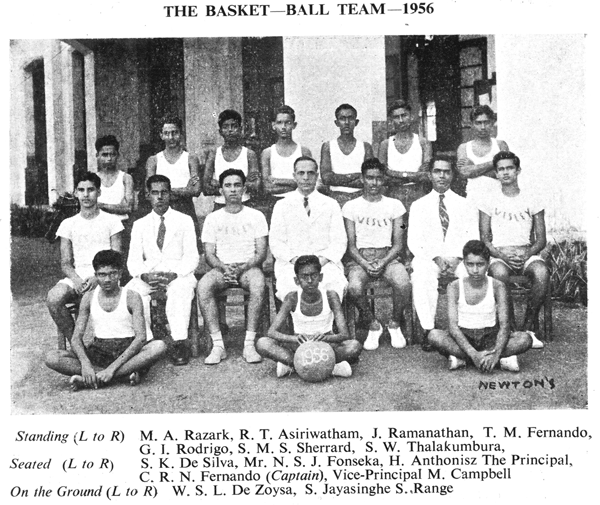The Double Blue International
Wesley College Colombo - Sri Lanka
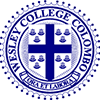
The Sports at Wesley College
Campbell Park
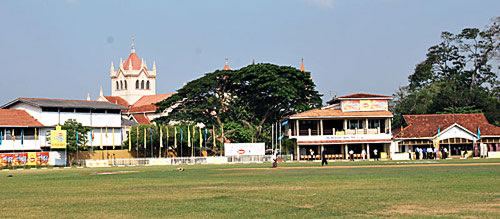
We pay homage to our Cricket Captains. They have done us proud. We honour and respect all the members who played under their captaincy.
The Photos from the Pavilion kindly sent to me by Richie Sappideen
List of 1st XI Cricket Captains sent by Jeremy Brohier
......................................................................
From Dr Nihal D Amerasekera
It is a great honour to be selected to represent the school. With the honour comes tremendous responsibility to do their best for the team at all times. This includes attending regular practices and travelling for the games away from home. This must occur at the expense of preparations for important examinations. We acknowledge and thank them for their efforts and sacrifices.
Those sportsmen were placed on a pedestal and were greatly respected by all. That intoxicating amalgam of praise and public acclaim can be destructive. Despite their teenage years they received this adulation with poise and dignity. Conceit grows imperceptibly and the person who is afflicted is unaware of it. Fortunately the hard knocks of our lives at school and those in the playing field were enough to tone it down. The effort to suppress one's feelings and behave well in public continuously must have been a great strain. Much has to be said about the discipline and training at Wesley which helped to groom such men of modesty and valour. I must say I looked at them with some envy and respect.
As I read through some of the anecdotes of the school matches on the Double Blue International, there are a multitude of interesting and hilarious stories of the games. Equally humorous stories fill the pages of the goings on off the field. There were sportsmen who were eccentrics, jokers and mavericks who saw the world differently. They indeed added colour to the sports and to life at school. They were all teenagers and none deserved sainthoods. It is only when we leave school and many years later, after life has come a full circle, that we appreciate how good those times were at Wesley. The weight of rules and regulations were a mere nuisance.
Personally, I never had the talent to represent the school. My sports were confined to soft ball cricket and soccer played in the Small Park at Karlsruhe Gardens. This has made me a life long spectator of all sports. Campbell Park was then our amphitheatre. I have such fond memories of watching cricket at Campbell Park standing under the "Mara" trees singing the College Song. Those Annual Sports Meets, Soccer, Rugby and Hockey matches at Campbell Park are memories to cherish. I now live 6 minutes walk away from the Lords Cricket Grounds and continue being a passionate spectator.
As a spectator now, I have the luxury of being an armchair critic. I can express my feelings freely although some views and opinions are far removed from reality. This is one of the great perks of being a spectator. At school I had to behave myself and take great care not to upset the sportsmen.
Having said all that, I have enormous respect for all those who played sports for the school. Sports were a huge part of school life. Away from the drag of books and classrooms, Sports made schooldays interesting, beautiful and memorable.
Links to further reading
1st XI Cricket Team 1908
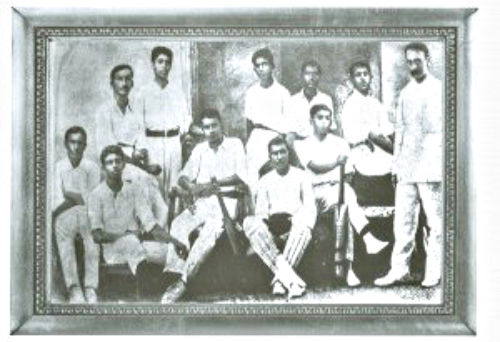
S.Gunasekera, D.M.Rupasinghe, E.A.Gunasekera, E de Silva, U.Gunaratne, Rev.Henry Highfield
Seated:
W.D.Lewis, S.Nagendra, F.W.Dias, O.C.Amarh, R.F.S.Mendis
.........................................................................
1st XI Cricket Team - 1935
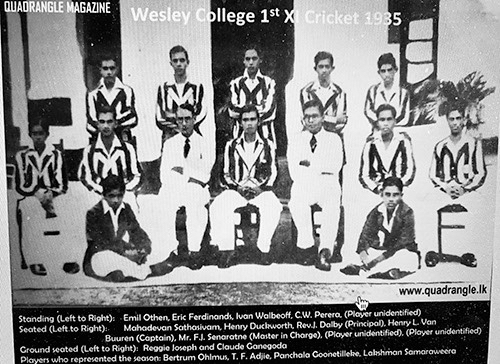
.........................................................................
1st XI Cricket Team - 1936
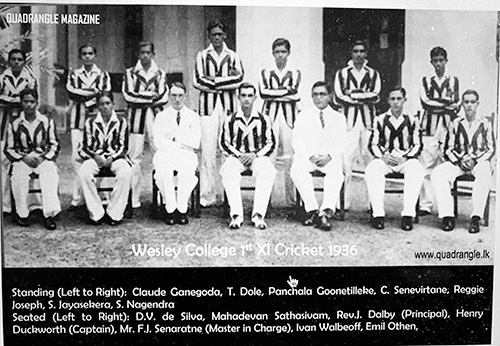
.........................................................................
1st XI Cricket Team - 1938
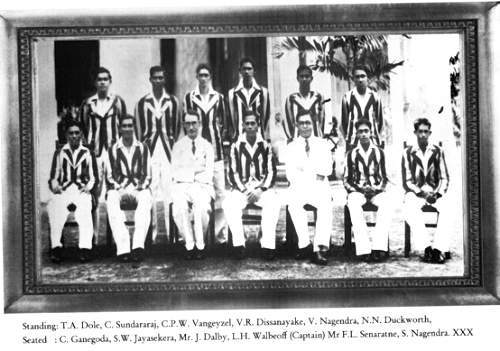
.........................................................................
1st XI Cricket Team - 1940
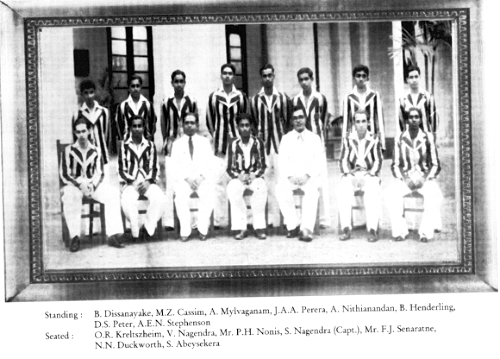
.........................................................................
1st XI Cricket Team - 1941
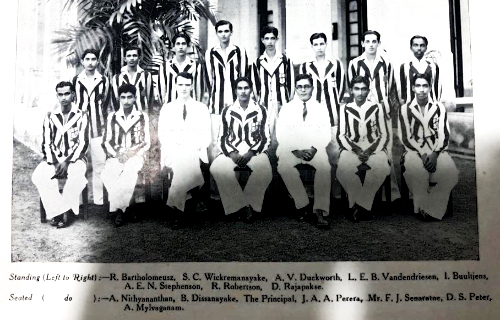
.........................................................................
1st XI Cricket Team - 1947
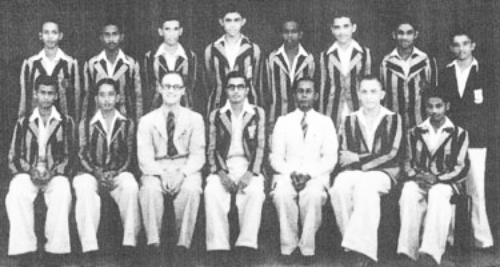
.........................................................................
1st XI Cricket Team - 1948
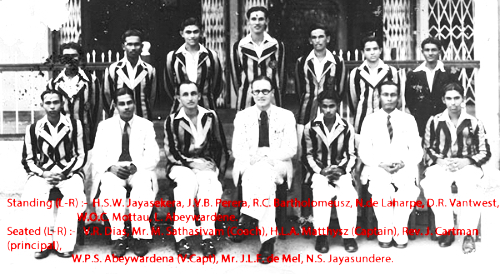
L to R - H.S.W Jayasekera, J.V.B Perera, R.C Bartholomeusz, N de La Harpe, D.R Vantwest, W.O.C Mottau, L. Abeywardene
Seated:
L to R- V.R Dias, Mr. M Sathasivam, H.L.A Matthysz (Capt), Rev James Cartman, W.P.S Abeywardene (Vice Capt), Mr J.L.F De Mel, N.S Jayasundere
.........................................................................
1st XI Cricket Team - 1952
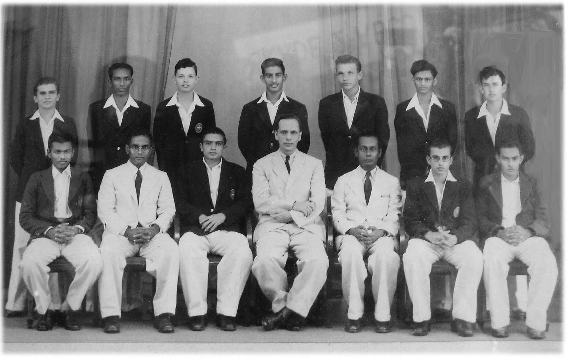
.........................................................................
1st XI Cricket Team - 1953
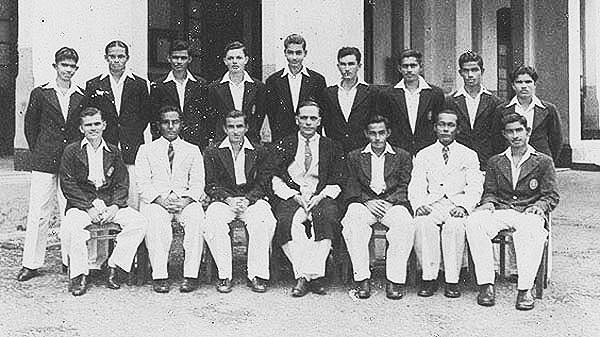
.........................................................................
1st XI Cricket Team - 1954
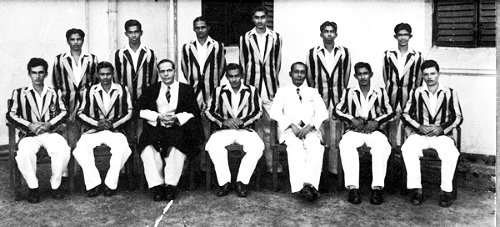
.........................................................................
1st XI Cricket Team - 1955
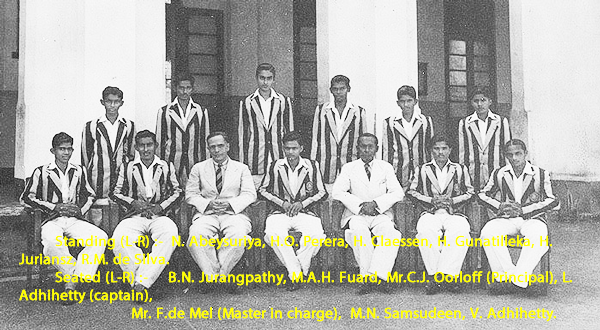
Nalendra Abeysuriya, H.O Perera, Herman Claessen, H.Gunatilleke, Harold Juriansz, R.M De Silva
Seated L to R:
B.N Jurangpathy, Abu Fuard, Mr C.J Oorloff, Lou Adhihetty, Mr JLF De Mel, M.N Samsudeen, Vincent Adhihetty
.........................................................................
1st XI Cricket Team - 1956
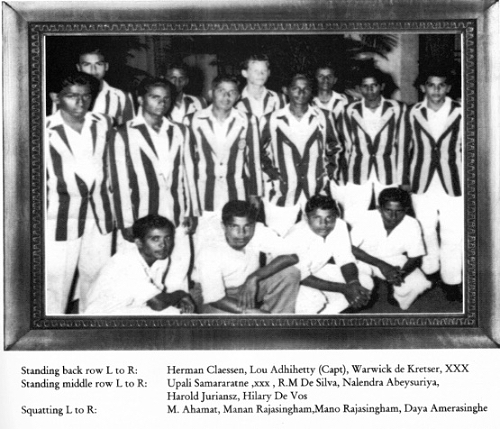
.........................................................................
1st XI Cricket Team - 1957
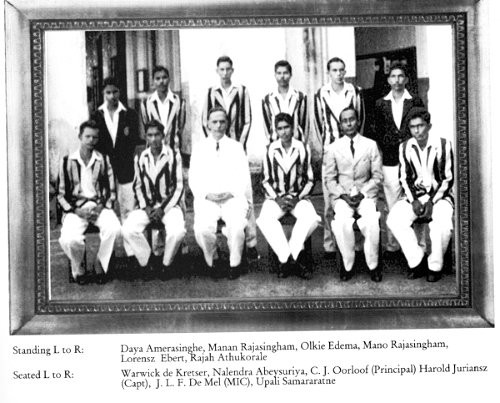
.........................................................................
1st XI Cricket Team - 1958
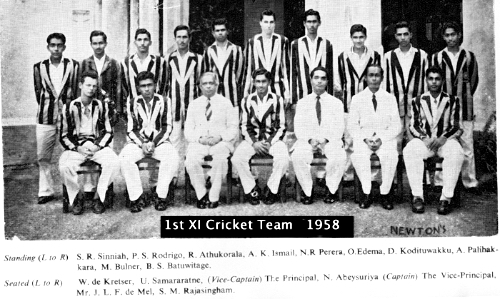
Senthil Sinniah, P.S Rodrigo, R. Atukorala, A.K Ismail, N.R Perera, O.Edema, D Kodituwakku, A Palihakkara, Milroy Bulner ,B.S Batuwitage
Seated L:R
W De Kretser, U. Samararatne(Vice Capt), Principal, N.Abeysuriya (Capt), Mr Lanerolle, Mr JLF de Mel, S.M Rajasingham
.........................................................................
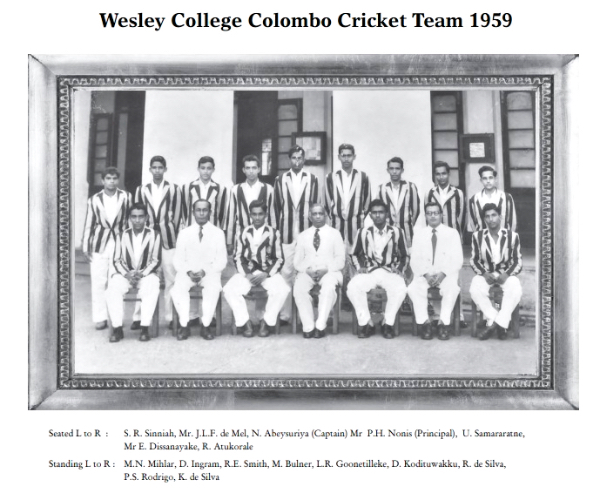
.........................................................................
1st XI Cricket Team - 1960
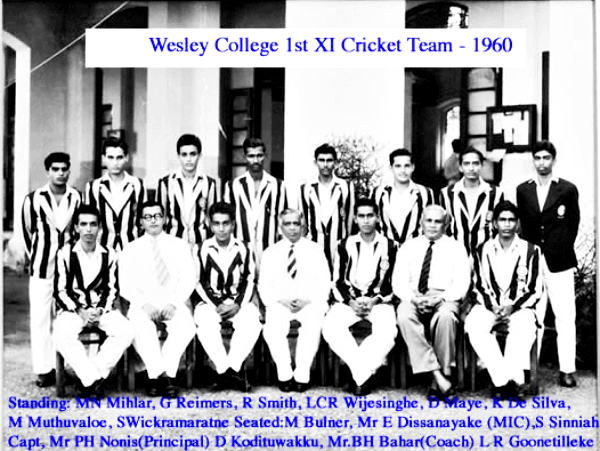
.........................................................................
1st XI Cricket Team - 1961
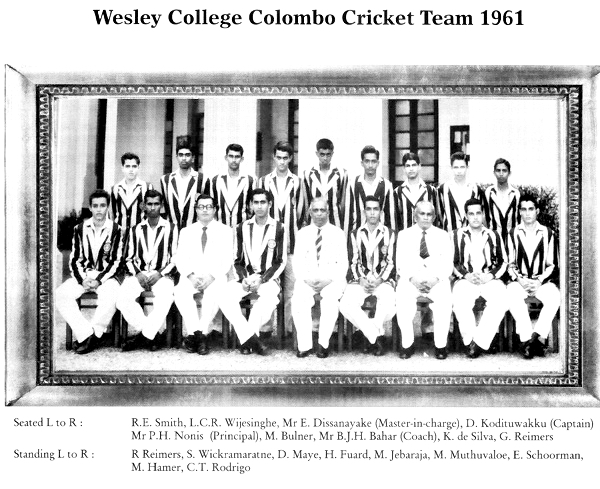
.........................................................................
1st XI Cricket Team - 1962

.........................................................................
1st XI Cricket Team - 1963
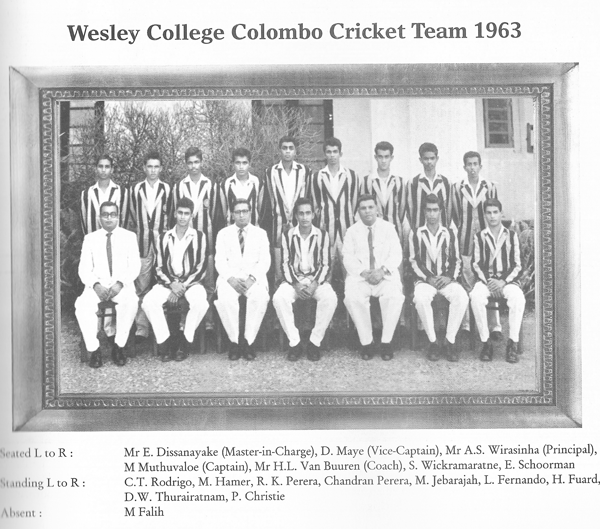
.........................................................................
1st XI Cricket Team - 1965
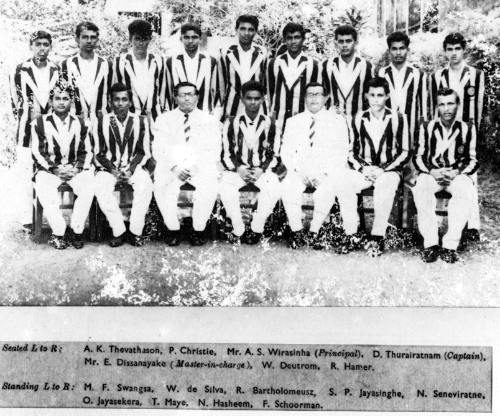
.........................................................................
1st XI Cricket Team - 1966

.........................................................................
1st XI Cricket Team - 1967
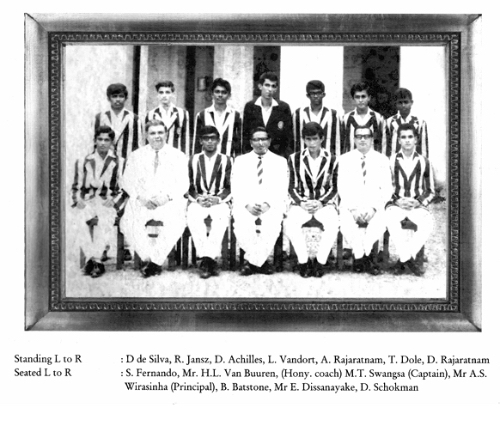
.........................................................................
1st XI Cricket Team - 1968

Rohan Wickramaratne, Patrick Jansz, Roger Hesse, Jayantha Wijemanne, P.Sivasubramaniam, Ivan Van Dort, Delmer Achilles, Sritharan Jeganathan, Hariharan Jeganathan
Derek Shockman(Vice Capt) , Principal, Sunil Fernando (Capt), Mr Edmund Dissanayake, Amaresh Rajaratnam
.........................................................................
1st XI Cricket Team - 1969

.........................................................................
1st XI Cricket Team - 1970

.........................................................................
1st XI Cricket Team - 1971
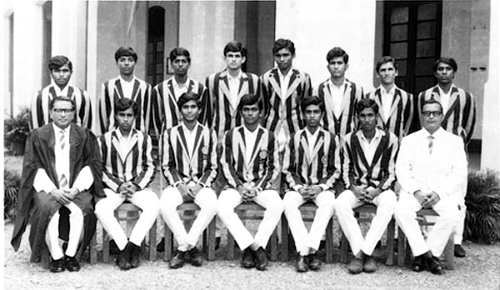
.........................................................................
1st XI Cricket Team - 1972
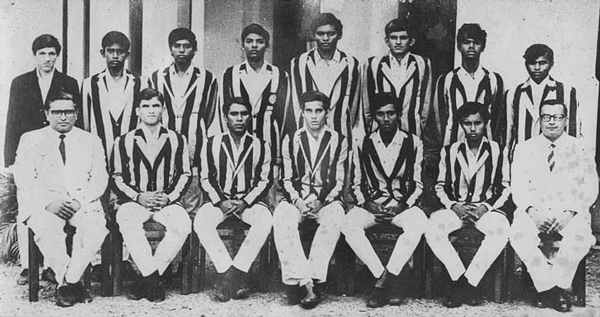
.........................................................................
1st XI Cricket Team - 1973
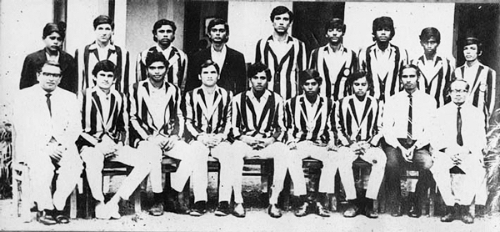
.........................................................................
1st XI Cricket Team - 1976/77
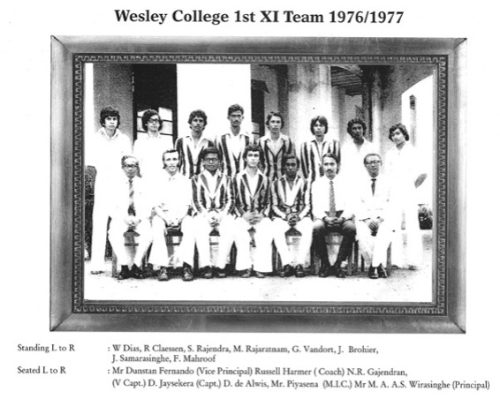
W. Dias, R Claessen, S.Rajendra, M Rajaratnam, G.Van Dort, J Brohier, J Samarasinghe, F.Mahroof
Seated L to R:
Mr Dunstan Fernando (Vice Principal), Russell Harmer(Coach), N.R Gajendran (Vice Capt), D Jayasekera (Capt), D De Alwis, Mr Piyasena (M.I.C), Mr A.S Wirasinha (Principal),
.........................................................................
1st XI Cricket Team - 1981
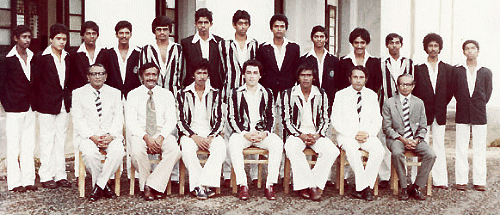
.........................................................................
1st XI Cricket Team - 1982
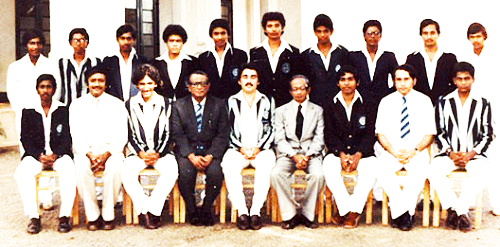
.........................................................................
1st XI Cricket Team - 1985
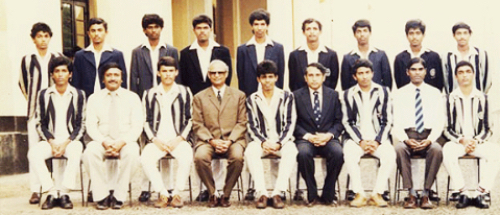
Chaminda Gunasekera, Duminda. Nissanka, Anjula Fernando, Jeganathan Wijenathan, Jerome De France, Rajah Navindran,Manjula Jayasinghe, Danesh Dissanayake.
Chanaka de Mel, Mr. Milroy Muthuvaloe (Coach), Dugal Jansz (Vice captain), Dr. Lou Adihetty (Principal), Mylvaganam Ganesh (Captain), Mr. M.A.P. Fernando(V. Principal), Mahendra Dissanayake, Mr. N.S.W. De Silva ( Master in charge) Perry Brohier.
.........................................................................
1st XI Cricket Team - 1986
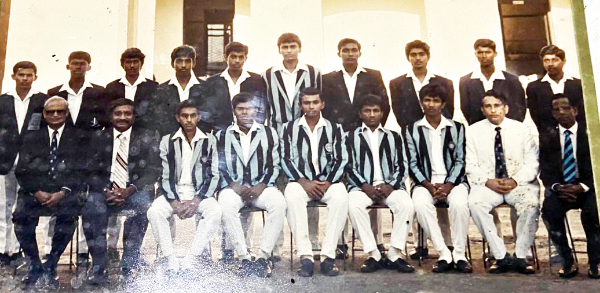
......................................................................... ......................................................................... ......................................................................... ......................................................................... ......................................................................... ......................................................................... ......................................................................... ......................................................................... I had the good fortune to be a member of Wesley's first eleven Cricket Teams during the 1950 to 1953 seasons. These were indeed our glorious Years of Cricket. Derrick Mack captained in 1950 and '51. Radley Claessen in 1952 and I lead Wesley in 1953. Wesley was placed second in the Inter-Collegiate Championship of 1950-51. The following season we took the top spot although we drew with St.Thomas' and in 1953 we had the distinction of being un-beaten Champions. It was an exciting four years of Cricket with Mr.A.V. Fernando as our honorary coach. Every player was self-motivated and totally committed to the task of winning. Wesley had the capacity to bat right down to number eleven. There were batsmen of sheer elegance, possessing every stroke in the book, and there were others with solid defence. Our fast bowlers were awesome whilst others had the ability to swing the ball with great control and our spinners had a natural gift of luring the unsuspecting batsmen to venture out of their crease at their peril. It was of course good fielding that made the difference because it restricted our opponent's ability to score. It generally made batsmen hesitant and negative in their approach and frustrated them as they repeatedly failed to penetrate the field. Good fielding of such a high standard provided our bowlers with confidence, which is an ingredient so virtually necessary in the battle for supremacy between bat and ball. It was reported on the grape vine that "Mus" as he was affectionately known was constantly looking up towards a bright blue sky on a blazing hot afternoon. The coach who was by this time quite disgusted by our efforts, unobtrusively moved upto us and whispered What the hell are you looking up for ?" Mus was quick to respond. "It might rain. Sir", he said. Yes, there was no doubt Mus was praying for a miracle like the rest of us. What we didn't know was that Mus wasn't going to surrender his wicket without a fight. George and Mus moved the score along steadily and then right out of the blue Mus pushed the ball into the covers and took off for a run like a scalded cat. The fielder lunged forward, picked up the ball and hit the stumps at the Welikada Gaol end. Mus was half way down the pitch but he kept running as if he wanted to reach the gaol to incarcerate himself for his grave error of judgement. He charged into the stumps flattening them in the process. Editors of Note: Bryan Claessen Captained the Wesley Team in 1953. In that year he was selected to play for Ceylon against, Australia skippered by Lindsay Hasset. Bryan was one of Wesley's best exponents of spin bowling, which included the "googly" He now lives in Adelaide, South Australia.
S.Rodrigo,R.Devendra, S.Wijayanayake,M.Sharaz,R.Mapitigama, S.Sappideen, S.Perera, M.Jayasinghe, R.David, S.Perumal
Seated Left to right:
Dr Louis De Z Adhihetty(Principal), M.Muthuvaloe(Coach), D.Dissanayake, J.Wijeratne, D.Nissanke (Capt), S.Jayasena, Z.Mantara,Mr.MAP Fernando(V.Principal),P.G.R Fernando(Master-in-Charge)
1st XI Cricket Team - 1987
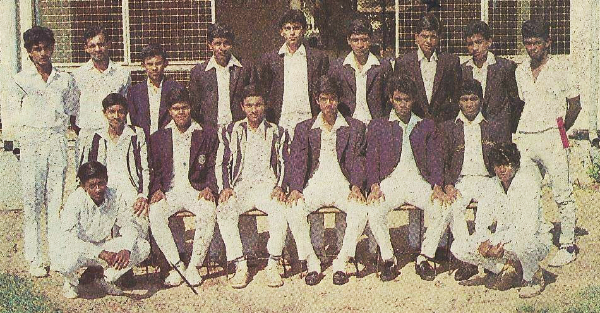
Manjula Jayasingha. De France, Shilpa Rodrigo, Shanaka Perera, Sappideen,Sanjeewa Seniviratne, Dharshana Liyanage, Shahnaz Mohamed, Karunakaran
Seated L- R Danesh
Dissanayake, Vijenathan VCapt, Duminda Nissanka,Zeshan Mantara, Keith Paul, Selsi Jayasinha
On ground L to R:
Suresh Perumal, Shehan Wijenayaka1st XI Cricket Team - 1990
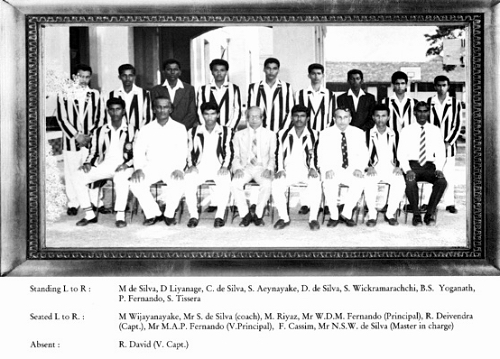
1st XI Cricket Team - 1992
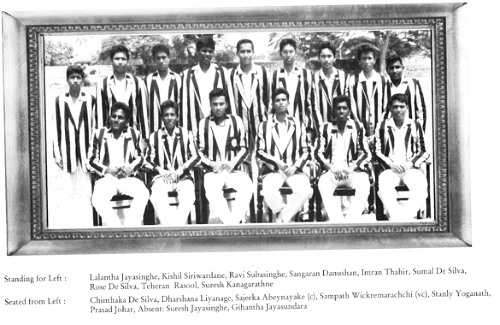
1st XI Cricket Team - 1995
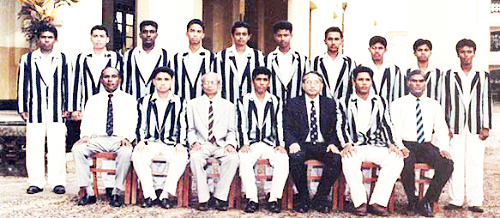
1st XI Cricket Team - 1996
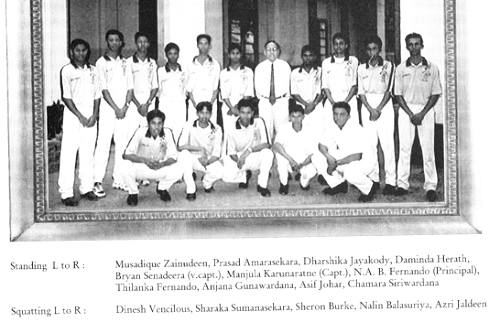
1st XI Cricket Team - 1999
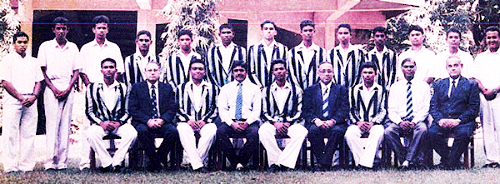
1st XI Cricket Team - 2001
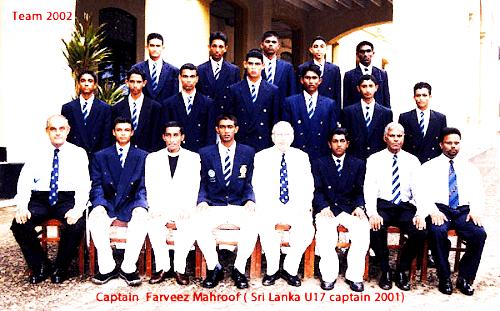
1st XI Cricket Team - 2012
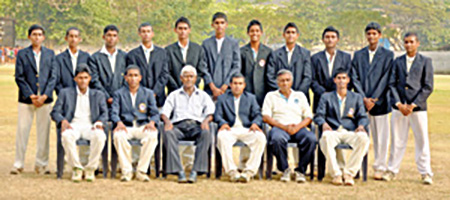
 There were two other aspects of paramount importance to Wesley's successes. First, we had an unrelenting determination; a will to win.We always played hard and we always played fair. Secondly, the players had the benefit of knowing that the whole school - teachers and students alike, without exception, were supporting them all the way. The intensity of support was inspiring and we were all fired -up for action by the famous War-Cry originated by Rev. James Cartman (Principal 1945-49) Because of this dedicated support and the sense of total unity that prevailed, the successes of our Golden Years must surely belong to all Wesleyites of the time and our achievements remain as their most cherished recollections to this very day. Be that as it may , we had our moments of nail- biting concern and one such occasion was our 1951 encounter with Prince of Wales College at the Campbell Park Grounds. Prince of Wales insisted that one of their teachers should umpire. This made it necessary for oar Coach to join him as a matter of courtesy. During the first Innings, Prince of Wales scored 142 runs which we considered to be an easy target for Wesley because of our very strong batting line-up. That assumption proved disastrous. Apart from a couple of small partnerships, Wesley made a right royal mess of things to find itself at a very precarious eight (8) wickets for around 100 runs. This was when George Jayatunga joined S .Musafer, our keeper.
There were two other aspects of paramount importance to Wesley's successes. First, we had an unrelenting determination; a will to win.We always played hard and we always played fair. Secondly, the players had the benefit of knowing that the whole school - teachers and students alike, without exception, were supporting them all the way. The intensity of support was inspiring and we were all fired -up for action by the famous War-Cry originated by Rev. James Cartman (Principal 1945-49) Because of this dedicated support and the sense of total unity that prevailed, the successes of our Golden Years must surely belong to all Wesleyites of the time and our achievements remain as their most cherished recollections to this very day. Be that as it may , we had our moments of nail- biting concern and one such occasion was our 1951 encounter with Prince of Wales College at the Campbell Park Grounds. Prince of Wales insisted that one of their teachers should umpire. This made it necessary for oar Coach to join him as a matter of courtesy. During the first Innings, Prince of Wales scored 142 runs which we considered to be an easy target for Wesley because of our very strong batting line-up. That assumption proved disastrous. Apart from a couple of small partnerships, Wesley made a right royal mess of things to find itself at a very precarious eight (8) wickets for around 100 runs. This was when George Jayatunga joined S .Musafer, our keeper. The fielders appealed and jumped around in glee but the Umpire was confused as he pondered if it was MUS who brought the stumps down , and according to the best traditions of this great game, the Prince of Wales Umpire gave MUS the benefit of the doubt. Such an incident should be sufficient to create a climax to bring this story to a conclusion but not so, with MUS at the centre wicket. He was out to the last ball of the over, caught Senaratne, bowled Sooriyaratchi for 20 runs when the scores were dead level. T.Allallasunderam at number 11, Wesley's fastest sprinter at the time strode out to bat. He walked straight up to George Jayatunga, who was to take the strike and nervously announces "Push and run, George" and that is exactly what they did to win the game. In this the School's 125th Anniversary, I join in the spirit of Celebrations and wish Wesley success in all its endeavors - both on and off the field. As a means of paying tribute to the gallant players and perhaps to refresh some fading memories I now give the names of all the cricketers who were a part of our glorious early 1950's.
The fielders appealed and jumped around in glee but the Umpire was confused as he pondered if it was MUS who brought the stumps down , and according to the best traditions of this great game, the Prince of Wales Umpire gave MUS the benefit of the doubt. Such an incident should be sufficient to create a climax to bring this story to a conclusion but not so, with MUS at the centre wicket. He was out to the last ball of the over, caught Senaratne, bowled Sooriyaratchi for 20 runs when the scores were dead level. T.Allallasunderam at number 11, Wesley's fastest sprinter at the time strode out to bat. He walked straight up to George Jayatunga, who was to take the strike and nervously announces "Push and run, George" and that is exactly what they did to win the game. In this the School's 125th Anniversary, I join in the spirit of Celebrations and wish Wesley success in all its endeavors - both on and off the field. As a means of paying tribute to the gallant players and perhaps to refresh some fading memories I now give the names of all the cricketers who were a part of our glorious early 1950's.
Vincent Joined the Ground Staff in 1958 Ranis, the bell-ringer, quite seriously told me, that be would not fit in, because "he was wearing shoes". But following the good example set by Wilbert, Vincent served the School with great acceptance till he resigned in 1985, after a period of 27 years. His family lived about 25 miles away, but he seldom took leave of absence. He was dependable, courteous, thorough in his work, and absolutely efficient. ' One incident about his integrity is recalled. When the School wanted to purchase a set of balls for practice, he made available 24 Kookaburra Balls used in the previous season. (Most ground boys used to sell used balls for a few rupees). Cricketers who knew him were full of praise for Vincent. Men of his calibre are a rare commodity today.
Wilbert joined the Ground Staff of Wesley in 1920. He was only 15 years old. He served the School devotedly for 48 years, when he retired because of feeble health. He passed away on the 23rd of April 1968. The good father that he was, he endeavoured to provide the bare necessities for his family of five, by sacrificing his mid day meal. It is said that he often partook of only a cup of plain tea at lunch time. Wesleyites had the highest regard for Wilbert. He had a good knowledge of the game. Very often the team that was selected by the School, was the same as he himself had in mind. Umpires who came to Campbell Park did not have to double check the markings of the wicket. Wilbert's measurements were always accurate. Wilbert had great faith in Wesley. The Old Boys rallied round splendidly to launch a Fund for his family. The Principal, Mr. Harold Nonis, and the Hony. Sec of the Old Boys' Union, Mr. J. G. P. Wickramanayeke were of great help to him. Wilbert's devotion to duty, loyalty, integrity, sense of responsibility and quiet efficiency were the hallmark of his character.
Links to further reading
I first came to love the game of cricket when I joined Wesley College in 1950 when DBC Mack captained a very successful school team. I recall with much nostalgia watching cricket at Campbell park in the blistering heat seated under those spreading Mara trees. Those brief encounters sparked a lifetime of devotion to the game.
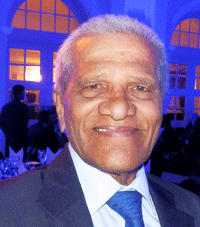 My affection for cricket has survived the years as I crafted a career and brought up a family. I then followed the mass exodus to the west which was then euphemistically called the “brain drain" (although I believe that the brain was mainly in the drain). My strictly limited talent for playing meant I would be forever a spectator. As I now watch cricket at Lords or the Oval I reflect on my years as a spectator watching school cricket in old Ceylon from Campbell Park to Randles Hill and the Galle Esplanade to Asgiriya. The stench from the Wellawatte canal as it wafted across the St Peters Grounds at Bambalapitiya will always remain in my nostrils when I recall those halcyon years of school cricket.
My affection for cricket has survived the years as I crafted a career and brought up a family. I then followed the mass exodus to the west which was then euphemistically called the “brain drain" (although I believe that the brain was mainly in the drain). My strictly limited talent for playing meant I would be forever a spectator. As I now watch cricket at Lords or the Oval I reflect on my years as a spectator watching school cricket in old Ceylon from Campbell Park to Randles Hill and the Galle Esplanade to Asgiriya. The stench from the Wellawatte canal as it wafted across the St Peters Grounds at Bambalapitiya will always remain in my nostrils when I recall those halcyon years of school cricket.
Mohammed N Samsudeen was a legend in his own youth. His cricketing talent was so precocious that he played for the school 1st XI team at the age of 14 during the captaincy of Ansar Fuard. His photo also appears in the 1953 cricket season captained by the Bryan Claessen and it is my belief he played a few matches in the Michaelmas term at the young age of 13. A most remarkable feat for an exceptionally talented fast bowler. He continued to play school cricket until 1956 when the school was captained by Lou Adhihetty and Wesley had a tremendously successful season.
My earliest recollections are of a young Samsudeen, rather short for a fast bowler, darting from close to the Campbell Park pavilion to release the ball clipping the bails off the opponents wicket. There was a mighty roar with the fall of every wicket from the packed crowd around the ground. After taking a wicket there were no exuberant celebrations. He picked up the ball and calmly walked back to his mark to bowl again. He could swing the ball prodigiously and came up with match-winning performances. Whenever he took a bag full of wickets at Campbell Park he was carried in triumph from the pitch to the pavilion by Wesleyites.
His rhythmical run-up and bowling action was sheer instinct and artistry. There were days when he simply swept away powerful batting sides by speed, guile and movement. He was fast, though not ferocious and did not often summon up the kind of aggression which threatened a batsman's ribcage. His skill was his uncanny accuracy. His strength and stamina were as exceptional as his speed. Samsudeen was a captain's dream because of his sheer reliability in length and line. Despite his casual non-caring demeanour he had tremendous courage and determination to do well. There was no need for sledging, his sheer natural ability did the talking. Year after year he became Wesley's sharpest attacking weapon.
Like many a bowler, he enjoyed the occasional batting feat as a low order 'slogger'. He was always reliable in the field, seldom putting down a catch in the deep.
In the 1950’s school cricket was at its zenith. Soon his name and exploits filled the back pages of the daily papers and Samsudeen became a household name feared and respected in equal measure. He became a match winner for Wesley. When his name was read out at assembly in the Great Hall we were in raptures. There was an out-pouring of affection and a generous applause.
Samsudeen played for the All Ceylon Cricket Team while at school and also played the combined school XI. For many years he was a match winning fast bowler for the Moors Sports Club in Colombo. Many of the facts and figures about his success as a bowler in school and First Class cricket are sadly lost in the mist of time. To this day I recall the sense of loss we felt when Samsudeen left school.
He might have been the most shy member of the dressing-room, but became positively animated with the ball in his hands. Despite the awe and aura Samsudeen never wanted centre stage and remained a quiet, retiring and modest guy. He cared less for the adulation and ceremony of cricket. Amiable and polite he is the most self-effacing of men. In those days Whenever I saw him, be it at the Pavilion or in the long corridors of Wesley College he wore a broad smile. He was ever willing to say hello to the many young fans who surrounded him. He had an abiding respect for the game, the spectators and the players. Samsudeens brother, MN Mihlar, played cricket for Wesley in 1959/60 as a successful fast bowler following in the steps of his illustrious bother.
Outside the game he loved, Samsudeen became a successful businessman in the textile industry. Despite his many notable achievements very little is written about him mostly because he maintained a low profile and never looked for fame. Many cricket lovers will remember MN Samsudeen as one of the finest left arm fast bowlers of the 1950’s and will recall with much affection his many achievements and his friendly smile.
Born in 1934 we celebrate his 80th year this year - We wish him good health and happiness in the years to come..
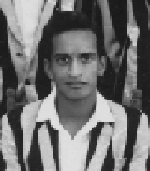 I joined Wesley in 1950. After captaining the Under 14 and Under 16 teams, I had the privilege of being appointed as the Captain of the 1st Eleven Cricket team in 1963. We went through the season unbeaten defeating St Peter's , Kingswood, and Under the able guidance of our coach Henry Van Buuren, former Captain, and astute tactician, we were selected as the first recipients of the Lifebouy Shield, for the best School's cricket team of 1963. Darell Maye was selected as the "Schoolboy Cricketer of the From 1960 to 1962 we came under the able guidance of B.J.H. Bahar (Snr), who hailed from far away Hambantota. Our Cricket was right on top. Other members of the team were Everard Schoorman (Australia), Milroy Jebarajah (Canada), Batcha Fuard (New Zealand), Sarath Wickramaratne, Mervyn Harmer Clifford Rodrigo, Rodney Perera, C.Perera, L.Femando I was invited to be the Honorary coach of the 1st Eleven in 1981 I accepted the challenge although the facilities available were limited. We were unbeaten m 1981 and in 1985.
I joined Wesley in 1950. After captaining the Under 14 and Under 16 teams, I had the privilege of being appointed as the Captain of the 1st Eleven Cricket team in 1963. We went through the season unbeaten defeating St Peter's , Kingswood, and Under the able guidance of our coach Henry Van Buuren, former Captain, and astute tactician, we were selected as the first recipients of the Lifebouy Shield, for the best School's cricket team of 1963. Darell Maye was selected as the "Schoolboy Cricketer of the From 1960 to 1962 we came under the able guidance of B.J.H. Bahar (Snr), who hailed from far away Hambantota. Our Cricket was right on top. Other members of the team were Everard Schoorman (Australia), Milroy Jebarajah (Canada), Batcha Fuard (New Zealand), Sarath Wickramaratne, Mervyn Harmer Clifford Rodrigo, Rodney Perera, C.Perera, L.Femando I was invited to be the Honorary coach of the 1st Eleven in 1981 I accepted the challenge although the facilities available were limited. We were unbeaten m 1981 and in 1985.
It was with a great sense of satisfaction that I can state that during the period 1981-1988 many centuries were scored by the boys trained by me. On for occasions , more than a 1000 runs were scored by individual players. Navin de Silva achieved this twice in 1981 and in 1982. In addition be captured more than 50 wickets each year. Duminda Nissanka scored 1000 runs in 1987 Navin de Silva was selected to lead the Sri Lanka School cricket team tour of England and its worthy of mention that Captain and Vice captain of our current national team, Arjuna Ranatunga and Aravinda de Silva played under Navin in this tour. Our unbeaten team of 1985, skippered by Mylvaganam Ganesh was adjudged the Best Schools Team and was awarded the Lifebuoy Shield again, for the third time, the second being under the Captaincy of Amaresh Rajaratnam. in 1969.
Before I conclude I must also refer to the 1983 Under 17 Team skippered by All -rounder Mahendra Dissanayake, which won the All-Island Division II Tournament, winning all six(6) matches. Mahendra captained the 1st XI in 1984. He holds the School record as the best bowler against St Peter's capturing 8 for 54, in 1985. In the same year, in the match against the invincible Nalanda team, on the Nalanda Grounds, Mahendra was in devastating form capturing 7 for 34 arid 7 for 30. Even Asanka Gurusinghe and Roshan Mahanama who were stalwarts in the national team later found it extremely difficult to face the deadly inswing of Mahendra. Further, Mahendra sportingly agreed to play under the 1985 Captain M.Ganesh, although he could have continued as Captain for another year. He materially helped the school to become Champions in 1985, through his personal example with bat and ball, and advice when asked by his Captain. It was with great regret that I accepted a Staff Post in Nuwara Eliya in 1988, which prevented me from serving My Alma Mater longer.
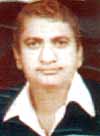 It is not possible to write precisely of my initial involvement with Wesley Soccer but I am sure - it was the Principal Mr. C. J. Oorloff who invited me to Wesley after a friendly game of Soccer between Wesley & the CR & FC In those early days, except for a few at Wesley, the rest were at best average and nil at worst! yet with total commitment, and enthusiasm dovetailed, the results of the preparatory matches of the third term, held out promise for our teams - the 1st Eleven and the under 18. Lest I forget or rather lest we forget let me express my deep gratitude to the late Terrence de Zilwa, it was he who provided the Soccer team with first set of soccer jerseys, shorts and stockings. Terrence never missed a match where the "Double blues" went into action. It was he who requested Mr. Oorloff to present me with a double blue tie, as a token of appreciation for my services to Wesley soccer. This gift remains a treasured momento.
It is not possible to write precisely of my initial involvement with Wesley Soccer but I am sure - it was the Principal Mr. C. J. Oorloff who invited me to Wesley after a friendly game of Soccer between Wesley & the CR & FC In those early days, except for a few at Wesley, the rest were at best average and nil at worst! yet with total commitment, and enthusiasm dovetailed, the results of the preparatory matches of the third term, held out promise for our teams - the 1st Eleven and the under 18. Lest I forget or rather lest we forget let me express my deep gratitude to the late Terrence de Zilwa, it was he who provided the Soccer team with first set of soccer jerseys, shorts and stockings. Terrence never missed a match where the "Double blues" went into action. It was he who requested Mr. Oorloff to present me with a double blue tie, as a token of appreciation for my services to Wesley soccer. This gift remains a treasured momento.
When for the first time the "Double Blues" took the field in competitive soccer, there appeared a large "fan" support from both College and the public. Our initial success against Carey College, Christian College, Richmond College, De Mazenod College and Kingswood College, were not only the fruits of labour, but a clear signal to the fancied soccer schools that a new star had appeared in the horizon. Many are the unforgettable pieces of action, for example the De Mazenod encounter at Kandana, when we were trailing one-nil in the final minutes of play, a free kick was awarded to us for a minor offence near 40 yards out in the middle. Upali Samararatne took some measured steps back amidst the absorbing mass, and let go a drive probably rare even in major soccer which sent the sphere curling into the corner of the net, to draw the match and keep the "Blues" undefeated I recall another incident when playing Richmond at the Galle Esplanade, an infuriated crowd invaded the field and manhandled our players triggered off in an incident on the field involving Lou Adhihetty, which could have turned into a fracas if not for the intervention of the late Dr. Dahanayake.
Then I recall Upali, in the game against St. Matthews at Mount Mary executing one of his menacing "gliding" tackles, not only brought down the player but his pants too! Up in Katugastota to play St. Anthony's, the Kandy District soccer champs, our goal keeper Terrence Gunawardene who in later years was Commander of the Air Force, was stricken with high fever, and though advised to stand down was determined to play. I recall the names of Michael Fernando and Rajah Authukorale. Terrence Gunawardene's performance was class. Though it was a drawn game, the major honours went to us.
Let me add a few words of appreciation to every member of the senior and the junior teams, of that period who excelled in the sport and brought honour to their Alma Mater. Lou Adhihetty, Gunasekera, Wimal Goonetilleke, Upali Samararatne, who skippered the "Double Blues" then, were excellent in leadership, apart from their individual performance. I may hasten to say the O.K. Hemachandra, now Deputy Inspector General of Police, Michael Fernando, Upali Samararatne, Nalendra Abeysooriya, Terrence Goonawardene, Rajah Athukorale. Samidon, Razark, and Lou Adhihetty could have donned National jersey, if only if they had pursued with the sport. In Hemachandra there was a very crafty player whose mid-field manoeuvres were.' the base of the team's success. Upali Samararatna's dare and dash and Terrence Gunawardene's safe hands were no mean contribution to the glory of Wesley Soccer. The sheer speed and control of Abeysooriya in the wings, and the deft and droit foot work of Michael Fernando, Samidon, Rajah Authukorale, to name a few were a delight to watch. These were then the days when the "Double Blues" bloomed and blossomed at Soccer!
Links to further reading
Nizam Hajireen is a Sri Lankan Soccer and Rugby International
 Forty years of service is certainly a landmark in the life of any individual and if such service is offered 'gratis' the worth is immeasurable. This then is the concise version of the life of Neville Abeygunawardene, the former National Soccer Coach who sadly today lies gravely ill and confined mostly to bed, reminiscing the green years not in a state of good cheer and comfort but more in pain and ponder - the residue of cancer. Seated by the side of his bed last week it saddened me deeply to see his weak and wrinkled body which was once the epitome of the dictum 'mens sana incorpors sano' with the only exception that his faculties were yet in fair control though not the same which kept his trainees in rapt awe throughout the discourses on soccer tactics and stratagem.
Forty years of service is certainly a landmark in the life of any individual and if such service is offered 'gratis' the worth is immeasurable. This then is the concise version of the life of Neville Abeygunawardene, the former National Soccer Coach who sadly today lies gravely ill and confined mostly to bed, reminiscing the green years not in a state of good cheer and comfort but more in pain and ponder - the residue of cancer. Seated by the side of his bed last week it saddened me deeply to see his weak and wrinkled body which was once the epitome of the dictum 'mens sana incorpors sano' with the only exception that his faculties were yet in fair control though not the same which kept his trainees in rapt awe throughout the discourses on soccer tactics and stratagem.
It was a hard way to the top
I came to know Neville in the mid fifties when he represented Young Stars FC Kandy skippered by Tom Deen and still later when he played for the Nugegoda District team as a nimble footed yet cut 'Inside Forward'. But my admiration grow to a point of adoration when I had the privilege of being under his mentorship in both the Police soccer team and the National soccer squad. He had the unique ability to get individuals of varied levels of talent dovetailed into a very effective outfit. His initial handling the soccer squads of the army, navy, police, and the air force toughened his stance on discipline more than anything else. Apart from training in the finer points of the sport, he was very particular on behavioral conduct of the trainees be it on or off the field. Just one incident passes my mind right now. Dinapala, a physically strong player in the national squad called his team mate with these words 'dhapan machang boley' a term innocuous and not disparaging at all. Blowing the whistle loud and clear Neville warned the player to mind his language saying that he is training the national team and not a common fish mongers club. Some had to pack up their bags and leave the squad for impropriety in language and behaviour. Probably these attributes contributed to fortify the technicalities in the sport and thus provide a spate of international victories that no other coach to date could equal, leave alone surpass.
Uncompromising in shady situations
When the late Sugathadasa, President of the Football Association went back on an assurance not to play the national squad sans at least two weeks of prior training, Neville tendered his resignation and the entire national squad led by Peter Ranasinghe refused to play, a resulting in the suspension of the coach and the team. However in the resulting litigation the coach and the team were recalled. Similarly when B.G.S. David district judge presiding over the selection of the team for the pre olympic tie in Israel, Neville is alleged to have thrown the relevant selection file in the face of the top brass for pressurising in include just one player who had the nod of the selectors. Having walked out the coach was brought back with no change in the squad and the assurance that the coach alone will either swim or sink with the team and none else whomsoever. Having won the runner up trophy at the eighth Agha Khan Gold Cup international tournament in Dacca, Neville refused to the suggestion of the manager to extend the tour and insisted that the team return home the next day. A few officials then hatched up an inquiry to suspend the coach which never saw the light of day. The famous Saudi tour where the pocket money of the players were denied to them and the coach blew the top off under another mock inquiry ordered by the late Minister Vincent Perera and which ended with the officials found guilty and the coach exonerated. Of the seven litigations that spanned the coaching career of Neville, he came out in all undeterred and undefeated.
So strong was his opposition to slippery, and slimy deals that even to this day thousands of his trainees stand so proudly behind him. I am sure to a man they would be praying that Neville would soon recover from his unfortunate illness and here we thank this peerless coach for all he has done for the poor man's sport.
Thank you Sir!
Pete Mendis, London, 1998
1st XI Cricket Team 1947
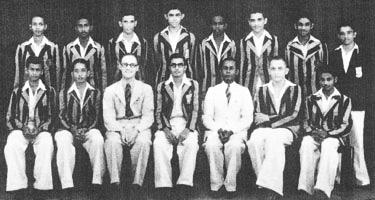
In the first term of 1946,a notice that the lst XI cricket practices will beheld at the Prison Grounds was displayed. During the first week there was a turn up of about 10, this number gradually increased. Wilbert and Marshall, lugged the material to the grounds.
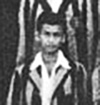 I met Marshall at Wesley when I came down to Sri Lanka in 1997 and seeing him after 50 years evoked mutual memories. The practices were taken very seriously, under the watchful eye of our Captain Edmund Dissanayake, who was ably assisted by Alan Ratnarajah (now deceased). We did well in all our third term matches, defeating Kingswood by an innings and Prince of Wales by three(3) wickets. We were a well knit team displaying a high 'espirit de corps'. Within that term a trip was organised to the 'ruined cities'- accompanying us were two members of the staff- Maurice Weerasooriya better known as "Tojo' and Shelton Peiris. Mr Paul Senaratne who was the son of a well known Methodist Minister, Revd. G.A.F.Senaratne, was the District Engineer at C.G.R. our genial host.
I met Marshall at Wesley when I came down to Sri Lanka in 1997 and seeing him after 50 years evoked mutual memories. The practices were taken very seriously, under the watchful eye of our Captain Edmund Dissanayake, who was ably assisted by Alan Ratnarajah (now deceased). We did well in all our third term matches, defeating Kingswood by an innings and Prince of Wales by three(3) wickets. We were a well knit team displaying a high 'espirit de corps'. Within that term a trip was organised to the 'ruined cities'- accompanying us were two members of the staff- Maurice Weerasooriya better known as "Tojo' and Shelton Peiris. Mr Paul Senaratne who was the son of a well known Methodist Minister, Revd. G.A.F.Senaratne, was the District Engineer at C.G.R. our genial host.
Some Senior Police Officers, whose sons were Hostellers mapped an extensive and interesting programme, with comfortable transport provided as well. After a few days , Tojo, a great gentleman, but of the moody type, announced that he was leaving us- none knew why- but however, the planned programme was earned out, under the leadership of Shelton and Edmund. With the commencement of the first term , we bad only Edmund to direct us at the nets, with Fred de Mel (Pappa) dropping in, on and off. The 'Thambi-boutique' was our rendezvous for a stimulating 'gabdee', and cup of tea! followed by a bee-line to Bertus Perera's home, in the company of his very hospitable parents, and the delightful presence of his sisters- Clarice and Junie. Bertus joined the Police and rose to the rank of Deputy Inspector General of Police. Then we had a another fine sportsman- L.V.Jayaweera, father of Vivian who was an Officer in the Mounted Corps. Later L.V. J. spent time after his strenuous work coaching. Our first match in 1947 was with Royal, at Reid Avenue whom we defeated after a lapse of eleven years.
The Monday following was decided a full holiday by the over-joyed Revd. James Cartman., who at the assembly that morning spoke of the teams 'grit and unity'. We felt seven feet tall ! The next match in 1947 was against St Thomas' which will certainly go down in Wesley's cricketing history, as the 'touch and go tragedy match', for Edmund our Skiver, whilst fielding at silly mid-off, switched m the middle of the over to silly mid-on, and was bit on the head when Ronnie Weerakoon(STC) pulled Jayasundera to the mid-wicket boundary. Edmund dropped unconscious, and was carried off the field by the Rev Cartman and Prefects, and rushed to Durdans Nursing Home, where he re-gained consciousness many days later. Bewildered as we were by this unfortunate incident which caused grievous injury to Edmund, - a fine batsman and a sterling bowler- we were determined to 'play up! and Play the game! ' and infused with a renewed fervour we were able to defeat St Thomas' by 112 runs. Alan took over the role of captain and the team to a man supported him. It is of interest to mention, though on a no(e of regret, that our performance of that year against Royal and St Thomas' has yet to be repeated even after as long as half a century.
This is an open challenge which Wesley must take seriously. In our day we had an aim and a direction, and without doubt like the great lads of today. Some of the 1947 players flit into mind like Harold Matthysz, D.T.Ramanayake, Piyasiri Abeyewardene, Vivil Dias, Denis Van Twest, Clive Bartholomeusz, Natty Prins, and Orville Mottau- of course there were others too who played their part for Wesley. Our next match was against Trinity at Asgirya. We received a warm welcome, as our reputation had preceded us!- though, of course , the media coverage of Trinity was in the superlatives that it had the best school-boy side, which included five (5) cricket Lions. It was our first match on turf. We drew a thrilling match having to make 147 in 90 minutes That year our next encounter was with St Benedict's College., whom we defeated by an innings on the Railway Grounds at Mount Mary. There was an unbecoming incident which marred the very spirit of sportmanship, when supporters of the defeated team smashed the glass pane of Rev. Cartman's car. -The Wesley team and supporters displayed great restraint This annual fixture was off the cards for nearly 40 years and revived in 1980, when Edmund was Prefect of Games. On my meeting Edmund, during a recent visit to Sri Lanka, he told me how thankful he was to Henry Van Buuren ( Wesley Captain of 1935) who coached him, besides giving useful instructions on the strategy of planning and directing not only one's team but also the method adopted by opponents.
Wesley has a high spirit of sportsmanship. I recall Edmund stepping down from Captaincy to give Harold Matthysz a chance. We also had the benefit of M. Sathasivam's great experience as be too coached our team. Both, Henry Van Buuren and Satha boosted the morale and image of the team. One cannot forget the interest, influence and the encouragement the Rev James Cartman exerted in the resurgence of post-war cricket at Wesley, despite the few facilities, in contrast to what are available now. Cricket then moulded us to "Play up! Play up! and Play the game! " and also face up to the challenges of life. What of Wesley today ?
Editors Note: Pete A. Mendis apart from his keen interest in Cricket was also involved in many other activities of the school such as the Histographers Society, and was a rumbustious Hosteller, though pint sized! He is the only son of the Late Rev. George Mendis, a one time Chairman of the Methodist Synod. He is married and now lives in London, England. From Shelton Peiris
Links to further reading
Kindly sent to me by Mr.N.S.Weerasekera
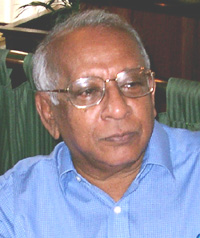 The writer was old boy of the college and was considered the Doyen of Sports writers In Sri Lanka. We expect knowledgeable young old boys like Richard Dwight and Eric Gauder to update this in future newsletters . Past and present Wesleyites I am sure be interested in what I shall be saying in the course of this article, dealing namely with sports of all forms at the old College in Dam Street, Pettah from 1893 when I was admitted into that institution as a free scholar at the age of ten. In those far off days the Principal was Rev. T C Hillard B A (Lond); the Head master Mr C P Dias MMC and his chief Assistant W E Mack.
The writer was old boy of the college and was considered the Doyen of Sports writers In Sri Lanka. We expect knowledgeable young old boys like Richard Dwight and Eric Gauder to update this in future newsletters . Past and present Wesleyites I am sure be interested in what I shall be saying in the course of this article, dealing namely with sports of all forms at the old College in Dam Street, Pettah from 1893 when I was admitted into that institution as a free scholar at the age of ten. In those far off days the Principal was Rev. T C Hillard B A (Lond); the Head master Mr C P Dias MMC and his chief Assistant W E Mack.
Of my old Principals and teachers at Wesley, there is none alive today and of my contemporaries in College as far as I can remember only R F Honter, famous old Wesleyite now living In retirement in England. J,Deheragoda Retired Supdt of Police: J.C.Alwis a veteran of over 80 now living at Wellawatte; A,W.Dissanayake retired schoolmaster of Richmond; Chevalier A Sellamuttu who was a classmate of mine and Robert De Alwis after a master at Kingswood. I can still remember my first from master namely J.W.Amerasekera, also J.A.Wijeyekoon and C.W.Alwis (afterwards a Mudaliyar of the Supreme Court).
I am sure most of my readers will be interested in the following facts. From 1893 till 1897 when Price Park was opened out. Wesley had no Playground. We young pupils indulged in a little cricket in the small compound adjoining the big hall. The older boys used to walk in the evenings to the racquet courts carrying their materials and practice there. The Chalmer's granaries now occupy that space. Later when Price Park a very poor sort of playground was opened out, both senior and junior boys indulged in Cricket and Football on the park. It was in 1893 that Wesley met Royal for the first time in a cricket match. The game took place on the old Royal College tiny playground in San Sebastian.
Wesley were led by A P De Bruin, afterwards Headmaster of All Saints' School at Galle and a famous Church Organist. In the team were C R Perera, a fine left hand batsman. Z H Mantara, later the captain of the Malay CC: Sir Gerard Wijekoon, Ben Honter eldest of the Honter brothers: M H Akbar and W L Faber. Later in 1895 Wesley met Royal -on the Racquet Court, when on the Wesley side were C.R.Pereira.EB Relich,RF Honter WA Joseph and a great fast bowler and Louis Scharenguivel. The last two lived in small park near my place, In 1897 Wesley beat Royal, I believe for the first time on Galle Face Green. M L Warish led Wesley and C E Perera played a brilliant historic innings of 98. In 1898, C E Perera Captained Wesley and among my team-mates were W ONathanielsz and B Joseph, a younger brother of W A Joseph and one of a famous family of eleven brothers who played a match against Bloomfield at the Racquet court. Another member of the Joseph family, Lennie is still alive today.
He also played for Wesley. In 1899, I commenced playing regularly for Nathanielsz. W A Wijekoon a fine all rounder, A W Dissanayake, Richard De Alwis and Lyn Barbut the greatest left hand bowler produced by Wesley. Today, my mind goes back to 1900, when a famous combined colleges team led by E Weerasuriya of Royal beat the invincible Colts CC by a few runs at the Victoria Park. In that famous team were Lyn Barbut, A W Nathanielsz and Willy Ekanayake younger brother of the famous H J V. I'm sure readers will pardon my modesty when as Captain in 1901, 1902. 1903 I set up a record for no one had captained Wesley Three times in a succession. Many years after A R Seneviratne equalled my record but I believe it still stands unique as I also won the Hill Medal in 1903.
The only other Wesleyite who was Captain and won the Hill Medal was the present principal Mr P H Nonis. In those far off days, apart from Royal, the other schools Wesley met In cricket were St Thomas', I would like to mention that in 1903. when the school champions Royal were beaten by Trinity College, Wesley went upto Kandy and on Bogambara grounds beat a famous Trinity eleven led by C V Aluwlhare and John Halangoda by one run. In my time the Combined Colleges, made up of the best cricketers of Wesley, St Josephs, Royal , St Thomas' and Trinity used to meet the leading first class teams in Ceylon and it fell to my honour to lead the combined colleges in several of these games.
In later years these matches ceased to function and today rarely do we hear of a combined colleges team beating the leading sides in Ceylon. Since my time at Wesley that ended in 1906 when I was a junior master and a Lieutenant in the Cadet Corp under captain CV Honter, amongst the famous Wesleyites whom I taught in the middle 3rd Form later won the Ceylon University Scholarship to go to England, not to mention other famous old Wesleyites like Mr.C.E.De Pinto and Mr.Eric Gunasekera afterwards the headmaster of Wesley, and a few others that I cannot remember.
Talking of famous cricketers produced by Wesley since 1903 belie the best were the late R E S Mendis, Sammy Gunasekera, both left handers who played for all Ceylon: F W Dias who was Captain in 1908-1909. T Sathasivam another fine left arm bowler whose son M Sathasivarn later played for Wesley and called as a batsman, A M Fuard. and R N Kannangara one of the greatest all rounder ever produced by Wesley scoring 1000 runs and taking 100 wickets in one year. After that come the brothers Mayol H S Joseph, who Is now I believe settled In Australia; A C Mendis a good left hander who played for the Notts; S Nagendran who also played for all Ceylon; Aban V Fernando, who was at one time master and cricket coach at Wesley and is now a well known sports journalist and the brothers Claessen - Radley and Brian.
I am not referring to famous - Wesleyites in the last ten years as their records are well known to readers. Among the greatest batsman produced since 1893, by Wesley first must be placed C E Perera; next comes In M Sathasivam who has done well for All Ceylon. I must not fail to mention that three best left arm bowlers were L Barbut, R E S Mendis, and Sammy Gunasekera. I can only deal briefly with Wesley's other sporting pastimes like Boxing. Athletics, and Soccer. In Boxing Wesley produced three of the greatest Boxers of all time in FC Jayawardene his brothers AP and AB and Henricus, who is still alive and a keen old sportsman. Also LV Jayaweera a truly fine pugilist and more recently HC Zavahir.
In Athletics Wesley have held annual meets and produced a fairly high standard of sport. The greatest Athletic product of Wesley was MA M Sheriff who later won the Athletics blue at Oxford University and also in the United States. Since the days of the school at Price park Wesley played Soccer matches with Royal, St Joseph's and other schools and did well. Since the days of the school at Price park Wesley played Soccer matches with Royal, St Joseph's and other schools and did well.
Links to further reading
From the Prefect of Games Mr Kenneth de Silva
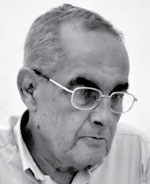
Cricket: The 1st XI team was not a normal Wesley outfit but their performance was very satisfactory. The under 13 team won 6 out of 8 matches played in the All island Division Two tournament. We lost to Holy Cross, Kalutara in the Semi Finals. Faris Mahroof was the Vice Captain of the under 15 cricket team that took part in the World tournament. He was gifted with cricket gear by the joint efforts of the OBU.
Soccer: The under 16 Soccer team reached the finals of the Colombo district. schools football association tournament, but were unlucky- to lose to Isipathana College. The match was drawn and the championship was decided on a penalty shoot-out which we lost 3-2 (In November 2000) This under 16 team also reached the semi finals of the All Island Schools Championship. Chess The under 19 team won the St John's College invitation schools championship in Feb. 2000.
Chess: Our under 17 Chess team won the Bishop's College 125th anniversary invitation schools tournament in June 2000 and the western province schools championship in July 2000.
Rugger: The under 13 squad won the All Island School's championship for the 2nd consecutive year in November 2000. The Wesley boys scored over 200points and conceded only 5points in winning all the 6 matches played.They were feted by the OWSC at Tea withe the former Rugby union President Lionel Almeida being the guest of honour. The OBU, Welfare Society and the OWSC also presented a purse to the coach Mr. Disantha Priyadarsana. If we keep this talented coach on a permanent basis we could surely see more successes in the future. The under 15 emerged Runners up at the All Islad Schools Tournament held in Oct 2000.They also participated in Malaysia where they won 4 matches and lost the semi final. Steve Perera and Lahiru Boteju were selected for the under 19 Rugby squad in the Junior Asia in Sri Lanka.
By Alfred Gogerly Moragoda CCS From the 125th Anniversary Souvenir
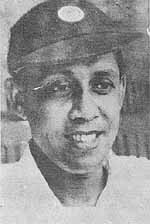 Sri Lanka's recent cricket exploits prompt an adaptation of Rudyard Kipling ' s Recessional " The tumult and the shouting have died. The Captains and their teams have departed. "The humble heart, which the Recessional terms an ancient sacrifice has been amply demonstrated by Sri Lanka's outstanding players personally. They have emphasized that the credit of success belongs to their team and not to themselves individually. However, the sacrifice for a contrite heart, also counselled in the Recessional, is hardly to be noticed anywhere. On the contrary, some even green to gloat over Sri Lanka's straight victories in the Wills World Cup matches and the Singer World Series matches, especially, and this not without some sense of justice, over its humiliation of the same adversaries in the finals of both these events. Even the newspapers have gone to town over.
Sri Lanka's recent cricket exploits prompt an adaptation of Rudyard Kipling ' s Recessional " The tumult and the shouting have died. The Captains and their teams have departed. "The humble heart, which the Recessional terms an ancient sacrifice has been amply demonstrated by Sri Lanka's outstanding players personally. They have emphasized that the credit of success belongs to their team and not to themselves individually. However, the sacrifice for a contrite heart, also counselled in the Recessional, is hardly to be noticed anywhere. On the contrary, some even green to gloat over Sri Lanka's straight victories in the Wills World Cup matches and the Singer World Series matches, especially, and this not without some sense of justice, over its humiliation of the same adversaries in the finals of both these events. Even the newspapers have gone to town over.
Sri Lanka's cricket. An editorial refers to the "decisive defeat of the Aussies for the second time" and goes on to add "our cricketing talent is truly extraordinary ... the exhilarating batsman ship of a Sathasivarn or the wicket- keeping of a Navaratne or the all round performance of a Gunasekera or Prins were the first indications of an island full of cricketing talent." All the names mentioned above are those of true sportsmen. But, perhaps, Sathasivam got more fun and joy from his cricket because he was that kind of person. It was fantastic that he was placed on remand for the murder of his wife. Those who knew him well certainly knew him as a murderer most merciless of the cricket ball.! He was the most naturally gifted batsman the world has ever .seen, the most charmingly disdainful of any kind of bowling, the most nonchalant in situations most desperate.
It was well-nigh impossible to seta field to contain him. He found than gaps with effortless ease. And he did it with artistry and finesse. It is no wonder he captained two countries at cricket. Had he played in his heyday in England, the cricket world could have placed him in no other class than that of Ranji and Duleep. These two I have not seen. But Hobbs and Sutcliffe I have, and Hammond and Bradman, and Miller and Dexter, and Worrell and Sobers. And Satha was indisputable their peer. This is only my opinion. And I have no hesitation in recording it. The bewitching elegance with which he walked to the wicket won my heart in a way in which the erect grace of Miller, the lordly hauteur of Dexter and the measured arrogance of Bradman, as they marched to their stance, failed to captivate me.
And the smile with which Satha took his place at the wicket, looking gleefully round the field noting the spot- left vacant by the opposing captain, was certainly not that of a crude and graceless murderer. So I visited Satha in the remand goal, moved by my affection, faith and goodwill. And as we talked he continue smiling with the same nonchalance he showed when he had a bat in his hand to face the wiles of the opposing bowlers in the most averse circumstances ii the cricket field. He chattily asked what his person said and what the person said about the murder he was alleged to have( committed And I told him that none of his fellow cricketers would dream that he had any hand in it The truth of this Keith Miller, Australia's greatest all-rounder clearly illustrated, when he also visited the remand to add his own quota to Satha's buoyancy.
In the course of my own visit to see him on remand the question of questions that Satha asked me was what my own wife thought about the charge that he had murdered his wife. I did not want to be untruthful. I confessed that not only my wife but all her friends, many if whom has been to her old school, were in no doubt that he had committed the murder, and they were all out for his blood Satha grinned. He had once had a skirmish with my wife's old school, which at that time had a Principal with an alphabetical name, something like Miss L. M. N O.P. The father of one of Satha's friends had a spadous jalopy. This Satha, then in his final year at school, had taken with his friends in the early hours of one morning, and in it they had loaded, as they passed by the flower pots that had the fairest flowers that ever blew in Cinnamon Gardens. Those days no garden gate was ever locked.
The morning found these flowerpots neatly arranged inside the premises of the alphabetically named Principals school. Satha and his friends were singing happy songs within its sacred walls as the maidens arrived in school. As word got around the Principal came on the scene. Satha went down on his knees. And, moving on his knees, one knee following the other in measured time, he came up to the Principal and asked her to be his bride. The Principal replied that she was still too young to think of marriage, but would keep the proposal in mind for consideration when she was old enough. Round one to the Principal. She then nicely told the gathered school boys that they has better leave in a hurry.
Some of the flower pots had been recognised by a damsel or two as belonging to their mammas, and the clamouring owners were on their way to claim them possibly in the company of the minions of the law. The Principal said she did not wish to see nice boys in trouble. They scrammed. Round two to the Principal. The next Principal of this school had the same name as the boy who did not have a penny to pay for his pie. But why should I not give the name of the chief guest she invited one year for the school prize giving. He was the Rev Lakdasa de Mel. The Principal in presenting her annual report, proudly reported that her school had won all the shields at the all island athletics meet for girls schools that year.
When it came to the Chief Guest's turn to speak he said all the nice things a Chief Guest is expected to say about teachers and parents and school girls and so on. lie also said that he was not a bit surprised, when he heard that part of the Principal's report about the prowess shown by the girls of her school in athletics, because he has always known that this school produced the fastest girls in the island. The Principal's face did not go cherry red. She smiled broadly and clapped. We loved her. When I saw Satha on remand I chose to speak of happy days. All these things, we recalled, may be to keep myself in good cheer. For Satha I had no need to cheer. He remained the embodiment of confidence and good cheer. As I left he asked me to give my wife his regards, and to tell her that, when he comes out, she is the next on his list.!
From the Editor:
From the Ceylon Sunday Times:
From the Daily News
A recent teledrama in Sinhala had implied that the real murderer was 'Sivam', in the Sathasivam Murder Case. This is grossly unfair by Sathasivam who was found 'Not Guilty'.
For more than 25 years, Sathasivam had held spectators spellbound with his vibrant batting. He played with cricketing greats like F. C. de Saram, Sargo Jayawickreme, Lucien de Soysa, B. R. Heyn, C K. Nayudu, Vijay Merchant, Mustaq Ali, Mankad, Lindwall, Keith Miller, Weekes, Worrell and Walcott. No one in Sri Lanka had scored more centuries than he. No one could set a field to him. He could always find the gaps to send the ball crashing to the ropes.
In sooth, he was a murderer of the leather ball, yet he stood indicated in the Supreme Court with the murder of his wife.
Satha had married in 1940. Relationships with his wife were not too cordial latterly and the wife filed divorce action on the grounds of malicious desertion. Satha who was in England at this time? returned to Ceylon on September 22, 1951, and in spite of the divorce proceedings, returned to his home at Alban Place, Bambalapitiya.
He lived with his wife for about two weeks. Thereafter, when he was at a friend?s house, he was served with divorce papers, on October 8. He returned to his home at Alban Place, that night.
Next day, about 8.15 a.m. the two older children left for school with the ayah.. Satha was still asleep. William, the servant had been employed by Mrs. Sathasivam, only a week before without any references!
When the children returned from school around 3 p.m. neither Satha nor William was there. Mrs. Sathasivam lay dead in the garage, which was adjacent to the kitchen. Satha was arrested around 5 p.m. at the house of his friend and charged with the murder. William, the 2nd accused, had been pardoned after the preliminary inquiry and was now a witness for the State. William who was arrested ten days after the crime, confessed that he had helped his master to kill the lady, before 9 a.m. He stated that the master had removed the lady?s bangles and gold thalikody and given them to William as a reward for his assistance.
He said that these were sold to a jeweller about 9.30 a m. Two men at the jewellers shop admitted the purchase and also confirmed the time. These jewellers were receivers of stolen property. How could one match their testimony to that of three other independent witnesses who definitely stated that they had seen Mrs. Sathasivam alive, around 10.30 a.m. The first of these was the traffic manager of the taxi company that had supplied Sathasivam with a cab, who said that a lady had phoned for a cab at 10.30 a.m. and he thought he had recognised her voice as that of Mrs. Sathasivam.
The driver of the taxi said that when he called at the house five minutes later, he saw Mrs. Sathasivam at the door when Mr. Sathasivam left in that cab. Finally, the son of Mrs. Sathasivam?s legal advisor, who was familiar with her voice, said he had a telephone conversation with her at some time after 10.25 a.m. None of them had any reason for inventing an untruth, and it seemed very unlikely that all three were mistaken.
Albert Silva, SP (Crimes) visited the scene of the murder, and acting on the evidence he collected on the spot arrested Satha. The Tangalle Police had arrested William and he was produced before the SP. The SP who had wide experience in his field, doubted William?s credibility. He played a fast one on William. Putting his hand into his pocket, he jangled his bunch of keys and said 'badu hambawuna'.
William who thought that Mrs Sathasivam's gold jewellery he had stolen had been recovered knew the game was up. He fell on the ground prostrate pleaded for mercy, and confessed with details of his dastardly performance, that it was he who single handed had murdered the lady. It is submitted, respectfully, that this confession to be admissible, should have been made before a Magistrate. The SP moved for the immediate release of Satha and William charged for the murder. However, the IGP rejected the SP?s plea, and ordered proceedings against Satha with William as a State witness. 'Honest Albert' true to his principles of honesty, bid goodbye to the force he had served with honesty and devotion.
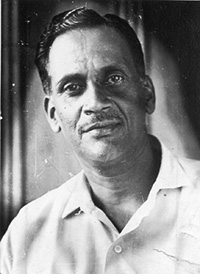 At this stage, let me deviate by stating that at that time very few knew that Satha was innocent. However there were at least three people who solemnly banked on Satha?s innocence. The other two were Christie Seneviratne, Sports Editor of the Daily News, and Alfred Gogerly Moragoda, Civil Servant. To continue, according to Prof. G. S. W. de Saram, JMO who had been called by the State, judging by the evidence in the digestive tract, the opinion was expressed that the morning meal of string hoppers had been taken about three hours before death and it was accepted that she would have died much later than 10.30 a.m.
At this stage, let me deviate by stating that at that time very few knew that Satha was innocent. However there were at least three people who solemnly banked on Satha?s innocence. The other two were Christie Seneviratne, Sports Editor of the Daily News, and Alfred Gogerly Moragoda, Civil Servant. To continue, according to Prof. G. S. W. de Saram, JMO who had been called by the State, judging by the evidence in the digestive tract, the opinion was expressed that the morning meal of string hoppers had been taken about three hours before death and it was accepted that she would have died much later than 10.30 a.m.
'One of the most important points was the fact that the soles of the lady?s feet were coated with the same dark material that had been found with the coconut fibres adhering to the abrasions on the left side of her jaw and neck. On analysis it was found to be identical with similar material taken from the kitchen floor. The Govt. Analyst also found drag marks on the kitchen floor. It seemed clear proof that she had walked into the kitchen that morning, and never walked out'. Sir Sydney Smith. Forensic expert who testified in this case which was reported in his book 'Mostly Murder', Satha who was examined soon after the crime did not have any scratches on his face or arms. William had scratches on the face and arms which looked about ten days old.
The trial lasted about 3 months and the Jury arrived at a unanimous verdict of 'Not Guilty', Dr. Colvin R. de Silva led the defence team. For the record, Sathasivam?s photograph appeares in the Wesley College M. H. Mohamed Pavilion in a prominent place. An annual Award is made in his honour to a Wesley cricketer 'For the most scintillating innings in the cricket season.'?
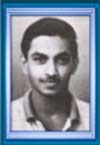 When Wesley skipper Danesh Dissanayake made his second successive century against Royal at Reid Avenue this season be achieved the rare distinction of getting those centuries on the same grounds. Danesh Dissanayake made exactly a 100 runs at Reid Avenue in 1988 and then followed up with another century of 114 against Royal this year. Of course the non-availability of the Wesley College grounds this year due to the laying of a turf wicket at Campbell Park forced the Wesley- Royal game lo be played at Reid Avenue this year too.
When Wesley skipper Danesh Dissanayake made his second successive century against Royal at Reid Avenue this season be achieved the rare distinction of getting those centuries on the same grounds. Danesh Dissanayake made exactly a 100 runs at Reid Avenue in 1988 and then followed up with another century of 114 against Royal this year. Of course the non-availability of the Wesley College grounds this year due to the laying of a turf wicket at Campbell Park forced the Wesley- Royal game lo be played at Reid Avenue this year too.
Danesh Dissanayake has been a consistent run getter and a capable medium pace bowler who did great service to the team from 1985 when be joined Wesley after doing so well at Nalanda. Danesh Dissanayake when he made die second century against Royal be broke the existing record for the highest number of centuries previously held by Brian Claessen and Lou Adhihetty making four centuries each. When Brian Claessan played for Wesley from 1951 to 1953 there was a complete rejuvenation in the game, as many watched his batsman ship which delighted them. His stature, poise and the way be stroked the ball to all parts of the field was full of glamour and sheer artistry.
During his three year spell be made four delightful memories for Wesley, 101 not out against Trinity in 1951, 115 against Kingswood in 1951, with both those innings played cm their respective grounds in Kandy. Brian Claessen also made several fifties during his career. Then in 1953 as Captain he made a fighting 105 against St.Thomas' College in the second innings of a drawn encounter led by P.I.Peiris on the Mt. Lavinia turf. In the final game Claessen made a belligerent unbeaten 157 against Richmond College, at Campbell Park associating in a record partnership with Abu Fuard who made a defiant 101. Wesley will always remember the Claessen era with nostalgia.
The next Wesleyite to score four centuries was the left hander Lou Adhihetty who made 114 against St Josephs in 1955 and followed up with three centuries, 147 against Kingswood. 104 against Trinity, and repeated his performance against St. Joseph's making 116 in 1956 at Darley Road. Brian Claessen had the distinction of playing for All-Ceylon against Len Hutton's England players in a whistle stop game at the Oval as a schoolboy along with the Thomian skipper lan Peiris in October 1953.
Danesh Dissanayake now has the privilege of surpassing these two cricketers making five centuries for Wesley during his career. Dissanayake made 107 not out against Carey in 1985 at Campbell park, 145 against Issipatana in 1987 at the Colts grounds, 100 against Royal at Reid Avenue, 105 against St Joseph's in 1989 at Darley Road and 114 against Royal at Reid Avenue. The full fledged all rounder has done quite well and in 1988 became the first schoolboy batsman to reach the golden 1000 runs.
Danesh Dissanayake during that season missed several centuries including 93 against St.Thomas at the P.Saravanmuttu Stadium. A bright prospect for the future and if recognised by the national selectors he should perform quite creditably in competitive cricket.
From Dr N D Amerasekera. This was an article written by Dayaprasad Peiris and appeared in the "Island" of 7th April 1989. He submitted this for publication in the souvenir, shortly before he passed away. He was a well-respected Freelance Sports Writer to the SL Newspapers.
I had the good fortune to be a member of Wesley's first eleven Cricket Teams during the 1950 to 1953 seasons. These were indeed our glorious Years of Cricket. Derrick Mack captained in 1950 and '51. Radley Claessen in 1952 and I lead Wesley in 1953. Wesley was placed second in the Inter-Collegiate Championship of 1950-51. The following season we took the top spot although we drew with St.Thomas' and in 1953 we had the distinction of being un-beaten Champions. It was an exciting four years of Cricket with Mr.A.V. Fernando as our honorary coach. Every player was self-motivated and totally committed to the task of winning. Wesley had the capacity to bat right down to number eleven. There were batsmen of sheer elegance, possessing every stroke in the book, and there were others with solid defence. Our fast bowlers were awesome whilst others had the ability to swing the ball with great control and our spinners had a natural gift of luring the unsuspecting batsmen to venture out of their crease at their peril. It was of course good fielding that made the difference because it restricted our opponent's ability to score. It generally made batsmen hesitant and negative in their approach and frustrated them as they repeatedly failed to penetrate the field. Good fielding of such a high standard provided our bowlers with confidence, which is an ingredient so virtually necessary in the battle for supremacy between bat and ball.
 There were two other aspects of paramount importance to Wesley's successes. First, we had an unrelenting determination; a will to win.We always played hard and we always played fair. Secondly, the players had the benefit of knowing that the whole school - teachers and students alike, without exception, were supporting them all the way. The intensity of support was inspiring and we were all fired -up for action by the famous War-Cry originated by Rev. James Cartman (Principal 1945-49) Because of this dedicated support and the sense of total unity that prevailed, the successes of our Golden Years must surely belong to all Wesleyites of the time and our achievements remain as their most cherished recollections to this very day. Be that as it may , we had our moments of nail- biting concern and one such occasion was our 1951 encounter with Prince of Wales College at the Campbell Park Grounds. Prince of Wales insisted that one of their teachers should umpire. This made it necessary for oar Coach to join him as a matter of courtesy. During the first Innings, Prince of Wales scored 142 runs which we considered to be an easy target for Wesley because of our very strong batting line-up. That assumption proved disastrous. Apart from a couple of small partnerships, Wesley made a right royal mess of things to find itself at a very precarious eight (8) wickets for around 100 runs. This was when George Jayatunga joined S .Musafer, our keeper.
There were two other aspects of paramount importance to Wesley's successes. First, we had an unrelenting determination; a will to win.We always played hard and we always played fair. Secondly, the players had the benefit of knowing that the whole school - teachers and students alike, without exception, were supporting them all the way. The intensity of support was inspiring and we were all fired -up for action by the famous War-Cry originated by Rev. James Cartman (Principal 1945-49) Because of this dedicated support and the sense of total unity that prevailed, the successes of our Golden Years must surely belong to all Wesleyites of the time and our achievements remain as their most cherished recollections to this very day. Be that as it may , we had our moments of nail- biting concern and one such occasion was our 1951 encounter with Prince of Wales College at the Campbell Park Grounds. Prince of Wales insisted that one of their teachers should umpire. This made it necessary for oar Coach to join him as a matter of courtesy. During the first Innings, Prince of Wales scored 142 runs which we considered to be an easy target for Wesley because of our very strong batting line-up. That assumption proved disastrous. Apart from a couple of small partnerships, Wesley made a right royal mess of things to find itself at a very precarious eight (8) wickets for around 100 runs. This was when George Jayatunga joined S .Musafer, our keeper.
It was reported on the grape vine that "Mus" as he was affectionately known was constantly looking up towards a bright blue sky on a blazing hot afternoon. The coach who was by this time quite disgusted by our efforts, unobtrusively moved upto us and whispered What the hell are you looking up for ?" Mus was quick to respond. "It might rain. Sir", he said. Yes, there was no doubt Mus was praying for a miracle like the rest of us. What we didn't know was that Mus wasn't going to surrender his wicket without a fight. George and Mus moved the score along steadily and then right out of the blue Mus pushed the ball into the covers and took off for a run like a scalded cat. The fielder lunged forward, picked up the ball and hit the stumps at the Welikada Gaol end. Mus was half way down the pitch but he kept running as if he wanted to reach the gaol to incarcerate himself for his grave error of judgement. He charged into the stumps flattening them in the process.
 The fielders appealed and jumped around in glee but the Umpire was confused as he pondered if it was MUS who brought the stumps down , and according to the best traditions of this great game, the Prince of Wales Umpire gave MUS the benefit of the doubt. Such an incident should be sufficient to create a climax to bring this story to a conclusion but not so, with MUS at the centre wicket. He was out to the last ball of the over, caught Senaratne, bowled Sooriyaratchi for 20 runs when the scores were dead level. T.Allallasunderam at number 11, Wesley's fastest sprinter at the time strode out to bat. He walked straight up to George Jayatunga, who was to take the strike and nervously announces "Push and run, George" and that is exactly what they did to win the game. In this the School's 125th Anniversary, I join in the spirit of Celebrations and wish Wesley success in all its endeavors - both on and off the field. As a means of paying tribute to the gallant players and perhaps to refresh some fading memories I now give the names of all the cricketers who were a part of our glorious early 1950's.
The fielders appealed and jumped around in glee but the Umpire was confused as he pondered if it was MUS who brought the stumps down , and according to the best traditions of this great game, the Prince of Wales Umpire gave MUS the benefit of the doubt. Such an incident should be sufficient to create a climax to bring this story to a conclusion but not so, with MUS at the centre wicket. He was out to the last ball of the over, caught Senaratne, bowled Sooriyaratchi for 20 runs when the scores were dead level. T.Allallasunderam at number 11, Wesley's fastest sprinter at the time strode out to bat. He walked straight up to George Jayatunga, who was to take the strike and nervously announces "Push and run, George" and that is exactly what they did to win the game. In this the School's 125th Anniversary, I join in the spirit of Celebrations and wish Wesley success in all its endeavors - both on and off the field. As a means of paying tribute to the gallant players and perhaps to refresh some fading memories I now give the names of all the cricketers who were a part of our glorious early 1950's.
Editors of Note: Bryan Claessen Captained the Wesley Team in 1953. In 1953, he was selected to play for Ceylon against, Australia skippered by Lindsay Hasset. Bryan was one of Wesley's best exponents of spin bowling, which included the "googly" He now lives in Australia.
Links to further reading
From South Australia
Transcribed from the Wesley College Archives
1st XI Team 1952

The four year period under review represents the "Golden Years" of cricket at Wesley. It is the period when our performances against Royal were indeed commanding. They were the seasons when we reigned with confident authority and it was a time when even the Royals bowed to Wesley's masterly sway.
It all started way back in 1946, when Edmund Dissanayake captained Wesley. He was an energetic player and an astute leader who set about his task with the firm belief that Wesley was second to none. At about the same time, a new breed of junior cricketers were being groomed by the late A.V. Fernando, an old boy of the school who represented Wesley with much distinction in his time. The newspaper article dated the 22nd of May 1948 and reproduced in the following pages, tells the story of Wesley's success at the junior level, when our under 14 team simply hammered a strong English junior eleven into total submission on their home ground at Nuwara Eliya. That was perhaps, one of the earliest signs of Wesley stirring to emerge as a dominant force and of Wesley lads beginning to realize that it was important to stand tall and to hold their heads up high, with pride.
This attitude, that we were as good, if not better than our opponents, was rather contagious. It certainly infected Wesley's leadership thinking for many years to come. It permeated through to succeeding captains, from Harold Matthysz (1947 - 48); W.P.S. Abeywardene (1949); Derek Mack (1950 _ 51); Radley Claessen (1952) and then to me in 1953, when Wesley remained unbeaten. It had taken eight years from 1946 to strike the highest note of the octave. We were at long last the unconquered champions of intercollegiate cricket.
In this centenary year of cricket against Royal College, I am pleased to recall past events; to remember all those who were a part of it and in particular, the contribution made by the late A.V. Fernando to coaching at Wesley and to recognize with a measure of satisfaction and pride, our achievements on the field.
I must also freely confess that I am compelled to pay high tribute to our gallant Royal opponents, who always fought fair and hard. In recalling the past, it becomes evident that a lesser rival would undoubtedly have succumbed to the might of Wesley far more readily. Players of the calibre of Channa Gunasekera, U. de Silva, Nirmalingam and S.S. Jayawickrema, to name just a handful, were talented and extremely determined cricketers. They were all tough players who were hard to beat and the results of matches will be sufficient proof of that. It is with this in mind that one must approach the task of assessing our own endeavours and achievements.
As for Wesley, we too had our fair share of competent players. S. Musafer for example, was one of the very best keepers in the island. He was equally at home with the fast bowlers as he was with spin, when he would whip the bails off at the twinkiling of the eye, to produce an ostensibly easy stumping. "MUS", as he was affectionately called, was somewhat unfortunate because of the abundance of good batsmen in the side precluded him from showing his skills with the bat. When it came to batsmen, we had a great stack of them.
The Mack brothers (Derek & Spencer) brothers who helped themselves to a few runs; the Abeywardene brothers (Lucky & Sirima) both very attractive bats; the Fuards (Ansar & Abu) who were skillful and dependable and the Adhihetty brothers (Lou & Vincent) who played with much success. Apart from this unique collection of brothers who represented Wesley at about the same time, there were the true fast bowlers in Radley Claessen and M.N Samsudeen who struck terror into the hearts of many a capable batsman.
They were indeed following the examples set by past fast bowlers of the stature of Norman de la Harpe and the late Clive Bartholomeusz who operated in the mid forties. Then there were the other equally fine players in Herbie Felsinger, Dennis Ebert, Pat Shockman, George Jayatunge, A. Casiechetty, G. Abeysooriya, G. Nanayakkara, N. Fernando, B. Jurangpathy, D. Range, T. Allalasunderam, Arthlow Champan, Neil Gallagher, N. Fernando, R.M. de Silva, A. Battuwitage and B. Perera.
The most significant aspect is that these players were all exceptionally good fielders. Allalasunderam however stood out because, apart from his safe hands, he had the speed and stamina of a race horse. Many will remember him most, for his ability to cover and protect a wide arc from fine-leg to long-on with absolute ease.
It is clear that Wesley had many skillful players. The contributions they made, together with a determination to win and a natural propensity to play as a team, produce the results which we now eagerly and spontaneously applaud.
The newspaper articles on our encounter with Royal in 1950 are regrettably the only ones not kept by father. I do recall however batting with some success and concluding the first day's play in partnership with Radley who did his best to shield and pamper me, as I was at the age of 15 years, the baby of the side. I have been in touch with Radley by phone and he confirms that the 1950 game against Royal was drawn.
As for the three succeeding years to 1953, let our battles against the Royals be described by fair and independent journalists who witnessed the games at the time. Some of the articles reproduced hereunder have been restructured by excluding non-Wesley material to reduce them to convenient sizes. It is with a great deal of pleasure that I present the facts of Wesley's triumphant march on the Royals from 1950 to 1953 and trust they will help revive and refresh some old and wonderful memories.
From the South Australia Cricket Association By Robert Mitchell
 It was with much sadness that Prospect Cricket Club learnt of the passing of former Club President, Bryan Claessen, on 16th March 2010, at the age of 74. Bryan was a well liked, admired, respected and skilled player, administrator and in particular, a friend.
It was with much sadness that Prospect Cricket Club learnt of the passing of former Club President, Bryan Claessen, on 16th March 2010, at the age of 74. Bryan was a well liked, admired, respected and skilled player, administrator and in particular, a friend.
Bryan’s cricket journey started in his native Ceylon (now Sri Lanka), where as a young school boy he played First X1 for his beloved Wesley College, at the tender age of 14. Bryan would vividly recall his days as a young cricketer at Wesley College, under-playing his performances and roles in the teams whilst enthusiastically emphasising the skills and exploits of his team-mates. I remember the passion and admiration that Bryan would describe the all- round skills of his older brother and captain, Radley Claessen. Radley had a unique ability to assess the situation and bowl with ferocious pace to intimidate impatience from the opposing batsmen, to bowlers from the “other end” hoping to take wickets, prevent runs being scored, to secure victory or avoid defeat.
Bryan captained an undefeated Wesley College Team in 1953, with a School record 4 centuries, splendid fielding exploits in the gully and outstanding bowling contributions, the best being a 9 wicket haul! Bryan was a gifted young all-rounder attaining All Ceylon (prior to Sri Lanka gaining Test Status) selection, whilst still at School. He played against Peter May’s England and Lindsay Hassett’s Australian Teams with skill and aplomb,belying his youth which elevated him personally to a reluctant local legend! This was evident at a National Under 19 Test at Adelaide Oval in 1985, when Bryan was greeted with enthusiasm by the Sri Lankan Under 19 Management Team and many supporters. Bryan emigrated to Australia in 1957, initially settling in Perth, where he became the 99th player to play First X1 for the mighty South Perth Cricket Club, a place Bryan remembered with great fondness, for his social and cricket achievements.
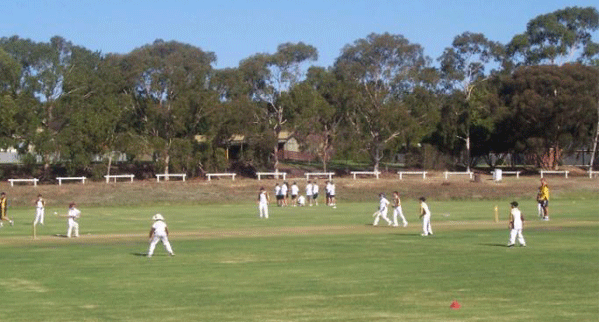
Bryan moved to Adelaide in 1960 and joined the Sturt District Cricket Club and continued his love of cricket, playing eight A Grade matches over three seasons. Romance and home security moved Bryan to Modbury, where he and wife Carol, established their home. Bryan was determined to play cricket for as long as he could and the Modbury Cricket Club became the family’s second home. Carol would pack a picnic lunch so all the children (5), could share in Bryan’s delight and enjoyment of cricket. Bryan was held in great respect at Modbury, progressing through the grades and becoming President in the early 1970’s. Many stalwarts of Modbury recall his cricket ability but they delight in the entertainment and social skills of their own royalty; Bryan was most affectionately known as the “Black Prince”. Bryan and Carol would host events for 75 cents to $1-00 per head, decorate the “old shed”, and thoroughly enthral patrons with their catering and social skills.
In the late 1970’s Bryan moved his cricket support to Prospect! He took on the role of President and was a skilled administrator, who presided over two controversial matters, the Graham Winter non-clearance to University and the infamous “non-permit” saga of the 1981-82 C-Grade and D-Grade Finals campaigns! After the latter saga, Bryan was convinced that with another day’s notice, he would have secured permits for all those players, but he was denied and hence an opportunity to play in a Grand Final was lost.
1982-83 was indeed Bryan’s greatest triumph, as a 48 year old he won the coveted Club Champion award and was part of the D Grade Premiership side!!! His post match “Pitch Blessing” and Clubroom Celebrations are still carved in the memory of those fortunate enough to be present! A rural relocation did not deter Bryan’s desire to play cricket, playing several season for Tailem Bend, after moving there in 1987-88.
Bryan was a devoted husband and dedicated father, taking great interest in the pursuits of his children, with wife, Carol, at his side. He was extremely proud when Cass made the State Under 21 Women’s Cricket Team and this pride was matched when Julian and Thomas represented Prospect in their Junior Age Teams. He was most proud on the birth of his grandchildren and insisted that they all call him Bryan - it was his name after all. Bryan was always considering ways and methods of helping others, often making significant personal sacrifices along the way. He had a unique ability to recognise talent and then actively encourage further development, on and off the sporting field. He would not seek the spotlight but it somehow found him, where he was a confident and skilful performer, very similar to his cricketing abilities.
Bryan had three great passions, cricket, his family and Carol, his wife. God bless them all. A humble man, a fine innings concluded but memories eternal!
Rest in Peace
Links to further reading
- Elton Bryan Claessen - In Memoriam 18/3/2010 -
- Cricketers of 1953 - Sent by Olkie Edema -
- A Tribute to Sir Donald Bradman- A Poem by Bryan Claessen -
- Some Memories of cricket of the 1950's sent by Bryan Claessen -
- Bryan Claessen by Dr.N.D.Amerasekera -
- Lunch with the Claessens - From the OBUA Newsletter 2005 -
- A Letter from Bryan Claessen sent in 2009 -
Vincent Joined the Ground Staff in 1958 Ranis, the bell-ringer, quite seriously told me, that be would not fit in, because "he was wearing shoes". But following the good example set by Wilbert, Vincent served the School with great acceptance till he resigned in 1985, after a period of 27 years. His family lived about 25 miles away, but he seldom took leave of absence. He was dependable, courteous, thorough in his work, and absolutely efficient. ' One incident about his integrity is recalled. When the School wanted to purchase a set of balls for practice, he made available 24 Kookaburra Balls used in the previous season. (Most ground boys used to sell used balls for a few rupees). Cricketers who knew him were full of praise for Vincent. Men of his calibre are a rare commodity today.
 Neville Dias Abeygunawardene passed away on Christmas night after a long illness. He was 73 years at the time of his death.Well known as one of the most outstanding mentors in local football, Neville’s knowledge of the birth and growth of the sport in Sri Lanka in his book titled "50 years of Association Football in Sri Lanka (1939 - 1989)" made Neville a moon among the stars in the profession.
Neville Dias Abeygunawardene passed away on Christmas night after a long illness. He was 73 years at the time of his death.Well known as one of the most outstanding mentors in local football, Neville’s knowledge of the birth and growth of the sport in Sri Lanka in his book titled "50 years of Association Football in Sri Lanka (1939 - 1989)" made Neville a moon among the stars in the profession.
It was the day after this writer had completed reading his book that he visited the maestro at his then residence down Pepiliyana way.After a long chat with Neville, mainly on football here and abroad, I felt almost bewildered at the colossal knowledge of the game, he was endowed with. His command of expression always kept the listener spell bound. Neville one of my close friends for over three decades was hail and hearty then.Abeygunawardene was responsible for Sri Lanka’s victories over Burma, India, Pakistan and several professional European clubs which visited our land.
Matchless
When it came to intricate questions of coaching, Neville was matchless, simply brilliant.
Explaining the varied patterns, systems, methods and tactics in modern football, he made it obvious that our standards in these aspects were almost pedestrian.To his few detractors who accused Neville of being a theoretician and hardly practical, Neville simply smiled and said "the proof of the pudding is in the eating".Neville, saw red on hearing of misdeeds and mismanagement. Speaking to this writer in his ancestral home in Eheliyagoda, Ratnapura he said that, "excusable are the wrongs done through blissful ignorance but woe be unto those who wittingly err for personal gains and selfish ends".Being a thorough disciplinarian and deeply technical oriented his approach to administrative matters vastly differed from the usual stereotype approaches.
Young coaches
"There are so many up and coming young coaches in our country and if correctly directed, they could be as good as any other in Asia.The pleas for foreign coaches by some is not only plain cock and muck, but a total admission of an inferiority complex in them," Neville, once told this writer.Neville learnt to play the game when he was a tiny tot at Sivali Vidyalaya, in the 'City of Gems'. He was eternally grateful and proud that Ratnapura provided him with all the opportunity to learn and play football for years.Neville ended his school career at Ananda College, Colombo, where he shone both at football and cricket.
Serious entry
Neville’s serious entry to football was in Kandy, where he teamed up with the late Tom Ossen for Youngsters SC. While Ossen went onto win international playing honours, Neville, as coach had the privilege of coaching the amiable Ossen in the national squad. Neville also played for Nugegoda District and was a good ball player.After training himself under the then England national football manager Sir Walter Winterbottom and that great English coach, Billy Wright, Neville continued his training in East Germany and France.The author of two books on football and volumes of writing on the sport, he was also a highly gifted poet.
Archives of English FA
His felicitation of the FIFA presented in rhyme was not only hailed by the world body as a brilliant original, but also achieved a place in the archives of the English FA.He started his coaching career in 1955 with the Wesley College team and was the first national coach of the Maldives.Sacked and suspended twice, resigned thrice, subject to fourth floor interrogation and several inquiries, filed litigation against authority a number of times, all in the course of a colourful football career, the firebrand, was always very much lively and alert, with a razor sharp tongue that gave expression to his brilliant mind.
Neville Abeygunawardene pioneered a fundamental change
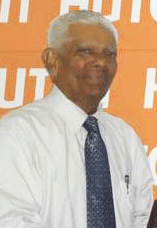 Neville D. Abeygunawardena is a person who pioneered for a fundamental change or reversal of conditions or ideas in the field of soccer in this country in the 1960s and 1970s for the betterment of the game. He was an instigator, a coach who revolutionised the game of soccer in Sri Lanka. His contribution to soccer was enormous. He was a man of many parts, a rebellion, who always stood for fair play, justice and for the rights of the footballers and their welfare. As a coach and soccer administrator, he was a staunch disciplinarian, who always called a spade a spade.
Neville D. Abeygunawardena is a person who pioneered for a fundamental change or reversal of conditions or ideas in the field of soccer in this country in the 1960s and 1970s for the betterment of the game. He was an instigator, a coach who revolutionised the game of soccer in Sri Lanka. His contribution to soccer was enormous. He was a man of many parts, a rebellion, who always stood for fair play, justice and for the rights of the footballers and their welfare. As a coach and soccer administrator, he was a staunch disciplinarian, who always called a spade a spade.
Neville, hailed from an aristocratic family from Thalgaswela Walauwa, Eheliyagoda. He was an outstanding soccerite, who served as our national football coach for many years, and did yeoman service to the poor man's game.The golden era of Sri Lanka's soccer dawned under his stewardship as national coach. The players like that gentlemen Peter Ranasinghe, Mahinda Aluvihare, Hasim Deen were some of his brilliant products.
He was born on 29th March 1930. He was an uncompromising disciplinarian.Accompanying the wrath amongst the administration saw him sacked thrice as the national coach, yet, brought him back by popular demand of players - a rare achievement indeed. Neville took V. A. Sugathadasa and Vincent Perera to courts and on each occasion, he came victorious. Football was his life.He was a versatile writer too. He authored two books on soccer, one of which is the history of Sri Lanka football. His presentation to FIFA in poetry was hailed. It was titled Viva FIFA. It is the only contribution in the archives.
 In the years gone by, soccer was a popular sport in Ratnapura. He studied at Seevali Maha Vidyalaya, adjoining Kalu Ganga. He played soccer for the Ratnapura side in the years 1945 and 1946. He was interested in cricket too.In 1947, he joined Ananda College, Colombo. His parents were keen to take him out from Seevali as he was a mischievous boy. He used to jump into Kalu ganga and swim. As he had 'two sullis' on his head, the parents, for his safety brought him to Colombo. They say that a person with 'two sullis', will die in water.
In the years gone by, soccer was a popular sport in Ratnapura. He studied at Seevali Maha Vidyalaya, adjoining Kalu Ganga. He played soccer for the Ratnapura side in the years 1945 and 1946. He was interested in cricket too.In 1947, he joined Ananda College, Colombo. His parents were keen to take him out from Seevali as he was a mischievous boy. He used to jump into Kalu ganga and swim. As he had 'two sullis' on his head, the parents, for his safety brought him to Colombo. They say that a person with 'two sullis', will die in water.
One of his contemporaries at Seevali was internationally reputed Joe Abeywickrema. Further Soma Udabage was also a classmate of Neville. English literature and Latin were almost compulsory at Seevali during this period.After joining Ananda, he attended cricket practices with Molligoda, Hewavisanthi, Bonny Wijesinghe and Bobby Wickremasinghe. He was an all-round student - a member of the Sinhala and English debating teams at Ananda College.
Although, Neville did not represent the country, he played for a leading club Harlequins. Due to an injury, he have to give up playing. Then, he took up to coaching. He was a vociferous reader on soccer. First, he coached Wesley College, where they became unofficial champions in soccer in 1952/54.
He coached the national football team for 18 years. He was a controversial figure. He was removed as national coach thrice by V. A. Sugathadasa, Vincent Perera and Kitchilan. He went to courts and won. In 1962, for the first time in the history of soccer in Ceylon, the entire national team went on strike. They walked out of the national camp pool. Peter Ranasinghe was his captain. Football President V. A. Sugathadasa suspended, Neville and the team for five years. Neville took Sugathadasa to court. E. R. S. R. Coomaraswamy appeared for Neville and Neville Samarakoon, former Chief Justice appeared for Sugathadasa. Neville and the Sri Lankan players won the case and they were all re-instated.
Not only in Sri Lanka, he was the national coach of the Republic of Maldives for six months. He took the Maldivian team to Larecenion Island in Madagascar. Maldivians lost to Cameroon 2-1.In 1968, pre-Olympics against Israel in Tel Aviv for 70 minutes the scores were nil. Sri Lanka goalie Hasim Deen was trampled. Lionel Pieris was replaced as the custodian.Last 10 minutes they scored two goals. Some of the players who played against Israel were Mahinda Aluvihare, S. P. (Sene) de Silva, Barjoos Sourjah, Hashim Deen, Edward Wickremasuriya, Jainulabdeen.Neville's greatest achievement as the national coach was the first international win over Pakistan. Then, Sri Lanka beat First Division Club of Switzerland - Swiss Red Star.
Neville, firmly believed that there must be nurseries - to improve soccer standard in Sri Lanka. "You have to tap them young," he said.Outspoken Neville served at the Wellawatte Spinning and Weaving Mills for 20 years in the personnel division. In 1978, he joined Mercantile Credit.During the latter stages of his life be became a victim of cancer and died a couple of years back. It was definitely an irreparable loss to Sri Lanka soccer. He was a honest, dedicated person, who helped many soccerites in Sri Lanka.
His wife's Gladys, was a great inspiration to him. When he was sick, Gladys and children - Rohan, Roshan, Ronald and Romaine looked after him and treated him well. But, unfortunately they could not save this versatile sportsman cum coach.
By Edmund Dissanayake
 Dharshika Jayakody, Wesley's cricket captain has broken all batting records. As at 1st November 98', he has notched up 8 centuries. Of the 18 Inter-Collegiate matches arranged by the School, 13 more remain to be played, and one can reasonably expect Jayakody to increase his tally. In 1997, Jayakody scored 116 Vs St. Joseph's, 131 Vs Kingswood, 110 Vs Trinity, and 136 Vs Richmond. In 1998, he scored 125 Vs St. Thomas, 126 Vs Carey, 101 Vs Nalanda, and in the third term of 1998, 171 not out Vs Maris Stella. Jayakody began to blossom as Captain of the Under 15 team. He is grateful to his Junior coaches Messrs. Buddhadasa, Kodituwakku, and W. A. N. Silva who nurtured him in the formative stages.
Dharshika Jayakody, Wesley's cricket captain has broken all batting records. As at 1st November 98', he has notched up 8 centuries. Of the 18 Inter-Collegiate matches arranged by the School, 13 more remain to be played, and one can reasonably expect Jayakody to increase his tally. In 1997, Jayakody scored 116 Vs St. Joseph's, 131 Vs Kingswood, 110 Vs Trinity, and 136 Vs Richmond. In 1998, he scored 125 Vs St. Thomas, 126 Vs Carey, 101 Vs Nalanda, and in the third term of 1998, 171 not out Vs Maris Stella. Jayakody began to blossom as Captain of the Under 15 team. He is grateful to his Junior coaches Messrs. Buddhadasa, Kodituwakku, and W. A. N. Silva who nurtured him in the formative stages.
Under the watchful eye of Bandula Warnapura, presently head coach, very much more could be expected from Jayakody. His father, a former Bank Executive, has given him all the encouragement that he required. Jayakody is also an excellent off-spin bowler, his best being 6 for 54 against Prince of Wales in 1997. It is important to bear in mind that individual performance alone will not help to produce good cricket What is most important is collective team-effort that will produce glorious victories as evidenced in earlier years.
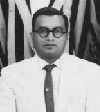 Roshan David became the second Wesley cricketer to score 5 Centuries for the School, when he scored 107 runs against Mahinda College in 1991. His earlier centuries are as follows:
Roshan David became the second Wesley cricketer to score 5 Centuries for the School, when he scored 107 runs against Mahinda College in 1991. His earlier centuries are as follows:
In 1989 he scored 108 Vs. Carey, 150 V Mahanama, 100 Vs Issipatana. In 1990, Roshan created a batting record when he scored 199 Vs Royal at Reid Avenue. He was unfortunate to miss a double century by just one run. David's 199 included 33 hits to the ropes In addition, David had a big score of 89 V St. Sebastian in 1990, and a good bowing performance of 8 for 97. David captained the School in 1991. He was left handed batsman, and a right handed spin bowler. He should go far in cricket if the Cricket Board takes a close look at him.
Across the seas to a land so far away.
At home no rattling boundary picket.
It's quiet, now that Don's in the real fray.
May the big, tall ship carry him safe,To England.
the place where he is dreaded most.
May his willow wand some magic make
And in that country many a hundred post.
A breathless silence; he takes his stance.
Those nimble feet, we could almost see them dance.
Back and across he shuffles to glance,
As on his first run to our joy he does prance.
He is off the mark and on his way,
To shouts of great joy from here to Ameroo.
And we in the bush in silence pray
For the Don to make another ton or two.
Our little town in darkness shrouded.
Only the sound of sheep in the shearing shed.
Men women and children all crowded;
Listening to every word of the game that's said.
He drives to cover and there's a cheer.
A pull, a cut, a hit to the long-on fence.
We bite our nails as the ton draws near
And hold our breath, as we stare in mute suspense.
A nation begins to breathe again,
As a nervous silence yields to loud applause.
With that I awake to feel the pain;
For Don's gone and I must now in honor pause.
Our Don has gone a playing cricket.
Across the sky to a place he'll be safe I pray.
At home no rattling boundary picket.It's quiet,
for Don has left and gone away.
 The cricket match between Trinity and Wesley played at Campbell Park in 1956 will be remembered for the splendid sportsmanship displayed by Trinity in bowling as many as 6 overs in 12 minutes (no mandatory overs then) and not employing "delaying tactics" to baulk a Wesley victory. In the final innings Wesley were left with 12 minutes to score 49 for victory. To the eternal credit of the Trinity players, they refrained from employing "delaying tactics." They did not delay unnecessarily in setting the field, nor did they delay between overs. If one were to leave 3 minutes for an over, only 4 overs would have been possible. But Trinity bowled as many as 6 overs. The way that these two senior cricket schools played the King of Games that day, was an object lesson to everybody. "For when the One Great Scorer comes to write against your name, he writes not whether you won or lost, but how you played the game". It is also relevant to record that Trinity’s coach was none other than "Gentleman" Hilary Abeyratne, presently in Australia.
The cricket match between Trinity and Wesley played at Campbell Park in 1956 will be remembered for the splendid sportsmanship displayed by Trinity in bowling as many as 6 overs in 12 minutes (no mandatory overs then) and not employing "delaying tactics" to baulk a Wesley victory. In the final innings Wesley were left with 12 minutes to score 49 for victory. To the eternal credit of the Trinity players, they refrained from employing "delaying tactics." They did not delay unnecessarily in setting the field, nor did they delay between overs. If one were to leave 3 minutes for an over, only 4 overs would have been possible. But Trinity bowled as many as 6 overs. The way that these two senior cricket schools played the King of Games that day, was an object lesson to everybody. "For when the One Great Scorer comes to write against your name, he writes not whether you won or lost, but how you played the game". It is also relevant to record that Trinity’s coach was none other than "Gentleman" Hilary Abeyratne, presently in Australia.
In 1946, in the match between Royal and Wesley, Harold Matthysz of Wesley was given out to a catch that went off his boot. Mahes Rodrigo the Royal skipper, recalled Harold to the wicket. Shortly after, Mahes played for All-Ceylon. Again, in a match played on the Nalanda Grounds, Royal skipper, Sarath Samarasinghe, (who was also wicket-keeper) who had the ball in his hands, refrained from running out the opposing batsman as he had collided with a Royal fielder in the middle. In the early sixties, Wesley batsman Milroy Jebarajah, aware that he was out caught behind, walked back to the pavilion, although there was no nod from the umpire. On that occasion, the President of the Umpires’ Association, Dodwell Soysa, who was an eye-witness to the incident, presented Jebarajah with a bat, on the following day.
There is the case of Danesh Dissanayake, Wesley’s opener who did likewise in the match against Thurstan in 1986, being applauded all the way to the Pavilion, it will be recalled that Danesh captained Wesley in 1989, and was selected as "The Ceylon Schools’ Best All-Rounder". He is presently in Australia. Again Wesley Captain Mahendra Dissanayake went halfway to the pavilion to recall an Isipatana batsman who had been given out caught. But sad to say, when Mahendra was on 85, a feeble solitary appeal for L. B. W, was upheld, when he attempted to glide a ball outside the leg stump. Sometimes it is dangerous to be too good! He too is presently in Australia. He was selected as "The Sports Star" in 1985.
From "The Hindu" the Indian daily
Cricket in Sri Lanka is founded on the schools. And in the honours system in schoolboy cricket, the batsman always takes precedence over the bowler. At that level, to score 50 or 100 is more generously rewarded, by fellow schoolboy and teacher alike, than to take four or five wickets. This background might explain why that beautiful, fractured island has produced so many great batsmen but very few bowlers of true international class. The doyen of Sri Lankan batsmen was undoubtedly F.C. (Derek) De Saram. He was born in 1912, into a home of sport and privilege. De Saram was an upper class Burgher who studied at Royal College, Colombo, before going up to Oxford in 1932. Here he was treated shamefully by the cricket authorities (as, years before at Cambridge, had been the experience of another brown-skinned aristocrat, K. S. Ranjitsinhji). They would not even give him a net, so he went off instead to the tennis courts. Here the equation was man-to-man, and the colour of one's skin did not matter so long as one beat one's opponent 6-0, 6-0. De Saram got his tennis Blue two years in a row, then tried his hand once more at The Parks. He was picked for the game against the visiting Australians, scoring an immaculate 100, this against Clarrie Grimmett and Bill O'Reilly, who otherwise carried all before them that summer. Of an Oxford total of 216, last year's reject made 128 (96 of these in boundaries), a lowly 16 being the next highest score. Three of his four sixes were hit off Grimmett. De Saram had now to be chosen for the University match, where he stroked a silken 85 in two hours at the crease.
While De Saram played active cricket, he got, on the average, one chance every five years to bat against bowlers of quality (there were none at home). From what he did to them we may consider him to have been a player of high class. In 1936 he played for Minor Counties against the Indian touring side, being "merciless" on Mohammed Nissar and Amar Singh, a pairing almost as deadly with the new ball as Grimmett and O'Reilly were with the old. He returned to Colombo the same year, his Oxford degree safely in his pocket. Then in November 1937 he was invited by the Catholic Gymkhana of Bandra to play for "The Rest" in the Bombay Pentangular. It was the first time this team of leftovers had made its appearance in the tournament. Also chosen for The Rest, and accompanying De Saram on the boat from Colombo, was the Buddhist opening batsman S. S. Jayawickreme, who had once battled with Derek for Royal College.
In the winter of 1932-33, while his mate was cooling his heels in Oxford, Jayawickreme was enjoying a fine tour of India with a Ceylonese team, scoring 50 and 100 in the two representative matches, being especially severe on Mohammed Nissar. When The Rest played the Muslims they were without Vijay Hazare, but even in his presence De Saram would have assumed, as of right, the mantle of leading batsman. He scored 50 in the first innings, his compatriot Jayawickreme contributing 67. When the Rest were set 266 to win in the fourth innings, Jayawickreme was out early for a duck, and the leg spin of Amir Elahi was too much for most of the others. But De Saram stayed till the end, scoring 133 not out with 22 boundaries, drives and cuts in the main, taking his side to within 33 runs of victory. This was the first ever competitive first-class match organised at the Brabourne Stadium, and De Saram's remains one of the finest innings played at that once famous, but now neglected, cricketing venue. Almost 20 years after he battled Elahi, De Saram came up against another show bowler of quality, Johnny Wardle. With the rest of Len Hutton's M.C.C. side bound for Australia, Wardle had stopped in Colombo to play a one-day match against All-Ceylon. De Saram, by now well into his forties, picked Wardle off his toes for six and then hit him repeatedly over extra-cover: the kind of treatment the Yorkshire left-armer never received from the stay- at-home English batsmen.
The poet Alan Ross, who was covering Hutton's tour for The Observer, wrote that "Wardle must have thought himself faced by a species (of batsman) newly arisen from the ocean". So long as the journeys were made by boat between Australia and England, touring teams bound for one or other country would stop en route at Colombo. Bradman played there, as did Miller, Compton, Statham and Hutton. The talents of the home side in these pick-up matches so impressed Jack Fingleton that he suggested that the best Ceylonese cricketers, like De Saram, be considered eligible for selection to Indian Test sides. The Indians, always patronising towards their little neighbours, offered instead to allow Ceylon University to enter the Rohinton Baria Trophy, and to organise an annual three-day match between the state side of Madras (later Tamil Nadu) and Ceylon (not yet Sri Lanka), played for the Gopalan Trophy, this named after the Madras fast bowler and double international. In the first of these fixtures, played in 1952 at Chepauk, De Saram was captain of Ceylon. He would, in most people's judgment, be skipper of an all-time Sri Lankan eleven as well.
This selection would not, perhaps, be based on his batting genius alone. For De Saram was, by both nature and upbringing, an autocrat. In 1962, by which time he had put away his kit for good, he was a key figure in the right-wing, military-aided attempt to unseat the democratically elected government of S.W.R.D. Bandarnaike. The coup failed, and De Saram was incarcerated for a long time in Colombo jail. In the late 1960s he was visited in prison by his fellow Oxonian and batting stylist, Colin Cowdrey. Cowdrey - who had chased some of those hits off Wardle back in 1954 - reported later that for their meeting the old warrior had put on his M.C.C. tie. A near contemporary of De Saram was Mahadevan Sathasivan. "Satha was from a prosperous business family, yet the elite St. Thomas's College rejected him, possibly because he was a Tamil. He joined the rival Wesley College, then hit a double century against the school which would not have him. Satha was a cricketer who liked the high life, a wanderer who went on to captain no less than three countries at the sport he chose to play in the daytime. Madras cricket lovers still speak in wonder of the 215 he scored in four hours of magical batsmanship at Chepauk for Ceylon against South Zone in 1947, this knock a strong claimant for the title of best innings ever played on that great ground.
 When Satha went into bat his manager said he would present him a bottle of Scotch if he made 100. He was 120 not out at close of play, then extracted a promise from the manager that he would send him for a week's holiday in Bombay if he achieved a second one. After partying all night Satha went on the next morning to his double hundred. In this innings he would come down the wicket even to C. Rangachari, India's fastest bowler. Like Mushtaq Ali he dressed smartly, sporting a white handkerchief tied around his neck, and, like Mushtaq again, he played on dancing feet. S. K. Gurunathan, writing of his innings in The Hindu, said that Satha played all the shots, most majestically the late cut and a leg glide by which "he waved the ball from his presence". Three years later he scored a faultless 96 against a Commonwealth attack led by Fred Freer, Frank Worrell and George Tribe, three Test bowlers, the last one of the greats. While still in his pomp as a player, Sathasivam was arrested on a murder charge. He was accused of killing his wife with an ammi, the massive cylindrical stone that Tamils use to grind the batter for their idli and dosai. Satha dipped deep into his savings and flew out a Queen's Counsel from London. The Q.C. was able to get him acquitted, so the Ceylonese batsman escaped the fate of the Jamaican and West Indian fast bowler Leslie Hylton, hanged in 1955 for wife-murder. Satha then settled down in Singapore, captaining its cricket team, and later, after the island's merger with its northern neighbour, led Malaysia as well. When the tempers had sufficiently cooled he returned to his homeland, to become once more a habitue of the bars and pavilions where they discussed great cricket feats, his included. De Saram and Sathasivan were batsmen of genius and men of will. They would be automatic choices in an all-time Sri Lankan eleven - at any rate, in an eleven selected by men above the age of 50. They were worthy forerunners of those who have come since, of strokemakers and artists such as Duleep Mendis, Roy Dias, Aravinda De Silva, Arjuna Ranatunga and Sanath Jayasurya.
When Satha went into bat his manager said he would present him a bottle of Scotch if he made 100. He was 120 not out at close of play, then extracted a promise from the manager that he would send him for a week's holiday in Bombay if he achieved a second one. After partying all night Satha went on the next morning to his double hundred. In this innings he would come down the wicket even to C. Rangachari, India's fastest bowler. Like Mushtaq Ali he dressed smartly, sporting a white handkerchief tied around his neck, and, like Mushtaq again, he played on dancing feet. S. K. Gurunathan, writing of his innings in The Hindu, said that Satha played all the shots, most majestically the late cut and a leg glide by which "he waved the ball from his presence". Three years later he scored a faultless 96 against a Commonwealth attack led by Fred Freer, Frank Worrell and George Tribe, three Test bowlers, the last one of the greats. While still in his pomp as a player, Sathasivam was arrested on a murder charge. He was accused of killing his wife with an ammi, the massive cylindrical stone that Tamils use to grind the batter for their idli and dosai. Satha dipped deep into his savings and flew out a Queen's Counsel from London. The Q.C. was able to get him acquitted, so the Ceylonese batsman escaped the fate of the Jamaican and West Indian fast bowler Leslie Hylton, hanged in 1955 for wife-murder. Satha then settled down in Singapore, captaining its cricket team, and later, after the island's merger with its northern neighbour, led Malaysia as well. When the tempers had sufficiently cooled he returned to his homeland, to become once more a habitue of the bars and pavilions where they discussed great cricket feats, his included. De Saram and Sathasivan were batsmen of genius and men of will. They would be automatic choices in an all-time Sri Lankan eleven - at any rate, in an eleven selected by men above the age of 50. They were worthy forerunners of those who have come since, of strokemakers and artists such as Duleep Mendis, Roy Dias, Aravinda De Silva, Arjuna Ranatunga and Sanath Jayasurya.

Mr.Dunstan Fernando is the present acting principal of Wesley College which was founded on the 2nd. of March 1874, has had the unique distinction of having as her head no less than six principals who were active sportsmen....Rev. David Izett, Rev. James Cartman, Harold Nonis, Shelton Wirasinghe, Dr. Lou Adhihetty and Dunstan Fernando, the present Acting Principal. The first four named have completed their innings on earth, brilliantly.
REV. IZZETT was the principal from 1941 to 1942 and was also a very keen sportsman having represented King’s College, London, at rugby. He encouraged every sport at Wesley. Hence, it was not surprising that under the captaincy of Albert Perera, Wesley emerged unofficial cricket champions in 1941. The vagaries of cricket could be judged by the fact that S. Thomas’ who had been beaten by Wesley, defeated Royal, who in turn defeated Wesley. The team was coached by School Master F. J. Senaratne who had not played cricket at all! He learnt his cricket by reading books. During Rev. Isett’s regime the Wesley hockey team drew large and appreciative crowds, wherever they played. The team was captained by A. Nithyanathan, who in later life functioned as Chief Justice of an African state. Ceylon’s hockey wizard A. Mylvaganam, who captained All-Ceylon, was a live wire of this team.
REV. JAMES CARTMAN was the principal from 1945 to 1949. Rev. Cartman used to turn out regularly for the Colombo Cricket Club, where he excelled as a bat and a cover point fielder. Rev. Cartman was the first President of the Ceylon Schools’ Cricket Association, which was inaugurated in 1947. At that time, the responsibility of selecting teams for the schools rested solely on the Schools’ Cricket Association, which was devoid of any interference from other bodies. They acted very responsibly, and earned many plaudits for their selection of school teams. It was during Rev. Cartman’s principalship that Wesley defeated cricket rivals Royal and S. Thomas’ in 1947, both matches being played on the opponents’ grounds. In athletics, while still schoolboys Mohamed Sheriff, Harold Matthysz and Ian Campbell, competing with the cream of Ceylon’s athletes, secured Ceylon titles in long jump, the javelin throw and high jump events, respectively. Others who excelled were Norman de Laharpe T. Van Rooyen and T. Alalasunderam. Rev. Cartman was able to invite top cricketers of the world to Wesley college, whenever they passed through Colombo. The cricket war-cry, which he introduced. "Zam Zam Zake, Zam Zam Zay, Ishoba, Ishoba Qoh Ah Eh" continues to be rendered at school functions even today. On match days, Rev. Cartman spearheaded the war-cry at assembly. Certainly, his personal interest produced results.
HAROLD NONIS was the principal from 1957 to 1961. He was the first Wesleyite to head Wesley. He skippered Wesley in 1921. A left-handed bat, he notched up a century against St. Joseph’s in 1921, Seventeen years later C. P. W. Van Geyzel broke his record, all his runs coming from SINGLES! It was during Harold Nonis’ regime that Lucky Goonetilleke was selected as the Best Schoolboy Bowler of 1959. Lucky played for All-Ceylon, and the crowd present at the Colombo Oval would remember how he clean bowled England Captain Ted Dexter neck and crop.
SHELTON WIRASINGHA came as Principal in 1962 and functioned in that capacity till 1983. He played for Richmond College, Galle as an opening bat; and was a hard nut to dislodge. Wirasinghe was also President of the Schools’ Cricket Association. During his principalship the school was selected twice as the Best Schools’ team. The first was in 1963 under the captaincy of Milroy Muthuvaloe. That year Darrel Maye was adjudged "Schoolboy Cricketer of the Year". The team was coached by former cricket captain Henry Van Buren. The next occasion was in 1969 under the captaincy of Amaresh Rajaratnam. In 1969 Wesley registered victories over Isipatana, Kingswood, St. Joseph’s, Royal and Richmond. This team was coached by former captain, Edmund Dissanayake. Shelton Wirasinghe passed away on the 13th November 1985. A tribute paid to him by the late Kenneth de Lanerolle, who was principal in 1984 is worth recalling...."This man of such vitality, such wit, charm and compassion has gone, leaving a void in many places where he was needed and loved. He was committed to Truth, Beauty and Goodness..." Mr. Kenneth M. de Lanerolle who passed away on the 5th of May this year had the privilege of heading three schools Wesley, Kingswood and Carey with great acceptance. During Wirasinghe’s period of office, allrounder Navin de Silva was selected to lead the Sri Lanka Schools’ Cricket Tour of England in 1981, and it is worthy of mentioning that Arjuna Ranatunge and Aravinda de Silva, captain and vice captain respectively of the national team later played under Navin on this tour. In 1981 Navin was selected as the "Best Schools’" Captain, and the "Best Allrounder".
DR. LOU ADHIHETTY was appointed principal in 1985. His appointment is unique in that he is the first Sri Lankan cap to be appointed head of any school. Lou captained Wesley at cricket, hockey, soccer and athletics. His consecutive centuries against St. Joseph’s and his centuries against Kingswood and Trinity will be long remembered where the ball flashed to the boundary, bullet-like! While in England, Lou captained his school Millfield at cricket.He won his national cap in hockey at the Asian Games in Jakartha in 1962. He won his "Hockey Blue" at the Cambridge University. Lou is presently in Switzerland, and continues to support the school in several ways. Once again, in 1985, Wesley was selected as the "Best School Team". Mylvaganam Ganesh was captain, and the coach was former captain Milroy Muthuvaloe. There can be no doubt that it was because of the active encouragement of the head that produced excellent results.
DUNSTAN FERNANDO, having served for a long period as vice-principal of Wesley was appointed its principal in 1989. And continued in the post till 1995. Once again he was invited to head Wesley in Sep. 2000 until the return of the new principal M. A. P. Fernando from abroad. Dunstan Fernando had an infinite knowledge of the intricacies of cricket. His active interest and encouragement extended to cricketers when it was most needed, materially helped them. Dunstan’s love for cricket nearly took toll of his life when he was vice-principal. At the Annual Staff-Prefects cricket match Dunstan opened batting with me. Very soon he was among the runs, and scored freely all round the wicket. The score began to mount...but the pace was too much for Dunstan, who collapsed through exhaustion and was rushed to the hospital. But everybody rejoiced when he returned to school, shortly after. Dunstan’s knowledge of the game was such, that he would have been an excellent coach. Whenever the team did badly, his very presence and active encouragement worked wonders. He did not look up to teaching as a profession but as a vocation. He was an excellent teacher of English and mathematics. In fact just now he has undertaken to teach English to several members of the staff, free of charge! The extensions to Campbell Park were made during his period of office. During his period of office two cricketers scored five centuries each. Danesh Dissanayake was the first Wesleyite to complete five centuries in 1989, while two years later Roshan David followed suit. However, it was Dharshika Jayakody who in 1998 completed the scoring of eight centuries. Dunstan will always be remembered as a great builder in addition to cricket. The Rev. Daniel Pereira block of classrooms, extensions to the Labrooy Block, chaplain’s quarters, and for the first time a much needed CHAPEL came to be built. The personal interest of these few principals certainly helped the school to occupy a very high place in sports.
By Dr Nihal D Amerasekera
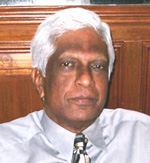 Lakshman Ravindra Goonetilleke (LR or Lucky) was born in Nugegoda on the 10th of December 1941 . In those days it was a leafy suburb away from the dust and grime of Colombo. His family had a long and strong connection with Wesley College. In 1952 LR started school in this long established institution of excellence which was the alma mater of his father. At the age of 16 his world fell apart when he lost his father bringing him great sorrow. His family rallied round to provide support.
Lakshman Ravindra Goonetilleke (LR or Lucky) was born in Nugegoda on the 10th of December 1941 . In those days it was a leafy suburb away from the dust and grime of Colombo. His family had a long and strong connection with Wesley College. In 1952 LR started school in this long established institution of excellence which was the alma mater of his father. At the age of 16 his world fell apart when he lost his father bringing him great sorrow. His family rallied round to provide support.
At school Lakshman concentrated on his cricket more than academia. He was always seen impeccably dressed wearing brilliant white shirt and long trousers. During the rough and tumble of school life he was neither bohemian nor radical but tread the straight and narrow remaining a disciplined lad, always. Despite his many sporting achievements he kept his feet well on the ground. He was not a man given to boasting although not averse to the acclamation he received. To all this he responded with boyish enthusiasm . Much has to be said about his personality, upbringing and the discipline at school which helped him to receive this adulation with such poise, dignity and humility.
His bowling action was hardly aesthetic, but it could be intimidating. Speed and lift and also swing and seam, were his weapons. He was as fast as any schoolboy bowler and he could get bounce from the flattest of pitches.
Focus on cricket brought him much success and fame. He played cricket for Wesley under 14, 16, and 1st XI teams. While at school Lakshman matured as a left arm fast bowler taking 50 wickets in each of the years – 1959 and 1960. He captured 8 wickets in one inning on 3 occasions which was indeed an impressive achievement by any reckoning. He was selected as the best schoolboy cricketer in 1959.
Combined Schools Cricket Team 1958 Capatined by Lorenz Pereira
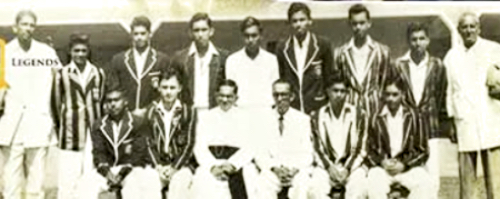
M.L. Idroos (STC), Raja de Silva (SJC), Anton Perera (SPC), Kingsley Fernando (St. Seb C), Priya Perera (SJC), Y. Amaradasa (Ananda), Suranjith Mendis (POW).
Seated L – R:
Lionel Fernando (SBC), Lorenz Pereira (Royal), L.R. Gunatilleke (Wesley C) and Sarath Samarasinghe (Royal).
After leaving school Lakshman played for the NCC with great success. His selection to play for his country brought him much fame and honour to his family and school. Playing for Ceylon in 1962 in the match against the MCC he clean bowled Ted Dexter creating a sensational entry into international cricket. He is one of the outstanding fast bowlers of his generation renowned for his consistency and accuracy in attacking the stumps. Tall and lankey, Lakshman had an ungainly run-up which belied his ability but whenever he played he dominated the bowling. For him bowling was a living, breathing art. Throughout his cricketing career whenever Lakshman played he remained a popular and inspirational member of the team. His cricket epitomised the best traditions of the amateur game not simply in the breathtaking power and technical excellence of his bowling, but also in the way he conducted himself as a player. Every bowler at sometime has to face the ignominy of being hit to all parts of the ground by a batsman. Lakshman weathered these storms with great restraint and many have remarked of his wonderful temperament in the field. The cricketing fraternity and the spectators queued to enjoy his talents over the years and rarely were they disappointed. During his cricketing career he lived up to national expectations. In today’s standards his dominance was brief but the expectations and the respect for him survived much longer. He should be immensely proud of his place in the history of the game in Sri Lanka.
Professional cricket in Sri Lanka was then non existent. There were no sponsorship deals and he had to earn a living. Like so many All Ceylon cricketers, he was a victim of his times. In the current money driven cricketing circus Lakshman would be a multi millionaire. Despite this drawback those years playing cricket were happy, rewarding and without regret. In 1963 Lakshman elected for a life as an up-country Planter starting as a “creeper” on Palm Garden Estate Ratnapura. In those days “creeping” was a punishing apprenticeship with a dawn to dusk routine. Although impetuous at times his charm and kindness gave him an incomparable ability to communicate with those at the top and also those at the lower rungs of society. These qualities were well suited for his chosen profession. This together with his management skills, honesty and hard work propelled him to become a Director of Whittals Estates & Agencies Ltd. After a successful and rewarding career at the top he retired in 1995. He then briefly joined Link Engineering as Director Link Inter Trade Ltd. In 1996 he launched his own company in the Aluminium Industry where he used his vast experience to provide a useful service to the community. This was not achieved without difficulty. Any embryonic business is confronted with a catalogue of restrictive problems. Lakshman had the perseverance, courage and the determination to make it a great success. He is courteous, soft-spoken and without pretension, yet his mild manner and soft voice belied a steely determination which ensured that things he wanted doing did get done, usually in the way he wanted.
Cricket is in his blood and he has remained close to the game giving his expertise to young cricketers at Wesley College. He was also a driving force in establishing the Cricket Development Council. Lakshman has tremendous loyalty to the game and to his school. He has spent countless hours training young cricketers with much success. Lakshman has always been generous with his time and his knowledge of cricket. In the Indian sub continent, politics bears its ugly head in all walks of life . His association with the school was no exception. There were times its anxieties brought him to the point of exhaustion. After many years of service to the school he loves, Lakshman has decided to take a back seat. Despite this he is often seen at the school supporting its numerous other vital functions. Having stepped back he still remains an influential and respected figure.
Lakshman also has a life beyond cricket and work. He and his wife Nimala have a wide circle of friends from all walks of life. They are tremendous hosts and generously so. Those who have attended their lavish lunches and dinners will never forget their wonderful hospitality and exotic delights. I will always remember their effervescent charm and good humour. Much of their continuing happiness focus on their close knit family. Lakshman and Nimala are immensely proud of their son and two daughters and also the grandchildren.
In his retirement he seeks refuge in meditation. This is well in keeping with his enigmatic but kind personal manner. Meditation is not only for the bearded sage sitting cross-legged in a forest cave. It helps us all to achieve peace in ourselves and in our lives. He is a regular and a Trustee at a Meditation Centre in Horana. The peace and the tranquility that it brings helps him to relax. This placidity and calm is evident in the manner in which he deals with the day to day problems and also the never ending trials of life.
It has indeed been a great pleasure to write about a friend from those halcyon days of the 1950’s. Colombo has changed beyond recognition and the old landmarks and values have disappeared too. Thirty years of war and peace have changed Sri Lankan society forever. Consumerism has taken its toll. The gentlemanly game of cricket has changed too and its money that calls the shots. For me, now, living abroad all that exists from way back are my friends. Although much has been written and said about Lakshman there is much more to him than what has appeared so far in the media and the public domain. I am greatly indebted to Lalith Wijesinghe and Senthil Sinniah, both former cricket captains of Wesley College, who have provided much information and inspiration, when this article was in preparation. They have been closely associated with Lakshman for over 55 years and have provided inside information, on and off the field, without which these notes would not have seen the light of day.
Lucky was a fearsome pace bowler who steered Wesley to sensational victories over many seasons. We respect and pay him tribute for his many contributions to the life of the school.
By (L.C.R) Lalith Wijesinghe
 My friendship with Lucky commenced with my staying at his home for a short period in 1961. He had just left Wesley whilst I was still a student. The fact that he and his mother agreed to keep me at his home exemplifies the quality of the person and his family. Lucky was my elder brother Shantha’s good friend. Our friendship now has been for nearly 50 years. The events that spanned this period in our lives could fill volumes. Some printable and others not. We had a select group of seven to eight in our circle of friends and still attempt to foster these bonds of friendship, although some are in foreign climes and three have passed away. Lucky has been a central figure in uniting all of us. If one was to describe his key character it is his fierce loyalty and generosity to his friends. His fairness and forgiving qualities combined with simplicity has endeared him to many.
My friendship with Lucky commenced with my staying at his home for a short period in 1961. He had just left Wesley whilst I was still a student. The fact that he and his mother agreed to keep me at his home exemplifies the quality of the person and his family. Lucky was my elder brother Shantha’s good friend. Our friendship now has been for nearly 50 years. The events that spanned this period in our lives could fill volumes. Some printable and others not. We had a select group of seven to eight in our circle of friends and still attempt to foster these bonds of friendship, although some are in foreign climes and three have passed away. Lucky has been a central figure in uniting all of us. If one was to describe his key character it is his fierce loyalty and generosity to his friends. His fairness and forgiving qualities combined with simplicity has endeared him to many.
“ Lean & Tall loved by all” were the words told to him by one of the fairer sex when all of us were attempting to get her attention, in a crowded place, is an incident I recall from our youth. This phrase really epitomises Lucky.
As a tea planter he started at Palm Garden Estate, Ratnapura and was posted to many Tea Estates upcountry as he progressed in his career. It is a fact that our circle of friends visited him at each and every location and spent days ,enjoying Nimala & Lucky’s kindness and hospitality. I recall vividly the time he played the perfect host to me and my new wife when he was posted at Matale. Many were the fun filled times spent in our younger days at the various estate bungalows Lucky occupied. We as a group have been associated with Lucky during his long and eventful courtship and subsequent marriage to Nimala, his successes and trials during his planting career which finally culminated in him being appointed a Director at Whittals. Goodness does not go unrewarded! This is reflected in Lucky’s life. He has been blessed with all that is good. A close knit loving family,a caring brother and sisters and a circle of loyal and true friends. I consider it a privilege to be his friend. A loyal, genuine and considerate human being.
I wish Lucky,Nimala and all his loved ones,the very best in life.
 60-year-old Lakshman Ravindra Goonetillekewas undoubtedly one of the best -left-arm fast bowlers that Sri Lanka produced. He sent Dexter's middle stump cart-wheeling at the Colombo Oval with a peach of a ball. In his brief stint as a left-arm paceman, he made his mark. His cricket career was cut short as he took up to planting. Distinguished Old Wesleyite L. R. Goonetilleke held the prestigious post of president of the old Wesleyite Sports Club for many years. Lucky is married to Nirmala. She is a tower of inspiration to him. They have a son Anuraj and two daughters Maheshika and Gihanka. Fatherly figure silver-haired Goonetilleke is a charming personality, a fine conversationalist, a knowledgeable cricketer and an equally fine gentleman.
60-year-old Lakshman Ravindra Goonetillekewas undoubtedly one of the best -left-arm fast bowlers that Sri Lanka produced. He sent Dexter's middle stump cart-wheeling at the Colombo Oval with a peach of a ball. In his brief stint as a left-arm paceman, he made his mark. His cricket career was cut short as he took up to planting. Distinguished Old Wesleyite L. R. Goonetilleke held the prestigious post of president of the old Wesleyite Sports Club for many years. Lucky is married to Nirmala. She is a tower of inspiration to him. They have a son Anuraj and two daughters Maheshika and Gihanka. Fatherly figure silver-haired Goonetilleke is a charming personality, a fine conversationalist, a knowledgeable cricketer and an equally fine gentleman.
 Premasara - To begin with tell us your reminiscences about your childhood and early schooling. LRG - I was born and bred at Nugegoda. My parents sent me to Royal Primary School. As did not gain admission to Royal college at Grade 6, I joined Wesley College. Some of my contemporaries at RPS were Sarath Samarasinghe, who captained Royal in the late 1950s and Nihal Kodituwakku, the present Royal College, cricket coach. We had a big garden at our home at Old Kesbewa Road, we played tennis-ball cricket. Merril Gunaratne, who later became a Deputy Inspector General of Police also used to play with us. Later he represented Colts CC.
Premasara - To begin with tell us your reminiscences about your childhood and early schooling. LRG - I was born and bred at Nugegoda. My parents sent me to Royal Primary School. As did not gain admission to Royal college at Grade 6, I joined Wesley College. Some of my contemporaries at RPS were Sarath Samarasinghe, who captained Royal in the late 1950s and Nihal Kodituwakku, the present Royal College, cricket coach. We had a big garden at our home at Old Kesbewa Road, we played tennis-ball cricket. Merril Gunaratne, who later became a Deputy Inspector General of Police also used to play with us. Later he represented Colts CC.
Premasara - I feel that Royal's loss was Wesley's gain? LRG - Well of course, I was very fortunate that I studied at Wesley. It is a great educational institution. It is multi-ethnic and multi-religious. We lived and studied like one family. Not only we learnt our books our character were moulded at Wesley. Therefore, I do not regret not entering Royal. I know that Royal College is also a great seat of learning. It's rather unfortunate that I could not enter Royal. I consider it as a blessing in disguise.
Premasara- Which year did you enter Wesley? LRG - In 1954. Premasara Which year did you leave? LRG- In 1960. I was a fairly good student, surprisingly, I came down in the University Entrance Examination. Those days they have done away with the viva. If the viva was there, I would have gained admission as I would have got additional marks for sports. Premasara - Who were your principals at Wesley during your time? LRG - For the major part of my career at Wesley my principal was C. J. Orloff. Then, Mr. P. H. Nonis. They were highly dedicated and committed educationists. Then we had some of the best teachers in the island.
Premasara- How did your school cricket career begin? LRG - I first played junior cricket and at under 11 level I showed promise as a left-arm fast bowler. I played for the Wesley first XI for three years - 1958, 1959 and 1960.
Premasara Who coached you and who was your master-in-charge of cricket? LRG - I was very fortunate that I came under one of the best cricket coaches in Sri Lanka Mr. R. B. Wijesinghe. He initially helped me to become one of the best schoolboy fast bowlers. He corrected my delivery and got me to bowl at one-stump at practices. He concentrated to improve my length and direction, which can be considered as the foundation in bowling. Mr. B. J. H. Bahar and Edmund Dissanayake also coached me. Mr. Dissanayake, who captained Wesley in 1940s was a teacher attached to Wesley and he was in charge of cricket for many years. Edmund Dissanayake and his son Danesh Dissanayke had the proud distinction of captaining Wesley.
Premasara - Who was your first XI captain in your first year? LRG - Late Nalendra Abeysuriya. Then, I played the following year under Senthil Sinniah, who is living in England.
Premasara - Who opened bowling with you for college? LRG - From 1958 to 1960 I opened bowling with Mihilar. He was a fine bowler.
Premasara Yes. Among the most exciting discoveries of the Post-war era Ted Dexter is one of the games most outstanding personalities. At Cambridge he got his Blue for cricket and for Golf and captained his university cricket team in his third season (1958). He also made his Test debut that same summer scoring 52 against New Zealand at Manchester. His county, Sussex, also recognised his ability by appointing him captain in 1960. Dexter elected England captain in 1961-1962, led the country in 30 of his 62 tests. His highest score was obtained in a Test Match 205 vs Pakistan at Dacca in 1961-62, and those who witnessed the swashbuckling power-packed masterly innings of 70 in 80 minutes in a crisis at Lords against West Indies in 1963 will never forget it.
Links to further reading
- L.R. Goonetilleke – a cornerstone in Wesley cricket - Click
- The Old Wesleyites Sports Club Report 1999 by L.R.Goonetilleke- Click
- LR Goonetilleke – A Cricketer and a Gentleman by Dr Nihal D Amerasekera 5th Sept 2010
- A Tribute to LR Goonetilleke by (L.C.R) Lalith Wijesinghe 23/9/10
- L.R. Goonetilleke – a cornerstone in Wesley cricket by Premasiri Epasinghe 23/9/10
by Premasara Epasinghe
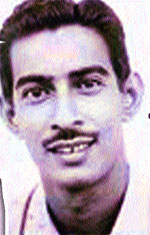 They brought honour and glory Born on 6th December 1936, in Colombo, he started his cricketing career at Wesley College, Colombo and shone as an allrounder. Later, he represented Moors SC, Colts CC, and CCC and went on to represent Sri Lanka from 1956 1971. Undoubtedly he was the best-off-spinner in Asia during this era. After hanging up his boots, Abu Fuard took to cricket administration. He was appointed full time Manager of Sri Lanka Team for 3 years from 1985. Prior to this period too, he was a successful Manager. Under his guidance Sri Lanka scored the first test victory against India at Saravanamuttu stadium. This was followed by beating Pakistan and Sri Lanka annexed the Asia Cup. In 1979 Abu acted as Sri Lanka Cricket Manager in the World Cup and during his period Sri Lanka won the ICC Trophy and thus qualified to play in the World Cup proper in 1979. At the conclusion of this Tournament Sri Lanka were placed 4th ahead of India, Australia, New Zealand and Canada.
They brought honour and glory Born on 6th December 1936, in Colombo, he started his cricketing career at Wesley College, Colombo and shone as an allrounder. Later, he represented Moors SC, Colts CC, and CCC and went on to represent Sri Lanka from 1956 1971. Undoubtedly he was the best-off-spinner in Asia during this era. After hanging up his boots, Abu Fuard took to cricket administration. He was appointed full time Manager of Sri Lanka Team for 3 years from 1985. Prior to this period too, he was a successful Manager. Under his guidance Sri Lanka scored the first test victory against India at Saravanamuttu stadium. This was followed by beating Pakistan and Sri Lanka annexed the Asia Cup. In 1979 Abu acted as Sri Lanka Cricket Manager in the World Cup and during his period Sri Lanka won the ICC Trophy and thus qualified to play in the World Cup proper in 1979. At the conclusion of this Tournament Sri Lanka were placed 4th ahead of India, Australia, New Zealand and Canada.
Abu Fuard was a member of the selection committee of the BCCSL from 1976 to 1981 and thereafter, served as the Chairman of Selectors from 1982 to 1986. Some of the achievements of Abu Fuard's Cricket Development efforts are there to be seen. To name a few the Sri Lanka Board Headquarters Building (in the initial stages he donated more than 2 million for the construction work which he earned from the Insurance Commissions, entitlements) Asgiriya stadium and Indoor stadium at the NCC grounds.
 Premasara- Please tell our readers how your school cricket career at Wesley began?
Premasara- Please tell our readers how your school cricket career at Wesley began?
Abu - Although cricket was in my blood, I started my sports career at Wesley, as an athlete. We had a teacher named Mr. Hunter. He encouraged me to be an athlete. I was a sprinter. I was a very active young boy. I first played cricket as an under 13 player. Then I was selected to play for under 15. I was a fast bowler. We had a coach Mr. Alban Fernando, and he turned me to an off-spinner. When I was playing for the Wesley First XI, we had two fast bowlers - Right arm paceman Radley Classen and left arm fast bowler Samsudeen. I started bowling off-spinners and I was successful. My father Mr. A.M. Fuard captained Wesley First XI in 1915. I was the vice-captain for two consecutive years in 1953 and 1954 and unfortunately, I could not lead the side for reasons best known to the school authorities.
My elder brother Anser Fuard also played for Wesley First XI and captained Wesley. He represented Moors and NCC. Premsara - Can you remember some of your noteworthy achievements when you were playing in the First XI. Abu - In 1953, I stroked a century against Richmond and put on a 231 runs partnership with Brian Classen, who also later represented Sri Lanka. In the same year, I took 6 for 76 against S'Thomas College Mount Lavinia and captured 9 for 53 against Prince of Wales. Following year, against Trinity Royal & Pow I returned the figures of 6 for 44, 8 for 60 and 9 for 38 respectively. I can remember in 1954, I notched 82 against St. Anthony's College Katugastota and in the two innings against Richmond I was unbeaten with 84 in the first innings and in the second essay scored 58 not out.
Premasara - From school you graduated to club circuit and very soon you gained your 'Ceylon Cap' which year did you play for Sri Lanka and against whom.
How did you perform?
Abu - I was the 12th man of the Sri Lanka Team the un-official Test against India captained by Polly Umrigar. My first appearance was in 1961, when I played against the mighty Australians led by Ritchie Benaud. This match was played at the Oval. (Sara stadium). I played under that gentlemanly cricket, C.I. Gunasekera for whom I have the highest respect and regard. In my debut I captured 2 wickets for 82. Aussies scored 289 with Norman O'Niell scoring an attractive 70 runs. Sri Lanka scored 187 for 8 at close. I still remember my skipper CI one of the most colourful cricketers that Sri Lanka produced, cracked Lindsey Kline for 24 runs in one over (4,6,4,4,6) I remained unbeaten on 22.
Premasara - Can you name some of the Australian Test players who played against you?
Abu - Ritchie Benard captained. Then Bill Lawry, Bobby Simpson, Peter Burge, Brian Booth, Graham McKenzie, Ian Quick, Frank Mission, Ron Gaunt. I still remember that foreign cricket correspondents covering this match that included famous Jack Tingleton, Ray Robinson commented on the fielding of Dhanasiri Weerasinghe on the boundary, bowling of Abu Fuard and the swashbuckling innings of C.I. Gunasekera.
Premasara - How about the 1962 England vs Ceylon match?
Abu- England led by Lord Ted Dexter were in Ceylon in 1962. The team included Tom Graveney, Ken Barrington, Peter Parfitt, Barry Knight and Rev David Sheppard. I had a good match against them, capturing 3 for 98 and 4 for 45 (Match Bag of 7 for 143).,
Premasara - Your forte is bowling. But you were also partly responsible for beating India at Ahmedabad. This was the first unofficial Test victory that Sri Lanka scored. Comment.
Abu- It was no doubt a magnificent team effort. We were left with a target of 112 to win. On a kin-soaked treachery. I opened in the second innings and made 40 runs and won the match 45 minutes before the scheduled close.
Premasara - You told me that it was Mr. Alban Fernando who advised you to bowl off-spinner in the school. Well, when you were mature were you influenced by any one that made you a superb off-break bowler, one of the best that Asia produced.
Abu - Well during the time that I just started playing club cricket, I was influenced by Vernon Prins. As I was young I was scared to speak to him. But, he was my idol in bowling. He was a fine off-spinner and a gentleman to the finger tips. I always had a very high regard to Prins and he is one of the nicest human beings that I have met. I learned a lot about off-spin bowling after I met an Englishman named Winslow. I met him when I toured India for the Gopalan Trophy matches. It was my good friend Indian cricket Kripal Singh, who introduced me to him. He taught me the finer points of off-spin bowling.
Premasara - Can you recollect some of your memorable bowling feats against International sides.
Abu - Against Joe Lister's International XI in 1964, I claimed 6 for 31 and the following year, for Sri Lanka Board President's XI, against Colin Cowdrey's XI in a limited over game I captured 4 for 61.
Premasara - Any notable achievements in the Gopalan Trophy Games.
Abu - IN 1960 at Madras I captured 4 for 21 and in 1961 scored 68 and took 3 for 44 at the Wanathamulla Oval (Sara stadium).
Premasara - What is your profession?
Abu- I knew only one thing, and that is Insurance. I joined De Soysa and Company Colombo 2, Principal Agent for nine foreign firms who handled major projects like Gal Oya, Inginiyagala, Kelanitissa, Victoria Bridge, Soccoman Pipelines etc. They did all the secretarial work and Insurance. I was handling the Insurance for them.
Premasara - As far as cricket administration is concerned you have much experience. How did this happen?
Abu - It was during late Mr. Robert Senanayake's time as the President in the early 1970s that I got involved in cricket administration. He was a very kind hearted gentleman and did his best for Sri Lanka cricket. Firstly, he did not see eye to eye with one. After about two years, he understood me. Those were the days, that only few, were truly interested to get into cricket administration. Of course, things have changed and new thinking has emerged as now, cricket is a highly professional exercise. I have served the BCCSL actively from 1973 to 1988 for fifteen years. Gamini Dissanayake, Lakshman Jayakody, Dr. N.M. Perera were great Presidents of BCCSL Premasara - Whom do you consider as the best President that you served? Abu - As President's Mr. Lakshman Jayakody, late Dr. N.M. Perera were quite good. Of course, the greatest Board President was late Mr. Gamini Dissanayake.
Premasara - Many say that you were responsible in bringing late Mr. Gamini Dissanayake to cricket administration.
Abu - I have heard that many people say this. It so happened by coincidence, that he came to reside opposite our house. He was a lawyer. My father too was a lawyer. As neighbours we associated very closely. Gamini Dissanayake was a very charming, good-hearted, friendly and a charismatic personality who was ever ready to help any one. In 1970, he became a member of Parliament. He loved cricket. Two of us use to spend hours and hours discussing cricket. Those were the days the BCCSL coffers were in the red. In fact even for practice matches, my mother used to prepare curries and soup and I used to take Bread to feed them. Mr. Dissanayake used to see all this. I humbly requested him to help us in our mission of promoting and developing cricket. Thats how I persuaded him to get involved in cricket administration. Luckily at that time he became one of the most powerful Ministers in the J.R. Cabinet.
Premasara - Did he ever offer you a top post in the Government?
Abu - Without my knowledge or consent, I heard from outside sources, that I was offered a top post at the Tea-Board. I told him he was doing a great injustice to me as well as himself, in making such an appointment. I told him that the only help that he could render to me was to get involved in the affairs of the Cricket Board and help my mission in improving cricket in Sri Lanka. I appealed to him to come forward as the President of the Board of Control for Cricket in SL, and gave him the assurance that I would lead his campaign to be the Board President. After the consultation he had with His Excellency J.R. Jayewardene he obtained the green light. There were people who did not like Gamini Dissanayake's entry to cricket administration some blamed me saying that I am 'Politicising cricket' some of the people who criticised and vehemently opposed my move to bring Gamini to the scene later went to Mr. Dissanayake. I used to see them from my bedroom. I used to laugh to myself about these 'social climbers,' and opportunists. I must tell you, that one person who helped me to get Gamini Dissanayake involved in the Cricket Board was late Mr. K.M.T. Perera, a live-wire at NCC.
Premasara - What do you think is late Mr. Gamini Dissanayake's greatest contribution to cricket?
Abu - Undoubtedly the gaining of Test Status to Sri Lanka. He prepared the ground with his dynamic set of officials in the Cricket Board. To gain Test Status he prepared the infrastructure and planning facilities, finance, grounds, administration etc. One day I told him how during Mr. Robert Senanayake's era, we went from pillar to post to find a venue to have our Board Meetings. Sometimes, at Clots and CCC we had abrupt endings to BCCSL Meetings as the clubs needed their Board Rooms. Mr. Dissanayake whatever he did, he did in style. His leadership qualities and PR was excellent. He was a superb conversationalist and a fine orator who could keep any audience spellbound. We started looking for a place for Board Headquarters. I moved in the matter. I contacted my good friend K.M.T. Perera, another good human being. He said that he would help me to get some portion of the land from NCC. In the meantime, Gamini Goonesena came from Australia and I must give him the credit, it was Gamini, who helped us to find a place to put up the present Board Headquarters. I still remember what Mr. Dissanayake told me after he was elected as the President of the Board of Control for Cricket in Sri Lanka. "Abu you all elected me. Now its your duty to deliver the goods. Unfortunately, cricket, as well as the country lost a great man, who served the country. Its a pity and a great tragedy.
Premasara - You were shy of publicity why?
Abu - Epa, I am a workaholic. I am a person who never wanted popular applause. But, I acted according to my conscience.
Premasara - Some say that you were the person who broke the 'Elite domination' in Sri Lanka Cricket?
Abu - I don't know how far this statement is correct. As you are aware they were like the 'Angels' dancing in the sky. The others, less privileged classes, were the 'Devils' below. SO, the Angels always look down on the Devils. My battle was to give equal opportunities to everyone, whether he was from a Elite school or not.
Premasara - Does that mean that you were responsible in bringing about the so-called 'Common Man's Era' in Sri Lanka cricket.
Abu - With all humility, I would like to say so, and to date, I don't regret my actions. I had proved today that opening the door to outstation cricketers has borne results. Of course, it was a long drawn out battle. Lots of people do not know that I was the one who proposed Bandula Warnapura's name as the First Sri Lanka Test Captain as a selector. My good friend K.M.T. Perera as the Chairman of the selection committee backed me to the hilt. There was a certain selector that opposed Bandula Warnapura's name as the captain. But, two of us K.M.T. and I fought for Warnapura, and we achieved what we wanted at that time.
Premasara - Can you name some of the top players, your contemporaries for whom you have a very high regard?
Abu - When I was playing for Colts my first captain P.A.T. Kelly was a wonderful human being. Then, there are three top Sri Lankan cricketing personalities for whom I have the highest respect and regard. They are thorough gentlemen. They are Vernon Prins, C.I. Gunasekera and Stanley Jayasinghe.
October 13, 2010,
By Premasara Epasinghe
 "The greatest achievement of my life in cricket, is the fulfillment of one of my ambitions. I took the game of cricket played , to talented under-privileged boys who were mostly from the outstations those from "non elite" schools . During my playing years, I noticed the discrimination meted out to outstation cricketers, I took upon myself, to fight for the cause of the under privileged cricketers. When I started the campaign against, the so-call of "elite schools", some people opposed me. During this early battle, a team mate of mine, former Ananda College Captain , Dhanasiri Weerasinghe, who is now domiciled in Australia and a few others backed me. "I, as a person belong to a minority community, is happy today to see outstation boys, who played for the so-called lesser known schools represent the Sri Lanka national team in a big way", stated Abu Fuard, one time "Asia’s best off-spinner", dedicated and committed Cricket Administrator, Team Manager and a relentless trainer of young cricketers in the late 1970s and early 1980s.
"The greatest achievement of my life in cricket, is the fulfillment of one of my ambitions. I took the game of cricket played , to talented under-privileged boys who were mostly from the outstations those from "non elite" schools . During my playing years, I noticed the discrimination meted out to outstation cricketers, I took upon myself, to fight for the cause of the under privileged cricketers. When I started the campaign against, the so-call of "elite schools", some people opposed me. During this early battle, a team mate of mine, former Ananda College Captain , Dhanasiri Weerasinghe, who is now domiciled in Australia and a few others backed me. "I, as a person belong to a minority community, is happy today to see outstation boys, who played for the so-called lesser known schools represent the Sri Lanka national team in a big way", stated Abu Fuard, one time "Asia’s best off-spinner", dedicated and committed Cricket Administrator, Team Manager and a relentless trainer of young cricketers in the late 1970s and early 1980s.
I presume, many people are unaware that this dynamic, cricketer-cum-administrator, Abu Fuard, was mainly instrumental in inviting the late Gamini Dissanayake, to promote Sri Lanka cricket. This great man, Gamini Dissanayake, was responsible in obtaining test status for Sri Lanka. He hand picked Abu Fuard to improve the infrastructure and the administration of cricket. Infact, it was due to efforts of Gamini Dissanayake and Abu Fuard that the present headquarters building of cricket, at Maitland Crescent became a reality., . Also the indoor-nets at the NCC premises, and refurbishing and constructing the Asgiriya Stadium in the hill capital as a test venue. Abu Fuard was the livewire behind improving the cricket structure. He is a man of honesty, integrity and an outspoken personality. Abu, is a marvellous man - a workoholic. His life is cricket. A strict disciplinarian, he is a man who calls "a spade a spade". He does not tolerate injustice. Sometimes, he is harsh. He is firm with his decisions and he is a fighter, on and off the field. Sometimes, people misunderstood him. But, with my long association with him, I can state here, although he is a "Tough Guy", he possess a golden heart. He won’t give up easily. He fights hard. He stands for fair-play and justice. I have seen him as a Manager, who maintains a very high standard of discipline.
In early the 1950s, Abu Fuard was an outstanding schoolboy cricketer. In 1953, he stroked a chanceless century for Wesley against Richmond College, Galle. With Brian Classen, they, (Abu Fuard) put on a partnership of 231. Both represented Sri Lanka with distinction later. Abu Fuard was the finest off-spinner produced in the 1950s – 1970s. As a schoolboy in 1953, Abu captured six for 76 against S. Thomas’ College, Mount Lavinia. He captured 8 wickets against Royal. While playing against Prince of Wales, Moratuwa, he returned the amazing figures of 9 for 53. Abu Fuard was born on 6th December, 1936, in Colombo. His illustrious father, A. M. Fuard, captained Wesley College in 1915 and his brother, the late Ansar Fuard, who later became a school teacher opened batting with me for the Education Department in the Government Service Cricket Tournament in the late 1960s, when I was teaching at Nalanda.
 Abu captained Wesley in 1954. Abu’s story is fascinating. He was a reliable sportsman. Many people do not know that he was also a fine athlete. He represented Wesley College in the Public Schools meet and competed with the late Lalith Atulathmudali in the 100 metres hurdles. He started playing cricket in the Under-13 age group , as a fast-bowler. However Wesley College cricket coach the famous Alban Fernando, turned him into an off-spin bowler. After leaving school, he played cricket for Moors, Colts and CCC. Abu Fuard, represented Sri Lanka from 1956-1971. Undoubtedly, he was the best off-spinner in that era. I still remember him playing against Australia, in a ‘whistle stop’ tour at the Oval. He bowled extremely well and became the highest wicket taker.
Abu captained Wesley in 1954. Abu’s story is fascinating. He was a reliable sportsman. Many people do not know that he was also a fine athlete. He represented Wesley College in the Public Schools meet and competed with the late Lalith Atulathmudali in the 100 metres hurdles. He started playing cricket in the Under-13 age group , as a fast-bowler. However Wesley College cricket coach the famous Alban Fernando, turned him into an off-spin bowler. After leaving school, he played cricket for Moors, Colts and CCC. Abu Fuard, represented Sri Lanka from 1956-1971. Undoubtedly, he was the best off-spinner in that era. I still remember him playing against Australia, in a ‘whistle stop’ tour at the Oval. He bowled extremely well and became the highest wicket taker.
If my memory serves right, it was Ritchie Benaud who stated, "we like to take this bloke, Abu to Australia". This shows he was rated high as the best bowler of Sri Lanka at that time. "Premasara, those days, I used to walk all the way, from 5th Lane, Colpetty, to Colts ground at Havelock town. I start practicing at about 2.30 p.m. I keep an object, sometimes a coin, on the matting. Bowl at it – "spot bowling". By this drill, I improved my length and direction. We were committed, worked hard," stated Abu Fuard. Fuard first represented Sri Lanka in 1961, against the mighty Australians captained by the great Ritchie Benaud.
In 1962, he played against Ted Dexter’s England side. His moment of glory came when he captured six wickets for 31 runs against Joe Lister’s International XI. Abu Fuard was a "Gutty Fighter". I still remember in early 1960s, in the first unofficial test against India at Ahamadabad, he played a key role in beating India. "It was a fine team effort. We were left with a victory target of 112 runs. I opened in the second innings. The wicket was a nighmare. There were pot-holes. on the pitch. I scored a quick fire 40. We won the match 45 minutes before the close," stated Fuard. Abu Fuard was an insurance man by profession. He joined De Soysa and Company, Colombo 2, principal agents for seven major projects, namely Gal Oya, Inginiyagala, Kelanitissa, Victoria Bridge, etc. They did the secretarial work and Abu handled the insurance work. It was during Robert Senanayake’s tenure, as the President of Sri Lanka Cricket Board, in 1973, that Abu Fuard got involved in cricket administration.
Those were the days where dedicated, committed gentlemen got into Cricket Administration in a honorary capacity. J. R. Jayawardene, Dr. N. M. Perera, T. B. Werapitiya, Lakshman Jayakody, were ornaments to Sri Lanka cricket. They never mixed politics with cricket. All those great men played the game. Gamini Dissanayake, although he did not play the game at the highest level, was a lover of cricket and a fine administrator. He was brilliant in selecting the correct man to the correct position. After retiring from playing cricket, Fuard became a cricket administrator.
In 1985, he was appointed full time manager of Sri Lanka cricket. Prior to this, he also functioned as a successful cricket Manager. Further, he was a qualified cricket coach, too. Under the able guidance of Abu Fuard as manager, Sri Lanka recorded her first Test victory against India on 11th September, 1985, at the Colombo Oval, (now called the Saravenamuttu Stadium). Sri Lanka beat India by 149 run. Sri Lanka first innings 385 – Second innings – 206 for 3 wkts. India first innings – 244 - Second innings – 198. For Sri Lanka Amal Silva scored III, Ranjan Madugalle 54, Roy Dias 95, Duleep Mendis 51. In the 2nd innings. – Sidath Wettimuny 32, Ranjan Madugalle 60 n.o. For India – K. Srikanth 64, M. Amaranath 60, S. Gavaskar 56, Rumesh Ratnayake 25.1-5-76-4 – 2nd innings – 23.2-6-49-5. India 2nd innings. 198 – Kapil Dev 78. Man of the Match – Amal Silva. In 1979, Abu Fuard, functioned as the manager, Sri Lanka team for the 1979 World Cup. During this period, Sri Lanka won the ICC Trophy. Fuard was a member of the selection committee of the BCCSL from 1976-1983. Thereafter, from 1982-1986, he was its chairman.
As a Nalandian, my happiest moment, in cricketing life, was the day that one of my students at Nalanda Bandula Warnapura, who captained Nalanda in the early seventies was elected of Sri Lanka’s first Test captain. I know that it was mainly due to the efforts of Abu Fuard, who proposed the name of Bandula Warnapura. Former Thomian and Ceylon cricketer, the late K. M. T. Perera, as chairman of selection committee, backed Fuard to the hilt. These is all forgotten history now. Fuard, was a tough talking person. His motto was "Country Before Self".
I still remember an incident where Sri Lanka were playing Pakistan at the CCC. One of the opening bowlers, after capturing a wicket in the second over, returned to the pavilion complaining about a "slight pain in his leg". Abu pounced on the bowler. "Young man, country is greater than your slight pain in the leg. Go out immediately to the centre, perform in the name of your beloved country, Sri Lanka. Then you will forget your pain", stated Fuard. This incident happened in front of me, and assistant coach, W. A. N. Silva. Although, he erupted like a volcano, in a few minutes, Abu was "cool as a cucumber". That is the nature of Abu Fuard, this fine human being. Believe me, this particular fast bowler captured five wickets at the end. Today, Abu Fuard maintains a low profile. His contribution to Sri Lanka cricket is enormous.
Links to further reading
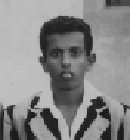 The Singer sponsored Wesley College six-a-side cricket tournament for the Golden Oldies in connection with the School's 125th anniversary will figure a host of Sri Lankan International players of yesteryear on February 21 Sunday at 9 am at Campbell Park. The Old Nalandians are expected to field a team including the first Sri Lankan Test captain Bandula Waranapura and former Test off spinner Lalith Kaluperuma will meet the Old Wesleyites skippered by Sunil Fernando in the first match scheduled to begin at 9 am . The old Benedictines hope Ranjith Fernando present Sri Lankan cricket team Manager and former wicket keeper will grace the occasion in 'bulk'. Ranjith is one of the fittest 'old goldies'.
The Singer sponsored Wesley College six-a-side cricket tournament for the Golden Oldies in connection with the School's 125th anniversary will figure a host of Sri Lankan International players of yesteryear on February 21 Sunday at 9 am at Campbell Park. The Old Nalandians are expected to field a team including the first Sri Lankan Test captain Bandula Waranapura and former Test off spinner Lalith Kaluperuma will meet the Old Wesleyites skippered by Sunil Fernando in the first match scheduled to begin at 9 am . The old Benedictines hope Ranjith Fernando present Sri Lankan cricket team Manager and former wicket keeper will grace the occasion in 'bulk'. Ranjith is one of the fittest 'old goldies'.
Royal are counting on Nihal Koddithuwakku the brilliant All Ceylon opening batsman, Ranjan Madugalle the popular former Sri Lankan captain and Ajith Pasqual to help them carry away the first ever old boys trophy. The Old Thomians strategy has not been revealed, but it is expected that Anura Tennakoon, Ajith Jayasekera, ``Holmang'' Mevan Pieris, the Sri Lankan fast bowler.
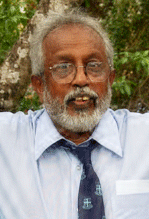 Priyantha Serasinghe will retrieve their whites from the cleaners for Sunday. The other sporting events programmed for the celebrations is the Triangular Cricket Tournament to be played on March 1, between exprtriate Old Wesleyites from the United Kingdom, Australia and those in Sri Lanka. A hockey match between the expatriate Old Boys and a Combined past and present team. On March 6, the school cricket team will be matched against the Past Captains of Wesley. Lou Adihetty, Milroy Mutuvaloe, Everard Schoorman, Ananda Thevedasan, Navin de Silva, Delmer Achilees and Ameresh Rajaratnam are some of the past captians who will pit their experience against Dharsika Jayakody and the strong Wesley team of today. A mini basket ball jamboree at 2.30 pm will close the program on March 13 at the Sugathadasa indoor stadium.
Priyantha Serasinghe will retrieve their whites from the cleaners for Sunday. The other sporting events programmed for the celebrations is the Triangular Cricket Tournament to be played on March 1, between exprtriate Old Wesleyites from the United Kingdom, Australia and those in Sri Lanka. A hockey match between the expatriate Old Boys and a Combined past and present team. On March 6, the school cricket team will be matched against the Past Captains of Wesley. Lou Adihetty, Milroy Mutuvaloe, Everard Schoorman, Ananda Thevedasan, Navin de Silva, Delmer Achilees and Ameresh Rajaratnam are some of the past captians who will pit their experience against Dharsika Jayakody and the strong Wesley team of today. A mini basket ball jamboree at 2.30 pm will close the program on March 13 at the Sugathadasa indoor stadium.
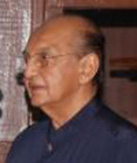 |
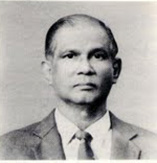 |
 |
| Mahroof Ismail | Denzil Perera | LR Goonetilleke |
Friday the 3rd of December 1999, will not be just another day in the life of the 'Old Wesleyites Sports Club' (OWSC). For to be more specific, the evening of that day is bound to be special, and one among other significant milestones in the life of the OWSC where members of the Club, well wishers and friends, with a sense of belonging and pride, will gather to felicitate three outstanding (club revival) past presidents in Prof; Mahroof Ismail, Denzil Perera and Lucky Gunetilleke. The deep commitment of these past presidents and the measure of their giving in the wider sense, could only be appreciated. - When one begins to realise, that the club which was dormant and eventually defunct for eleven years (1978-1989), was virtually resuscitated in 1989, mainly through the unflagging zeal and fervour of these three presidents. Mahroof, Denzil and Lucky each of them during their respective presidency's along with their accredited committees, spanning a decade (1989-1998), strove successfully in those crucial formative revival years to give the club, tone and direction, a distinctive character of its own and more importantly the much needed financial stability.
The club, which is now well established with the base and foundation so laid for sustained progress, is fortunate to have as its current president, the highly enthusiastic and versatile Capt: Navin de Silva to steer it through into the next millennium. It's against this background and in recognition of the pioneering service rendered by Prof: Mahroof Ismail, Denzil Perera and Lucky Gunetilleke, endearingly referred to as the revival presidents -That the club in oneness of spirit amidst much fellowship will unveil their respective portraits. Truly a fitting gesture of "Honour to whom honour is due, Thanks to whom thanks is due." Mahroof who was the first of the club revival presidents (1989-1993) was an accomplished all round student and the senior head prefect at Wesley. He had a penchant for winning prizes and carried away many of them at the college annual prize giving, inclusive of the prestigious 'Hill Medal' on two successive occasions in 1948 & 1949. As a keen sportsman, he captained the college at hockey and badminton and went on to lead the Ceylon university in both sports. His contribution to hockey was recognised, when he was at one time made the president of the state services hockey association and vice president of the Ceylon hockey association.
The early promise of eminence at college, was seen when he progressed to be the Director of the Medical Research Institute and later to be the Dean of the Faculty of Medicine in the University of Colombo. Denzil who took over from Mahroof in 1994 was president till 1995. It was during his tenure, that the club developed from the railway carriage stage to have a sophisticated sports complex and a modern club house. As a meticulous student and sportsman he displayed leadership qualities and organising ability at a very early age. He captained the college hockey team and represented Ceylon and travelled abroad as a member of the mercantile hockey team. Denzil is the proprietor of 'Qualipacks' (Pvt) Ltd and had done much in the raising of funds, especially by organising the popular annual dance, not forgetting his touching gesture of the assistance given in the cause of the billiard room.
Lucky who succeeded Denzil in 1996, was the third of the revival presidents and served up to the end of 1998. Being lanky and lithesome, he had the natural aptitude for being a classy left arm pace bowler. He had an outstanding career at Wesley, as a student and a rare bowler, who won many an award with a hat-trick or two to his credit. He made the right kind of impression, to be among the wickets at the NCC and was picked to represent Ceylon. The beauty of a ball with which he bowled the English Captain, Ted Dexter is still spoken of. His administrative ability as a planter and former Director of Whittal Boustead and Gordon Frazer, was in evidence during his three year period as president. He will, amongst others, be remembered for getting down school teams from the north and east to participate in the schools'- 6-a-side cricket tournament and, for providing crutches and artificial limbs to wounded soldiers. Lucky at present is the Director of Link Engineering.
The 'Old Wesleyites Sports Club' came into being in 1941, mainly out of a growing passion for hockey, which existed within the old Wesleyites of that era. A common bond amongst players and enthusiasts had been established throught this sport. And it became necessary on leaving college, to further strengthen this and give continuity to it, which resulted in the OWSC being born. History records that in the early fifties, members of the OWSC played a prominent role in the promotion and furtherance of hockey in the country. Hockey teams of the OWSC participated in the Pioneer Shield, Andriesz Shield and Bacon Cup tournaments, with a measure of success, being champions on more than one occasion. The club in those years, was preoccupied with hockey, it failed to broaden out to other areas, and was greatly disadvantaged by the lack of a meeting place, a club house.
Naturally then the club had a chequered existence, with more downs than ups and long spells of inactivity, to be finally defunct from 1978 to 1989. Heartening it is to observe, that in the last ten years, the club under the three revival presidents, has recorded unprecedented growth of a sustaining nature, which augurs well for the future. This was made possible by the high powered, ambitious projects which brought in the necessary funds for the club to forge ahead, and as well support the college in its endeavours. Chief among which, was the pioneering ventures such as the schools' six-a-side cricket tournament under the chairmanship of Eric Gauder, and the schools 7-a-side hockey tournament managed by Rohan Amerasinghe.
The former is being sponsored by the Ceylon Cold Stores Ltd., whilst the latter is sponsored by Janashakthi. The chief guest at the evening's function on December 3rd, will be the illustrious old boy of Wesley Rienzie Wijetilleke, the managing Director of Hatton National Bank and currently president of the Interim Cricket Board. Rienzie has been very supportive of both the college and club in many ways, and will do the honours of unveiling the portraits of the three revival presidents, and a panel depicting the names of past presidents of the club. The guests of honour will be two distinguished old boys, Richard Ebell and L.C.R. Wijesinghe.
By Edmund Dissanayake
 The Royal-Wesley cricket match, which was played on the Railway Grounds, Mt. Mary on the 8th. and 9th February 1946, will be remembered for the controversy it raised, probably unique in Sri Lanka, when on the first day of play, the Royal captain, Mahes Rodrigo wanted to declare his innings closed, but the Wesley skipper, Edmund Dissanayake, refused to accept the Declaration as it was late by 5 minutes! The powerful Royal team led by "Sporty" Mahes Rodrigo included M. Kasipillai, G.T. Kapukotuwa, G.L.G. Cooray, T. Parathalingam, C.D.L. Fernando, Percy Goonewardene, F.E. Porrit, Vimal Wickramasuriya, R. Rajaratnam and R.S. Cooke.
The Royal-Wesley cricket match, which was played on the Railway Grounds, Mt. Mary on the 8th. and 9th February 1946, will be remembered for the controversy it raised, probably unique in Sri Lanka, when on the first day of play, the Royal captain, Mahes Rodrigo wanted to declare his innings closed, but the Wesley skipper, Edmund Dissanayake, refused to accept the Declaration as it was late by 5 minutes! The powerful Royal team led by "Sporty" Mahes Rodrigo included M. Kasipillai, G.T. Kapukotuwa, G.L.G. Cooray, T. Parathalingam, C.D.L. Fernando, Percy Goonewardene, F.E. Porrit, Vimal Wickramasuriya, R. Rajaratnam and R.S. Cooke.
The comparatively young Wesley team led by Edmund Dissanayake included Alan Ratnarajah, Piyasiri Abeywardene, Harold Matthysz, Natty Prins, Denis Van Twest, Bertus Perera, Clive Bartholomeusz, Eric Nugara, Vivil Dias, Sinha Jayasundera and Ronald Gomes. Veteran sports writer, S.S. Perera has published in the "Royal-Wesley Centenary Cricket Match Souvenir, 1993" some interesting details about this match. "For the first time in the history of Ceylon School Cricket Schools requested the Official Umpires' Association to officiate as Umpires." "The rules prevailing at that time stipulated that no declaration shall be made on the first day unless a minimum of one and a half hours of batting were given to the other side.
The refusal of the Wesley captain was unpheld by the Umpires on that rule." This rule was not popularly known, as several spectators inquired as to why the declaration was refused. What followed thereafter was a comedy. Royal had piled up 312 for 5 when balked by the declaration, Mahes Rodrigo who was on 18, retired. The next batsman F.E. Porrit played one ball and wished to retire. But he was informed by the Umpire that he could not do so without facing at least one over. Vimal Wickramasuriya, Rajaratnam and Cooke, followed suit. Parathalingam was not out 2. "This comedy of "retirement" took 20 minutes to enact and from Wesley's point of view, was of great help in postponing the moment of defeat. For the Wesley team of 1946 included 8 freshers, all of whom were under 16. Vivil Dias was a student in Grade 7. Royal were out for 317 towards which Kapukotuwa contributed 81, Cooray 78, Kasipillai 69 and Percy Goonewardene 46. Earlier, the Royal batsmen were in such an aggressive mood of scoring that the Wesley bowlers considered it wiser to bowl "wides." There were as many as 14 wides.
On the first day, Wesley had one hour to bat. Everyone expected Wesley to collapse. I opened batting with Vivil Dias. My first run came after I had batted for half an hour! It was a single pushed to mid on. There was tremendous applause from the Royal camp... not a cheer but a jeer, which was taken up sportingly. At the end of the day we had scored 50 runs for 1 wicket. To continue, may I quote from "Sports and Recreation." "Wesley batted for one hour on Friday and were all out for 167 on Saturday. Edmund Dissanayake was the last man out, having scored 107 runs, which included 16 hits to the ropes. Wesley followed on and batted for rest of the day, scoring 172 for 7 towards which Vivil Dias scored 79. Dias, who had been ruled out caught at 8 was recalled by the Royal captain Mahes Rodrigo, after a brief consultation with the fielder concerned. This sporting act of the Royal skipper probably deprived them of a victory. It will be recalled that Mahes played for All Ceylon later and also captained the Ceylon Rugby team more than once. "The correctness of the decision in upholding the refusal of the Wesley captain, was approved by the MCC. A few years later this Rule was repealed. A Declaration is now possible on the first day of play, at any time."
 For more than 25 years, M. Sathasivam had held spectators spellbound with his vibrant batting. He played with cricketing greats like F. C. de Saram, Sargo Jayawickreme, Lucien Soysa, B. R. Heyn, Henry Van Buren, C. K. Nayudu, Vijay Merchant, Ray Lindwall, Keith Miller, Weekes, Worrell and Walcot. But he was more than their peer. He was easily the most stylish batsman the world has seen. Records meant nothing to him as he lowered them with consummate ease. No one in Sri Lanka has scored more centuries than he. T. B. Marambe in his book "Pen pictures of our cricketers" states as follows"; There is a touch of arrogance even as he walks to the wicket. There is grace in his movements as he takes guard and looks round the field for the gaps. Out goes his front feet, there is a flash of a white blade and the ball scuds to the ropes.
For more than 25 years, M. Sathasivam had held spectators spellbound with his vibrant batting. He played with cricketing greats like F. C. de Saram, Sargo Jayawickreme, Lucien Soysa, B. R. Heyn, Henry Van Buren, C. K. Nayudu, Vijay Merchant, Ray Lindwall, Keith Miller, Weekes, Worrell and Walcot. But he was more than their peer. He was easily the most stylish batsman the world has seen. Records meant nothing to him as he lowered them with consummate ease. No one in Sri Lanka has scored more centuries than he. T. B. Marambe in his book "Pen pictures of our cricketers" states as follows"; There is a touch of arrogance even as he walks to the wicket. There is grace in his movements as he takes guard and looks round the field for the gaps. Out goes his front feet, there is a flash of a white blade and the ball scuds to the ropes.
So perfect is his timing, so quick his feet, and so keen his eye".... Between 1934 and 1959 Sathasivam has scored 144 centuries. (Refer to page 50 of the "Royal-Wesley Centenary Cricket Souvenir". Is it little wonder that he captained two countries at cricket? Let me quote Alfred Moragoda, my former teacher at Wesley, ex CCS, as published in a leading newspaper on October 12 1996... "Satha, was the most naturally gifted batsman the world has ever seen, the most charmingly disdainful of any kind of bowling, the most nonchalant in situations, most graceful. It was well-nigh impossible to set a field to contain him.
He found the gaps with effortless ease. And he did it with artistry and finesse.... I have seen Hobbs and Sutcliffe, Hammond and Bradman, Worrell and Sobers, but Satha, was indisputably their peer." Moragoda continues in lighter vein... "In Satha's last year at Wesley, on the morning of the Royal -Thomian, together with a few friends, he loaded all the flower pots that had the fairest flowers that ever grew in Cinnamon Gardens, into a Jalopy. The morning found these flower pots neatly arranged inside the premises of "Maidens' College". Satha and his friends were singing happy songs within its sacred walls as the maidens arrived. As word got around, the Principal came on the scene. Satha went down on his knees, one knee following the other in measured time, he came up to the Principal (She had an alphabetical name like L.M.N.O.P.) and asked her to be his bride.
The Principal replied that she was still too young to think of marriage but would keep the proposal in mind when she was old enough" ... that was Satha. out of School ! In 1947, All-Ceylon played against South India on the Chepauk Ground. "The Hindu" described Satha's batting thus...' "It was well worth going miles to see the beautiful batsmanship of Sathasivam. There was all the art and style in his innings which was played on dancing feet. He played all shots from the prettiest late cut to the fine leg glance which he did as much as wave it away from his presence. He was the complete master." Satha's 215 broke the previous ground record of Joe Hardstaff who scored 213 in 1938. Lucien de Zoysa writing about Satha as published in the "Island" of 29th October 1989 stated... "Satha had the eye of a hawk; the wrists of a fencer; the feet of a dancer. All combined to make a Satha innings a taste of bubbly champagne.
His walk to the middle, with his cap at a rakish angle, had style. The nonchalant way he took guard and his stance had style. His every movement had feline grace." For the record, Sathasivam's photograph appears in the Wesley College M. H. Mohamed Pavilion in a prominent place. An annual award is made in his honour to a Wesley cricketer, "For the most scintillating innings in the season."
By Premasara Epasinghe
 The study of the past events, especially, political, social, and economic development of a country can be defined as HISTORY. The nation that forgets the past has no future. There were some politicians, who opposed the teaching of history in our schools sometime ago. They fell by the wayside totally, rejected by the people. Sports history is fascinating and thrilling. I strongly feel that our present sportsmen and sportswomen should read and do an in-depth study of our "Sporting Greats," so that they in turn can emulate their great deeds. Undoubtedly, the characteristic of this great sportsmen will be a role- model to most of our young, up and coming sportsmen and sportswomen. Today, I feature the most exciting, adventurous batting artist that displayed his born talents as a Colossus in the playing field of cricket. He occupied centre stage during the period spanning from 1940-60s. The colourful figure tormented not only the local bowlers, but also international bowlers of repute; from India, Pakistan, England and Australia. He is none other than Mahadevan Sathasivam, popularly known as M. Sathasivam. ‘Satha’ was a product of Wesley College, Colombo.
The study of the past events, especially, political, social, and economic development of a country can be defined as HISTORY. The nation that forgets the past has no future. There were some politicians, who opposed the teaching of history in our schools sometime ago. They fell by the wayside totally, rejected by the people. Sports history is fascinating and thrilling. I strongly feel that our present sportsmen and sportswomen should read and do an in-depth study of our "Sporting Greats," so that they in turn can emulate their great deeds. Undoubtedly, the characteristic of this great sportsmen will be a role- model to most of our young, up and coming sportsmen and sportswomen. Today, I feature the most exciting, adventurous batting artist that displayed his born talents as a Colossus in the playing field of cricket. He occupied centre stage during the period spanning from 1940-60s. The colourful figure tormented not only the local bowlers, but also international bowlers of repute; from India, Pakistan, England and Australia. He is none other than Mahadevan Sathasivam, popularly known as M. Sathasivam. ‘Satha’ was a product of Wesley College, Colombo.
Once, I drove to Kandy to commentate in a match played at Asgiriya accompanying the legendary Gamini Goonasena, and famous cricket writer Rajan Bala from India. Rajan presented his latest book titled ‘ALL BEAUTIFUL BOYS’ to me, a readable, lovely cricket book, written in simple language in his own inimitable style. Turning the pages, I came across an interesting chapter on Ceylon Cricket. The famous author Rajan Bala in this chapter pays a big tribute and a bouquet to M. Sathasivam. He quotes from an past Indian cricket captain, brilliant off-spinner Gulam Ahamed. Quote: "I have bowled at Bradman, Harvey, Hutton, Denis Compton, Keith Miller, The Terrible W’s -Weekes, Worrel and Walcott. If you ask me a question, who is the most difficult batsman that I have ever bowled, I will mention a name that some times you will not know. He is M. Sathasivam of Ceylon. I will never forget how he thrashed me in Chennai." M. Sathasivam was the most feared batsman during this era. As Nalanda opener cum wicket- keeper in the Champion Side of 1957, 1 was very fortunate to witness the double century of Sathasivam at the NCC grounds.
He represented the "Champions Side" against the "Rest." The cream of Sri Lanka super stars, were in action. This was the best innings I have ever seen in my life. I have seen the best of cricket in the world to a certain extent. Sathasivam was a batting artist. I have never seen a batsman who plays the ‘late cut’ so beautifully. It is a "Sathasivam Special." Sathasivam wore cream flannels and a cream coloured, fuji silk long-sleeved shirt.
Like the famous Douglas Jardine, the English captain of the "Body Line Series" in 1930s, he wore a handkerchief round his neck and harlequin cap adding colour to his personality. His footwork was excellent. For him, there was nothing called a good or a bad ball. While batting with his superb concentration, he turned the good ball to bad balls. With his hallmark stroke, late-cut, he could pierce through the slip cordon, third man, gully or point at will. Once I had the good fortune of playing for Saracens against Tamil Union. Nalanda coach, ever-green Gerry Gooneratne, captained the Saracens side. Gerry as a successful captain, has "foxed" Satha many a time. His ploy was simple. In this particular match, Gerry, used his off-spinner Mahinda Athulathmudali, when Satha arrived at the crease. Gerry laid a trap. He got the tall, lanky off-spinner ‘Atu’ to bowl three deliveries outside off-stump.
Satha’s beautiful late-cut was a treat to watch. Gerry instructed Atu, to allow him to play his famous stroke. The fourth ball spun from middle to leg. Satha moved and cut it. Gerry applauded his beautiful late-cuts. "Nice shot Satha," "Beauty Satha" and encouraged him to go for his pet shot freely. The fourth ball, he misjudged and cut through gully uppishly. Gerry rolling to his left, held a brilliant catch to dismiss Satha. We were all in cloud nine. Those days the clash between Singhalese Sports Club (SSC) and Tamil Union AC was like a Greek meeting a Greek. It was the local "Cricket Derby." The two teams consisted of the best cricketers of the island. The centre of attraction was Sathasivam. S.S.C. and Tamil Union always maintained a very cordial relationship. S.S.C. possessed the shrewdest captain, Col. F.C. De Saram.
The S.S.C. camp planned their strategy weeks ahead, to get Satha out early. ‘Pappa Saram’ planned a different "coup" to dismiss Satha early. He was invited to the S.S.C. for a social gathering the day before the match. The S.S.C. members entertained Satha, till the morning hours. He did not go home. He slept in the car. On the match day, he went straight to the dressing room and had a good shower. Winning the toss, S.S.C. invited Tamil Union to bat first. Within twenty minutes, they captured openers for 24 runs. Sathasivam walked in to the middle. He straight away went in to action. By lunch, he reached the magical three figure mark with 17 hits to ropes. F.C. De Saram’s, ‘Coup de Et’ failed. Although in different camps Satha and F.C. were best of friends, and played cricket with the true spirit of the noble game. Satha is so close to Col. F.C. De Saram that he used to address him as ‘Derrick.’ Another incident that is etched in my mind is a statement by R. Rangachari, the former Indian pace bowler.
I commentated the first ever cricket commentary for Sri Lanka Rupavahini Corporation relating to the First Test between Sri Lanka and India in 1982. I’m very grateful to late Mr. M. J. Perera, one of the most respected civil servants, and one of the top administrators who selected me as one of the commentators for that Test. Rangachari was the curator. He said the best innings he had ever seen was the double century of Sathasivam at Chinnaswamy Stadium. The legendary West Indian Learie Constantine’s Commonwealth team visited Ceylon in 1950. In a rain affected match at the Colombo Oval, Sathasivam scored a brilliant 96. In an earlier match against India in 1945, he scored 107. In a Gopalam Trophy match, Sathasivam scored an epic innings of 215, the highest individual score made at Chinnaswamy Stadium till 1950. Sathasivam was a controversial figure. He was in remand jail, charged for the murder of his wife.
After he was acquitted, he once again played for Tamil Union in the Division Two Tournament. News went round the city that Sathasivam is back at play. Thousands flocked to see their hero after a lapse of about five years. The match was played as BRC ground, Tamil Union versus BRC. After the fall of the 2nd wicket, Sathasivam walked in. The spectators gave a grand ovation. Satha took his guard. A young fast bowler, to show his might and arrogance, send a ‘bumper’ to Satha. He ducked. The bowler’s intention was to frighten the old man. He send another ‘bumper.’ It should be reminded that during this period there were no helmets.
Satha, slowly walked up to the young bowler and had said very politely: "Son, I am an old man, like your father. Don’t try to injure me. Don’t bump at me." The fast bowler, with his tail up, bowled another ‘bumper’ to Sathasivam. The batting maestro positioned himself well and hammered a mighty six and dispatched the ball over the mara trees and the ball was deposited at the nearby Havelock Rugby Ground.
 It was on one of those days many years ago, as I stood at the then famous, Fort Chatham Street - that I couldn't help but keep my eyes focussed on a man, who did seem extraordinary to be special.
It was on one of those days many years ago, as I stood at the then famous, Fort Chatham Street - that I couldn't help but keep my eyes focussed on a man, who did seem extraordinary to be special.
He was tall, clad in a three quarter long sleeved silken shirt (with half of his shirt collar up) a pair of white trousers and his feet shod, in a pair of moccasins.
Conscious that many were noticing him, he with superior delight and a spring in his step walked into 'Dianas'. After being there a while, he walked out sprightly in the very same casual but attractive way to enter 'Chands' and he left that as well to enter his car.
He had his left hand on the wheel, his right elbow on the right window, with cigarette between his fingers, to drive off with a twinkle in his eye - That man was none other, than the one and only 'Mahadevan Sathasivam,' who was affectionately known as debonair 'Satha'.
His uniqueness lay as a right handed stylish batsman, with an attractive flamboyancy. Satha who was the wayward genius, was a batsman par excellence, who through his artistic wizardry with the willow lent enchantment to the game, in a way that on one else, but only he could. In his inimitable way of cricket, he was beyond compare to be peerless in that class of batsmanship.
What was so distinctive about Satha was, that he brought to his batting a lackadaisical approach and an air of nonchalance, that was so deceptive to leave fielders, bowlers and wicket keepers confused. For on the contrary he was always alert, fleet of foot with supple wrists and hands and feet moving in obedience to the ticking of his mind while at the crease.
His very delicate late cut to the slips with much finesse, was likened to the elegance of a swordsman, slicing through a stalk leaving the flower undisturbed, to remain on the stalk, without falling. He was an unconventional type, both on and off the field, a versed to his style being cramped by rules and regulations. Extraordinary as he was, lack of practice or the latest of nights, did not bother him at all.
There were times, when he was getting ready to bat, he would request the ground boy to strap his ordered to measure slim air of pads on his legs - the ground boy apart, the slim pair of pads were to his liking to move quickly on his feet.
Out there in the middle, he was completely different to score runs in his familiar accustomed way. His devil may care arrogance, disdain and contempt with which he treated bowlers and, a measure of cheeky cynicism thrown in, was a draw bringing spectators from all other cricket venues to just see him bat.
He was appropriately attired, be it for a cricket match or at public occasions, to earn the sobriquet 'cynosure'. Some do say, that the swiftness of his feet, was partly due to his frequenting the dance floor and, that he kept his eyes alert by playing billiards.
Satha was born on October 18, 1916 and passed away at the age of 61 on July 9, 1077. He grew up in the vicinity of all Saints Church Borella and attended the nearby Wesley College, as a student. Representing Wesley at cricket from 1934 - 1936 he was impressive as a prodigious batsman and turned out to be a prolific scorer. But the match that is etched in the memory is the 1936 Wesley vs S' Thomas' cricket encounter.
The invincible Thomian star studded side led by Donald Fair weather made 260 or so and, then made shambles of the Wesley batting, reducing it to 70 for 5 in no time. But Satha was still there, and for reasons best known to some, Satha had something to settle with S' Thomas' - accepting the challenge from this point, he burst forth in an innings of sparkling brilliance without compare for 142 runs, to take the score well over 300 and save the day for the school. Indeed Wesley's gain was Thomian's loss.
Decades later the Principal of Wesley College was, Rev James Cartman, who played for the CCC and was President of the Ceylon Schools Cricket Association.
Satha was almost synonymous with Wesley. Cartman requested Satha to come on an evening and see the team at practice.
Satha saw Wesley's senior batsman Ansar, was being tentative and hesitant against the fast bouncers of the opening bowler Radley. This found Satha telling Ansar to step aside and give him the bat, and that he will show him how. Satha sans pads, gloves and other protectives rocked up and down on the crease and hooked Radley's bouncer onto the road, the next on the off, he square drove onto the gravel foot path.
Is words to Ansar were that for a fast bowler you have got to keep your feet moving, and not allow them to get stuck to the crease. Needless to say, Ansar was one amongst many others, to whom Satha was a hero.
Satha's cricket career spanned a period of 19 years commencing from 1934 - it did suffer interruptions to an extent by the2nd world war and a long drawn out domestic problem.
Significant was Satha's characteristic commandeering entry to the wicket, with the cap at a jaunty angle and the bat firmly in his hand. If he did get out cheaply, he undaunted would make his exit, with that 'coco-hoop' look, as if to say well you got me this time but you'll pay for it next time.
The first time I saw Satha play, was when we met the Australian Services team in 1945, led by Lindsay Hassette, with that handsome brute, as ladies wont to say, in Keith Miller the others being Cecil Pepper Roper, Pettiford', Whittington and Carmody.
Miller made a belligerent 132 and the hand he had in dismissing Satha in both innings is worth recounting. Noticing Sathasivam batting his own characteristic stylish flourish and the evident flair to hook, Miller alerted Pettiford on the line and deliberately bounced a little out of the leg stump, Satha instinctively went for the shot.
The ball soared high in the fine leg region and lodged in the safe hands of Pettiford, who hadn't to move.
The next was when Satha in grand elegance, cut a ball from Cecil Pepper towards Miller in the 2nd slip, the ball sped in a flash with lightening speed, almost along the ground, quick indeed for the eye to follow and the crowd roared in applause for a certain four and looked towards the boundary - Miller too, to keep it up, from his bent position turned towards the line, as if to beckon the ball back.
Then it happened, there was a hushed silence, everybody kept still and Miller from the point of his ankle tossed the ball for all to see and up went the umpire's finger. It's not only cricket but other mutual interest made Satha, Miller, Worrell, Walcott, Sobers, Weekers and yet others from other countries, firm friends.
Then came Bradman's all conquering side in 1948. It was a whistle stop half-a-day match, with Sathasivam captaining all Ceylon and, having the rare distinction of leading Malaysia as well later on. Skippering two countries does speak much for this entertaining batsman. In that whistle stop match, Australia hurriedly scored 184 for 8, whilst Ceylon replied with 46 for 2.
Satha made quite a number of fifties, too many to touch upon here, but we will just dwell on two. The evening prior to the Commonwealth match, Satha was making merry late into the night at a leading hotel with some friends.
On being aware of this, one with authority in the CCA despite the heavy rains, went up to Satha and with anger said, "Satha you're dropped for tomorrow's match" Satha's reply in that merry mood was "you'd better drop me only at 6.00 pm tomorrow". The next day turned out to be gloomy with overcast grey skies and intermittent thin drizzle.
Satha was up against bowlers like George Pope, Fred Freer and Geo Tribe, on a pitch that was soggy spoken of as a mud larker's wicket. Satha's strategy on a treacherous pitch was to be meticulous in cutting off the flourishes and frills and play out of character to be subdued and punish the bad deliveries with sheer elegance. The outcome was that at 6.00 pm he was unbeaten on 96 and the match I presume ended in draw. There were any fifties scored like this by Satha, who was reluctant to run his singles, but rather walked them, and on the field he proved to be lethargic. Against the West Indies, he cut Trim to gully over the outstretched arm of Walcott, which made Jeff Stollmeyer ask Walcott to move further away - Satha the maestro of the delicate late cut, seeing the gap he had fashioned between Walcott and Weekes, he came down on the ball n a flash to send the ball through the gap to the boundary. There is also the incident of Worell deliberately dropping Satha, in order to see him bat.
Satha in his cricket career scored 40 centuries and 4 double centuries. It is not the intention to analyze all the 40 centuries made by him in cavalier, though committed to the side's cause. But we will just dwell on two - India had a very strong side under the great batsman Vijay Merchant, and vicious spin bowler, Vino Mankad. Ceylon batting on the Oval wicket in 1945 was dismissed for 107 with India enjoying a lead of 72. Ceylon sent into bat again had barely wiped out the deficit with 5 wickets down for 75, when Satha curbing his natural instincts in the interest of his team, scored a pleasing 111 in a total score of 225 for 7 to earn a highly meritorious draw.
In a premier league match, Colts batting first on Saturday made 210 - Satha having to meet his friend in Bandarawela, walked up in mufti to, Tita Nathaniel, and said that he would not be batting that evening as he was heading for Bandarawela. Early next morning, he at 5.30 am rushed to the Tamil Union, had a net, a shower, breakfast of bacon and eggs and attired for the matched dashed for the Colts ground.
There was panic in the Colts camp, when the night watchman was walking back - that led to a sigh of relief to see Satha in his usual way walking towards the wicket to make 09 and win the match.
The BRC, soon after the 'Battle of the Blues' had co-opted one of the captains of the two sides who was a pace bowler to open bowling.
He bounced the ball which Satha let it to the wicket keeper, whilst Satha slowly walked to the youngster and said "Sonny I am an old man, but don't do it again". The youngster not to be outdone did it again and had the dismay of seeing the ball soar onto the Havelock's Rubby grounds and Satha went merrily on.
It was quite evident that Satha enjoyed his batting with a gimmick or two. He drew a few matches for Tamil Union by bagging the batting from the last man by changing for the last ball. He would cut into gully twice, only to be fielded, the third time he would make the motions of cutting, but at the very last moment he would withdraw his bat to fox the renowned Ben, wicket keeper for 4 byes.
If close in fielders are set for Satha, which is rare, he would walk up to the level of the close in fielders and bat from there. This did have the desired effect for the close in fielders to be moved away.
Satha when into his stride would yell 'boy!' and the ground boy would come running out with his cap. Batting ever so attractively Satha would walk down the pitch and shout "i want that car off", a nervous umpire will go down to the line and get the car moved away - that was Satha.
Apart from the numerous fifties, he also scored 40 centuries and an additional four double centuries, at the progressive age of 43 years. However, the innings that lingers and still spoken of even today in India and Sri Lanka with much enthusiasm - is when Sathasivam with much finesse and elegance scored 215 to break Joe Hardstaff's record at the Chepauk Stadium Madras, where all Ceylon in 1947 played South India. In appreciation spontaneous cheers rent the air from all over the grounds and, those in the Pavilion to a man gave him a standing ovation. It is difficult to follow or describe Satha's stroke play, it has to be seen to be relished - a pity that there was no TV coverage then.
When Ghulam Ahamed a former Indian Captain and a great spin bowler was asked by an Indian Journalist as to whom he regarded as the best batsman, he had bowled to - Ahmed's reply was "you might have not heard him, M Sathasivam of Ceylon".
The journalist continues asking, "after bowling to all the greats of the time, as to how he picked u a relative unknown and gave him pride of place". Ghulanm Ahmed said "he did not allow me to land the ball most of the time during his double century against South India".
Sobers on a holiday here as a guest of Satha, were on a pub crawl and ended up at the colts where a match was being played. A small crowd had gathered around them. Satha was goading Sobers by saying he would even today thrash him over the trees around the Park and Sobers good naturedly kept it up by saying "yes maan, I know maan, yes maan". After a while Satha went to ease himself, Sobers sought the opportunity to tell those gathered "my boss (that is Worrell) says Satha is the greatest batsman he had seen", Praise indeed.
He is truly a great son of Wesley College, and the Old Wesleyite Sports Club, has done well to perpetuate the memory of Satha by holding the annual Thomian vs Wesley cricket encounter for the Mahadevan Sathasivam challenge Trophy.
I have been following cricket for many years, but I have yet to see a batsman like Satha coming up.
The mould in which he was cast, is no more and the like of him we will not see again.
Wesley College founded on the second of March 1874 celebrates this year its '125 years of excellence' in the field of education. It is  regarded as quite an achievement, when one considers the varying vicissitudes and difficulties it had to encounter, as it journeyed along through the years in its commitment to impart a holistic education. Being a premier institution of the Methodist Church, the general expression in keeping with their tenet will be one of ``we'll praise Him for all that is past and trust Him for all thats' to come''.
regarded as quite an achievement, when one considers the varying vicissitudes and difficulties it had to encounter, as it journeyed along through the years in its commitment to impart a holistic education. Being a premier institution of the Methodist Church, the general expression in keeping with their tenet will be one of ``we'll praise Him for all that is past and trust Him for all thats' to come''.
It would be interesting to note that Royal, S. Thomas', Wesley and Trinity, perhaps in that order - with each, well over a '100 year' existence, were the pioneers of school cricket, at least where mutual cricket encounters amongst them were concerned. Like the afore mentioned schools, Wesley too, was fashioned in accordance with the Public schools' system, where sports formed an integral part in the development of a student. The sports field was regarded as important as the classroom, with one being complementary to other. And for more good reasons than one, cricket comparatively, in the realm of sport continues to take pride of place in the life of a school. Acknowledging this, Wesley in recognition of this in its historic year, will make an award for the man of the match, for each of its cricket encounters during the first term. The award will consist of a plaque and a cricket slack (totalling Rs. 1000) This could be won by a player from either side, with two respective coaches acting as adjudicators.
 It has in addition, to mark this important milestone in the annals of Wesley College, put out an attractive and very informative fixture card, which makes interesting reading. From it one gathers that there have been 101 centuries recorded since Wesley's first cricket match in 1893. Many a Wesley cricketer has centuries against their names during their eras. But what strikes us forcibly as significant, is that apart from scoring a century in the previous year (1995) Lou Adhihetty scored three centuries in 1956. Whilst Roshan David too, had three centuries in one and the same season in 1989 and following it up with a century each in 1990 and 1991. But by far the most outstanding and surpassing them all with the bat, is Wesley's current dazzling batsman Dharshika Jayakody who notched up four centuries in 1997 and four centuries in 1998. Quite deservedly and fitting it is, to find that the honour and rare privilege of leading Wesley in its memorable year falls on Jayakody. As a fifth year coloursman Jayakody apart from his excellent batting is also a fine off spinner and, being the only coloursman in the side, much will depend on what he does.
It has in addition, to mark this important milestone in the annals of Wesley College, put out an attractive and very informative fixture card, which makes interesting reading. From it one gathers that there have been 101 centuries recorded since Wesley's first cricket match in 1893. Many a Wesley cricketer has centuries against their names during their eras. But what strikes us forcibly as significant, is that apart from scoring a century in the previous year (1995) Lou Adhihetty scored three centuries in 1956. Whilst Roshan David too, had three centuries in one and the same season in 1989 and following it up with a century each in 1990 and 1991. But by far the most outstanding and surpassing them all with the bat, is Wesley's current dazzling batsman Dharshika Jayakody who notched up four centuries in 1997 and four centuries in 1998. Quite deservedly and fitting it is, to find that the honour and rare privilege of leading Wesley in its memorable year falls on Jayakody. As a fifth year coloursman Jayakody apart from his excellent batting is also a fine off spinner and, being the only coloursman in the side, much will depend on what he does.
To rivert back to the fixture card, it also reveals that there are quite an array of Wesley bowlers who have taken eight wickets an over in a single innings. Abu Fuard did it on four occasions, once in 1953, twice in 1954 and once in 1955 whilst Lucky Goonetilleke performed this feat thrice, once in 1958 and twice in 1959. Brian Claessen and Abu Fuard had the distinction of performing a double i.e., scoring a century and taking eight wickets in a match in a particular year. The other interesting thing to observe was that one of the pioneers in radio cricket commentaries S.P. Foenander, Captained Wesley in the years 1901, 1902 and 1903.
Trinity College will meet Wesley College in their inter-school cricket match to be played at the Asgiriya Stadium on January 12 and 13 for the Richard Lionel Kannangara trophy. It is fitting that a trophy has been awarded for this fixture as Ritchie Kannangara had very close associations with both Wesley and Trinity. He was educated at Wesley College, Colombo when Highfield was the Principal and represented the school at cricket from 1914 to 1917, captaining the team in 1917. He was a fine left-hand bat and a left-arm medium pacer. Some of this noteworthy performances were against Royal College where he scored 350 runs in three years, including 129 not out in 1916 and 153 in 1917, which still remains the record for the series. He also scored 121 not out against Trinity College in 1917 and topped the schools batting averages in the same year.
Professor C. E. C. Bulathsinghala, in an article in the now defunct 'Weekend' of 1st August, 1968, titled 'Blood of the Kannangaras' speaks of "R. L. Kannangara, the captain of Wesley and one of the best schoolboy cricketers of all time, whose name was a household word with those of Jack Anderson, Oswin Wright, J. A. de Silva and S. Saravanamuthu." R. L. Kannangara represented Bloomfield Cricket Club, The Ceylonese Upcountry and All Ceylon (as Sri Lanka was known then). In one match for the Ceylonese Upcountry against the MCC, he took 5 for 60. This means that he was among the very early players in the national team, representing shortly after 1918, the Ceylonese side against the Europeans in the company with the great and mighty, wrote Bertie Wijesinha in the Ceylon Daily News in the mid sixties. In one of those years, the Ceylonese team comprised D. L. de Saram (captain), M. K. Albert, A. Aluwihare, V. S. de Kretser, V. T. Dickman, Dr. C. H. Gunasekera, Cecil Horan, R. L. Kannangara, Edward Kelaart, S. Perimpanayagam and P. Pulle. Bertie Wijesinha, one of the outstanding opening bowlers in the All Ceylon team in the fifties and sixties and one-time Sports Editor of the Ceylon Observer said in an article published in the Observer of 24th June, 1965, under the heading "Challenge accepted" with a sub-heading "Ritchie Kannangara one of the great left-handers of his time" and "A flashing blade brought runs". Alas, I never saw him bat till he was well past his 40, after he had laid down his bat and thrown his boots away. It was a match of no account and I do forget how many runs he scored.
Bertie Wijesinha, in his article continued "but the glimpse he revealed in that brief and sudden appearance told a thrilling tale of past glories, of splendid attainment and above that, of grace and style that age could not delete, of lightness of foot that limbs grown stiff could not be leaden, and a firm arm and bat that dulling reflexes could not sway from the vertical and the full bladed. "Twenty five years younger, I bowled at him that day in vain on Asgiriya's fast grass though I joyed in the labour to see such skill and economy of effort. In my mind's eye, I could see the years fall away and the batsman in his prime and in his pride deal with such effrontery as I employed." Brilliant batting The article continued that "He moved with smooth, lithe grace, and was in position with scarce a thought: instinct with malice, aforethought, perhaps. And then he touched the ball with flowing blade, wand like in his small hands. Hey presto! The ball would float away obedient, persuasion rather than force, to some distant part of the field, towards cover or mid-wicket and glanced to fine leg. No sound of bat against ball abused the ear. Sheer magic though the eye had seen it all, but scarcely believed when it had seen. But it was the style of the man that mattered, that caught the eye and was etched for all time, like any masterpiece on canvas. What pity that no master was there to capture such delicate mood and action and the colour of his brilliant stroke making." His best innings? It was not the hundreds, not one of them he said emphatically. But he did remember a match against S. Thomas' College played on the BRC grounds at Havelock Park. Wesley had been left with 215 runs to make and only 135 minutes of play left in which to win the match. It was a challenge that would have balked many a school team of today and made them play safe, settling for an honourable draw. Nothing venture, nothing lose! Schoolboy cricketers were made of sterner stuff then. Wesley accepted the challenge. They got off to a good start and there was no stopping them. Kannangara and his captain Boteju tore into the Thomian bowling, and Wesley got the runs and victory with minutes to spare. A memorable achievement! Kannangara scored some eighty odd runs that day when nothing seemed to go wrong. Spurred by visions of a great game and inspired by an instinct for success, he cut loose with his flashing blade and executed every stroke in the book. Perhaps he improvised a few as the need arose.
"Kannangara studied law, but with his passing out, he chose to teach. He went to Trinity College, Kandy. And so went from the cricket scene a star of extraordinary lustre which blazed comet-like across the cricket horizon and vanished over the hills into self effacement" wrote Bertie Wijesinha in the Daily News of the mid-sixties. He joined the staff of Trinity College, Kandy. In an article captioned "Preparing for the visit of MCC team" published in a leading newspaper in 1927, a sports writer under the pen name "Authentic" referred to a century scored by Richard Kannangara for the Trinity College staff against the European dominated Kandy Sports Club stated: "There is no reason why this cricketer should be lost to representative games because be is no longer resident in Colombo." At Trinity College, he was legendary as a teacher. He moulded the Trinity junior cricket teams which were second to none. A. N. Perera in his 'Appreciation' on the death of Richard Kannangara in the Ceylon Daily News of 1972 said: "It was largely owing to his good work in the under-12 and under-16 that Trinity owed her prominence in inter-school cricket in the late thirties and forties. It is significant that when the last of those whom he coached and passed through the first eleven, the reservoir dried up, and even 20 years later Trinity was to feel his loss.
Fine sportsmanship A lovely story related by Kenneth de Silva, Prefect of Games at Wesley College, to illustrate the extraordinary spirit of sportsmanship that had always marked Wesley-Trinity cricket (Richard Kannangara was closely associated with both these schools and shared all of the same spirit). This was from the days when the game was the thing not just victory at any cost, and the whole point of the matches was to try to win but at the same time ensure that everybody, including the spectators got his/her full measure of enjoyment and thrills. The game, which was played in Colombo was petering out to a draw. Trinity, who were batting, decided to try and introduce some fun and excitement into the game by a declaration which gave them no real chances of winning the game but challenged Wesley to chase a demanding target: namely 48 runs in 12 minutes. Wesley showed themselves very ready to accept the challenge, and went for the runs. Trinity realised very early that Wesley were likely to make it, and could have slowed down their rate of bowling to make sure that only about three overs were bowled during the time that was available, as mandatory overs were unknown then, thus securing a draw. Instead of resorting to such tactics, however, Trinity continued to be very brisk about their bowling, ensuring that they squeezed a full four overs into the 12 minutes. The result was that Wesley was able to beat them in a very exciting finish. The Wesley batsmen returned to the pavilion to loud and vociferous applause, but the loudest, longest and warmest applause was reserved for the Trinity team, who lost the game but won the hearts of the spectators. A result in the match was plucked out from nowhere. The game is no longer played in the same way today, and, as the current Sri Lanka tour of South Africa is showing, this need not be at the expense of sportsmanship.
One can play very hard and still preserve high standards of sportsmanship. Thus Shaun Pollock said at the end of the rain-hit fourth day's play in the first test when South Africa were well on top, that "he planned to do Sri Lanka no favours - There's no reason to dangle any carrots" in deciding any likely targets for the Sri Lankans on the last day. And none of this reduced the level of sportsmanship displayed by both sides. But, still, one looks back with some regretful thoughts at the passing of that other day and age, and perhaps also place, when the incident related by Kenneth de Silva took place. Such incidents do, after all, make an important difference to the quality of our enjoyment.
Wesley-Trinity for Kannangara Trophy - By Aubrey Kuruppu
It is in the fitness of things that the Wesley-Trinity inter school match scheduled for January 12 and 13 at the Asgiriya Stadium will be played for the R. L. Kannangara Memorial Trophy.
It would be well nigh impossible to find another who has made such a tremendous contribution in diverse capacities, be it noted to these two Christian institutions as Ritchie Kannangara. The unintiated and those less long in the tooth may be inclined to ask, "Ritchie who?'. If that were so, it would be a shocking injustice to a flannelled gentleman who, by all accounts, played his cricket with immeassurable grace and infinite style. Diminutive in stature, this left hand bat and purveyour of left arm medium pace, played for his alma mater, Wesley College, from 1914 to 1917, captaining the school in 1917. Just as McGrath tragets the leading batsmen in the opposing team (Lara, Tendulkar, Atherton) for special attention, so Ritchie Kannangara picked on the leading adversaries of his day to make an indelible impress. Thus, he made 129 not out against Royal in 1916 and went one better in 1917, scoring 153. This was his annus mirabilis, the year in which he also charmed his way through an unbeaten 121 against Trinity (his haven to be in the hills) added a third century and, just for good measure, topped the inter school batting averages.
On leaving school he turned out for Bloomfield Cricket Club, the Ceylonese Upcountry team and All Ceylon. His national appearances were by necessity restricted by the fact that after the study of law, Ritchie Kannangara decided to embark on a teaching career. He threw in his lot with Trinity and the association was mutually rewarding.
Briefly, as coach of the senior team, and more lengthily as coach of the junior teams, he ensured a steady supply of impressive cricketers - everyone of them moulded in his image : that of a very "perfect gentile knight". In the case of Ritchie, the style was the man.
At Trinity, he lived life to the fullest, taking part in almost every field of activity. Headmaster of the Lower School and teacher of English in the Upper, in the case of Ritchie, the word's "well at the boding tremblers learned to trace/that day's disasters in his morning face" do not apply. Stern he was when the situation demanded it. But more often than not, the twinkle in his eye was the perfect giveaway.
In the field of cricket, whatever he touched, he adorned. Borrowing a quotation from the celebrated Bertie Wijesinghe, twenty five years his junior: "Ritchie moved with smooth lithe grace ...... and then he touched the ball with flowing blade, wand like in his small hands... persuasion rather than force."
Ritchie played his cricket in an age when the game was played for sheer pleasure and strong bonds of friendship were extablished. Mercifully, the Guptas and the Johns had not yet begun to taint and tarnish the noble game. Present-day cricketers of Wesley and Trinity could with advantage adopt Ritchie Kannangara as their role model.
This article was written by Mahinda Wijesinghe with the help of S.P.Foenander's book on "Sixty years of Ceylon Cricket". S.P.Foenander is an old boy of Wesley College and Captained the First XI Cricket team in 1901, 1902 and 1903. SPF was called the Wisden of the East and was a world renowned Cricket chronicler.
That Sri Lanka was crowned the world champions of cricket, in 1996, was an event probably without parallel in the island’s history. It was the culmination of a long and an arduous journey. A journey that began when the British first planted the Union Jack in Ceylon, in 1815, and almost immediately after, the cricket stumps. A story that encompasses almost 200 years. As S.P.Foenander, the first authoritative commentator of cricket in Ceylon wrote in his book ‘Sixty Years of Ceylon Cricket’ (1923):
The "sun never set on the British Empire" was an oft-quoted expression in the days gone by to indicate their colonies - of which Ceylon was one - established across the globe, by the conquering Englishmen. It was also said that wherever the conquerors planted their Union Jack, the cricket stumps followed suit not long after. Great Britain, as England was more popularly known then, mainly in order to signify her position as a world power (though, officially it comprises England, Scotland and Wales) planted their national flag in 1815, and the Colombo Journal, of 3 November 1832, reports a cricket match where the newly formed Colombo Cricket Club, comprising entirely of expatriate members (a condition for membership that persisted until 1961) were subjected to a trouncing by 10-wickets at the hands of a team drawn from the 97th Regiment of the British Garrison in a match played at the now defunct Sports Club grounds at Galle Face. So, it was really the British militia that introduced the summer game to the then many-splendoured isle. Early chroniclers however gave most of the credit for the popularisation of cricket to Rev. Brooke Bailey who came to Ceylon as Assistant to the Head Master of the Colombo Academy, now known as Royal College. Though not played on perfectly manicured outfields or properly rolled pitches, the game, it was widely reported, spread to Galle and Kandy and attracted many adherents amongst the British soldiers and the expatriate tea and coffee planters. True, the game was played with great zest, but, it was still not within reach of the ordinary 'native'.
Local cricket chronicler S.P.Foenander, known as the Wisden of the East, records in his authoritative Sixty Years of Ceylon Cricket (1923), about the "splendid pioneering work" done by the tea and coffee planters and of the early matches, beginning from 1870, played at the picturesque Darrawella ground nestling in the hills. These frontiersmen considered it a "trifling task to walk from their totums a distance of 15 to 20 miles to the cricket ground" play the match and return home the following day. The white-controlled Colombo Cricket Club, it was, that administered the game in the country until the formation of the Ceylon Cricket Association in 1922. Ceylon, located ideally midway between the antipodean cricket-playing nations of England and Australia, and whose teams used to pass the island on their tours during the voyage, gave an opportunity for the tourists to "stretch their legs and play a limb-loosener match" here. In 1882, Hon. Ivo Bligh's M.C.C. cricket team bound to Australia, and who was responsible for the birth of the Ashes on that tour, became the first visiting representative to play a match on local soil. The game, played on the 13th and 14th of October 1882, on the Sports Club grounds at Galle Face ended in a draw, though lack of time certainly helping the locals! Then, Lord Sheffield's team played here 9 years later.
Great cricketers from England and Australia including Dr.W.G.Grace, Ranjitsinjhi, Wilfred Rhodes, Sydney Barnes, Archie Maclaren, Lord Harris, Charles Bannerman, Fred Spofforth, Joe Darling, Clem Hill, Warwick Armstrong and, much later, the legendary Don Bradman, are some of the more famous names who have adorned our playing fields. However, it was not until 1882 that the Ceylonese cricketers of native origin crossed swords with their colonial masters. In this historic game Ceylon was led by A.C.Edwards, described as "the old Thomian cricketer," and included in the local side were brothers Harry and Charles Ball of Negombo, Sam Pereira described as a stylish right-hand batsman, Richard de Zylva and W.Rosemalie-Cocq of Galle. The match, played as usual on the Sports Club grounds at Galle Face, ended in a win for the Europeans. But, as S.P Foenander wrote: "It was not till the Jubilee year, 1887, that the first real contest between the best eleven European cricketers and the picked representatives of the Ceylonese took place. The match caused great interest in Colombo, seeing that two powerful teams had been selected to meet......and settle the question as to whether the Ceylonese cricketers, who had recently been showing improved form with bat and ball were superior to the strongest team of European players."
The Ceylonese team was drawn entirely from the Colombo Colts Cricket club, considered the strongest team in those days, and led by Dr.Edgar de Kretser. The team included, inter alia, Ernest Joseph, brothers Collin and Banda(!) Kelaart, Oswald Van-Hoff, Willie de Fransz, Charles Heyn and Patrick Thomasz. The Europeans comprised players of the calibre of Ashley Walker the former Cambridge Blue and Yorkshire county cricketer, H.C.P.Bell, George Vanderspaar considered the Grand Old Man of Ceylon cricket, F.Stephen, the famous Thomian coach, Charles Gordon, P.C.Oswald et al. Time saved the locals from defeat since the Ceylonese were still 82 runs behind "at the call of time with only a wicket in hand." The annual fixture between the Europeans and the Colts, as the sole representatives of the Ceylonese, continued until 1902. That the Colts enjoyed this monopoly is strange because clubs such as Kalutara C.C. (1873), Galle C.C. (1875), Nondescripts (1888), Bloomfield C. & A.C. (1893), Burgher Recreation Club (1896), Singhalese Sports Club and Tamil Union (1899) were around. In 1905, began a new chapter in local cricket when a more representative Ceylonese side, led by J.C. McHeyzer beat the Europeans captained by G.H.Gibson by 4 wickets.
After a lapse of 5 years, due to the War, and despite the arrival of Somerset county bowler W.T.Greswell, the Ceylonese skippered by D.L.de Saram and having within their ranks members of Colts, N.C.C. & S.S.C., beat the colonials by the comfortable margin of 7 wickets. Though the Europeans were now fielding English county cricketers such as Greswell (Somerset), Walker (Yorkshire), A.L.Gibson (Essex), H.G.Cornish (Surrey Club & Ground), the locals too had skilful players such as the de Sarams, T.Kelaart, A.C.Amath, J.C.Weinman, D.B. & C.H.Gunasekera, C.E.Perera and others, and got the better by 7 wins to 3, in the 10 encounters between 1905 and 1923. The inaugural meeting of the Ceylon Cricket Association was held on 13 July 1922 when representatives of all cricket-playing clubs met at the Colombo Cricket Club pavilion with Mr.P.J.Parsons (C.C.C.) in the chair. Member of the Tamil Union and sponsor of the game Dr.John Rockwood was elected the first President, while O.B.Forbes (C.C.C.) and L.E.T.Holsinger (Bloomfield C.& A.C.) were picked as Secretary and Treasurer respectively. It was from this point onwards that the island's cricket took on a proper direction. Yet, it must be mentioned that, thanks to the pioneering work done by school teacher and English county cricketer, Ashley Walker and a few others, the foundation for a vibrant school cricket system was laid. Walker who came to the island as Assistant to the Head Master of Colombo Academy, now Royal College, Colombo, encouraged the boys at cricket. So, in 1879 began the historic Royal-Thomian match.
An annual encounter which has continued uninterrupted since, and which was described by the respected English writer, radio and TV commentator, Christopher Martin-Jenkins, in the staid Wisden Cricketers' Almanack of 1994 as follows: "Eton and Harrow at Lord's cannot, these days, hold a candle to what claims to be the oldest school fixture staged without interruption. Nowhere in the world is a school match accorded anything like the same attention. Tickets were more expensive, and in far greater demand, than those for a Test..............Royal and S. Thomas were modelled on the Victorian public schools of England and the game survives in a Henry Newbolt time-warp that is not only charming but also ensures a steady stream of talented cricketers......" New ground was broken when Dr.C.H.Gunasekera became the first local to play in the English county championship when he represented Middlesex in 1919. F.C. De Saram covered himself with glory when he represented Oxford University (Blues in 1934 & 1935) with distinction and became the only amateur in history to have scored 1000 runs on his first-class debut season (1934) at an average of over 50. In the same year, his brilliant century (128 out of a total of 216, the next highest scorer being D.F.Walker who scored 16) against the touring Australians with Bradman, and led by Bill Woodfull which included a bowling attack of the fearsome leg-spinner Clarrie Grimmett, is still talked of. Ceylon, as a cricketing nation, was raising its head. But, the journey was just beginning, the journey that culminated on 17 March 1996 when Sri Lanka wore the crown of the World Champions in a type of cricket that took four more decades to emerge. Laddie Outschoorn (Worcestershire 1946-59) carried the torch in the English county championship by becoming the first Ceylonese to play professional cricket in their first-class circuit. He was soon followed by the likes of Stanley Jayasinghe and Clive Inman (both for Leicestershire) and the last of our countrymen to play in the English county championship, and shine, was Aravinda de Silva.
One must also not forget the magnificent contribution made by Gamani Goonesena who played for Nottinghamshire and captained Cambridge University (1957). He not only led them to a convincing win over Oxford University in their annual fixture but also scored a record-breaking double century in the game. Goonesena established many University records and later represented the state of New South Wales (Australia) in the Sheffield Shield tournamen, the only Ceylonese to have played in the first-class domestic tournaments in England and Australia. However, with due respect to our present cricketers, it must be mentioned that the players, circa 1940 -1970, if given the same opportunities, exposure and the financial incentives, would probably have done even better. Master batsman Mahadeva Sathasivam and old Wesleyite was, by all accounts, a genius of a batsman. Frank Worrell, the former West Indian skipper publicly announced that if he was to pick a World XI., the first batsman he would pick would be "Sathasivam from Ceylon." Then, there was F.C.de Saram, Sargo Jayawickrema, D.S.Jayasundera, Robert de Kretser, C.I.Gunasekera, Stanley Jayasinghe, Vernon Prins, H.I.K.Fernando, Gamani Goonesena, Makkin Salih, Malcolm Francke, Bob Bartels, Mahes Rodrigo, Channa Gunasekera, Abdul Lafir, Michael Tissera, Ronnie Reid, and quite a few more who could have adorned any Test team. Surmounting many odds, Sri Lanka were accorded Full Member status of the International Cricket Conference on 21 July 1981, and the first-ever Test, against England, was played at the P.Saravanamuttu stadium, in February 1982.
The game where the Sri Lankans, led by Bandula Warnapura, dominated until the last day, was however lost in dramatic fashion at the post. However in 1984, the Sri Lankans outplayed England at Lord's in a sensational display and gave further indication of their undoubted skill when they declared both their innings closed but were unable to force a win. And, it came in 1993 at the S.S.C. grounds when the then unknown Sanath Jayasuriya hammered the first ball he received from England left-arm spinner Phil Tufnell for a six to herald a Sri Lankan win by 5 wickets. The worm had turned. The continuing terrorist war and the consequent economic problems were a drawback for international teams to visit the island. Overseas tours were difficult to obtain due to lack of "marketability" of our players. Yet, the general interest in the game amongst the public was astounding, thanks mainly to television. The game was being played on paddy fields, street corners and any available open spaces. During this period of bombs and mayhem, the only silver lining in the lives of the people is cricket. The exploits of Aravinda de Silva, Sanath Jayasuriya and Arjuna Ranatunga are on the lips of schoolboys, housewives, pavement hawkers, politicians, business magnates and even religious dignitaries. Cricket is a national pastime as much as soccer is for Brazil. The joy, happiness and the euphoria of Sri Lankans living here and abroad when the World Cup was won in 1996 will never be forgotten.
Today, Sri Lanka as a cricket-playing nation, is a country to be reckoned with. 50 years ago, in 1948, when the Lion flag was hoisted over the island nation and the great Don Bradman's Australian team played a match against Ceylon, the pitch was found to be embarrassingly some two yards short! It was a big laugh for the Australians. Fittingly, it was the Australians that Sri Lanka trounced by 7 wickets in the final of the World Cup on that memorable night of 17 March 1996 at Lahore. Sweet revenge. Today, the tag of World Champions has given a new identity to Sri Lanka. It is not only due to a bloody senseless conflict nor for the famed Ceylon tea that Sri Lanka is now known. From this country hails a set of cricketers who play the game in a manner to thrill the cognoscenti and the commoner, and who has brought honour and glory to their native land. A tribute both the cricketers and the people of Sri Lanka will always cherish and will be a landmark in the annals of our history.
Links to further reading
By Peter Cassie-Chitty
Everard Schoorman the former BRC and Wesley skipper and Robin Riemers the former Wesley cricketer are on a short holiday in Sri Lanka. Schoorman and Riemers were talented batsmen who represented Wesley in the early sixties - the era when after the glorious fifties, Wesley cricket rode the crest of the wave.
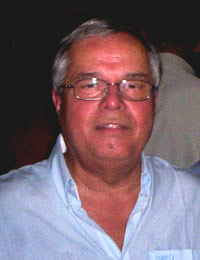 At a get-together recently Schoorman and Riemers were joined by Wesleyites who became household names in the cricketing circles -- L.R.Goonetilleke, Milroy Muthuvaloe, Mervyn Hamer, Sarath Wickremaratne, Kenneth de Silva and C.T.Rodrigo fondly remembered the victories and the defeats of this period. Two of Wesley's most convincing victories beating the star studded Ananda team by an innings and turning tables on Darrell Lieversz and Royal came under Lalith C.R.Wijeysinghe. Riemers and Schoorman figured in many a victory of these years while Mutuvaloe and C.T.Rodrigo performed exceptionally. Wickremaratne was a brilliant close fielder as agile as a monkey and a batsman who had commanding leg side strokes. Undefeated Wesley College were comfortable winners of the Lifebuoy Shield for the Best Schools team in 1963 under Milroy Mutuvaloe, allrounder Darrell Maye being voted the Schoolboy Cricketer of the Year. Mervyn Hamer and Milroy Jebarajah most often laid a solid foundation for Wesley's unbeatable scores.
At a get-together recently Schoorman and Riemers were joined by Wesleyites who became household names in the cricketing circles -- L.R.Goonetilleke, Milroy Muthuvaloe, Mervyn Hamer, Sarath Wickremaratne, Kenneth de Silva and C.T.Rodrigo fondly remembered the victories and the defeats of this period. Two of Wesley's most convincing victories beating the star studded Ananda team by an innings and turning tables on Darrell Lieversz and Royal came under Lalith C.R.Wijeysinghe. Riemers and Schoorman figured in many a victory of these years while Mutuvaloe and C.T.Rodrigo performed exceptionally. Wickremaratne was a brilliant close fielder as agile as a monkey and a batsman who had commanding leg side strokes. Undefeated Wesley College were comfortable winners of the Lifebuoy Shield for the Best Schools team in 1963 under Milroy Mutuvaloe, allrounder Darrell Maye being voted the Schoolboy Cricketer of the Year. Mervyn Hamer and Milroy Jebarajah most often laid a solid foundation for Wesley's unbeatable scores.
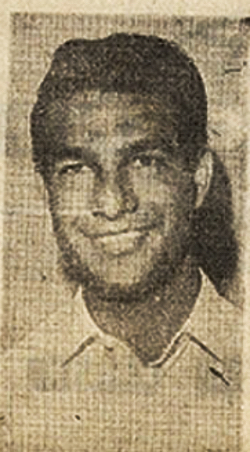 Schoorman is remembered by his players as the best skipper Wesley ever had for with a most mediocre fielding team he and deputy Mervyn Hamer led from the front succumbing only to a very strong Thomian team by eight wickets -- (S. Thomas' losing Boralessa and L.S. Perera for eighteen runs) and to St.Peter's when the Wesley batting collapsed for 60 runs to the seam bowling of Peterite skipper David Heyn, Wesley had to make only 120 runs to win. Picking up from there they defeated a strong Josephian team who declared twice. Wesley scored 202 for 5 in 90 minutes with allrounder Chandran Perera who scored 54 in the first innings making 72 not out in the second. Schoorman made 50. Wesley then beat Trinity, Richmond, Kingswood and were held to a draw by the strong Ananda side who had former Armoured Corps officer Lalith Gooneratne stopping the advancing Wesleyites with a disciplined defensive knock.
Schoorman is remembered by his players as the best skipper Wesley ever had for with a most mediocre fielding team he and deputy Mervyn Hamer led from the front succumbing only to a very strong Thomian team by eight wickets -- (S. Thomas' losing Boralessa and L.S. Perera for eighteen runs) and to St.Peter's when the Wesley batting collapsed for 60 runs to the seam bowling of Peterite skipper David Heyn, Wesley had to make only 120 runs to win. Picking up from there they defeated a strong Josephian team who declared twice. Wesley scored 202 for 5 in 90 minutes with allrounder Chandran Perera who scored 54 in the first innings making 72 not out in the second. Schoorman made 50. Wesley then beat Trinity, Richmond, Kingswood and were held to a draw by the strong Ananda side who had former Armoured Corps officer Lalith Gooneratne stopping the advancing Wesleyites with a disciplined defensive knock.
From the Ceylon Daily News 15th March 1972
Ceylon cricket receives another blow shortly when the Burgher Recreation Club skipper Everard Schoorman emigrates to Australia. He started his career as a cricketer for Wesley College where he soon established himself as a hard hitting batsman. He captained the side in his final year at school. He then joined BRC and played in the Sara Trophy games. There he soon made his mark and captained BRC. He played for Maharajah Organisation in the Mercantile division. Here he helped the Organisation to annexe the Mercantile “A” Division Cup. He also captained the Maharajah Organisation hockey. Everard Schoorman was a fine all round sportsman. His emigration will be a great loss to the BRC, Maharajah Organisation, the sports fraternity in Sri Lanka and the many who knew him. We wish him well in his knew country, Down Under.
 The Hamer brothers - Russel and Mervyn - created a record of dismissals against Royal that year. Russel bowling off and leg spin at 'Kumble' speeds had brother Mervyn catching and stumping five Royalists. Allrounder William Deutrom saved Wesley from humiliation raising a few giggles with his unorthodox defence while the match petered out into a draw. Wesley cricket hit rock bottom when in 1965 led by Donald Thurairatnam they lost to S. Thomas',Trinity, Royal and Richmond by an innings. They beat Kingswood and drew against St.Peter's, St. Joseph's and Ananda. Thurairatnam seemed not to have gained from the experience he earned playing under Mutuvaloe and Schoorman - two master tacticians - learned their trade under Lalith Wijesinghe (1962) and Dharmaratne Koddituwakku (1961). Revival came under allrounder Amaresh Rajaratnam in 1969 that Wesley maintained till the late 1970s. Wesley have been struggling in the past are struggling now. They will need Schoorman type skippers to bail them out.
The Hamer brothers - Russel and Mervyn - created a record of dismissals against Royal that year. Russel bowling off and leg spin at 'Kumble' speeds had brother Mervyn catching and stumping five Royalists. Allrounder William Deutrom saved Wesley from humiliation raising a few giggles with his unorthodox defence while the match petered out into a draw. Wesley cricket hit rock bottom when in 1965 led by Donald Thurairatnam they lost to S. Thomas',Trinity, Royal and Richmond by an innings. They beat Kingswood and drew against St.Peter's, St. Joseph's and Ananda. Thurairatnam seemed not to have gained from the experience he earned playing under Mutuvaloe and Schoorman - two master tacticians - learned their trade under Lalith Wijesinghe (1962) and Dharmaratne Koddituwakku (1961). Revival came under allrounder Amaresh Rajaratnam in 1969 that Wesley maintained till the late 1970s. Wesley have been struggling in the past are struggling now. They will need Schoorman type skippers to bail them out.
Links to further reading
 The Ananda-Wesley inter-schools cricket fixture will be revived after 20 years on the initiative of the Old Boys Sports Clubs of the schools. The match is scheduled for February 24 and 25. When the schools last met in 1980, Ananda was captained by Rohita de Perera and Wesley by Capt. Navin de Silva. Former Sri Lankan captain Arjuna Ranatunga was a member of the Anandian team. The friendly rivalry was manifest between the neighbours throughout the late fifties and into the sixties and seventies. Wesleyites were more often than not Ananda's boogey men. In 1962, a brilliant Ananda led by Sarath Wimalaratne included all rounders 'Tida' Rajapakse and 'Patta' Fernando (both senior officers in the Sri Lanka Army) were trounced by an innings after the hitherto unknown leg spinner Clifford T. Rodrigo finished with a record 8 wickets for 9 runs for Wesley.
The Ananda-Wesley inter-schools cricket fixture will be revived after 20 years on the initiative of the Old Boys Sports Clubs of the schools. The match is scheduled for February 24 and 25. When the schools last met in 1980, Ananda was captained by Rohita de Perera and Wesley by Capt. Navin de Silva. Former Sri Lankan captain Arjuna Ranatunga was a member of the Anandian team. The friendly rivalry was manifest between the neighbours throughout the late fifties and into the sixties and seventies. Wesleyites were more often than not Ananda's boogey men. In 1962, a brilliant Ananda led by Sarath Wimalaratne included all rounders 'Tida' Rajapakse and 'Patta' Fernando (both senior officers in the Sri Lanka Army) were trounced by an innings after the hitherto unknown leg spinner Clifford T. Rodrigo finished with a record 8 wickets for 9 runs for Wesley.
 Wesley was led by Lalith Wijesinghe with Wesley's present Prefect of Games, Kenneth de Silva as his deputy. Ananda had come across other leg spinners in 'Kunghi' Balendra and Elmo Rodrigopulle (St. Benedict's) and suffered similarly. In the years that followed very strong Anandian teams were met on equal terms by Wesley captained in 1963 by Milroy Mutuvaloe, in 1964 by Everard Schoorman and Donald Thurairatnam. Wesley's cricket declined in 1966 but a resurrected 1969 team led by Ameresh Rajaratnam held its own remained unbeaten and won the best schools team award. While Wesley has but three international cricketers to boast of in Abu Fuard, L.R.Goonetillake and Russel Harmer, the Anandians list runs on and on. From Arjuna Ranatunga who scored the first fifty in the inaugural Test, and Sidath Wettimuny who scored the first century (157 against Pakistan in Hyderabhad) and Brendon Kuruppu who scored the first double century against New Zealand. Wesley cricket is not in the doldrums. What it lacks is the positive play needed to change losses into draws and draws into wins.
Wesley was led by Lalith Wijesinghe with Wesley's present Prefect of Games, Kenneth de Silva as his deputy. Ananda had come across other leg spinners in 'Kunghi' Balendra and Elmo Rodrigopulle (St. Benedict's) and suffered similarly. In the years that followed very strong Anandian teams were met on equal terms by Wesley captained in 1963 by Milroy Mutuvaloe, in 1964 by Everard Schoorman and Donald Thurairatnam. Wesley's cricket declined in 1966 but a resurrected 1969 team led by Ameresh Rajaratnam held its own remained unbeaten and won the best schools team award. While Wesley has but three international cricketers to boast of in Abu Fuard, L.R.Goonetillake and Russel Harmer, the Anandians list runs on and on. From Arjuna Ranatunga who scored the first fifty in the inaugural Test, and Sidath Wettimuny who scored the first century (157 against Pakistan in Hyderabhad) and Brendon Kuruppu who scored the first double century against New Zealand. Wesley cricket is not in the doldrums. What it lacks is the positive play needed to change losses into draws and draws into wins.
With an international and reputed tactician at the helm of her team, Wesley's experienced cricketers seem to be overwhelmed by a fear of losing and play for draws. Coaches can groom their players, yet a fighting spirit has to come from within. Scratching around in conducive conditions against Royal proved a point. Wesley has had exciting cricketers in Derek Ingram, Kenneth de Silva, Rodney Perera, Mervyn Harmer, Chandiran Perera and Amaresh Rajaratnam. With these players on song no target was too big. Wesley go out underdogs in this game; Ananda are still a force. Rakitha Wijetunga and his men will have to have a confident and positive approach if they are to make a 'match' of the encounter. Chandrasekera could be a better bowler giving the ball air and Jaldeen as a batsman is wasted when he plays safe.
Links to further reading
By Edmund Dissanayake
 THE SMALL PARK at Karlsruhe was the place where I started cricket with the rubber ball. When I graduated to hard ball cricket practices and junior matches continued to be played there. With the outbreak of the Second world war in 1939 our school and the grounds at Campbell park were taken over by the military. Hence we had to proceed to the prison grounds for our cricket. I first played for Wesley in 1944 together with my elder brothers Chandra and Donald. In 1946 I was asked to lead Wesley. It was a very big challenge, for there were only 3 of the previous year’s players available! Our first match was against Royal on the Railway Grounds, Mt. Mary. One week before this match, Coach Henry Van Buren, a former captain, took me to a house overlooking the ground, where Royal were playing another school. Together we plotted on paper the scoring strokes of certain strong Royal batsmen.
THE SMALL PARK at Karlsruhe was the place where I started cricket with the rubber ball. When I graduated to hard ball cricket practices and junior matches continued to be played there. With the outbreak of the Second world war in 1939 our school and the grounds at Campbell park were taken over by the military. Hence we had to proceed to the prison grounds for our cricket. I first played for Wesley in 1944 together with my elder brothers Chandra and Donald. In 1946 I was asked to lead Wesley. It was a very big challenge, for there were only 3 of the previous year’s players available! Our first match was against Royal on the Railway Grounds, Mt. Mary. One week before this match, Coach Henry Van Buren, a former captain, took me to a house overlooking the ground, where Royal were playing another school. Together we plotted on paper the scoring strokes of certain strong Royal batsmen.
I can still remember the powerful square cut of Kapukotuwa and the flashing off drive of M. Kasipillai. These two shots had to be blocked in order to contain the formidable batting of Royal led by Mahes Rodrigo. Royal having scored 307 for 5 declared at 4.35 P.m. I refused to accept the declaration as according to the existing rules, one and a half hours of batting had to be given to the other side. Then followed a comedy, when the last 5 batsmen stayed at the wickets for an over each, and retired. Royal totalled 317. Subsequently this matter was referred to the MCC who ruled in favour of Wesley. Today a declaration is possible at any time. To continue.... at the end of the first day Wesley had scored 50 for one. I continued batting next day, being the last man out having scored 107 runs. Follow on, Harold Matthysz had been given out for a catch off his boot. Mahes Rodrigo, having consulted the fielder concerned, recalled Harold who had gone to the pavilion. This act of SPORTSMANSHIP helped Wesley to bat the whole day scoring 172 for 7. The last century against Royal had been scored in 1917... 29 years ago. When I went home former cricket captain Stanley Jayasekera presented me with five rupees. This was a princely sum for a schoolboy 57 years ago.
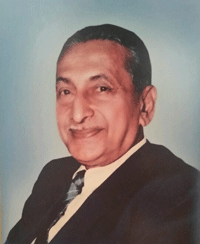 Today a century can bring a boy more than a thousand rupees. In 1947, Wesley had no cricket coach, for Henry Van Buren had been posted to a distant office. Very few are aware that I had to play two roles as Captain and coach! But surprisingly, we beat both Royal and S. Thomas’ both matches being played on the opponents’ grounds at Reid Avenue and Mt. Lavinia. In 1947 Wesley played only 6 Inter-Collegiate cricket matches. Today we play more than 17, beginning in October. During my day, matches were played from 12 noon to 6 P.m. There were two intervals. There were no mandatory overs. But with less playing time, there were rusults. Today matches start at 10 a.m. Teams go out having decided not to lose. The will to WIN is absent today. Earlier protection to the batsman was minimal.
Today a century can bring a boy more than a thousand rupees. In 1947, Wesley had no cricket coach, for Henry Van Buren had been posted to a distant office. Very few are aware that I had to play two roles as Captain and coach! But surprisingly, we beat both Royal and S. Thomas’ both matches being played on the opponents’ grounds at Reid Avenue and Mt. Lavinia. In 1947 Wesley played only 6 Inter-Collegiate cricket matches. Today we play more than 17, beginning in October. During my day, matches were played from 12 noon to 6 P.m. There were two intervals. There were no mandatory overs. But with less playing time, there were rusults. Today matches start at 10 a.m. Teams go out having decided not to lose. The will to WIN is absent today. Earlier protection to the batsman was minimal.
Today even the fielders are heavily protected. If helmets were in vogue in 1947, I would not have ended in hospital after the Thomian match. In the past, appeals to the umpire were not frivolous. Today not only are they frivolous, but intimidatory! I must refer to the match against Royal in 1969, where I had the privilege of coaching Wesley. In this match there were three declarations, and it was in the last ball of the match that Wesley proved victorious. At the end of the match both teams and the officials were invited to a sumptuous dinner hosted by D. S. Wijemanne. The friendships that were cultivated therefrom have been lasting. Talking about coaches, Henry Van Buren and B. J. H. Bahar (Snr) were the most outstanding. They did not carry any certificates. But they produced RESULTS and above all GENTLEMEN. Edmund Dissanayake
From the Island newspaper
1st XI Cricket Team 1953

For one of the finest cricket captains- Bryan Classen, 1953 will be remembered as a glorious year for Wesley, and of very special interest. As under his leadership, Wesley was unbeaten, having registered victories against St. Joseph’s, Royal, Kingswood, Prince of Wales and Richmond. The matches against S. Thomas’, Trinity and St. Peter’s were drawn. It will be seen that only 8 inter-collegiate matches were played then, when compared to the number played today. The authorities concerned should seriously consider whether increasing the number of fixtures will have a deleterious effect on the players themselves. Should not education be the primary concern? The match against Royal has been singled out because of certain special features. In each of three innings, the totals did not exceed 85. Royal scored 68 and 76 while Wesley scored 145 and 84. In Royal’s first innings, the first four wickets fell for a solitary run, which was a leg bye.
There were three sets of brothers — Claessens, Adhihettys and Fuards. In this match, played at Reid Avenue on the 7th and 8th February, as many as 15 players were out LBW of which nine such decisions went against Wesley. For Royal, N. Mathew scored 35, and Patrick Schokman scored 74 for Wesley. In the bowling S. L. A. Wickramasinghe bowled best for Royal capturing 4 wickets for 2 runs in the 2nd innings, while M. N. Samsudeen was Wesley’s wrecker in the 2nd innings, capturing 5 for 17. Just before the Wesley team left for Reid Avenue, one of the Wesleys’ cricketers, who happened to be a prefect also, was summoned before the Principal Cedric Oorloff. The head of a leading girls’ school had come with a complaint that a couple of Wesley boys had hidden behind a giant flamboyant tree, and shouted at a girl, whose hair-style reminded one of a common bird’s nest. The cricketer in question was on duty at the rear entrance to Wesley, but had not taken steps to identify the boys, nor prevent them from shouting at the girl. The principal who was a strict disciplinarian, gave this lad ‘six of the best’. He took up his punishment stoically. But in later life, he reached the highest ranks in the Police Service.
By Dr. Nihal D Amerasekera
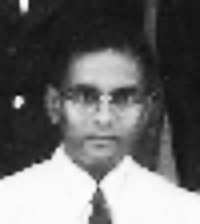 Mr AV Fernando was Wesley's uncompromising cricket coach of the 1950's and he was among the finest. His ability and methods to motivate players are legendary. His record as coach to the Wesley College cricket team was spotless with regular victories against the long established and prominent Colombo schools. Royal and St Thomas' were the big guns and his ambition as a coach was to break that mould. During his tenure as our coach we enjoyed a string of unbeaten teams and years of fine cricket. In those glorious years 3 of our finest cricketers represented the country whilst still at school - Bryan Claessen, Abu Fuard and L R Goonetilleke. The respected sports writer, Premasiri Epasinghe says " Abu Fuard took to cricket at the age of 12 as a fast-bowler. It was his first coach Alban Fernando, who turned Abu, to be an off-spinner". He turned out to be Asia's best off spinner.
Mr AV Fernando was Wesley's uncompromising cricket coach of the 1950's and he was among the finest. His ability and methods to motivate players are legendary. His record as coach to the Wesley College cricket team was spotless with regular victories against the long established and prominent Colombo schools. Royal and St Thomas' were the big guns and his ambition as a coach was to break that mould. During his tenure as our coach we enjoyed a string of unbeaten teams and years of fine cricket. In those glorious years 3 of our finest cricketers represented the country whilst still at school - Bryan Claessen, Abu Fuard and L R Goonetilleke. The respected sports writer, Premasiri Epasinghe says " Abu Fuard took to cricket at the age of 12 as a fast-bowler. It was his first coach Alban Fernando, who turned Abu, to be an off-spinner". He turned out to be Asia's best off spinner.
Mr AV Fernando is an old boy of Wesley College. The Doyen of Wesley cricket and himself a respected coach Mr Edmund Dissanayake writes:: Bryan Claessen owes his success to coach Alban V. Fernando. Alban was hit on the head when he opened batting with Henry Van Buren against Royal in 1931. He had scored 24 runs when he was rushed to hospital after being struck by bowler D. H. Labrooy. The head injury put him off the game of cricket, but not as a coach as he served Wesley in a honorary capacity. We must salute him for the hard work and dedication which he gave his old school free of charge and at his own expense. It seemed he needed only enough money to guarantee his personal independence.
AV was concerned not only with success but to make certain the students understood the basics and nuances of the game. His approach to coaching reflected the manner in which he had played the game and seen it played at the highest level. AV was respected for his intense commitment both to the team and the way in which he wanted them to play. There were times when the boys were apprehensive of his exhaustive training sessions and his abrasive team talks. AV's fireworks graced the coaching sessions without spoiling it. His warmth , indomitable personality and his good spirits seemed to hold a gift for everyone. The players respected him enormously.
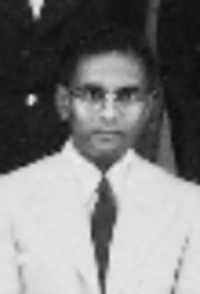 A run saved is a run scored. Many matches are won because of splendid fielding and brilliant catching. Senthil Sinniah, KD Kodituwakku and LR Goonetilleke played Under 16 cricket and went on to be selected for the 1st XI. On their first day AV said " I am going to see if you could field well. If you cant you will not be selected" . Mr AV Fernando encouraged and supported good fielding and believed in the old cricket adage " catches win matches". Once when at practices one of the fielders had his hands in his pocket. AV spoke to him firmly " there is a match going on in the park and another in your pockets". He changed his ways and later captained an immensely successful unbeated side at Wesley.
A run saved is a run scored. Many matches are won because of splendid fielding and brilliant catching. Senthil Sinniah, KD Kodituwakku and LR Goonetilleke played Under 16 cricket and went on to be selected for the 1st XI. On their first day AV said " I am going to see if you could field well. If you cant you will not be selected" . Mr AV Fernando encouraged and supported good fielding and believed in the old cricket adage " catches win matches". Once when at practices one of the fielders had his hands in his pocket. AV spoke to him firmly " there is a match going on in the park and another in your pockets". He changed his ways and later captained an immensely successful unbeated side at Wesley.
He was extremely passionate about his role in the development of Wesley’s young talent and played a big part in helping the boys make the most of their abilities. Known for always observing the spirit of the game, and allowing the bat and ball to do the talking, AV despised' sledging' of any kind. A disciplinarian and meticulous organiser, he was a hugely respected mentor to the hundreds of young cricketers that played under his charge for well over a decade. The youngsters always knew where they stood with him. All through his coaching career his unwavering zest, essential good nature and bubbling optimism shone through.
He was a well known and hugely popular figure among the cricketing circles in Sri Lanka. AV was a regular sports journalist and cricket writer for the Times of Ceylon when he gave his views of the state of cricket in the country. He covered the school games and also the ever popular Sara Trophy cricket. AV could be swift and sharp with the written word as with the spoken word. With his immense knowledge of the game he provided incisive and unbiased accounts of the state of play. His journalistic efforts under the pen name of 'ALBAN' were popular and widely appreciated. Elmo Rodrigopulle writes "Incidentally ‘AV’ was the cricket correspondent when I joined the ‘Times of Ceylon’ in 1961 and had the privilege of being shown how to write and describe the game and must say a big thank you to him for what I am in the world of cricket writing today".
Mr AV Fernando's effusiveness at moments of excitement could lead to some equally delightful situations. During a match against Royal College at Campbell Park, Wesley were hanging on for dear life with Erroll Smith and Kenneth De Silva at the crease fighting for a draw. Dark clouds gathered rapidly when the batsmen appealed for bad light. The umpires lifted the bails to the dismay of the Royal supporters and the match was called a draw. The story goes - FC De Saram , an ardent Royal supporter and a former All Ceylon Cricket Captain was furious and berated the umpires and all those gathered in the pavilion. The shock in the crowd was palpable. AV's expressive face came alive with adrenaline-fuelled emotion. The suggestion of bias infuriated AV Fernando. He wasn't amused by this tirade and answered firmly " If you were in this position you would have done the same". There was much laughter and then a deathly silence of acceptance.
Mr AV Fernando earned the respect of the young 1st XI cricketers at Wesley College to whom he gave of his best. He was well aware of the agony and the ecstasy of school cricket and the passion it generated. The cricketers have the highest praise for him and they will remember AV's support all through the victories and defeats during the hectic cricket season. AV was the catalyst around which the whole team was built. He coached the school during those glorious years of Wesley cricket to produce some of the finest unbeaten teams that entertained and enthralled us all.
Mr AV Fernando is regarded as among the finest coachers and most authoritative cricket scribes of his generation. Being a bachelor he gave his all to cricket. He helped to re-establish Wesley in the top echelons of School cricket. With his sound temperament, jovial nature and great cricketing knowledge he produced some of the finest teams that Campbell Park has seen. He will be long remembered for his loyal service to his alma mater and also as an outstanding man.
May he find Eternal Peace

Sent by Olkie Edema (Canada)
Perhaps the best cricket team that Wesley ever had – I believe it was in 1953/4. I had joined Wesley the year before (from S Thomas’ Prep). I took this photo of a picture hung up in the old Wesley pavilion, while in SL earlier this year.
Incidently, A.V. Fernando was still coaching Wesley when I played. At an ‘end of season’ party (at Lorenz Ebert’s place) he came over to me, put his arm around my shoulders and said “Olkie, in my opinion, you’re the finest bowler that Wesley has had”. The only problem…. A.V. was blind drunk at the time!! Poor chap died from either cirrhosis or a heart problem not long after.- Olkie Edema
Notwithstanding reduced fixtures and shorter playing hours, Bryan Claessen notched up 4 centuries. Against Trinity (101 not out) 115 vs Kingswood, 157 not out vs Richmond and 105 vs S. thomas’. His best bowling performance was against Zahira (9 for 37). Other good performances were 8 for 68 vs St. Joseph’s, 6 for 39 vs Kingswood, 6 for 20 vs Prince of Wales, 6 for 87 vs Trinity, and 6 for 38 vs Richmond. Bryan was selected to play for All-Ceylon while at school, in 1953, under Sargo Jayawickreme’s captaincy, against the powerful Australian Team skippered by Lindsay Hasset. Bryan was an outstanding and complete cricketer, a stylish and aggressive strokemaker with an array of strokes all round the wicket. He was also a wily leg spinner, who bamboozled batsmen with his flight and spin; a brilliant fielder in any position, and one of the prodigious captains produced by Wesley. He owes his success to coach Alban V. Fernando. Alban was hit on the head when he opened batting with Henry Van Buren against Royal in 1931. He had scored 24 runs when he was rushed to hospital after being struck by bowler D. H. Labrooy. The head injury put him off the game of cricket, but not as a coach as he served Wesley in a honorary capacity. Bryan migrated to Australia in 1957, and secured several awards in cricket. He will be remembered as the first Sri Lankan to be elected President of South Australia’s District Cricket Club. Professionally, Bryan was a Prosecutor in Family Law. When he retired in March 1988, he was in charge of the Division responsible for the enforcement of family support orders in South Australia. Wesley’s wonder team of 1953 consisted of Bryan Claessen (Capt.), Ansar Fuard, Abu Fuard, Pat Schokman, B. N. Jurampathy, Lon Adihetty, Vincy Adihetty, A. R. Chapman, Herman Claessen, C. N. Gallaher, D. Range, A. P. Batuwitage M. N. Samsudeen and N. W. Fernando, the coach was A. V. Fernando and Master-in-charge was J. L. F. de Mel. Edmund Dissanayake
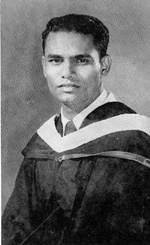 Hockey at Wesley is almost synonymous with Hockey in Sri Lanka. It is a presuptious statement to make, but with much truth Wesley has produced the stalwarts for Hockey in Sri Lanka. They are presently-at the helm of affairs in the controlling bodies. Their interest in and dedication", to Hockey is so apparent that it is almost impossible .to think of them except at a national level. This article attempts a resume of Hockey since 1950. In 1950, Wesley was already a school with a reputation for Hockey, The boys knew it and the coaches and masters in charge were alive to the challenge to keep up the standards. Messrs. Fred Abeysekera, Danton D'Abrera, N. A. B. Fernando were at the helm of affairs determining the standards for the school. Mr. T. Amit, a hockey enthusiast of repute, helped the school as an honorary coach and Later Mr. Freddie White, a Ceylon Cap. Success of a game like Hockey depends very much on the training of juniors. This probably is the one main factor that almost guaranteed the maintaining of hockey standards. Mr. Abeysekera had already initiated the moves to have a series of junior teams Under 16, Under 14, etc. The junior teams were well handled and expertly coached. Mr. A. Mylvaganam, an old Wesleyite and a Ceylon Cap was a tower of strength along with Messrs. Walter Jayasariya, the late T. M. N. Mahamooth, and Mervyn K. Peries. It was a hockey rally" so many to help and so many willing to give their time, money and energy for Wesley hockey.
Hockey at Wesley is almost synonymous with Hockey in Sri Lanka. It is a presuptious statement to make, but with much truth Wesley has produced the stalwarts for Hockey in Sri Lanka. They are presently-at the helm of affairs in the controlling bodies. Their interest in and dedication", to Hockey is so apparent that it is almost impossible .to think of them except at a national level. This article attempts a resume of Hockey since 1950. In 1950, Wesley was already a school with a reputation for Hockey, The boys knew it and the coaches and masters in charge were alive to the challenge to keep up the standards. Messrs. Fred Abeysekera, Danton D'Abrera, N. A. B. Fernando were at the helm of affairs determining the standards for the school. Mr. T. Amit, a hockey enthusiast of repute, helped the school as an honorary coach and Later Mr. Freddie White, a Ceylon Cap. Success of a game like Hockey depends very much on the training of juniors. This probably is the one main factor that almost guaranteed the maintaining of hockey standards. Mr. Abeysekera had already initiated the moves to have a series of junior teams Under 16, Under 14, etc. The junior teams were well handled and expertly coached. Mr. A. Mylvaganam, an old Wesleyite and a Ceylon Cap was a tower of strength along with Messrs. Walter Jayasariya, the late T. M. N. Mahamooth, and Mervyn K. Peries. It was a hockey rally" so many to help and so many willing to give their time, money and energy for Wesley hockey.
In the Sixties, Wesley was represented in the controlling bodies and was therefore responsible for the organisation of national tournaments. For the first time, a schools team from India visited Sri Lanka-the Bal Mandal Team-and Sri Lanka triumphed much to the jubilation of the hockey enthusiasts in the country. A lad from Wesley, Shanti McLelland was chosen skipper of one national team. There never was a year when Wesleyites did not represent a 'national schools hockey team in Sri Lanka. This is a matter of great pride. It is noted for purposes of record that in the mid-sixties, the Ceylon Schools Hockey Federation was given a special permit by The Government of Ceylon to import, hockey equipment direct. The cost of hockey gear therefore dropped to such an extent that almost 300 boys of Wesley purchased sticks, This meant that about a third of the boys, a wonderful sight indeed to watch all these lads moving into Campbell Park each day at 4p.m. to learn how to play. Almost all age groups Were represented and until the 1970's. These lads who began playing the game under 10 were playing serious hockey for the school. The boys were divided into a number of groups and Mr. Amit organised physical instruction classes before they were allowed to push the ball around. It is still a sight we remember with great satisfaction. In this article, no attempt is made to record our performances year by year.
At one time, the hockey 'strong' schools preferred to play us early in the season to boost their morale "by defeating us. In the sixties, it was the other way round They postponed our fixture to the maximum possible extent, much to our dislike. We wanted 'morale boosters' too! There was hardly a match we played with possibilites of defeat. More often than not, we were the feared team and both spectators and players were certain our hockey team would play the game in the spirit in which games such as hockey, should be played. We won and rejoiced more often than we lost and got disappointed. Wesley knows that hockey is now her traditional forte. To single out individuals as outstanding would be an impossible task, suffice it to say, that our quota of representation in national hockey is envious which reflects our per mances in school, Young stalwarts- like Bashurdeen Musafer, Rajah Jayasuriya, Swangsa; C. T. Rodrigo, Sarath Wickramaratne, Sandy Musafer are well known in hockey circles as nation-class players and at the moment even younger players such as A. L. George, Jeganathan brothers, Rohan Amerasinghe, Shanti McLelland considered right on top in Hockey. The young and the not so young are now together at national hockey representing the country at international tournaments some under the banner of the Old Wesleyites Sports Club, others affiliated to hockey playing clubs. Very soon, they will all join to play for the OWSC only, and we are certain, with such stalwarts as these school hockey too cannot go steeply down. Wesley must remain the only nursery for the strengthening of O.W.S.C. and we are confident hockey at Wesley will go on improving to an extent when we could form the nucleus of national teams in the near future. Wesley and hockey will go together, we are confident, for many more years to come.
Links to further reading
 When the Editor of -the Wesley College Centenary Celebrations, souvenir requested me to write a short piece reminiscent of my schooldays at Wesley, I had no alternative but to write a little about myself which has now become history. I am well aware, being a journalist that it is unethical to do so. But I can think of no, other incident which is important to me and to the college. Hence this article. The resurrection of Wesley cricket after a lean period for almost a decade came under the leadership of Henry L. Van Buren, who died a few years back. Van Buren piloted Wesley to an invincible season in 1935 which brought back Wesley to where it belonged. To carry on the good work that Van Buren had left was no easy task. Wesley's ardent supporters of the game, well wishers and old boys, kept their fingers crossed the 'following year, hoping that Henry Duckworth (now in Australia) would continue with the good work. Although Van' Buren's reputation of invincibility was formidable, skipper Duckworth performed something that was beyond even the great Van Büren. Wesley had never won against -St: Joseph's in the long cricket association of the two schools up to then.
When the Editor of -the Wesley College Centenary Celebrations, souvenir requested me to write a short piece reminiscent of my schooldays at Wesley, I had no alternative but to write a little about myself which has now become history. I am well aware, being a journalist that it is unethical to do so. But I can think of no, other incident which is important to me and to the college. Hence this article. The resurrection of Wesley cricket after a lean period for almost a decade came under the leadership of Henry L. Van Buren, who died a few years back. Van Buren piloted Wesley to an invincible season in 1935 which brought back Wesley to where it belonged. To carry on the good work that Van Buren had left was no easy task. Wesley's ardent supporters of the game, well wishers and old boys, kept their fingers crossed the 'following year, hoping that Henry Duckworth (now in Australia) would continue with the good work. Although Van' Buren's reputation of invincibility was formidable, skipper Duckworth performed something that was beyond even the great Van Büren. Wesley had never won against -St: Joseph's in the long cricket association of the two schools up to then.
To triumph against the Darley Road boys was a gargantuan task, especially in l936, under the astute Josephian captaincy of Malcolm Spittel, whose team that year was unbeaten. The Josephians, with victories 'against Royal, St. Thomas' and Trinity, It was a formidable combination of strength and naturally Spittel and his men were classed as firm favourites against Wesley at Darley Road. There was drama and excitement from, the first ball bowled until the last. This was expected as both teams had in their ranks some of the finest schoolboy cricketers, who later won their Ceylon 'caps". They were Spittel and Gerry Gooneratne of St. Josephs and Mahadevan Sathasivam, Sella Nagendra and Ivan Walbéoff of Wesley. Yes, in the cricket firmament that year a new star was born. He was M. Sathasivam, who later. Established himself as the most outstanding batsman Ceylon ever produced. With Sathasivam in brilliant batting form, with a classic century to his credit the previous week against S. Thomas Wesley's batting could ,match evenly with that of the Josephians. This last school encounter between St. Joseph's and Wesley produced spectators of unprecedented magnitude. In fact the whole Darley Road grounds and precincts were swarming with crowds who had come to watch the 'battle of the giants'. The two schools were led by first cousins Spittel and Duckworth and the scene was charged with excitement.
In theory the Josephians had the edge over the Wesleyites and it was with some trepidation that Wesley took the field. Despite the treacherous matting wicket and the scorchingly fast outfield, it was a tussle in which bowlers dominated, preventing batsmen from taking undue' liberties. Even the mercurial Sáthasivam, of whom everyone expected a century, failed to penetrate the tight field and the effective bowling. Strangely enough, spinners of both schools contributed to the low scoring game. Gooneratne, David Arndt and Spittel proved unplayable, while for Wesley the damage was done by the spin twins Stanley Jayasekera and Reggie Joseph. - As a fresher who opened the 'new ball attack for Wesley, no one took me seriously as a batsman, but it was in this game that I had the great honour of steering Wesley to victory with Walbeoff, to the tumultuous cheers of the record crowd. In this low scoring clash, the Josephians trailed the Wesleyites by a dozen runs on the first Innings, with the batting and bowling honours evenly distributed. The second day's play evoked great interest -and enthusiasm and when the last Josephian, batting pair left the centre, Wesley were given a victory target of making 120 odd runs in almost even time. Against the, tight Josephian attack spearheaded by Spittel, Gooneratne and Arndt, victory for Wesley was out of sight beyond the distant horizon.
Wesley wickets fell at regular intervals and with Sathasivam, Duckworth, Nagendra and Emil then back in the pavilion, the task of winning looked remote. The fall of the eighth wicket sent me to the centre with 15 runs-to make for a win in even time. At first I was nervous and trembling as I never experienced an ordeal of this nature before. But I was consoled with the fact that Walbeoff was at the other end unperturbed having been there for a considerable time. Spittel's first delivery whistled past my right ear and the second whacked me on the hip, leaving a dent which remains 'up to this day' the impact of leather on muscle and bone is something I cannot describe. At the other end Walbeoff cautioned me to play a straight bat to the ball that came straight through. Later, of course, I did this with the efficiency of a veteran. Then came the crucial moment, when a Spittel in swinger hit my bat and to my great delight the ball sped to the leg side boundary, bringing the target closer. Eleven precious runs to make in 10 minutes. The tantalising bowling of' left armer Gooneratne was my next, hurdle to clear. Within a matter of 'minutes victory was within striking distance. At this stage Wesley had to make 3 runs with two wickets intact. . Although Spittle had ideas of shattering my stumps, I was equally confident about myself. Spittel charged down the bowling, run-up with additional zest and his fatal ball, an in-swinger, I dispatched to the fine, leg boundary, giving Wesley the much needed runs for victory the first ever, against St. Joseph's College.
Addendum: by Shanti McLelland
It was extremely interesting to read one of Wesley's great victories at cricket, specially against St. Joseph's. Specially because, over the years Wesley consistently had thrilling encounters with St. Josephs College at Darley Road. The article was written in the same style Christie Seneviratne wrote many cricket reviews for many years for the Daily News. Christie a towering figure won respect from many of the visiting sports reporters, cricket pundits, eminent cricketers, and officials for this explicit knowledge of the game and the outstanding ability to recapture memorable feats of many cricketing greats, and for his unbiased reporting. He succeeded Carlton Seneviratne to become Sports Editor of the Ceylon Daily News. Some Wesleyites he worked with would remember him as a jovial and an extraordinary friend and colleague. He would always give a junior an opportunity to cover some of the elite sporting events, which was a rare quality. He was figurative in his previews, literal in reporting results, and of emblematic in his reviews. He maintained the highest standards of ethical journalism. Christie Sevenviratne's cricketing column will be always remembered, so will the pseudonym. He cherished to publish his 'nom de plume', which of course will remain so. Christie contributed to Wesley's cricket in the sixties, when Nihal Seneviratne followed his father's footsteps to represent Wesley. Nihal opened bowling for Wesley, with his right hand medium pace and like his father, he was a reliable tail-end batsman. At stumps, we see them walk back to the pavilion, with the double blue flag flying high in their honour.
- Christie Seneviratne Remembered by Premil Ratnayake - Click
- M.Sathasivam by Christie Seneviratne - Click
- In Memoriam - Nihal Seneviratne Added 28th July 2022
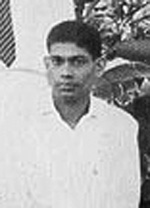
The First Game
Wesley's 'cricket history dates back to 1893-to the inauguration of the Wesley-Royal series, which is the second oldest cricket series in Sri Lanka. To the late Percy de Bruin fell the honour of captaining that Wesley team of 1893; the Royal captain being M. D. Cockburn, while one of the umpires was Mr. John Harward, then Principal, of Royal College. The historic match was played at San Sebastian, then the home of the Royalists. The first Wesley team included G. B. Honter, Z. H. Mantara (one of Malay C.C.'s best cricketers), T. A. Akbar, C. E. Perera, Gerard Wijekoon (later Sir Gerard, one time President of the now defunct Senate) and W. Faber.
Two Greatest Teams
Considering that Wesleyites who have -watched Wesley cricket over the past thirty years are almost unanimously agreed that Bryan Claessen's team of 1953 was the greatest Wesley team they have seen, it can be stated here that-the two greatest Wesley teams during her cricket' history were C. R. Perera's XI of 1896 and Bryan Claessen's Xl of 1953. Those Who comprised the latter team were: the Fuard brothers-Ansar and' Abu, the Adihetty brother Lou and and Vincey, Pat Schokman,MN. Samsudeen, Niel Gallagher Arthlow Chapman, the late Herman Claessen (the skipper's brother), T. Range and B N. Juranpathy. ,Of this team, Bryan Claessen and Abu Fuard represented Sri Lanka, white Pat Schokman and M. N. Samsudeen were awarded C.C.A caps.
The Greatest Batsman Ever Produced - Best Bowlers Too
Wesley has had a number of ups and downs in her cricket history, and in this chequered career she holds the proud distinction of having produced the greatest right-hand batsman ever produced in this country. E. Perera who captained the College team in 1899. In the bowling department too Wesley has had the best pair of schoolboy bowlers in the island, in Lyn Barbut and V. O. Nathaniels (the former a slow left-arm bowler while the latter was a deadly contrast as speedster), and in first-class cricket Sri Lanka had no better pair of left arm bowlers than the Wesley products. E. S. Mendis and Sam Gunasekera, each of whom had bagged over 100 wickets.
Founding of Sinhalese Sports Club
It may interest readers to note that while captain of Wesley, C. E. Perera captained the famous Combined Colleges XL of 1899 that was composed of 11 Sinhalese cricketers and this led to the formation of the Sinhalese Sports Club; its founder none other than another' Wesleyite, H. J. V. Ekanayake -The inaugural meeting was held in the Wesley College Hall, at Dam Street, Pettah.
Big Names In Wesley Cricket (Early Period)
Leading cricketers produced by Wesley after 1900 were C. A. Perera (brother of the great C. E. Perera-and the first Wesleyite to score a century), F. W. Dias, R. E. S. Mendis, E. J. Melder who, in S. P. Foenander's opinion was the greatest left-hand batsman , Sam Gunasekera, S. Nagendra (Snr.), Richard de Alwis, O. C. Amath, and A. M. Fuard. Richard de Alwis was a right-arm fast medium bowler who once captured nine wickets in an innings against Royal and this performance is still a record in this series (there are only two other instances of a Wesleyite capturing nine wickets in an innings . W. E. de Zylva bagged nine for 14 against Richmond in 1912 and Amaresh Rajaratnam returned figures of 9 for 10 against Issipathana in 1969). This had perhaps been Wesley's most glorious era in cricket, the team remaining unbeaten for three consecutive years, from 1908-1910.
Up to 1940
Other cricketers who did Wesley proud during the first thirty years of Wesley cricket were E. A. Gunasekera, T. Sathasivam, M. K. Cassim, N. Molligoda, the late R. L. Kannangara (the only Wesleyite to score two centuries against Royal in consecutive years), A. H. M. Ismail, the Mayo brothers H. E. L. and A. T. M., A. E. Seneviratne, V. N. Vandendriesen a P. H. Nonis. Excelling for Wesley during the. thirties were R. Jeganathan whose record score for Wesley 163 against' Trinity in 1932-was broken only in 1961 when Ronald Smith made 199 against Richmond, and this in turn was eclipsed by Mervyn Hamer who made 233 against Kingswood in l964 H. L. Van Buuren, S.W Jayasekera, H. N. Duckworth, I. H. Walbeöff, C. P. W. Vangeyzer, C.Ganegoda and M. Sathasivam. The last named was the most brilliant batsman produced in Sri Lanka since C. E. Perera, and occupies a prominent place in the roll of honour. He enlivened the local cricket scene with his particular brand of batsmanship, and has scored more centuries than any other Wesleyite. One of his more noteworthy knocks was the century he made in the Pent angular Tournament in India, and his best performance too was recorded in India when he made 217 in Madras, which is a record for a Ceylonese cricketer in India. Incidentally, in making 'this score, Sathasivam broke England's Joe Hardstaff's 'ground record of 214. "Satha" as he is popularly known has the added distinction of being perhaps the only cricketer in any part of the world to have led two national sides-All Ceylon and Malaysia.
1940 Onwards
Wesley's cricket 'during the war years was badly affected mainly due to the school being deprived not only of proper ground facilities but of her very home as well, which was taken over by the armed forces for use as a military hospital Nevertheless, even during these difficult years Wesley produced a number of cricketer who did 'their College proud. Among them were S. Nagendra (Jñr.) who following in his famous father's footsteps too won representative honours (the only Wesleyite. father-and-son due to' achieve this honour, A. A. Perera, B. T. Henderling, T. I. Cassim, and A Mylvaganam (who was considered the best schoolboy bowler of his time, and later 'represented Sri 'Lanka). Under the captaincy of J A. A. Perera, in 1944, Wesley emerged champions in intercollegiate cricket. That year, Wesley beat St. Thomas' (by an innings) St. Joseph's, Trinity and Richmond. The conclusion of the war,' and Wesley's return to her traditional home as well as the availability of Campbell Park for use of her cricketers saw the school emerge as a 'force to reckon with in inter-collegiate cricket. During the period following the war, a feature of the Wesley teams with a few exceptions, was that there was at least one set of brothers playing for the College each year. The brothers who had represented Wesley since the war included the Dissanayake brothers Chandra, Donald and Edmund: Abeywardena brothers Piyasiri and Lakshman Mack brothers Derrick and Spencer; Ebert brothers: Denis and Lorenz; Claessen brothers-Radley, Bryan and the late Hermon; Fuard brothers-Ansar, Abu and M. H. (the first named, like his father, A. M. Fuard, captained the school); Adihetty brothers-Lou and Vincey; Rajasinghe twins; Hamer brothers Mervyn, Russel and Glanville, Wickremaratne brothers-Sarath and Rohan (the former captained the Central Province team versus "the visiting M CC. team in early 1973); Schoorman brothers-Everard and Francis; Jeganathan twins Haridharan and Sridharan; and the Jansz brothers; the late 'Travis, Ray and Tyrone (the last named was the fastest schoolboy bowler. in 1972). Outstanding among. post war Wesley cricketers arc Brian Claessen, Abu Fuard, Lucky Gunatilleke, Russel Hamer (all of whom represented the country in "unofficial" test cricket), Pat Schokman and Samsudeen (who 'won C.C.A. caps). Brian Claessen was capped for Ceylon while a schoolboy, while Samsudeen similarly won his C.C.A. cap as a schoolboy. Cricket history might have been created when twins-the Rajasingham twins opened batting for Wesley. Eight Wesleyites held the distinction of leading first class club teams since the war. They are M. Sathasivam (Tamil Union), Lucky Abeywardene (Bloomfield),' 'Bryan Claessen (Colts), Clive Bartholomeusz (B.R.C.), Abu Fuard (Colts), Maxwell de Silva (Catamarans), Everard Schoorman (B. R. C. ) and Russell Hamer(Bloomfield).
Declaration Controversy
After the war, Wesley emerged as a striking force in inter-collegiate cricket with her team of 1947. Ably led by Edmund Dissanayake she convincingly 'beat 'both Royal and St. Thomas' the Only time this had been achieved In the last 51.years. Edmund 'Dissanayake, as a' captain'; was a shrewd tactician, and Wesleyites will recall how by his strategy in the 'encounter with Royal' in 1946, he became 'the centre of controversy. The matter was of such' magnitude 'that it' was referred to the 'M.C.C. who 'ruled In' favour of the Wesley skipper.
Unbeaten Teams After The War
In the early fifties, Wesley dominated intercollegiate cricket and were unofficial champions in 1952 and 1953. The 1952 team under Radley Claessen was beaten by St. Thomas', but 'Bryan Claessen's' 1953 team remained unbeaten, the first to achieve this since the war. The feat was repeated in 1961 under D. Kodituwakku, in 1963 under Milroy Muthuvaloe and; in 1969 under Amaresh Chandra Rajaratnam. Wesley annexed the Lifebuoy Shield in 1963 (The first year of its award) on being adjudged the best school team and on repeating this feat lit 1969, she became the first school to 'win this shield twice. In' 1963 Wesley had the added distinction of having one of its team-namely Darrell Maye chosen as Schoolboy Cricketer of the Year.
Memorable Victories
Wesley's greatest post-war victory was over the formidable Josephian'team of 1952,' the. most impressive an innings victory over. the Thomians in 1950, and the most exciting a 'victory by 10' runs over. Royal in 1969, with the last ball of the last over (one cannot forget, however, how Lou Adhihetty's side. of 1956 hit up 49 runs in only 12 minutes to defeat Trinity, with only a couple of minutes to spare). The highest number of victories in a season was recorded in 1962 under Lalith Wijesinghe when Wesley won six matches, five of them. In consecutive games against St. Joseph's Trinity, Royal, Richmond and Ananda. The sixth victory was in an earlier match versus 'Kingwood.
Best Bowling Performances
Some of the best postwar bowling performances Wesleyites 'can recall: are 9 for 10, including a hat-trick, by Amaresh Rajararatnam when 'Issipathana were sent reeling for 31 and 8' for '9 by C. T. Rodrigo when Ananda crashed 'to an innings defeat 'in 1962, and a haul of 8 wickets by Lucky Gunatilleke in 1959 when he ripped through the Maris Stella batting lineup, to help Wesley shot them out for only 16. Going back to the early, period, Wesleyites will recall the match against Trinity in 1910, when 'C. S. Jayasinghe and M Sathasivam' both performed the "hat-trick" in their second innings. Fielding and .wicket keeping 'had played. a prominent role in Wesley' successes, and in the post war period Wesley was fortunate to have a number of top-notch wicketkeepers Among them were Harold Mathysz, Pat Schokman; Mervyn Hamer, Russel Hamer, and' Patrick Jansz. Russell' Hámer crowned himself with glory when selected to represent Sri Lanka in 1972. . Patrick Jansz established what may be an inter-collegiate record when he made 10 dismissals against Richmond in 1969. As for close-in fielding. Sarath Wickremaratne in his specialist' position of gully, or at short-fine leg, thrilled spectators with' his spectacular catches. Most remarkable was his "match bag" of 9 catches against Ananda in 1962-probably another intercollegiate record.
Greatest All-Rounder
If one were to pick the greatest postwar cricketer produced by Wesley the obvious choice is Bryan Claessen. He played for Wesley from 1950-53, captaining the team in his last year. In 1951, the "Spotting times" picked him as the best all-rounder in schools, and 'in 1952 he again received recognition-as the best bowler in the schools. He crowned .his school' cricket career by achieving the rare distinction of leading his team to be the first unbeaten post-war Wesley side and unofficial school cricket champions for 1953 to 'cap it all, his was the greatest post-war Wesley team, and one' of the two 'greatest teams produced by Wesley in her eighty years of cricket. Add to this, his selection., While in school, to represent' Sri Lanka versus the Australian Test team led by Lindsay Hassett a rare achievement, in the fifties, for a schoolboy. He was an outstanding and complete all-rounder-a stylish and attractive batsman with an array of strokes all round the wicket,, a wily right-arm leg spinner who bamboozled leading batsmen with his flight au spin, an alert and brilliant fielder in any position and an astute leader and captain.
Fight Back and Hope
This, then, is Wesley's record in cricket She has had her great moments; those not so great, and yet others which were far from great. She has acknowledged triumph with grace, defeat without rancour, and has' battled adversity with courage and tenacity, fighting back gallantly while' demonstrating what sports writers" in Sri' Lanka have now come to identify 'as "sheer Wesley guts", to snatch victory from the jaws of defeat.
1st XI Cricket Team 1947

To Wesleyite, the year 1947 was ,a memorable one. For, under the leadership of their cricket captain. Edmund Dlssanayake, after a long period of 31 years, Wesley were able to defeat both Royal College and S. Thomas' College, In the same season. After their victory against Royal at Reid Avenue, Wesley were to meet St. Thomas at Mt. Lavinia, the following week. But the Wesley Captain was greatly troubled in mind.. When questioned as to the cause of his anxiety he stated that he had an uncanny feeling, something that he could not fathom a feeling that he would be seriously 'injured the Thomian match. St.Thomas' was captained by Upali Katugaha, who had Ronnie Weerakoon as his deputy. An unprecedented crowd was present to watch the Thomians reel under Wesley's pressure, with Edmund bowling his heart out to capture 6 wickets for 14 runs. The first day ended on a triumphant note for Wesley. The Wesley Captain had troubled thoughts haunting him..., an accident ....hospitalisation.... and perhaps death! Was this a premonition! Come Saturday. The understanding Principal (Rev James Cartman) decided to drive his captain to Mount Lavinia. How many Principals would do such a thing today? The car had barely proceeded a hundred yards, when right opposite the Children's Hospital, 'the car stalled for no apparent reason. Heavy black smoke, ominous as it were, began to bellow forth from the under-carriage. That worthy English gentleman, lay full length on the dusty, dirty road to remedy the apparent fault in his car but the captain's mind was not at ease.
At Mount Lavinia. the young Wesley team battled valiantly, and once again the Thomians were at sea, having lost their first six wickets. for only 60 runs 'and a huge total facing them.. This time the Thomians had to contend with a different form of strategy-the presence of a fielder at "suicidal" short-leg. The Thomian batsmen, playing defensively, were caught out at short-leg. Then it happened N. S. Jayasundere who had been bowling an immaculate length, sent a delivery that slipped off his palm, and Ronnie Weerakoon clobbered the full toss, the ball striking Edmund (at short leg) with a resounding thud on his head. Edmund swung round and fell full length on the wicket. Rev. Cartman was the first to rush into the field, and 'as he carried off his captain, even the ranks of Tuscany could scarce forbear to cheer. Before he lapsed into unconsciousness the Captain gave vital instructions about bowling changes. Wesley emerged victorious by 112 runs.
BATTLE FOR LIFE At the Durdans Private Hospital, Dr. J. H. F. Jayasooriya, the eminent brain surgeon, battled round the clock to save the life of this cricketer It was found that he suffered from concussion of the brain, laceration of the brain tissues, associated with paralysis of the region below the waist. His recovery was indeed a miracle.. Many interesting stories were related during the one and a half months that Edmund lay between life and death. Another E. Dissanayake's death had been announced in the "Stop Press" column, and sympathisers presuming the worst had happened to Edmund, flocked to the Durdans. The cricket teams of Royal and St. Thomas' too were there! The rumour of his "death' spread to Galle, where a sister school, held a special Memorial Service! It is interesting to record that the last occasion on-which Wesley defeated S. Thomas ' at Mt. Lavinia, was under Edmund's captaincy in 1947; and at Campbell Park, in 1972, under Edmund's coaching. By Courtesy of Editor.
 An old scrap book with newspaper clippings discoloured with the passage of time, revealed some of the superlative cricket deeds of Mahadevan Sathasivam, the greatest of Sri Lanka's batsman. I was alarmed at his modesty, when I interviewed him at his home in Bambalapitiya, to write his memoirs for the Wesley College Centenary Souvenir. Sathasivam's exploits in the game have always been known far and wide from the time he was a chip of a schoolboy. I had the rare privilege of being his classmate and colleague at Wesley for a number of years until I was singularly honoured playing in the same Wesley team with him in the third term of 1935 and in the full intercollegiate season of 1936. The rolling-stone attitude of Sathasivam took him from Wesley to St. Joseph's and back. But finally, Wesley became his domain, largely due to the efforts of his father, who was himself an illustrious old Wesleyite. Later in life Sathasivam had the honour to play with stalwarts of the game like C. K. Nayudu Vijay Merchant, Mustaq Ali, Vinoo Mankad, Keith Miller, Ray Lindwall and those redoubtable West Indians, the three terrible W's - Worrel, Weekes and Walcott. For almost a quarter-century, Sathasivam had held the spectators spellbound with his batting virtuosity, and often crowds that watched his innings would nostalgically~ compare it with an earlier Sathasivam innings. Satha wielded the willow with such fluency that he nia4c the bowler look silly at times.
An old scrap book with newspaper clippings discoloured with the passage of time, revealed some of the superlative cricket deeds of Mahadevan Sathasivam, the greatest of Sri Lanka's batsman. I was alarmed at his modesty, when I interviewed him at his home in Bambalapitiya, to write his memoirs for the Wesley College Centenary Souvenir. Sathasivam's exploits in the game have always been known far and wide from the time he was a chip of a schoolboy. I had the rare privilege of being his classmate and colleague at Wesley for a number of years until I was singularly honoured playing in the same Wesley team with him in the third term of 1935 and in the full intercollegiate season of 1936. The rolling-stone attitude of Sathasivam took him from Wesley to St. Joseph's and back. But finally, Wesley became his domain, largely due to the efforts of his father, who was himself an illustrious old Wesleyite. Later in life Sathasivam had the honour to play with stalwarts of the game like C. K. Nayudu Vijay Merchant, Mustaq Ali, Vinoo Mankad, Keith Miller, Ray Lindwall and those redoubtable West Indians, the three terrible W's - Worrel, Weekes and Walcott. For almost a quarter-century, Sathasivam had held the spectators spellbound with his batting virtuosity, and often crowds that watched his innings would nostalgically~ compare it with an earlier Sathasivam innings. Satha wielded the willow with such fluency that he nia4c the bowler look silly at times.
 A long-hop by a fast bowler was promptly dispatched to the boundary with such ease that no bowler ever tried a second bouncer at him. He was always alert, with swiftness~ of feet, to steer the bail to any part of the field as he wished. A half volley was sent crashing to the boundary. But the stroke that had the real grace of an artist was late-cutting a paceman. He showed no weaknesses and it was a nightmare for a bowler to bowl to him. This was Sathasivam. He was not, in strict terms, a disciplined cricketer, but because of his brilliance, coupled with his absolute& self-confidence, one forgave him all his faults. In other words, he was a born and gifted cricketer who paid scant. respect to physical fitness. With his masterly and majestic stroke-play he was able to conserve the limited energies he had at his command. I would term Sathasivam's greatest innings as the one he displayed at Chepauk in Madras, when his double century for Ceylon against Madras wiped out Joe Hardstaff's age-old ground record, On that hot and stuffy day in 1947, Sathasivam meted out a remorseless battering on such bowlers as Madras paceman Raugachari Andy the two Indian Test men, M. J. (Gopalan and Ram Singh. Earlier in 1944, when the Bombay officials heard of Sathasivain's effortless and meaningful batting, they invited him to play for the 'Rest XI' in the Bombay, Pentagular.
A long-hop by a fast bowler was promptly dispatched to the boundary with such ease that no bowler ever tried a second bouncer at him. He was always alert, with swiftness~ of feet, to steer the bail to any part of the field as he wished. A half volley was sent crashing to the boundary. But the stroke that had the real grace of an artist was late-cutting a paceman. He showed no weaknesses and it was a nightmare for a bowler to bowl to him. This was Sathasivam. He was not, in strict terms, a disciplined cricketer, but because of his brilliance, coupled with his absolute& self-confidence, one forgave him all his faults. In other words, he was a born and gifted cricketer who paid scant. respect to physical fitness. With his masterly and majestic stroke-play he was able to conserve the limited energies he had at his command. I would term Sathasivam's greatest innings as the one he displayed at Chepauk in Madras, when his double century for Ceylon against Madras wiped out Joe Hardstaff's age-old ground record, On that hot and stuffy day in 1947, Sathasivam meted out a remorseless battering on such bowlers as Madras paceman Raugachari Andy the two Indian Test men, M. J. (Gopalan and Ram Singh. Earlier in 1944, when the Bombay officials heard of Sathasivain's effortless and meaningful batting, they invited him to play for the 'Rest XI' in the Bombay, Pentagular.
And in his very first appearance against the Muslims, led by that mercurial cricketer, Mustaq Ali, Satha gracefully stroked a magnificent century. Records meant nothing to Sathasivam as he lowered themo with consummate ease For instance, his century for Wesley against St. Thomas' was the first a Wesleyite scored against the Thomians. His classic 145 was made at Mt. Lavinia against such a squadron of schoolboy bowlers of' the calibre of Shelton Thabrew, Donald Fairweather, Shelton Anthonisz and Douglas Flamer-Caldera. In first-class' Ceylon cricket, Sathasivam still holds a record for the most number of centuries. His exploits in cricket 'were known far and wide and he is probably the only cricketer in the world to have skippered two countries-Ceylon and Malaysia. This happened when at the tail end of his first-class career, Sathasivam went to Kuala Lumpur to take 'up a lucrative insurance business. There, he impressed the fans and' officials so well that they picked him to lead. Malaysia against the A' and later against Hong Kong. As a batsman, Sathasivam. who had no equals, revelled at fast wickets, but his technique was so nearly perfect, that he could bat on any type of wicket with the Same punch and aggressive grace. His 97 for Ceylon in 1950 against a Commonwealth XI was a masterpiece and the late George Duckworth.' who 'was then managing the team, said it was a gem of an innings played. under trying and difficult conditions. In fact the ' Oval wicket that day was a 'sticky dog' after rain and Sathasivam's 97 came out of a total of 150.
But Satha fondly talks about the innings in which he scored a double-century not out for the Rest' against the Mercantile Services In the Ceylon Quadrangular Earlier, Sathasivam, making his debut for Ceylon against India, slammed 111 runs. In 1945 against the team led by Vijay Merchant. It was it is game that Vinoo Mankad first made his mark as a bowler. Sathasivam played in C. K. Naidoo's Jubilee in 1945 arid made a classic 80 at Eden Gardens, Calcutta. his innings was so absorbing that the then Governor of Bengal invited him to play in his team in a charity match. Sathasivam halted a hat-trick, when three consecutive balls saw Mustaq Ali, Mankad and Amarnath sent back to the pavilion. It was Ceylon's genius' who stalled Choudhri's fourth wicket, 'hitting him for two successive boundaries before he made a sound 55. An exhaustive train journey from Calcutta to Colombo brought Sathasivam straight to the Oval where he was bulled, to play for Tamil Union in a key match against the Sinhalese Sports Club. in this game both Sathàsivam and 'Sargo' Jayawickreme, (S, S. C.) notched centuries. John' Halangoda of ,Trinity fame; Wesley's coach in the' 'years 1935 and36 Sathasivam at the Campbell Park nets said: Damn it cut out those flourishes, Satha." ' but batting flourishes were his forte.
 The O.W.S. C. came into being in 1941, mainly due to a bond amongst hockey players in that era when it became necessary for these players to continue the sport after leaving College. The idea of the formation of the club was conceived by Old Wesleyites T.M.N. Mahamooth J.A.A. Perera and A. Nithiyanandan which concept found favour with Mr. P.H. Nonis the Vice Principal. The first historic committee was elected with the assistance of the doyen of Hockey, Walter Jayasooriya, at a meeting at Ranabahu Garage, Braybrooke Place, Slave Island. This was the humble beginning of a club that was destined to lift the image of Wesley College to great heights. The main members of that first committee were Patron the Principal Rev. David S. T. Izzett. President W. Harris de Kretser, Secretary T. M. N. Mahamooth and Treasurer J. A. A. Perera.
The O.W.S. C. came into being in 1941, mainly due to a bond amongst hockey players in that era when it became necessary for these players to continue the sport after leaving College. The idea of the formation of the club was conceived by Old Wesleyites T.M.N. Mahamooth J.A.A. Perera and A. Nithiyanandan which concept found favour with Mr. P.H. Nonis the Vice Principal. The first historic committee was elected with the assistance of the doyen of Hockey, Walter Jayasooriya, at a meeting at Ranabahu Garage, Braybrooke Place, Slave Island. This was the humble beginning of a club that was destined to lift the image of Wesley College to great heights. The main members of that first committee were Patron the Principal Rev. David S. T. Izzett. President W. Harris de Kretser, Secretary T. M. N. Mahamooth and Treasurer J. A. A. Perera.
The O.W.S.C. was in the forefront of Hockey in Ceylon (as it was then known). The President of the 0.W.S.C. Mr. Harris de Kretser served as a Vice President of the Ceylon Hockey Association in 1941 whilst Walter Jayasooriya and T.M.N. Mahamooth served as council members. Both Jayasooriya and Mahamooth were responsible for the formation of the Ceylon Hockey Federation and the Colombo Hockey Association and did much to organize local tournaments and arrange tours to and from the country. It may interest the reader to know that in the Silver Jubilee tournament committee comprising of five, four of whom were members of the 0.W.S.C. viz. Walter Jayasooriya Chairman. T.M.N.Mahamooth Secretary, Dr. A. S. Ismail and A. Mylvaganam.
Though hockey was the main purpose for which the club was formed the club however in those earlier years did not confine itself to hockey alone. Being affiliated to the various sports bodies it also played cricket matches, traveled all the way to Galle to play a soccer match and the athletes of the club participated in the A.A.A. Championships, with the basket ball players doing duty to the club in the YMCA. Open basket ball tournament for the Carnmack Cup.
Socializing was a part of the club's yearly program The get-togethers and fellowship binges weren't elaborate and so organized as seen today, They were held with the members donating cash or bringing an item of food or drink. The high point of their social activity came, when the club held its first ever dance (the double blue dance) at the Colombo Town Hall on 23rd November 1946 music was provided by the Crake Brothers and tickets were priced at Rs. 5/-with the ladies being allowed free. The dance turned out to be a great success with over 500 persons participating. The O.W.S.C. since its inception in 1941 displayed much enthusiasm which was maintained right up to 1961. But thereafter for a period of 11 years (1961 - 1972) the club was inactive.
O.W.S.C. REVIVED IN - 1972
The club however bounced back in 1972 through the efforts of the Vice-Principal L.A.Fernando, Vice-President T.W. Camball and Hockey Captain Shanthi McLellend. In the field of hockey, the year 1972 turned out to be a successful one for the old Wesleyites, in that they won the Pioneer Shield, the Bacon Cup and were runners-up in the Andriesz Shield.
OWSC REVIVED - 1977
Lying dormant for two years the club in 1977 was activated by T. W. Campball, President , Walter Jayasooriya Vice President, with Donald De Silva as Secretary and S. R. Amarasinghe as Treasurer.
O.W.S.C. REVIVED IN 1989
At a Dinner hosted by Mr. Shanthi McLellend at the Taj Samudra for L. C. R. Wijesinghe and L. R. Goonetilleke in 1988 the revival of the 0.W.S.C. was discussed. The subject was in the mind of L.C.R. Wijesinghe and LR. Goonetilleke, but the initiative was taken only in 1989 when they decided that for the purpose of doing something meaningful for the school and to find a meeting place for Old Wesleyites, reviving the O.W.S.C. with Old Wesleyites who will be committed to the cause, was the only way. They had to find a President who will be dynamic and respected.
A notice was published requesting all old Wesleyites to attend a meeting at the college hall on the 23rd March 1990 to revive the old Wesleyites Sports Club. There were 37 old Wesleyites present on this date. Mr Dunstan Fernando the Principal chaired the meeting. He welcomed those present and explained the purpose for convening the meeting. Mr. Walter Jayasooriya the founder member of the Old Wesleyites Sport Club out-lined the history and advised that a club house was set up and a constitution had being drafted in 1966.
Prof. Mahroof Ismail was appointed the President and a committee consisting of 5 Vice Patrons, 15 Vice Presidents, Treasurer, Secretary, 4 General Committee members, 7 convenors of sports were appointed.
L. R. Goonetilleke and Tyrone Maye met the Minister for Transport Wijepala Mendis with a close friend of the Minister and also sought the assistance of the speaker M.H. Mohamed to obtain the railway carriage for a consideration of Rs. 5,000/- L.C.R. Wijesinghe and L.R. Goonetilleke with the assistance of another Wesleyite Cecil Fernando' . attached to the Railway, Department selected a carriage. Logistics of transporting the Railway Carriage had to be worked out. Mr. Sunil Rupasinghe an Old Boy helped with a long bed trailer with M/s Gaffoor and Ashroff helping with the crane to hoist the carriage on a trailer. Mr. O.K. Hemachandra presently D.I.G. organized two police riders to clear the road to bring it from the railway yard to Campbell Park. Unloading was done with the assistance of the same crane.
Refurbishing the carriage was a tough task and our gratitude toL.C.R. Wijesinghe and Kenneth Goonetilleke who worked tirelessly along with Ranjith Amarasinghe an Old Boy of Wesley and Managing Director of Fab Construction Co., Ltd. These people were responsible for the building and other facilities and were assisted by the President, Lucky Goonetilleke, Denzil Perera and Tyrone Maye. L.C. R. Wijesinghe spent all his free time at the site until the Club House was completed and we are grateful for his commitment.
On the 29th of June 1991 the Unique Club House was opened. The motivating genial President, Prof. Mahroof Ismail, who had an excellent rapport with all concerned was requested to be the Chief Guest and declare open the Club House. To open the Club House was a honour bestowed on a President, who was busy as Dean of the Faculty of Medicine, but always gave his time to ensure that the club achieved its targets in all spheres. Mention must be made of assistance given by Mr. Wilhelm Vandort to ensure the Opening was held as scheduled with support from Tyrone Maye and other members of the Committee. Richard Dwight our scribe, has helped us to get the required publicity and also edited the souvenir published for the opening of Phase II of the Club. He was also responsible for the Newsletters.
The Annual Dance of Old Wesleyites was traditionally held by the OBU, but in 1990 the OWSC decided to organize it with the concurrence of the OBU. Since then, the Club organized the Dance very successfully. The proceeds from the Dance helped to swell the coffers of the club. The conveners of the Dance were 1990 - 94 Denzil Perera, 1995 - Jeremy Brohier, 1997 Navin De Silva. Navin set a target of Rs.1 million in, as revenue and almost achieved it.
The President Prof Mahroof Ismail was very keen of having a fixed depost of Rs. 1,000,000/- to ensure that the club was stable, Mr. Kenneth Gunetilleke organized a Mega Motor Show to be held at the B.M.I.C.H. on 22nd
- 23rd August 1992 to achieve the President's target. This turned out to be the most spectacular Motor show ever held in Sri Lanka. He was ably supported by Ajith and Rohan Perera.
Mother event which has earned a name is the School Invitations Six a Side Cricket Tournament. Eric Gauder proposed this event be held in 1993 and been convener since its inauguration in 1993. His skill has earned this event a reputation as the best conducted six a side cricket tournament. The club is grateful to Eric Gauder for up lifting the image of the club and the school, where in 1998 we had teams from the North and East playing in the tournament for the first time. This was Wesley' contribution to interaction between communities and our contribution to foster peace and unity in the country. No other organization had invited teams from North and West to participate in a tournament in Colombo with live television coverage on the final day.
Mr. Denzil Perera was appointed the President in 1994 with Tyrone Maye and Sunil Fernando as Secretaries during his tenure. It was during his tenure of office that Captain Navin De Silva was appointed as convenor for the expansion of the Second phase of the club. Navin De Silva was motivated by a donation of Rs. 25,000/- made by Dr. G. Paul and the reserves in the club's coffers. He had Ivor Mahroof as Secretary of the project committee and late R. Kukendran designing and supervising the project. Some old Wesleyities contributed generously for the expansion and their names appear in the Roll of Honour displayed at the Club House. A plaque to honour President Denzil Perera was installed, on his gifting a magnificent Billiards table to the Club. His splendid and generous munificence, certainly enhanced the Club's status and profile.
The electrical work was undertaken by the generous committee member Suresh Nithiyanandan at no cost to the club with Clive De Silva, the philanthropist under taking the plumbing free of charge. The foundation stone for the Phase II was laid by Old Boy Reinzie Wijetilieke Managing Director, Hatton National Bank on 28th November 1995. The soft opening was by Thilanga Sumathipala the current president of the Board of Control for Cricket. Phase II of the club was officially opened on July 19th 1996by Hon. Kingsley Wickramaratne, Minister of Internal & International Commerce & Food as Chief Guest. Navin De Silva was supported by Sunil Fernando, Ruwan De Silva, Lucky Goonetilleke, Jeremy Brohier, Tyrone Maye and his able secretary Ivor Mahmof. Selvakumar has been generous with his contribution at all times and sponsored the printing of the Souvenir. Rizwan Sahabdeen always whenever requested made as substantial donation to support our cause.
Lucky Goonetilleke took over as President in 1996 and embarked on recovering the deficit from construction of Phase II, launching tbe fund for a Swimming Rd and stabilizing the finances of the club. All these have been achieved although lot more funds are required for a swimming pool.
The first Schools Invitation seven a side hockey tournament was held in 1998 with Rohan Amarasinghe as convener and Mohamed Rizvi as Secretary. There were many bouquets for organizing an excellent tournament.
It will be relevant to mention the contribution made by the OWSC to sport at Wesley. The club has recognized the efforts of the Coach Bandula Warnapura and Coordinator of Cricket Kenneth De Silva by rewarding them for their achievements. Re-organized the structure of the Cricket and also increased the salary of the Coach in keeping with current emoluments. Similarly the salaries of the Hockey & Rugger Coaches were increased but not adequately. Emoluments for Coaches and Masters must be raised to bring job satisfaction and commitment. The Club has towards this end inaugurated a fund with Wilhelm Deutrom of Australia making the initial contribution.
Nutrition has been provided to the boys engaged in Cricket, Hockey and Rugger, Residential Camps have been funded by the OWSC. Contributions to Cricket, Hockey and Rugger gear have been made by the club. Rugger and Cricket clothing have been purchased. Expenditure has also been incurred on maintaining and improving the ground and gifting a matting every year with boundary ropes. Contributions were also made for overseas tours of Wesleyites representing the National Schools sides in Hockey and for the purchase of Blazers for Prefects.
We are grateful to the O.B .U.' s of U.K. and Australia for supporting us. The O.B.U. of U.K. donated Sterling pounds 1,000/- and vitamins were gifted by Senthil Sinniah of U.K. Wilhelm Deutrom and Upali Perera of Australia have been great benefactors of the Club. We look forward to continued support from our overseas O.B.U's.
We must not forget those who built the club to it's present pristine position. Prof. Mahroof Ismail who was President from the time of the revival in 1990 until 1994 who gave the lead in all activities. Richard EbeIl and Shanthi Sadanandan were the custodians of the exchequer 1990-94. They ensured that the credibility of the club was never in doubt. They were followed by Ruwan De Silva who still continues as Treasurer, These gentlemen never enjoyed a function as they were behind the counters or table counting the collection and it is heartening that our credibility has never been in doubt.
Ajith and Rohan Perera, Kenneth and Dian Gunatilleke, were secretaries and assistants who steered the course with such dedication that own businesses were affected. Tyrone Maye succeeded Ajith and then young Ivor Mahroof took over. He was a young man with great responsibility in a leading mercantile establishment, but never failed to do his duty by the club. Gerard Fernando succeeded Ivor Mahroof in the current year. Our thanks to Mr.. 0. K. Dayaratne who has given five years of dedicated service and continues in the same capacity.
Socializing was apart of the Club's yearly program.' Mr. Parakkrama Wijemanne our social Secretary like his father late D.S. Wijemanne always volunteered to subsidize the event in addition to organizing very enjoyable and successful "Club Nites"
The Old Wesleyites Sport Club entered a side for Division III Tournament of the Board of Control for Cricket. We are indebted to Mr, S unit Fernando who has single handedly handled the side. In the current year we entered a team for the Basket Ball Tournament.
Mention must be made of the class of 90's who have banded themselves together to support and develop sports. This augurs well for the sports club which is assured of it's objectives being achieved even in the future.
125th year Anniversary celebrations commenced with the Schools Invitation Seven a Side hockey Tournament on 13th September 1998. It was followed by the Schools Invitation Six Side Tournament over three days from 26th - 27th September '98. A feature of this tournament was that teams from the North and East participated which made it a truly All Island tournament. There are other tournaments and events planned from 2lstFebruary 1999 to celebrate the 125th year of Wesley's educational excellence. On 21st February Golden Oldies Six a Side Tournament followed by the Anniversary Ball on 27th February 1999.
A triangular Cricket Match among the Old Boys of Australia, UK, and Sri Lanka is fixed for the 01st March 99. Pot Black Snooker is scheduled from 28th February to 5th March and a Hockey Match between present and past Wesleyites against the overseas OBU's On 7th March 99, the Grand Finale will beheld at the B .M.I.C.H. where awards will be presented to winners of the All Island Art competition of the 125 schools selected from district competitions held in 1998.
L.R. Goonetilleke – a cornerstone in Wesley cricket
 Half a century in rugby or cricket is a sizable length of time. Wesley College which first took to rugby in 1956 has now reached that ‘golden’ milestone having slowly but surely climbed the ladder.
Half a century in rugby or cricket is a sizable length of time. Wesley College which first took to rugby in 1956 has now reached that ‘golden’ milestone having slowly but surely climbed the ladder.
It was on August 26 at Longden Place, that Wesley scrummed down with Thurstan for their Dinesh Rajaratnam memorial trophy match. It was a case of leading the lambs to slaughter. Wesley won the match with stunning results beating the latter by a huge 75 points to 5.
In the crowd, watching the proceedings silently was former Wesley, NCC and Sri Lanka left-arm fast bowler Lucky Goonetilleke. Batsmen feard him whether at school or at club level. The lanky fast bowler still looks wiry despite the years rolling by.
A planter by profession, now in retirement, Lucky is leading a quiet life at Nawala. If Sri Lanka was playing test cricket at that time Lucky could have wrought havoc in the international circuit. Like left-armers Bill Johnston and Ian McKiff (Australia) he tormented the batsmen.
His cricketing career was cut short when he joined Palm Garden Estate, Ratnapura. Leaving school joined the Law College, in 1960.
Q: You believe in “Practice makes perfect.”
A: Yes, Bertie Wijesinghe strictly adhered to this. I had a short stint at the NCC having taken up planting. It proved memorable.
Q: When did you start playing cricket for Wesley?
A: In 1958-’59 under Nalendra Wijesuriya, My final year under Senthil Sinniah.
Q: What was your most unforgettable moment in your school career?
A: There are many though I can’t them present. To put it in a nutshell -- my best bowling effort of 9 for 8 including a hat-trickwas against Maris Stella, Negombo. The most unforgettable achievement was against our traditional rivals, Royal. I started with 4 for 60 in my first year-1958. In 1959 headlined Lucky vs Royal. Royal scored 191 (Nihal Kodituwakku 78, I finished with a rich haul --27-9-45-8. Bowled start to finish. In 1960 it was a great year for Wesley cricket and me and that, too was against Royal. Brothers Lalith and Nanda Senanayake, Kodituwakku, Michael Dias, T. Perairaver, Dr. Harsha Samarajeewa, Daya Sahabandu. Royal Ist innings 91 (LR-17-6-31-7) including a hat-trick) and 126 L.R. 22.3-4-49-6) Match bag of 13 for 80.
Q: Is thisa record for this encounter?
A: May be. I am not interested in records. Another left-armer, Daya Sahabandu had a match bag of 10 for 39.
Wesley was struggling at 51 for 9, but not for bad light. Both schools maintained the true traditions and the spirit of the game.
Q: You were like “Dennis the Menace” in school and club cricket (D.K. Lillee Australia). Anything unsavoury that occurred at school level?
A: Yes. Against St. Peter’s at Campbell Park. St. Peter’s too had a hostile paceman, Anton Perera. He couldn’t make an impression. The matting was laid and nailed They wanted it removed for inspection thinking there were stones spread on the pitch. Surprisingly the umpires agreed. But their fears were unfounded
Q: What was your best in the Premier league?
A: 9 for 28 against Catamarans, at Moratuwa, including a hat-trick.
Q: You played for combined schools
A: Yes. Colombo schools vs, Outstation schools. Helped them to win the match with a hat-trick.
Q: Who was the best schoolboy batsman you had to reckon with?
A: Antonian Charlie Joseph.
Q: When did you play for Sri Lanka?
A: In 1962 against the MCC (England), led by Ted Dexter.
Q: With whom did you open bowling?
A: With Jayasinghe. He never opens bowling for his county Leicestershire. You asked him. Stanley, said. Yes.
Q: Any comments about school cricket at present times?
A: During my time, the matches started at 12 noon. Milk interval followed by tea break. But still there was a result, providing exciting cricket. Today it commence at 10 a.m. A big drawl.
Q: Apparently some teams plodding for the entre first day. What is the reason?
A: For the sake of trophies and points. A meaningless exercise, Neither helping the game or its development at higher level. Our junior international cricket standard is pathetic.
Do away with competitive cricket at juvenile level. Sri Lanka Cricket must take a serious note of this.
Links to further reading
 Perhaps, Wesley will always be remembered as 'a cricket school', having produced many greats in her century old tradition of vibrant and exciting cricket-just as Trinity will always be 'a rugger school' and Kingswood 'a hockey school', - in the corporate mind of the public.
Perhaps, Wesley will always be remembered as 'a cricket school', having produced many greats in her century old tradition of vibrant and exciting cricket-just as Trinity will always be 'a rugger school' and Kingswood 'a hockey school', - in the corporate mind of the public.
The attempt in this brief write up on an aspect of Wesley hockey is to recall a spell of excellence the College achieved on the hockey field. Such occurrences would no doubt have been irregularly spread out in the history of the game at Wesley.
A reference to Wesley Hockey would not be complete without recollections of A. Mylvaganam. In the Olympic Class of India's Dyan Chand was molded this most outstanding and versatile hockey player Wesley-and Sir Lanka-have produced. Mylvaganamn's dribbling of the ball was a sheer delight to watch-wizard-like mesmerising the opposition with an artistry then seen Only in the Indian Olympic Hockey Teams. Such days have faded away .... yet the memory of Myla-the greatest hockey player produced by Wesley-will live on.
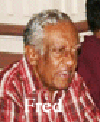 As Wesley has not maintained adequate records-it has no archives containing a meticulous record of the past-the scene has to abruptly shift to 'Hockey in the Fifties' when the writer (an Old Boy) was a member of the Staff of Wesley College in the period 1957-1960 - a period of four very productive years. It was during this period that Wesley hockey was resuscitated.
As Wesley has not maintained adequate records-it has no archives containing a meticulous record of the past-the scene has to abruptly shift to 'Hockey in the Fifties' when the writer (an Old Boy) was a member of the Staff of Wesley College in the period 1957-1960 - a period of four very productive years. It was during this period that Wesley hockey was resuscitated.
The writer was Master-in -Charge of Hockey- cum Coach and was determined to make hockey at Wesley as glorious and exciting a game as cricket. It was observed that Wesley concluded her hockey season with the customary House Matches -the cart before the horse-paradoxically 'talent' being discovered after the College XI had completed its fixtures for the season! The whole process was reversed. The hockey season commenced with the staging of the Inter-House Tournament, outstanding players identified and a pool' created from which more representative and talented Wesley Teams emerged. This was the first step.
The Writer's desire to do more for his old school had however not been quenched. Totally new thinking prevailed; several teams were visualized. And so began Wesley's Under 10 Team; Under 11 Team; Under 12 Team; Under 14 Team; Under 15 Team; Under 16 Team (traditional); an Under 17 Team; a Second XI; and The FIRST ELEVEN. The pressure for positions in the First Eleven had by now intensified and selection became very
competitive-with the standard of hockey at Wesley improving in leaps and bounds.
Wesley's image as a force to be reckoned with in the game began to be recognised, and to use a cliché, "the stage was set" for the great revival-the pushing of Wesley hockey to its utmost capacity-brilliance.
The great challenge that had to be met was to find one hundred hockey sticks for these pools of players of diverse ages. The Old Boys on the staff assisted generously (Derrick Mack, Ivan Ondaatje, Edmund Dissanayake, N.A.B. Fernando and the Writer.) The boys themselves contributed what they could afford. The College provided slicks for the First Eleven Team
Dialogue on time need-the dire need-for more sticks was initiated with the dynamic Subash Chaula (Senior) of Diana's (Diana and Company was a famous Sports Shop in Colombo) who always supported sports-and through his willingness to assist us, we obtained sticks on a deferred payment basis. And so began the great hockey invasion of the citadel of cricket.
The learning of the game was not confined to mere practices at Campbell Park-more or less on rugged terrain! -but at the Ceylonese Ladies' hockey ground at Bullers Road which had a smooth well groomed surface, ideally suited for more artistry in hockey. (The Rupavahini buildimgs now stand on these beautiful grounds.) It was on this ground that Wesley defeated Kingswood (3-0) in 1960 with sonic superb shooting by Glenn Reimers who scored all three goals for us.
There was always the intellectual side to the game. It was hot a case of merely running around with a stick and ball. The players had to be trained or attuned to working out strategy. The game had to be studied hike any other subject at school hut in an exciting manner! Diagrams of the field were drawn on the Blackboard; the position of players explained (each with a distinctive role to play) the need to have a perfect understanding with each other; love and concern for each other-the team had to work together like a harmonious family; out of which would emerge a strongly bonded, well motivated, disciplined team-the best Team-proud to don the Double Blue jersey. A totally new uniform' was designed-navy blue-with WESLEY embroidered in light blue letters spread out on the front of the jersey. Boots had to be of an uniform colour. Each player had to have at least two pairs of Wesley hose. This attention to detail and psychological build up were of great importance.
A booklet on Hockey was produced (cylostyled)
One should not, for instance, attempt a goal from an obtuse angle! A fair amount of elementary geometry was unobtrusively pushed into the learning process. Mind and Body had to be totally integrated: and involved. Eight to ten hours sleep was needed. Playing fix Wesley meant a deep sense of commitment.
There was an air of great excitement amongst the young ones, in particular. They had something of value to Contribute to their very own Wesley. The most important lesson imbibed by these eager beavers was that this was a great TEAM game. Everyone mattered. A goalie could not score a goal-yet he was vital in defense. A forward's task was to maximisc his opportunities in the "D". The hail moved (the opposing side was intelligent too!) and to do so all eleven players were needed-and involved-totally. Physical skills had to be juxtaposed with the intellect. Attack and Defense were both vital to the game. A strategy was always needed.
By now the future (how long is the future?) of Wesley hockey was placed on a firm footing and this was amply demonstrated by our supremacy in the game in the next decade.
The very first, totally committed team to Wesley's new outlook on the game-the 1960 'Team-appears in the photograph facing this article. It is a tribute to these players for a magnificent beginning that propelled Wesley towards becoming a "great hockey school , as well.
Several from the age-tried pools created, excelled in the game-and were invited to the Sri Lanka Trials that are a prelude to the selection of respective Sri Lanka Teams. Some of the names I recall are: Sarath Wickramaratne, Raja Jayasuriya, B. Musafer, H. B. Musafer, S. McLelland, and C. T. Rodrigo. I'm certain I've left out some names as no records have been maintained by Wesley of such achievements-outside the realm of cricket, in particular.
The Wesley Pavilion, or The OWSC Club House will soon have a Panel displaying the names of Wesleyites who have represented their country (In the case of M. Sathasivam two countries-cricket) in all games-a sequel to the Writer having brought this up at an OBU Meeting three years ago. Hopefully, this 125th year commemoration issue will include such information, as well - provided such information reaches the Editorial Panel in time!
The climactic point of all these happenings-what may perhaps be termed a Renaissance or re-birth of hockey at Wesley-was a tour of South India planned jointly with Oliver de Soysa-Master-in-Charge of Hockey at St. Thomas' College, Gurutalawa left our shores on the tour-sans Wesley.
The great spirit of not accepting any set back tamely stood us in good stead. We played a series of matches at home and honed our skills further. 'Wesley hockey' looked good.
The Writer discussed this scenario briefly with Bandula Warnapura (Wesley Cricket Coach and former Sri Lanka Test Cricketer) at the Six-a-Side Cricket finals conducted by the OWSC and concluded recently at Campbell Park, as part of Wesley's 125th Anniversary celebrations, lie would perhaps think of doing likewise for Wesley Cricket!
D.F (Fred) Abeysekera
(Cartman-Oorloff Vintage)
Links to further reading
Editor's Note:
 Why me'? he should have written to the likes of a Trevor Collette, Jackie Carnie, Bashur Musafer or Razeen Sappideen. These are the fellows who wrote prize winning essays and could quite easily provide him with as much copy as he needs. Me! who's only published work to date has been a one paragraph piece on "My dog Trigger" in the College magazine during my primary school days. Surely, he must be joking!! These were my thoughts as I read and re-read Fred Abeyesekera's letter asking me to write something for publication in the Hundred and Twenty-fifth Anniversary Souvenir. That was February 1998. It is now late August 1998. Fred's dear wife Indrani is in Melbourne. No, he wasn't joking. I had better write something "Wesley was a Cricket school", so said Bryan Claessen during a conversation I had with him some years ago at his home in Adelaide.This statement was especially true of the Wesley I started at in 1952. The Claessens, Fuards, Musafer, Samsudeen, Adihetty, Schokman, Gallaher, and Chapman termed the nucleus of a team that must have seemed like 'Bradman's 1948 Invincible", to the other College sides of the time' Rather than go down the well-worn path of reviewing Wesley's cricket performance for the years I was there (1952 - 1961) I have opted to select my own "Dream Team" from those cricketers going around at the time. I have attempted to select a team that is balanced and would be capable of performing under all conditions. As this is my fantasy, I have taken the liberty of nominating the eleven in probable batting order with reserves.
Why me'? he should have written to the likes of a Trevor Collette, Jackie Carnie, Bashur Musafer or Razeen Sappideen. These are the fellows who wrote prize winning essays and could quite easily provide him with as much copy as he needs. Me! who's only published work to date has been a one paragraph piece on "My dog Trigger" in the College magazine during my primary school days. Surely, he must be joking!! These were my thoughts as I read and re-read Fred Abeyesekera's letter asking me to write something for publication in the Hundred and Twenty-fifth Anniversary Souvenir. That was February 1998. It is now late August 1998. Fred's dear wife Indrani is in Melbourne. No, he wasn't joking. I had better write something "Wesley was a Cricket school", so said Bryan Claessen during a conversation I had with him some years ago at his home in Adelaide.This statement was especially true of the Wesley I started at in 1952. The Claessens, Fuards, Musafer, Samsudeen, Adihetty, Schokman, Gallaher, and Chapman termed the nucleus of a team that must have seemed like 'Bradman's 1948 Invincible", to the other College sides of the time' Rather than go down the well-worn path of reviewing Wesley's cricket performance for the years I was there (1952 - 1961) I have opted to select my own "Dream Team" from those cricketers going around at the time. I have attempted to select a team that is balanced and would be capable of performing under all conditions. As this is my fantasy, I have taken the liberty of nominating the eleven in probable batting order with reserves.
1. Radley Claessen - Captain in 1952- A quality all rounder capable of opening both the batting and bowling. Scored a century and had many good bowling performances to his credit.
2. Abu Fuard - Great all rounder. Right hand batsman and a classy off-spinner. Scored a century and took five or more wickets in an innings seven times. Went onto represent Sri Lanka several times and was considered to be one of the finest off-spinners in world cricket.
3. Bryan Claessen - Captain in 1953 and my nomination as Captain of this Team. Arguably the finest all round cricketer produced at Wesley in her 125 years. A stylish right hand hat and crafty leg spin bowler who was selected to represent Ceylon whilst still a schoolboy' Scored four centuries and took five or more wickets in an innings no less than 18 tunes.
4. Lorensz Ebert - Right hand batsman who played only one full season in 1957. He was the mainstay of the batting in that year scoring a century and several half centuries. Was chosen as best schoolboy batsman of the year.
5. Lou Adihetty - Captain in 1955 and 1956. Fine all rounder who batted left hand and bowled right arm at genuine pace. lie was especially lethal on the matting wicket at Campbell Park. Scored four centuries and took over 5 wickets four times. An all round sportsman par excellence who seemed to represent Wesley at everything.
6. Pat Shockman - Right hand batsman who was short in stature hut not on talent. An attacking batsman who played in many an exciting innings, usually when quick runs were required by the team. Represented the CCA in 1954. Reserve wicket keeper in this team.
7. Lalith Wijesinghe - The quiet achiever. Steady left hand batsman and right arm medium pace bowler. Took more than 5 wickets in an innings five limes to 1961. Nearly howled Wesley to a famous victory against St. Thomas' at Mount Lavinia in 1961 when the Thomian last pair held out for over 40 minutes to save the game. Lalith had a match hag of 11 wickets for 73 runs in that game.
8. Herman Claessen - The youngest of the famous Claessen brothers. A left hand slow bowler
had an outstanding season in 1956 when he look more than 5 wickets in an innings on five occasions
9. Sardin "Mus" Musafer - The wicket keeper in this team, Right hand batsman. Aim excellent stumper who needed to keep to a wide variety of bowlers last slow, and in between.
l0. Mohamed "Sam" Samusudeen - Wasn't built like a fast bowler, but as many batsmen of the time will testify to, he was more than little hit quick. A left arm bowler who took over 5 wickets On eight occasion. Gained CCA selection later on and in fact took all ten wickets in an innings against a touring Pakistani Team that contained several lest players.
11. "Lucky" Goonetilleke - Left arm pace bowler. Few bowlers have dominated the College scene to the extent that he did in the years that he played (1958- 1960). He took over five wickets an innings 12 times. He seemed to have a particular liking (or was it a disliking?) for Royal College batsmen. His figures against Royal for each of his years were amazing.
12. Nalendra Abeysuriya - Captain in 1958 and 1959. Right hand batsman and medium paced bowler, -Was an all-round sportsman in the Lou Adihetty mould. Represented Wesley at most sports with distinction.
13. Neil Gallaher - An exciting right hand batsman who wasn't overshadowed by him team mates in the star studded teams of 1952 and 1953.
14. Errol Smith - Dashing left hand batsman. Not too bright though! ran his partner (Darrel Maye) Out leaving himself stranded on 199 not Out against Richmond College in 1961, time highest score made by a Wesleyite up to that time. This team, I am sure would be as good or better than any that could he nominated for any ten year period in Wesley's 125 Year history.
I welcome any comment readers may have about my selections when we next meet. Maybe, over a "Ginger beer' or three at the Sports Club in March 1999'
Just by the way I want to test the theory that Wesley was a "Cricket School'?" Try to recall the name of the Captain of the Cricket Team for each of the years you were at Wesley. Now tiny to recall the names of Captains of the other sporting teams or worse still the name of time Hill Medallist for those years. Point proved I'm sure! So there Fred!!! I have written something. Now can I go back to doing nothing for the next 125 Years. don't you just hate being put under pressure
Editors Note
Links to further reading
SSC the domain of Royal and STC, a myth says P.I Peiris By Richard Dwight
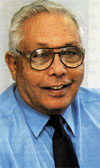 The former all Ceylon cricketer and current vice president of the Sinhalese Sports Club (SSC), P.I. Peiris, quite emphatically declared that it was a misconception, any a myth, to refer to the SSC as the sole domain of those from Royal and S. Thomas'.
The former all Ceylon cricketer and current vice president of the Sinhalese Sports Club (SSC), P.I. Peiris, quite emphatically declared that it was a misconception, any a myth, to refer to the SSC as the sole domain of those from Royal and S. Thomas'.
Peiris a Cambridge blue of S. Thomas' and SSC, having played the game at the highest level, was most deservedly, with much competence proposing the toast to cricket, at the SSC's Centenary banquet at the Hotel Lanka Oberoi. There was in him a sense of urgency to substantiate what he said at the outset - losing no time, he explained that the club had its origin through cosmopolitan thinking, brought about by the members of the combined schools cricket team in 1899. The first secretary of the club was H.J.V. Ekanayake an old Wesleyite, who was responsible for the Wesley College song, whilst the chairman, was yet another Wesleyite in illustrious Sir Don Baron Jayatilleke and the first president was Harry Dias.
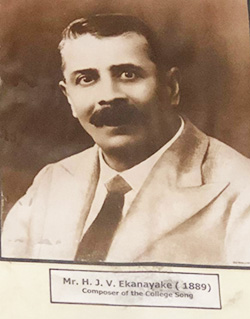 The nucleus of the cricket team in those formative years comprised C.E. Perera, his brother and Ekanayake all from Wesley, M.K. Albert and yet others from way down Moratuwa and Galle, with the Josephians and Peterites chipping in as well. Furthermore the membership was made up of varied communities, and Peiris went on to say that when he captained, his deputy was a muslim, his leading bowler was a Eurasian and the cricket secretary was a Borah.
The nucleus of the cricket team in those formative years comprised C.E. Perera, his brother and Ekanayake all from Wesley, M.K. Albert and yet others from way down Moratuwa and Galle, with the Josephians and Peterites chipping in as well. Furthermore the membership was made up of varied communities, and Peiris went on to say that when he captained, his deputy was a muslim, his leading bowler was a Eurasian and the cricket secretary was a Borah.
The game of cricket at the club was a binding force, which assisted in the promotion of racial harmony, eliminating in the process differences in caste, creed and colour. Viewed in all its entirety, Peiris stressed that it is uncharitable therefore to say, that the SSC is parochial in outlook and, the prerogative of a leading school or two.
Switching on from the serious vein to the lighter, Peiris seeing the police band in the background providing pleasing music earlier, was reminded of a wedding he attended many years ago in Moratuwa, where too a band was playing in the church porch. The band not kept well informed, miscued and as the bridal couple was coming down the aisle played 'Poor Old Joe' he said that this cautions him not to bore the audience, for the band here might step in and play 'Pack up your troubles and go, go, go'.
With a sense of nostalgia he referred to Dr. C.H. Gunesekera, Chippy Gunesekere and F.C. De Saram, who were special to the club and dwelt as well on the greats like D.S. Senanayake, John Kotelawala, J.R. Jayewardene and Dudley Senanayake, who apart from being presidents of the club, went on to lead the nation too. Some of them he expressed with gratitude, influenced and moulded him and felt that the young should learn to respect and be appreciative of the services rendered by their elders in the cause of the club.
 He appealed to the president of the club, to work towards the publishing of a comprehensive history of it. Peiris concluded his historic address thus ``As a club, we have swung far away from cricket, it's time we swing the pendulum back to cricket. Empires rise and empires fall, times change, we must achieve a balance and forge ahead to foster harmony through cricket, the binding force, for otherwise all will be lost. May the next 100 years, be mighty as the previous 100 years.
He appealed to the president of the club, to work towards the publishing of a comprehensive history of it. Peiris concluded his historic address thus ``As a club, we have swung far away from cricket, it's time we swing the pendulum back to cricket. Empires rise and empires fall, times change, we must achieve a balance and forge ahead to foster harmony through cricket, the binding force, for otherwise all will be lost. May the next 100 years, be mighty as the previous 100 years.
Earlier on, the vice president of the SSC and acting chairman of the Centenary banquet committee W.T. Ellawala made the welcome address, whilst the president of the club Daya Perera PC was the other post prandial speaker, who announced that his future plans for the club was the building of a new office complex, new dressing rooms and a new swimming pool.
The chairman of the centenary celebrations committee R.J. de Silva proposing the vote of thanks, outlined in detail the clubs' gratitude to all those associated with its progress. The banquet was interspersed by the lighting of the oil lamp, the observation of two minutes silence for those deceased, and the ceremonial dignified manner in which the birthday cake was brought in to the accompaniment of the music 'Dhannobudunge' by the Police band, and cut by the president. The proceedings were well steered with much finesse by the General Manager/curator of SSC Ranil Abeynaike, who had something relevantly apt to say as he introduced each speaker and what struck us as significant, was when introducing Ian Peiris he said that it was Peiris, who when as ground secretary was largely responsible for the transformation of the ground to the picturesque one it is now and so accepted as an international test venue.
The banquet which was exclusively for members, was preceded by a preliminary time of fellowship over cocktails at the Atrium Lobby, where members drawn from the professions of the medical, legal, business and cricketers past and present, along with the fairer sex lending much colour, indulged in harmless chatter, amidst the clinking of glasses reliving the past, swapping stories and anecdotes to make it a really memorable occasion befitting a centenary of this leading club.
By Sharm de Alwis
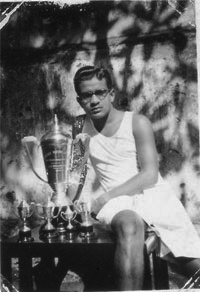 The Trinity-Wesley cricket encounter is the fourth oldest inter-school fixture in this Country, after the Royal-Thomian (1879); Trinity-Royal (1893); Trinity-St. Thomas’ (1898).
The Trinity-Wesley cricket encounter is the fourth oldest inter-school fixture in this Country, after the Royal-Thomian (1879); Trinity-Royal (1893); Trinity-St. Thomas’ (1898).
The first match was played in 1903. Trinity was captained by C. B. Aluvihare, Wesley, by S. P. Foenander. Wesley won in resounding manner which led to the abandoning of the fixture for four years. Revived in 1908, Wesley again won handsomely for the next year’s fixture to be abandoned.
From 1910 this has been a regular fixture except for sporadic breaks in 1917, ’19 and ’43. Although Wesley held the whip hand in the early encounters, Trinty came into the winning streak as early as 1911 under J. Masilamani and held the ascendance except in 1912, 1913, 1935, ’41, ’52, ’54, ’56, ’60, ’62, ’64, ’68 and ’70. Since 1972 the wins and losses have been more or less equally shared and the remarkable feature of this series is that upto 1932 a decision was reached in every encounter.
The stalwarts produced by both Schools is legion and due to constraints of space, mention will only be made of Wesley’s M. K. Albert, the Gunasekeras, the mercurial Satahasivam, arguably the finest batsman produced by our Country, Stanley Jayasekera, Bertram Henderling, Edmund Dissnayake, M. N. Samsudeen, the Claessen brothers, Patrick Schokman who had his beginnings at Trinity, Abu Fuard, Lou Adhihetty, S. Nagendra, Jegganathan, Gunatileke and Wilhelm Van Dort.
 Trinity had H. C. Inman, M. B. Ekanayake, A. W. Dambawinne, C. E. Simithaarachchi, M. P. Kalora, Alfred Aluvihare, the prince of wicket-keepers, A. H. R. Joseph, Percy Maralande and hisson, Nimal, V. C. ‘Pug’ Schokman, Harry Delwitha, H. M. Schakman, Willie Aiyadurai, S. A. Odayar, Philip and brother Eddie Buultjens, C. Dharmalingam of the two hat tricks, Blackham Wijewardena, Rex Breckenridge, O. L. Izzadeen and his two brothers O. L. Z. Abdeen and O. L. M. Lebbe, T. B. Marambe, R. P. de Alwis, Vernon Ratwatte, the classic left-hander, H. EW. ‘Pat’ Solomons, T. B. Werapitiya, Dala Wadsworth, Eustace Rulach, M T. M. Zaruk, Harindra Dunuwille, Himendra Ranaweera, Malsiri Krukulasoorirya, Senanka de Chikera, Jayantissa Ratwatte and in recent years, Dinesh Selvarajah, Ravi Ratnayake, Mevan Balalle, Suren Jayasinghe, Dudeepa Ratwatte, Kumar Sangakkara and Thushara Weerasooriya. Wesley’s strongest team would have been in 1956, coached by Edmund Dissanayake and captained by Lou Adhihetty when they were un-official champions.
Trinity had H. C. Inman, M. B. Ekanayake, A. W. Dambawinne, C. E. Simithaarachchi, M. P. Kalora, Alfred Aluvihare, the prince of wicket-keepers, A. H. R. Joseph, Percy Maralande and hisson, Nimal, V. C. ‘Pug’ Schokman, Harry Delwitha, H. M. Schakman, Willie Aiyadurai, S. A. Odayar, Philip and brother Eddie Buultjens, C. Dharmalingam of the two hat tricks, Blackham Wijewardena, Rex Breckenridge, O. L. Izzadeen and his two brothers O. L. Z. Abdeen and O. L. M. Lebbe, T. B. Marambe, R. P. de Alwis, Vernon Ratwatte, the classic left-hander, H. EW. ‘Pat’ Solomons, T. B. Werapitiya, Dala Wadsworth, Eustace Rulach, M T. M. Zaruk, Harindra Dunuwille, Himendra Ranaweera, Malsiri Krukulasoorirya, Senanka de Chikera, Jayantissa Ratwatte and in recent years, Dinesh Selvarajah, Ravi Ratnayake, Mevan Balalle, Suren Jayasinghe, Dudeepa Ratwatte, Kumar Sangakkara and Thushara Weerasooriya. Wesley’s strongest team would have been in 1956, coached by Edmund Dissanayake and captained by Lou Adhihetty when they were un-official champions.
Trinity held sway a decade earlier, in ’46 with C. N. ‘Pittu’ Schokman captaining a superb blend of artistes of the willow and the red cherry. The others in the team were Asoka Yatawara (V. C.), Asoka Imbuldeniya, S. B. Pilapitiya and Frank Sirimanne of the record first wicket stands, Mervyn Wanduragala, E. D. ‘Blakes’ Senaratne, Jim Bandaranayake, Harvey Jones, Lala Wadsworth and Michael Schokman.
Scorers of centuries for Wesley
1917 R. L. Kannangara - 121 n.o.
1928 H. A. Sahabandu - 102
1932 R. Jeganathan - 163
1938 S. Nagendra - 102
1951 Brian Claessen - 101 n.o.
1956 Lou Adhihetty 104
1973 A. Wickramasinghe 107
1978 R. D. M. Claessen 132 n.o.
1997 D. Jayakody 110
Scorers of centuries for Trinity
1911 S. R. Titus 174
1922 V. C. Schokman 107 n.o.
1923 V. C. Schokman 132
1924 A. B. Madawela 114
1931 P. de Silva 101
1934 Eddie Buultjens 105 n.o.
1942 T. B. Werapitiya 147 n.o
1962 L. Karunatileke 105
1963 L. Karunatileke 101
1965 M. T. M. Zaruk 168
1976 Rohan Perera 114
1988 Mevan Balalle 115
1996 R. de Rafayal 111
Bowling (5 wkts and over) for Wesley
1910 T. Sathasivam 6 for 211912 V. B. Milavitiya 6 for 37
1922 D. Nathanielsz 6 for 39
1942 B. Henderling 6 for 22
1948 N. S. Jayasundera 7 for 48
1952 Brian Claessen 6 for 87
1954 Abu Fuard 6 for 44
1954 M. N. Samsudeen 8 for 23
1955 Abu Fuard 8 for 76
1964 P. Christie 6 for 14
1968 A. Rajaratnam 6 for 19
1968 D. Schokman 6 for 42
1970 A. Wijesinghe 6 for 19
1970 D. Achilles 6 for 34
1990 M. Riyaz 5 for 58
1991 M. Riyaz 5 for 57
1998 R. Senadheera 5 for 55
Bowling (5 wkts and over) for Trinity
1910 H. V. Cooke 6 for 26
1915 H. C. Inman 6 for 75
1915 H. C. Inman 7 for 25
1918 J. H. Bandaranayake 5 for 31
1920 F. A. Van Rooyen 6 for 31
1921 J. Murray 5 for 15
1922 Percy Maralande 7 for 13
1924 R. B. Ettipola 6 for 24
1925 R. B. Ettipola 7 for 28
1926 Fred Murray 7 for 8
1926 Willie Aiyadurai 5 for 8
1927 Willie Aiyadurai 5 for 13
1928 C. Thalgodapitiya 6 for 38
1932 Blackham Wijewardena 6 for 61
1934 Eddie Buultjens 5 for 48
1937 Sammy David (1937) 7 for 13
1939 C. Dharmalingam 5 for 24
1942 Raine Wright 7 for 30
1945 Lala Wadsworth 5 for 47
1947 Mervyn Wanduragala 5 for 66
1949 Lala Wadsworth 5 for 30
1953 Aananda Bandaranayake 6 for 42
1955 Sene Ettipola 5 for 49
1955 Sene Ettipola 5 for 38
1963 S. M. Perera 8 for 55
1964 Harindra Dunuwille 5 for 27
1964 Harindra Dunuwille 5 for 63
1965 A. S. Ratwatte 6 for 15
1966 Glen Van Langenberg 5 for 21
1967 Glen Van Langenberg 5 for 35
1968 Ajith Abeyratne 6 for 64
1994 N. Sureshkumar 5 for 31
1994 J. L. B. Seneviratne 5 for 48
1994 J. L. B. Seneviratne 5 for 39
Fathers and Sons who captained for Wesley
1915 A. M. Fuard
1946
1947 Edmund Dissnayake
1954 Ansar Fuard
1989 Danesh Dissanayke
Fathers and Sons who captained for Trinity
1906 M. B. Ekanayake
1943
1944 T. B. Werapitiya
1920
1921 Percy Maralande
1922
1930 S. A. Odayar
1958
1959 Nimal Maralande
1957 M. Uvais Odayar
Hat- Tricks for Wesley
1910 T. Sathasivam
1910 C. Jayasinghe
1964 Peter Christie
Hat- Tricks for Trinity
Trinity:-
1947 Mervyn Wanduragala
Memories of Cricket in 1962 By Edmund Dissanayake
 Hambantota is in the grip of a severe drought. The State has been quick to rush aid in tangible form and several other organizations have followed suit. Among them is the National Cricket team led by Sanath Jayasuriya.In this article it is proposed to refer to one of the most knowledgeable cricket tacticians produced by Hambantota .... B. J. H. Bahar (Snr.). Hambantota also produced outstanding cricketers who played for Colombo Schools like Zahira, Ananda, Royal and Wesley, to mention a few. The Jayahs, Burahs, Kulatunges, Cassims, Bahars and Dissanayakes were household names in days of yore.B. J. H. Bahar (Snr.) was able to build splendid rapport between coach and team. The factor was one of the most potent reasons which contributed to Wesley’s phenomenal success in cricket in 1961 and 1962. Success did not go to his head as he remained unassuming until the very end. The unprecedented crowd present at his funeral was eloquent testimony to the affection and respect he commanded. At Muslim funerals, it is not the practice for the widow to be present at the cemetery. But Mrs. Bahar, despite the frowning looks of Minister Baduddin Mahmud, paid her respects to him, at the Jawatte Cemetery. She remained with him in death as in life we salute this lady.
Hambantota is in the grip of a severe drought. The State has been quick to rush aid in tangible form and several other organizations have followed suit. Among them is the National Cricket team led by Sanath Jayasuriya.In this article it is proposed to refer to one of the most knowledgeable cricket tacticians produced by Hambantota .... B. J. H. Bahar (Snr.). Hambantota also produced outstanding cricketers who played for Colombo Schools like Zahira, Ananda, Royal and Wesley, to mention a few. The Jayahs, Burahs, Kulatunges, Cassims, Bahars and Dissanayakes were household names in days of yore.B. J. H. Bahar (Snr.) was able to build splendid rapport between coach and team. The factor was one of the most potent reasons which contributed to Wesley’s phenomenal success in cricket in 1961 and 1962. Success did not go to his head as he remained unassuming until the very end. The unprecedented crowd present at his funeral was eloquent testimony to the affection and respect he commanded. At Muslim funerals, it is not the practice for the widow to be present at the cemetery. But Mrs. Bahar, despite the frowning looks of Minister Baduddin Mahmud, paid her respects to him, at the Jawatte Cemetery. She remained with him in death as in life we salute this lady.
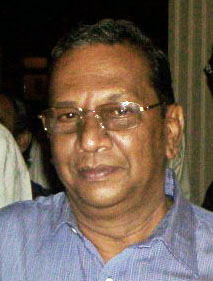
It is proposed to refer to two cricket matches in 1962 in his capacity as Wesley’s cricket coach, where Bahar skills, knowledge, and tactics paid such dividends.
One week prior to the Royal-Wesley cricket match, Royal’s speedster Darrel Lieversz had annihilated St. Peter’s. In that match, Lieversz had captured 6 wickets for 3 runs in 8 overs, 7 of which were maidens, on the first day. Hence, understandably, the Daily News of 23.2.1962 published the following headline in a preview of the Royal-Wesley match "Lieversz vs Wesley at Campbell park" The guttsy Wesleyites were not going to take this ‘slight’ lying down. Their skilful coach Bahar had a already planned the strategy to withstand the Royal fury. In cricket, as in war, attack is the best form of defence. and Wesley was ready to meet the challenge. Royal batting first scored 169 runs with S. S. Kumar scoring 73. Darrel Maye captured 6 for 41.When Wesley had to bat, on Bahar’s advice, two different openers were sent in, to face the fury of Lieversz and R. C. de Silva. The openers were instructed to thrash the bowling from the very first ball, come what may... "come or go Chicago," in the schoolboy language! Milroy Muthuvaloe, walked to the crease, giving the impression that he was the master, and asked for "off-stump guard"! The umpire was confused and asked Milroy whether he really wanted off-stump guard. Perhaps, this itself may have had a psychological effect on Lieversz! The vicious swing of the Lieversz-de Silva combine had to be countered and Wesley’s new found openers did it magnificently.
Wesley scored 170 in the first innings, Muthuvaloe scoring 30 and Kenneth de Silva 44. Incidentally, Kenneth has come back to serve Wesley as the indefatigable Prefect of Games. Royal scored 136 in their second essay, with Vijaya Malalasekera, presently of the Interim Cricket Board, scoring 31. Kenneth with his fast off-breaks captured 3 for 18 and Darrel Maye, with his off-cutters 4 for 44. In Wesley’s second innings, she lost only 5 wickets to clinch the match. Sarath Wickramaratne was unbeaten on 32 with skipper Lalith Wijesinghe on 37. It was really Lalith’s brain-child to bring a Railway carriage for the Old Wesleyites’ Sports Club adjacent to the Wesley-M. H. Mohammed Pavilion."
Poor Lieversz, he bowled 10 overs and conceded 31 runs without success. However, de Silva captured 3 for 50. In this victory for Wesley, coach Bahar’s tactics paid dividends. Another instance of Bahar’s strategy was displayed in the match against Ananda. One week prior to his fixture, Ananda was involved with another school at Campbell Place. Wesley did not have a school fixture that week and Bahar told me that he would walk across to the adjoining park to watch Ananda at play. When he returned, he suggested that we should play C. T. Rodrigo, as a spin bowler. The Ananda fixture was Wesley’s last fixture. C. T. Rodrigo did not find a place in the earlier matches, where Wesley had defeated Royal, Trinity, St. Joseph’s, Richmond and Kingswood. To play C.T. in this last fixture would have been a gamble. But I knew Bahar very well and readily accepted his decision.
The Ananda match was played on the 16th and 17th March ‘62. Ananda scored 116 runs with P. Polonowita, the top scorer with 25. Kenneth de Silva captured 5 for 22. C. T. Rodrigo who had been specially played in this match for his bowling, had not bowled a single ball in the first innings! This was not accidental but by design. Wesley did not want to expose their trump card, until it was necessary. Wesley scored 254 runs, with Darrel Maye 70, Sarath Wimalaratne the Ananda skipper captured 5 for 80. In Ananda’s second innings they were sitting pretty on 79 for 2, when Rodrigo was brought in and Ananda soon slumped to 94 all out with Rodrigo capturing 8 wickets for 9 runs! Wesley won by an innings. Sarath Wickramaratne fielding close-in at gully brought off 9 catches in the match. Bravo! Bahar, Wesley’s coach par excellence.
Indeed if Dave Whatmore is the toast of Sri Lanka, Bahar is the toast of Wesley.
From the Editor Dr Nihal D Amerasekera
B.J.H. Bahar, a member of the Colombo Malay Cricket Club held the position of Secretary Ceylon Cricket Association and Secretary Board of Control for Cricket in Ceylon. B.J.H. Bahar who trained as a coach from the Gower School of Cricket in London, also served in the national selection panel during the period. He was also instrumental in constructing the first ever indoor practice wickets and coaching school in South Asia which was located in Colombo in 1953. The school was opened by Nigel Howard, the captain of the English team on its way to the MCC’s four-Test series in India that year. - Courtesy Sunday Times Sri Lanka
By Edmund Dissanayake
Kenneth M. de Lanerolle, former Principal of Wesley, Kingswood and Carey passed away earlier this year.
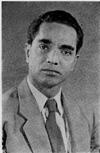 He was actively interested in sports, for he used to say that the disciplines learnt thereby were immeasurable. It was Mr. Lanerolle who introduced basketball to Wesley. He was able to obtain the services of Mr. Kingsbury of the Central YMCA to train our boys. The court was situated on the eastern side of Campbell Park where the practice cricket pitches now stand. Subsequently, the court was established on the north-eastern side of Wesley, thanks to the interest displayed by Mrs. Ranjini Fernando, the present principal’s wife as the Hony. Coach. In fact the interest among the students was such that single-handed she coached several junior teams with success.
He was actively interested in sports, for he used to say that the disciplines learnt thereby were immeasurable. It was Mr. Lanerolle who introduced basketball to Wesley. He was able to obtain the services of Mr. Kingsbury of the Central YMCA to train our boys. The court was situated on the eastern side of Campbell Park where the practice cricket pitches now stand. Subsequently, the court was established on the north-eastern side of Wesley, thanks to the interest displayed by Mrs. Ranjini Fernando, the present principal’s wife as the Hony. Coach. In fact the interest among the students was such that single-handed she coached several junior teams with success.
Mr. Lanerolle’s interest in promoting cricket resulted in the Carey Old Boys presenting an annual trophy for the Wesley-Carey cricket encounter. Even after he lived in retirement in Kandy, he used to talk to the writer as to whether there would be a result, to enable him to be present the trophy when awarded.
In his capacity as principal of all three schools, he knew the strength and weakness of each player, and it was a pleasure to sit beside him watching the game. He was conversant with the ins and outs of the game.
One Sunil J. Peries in an appreciation stated that during the principalship of Mr. Lanerolle, Kingswood was in the forefront of all sports. In both soccer and hockey, Kingswood emerged Kandy District Champions. Further, a Kingswoodian was selected "Schoolboy Cricketer"... Maurice Fernando.
During the regime of Rev. James Cartman, Principal of Wesley, a drama which had a religious tinge was staged. The principal had requested that there was no need to show audience approbation, but as soon as Mr. de Lanerolle had rendered the song "Swing Low" there was deafening applause. He had a wide repertoire of songs.... specially Negro Spirituals. The writer is privileged to possess one of his cassettes containing 22 songs, among which are "I’m Patience", Blue Tail Fly, Ole Man River, Under the Bridges of Paris, Santa Lucia, Drink To Me Only, Deep River, etc.
It was Mr. de Lanerolle’s wish that his body be cremated as early as possible. He had planned his Final Exit ten years earlier, giving detailed instructions to A. F. Raymonds. Even the dress that he was to wear, was ready two years earlier. However, those near and dear to him gave him a right royal funeral. The Wesley College Prefects, together with Shelton Peries leading, walked in front of the hearse, and all the associations connected with the school, the Old Boys of Kingswood, Carey, Wesley, well-wishers, and friends, walked all the way from the Wesley College Great Hall.
The principals of Wesley, Kingswood and Carey, Tissa Jayatilleke, Benson and the writer were the 6 pall-bearers on that solemn occasion.
The writer ends this simple tribute to a great man by referring to what Tissa Jayatilleke, a Kingswoodian had to say of him... "Mr. Lanerolle’s undisputed gifts and skills — a superb speaker, singer, actor, broadcaster, administrator, writer and a fearless critic of anything unworthy or unsavoury, and his quiet sense of humour, made me to respect him. Later, I began to discover the lovely human being in Mr. de Lanerolle. The man who cared for his family, the man who cared for his fellow-beings, the man who cared about issues that touched the lives of those around him, the man who defied powerful men who vainly attempted to compromise on fundamental issues, the man of letters, in a nutshell, I discovered in Mr. Lanerolle, a man of utmost integrity, refinement and character. This is the de Lanerolle, I have grown to love and look up to and draw inspiration from".
The following photo and script were sent to me by a loyal old boy Yohan Raju. Due to the passage of time and disuse he cannot recall the names of some friends in the picture which he apologises unreservedly. If any Wesleyite can help us "to put names to faces" please contact me on this website. The scratches in the picture merely adds to its historical value. I belong to an earlier era but Oh! what nostalgia to see the music class on the left, the Kindergarten on the right and the old "takarang" Tuckshop at the back. (N.D.Amerasekera)
Yohan Raju writes:
Attached is a photo of the
College Athletics team.
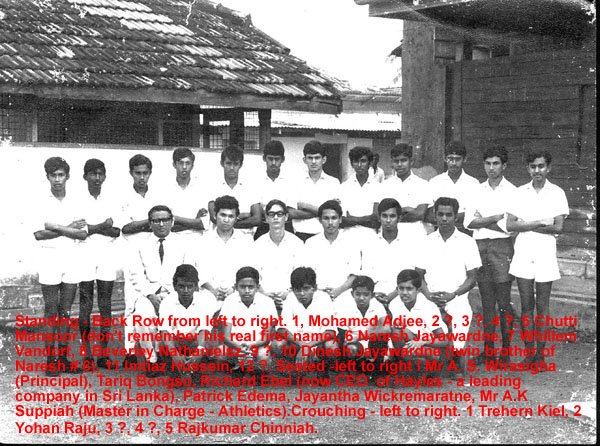
I honestly cannot remember which year this was taken! I suspect that it
was in the late 60's or early 70's - most probably 1968, 1969 or 1970.
I am also sure that I spelt some of the names wrong - I apologise for
that.I will attempt to give you the names of those in the photo that I
remember - but not all.
1, Mohamed Adjee, 2 ?, 3 ?, 4 ?, 5 Chutti Mansoor (don't remember his
real first name), 6 Naresh Jayawardne, 7 Whillem Vandort, 8 Beverley
Nathanielsz, 9 ?, 10 Dinesh Jayawardne (twin brother of Naresh # 6), 11
Imtiaz Hussein, 12 ?.
l Mr A. S. Wirasigha (Principal), Tariq Bongso, Richard Ebel (now CEO
of Hayles - a leading company in Sri Lanka), Patrick Edema, Jayantha
Wickremaratne, Mr A.K Suppiah (Master in Charge - Athletics).
1 Trehern Kiel, 2 Yohan Raju, 3 ?, 4 ?, 5 Rajkumar Chinniah.
If you agree to post this photo on your website, may I please request
you do so with a kind disclaimer and an apology for the lack of detail.
I also hope that people won't be offended if I have mis-spelt some
names. Perhaps you could use the disclaimer to encourage visitors to
your great website to correct it and/or give you the other names that I
have forgotten.
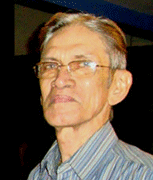 |
 |
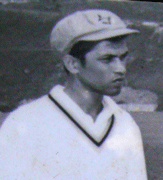 |
Russel has the distinction of having his name etched with greats like Wally Grout of Australia and 17 others at club, Sheffield and County level. He also has the distinction of scoring 24 runs in an over at the B.R.C. six-a-side tournament in 1969 which stood for more than ten years.Five first-class cricket- ers from three genera- tions is an exception, the five are Granville senior Mervyn, Russel, Granville Jnr. and Russel's son Peter, four were first-class wicketkeepers.
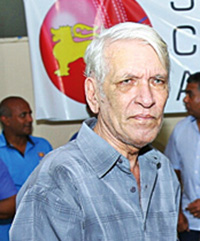 The Hamers are wonderful people to keep company with. Russel gave me a description about his father and two brothers' cricketing careers. His father Granville Snr. opening bowler and a right hand bat, played for the Government Services for many years and in the later stages took to umpiring and cherishes umpiring the match between the West Indies who had players like Conrad Hunte, Seymour Nurse, Garfield Sobers, Rohan Kanhai, and Wesley Hall playing against Ceylon. Mervyn his elder brother was a fine wicketkeeper and a left hand bat played for Wesley College, and three prominent clubs Nomads, Bloomfield and BRC and has a highest score of 232 against Kingswood Kandy which is also the highest between the two schools, he has also represented Maharajah's in Mercantile tournaments and toured with the Maharajah team to India, Malaysia and Singapore. Granville Jnr. his younger brother was also a Wesleyite and played for the senior team for five years. He was a hard-hitting right hand bat and wicketkeeper who also played for Nomads and Colts CC in the Sara Tournaments. At present Granville has his own private junior coaching school at Campbell Park which has about 40 children coming from prominent schools in Colombo. He has produced several top junior level cricketers. His two sons Damian and Trian are up and coming cricketers and ruggerites playing for the Wesley junior teams. They most probably might emulate their grandfather, father and uncles. Russel Hamer the second of three boys also studied at Wesley College from the Lower Kindergarten as it was known those days upto the senior. He represented Wesley at cricket and soccer though he excelled at cricket more than soccer. He captained the senior soccer team and was selected for the national youth pool which included players like Judy Preena, Appiah (both players later played for Ceylon and Sri Lanka) and Yoga Crusz. In cricket Russel started at the lowest rung from Under 14 and 16 and represented the senior team for two years. He played under Everard Schoorman and Donald Thurairatnam and his contemporaries were M. Jebaraja. W. Deutrom, Peter Christie, Omar Jayasekera, M.T. Swangsa and his brother Mervyn. His best innings at school level has been the 117 he scored against Ananda which incidentally was his last match. His first coach was Lionel Jayasuriya at school and later D.H. de Silva and Mike Chanmugam who taught him the finer points of wicketkeeping and batting. He left school in 1965 and whilst playing for the school he played for Bloomfield CC in a Daily News trophy match. In his first outing against Colts CC he had the honour of scoring a century and with that he was promoted to the Sara Trophy team.
The Hamers are wonderful people to keep company with. Russel gave me a description about his father and two brothers' cricketing careers. His father Granville Snr. opening bowler and a right hand bat, played for the Government Services for many years and in the later stages took to umpiring and cherishes umpiring the match between the West Indies who had players like Conrad Hunte, Seymour Nurse, Garfield Sobers, Rohan Kanhai, and Wesley Hall playing against Ceylon. Mervyn his elder brother was a fine wicketkeeper and a left hand bat played for Wesley College, and three prominent clubs Nomads, Bloomfield and BRC and has a highest score of 232 against Kingswood Kandy which is also the highest between the two schools, he has also represented Maharajah's in Mercantile tournaments and toured with the Maharajah team to India, Malaysia and Singapore. Granville Jnr. his younger brother was also a Wesleyite and played for the senior team for five years. He was a hard-hitting right hand bat and wicketkeeper who also played for Nomads and Colts CC in the Sara Tournaments. At present Granville has his own private junior coaching school at Campbell Park which has about 40 children coming from prominent schools in Colombo. He has produced several top junior level cricketers. His two sons Damian and Trian are up and coming cricketers and ruggerites playing for the Wesley junior teams. They most probably might emulate their grandfather, father and uncles. Russel Hamer the second of three boys also studied at Wesley College from the Lower Kindergarten as it was known those days upto the senior. He represented Wesley at cricket and soccer though he excelled at cricket more than soccer. He captained the senior soccer team and was selected for the national youth pool which included players like Judy Preena, Appiah (both players later played for Ceylon and Sri Lanka) and Yoga Crusz. In cricket Russel started at the lowest rung from Under 14 and 16 and represented the senior team for two years. He played under Everard Schoorman and Donald Thurairatnam and his contemporaries were M. Jebaraja. W. Deutrom, Peter Christie, Omar Jayasekera, M.T. Swangsa and his brother Mervyn. His best innings at school level has been the 117 he scored against Ananda which incidentally was his last match. His first coach was Lionel Jayasuriya at school and later D.H. de Silva and Mike Chanmugam who taught him the finer points of wicketkeeping and batting. He left school in 1965 and whilst playing for the school he played for Bloomfield CC in a Daily News trophy match. In his first outing against Colts CC he had the honour of scoring a century and with that he was promoted to the Sara Trophy team.
In 1964 and, '65 he represented the Combined Schools under Sunil Fernando (St. Benedict's) and Sarath Seneviratne S. Thomas' Mt. Lavinia, his contemporaries in those teams were A.G. Perera (with whom he later had a double century partnership playing for Bloomfield), B. Ried, S. Rajaratnam, Travis Fernando, David Heyn, H. Dunuwille and Anura Tennekoon to name a few. After leaving school he was under the wings of Mr. R. Rajamahendran the proprietor of Rajendrams Ltd and Maharajah's Organisation who was responsible in promoting cricketers at that time. Russel says "I am eternally in debt to Mr. Artie Samarasekera an ardent supporter of Bloomfield and also Mr. R. Rajamahendran who was like a god to me."
Russel captained the Maharajah's in 1970/71 has toured with the Maharajah's team to India, Malaysia, and Singapore. In Malaysia, Russel scored 100 runs from a total of 195 for 2 wkts.Russel was going great guns in the club circuit too and his best innings has been his 174 he scored against B.R.C. with A.G.. Perera 104 not out. These two put on a blistering partnership of 297 runs for the second wicket with all these performances and captaining the Bloomfield team, he could not find a place in the National side. "But all this changed when I left or may I say was forced to leave Bloomfield, where I played for eight years. I joined B.R.C. in 1971 and in the very first season I played for B.R.C., I was selected to play for the Ceylon team against the Pakistanis which did not materialise due to the war between India and Pakistan but in 1972 the Pakistanis came and it was captained by Intikab Alam which had players of the calibre of Zaheer Abbas, (who has the distinction of scoring two centuries in a match eight times which is a world record), Mustaq and Sadiq Mohamed, Wasim Bari, Majid Khan and Safraz Nawaz to name a few." Ceylon was captained by Michael Tissera and had Anura Tennakoon, Daya Sahabandu, T.B. Kehelgamuwa and Duleep Mendis. It was Russel's and Duleep's first international match. In 1973 the M.C.C. team captained by R. Lewis toured Sri Lanka comprising players like Alan Knott, Mike Denness, Keith Fletcher, Derek Underwood, and D. Amiss. Sri Lanka was captained by Mike Tissera and had Bandula Warnapura, Duleep Mendis, Anura Tennakoon, D.S. de Silva, Neil Chanmugam and H.S.M. Peiris. After that Russel was in the back seat for some time. Russel has also represented Ceylon at the Gopalan Trophy series on numerous occasions. His contemporaries at different times have been Anura Tennakoon, David Heyn, Sunil Wettimuny, Daya Sahabandu, Lasantha Rodrigo, J. Robertson, Lalith Kaluperuma and T.B. Kehelgamuwa. In one series he scored 52 runs. In 1975 whilst representing Mercantile Cricket Association in a match against Government Services for the Robert Sennayake trophy, he scored 132 and sqeezed back into the National side to tour India for three unofficial Test matches. The Indian team was captained by the batting maestro Sunil Gavaskar and had players like Dilip Vengaskar, Gundappa Vishwanath, Seyed Kirmani, Mohinder Amaranath, Madan Lal, Anshuman Gaekwad. Sri Lanka was captained by Anura Tennakoon and other prominent members were Sunil Wettimuny. D.S. de Silva, Ajith Silva, David Heyn, Daya Sahabandu and the late Anura Ranasinghe.
Though the tour was successful for Russel, he had to undergo unwarranted problems and was on the verge or returning back home at his own expense details of which he did not want to expose. Russel has the distinction of claiming seven victims behind the stumps on two occasions. The first was in 1978 when he was playing for his new club the S.S.C. against Moratuwa C.C. For his brilliant performance Russel was asked to lead the team to the pavilion. The second occasion was in 1980 against the Saracens. Thus Russel has the distinction of having his name etched with greats like Wally Grout of Australia and 17 others at club, Sheffield and County level. He also has the distinction of scoring 24 runs in an over at the B.R.C. six-a-side tournament in 1969 which stood for more than ten years. The last international match that Russel played was in the year 1977 which was against an England team captained by Tony Greig which had players such as of Mike Brearley, Bob Woolmer, Bob Willis, Derek Underwood, Derek Randal, Alan Knott, and Dennis Amiss. Sri Lanka was captained by Anura Tennakoon with Roy Dias, Bandula Warnapura, Tony Opatha, Duleep Mendis. D.S. de Silva and Jayantha Seneviratna being some members of the team. In fact Russel had retired through disgust but he had been called back on the intervention of the then Sports Minister but the shabby treatment did not stop with the result. Russel had to go to courts against some officials for injustice. S.S.C. was Russel's last club that he played whether it was Sara or Daily News trophy. He was a member from 1978 to 1995 during which period all cricketers at Maharajah's lost their jobs due to the '83 violence. He worked there for 18 years and at S.S.C whilst playing, his good friend Ranjith Doranagama, an old Trinitian had suggested of putting up a school for cricket. Russel had then decided to impart his knowledge and train young cricketers. It was the first local coaching school at the S.S.C.
After Ranjith left for a planting job to the outstation Russel was discontinued from coaching but is grateful to Ranil Abeynaike who understood his position and was kind enough to offer him two coaching days for a week and to act as an assistant curator at S.S.C. When Ranil left for Australia later Russel was appointed the curator at S.S.C. and that changed his life completely to another side of cricket, by which he is benefiting now. He also coached his alma mater during the period of Principals Mr. A.S. Wirasinghe and Mr. Lou Adihetty free-of-charge and before his side of the story ends Russel reminds that he has played for seven clubs in the 'A' division namely Bloomfield C.C., B.R.C., Nomads, Liberty C.C., Saracens, Moratuwa C.C. and S.S.C. which maybe a record. In 1995 Russel was appointed as the senior cricket coach of the Kettarama school of cricket by the Minister of Sports and he is ever grateful to Commander H.U. Silva Director Sugathadasa Stadium and Kettarama Stadium and Mr. Sooriyaarachchi and lately Miss. Rohini Fernando secretary of the Sri Lanka Women's Cricket Association approved by the Sports Ministry had requested Russel to coach the Sri Lanka Women Cricketers which he has accepted and he conducts at the Kettarama Stadium. Last of the five Hamers is Peter, Russel's son a left- handed bat and fine wicket- keeper like the father. Peter is at present playing in Australia. Russel speaking on behalf of his son said Peter had his education at St. Joseph's, Darely Road and started playing cricket from the age of seven. He got his first hundred against Zahira Maradana in a Under-13 match and from there he went from strength to strength. Peter was baptised into the senior team when he was 13 years from there onwards he was a regular member of the senior team for five years. He captained the senior team in the year 1994 and in between those years he turned up to be a fine batsman.
In 1993 at the Observer 'Bata' schools award he was given a special merit award for his 280 runs he scored against Wesley College (missing Jack Anderson's record by 12 runs) he also scored 1136 runs and had 48 dismissals that season. Peter was a member of the Sri Lanka Under-20 team that toured Malaysia and Singapore and also toured India with the Sri Lanka schools team, he captained the Colombo District Cricket Association team. After leaving school Peter represented the Old Antonians Wattala in the Under-23 tournament and scored two double centuries, later playing for S.S.C. in the Daily News trophy he opened batting with his father Russel a unique and rare feat that anyone can achieve.
Four runs to win in 2 balls and Rodney Perera swipes Perumal bouncer over keeper’s head
 In 1962 Wesley was coached by B. J. H. Bahar (Snr). Lalith Wijesinghe was captain with Kenneth de Silva as deputy and the Wesleyites will remember the year for the wonderful cricket produced by their team, which resulted in victories over Trinity, Kingswood, Royal, Ananda, Richmond and St. Joseph’s.The match against St. Joseph’s was of special significance as both teams were equally balanced and a large crowd at Darley Road and also the Maradana people had taken "bets" on the game. Wesley declared at 240 for 9 with Mervyn Hamer making 50 and Sarath Wickramaratne 66. St. Joseph’s replied with 124 with off spinner Kenneth de Silva taking 6 for 41. Following on, the Joes were dismissed for 156 with Kenneth de Silva capturing 5 for 36. It was in the Josephians second innings, that the 9th wicket was worth 50 runs, after a fresh lease of life was given to the batsman, when the Wesley keeper and another fielder appealed to the wrong umpire for "hit wicket".Law 47 clearly states that the jurisdiction for "hit wicket" lay with the leg umpire... and so the batsman continued with his innings, regardless. Wesley were left with only 30 minutes to score 41 runs for victory and then there were no mandatory overs. Five Wesley wickets had fallen, and with the crowd on its toes paceman Brian Perumal sent down the last over, from the swimming pool end. Four balls had been delivered, and Wesley had to score 4 runs for victory in the last two balls. The entire field paraded the boundary line. While one fielder was even placed behind the wicket-keeper.In schoolboy language "a long bye". Run getting was almost impossible... but not for Rodney Perera. Perumal’s 5th delivery was a bouncer and Rodney swiped at it in the way one would hit a rubber ball, (popularly referred to as "uda bat"?, and the ball sailed over the wicket keeper, and also the long bye and rolled over the boundary near the pavilion.
In 1962 Wesley was coached by B. J. H. Bahar (Snr). Lalith Wijesinghe was captain with Kenneth de Silva as deputy and the Wesleyites will remember the year for the wonderful cricket produced by their team, which resulted in victories over Trinity, Kingswood, Royal, Ananda, Richmond and St. Joseph’s.The match against St. Joseph’s was of special significance as both teams were equally balanced and a large crowd at Darley Road and also the Maradana people had taken "bets" on the game. Wesley declared at 240 for 9 with Mervyn Hamer making 50 and Sarath Wickramaratne 66. St. Joseph’s replied with 124 with off spinner Kenneth de Silva taking 6 for 41. Following on, the Joes were dismissed for 156 with Kenneth de Silva capturing 5 for 36. It was in the Josephians second innings, that the 9th wicket was worth 50 runs, after a fresh lease of life was given to the batsman, when the Wesley keeper and another fielder appealed to the wrong umpire for "hit wicket".Law 47 clearly states that the jurisdiction for "hit wicket" lay with the leg umpire... and so the batsman continued with his innings, regardless. Wesley were left with only 30 minutes to score 41 runs for victory and then there were no mandatory overs. Five Wesley wickets had fallen, and with the crowd on its toes paceman Brian Perumal sent down the last over, from the swimming pool end. Four balls had been delivered, and Wesley had to score 4 runs for victory in the last two balls. The entire field paraded the boundary line. While one fielder was even placed behind the wicket-keeper.In schoolboy language "a long bye". Run getting was almost impossible... but not for Rodney Perera. Perumal’s 5th delivery was a bouncer and Rodney swiped at it in the way one would hit a rubber ball, (popularly referred to as "uda bat"?, and the ball sailed over the wicket keeper, and also the long bye and rolled over the boundary near the pavilion.
Rodney then raced to the pavilion, followed by an angry crowd (not schoolboys) who probably had lost their bets. Rodney was "hidden" in the pavilion while Kenneth de Silva jumped for joy and injured his head!But the writer’s problem then was to smuggle out Rodney with an angry crowd waiting at the northern entrance, near the pavilion.There were three cars lined up facing the northern gate opposite the pavilion, the third of which was driven by Danister de Silva, who was given instructions by the writer to reverse his vehicle as soon as the first two cars had gone forward to reverse, past the main building, past the swimming pool and through the southern gate, into freedom. This car carried Rodney, in dark clothing and dark glasses, Danister’s children and the writer. In the words of Sherlock Holmes this was an exercise "Elementary, Watson!"Rodney (now no more) was a very popular figure. He scored 101 not out in 43 minutes against Richmond. The other centuries scored in 1962 were by Kenneth de Silva 100 against Richmond and 127 by Lalith Wijesinghe against Kingswood.The Wesley cricketers will remember the wonderful sea bath at Uswetakeiyawa, in celebration of their victories, when Rodney mischievously pushed into the inviting waters, the cheering squad of Arlene, Audrey, Malkanthi and Wickramaratnes. (Did they learn from Percy) and their first lessons on swimming by using a tyre. The fabulous lunch at Danisters, and the sumptuous dinner at Bahars, where the Principal Shelton Wirasinghe and his wife Manel were present. Probably, they would have tasted for the first time the exotic food prepared in the inimitable Hambantota style!
By Edmund Dissanayake
 It is rare that an individual excels both in sports and studies. But Mahendra Dissanayake is one of them. It will be recalled that Mahendra skippered the 1983 Under 17 cricket team at Wesley and won all six matches and thereby emerged All-Island Cricket Champions. He later captained the first XI in 1984 and his impressive bowling performance of 8 for 54 against St. Peter’s in 1985 is still to be bettered. In the same year, Mahendra also took 7 for 34 and 7 for 30 against then formidable Nalanda team. Even Roshan Mahanama and Asanka Gurusinghe could not counter the deadly in-swing of Mahendra.Mahendra however continued his good work in Melborne, Australia while playing for his club Benteligh. A few of his bowling performances were: 4 for 28 vs Springvale Sc, 5 for 25 vs Oakleigh Sc, 5 for 17 vs Parkdale Sc, 6 for 32 vs Brunswick Sc, 5 for 40 vs Sunshine Sc, 4 for 48 vs Preston Sc, 6 for 43 and 4 for 21 vs Kew Sc.
It is rare that an individual excels both in sports and studies. But Mahendra Dissanayake is one of them. It will be recalled that Mahendra skippered the 1983 Under 17 cricket team at Wesley and won all six matches and thereby emerged All-Island Cricket Champions. He later captained the first XI in 1984 and his impressive bowling performance of 8 for 54 against St. Peter’s in 1985 is still to be bettered. In the same year, Mahendra also took 7 for 34 and 7 for 30 against then formidable Nalanda team. Even Roshan Mahanama and Asanka Gurusinghe could not counter the deadly in-swing of Mahendra.Mahendra however continued his good work in Melborne, Australia while playing for his club Benteligh. A few of his bowling performances were: 4 for 28 vs Springvale Sc, 5 for 25 vs Oakleigh Sc, 5 for 17 vs Parkdale Sc, 6 for 32 vs Brunswick Sc, 5 for 40 vs Sunshine Sc, 4 for 48 vs Preston Sc, 6 for 43 and 4 for 21 vs Kew Sc.
He was one of the popular and highly respected head prefects produced by Wesley College Colombo. He continued his studies in Australia. And was admitted to the Degree of Bachelor of Engineering in 1995. In addition, he is a Computer Systems Engineer. He also secured his MSc. in Information Technology.
His father Graham was Sri Lanka’s Food Commissioner and earlier excelled in hockey and athletics.
Sportsmanship is a trait that has slipped away from the grasp of sportsmen today.
This prime quality which governs the conduct of the ones dabbling in sports is rare in deed. A sporting gesture worth mentioning was witnessed at Wesley College when the authorities had to decide on the captain for the current season. This heart warming incident took place late last year when Sajith Kolombage, who was considered for the captaincy with another senior of equal seniority, made a request to the authorities that his colleague should lead the side as he thought that he would make a better captain. This inspiring act on Kolombage’s part saw Favreez Maharoof being appointed as captain of the First Eleven team.
But Maharoof’s credentials have in no way been in question as he happens to be one of the most gifted batsman among schools. He being selected to represent the country at the ongoing Under 19 World Cup, in New Zealand, underscores the fact that he holds the character to live up to big occasions. The spirit of the present day cricketers brings memories of how the school toiled hard at the begging to servive in the sport sans a ground of it’s own.
The school founded in 1874 by Reverend Daniel Henry Perera, is said to have used the Racquet Courts for sports activities, a large extent where the Chalmers Grannary is located in Pettah. In 1887 the school obtained permission to use the Price Park in Pettah for sports.The school even acquired a five and half acre property which was subsequently used to put up the buildings of the school. Wesley used Campbell Park for sports activities there after. The school today boasts of a sports club,named Old Wesleyites Sports Club, and also enjoy facilities which were not available to the earlier generations who were at Wesley many years ago. Wesley also holds pride of being part of the second oldest cricket match among schools which happens to be their annual fixture against Royal. The two schools battle for the late Frank Gunasekara Trophy.
Wesley also plays traditional fixtures against Trinity and S.Thomas’ which happen to be two leading cricket playing schools in the nation. The team this year began on a sound note when they recorded first innings points over Maristella Negombo. However the school suffered a crushing blow in the hands of the Peterites who beat them by innings. The lads from from Campbell Park however didn’t lose heart and came back fighting to earn a first innings win over Thurstan at which fixture their skipper Maharoof dazzled with the ball to take five wickets. The team’s match against Trinity proved the sparks in the matches among the schools last week when they took up the challenge of chasing 153 to win off 13 overs. The Wesleyites however could mange to get only 104 losing four wickets in the process.
The school’s batting this year will revolve around acting skipper Kolombage, Pramodh Makalande, Nuwan Samith Fernando, Anderio Toussaint, Isuru Fernando and Thushara Waduge who have all showed form with the bat. Pace bowler Eric Joseph will be Wesley’s main strike bowler this year having given a torrid time to the school’s opponents in all outings. The others who could add spice to the Wesley bowling is Kushan Senewiratne and Thushara Waduge. The school is coached this year by Neil Rajapakse who at one time coached St.Sebastians College Moratuwa. The Wesleyites under his guidance have catapulted up the points table to 16 th place from a miserable 23rd slot they occupied. The school has already played Maris Stella, Thurstan, Sri Jayawardanapura, St.Anthony’s, St.Peter’s, St.Benedict’s and Trinity.
The Wesley College cricket pool-Favreez Maharoof, Sajith Kolombage, Anderio Tossaint, Nuwan Samith, Isuru Fernando, Pramodh Makalande, Thushara Waduge, Kamantha Kodikara, Eric Joseph, Kushan Senewiratne, Afzal Sabar, Charitha Karunaratne, Aruna Kumara, Arnold Vandersay, Surein Sundaralingam, Anoj Katipearachchi, Pradeep Perera, Umayanga Fernando, Shiraj Nadaraja.
From the Ceylon Observer 5th July 1937
Kindly sent to me by Mr. Victor Melder of Australia
One of the best known all round Ceylon sportsman E J Melder passed away yesterday and the funeral took place this morning at Kanatte. Jubilee Melder who was born in 1887, the Jubilee year of Queen Victoria was just 50 years of age and till recently used to play cricket with success. Educated at Wesley College he made his name first of all as a left arm bowler. Playing against Royal College in 1904 he captured 6 wickets for 6 runs. At college he never gave me the impression of developing into the great left hand batsman he afterwards became. Just when his bowling promised to make him a really great player he put his left arm out and ever since then was only a change bowler. As a batsman he became one of the soundest and most consistent scorers of Ceylon.
In 1912 I saw him score a century 110 not out for Colts against DACC at Radella. I well remember that feat as he used a prize bat which had been given to me as a souvenir by the famous Australian batsman Warren Bardsley. Melder first came into prominence as a batsman for the Bloomfielders and then for the Colts. In 1910 he headed the BC and AC averages with 72.5. In 1911 he scored 168 for Harrisons V Aitken Spence in the Mercantile Competition.
In 1912 he created a Ceylon record by aggregating 1548 runs in all matches and beating VFS Crawfords record of 1460 compiled in 1911.
In 1913 he headed the BC and AC averages with 62.00.
Melder played test cricket with success for the Ceylonese Vs Europeans. In 1913 he scored 44 and in 1920 he hit up 55 out of a total of 287. He visited Bombay with the powerful Ceylonese XI led by D.L.De Saram and managed by the late John Rockwood. He was 3rd in the batting in that tour. Scoring 136 runs and averaging 27.2. His highest score was 52 against the Bombay Gymkhana. Of his contemporaries in that team DL De Saram, C Horan, ER De Saram, A Aluvihara, Dr.John Rockwood, and Frank Gunawardene pre deceased him. Those still alive are V De Kretser, A.C Amath, MK Albert, Albert de Alwis, Ja and C De Silva, P and S Saravanamuttu, and S.W loos.
In 1927 he played for Nugegoda sports club and scored 163 against Kelani Valley.
Not Only did he excel in cricket but also as a soccer player and an all round athlete. He was a splendid athlete who did the 100 yards in 10.45 seconds and cleared 5ft 3in in the high jump and did well in Pole Vaulting. He was an excellent soccer forward and played often for the YMCA and the CHUMS and his firm Harrison and Crossfield.
He was a self made man and retired form Mesrs Harrison and Crossfield to run his own business in Nugegoda where he owned much property and was held in high respect.
S.P. Foenander captains Wesley College team in a match against Mr. Dissanayake's team at Price Park. In the team are J.E. Amarasekera, A . Barbet, A.P. Joachim, H.W. Dissanayake, A. W. Nathanielsz, E. A. Bechs, J. H. Perera, A. R. Wijekoon, S. P. Wijetunga and L. Barbett.
From the Ceylon Observer 28th Feb 1999
Almost a quarter of AirLanka's airbus that took off from London's Heathrow airport last Thursday was filled with staunch and loyal old boys of Wesley College, Colombo on their way to their alma mater's 125th anniversary. Lord Reggie's old and dear friend Ben Fernando who is the present head of Wesley and once upon a time, a very, very popular figure in London's Sri Lankan scene and president of the oldest Sri Lankan organisation here on many occasions. 'The Association of Sri Lankans in the UK', will be truly proud of these lads who left no stone unturned to make this trip, be there on time and play their part well.
Speaking to Lord Reggie on the eve of their departure Lord Reggie's close pal, a former Wesley skipper Ananda Thevethasan said the lads were pleased that the OBU's patron - a former principal - Rev. D. Izzett was travelling with them and will be there to share those moments of glory and happiness when Old Wesleyites in Sri Lanka and from Australia will "be with us as one family". Thevathasan also expressed his absolute joy about the participation of that famous and mighty Old Wesleyite and Cambridge Double Blue (Cricket and Hockey) Lou Adihetty. He said; "He was our coach and every move of his on the field was classic. It will be wonderful to see him at the crease again. That alone is worth the trip." R. Perera will captain the UK team against SSC and Tamil Union on the 3 March and 8 March 1999 respectively at this cricket tournament which has been organised by former Sri Lanka opening bowler L.R. Goonetillake (President, OWSC).
An interesting duel should be the game between the past Wesley skippers made up of Lou Adihetty, Milroy Mutuvaloe, Everad Schoorman, Ananda Thevethasan, Navin de Silva, Delmer Achilees and Ameresh Rajaratnam and others against he present college eleven led by Dharsika Jayakody. Lord Reggie also wishes to warn the rest of the Wesley teams that the team from UK put on a magnificent show at the Festival of Cricket here in 1997 to get the better of all the leading Sri Lanka schools which gave them that much coveted Sri Lanka OBAs trophy and be it bowling a 'googly' or a 'chinaman' or for that matter batting on a difficult pitch these lads are sure to put on a splendid performance and give the rest a jolly hard time. Queen says 'OK' to drugging of her carriage horses Buckingham Palace recently admitted that royal horses are on occasions drugged before ceremonial events. According to a palace spokesman the sedatives are given purely to calm the younger horses for important events such as the State Opening of Parliament and the annual Royal Ascot race meeting. The spokesman said the drug acepromazine which is given in doses of around 25mg has a numbing effect and stops the horses from getting excited when passing noisy or cheering crowds.
These doses Lord Reggie understands are given as a liquid through a syringe into their mounts or as ground-up tablets together with their food thus making the animal tame and peaceful for some time. 'Late sitting' - a rare picture of Tony Blair.One of London's newspapers Lord Reggie loves to read, the 'Evening Standard" recently held a photography competition that attracted over 50,000 entries taken by people from many walks of life depicting everyday scenes of England from many angles of life. Those pictures taken by both amateur and professional photographers portrayed sad, happy and stunning moments but the one Lord Reggie really enjoyed was that of the British Prime Minister Tony Blair seated on the carpeted floor of the parliament titles. 'Late sitting: an intimate shot of Tony Blair by Mike Maloney.' As our picture shows the melancholy faced Tony Blair is seen reflecting over a letter he probably just finished reading but in which oak panelled room in the Parliament building will be even difficult for the longest serving member to guess.
Wesley beat Trinity at Rugby 2002 (Sent to me by Yohan Raju)

Rugby shock as Wesley rattle Trinity 21-0 The Colombo school records first ever win over the Kandy side By M.Shamil Amit Police in full cry as they tackle an Army player at Galle Face. Pic. by Ishara S. Kodikara
Wesley led by that burly No. 8 and Sri Lanka youth player Lahiru Boteju created history when they outclassed the Trinity Lions for the first time ever in the history of rugby encounters between the two schools which has been played for over a half century. They completely rattled the Trinitians when they scored a convincing 21 points (three goals) to nil victory in the inter-school rugby match at Longdon Place. Having led 14-0 at half time. It was rugby of a high order with the Wesleyites treating the massive crowd that thronged to witness the game with some superlative rugby. They got into business in the first five minutes of play in the first half when winger Nawshik Fareez ran over for a try from a move initiated by second row Chatura Weligamage. Full back Zakir Badurdeen put the finishing touches to give Wesley an early 7-0 lead. The Wesleyites were far more superior in all departments winning the line outs and their working down the line had the Trinitians in a spot of bother. Centre Ziyard Thahir and Steve Perera another Sri Lankan youth player had their opponents guessing with their robust play and kicks to touch. In the dying stages of the first half Ziyard Thahir increased the lead with a superb try scored from a five yard scrum which was again converted by Zakir Badurdeen to make it 14-0. Resuming in the second half the Trinitians penetrated their opponents' territory but only to be denied scoring by the solid defence of the Wesleyites. The Trinitians missed two opportunities of reducing the lead when second row D.A.de Silva fluffed two penalties which was of kicking distance. In the 23rd minute Wesley was offered a 40 metre penalty and Zakir's kick went astray. With no quarters asked or given the game was being played at a terrific pace with referee Orville Fernando doing a tireless job with the whistle. Wesley succeeded in increasing their lead when in the 25 metre line of their opponents' skipper Lahiru Boteju intercepting a pass gave it over to second row Tyronne Harrison who barged through many defenders to score under the post. Zakir made no mistake with his kick this time to give Wesley a healthy 21-0 lead. The Lions were dejected and gave up hopes of giving a fight back ultimately being tamed down.
From the Observer
Shock.....Wesley create history with sensational 21-nil win over Trinity by Ranjan Anandappa
Spearheaded by a spectacular forwards display, Wesley created history recording a sensational 21 points (Three goals) to nil win over Trinity for the first time in their rugby history in an inter-school encounter played at Longden Place yesterday. The Kandy schools opening game for the season played in Colombo yesterday ended in disaster as the Wesleyites completely rattled the Trinitians with their robust style of play. The Wesleyites should owe their success to their diligent set of forwards led by their skipper and number eight Lahiru Boteju and excellent support coming from the rest Chitrajith Weligamage, Shariffudeen, Steve Perera and Nalawangsa dominating the proceedings. Overall it was a superb team effort which gave the Wesleyites to savour the historic moment. Wesley opened scoring in the 5th minute when winger N. Fareez touched down and Zakir Badurdeen gave them the extra points and mid way in the first half, centre Z. Thahir scored off an infringement under the post and Badurdeen made no mistake with the kick. Wesley led 14-0 at the breather. The Wesleyites played exceptionally well in attack and defence to put the breaks on any Trinity moves. The Trinitians won most of the line-outs with second rower D. A. de Silva beating counterparts but lack of cohesive play prevented Trinity making much headway. The Kandy school missed a couple of scoring opportunities through penalties when hooker P. Wasalathanthri lacked the direction while kicking. Orville Fernando refereed. Wesley also won the under 17 game 5-0.
From Bachchi Oumar
I am just thrilled to hear about the good news about the rugby team. What about doing something for the team? Perhaps a new set of jersies and/or a formal dinner for the team and coaching staff at the pavilion, in appreciation for this great victory. Can you organize a hat collection? You can count me in for $50. Please let me know where I should send the cash etc. In all the years I represented Wesley at rugby, I never experienced defeating Trinity College. We came close in 1978 under the captaincy of Rashmore Ferdinands; we lost 4-Nil at Longden Place. This was the highlight of my rugby career at Wesley, although we lost the game. In the same year we drew with Issipathana (another goliath) in 1978. I am sure all former Wesley Ruggerites would attest to the gravity of this victory; I sure do. Let’s appreciate the current team’s feat and share in the glory of this moment and do something for the Team. Later……. Bachchi Oumar
From Patrick Gnanamuttu
Hi Batchi, If you had played the way I told you to, we could have beaten Trinity a long time ago… Anyway too late for regrets !! Why don’t we all go down to SL and personally congratulate the boys on this Historic win… Cheers mates Patrick
PS - Count me in for any contributions
Links to further reading
From The Island - 30 April 2002 by Ravi Nagahawatte
Wesley juniors underscored the fact that their future in rugby will be rosy when they ran out winners in the Western Province Inter-school Under 15 12-a-side rugby tournament by beating Royal College Colombo in the final at Bullers Road yesterday. The Wesleyites had the edge when ever their line swung into motion and held their opponents in suspense before pulling off a 5-0 win. The team however were kept in check by some resolute tackling by the Royalists who didn't enjoy much possession. The Wesleyites shot into the lead on the stroke of half time when winger Niranjan Wickremasinghe exposed a gaping hole in the Royal defence when the three quarter line was in full swing. The conversion however went astray. Royal played better after 'lemons' but failed to put the finish to some promising moves which forced the Wesleyites to back peddle at times. The losers showed their strength with their bigger made forwards. But the Wesleyites played better and held on till the final whistle to record a memorable victory. Nalanda annexed the Plate Trophy beating St.Joseph's 8-0 in the final while Royal Panadura won the Bowl Trophy beating Zahira College in the final. Former Thomian, Havelocks and Sri Lanka second row forward Chaminda 'Diga' Rupasinghe was the chief guest at the final.
The "Island" of 16th, March 1985, "Nalanda shot out for 84" reported as follows:
"The match began at 12.45 due to overnight rain and the Nalandians who took first lease of the wicket could not cope with bowling of paceman Mahendra Dissanayake and were skittled out for 84". "The only Nalandian to offer any resistance to the Wesley attack was skipper Asanka Gurusinghe who scored an attractive 44. He had five hits to the ropes during his 103 minute stay at the wicket. Paceman Mahendra Dissanayake who ripped through the Nalanda batting line-up ended with the excellent figures of 12.2 overs 4 maidens 34 runs 7 wickets". At the end of the day Wesley were 96 for 6 wickets with Chanaka de Mel making a well compiled 32. On the second day, Wesley were bowled out for the addition of only 9 more runs, making a first innings total of 105 runs. Nalanda batting a second time could not cope with the fiery pace of Mahendra Dissanayake and were skittled out for 89. Asanka Gurusinghe was the only batsman to offer any resistance to the Wesley attack, scoring an attractive 35. Once again Mahendra captured 7 wickets for only 30 runs, to have a match bag of 14 wickets for 64 runs. Wesley had to score 69 for victory in 14 overs, and they lost 7 wickets for 46. Sunantha Wickremasuriya took 2 for 12 and Nalin Hewage 2 for 7. In Wesley's first innings the successful Nalanda bowlers were Kushantha Dissanayake (3 for 21), Channa Weerapperuma (2 for 9) and Kusal de Silva, 2 for 32. It is interesting to record that in Nalanda's first innings, Mahendra Dissanayake clean bowled five of his victims including Roshan Mahanama and Asanka Gurusinghe.
Sunday Observer 5 May 2002
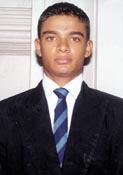 Wesley College wicketkeeper cum opening batsman Anderio Frederic Toussaint and Janaka Amila Withanaarachchi of Bandaranayake College, Gampaha skipper are the OBSERVER-BATA MOST POPULAR SCHOOLBOY CRICKETERS OF THE YEAR 2002. Anderio won the All-Island Contest with a total of 14,187 votes having received 2,119 votes on the final coupon No. 10. Anderio has been on top except on coupon number one and two. He was in first place in the penultimate count No. 9 with 12,068 votes ahead of Bendictine allrounder Sisil de Silva, 7,591 votes. In the final coupon No. 10, Anderio received 2,119 votes while Sisil received 1389 votes. So Anderio had no difficulty in coming on top. Sisil finished in second position with 8,980 votes and Charith Sylvester Fernando of De Mazenod College came third with 4,268 votes. Besides being popular cricketer, Anderio had a successful season, scoring over 739 runs which included five half centuries. His best innings was against Kignswood in which match he got 90 runs. He is also a smart wicketkeeper and had 35 victims behind the stumps this season. Anderio also is a good soccer player having captained the college football team in the inter-school tournaments. He played cricket for the college from the age of 8 years.
Wesley College wicketkeeper cum opening batsman Anderio Frederic Toussaint and Janaka Amila Withanaarachchi of Bandaranayake College, Gampaha skipper are the OBSERVER-BATA MOST POPULAR SCHOOLBOY CRICKETERS OF THE YEAR 2002. Anderio won the All-Island Contest with a total of 14,187 votes having received 2,119 votes on the final coupon No. 10. Anderio has been on top except on coupon number one and two. He was in first place in the penultimate count No. 9 with 12,068 votes ahead of Bendictine allrounder Sisil de Silva, 7,591 votes. In the final coupon No. 10, Anderio received 2,119 votes while Sisil received 1389 votes. So Anderio had no difficulty in coming on top. Sisil finished in second position with 8,980 votes and Charith Sylvester Fernando of De Mazenod College came third with 4,268 votes. Besides being popular cricketer, Anderio had a successful season, scoring over 739 runs which included five half centuries. His best innings was against Kignswood in which match he got 90 runs. He is also a smart wicketkeeper and had 35 victims behind the stumps this season. Anderio also is a good soccer player having captained the college football team in the inter-school tournaments. He played cricket for the college from the age of 8 years.
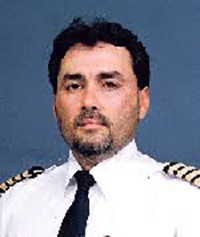 Capt. Navin de Silva, a versatile sportsman to hail from Wesley College has excelled in ball games - cricket and hockey for the school and later for NCC and CCC with much success. He has added another ball game - golf and was a cynosure in the RCGC greens. Taking to the sport only last year (within ten months) proved his mettle.
Capt. Navin de Silva, a versatile sportsman to hail from Wesley College has excelled in ball games - cricket and hockey for the school and later for NCC and CCC with much success. He has added another ball game - golf and was a cynosure in the RCGC greens. Taking to the sport only last year (within ten months) proved his mettle.
Slowly, but surely with his powerful drives and meticulous putting he mastered the skills. Firstly,he won the NoBride trophy, partnering Wimal Wijenayake. It was no looking back since then and has been a consistent performer. Despite exigencies of duty during his spare time he took to the greens and trained with resolution and determination. The hallmark in him, was that he was willing to learn from whatever quarter - the rough and smooth.
He won the popular Mercedes Benz 'B' Div. title to earn a berth to represent the country, in the Asian 'B' qualifying golf championship to be held in Gold Coast, Queensland, Australia, in August 2002.
Two hundred and fifty golfers teed off - among them were seasoned campaigners. He did proud to Wesley and to the National Carrier, SriLankan Airlines. As a schoolboy, De Silva led the Sri Lanka Schools team in 1981 for the tour of England. Incidentally his deputy was former Sri Lanka skipper, Arjuna Ranatunga. Had he continued in cricket he could have played in the national team as an utility all-rounder.- BW
After 40 Years since 1st School Cricket Tour of UK led by Navin de Silva
A picture is worth thousand words” Brotherhood, after almost 40 years since the first Sri Lanka schools cricket tour to UK in 1981, led by Capt Navin de Silva. The tour was a forerunner for many greats down the line such as Arjuna Ranatunga, Aravinda de Silva, Romesh Rathnayake, Graham Labroy, etc with many are still serving SL cricket in various capacities. Great memories and best of camaraderie. Missed a few due to unavoidable circumstances. Gone for ever, late Roshan Gunarathne Former Captain Nalanda and National player. Absolute Respect, team mate and brother.
Standing from L to R, Ranil Peries, Oshadie Weerasinghe, Charith Senanayake,Hiran Cooray, Graham Labroy, Gamini P, Mihara Egodage, Sanjaka Wijemanna and Ashley De Silva.
Absent, Sumithra Warnakulasuriya (indisposed) Deepal Dharmasekera, Olga Herat, Romesh Rathnayake (over seas) Kamal Dharmasiri (MIA)
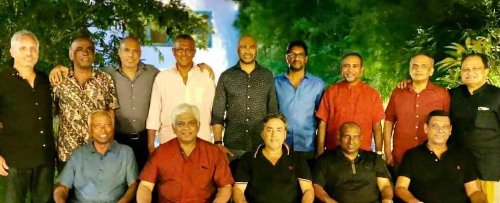
Links to further reading
Wesley College, the 100-year-old institution has made a name in cricket and hockey producing some outstanding players at the national level. The likes of late maestro M. Sathasivam, Brian Classen, L.R. Gunatillake, Russel Hamer, M. Samsudeen, Abu Fuard, Navin de Silva etc. (Cricket).
Legendary T. Mylvaganam, a dazzling hockey player. The school took upto rugby in the mid '50s. Eddie Buell was its first captain in 1956. The present Principal Mr. M.A.P Fernando was the M.I.C. (rugby) and Prefect of Games in the '70s saw the school taking to serious rugby. The Campbell school has taken to rugby and has proved their mettle at the junior level during the last couple of years according to Mr. Fernando.
The school had the likes of Reggie Bartholomeuz (Winger), Iqbal Musafer (fly-half), Kishan Musafer (Winger, presently playing for CR), Neville Perera etc. All donned the Red Shirt and played for the country.
The juniors during the last two years have been in the forefront winning titles. They have been developing the game at grassroots level. It has borne fruits according to coach Dishantha Priyadharshana, who is in charge of the junior and the First XV team. Of course Wesley is fortunate to have the services of S.W. Chang as Consultant (a storehouse of knowledge) to assist the coach.
Wesley last week won the All-Island Under-15 Rugby championship defeating St. Sylvester's 27/0. No team in the he entire tournament crossed their line or scored a point in this 10-a-side, staged in Kandy. Last year (2001) the Under-17 team in the All-Island Cup (10-a-side) were runners-up to Isipatana. Last year the Under-15 team toured Malaysia for the 10-a-side and was runner-up in the Cup.
Chang, a keen student of the game, has managed junior national teams abroad. There is a squad of 25 who are prepared to learn and committed to the sport. They have to take the rough with the smooth. They learn by their mistakes. If the Wesleyites are doing well in the on-going season, this attributes to the tremendous support afforded to them by the OWSC, the immediate past president Navin de Silva and the incumbent president Tyronne Maye.
The Prefect of Games, versatile old Wesleyite sportsman, Kenneth de Silva is spending much time attending to their needs (Heavy pack). The team led by Lahiru Boteju (No. 8) leads a hardy pack and a member of W.C. Junior team Steve Perera (prop), Ziard Thahir (centre) Sri Lanka youth players. 13 of last year's players are in the squad. Prasad (fly half), Rukshan Omar, Julian Francisco (h/backs), Nuwan Samith (centre), Zaki Badurdeen (fullback), Chithraja Weligamage (prop). The boys are all geared up and started with a bang.
Defeated Trinity for the first time 21/0 (friendly) won against St. Anthony's Kandy (with 5 national players tournament match) in Kandy 12-8 in a rousing contest. Beat Carey 24-13.
There are ten players, who are still Under-17. They are knowledgeable about the basics and the laws of the game. Taught to maintain the spirit of the game at all times and play to the whistle. Mr. Fernando said, indiscipline will not be tolerated from whatever quarter. The outcome is secondary, the game that matters in the end.
 Wesley College has done well, after a lapse of several years, to revive its 'Colours Nite' which takes place on July 6 (Saturday) at 6.00 p.m. at the College Hall.
Wesley College has done well, after a lapse of several years, to revive its 'Colours Nite' which takes place on July 6 (Saturday) at 6.00 p.m. at the College Hall.
The chief guest on the occasion will be Commodore Harsha Mayadunne, the President of the SLRFU and Mrs. Mayadunne.
Colours, in recognition and appreciation of excellence achieved in the varied sports disciplines at Wesley, will be presented by Mayadunne. Awards will also be made by prominent 'Old boy' sportsmen for outstanding performances by the current Wesleyites. The College Hewisi band will provide entertainment.
 Ex-firebrand cricket manager Abu Fuard can be considered one of the key men responsible for the current shake-up prior to the election of office bearers to the Board of Control for Cricket in Sri Lanka.An incumbent vice president, he is not only a candidate for the same post, but the main voice behind the candidacy of Clifford Ratwatte who is opposing present President Thilanga Sumathipala at the election to be held next Sunday. "I came to serve cricket and I am free to decide for whom I should vote. I don't belong to any team," Fuard told journalists at a packed news conference organised in support of Ratwatte last Tuesday.An articulate speaker, Fuard did not mince his words and charged that administrators were working against laid down procedure in decision making. "I am a person mindful of my responsibility. I have always advised the Executive Committee to act with tact and wisdom.
Ex-firebrand cricket manager Abu Fuard can be considered one of the key men responsible for the current shake-up prior to the election of office bearers to the Board of Control for Cricket in Sri Lanka.An incumbent vice president, he is not only a candidate for the same post, but the main voice behind the candidacy of Clifford Ratwatte who is opposing present President Thilanga Sumathipala at the election to be held next Sunday. "I came to serve cricket and I am free to decide for whom I should vote. I don't belong to any team," Fuard told journalists at a packed news conference organised in support of Ratwatte last Tuesday.An articulate speaker, Fuard did not mince his words and charged that administrators were working against laid down procedure in decision making. "I am a person mindful of my responsibility. I have always advised the Executive Committee to act with tact and wisdom.
"There were occasions I thought of resigning, I just could'nt stomach what was taking place," added Fuard who is challenging the same people he promoted only last year.For ethical reasons Fuard declined to reveal deep details of alleged controversial expenditures, but his main cause for shifting the tide is the sanctioning of 400 million rupees for the construction of a stadium in Dambulla.An area which he describes as sparsely populated and not worthy to play host to an international stadium."The way funds were used are best known to them (Executive Committee). I always told them to follow procedure all the time. But they saw me as an obstacle to their work", said Fuard.The neglect of future cricketers and the failure to take stock of ageing players has also made Fuard fall out with the current administration. Fuard reasons that existing venues in Kurunegala, Matara and Radella in the central highlands, should instead draw the attention of administrators for upgrading to international standards.
Fuard promised that under a changed administration, Kurunegala could be redesigned as a Test venue with just 10 million rupees and Radella be transformed into a first class ground.It will be also used as a training centre for Sri Lankan teams preparing for tours in cold countries like New Zealand and England.He said a sum of 50 million rupees could be set aside (from the Dambulla fund) for the construction of a hotel in Kurunegala to boost the venue's image.Fuard's crucial insight into the present administrative system prompted reporters to direct the majority of their questions at him. One reporter, a foreign correspondent apparently spellbound by Fuard's rhetoric, asked the former leg-spin bowler why he was contesting the vice presidency and not the top post.
"I would go to any length, but I know my limitations. I want to serve cricket but I don't want to creep into places where I'll be uncomfortable", Fuard shot back.Fuard supported Ratwatte's decision to challenge Sumathipala by remarking that the best cricketers don't become the best administrators. "Some of the best administrators have never held a bat and Jagmohan Dalmiya did not even play marbles," declared Fuard.Dalmiya, an Indian, is the current head of the International Cricket Council (ICC)Both Fuard and Ratwatte shared similar views that the Sports Ministry will have to be advised on the need to change existing regulations that prevent potential administrators who have not played cricket from holding office in the Board.
A Legendary Cricket Legionnaire Sporting personalities with Ken de Joodt
 It is a truth of life to those who believe, that "God blesses those who give of their lives and resources" - giving of your time, giving of your talents and giving of your love, be it in the 'recreation' of Sports or in the creation of life! To those who know, 'Thanking God' is a great act of simple gratitude - but with it comes greater gain! Abu Fuard worked hard in whatever he applied himself - to reap a harvest of rewards! Like the farmer who 'puts his hand to the plough' in the field and plods on, to pluck the fruits of success and distributing the delights with others.
It is a truth of life to those who believe, that "God blesses those who give of their lives and resources" - giving of your time, giving of your talents and giving of your love, be it in the 'recreation' of Sports or in the creation of life! To those who know, 'Thanking God' is a great act of simple gratitude - but with it comes greater gain! Abu Fuard worked hard in whatever he applied himself - to reap a harvest of rewards! Like the farmer who 'puts his hand to the plough' in the field and plods on, to pluck the fruits of success and distributing the delights with others.
Abu did likewise in his 'long innings' of over 30 years in his illuminating Cricketing career, on and off the cricket fields! Abu Fuard As one of Sri Lanka's sensational 'super-duper' off-spin bowlers, highly acclaimed in the past as one of the best in Asia's Cricketing arena, Abu has come to 'grips' with life (as he did so well with the cricket-ball), accepting the good that came his way to do good for others! "To err is human - to forgive is divine" makes one realize that people are apt to make mistakes but learning from one's mistakes is more profitable to life. Abu had in his 'run of play'- 'spun-out' powerful people (at 'Silly-point"!) who may have been 'narrow-minded' in their motives and more focused on their 'own gains, than for the good of the game and the players themselves! By propelling his 'variations' he had misunderstandings and 'mix-ups'...but the 'breakthroughs' - (some 'bowled-out' and some 'caught-out', with no questionable 'LBW's!) - came before "stumps (or daggers!) were drawn" !!
Resulting from the 'breakthroughs', many a talented Cricketer was in due course identified and given the opportunity or a 'chance' to play for Sri Lanka, picked from across the 'barriers' of the North, South, East, West and Central parts of the island. Perhaps it was an easy task for the Selectors to 'pick the best' from the metropolis, Colombo - players knew well that if they played for a Colombo club, they would stand a good chance for selection in the Sri Lanka side!' It is no secret in Sri Lanka Cricket, that Abu Fuard, (backed by a former Ananda Captain Dhanasiri Weerasinghe), from the mid-Seventies, was 'instrumental' in paving the way for more, young exciting cricketers from the outstations, to add 'glamour' to Sri Lanka cricket - and a few years later a 'new tune' was played..."we are the Champions!" During the illustrious tenure of Robert Senanayake, from 1957 to 1976 as President of the BCCSL, the 'pace' changed and 'new things' began to happen in 1973! With a new Sports Law in 1976 which declared that office-bearers could hold their posts for only two years in succession, Robert Senanayake's devoted service of 20 years came to an end! Some of the dedicated administrators Sri Lanka Cricket had from the early 50's to mid 90's, were J.R. Jayawardene (1952 to '56), Robert Senanayake (1957 to '76), Maj. Gen. B.R. Heyn (1976 to '78), Dr. N.M. Dr. Perera (1978 to '80), Gamini Dissanayake (1981 to '89), P.I. Peiris and Lakshman Jayakody (1989 to '91), Tyronne Fernando (1991 to '94).
In his term as President of the SL Cricket Board (BCCSL), Gamini Dissanayke took over at a crucial stage in the history of Sri Lanka Cricket, to continue his efforts from 1981 to obtain full ICC status for Sri Lanka. Abu had been a close friend of Gamini Dissanyake, (who stayed down the same lane in the opposite house from 1974). "We often met and had discussions on the betterment of cricket" - said Abu "and I executed the plans and programs entrusted to me, preparing the infrastructure, planning, finances, etc; to perfection - and assisted him in the 'ground' work for obtaining Test Status." An ICC condition given to Gamini in 1981 at the ICC members meeting, was to ensure that additional Test Playing Venues would be constructed to international standards in Kandy and in Galle, within a year. Gamini entrusted the responsibility to Abu, to transform the Trinity College Kandy grounds at Asgiriya into an international Test playing venue. Cutting a long story short, Abu ensured that this requirement was fulfilled and Gamini went back to the ICC in London, to 'bag' his greatest achievement in cricket. England played the Sri Lanka Test Team in their first Official Test Match in Colombo, from 17th to 22nd February 1982.
Abu has been blessed with a lovely wife Fawziya whose love, care and concern are exemplary and Abu is pleasantly satisfied as he approaches his birthday in December this year...to reach the proverbial - "Three score and ten" 70 years in age! Abu was bonr in 1936, inheriting his father's brilliance and cricketing talent from the age of 13, A Lawyer by profession A.M. Fuard, (Abu's father) Captained Wesley College, Colombo in 1915 and went on to play for the Moors Sports Club in 1916, to perform the 'double' in scoring 1000 runs and taking 100 wickets in all the matches that season. Abu Fuard commenced playing for Wesley College in 1951, at an early age of 14 yrs and continued a 'star-spangled' school cricketing career up to 1954. He first played under Radley Claessen in 1951, Brian Claessen in 1952 and his brother Ansar Fuard in 1953. Abu bears bitter memories of the manner in which he was deprived of captaincy in 1954 as he had three more years to play for the school. Although he was certain of captaining in 1955, to his horror he discovered through the "Evening Observer" (in an article published by one of Sri Lanka's best Sports Reporters in the fifties, Eustace Rulach), that some other boy had been appointed the captain.
This caused a phenomenal change in his young life and with a change in his attitude, he expressed it in 'no small way' to the school authorities in charge of Cricket. Abu said "I was too young to handle this disappointment - I just changed from being a 'little lamb' to an angry lion!" In fact, Abu took an immediate decision to quit school in protest, which gave the Principal and Master-in-Charge a rude shock, when they were told that he will not play for the team again. This compulsive action caused a reaction in his character, making him more alert to the adversities of life and created in him a tougher 'line-of-action'. With no time wasted, Abu launched out into a career of Insurance at the age of nineteen, which he has pursued over the last 51 years and continues to this day, as an Insurance Agent and Consultant. In cricket too, Abu had represented the Moors Sports Club while still at School, from 1951 to early 1953. He then dedicated himself to playing serious club Cricket, and joined the Colts Cricket Club up to 1967.
From 1968 to 1971 he benefitted by playing for the Colombo Cricket Club, although Abu had 'hung-up' his boots in 1967! In earlier times, he put in long hours of practice and played Cricket 'real hard' to gain his position in the Sri Lanka team from 1956 to 1971 a period of fifteen long years. Although Abu began his cricketing career as a pace-bowler in his youth, he was 'picked' by his coach at Wesley College, A.V. Fernando, to take up to Spin bowling which he did like a 'duck takes to water' ! Some of his outstanding performances in the following years included a haul of 6 for 76 against S. Thomas' College Mt. Lavinia, 8 wickets for 60 against Royal and 9 for 53 against Prince of Wales. As a great all-rounder, he excelled in batting and he was associated with Brian Claessen in a record-breaking partnership of 231 runs against Richmond College, Galle. From this point onwards, there was no turning back and his progress and prowess in cricket as a 'Great Gentleman Cricketer' grew steadily over the years extending to Cricket Administration and Management completing 31 years dedicated service and leadership, to Sir Lanka Cricket Board, a Selector from '75 to '86 (Chairman from '82 to '86), the first Team Manager of Sri Lanka in 1975 on their tour to Bangladesh and in '79 he was Asst. Manager to Maj.Gen. B.R. Heyn on the UK tour.
From 1985, he was appointed Manager of the Sri Lanka Team for three years. In 1996, Abu received a "Testimonial" for his great contribution to Sri Lanka Cricket, both as a Test Player and for Administration and Management, at a 'Benefit Match' played in Sharjah, where Michael Holding of the West Indies and Abdul H. Kardar of Pakistan, also received "Benefits". His greatest recollections of outstanding Sri Lanka cricketers in his time, starts with C.I. Gunesekera, who he considers the finest Captain, who maintained high standards of discipline and led by example. Abu recalled with laughter how 'C.I' always called Abu 'Master' even on the field he would say "Master, will you bowl?" and Abu would promptly shoot back "Yes Sir" and this would go on in their record breaking batting partnerships too! "Master, come one!" and Abu would say "Yes Sir" and run...but he yet does not know why C.I. called him "Master"! Norman de La Harpe, Tita Nathanielsz, Pat Kelly, Makkin Salih, Laddie Outschorn, Vernon Prins, H.I.K. Fernando, Stanley Jayasinghe, P.I Peiris and Gamini Goonasena are some of the others he can vouch for as true 'Gentlemen Cricketers'! In bowling, Anuruddha Polonowita and Abu were likened to the famous West Indian 'spin-twins' Ramadhin and Valentine, but there were others too, like Neil Chanmugam, Fritz Crozier, Annesley de Silva, Daya Sahabandu and last but by no means least is C.I. Gunesekera. Abu's highlights of the numerous occasions on which he has performed brilliantly in School, Club and Sri Lanka Test Cricket is in 1964 when he claimed 6 wickets for 31 runs against Joe Lister's International XI. To his mind, he thinks his greatest thrill and achievement has been his success in 1973, to have made a way and opened the doors for the 'outstation Cricketers' to be given their chance for selection to play for Sri Lanka.
Links to further reading
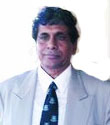 Relished by the American press as far back as 1919 (Atlantic monthly) and Victoria Institute K.L. (1923) the famous quote from Rudyard Kipling reminds us of the mud covered 60 minutes at St. Benedicts Grounds at Kotahena. Still, some of our best rugby players did come out as clean as they went in. Kandy, the beautiful tea county, on a rain drenched day, Wesley meeting Kingswood at rugby, at Bogambara grounds, not too far from the Prison walls, those who scrummed down will remember the mud splashed faces and the soggy boots. Wesley grounds was the opposite, dust and gravel, peeled elbows and bruised knees. Peel. As I write, the names that come to my mind are: Sinsen, Chang, Bashudeen Musafer, Shari Musafer, Reggi Bartholomeusz, Asoka Jayawadane, Dr. Shee Hung, M.C.A (Cassim) Cader (all captained Wesley). Sextus Taylor, Leon Ingram, Haig Claessen, S. Wahab, Kevin Gauder, Jeremy Brohier, Patrick Gnanamuttu, Nihal Peiris, Nihal & Jayantha Peiris, Mano Gnanapragasam, Ponnambalam Sivasubramanium, Jayawardane Brothers, Marlin & Rohan Weerasinghe, Dianesh Rajaratnam, Micheal & Jeremy Kreltsheim, Keith de Kretser, Norton Abeydeera, Samsudeen, Akbar, Taric Bongso, Richard Ebell, Mahes Samaraweera, Jayantha Wickremaratne, Henry & Eustace Mathuranayagam, Brian Bartholomeusz, A. M. Mohideen, Rory Rodrigo, Dayantha Makalanda, Emir Musafer, Dr. Ma Huung, Leroy Jansz, Harward Grabo, Yohan Raju, Bachchi Oumar, Ray de Run, Ahlip twins.
Relished by the American press as far back as 1919 (Atlantic monthly) and Victoria Institute K.L. (1923) the famous quote from Rudyard Kipling reminds us of the mud covered 60 minutes at St. Benedicts Grounds at Kotahena. Still, some of our best rugby players did come out as clean as they went in. Kandy, the beautiful tea county, on a rain drenched day, Wesley meeting Kingswood at rugby, at Bogambara grounds, not too far from the Prison walls, those who scrummed down will remember the mud splashed faces and the soggy boots. Wesley grounds was the opposite, dust and gravel, peeled elbows and bruised knees. Peel. As I write, the names that come to my mind are: Sinsen, Chang, Bashudeen Musafer, Shari Musafer, Reggi Bartholomeusz, Asoka Jayawadane, Dr. Shee Hung, M.C.A (Cassim) Cader (all captained Wesley). Sextus Taylor, Leon Ingram, Haig Claessen, S. Wahab, Kevin Gauder, Jeremy Brohier, Patrick Gnanamuttu, Nihal Peiris, Nihal & Jayantha Peiris, Mano Gnanapragasam, Ponnambalam Sivasubramanium, Jayawardane Brothers, Marlin & Rohan Weerasinghe, Dianesh Rajaratnam, Micheal & Jeremy Kreltsheim, Keith de Kretser, Norton Abeydeera, Samsudeen, Akbar, Taric Bongso, Richard Ebell, Mahes Samaraweera, Jayantha Wickremaratne, Henry & Eustace Mathuranayagam, Brian Bartholomeusz, A. M. Mohideen, Rory Rodrigo, Dayantha Makalanda, Emir Musafer, Dr. Ma Huung, Leroy Jansz, Harward Grabo, Yohan Raju, Bachchi Oumar, Ray de Run, Ahlip twins.
But, 2002 was the year Wesleyites have been waiting for - at Longden Place. A memorable match when the best fifteen from the Double Blue was put against the best players from Trinity College, Kandy. This time the Lions failed to roar, they were tamed by a huge margin of 23 to Nil. Many great teams with classy players tried, came close, but could not cross the line to touch down to claim a victory. Bachchi Oumar records the previous best was under the captaincy of Rashmore Ferdinands in 1978 (Nil-4) also at Longden Place. Congratulations to the Master-in-Charge, Coach, Captain, and the team. A sincere Thank You to the Old Boys who rallied to fate the Wesley team - particularly Richard Yohan Raju, Bachchi Oumar, Patrick Gnanamuttu, and Navin de Silva.
At a time when we are ecstatic with our performance and achievement and celebrate, let us take a moment to remember all those who helped Wesley Rugger. To mention a few I distinctly remember: The coaches - Mr. Lucky Withana, Mr. Kenneth Boteju, and Mr. Bentley Barsenbech; The teachers - Mr. M.A.P. Fernando, Mr. D. D'abrera,Mr. D.A. Pakkiyanathan.
The other muddy game is soccer as in football but distinguished from American Football or Aussie Football. Wesley's record is well documented in the article written by Mr. Neville Abeygunawardane " Reminising Soccer at Wesley". I miss some of the great names, but remember a few more names like, like Samidon, Ratnavel, Mervyn and Russel Harmer, Ranjit Samararatna, Bulner and Rodney Perera. Wesley gave up soccer for a period between 1964 to 1968. I hope the recent accomplishments from 1968 will be recorded.Sir George Bernard Shaw described cricket as a great game played by 11 flannel fools at the wicket. Much has been written about our cricketers who made history. There were a few loyal Weslyites who loved the game and supported when we really needed moral support in black & white in newsprint. I remember: Christie Seneviratne, Arnold de Silva, Peter Cassi Chetty, Cumar Rodrigo, Ranjit Vethacan, and Richard Dwight. Now, Dwight's Columns appear in the Sri Lankan Dailies while Peter's views, reviews, and critiques appears in Tony Greig's dot com cyber media columns in "The Wicket.com" available in hypertext: http://thewicket.com/archivewriterlist.asp (as provided by Patrick Gnanamuttu).
By Pelham Juriansz
 Anderio Frederick Toussaint, Wesley's wicketkeeper-batsman and soccer captain, who won the Observer-Bata Most Popular Schoolboy Cricketer of the Year award received the prestigious Best Allround Sportsman Trophy at the Wesley College Colours Nite 2001 at the College Hall yesterday.
Anderio Frederick Toussaint, Wesley's wicketkeeper-batsman and soccer captain, who won the Observer-Bata Most Popular Schoolboy Cricketer of the Year award received the prestigious Best Allround Sportsman Trophy at the Wesley College Colours Nite 2001 at the College Hall yesterday.
This awards nite which was the brainchild of the former Principal of Wesley late Shelton Wirasingha was revived after a period of 7 years.
Chief Guest at the celebration Commodore Harsha Mayadunne, President of the Sri Lanka Rugby Football Union said that Wesley had a proud history of producing excellent cricketers, the most celebrated of whom is the late Mahadevan Sathasivam, who according to many cricket experts, was Ceylon's finest batsman, having captained two countries, namely Ceylon and Malaysia.
Rugby too has improved at Wesley in the last few years and three players represented Sri Lanka, namely Lahiru Botejue, Ziard Thahir and Steve Perera.
Outstanding schoolboy cricketer Farveez Mahroof who represented the Sri Lanka under 19 schoolboy team received many awards for his prowess. He won the E.T. Fernando Memorial Prize for batting, the M. Sathasivam Prize for bowling, the A. V. Fernando Memorial Cup for the Best Allrounder and the Herman Claessen Challenge Trophy for the Best Outstanding Performance.
In addition to his best Sportsman Award, Anderio Toussaint won the Dushyantha Memorial Cup for fielding and along with Mahroof was awarded cricket colours.
The Fifth Annual Rugby encounter between Thurstan & Wesley for the Diyanesh Rajarathnam Trophy will played on 19th Friday at the CR & FC Grounds Longden Place. The score to date stands 3 to 1 in favour of Thurstan.
Diyaneh Rajarathnam was an outstanding product of Thurstan who had the unique honour of Captaining both Cricket and Rugby Teams. In Rugby he played as Fly half and inside Three quarter was also a place kicker of repute. Ironically his first match was against Wesley his former school at the Campbell Park under the captaincy of Upali Hewage. The match was won by Thurstan 8-3 with Diyanesh contributing 5 points. Diyanehs's elder brother Amaresh captained Wesley cricket Team in 1969. Thurstan & Wesley took up to rugby in the mid fifties around the same time & it was only in 2001 that Wesley was able to beat Thurstan. Thus the similarities & the close connections between the two schools over the years makes this encounter an interesting affair.
Both Thurstan & Wesley can be proud of their contribution to Sri Lanka's Rugby. Jeff Rutnam, Deepal de Zoysa, Sunil Jayakody, E.K.R. Wijewardena, Ranjit Jayawardena, Dushyantha Samarasekera, Tissa Nanayakkara, Rohan Boudweyn Chula Dharmadasa and Harsha Mayadunne stand out among the Thurstanites while Reggie Bartholamuesz, Cavarn Gauder, Iqbal Musafer, Zubair Dercy, Eddie Buell and former CR skipper Kishan Musafer figures prominently in Wesley's hall of fame.
This year Wesley has fared extremely well including a record breaking win over Trinity are considered one of the strongest school teams and will undoubtedly go out as firm favourites to retain the trophy. Thurstan on the other hand are going through one of their leanest seasons with a young and inexperienced team, but are expected to give a good account of themselves in the Big game.
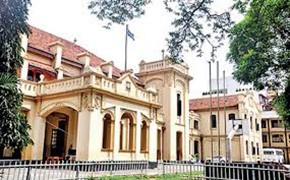 |
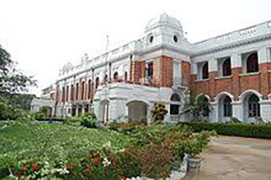 |
The second oldest school cricket encounter in Sri Lanka, the annual cricket fixture between Wesley and Royal, will unfold another chapter at Campbell Park today. For the record this year’s match will be the 109th occasion where the two schools will play each other. The series commenced back in 1893 when the two schools battled each other at the Royal Ground, Pettah (Present St.Sebastians Hill. Royal won the match by 53. The match since then has been a looked forward to event in the calendars of both schools. The only year the match could not get under way was in 1943 when the grounds of both schools were requisitioned during the war with the threat of a Japanese invasion. Of the 108 encounters played so far Royal have won 47 matches while their rivals have emerged winners on 22 occasions.
Another feature of this cricket fixture is that there is trophy, named after the late Sir Frank Gunasekara, on offer for the winning team. This trophy has been on offer since 1969. The Trophy was donated by Dr Lucian Gunasekara, son of the late Frank Gunasekara. Royal led by all rounder Ganganath Ratnayake are expected to take the fight up to the Wesleyites who are marshaled by Favreez Maharoof.
Royals last won this encounter in 1995 while Wesley’s final win in the series took place in 1969, the year the Frank Gunasekara Trophy was introduced. In two other key fixtures which are to begin today St.Joseph’s will take on Ananda at Ananda Mawatha while Dharmapala will travel up to Campbell Place to meet Nalanda.
The probable teams-
Wesley:Favrez Maharoof, Sajith Colombage, Nuwan Samith, Anderio Toussiant, Pramod Makalanda, Isuru Fernando, Thushara Waduge, Eric Joseph, Kamantha Kodikara, Kushan Senewiratne, Afzal Sabar, Surendran Sundaralingam
Royal: Ganganath Ratnayake, Chaminda Vidanapathirana, Menuka Keenawinna, Damith Abeygunawardana, Sugeesha Dinushan, Suren Mendis, Sahan Perera, Rochana Wijeratne, Naveen Dias, Tharaka Kottehewa, Dishan Kanake, Pasindu Chamikara.
By Pelham Juriansz
The schools invitation "sixes" organised by the Old Wesleyites Sports Club(OWSC) and sponsored by Ceylon Cold Stores(CCS) under the Lemonade label will enter its 10th year when 24 schools will battle it out for supremacy at Campbell Park on October 12 and 13. The matches will commence at 8 a.m. on both days.
Thirty two schools have been invited though only 24 will be finally selected. The selection procedure is as follows:
27 schools who performed well during the 2001/2002 season (i.e. 19 schools from the 'A' division, 5 teams from the 'B' division and 3 teams from 'C' division), two international schools and 3 outstation sides at district level-from Jaffna, Batticaloa, Polonnaruwa or Anuradhapura will be selected.
The first 24 teams responding to the invitations will be selected.
This year only 24 teams will be seen in action as against 28 last year. Last year, Royal won the tournament while De Mazenod, Kandana were runners-up. The draw for the tournament will take place on October 1 at the OWSC club house. Speaking at the press conference in connection with the event, Ivor Mahroof, Senior Vice President of the OWSC, said that this tournament which started 9 years ago was the first of its kind for schools. Laksiri Wickramage, Director, Ceylon Cold Stores (CCS) on behalf of the sponsors said that CCS is very happy to be associated with this tournament for the last nine years going into its tenth competition and will continue to support the "sixes" for the next two decades. said Wickramage.
The Principal of Wesley, M.A.P. Fernando said that about 15 years ago Wesley played a match against St. John's Jaffna and he went with the team to Jaffna and they reciprocated by coming to Colombo.
"This tournament gives the outstation schools a chance to play with the Colombo schools and schools like Kalutara Vidyalaya, De Mazenod have performed well and even won the tournament," added Mr. Fernando.
We pay homage to our Rugby captains. They have done us proud. We honour and respect all the members who played under their captaincy.
......................................................................
The Photos from the Pavilion were kindly sent to me by Vinod Joseph and Keith Grenier.
List of 1st XV Rugby Captains sent by Vinod Joseph and Keith Grenier
......................................................................
From Dr Nihal D Amerasekera
It is a great honour to be selected to represent the school. With the honour comes tremendous responsibility to do their best for the team at all times. This includes attending regular practices and travelling for the games away from home. This must occur at the expense of preparations for important examinations. We acknowledge and thank them for their efforts and sacrifices.
Those sportsmen were placed on a pedestal and were greatly respected by all. That intoxicating amalgam of praise and public acclaim can be destructive. Despite their teenage years they received this adulation with poise and dignity. Conceit grows imperceptibly and the person who is afflicted is unaware of it. Fortunately the hard knocks of our lives at school and those in the playing field were enough to tone it down. The effort to suppress one's feelings and behave well in public continuously must have been a great strain. Much has to be said about the discipline and training at Wesley which helped to groom such men of modesty and valour. I must say I looked at them with some envy and respect.
As I read through some of the anecdotes of the school matches on the Double Blue International, there are a multitude of interesting and hilarious stories of the games. Equally humorous stories fill the pages of the goings on off the field. There were sportsmen who were eccentrics, jokers and mavericks who saw the world differently. They indeed added colour to the sports and to life at school. They were all teenagers and none deserved sainthoods. It is only when we leave school and many years later, after life has come a full circle, that we appreciate how good those times were at Wesley. The weight of rules and regulations were a mere nuisance.
Personally, I never had the talent to represent the school. My sports were confined to soft ball cricket and soccer played in the Small Park at Karlsruhe Gardens. This has made me a life long spectator of all sports. Campbell Park was then our amphitheatre. I have such fond memories of watching cricket at Campbell Park standing under the "Mara" trees singing the College Song. Those Annual Sports Meets, Soccer, Rugby and Hockey matches at Campbell Park are memories to cherish. I now live 6 minutes walk away from the Lords Cricket Grounds and continue being a passionate spectator.
As a spectator now, I have the luxury of being an armchair critic. I can express my feelings freely although some views and opinions are far removed from reality. This is one of the great perks of being a spectator. At school I had to behave myself and take great care not to upset the sportsmen.
Having said all that, I have enormous respect for all those who played sports for the school. Sports were a huge part of school life. Away from the drag of books and classrooms, Sports made schooldays interesting, beautiful and memorable.
Links to further reading
.........................................................................
Rugby 1st XV Team - 1959
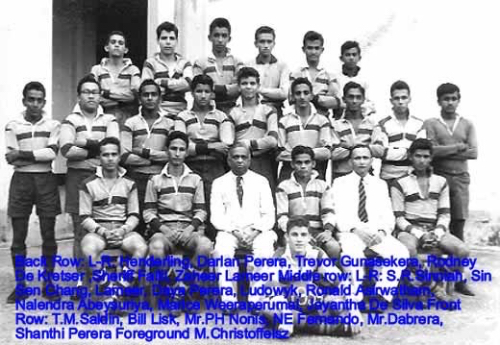
.........................................................................
Rugby 1st XV Team - 1960
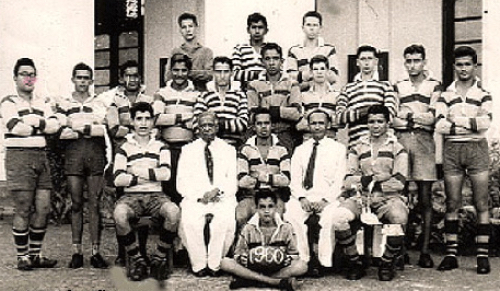
Fore Ground:- Robin Reimers
.........................................................................
Rugby 1st XV Team - 1962
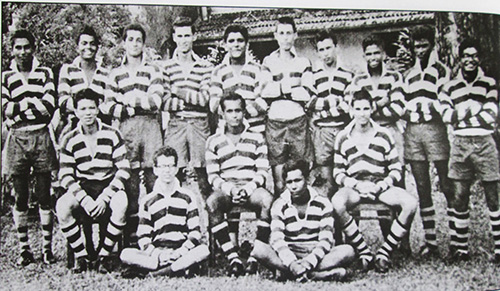
.........................................................................
Rugby 1st XV Team - 1966
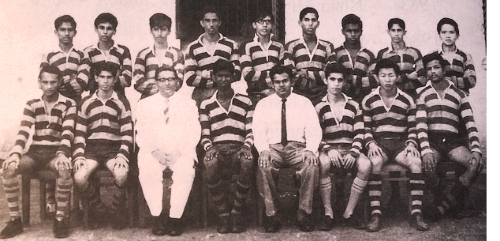
.........................................................................
Rugby 1st XV Team - 1967
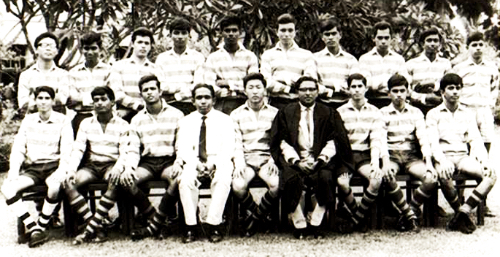
.........................................................................
Rugby 1st XV Team - 1968
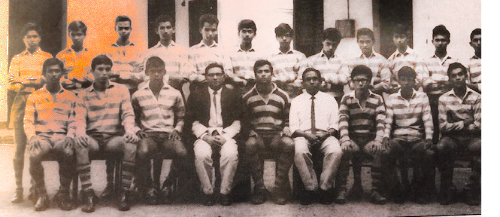
.........................................................................
Rugby 1st XV Team - 1969
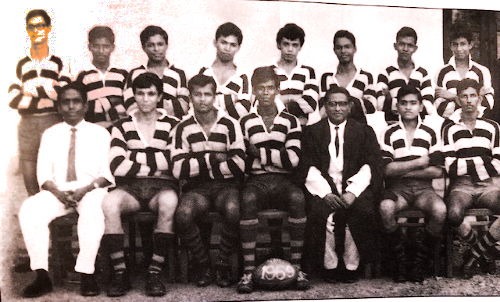
Mr Pakianathan, Roger Koch, Asoka Jayawardene (Capt ) MCA Cader, Mr A S Wirasinha, Soekarno Samsudeen, Eustace Mathurunayagam
Standing L-R:
Richard Ebell, Reza Thajudeen, IMA Cader, Tariq Bongso, Jeremy Kreltszheim, B H Dole, Emir Musafer, Leon Ingram.
.........................................................................
Rugby 1st XV Team - 1973
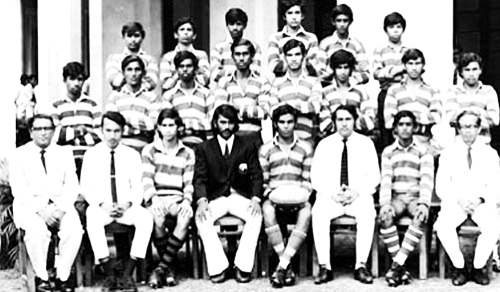
.........................................................................
Rugby 1st XV Team - 1974
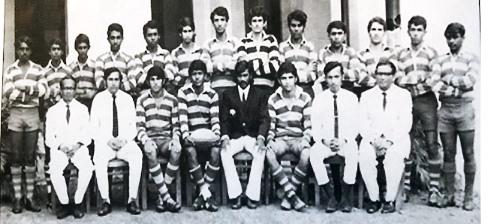
.........................................................................
Rugby 1st XV Team - 1975
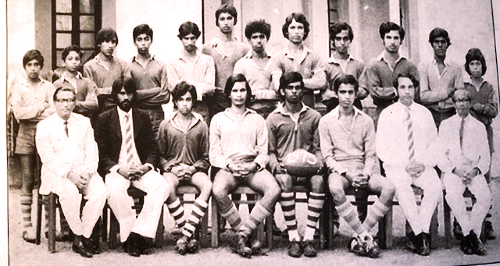
.........................................................................
Rugby 1st XV Team - 1977
Captained by Yohan Raju
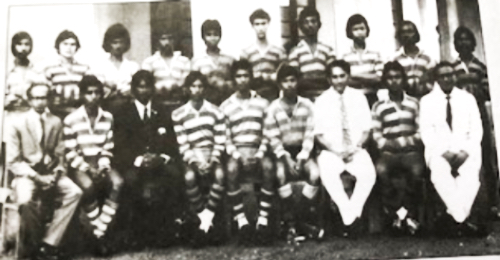
Anil Perera, Shehan Nanayakkara, Mirza Caleel, Zubair Doray, Ajith Uvaise, Dilangen Jayasekera, Riza Kamaldeen, Bachchi Oumar, Ajith Dias, Panchalingam.
Mr Dunston Fernando (Vice Principal), Paul, Reg Bartholomeusz, Iqbal Ahamat (Vice Captain), Yohan Raju (Captain), Rohan Oumar, Mr M.A.P Frenando (Master In charge), Mr A.S.Wirasinghe (Principal)
.........................................................................
Rugby 1st XV Team - 1978
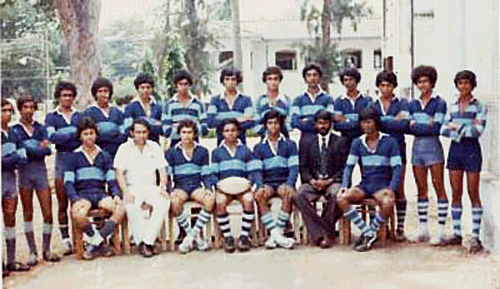
Ajith Dias, Anil, Kaleel Mirza ,Zubair Doray, Shamy Rajendra , Imtiaz Jayah , Andrew Asirwathan , Glen Wambeek, Reza Kamaldeen , Alwis (Wavla jnr), Faizal Bongso , Uduman , Ajith Senewirathne
Gulam (bachi) Omar, Mr MAP Fernando , Shihan Nanayakkara , Rusmore Ferdinandz(Capt), Ajith Uwais, Mr Reg Batho, Musthafa
.........................................................................
Rugby 1st XV Team - 1981
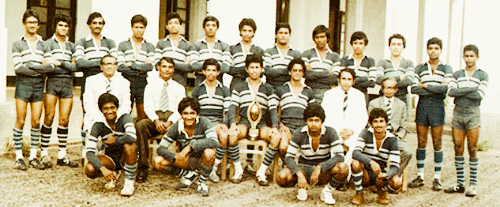
Milroy Barnabus, M.Rahmathullah , Sumith Perera , Sareem Jasim, M.Fahmy, Fazal kamaldeen, Shashi Ganarajah, Ishan Ali , Zubair doray , Riaz osmand , Navin de Silva , N.Ravichandran , Deepthi Perera
Mr AS Weerasinghe, Mr Benedict De Zylva (Coach), Rohan Costa, Gulam Omar (Capt), M,Kaizer, Mr MAP Fernando Ground L to R; Fazi Doray , Sanjeew Ganarajah, Senaka Perera , Hemantha Pathirajah
.........................................................................
Rugby 1st XV Team - 1982
Captained by Hassan Kaiser
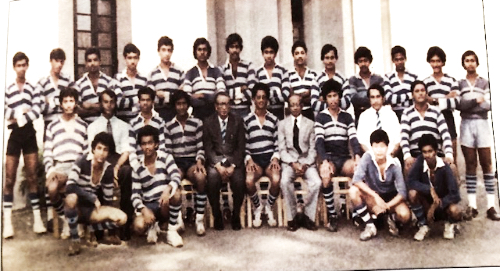
.........................................................................
Rugby 1st XV Team - 1983
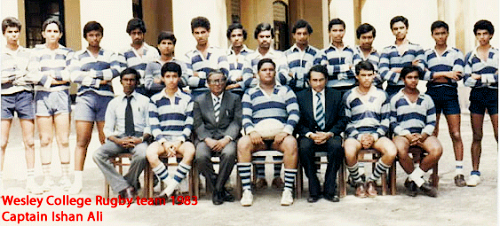
.........................................................................
Rugby 1st XV Team - 1984
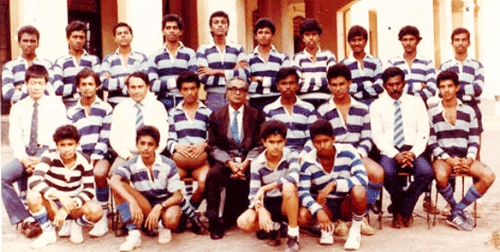
.........................................................................
Rugby 1st XV Team - 1988

.........................................................................
Rugby 1st XV Team - 1992
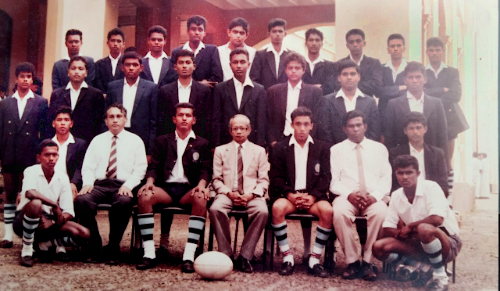
.........................................................................
Rugby 1st XV Team - 1993
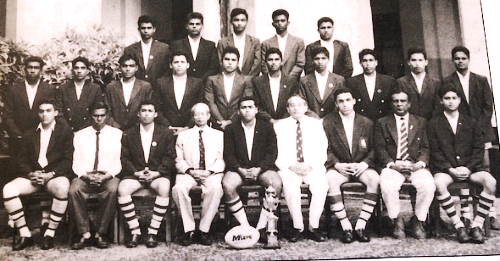
.........................................................................
Rugby 1st XV Team - 1994
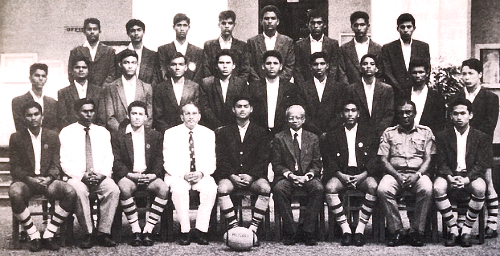
.........................................................................
Rugby 1st XV Team - 1995
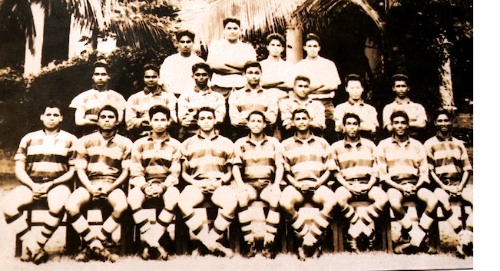
.........................................................................
Rugby 1st XV Team - 1996
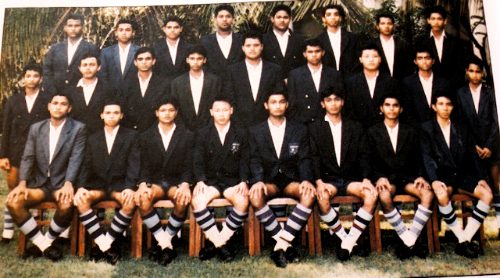
.........................................................................
Rugby 1st XV Team - 2002
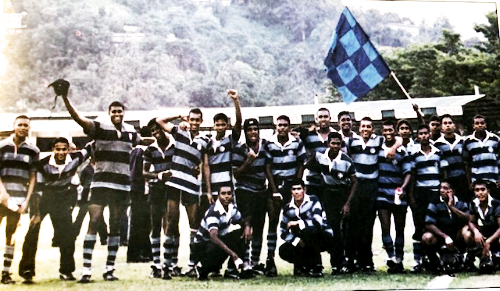
.........................................................................
Rugby 1st XV Team - 2006
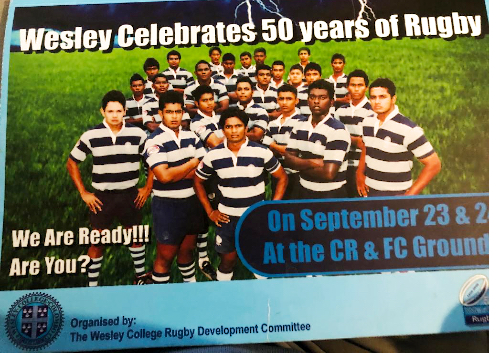
.........................................................................
Rugby 1st XV Team - 2019
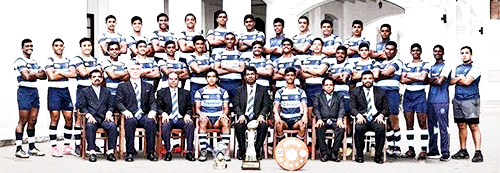
It was February 1953, a brilliant team effort by our cricketers and Wesley had defeated our traditional rival Royal College, for the second year in succession. There were 15 lbw decisions in this match which produced 253 run for 23 wickets. Pat 'Spud' Schokman played a cavalier innings of 74 runs, including 14 fours, Samsudeen was unplayable, taking 5 for 17, and our fielding was inspirational with Neil Gallagher, Ansar Fuard, Brian Claessen and Arthlow Chapman being outstanding.
The last Royal wicket had fallen and Wesleyities of all ages joined in the ecstatic celebrations that followed. The late Gordon Amaresekera, who was holding a rugby ball confiscated from a youngster, kicked it in the direction of the vanquished Royalists who picking the ball up ran in the direction of University College Grounds. All hell broke loose - Wesleyites of all ages gave chase to recover the ball and restore honour - a scrap game of rugby football commenced no rules, no quarter asked. Sanity soon returned and the sporting cheerleaders of both colleges arranged a game of makeshift rugger - the prize the rugby ball.
I cannot recollect the final score if any, or whether the ball was returned to the young owner, but one thing is certain Rugby Football had arrived at Wesley and those first players were Brian and David Mack, Ralph Maas, S K Kasinathan, Gordon Amarasekera, P B 'Kuiya' Herat, the late Rodney Schokman, David Schokman, Denzil Perera, Ranjith Authokarale Ranjith Abeydeera Melville Mottau, Vernon Speldewinde, Mohamnmed Iqbal, Chris Stork, Tissa Amarasingha, Gamini Seniviratne, Brantha, Preena, Geoffrey Fernando, Richard Dwight, "Abee" the Buell brothers and many more.
Wesley commenced playing rugby as an official sport in 1954. Our first captain was Edward Buell and Vice Captain Noel Beven. Both these players represented the CR and FC and the Ceylon Barbarians. Pat Schokmnan T Allasundream, S K Kasinathan played for the Havelocks.
We will be compiling a more detailed history of Rugby Football at Wesley and hope to include this in our next issue of the Bulletin.
So, Wesleyites, this is my version of rugby arriving at Wesley.
ABEE
Wesley College will honour their sportsmen who excelled during the year 2001 at the Wesley Colours Nite to be held on July 6 (Saturday) at 6 p.m. at the College Hall.
Commodore Harsha Mayadunne, President of the Sri Lanka Rugby Football Union and Mrs. Mayadunne will be the chief guests.
Four old boys who excelled in sports have been invited as guests of honour to give away some of the awards.
They are Flt.Lt. Sampath Wickremaratne (Soccer), Mr. Rohan Amarasinghe (Hockey), Mr. Russel Hamer (Cricket) and Mr.Kishan Musafer (Rugby Football)
Among the award winners are five lads who represented junior national teams, namely Lahiru Boteju, Steve Perera and Ziard Thahir (U-19 Rugby), Omar Sariffoodeen (U-16 Rugby) and Farveez Maharoof (U-19 Cricket).
The award for the best all-round sportsman for 2001 goes to Anderio Toussaint, who was recently picked the most popular schoolboy cricketer ofthe year.
(MSA)
Kind courtesy of its Editor Dallas Achilles
CRICKET ACHIEVEMENTS BY WESLEYITES
Cricket is the most important sport in Wesley and the Editors feel that the present boys may be interested in these achievements
(A) BATSMEN WHO HAVE SCORED OVER 150:
1917 R. L. Kannangara 153 Vs Royal
1932 R. Jeganathan 153 Vs Trinity
1953 E. B. Claessen 157 Vs Richmond
1960 D. Kodituwakku 151 Vs Kingswood
1961 E. R. Smith :199* Vs Richmond
(B) BATSMEN WHO HAVE SCORED CENTURIES:
1006 C. A. Perera, 108 Vs Royal
1913 A. J. Boteju 110 Vs Richmond
1916 R.L.Kannangara ... 129 Vs Royal
1917 R. L. Kannangara ... 121* Vs Trinity
1918 H. E. L. Mayo 101 Vs Ananda
1921 P. H. Nonis 103 Vs St. Joseph’s
1928 H. A. Sahabandu 102 Vs Trinity
1931 R.Jeganalhan 111* Vs St. Thomas’
1985 H. L. Van Buuren ... 110* Vs Richmond
1936 M. Sathasivam 142 Vs St. Thomas’
1937 H. N. Duckworth ... 117 Vs Ananda
1938 C. P. W. Vangeyzel 104 Vs St. Joseph’s
L. H. Walbeoff 100 Vs St. Thomas’
S. Nagendra 102 Vs Trinity
1940 S. Nagendra 188* Vs St. Joseph’s
1944 A. Ramachandra 104 Vs Ananda
1945 A. Ramachandra 110 Vs Richmond
A. B. H. Ratnarajah 126* Vs Richmond
T. I. Cassim 112 Vs St. Joseph’s
1946 E. Dissanayake 107 Vs Royal
1948 J.V.B.Perera 111 Vs St.Thomas’
H. L.A. Matthysz 119* Vs Royal
H. L. A. Matthysz 102 Vs Kingswood
W. P. S. Abeywardene 100 Vs St. Joseph’s
1949 W. P. S. Abeywardene 123 Vs Richmond
W. U. L. Abey’wardenc 100* Vs St. Joseph’s
1950 F. D. Ebert ... 107 Vs Kingswood
1951 R. L. Claessen 101 Vs St. Joseph’s
D. B. C. Mack 105 Vs St. Peter’s
E. B. Claessen 101* Vs Trinity
E. B. Claessen 115 Vs Kingswood
1953 E. B. Claessen 105 Vs St. Joseph’s
M. A. H. Fuard 101 Vs Richmond
1955 L. Adhihetty ... 114 Vs St. Joseph’s
1956 L Adhihetty 147 Vs Kingswood
L. Adhihetty 104 Vs Trinity
L. Adhihe.tty 110 Vs St. Joseph’s
1957 L. Ehert 112 Vs Trinity
1958 R Athukorale 114 Vs Kingswood
1961 D Kodituwakku ... 103 Vs Carey
* Indicates Not Out.
(C) BOWLERS WHO HAVE TAKEN 8 WICKETS AND OVER IN AN INNINGS:
1943 K. Balakrishnan 8 --11 Vs St. Benedict’s
1951 E. B. Claessen 8 --68 Vs St. Joseph’s
1954 M. A. H. Fuard 9 --35 Vs Prince of Wales
M. A. H. Fuard 8 --60 Vs Royal
M. N. Samsudeen 8 --28 Vs Trinity
1955 M. A. H. Fuard 8 --76 Vs Trinity
1951 L. R. Goonetilleke 8 --9 Vs Mans Stella
L. R. Goonetilleke 8 --18 Vs Kingswood
L. R. Goonetilleke 8 --45 Vs Royal
(D) HIGHEST TOTALS MADE BY WESLEY:
1914 Vs Richmond 379 1952 Vs Kingswood 342
1915 Vs Ananda 340 1953 Vs Richmond 343 for 4
1917 Vs Royal 305 for 8 ... Vs Anthony’s
Vs Trinity 307 1950 Vs Kingswood 330 for 9
1936 Vs St. Thomas’ 313 1956 Vs St. Joseph’s 322
1945 Vs St. Joseph’s 338 1960 Vs Kingswood 408 for 8
1950 Vs Kingswood 348 1961 Vs Richmond 361
1961 Vs Carey 353 for 5
Kindly sent by Arthur D'With Barbut
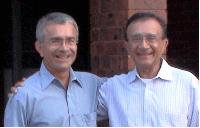 It was in the "Daily News" or "Observer" in the early 1950's when my grand uncle Lynn Barbut died. Lynn's surname was Barbut as distinct from d'With-Barbut, which was started by my grandfather Cecil d'With-Barbut, who was Lynn's only brother. The newspaper article was written by the late S.P.Foenander, a great sportsmen and doyen of sports journalists.
It was in the "Daily News" or "Observer" in the early 1950's when my grand uncle Lynn Barbut died. Lynn's surname was Barbut as distinct from d'With-Barbut, which was started by my grandfather Cecil d'With-Barbut, who was Lynn's only brother. The newspaper article was written by the late S.P.Foenander, a great sportsmen and doyen of sports journalists.
Lynn Barbut - A Fine Left-Hander By S.P Foenander
Lynn Barbut, who passed away last Sunday and whose remains were laid to rest at Kanatte, was one of the greatest left arm bowlers produced by Ceylon. Educated at Wesley College he made his mark in Inter-school cricket first under the captaincy of the late C.E.Perera and later when W.O.Nathanielsz was captain. With his slow medium leg breaks of impeccable length Barbut was a terror in inter school cricket.
In 1899 I happened to be a team mate of his when the Wesley XI beat the redoubtable Colts, C.C. including Tommy Kelaart, W. de Rozayro and W. de Fransz. Barbut took 9 wickets in that game for less than 6 runs each. Barbut bowled most effectively in his three contests with Royal and in 1900 when the Combined Colleges led by the late E.Weerasuriya (Royal) beat the full strength of the famous Colts on the N.C.C. ground it was Barbut, who carried off the prime bowling honours for the school boy team, who included the great D.L. de Saram. I had the honour of playing in that victorious Schools XI of whom only two survive apart from myself, and they are W.O.Nathanielsz and A.C.Amath.
After leaving Wesley Lynn Barbut played with success for the Colts C.C. but after a short while he dropped out of the game having settled in Bandarawela. In recent years ill health reduced his activities but he took a keen interest in the Bandarawela Tennis Club for many years and whenever I visited that town it was a pleasure to meet my old cricket team mate and discuss old times . May the turf lie lightly over him.
S.P.F "
The British left the country 50 years ago. But their summer game cricket is still here, played more enthusiastically by the Lankans than the British.So much so that Sri Lanka became the World Champions in 1996.It was also said that wherever the conquerors planted their Union Jack, the cricket stumps followed suit not long after. Great Britain, as England was more popularly known then, mainly in order to signify her position as a world power (though, officially it comprises England, Scotland and Wales) planted their national flag in 1815, and the Colombo Journal, of 3 November 1832, reports a cricket match where the newly formed Colombo Cricket Club, comprising entirely of expatriate members (a condition for membership that persisted until 1961) were subjected to a trouncing by 10-wickets at the hands of a team drawn from the 97th Regiment of the British Garrison in a match played at the now defunct Sports Club grounds at Galle Face.
So, it was really the British militia that introduced the summer game to the then many-splendoured isle. Early chroniclers however gave most of the credit for the popularisation of cricket to Rev. Brooke Bailey who came to Ceylon as Assistant to the Head Master of the Colombo Academy, now known as Royal College. Though not played on perfectly manicured outfields or properly rolled pitches, the game, it was widely reported, spread to Galle and Kandy and attracted many adherents amongst the British soldiers and the expatriate tea and coffee planters. True, the game was played with great zest, but, it was still not within reach of the ordinary 'native'.
Local cricket chronicler S.P.Foenander, known as the Wisden of the East, records in his authoritative Sixty Years of Ceylon Cricket (1923), about the "splendid pioneering work" done by the tea and coffee planters and of the early matches, beginning from 1870, played at the picturesque Darrawella ground nestling in the hills. These frontiersmen considered it a "trifling task to walk from their totums a distance of 15 to 20 miles to the cricket ground" play the match and return home the following day. The white-controlled Colombo Cricket Club, it was, that administered the game in the country until the formation of the Ceylon Cricket Association in 1922. Ceylon, located ideally midway between the antipodean cricket-playing nations of England and Australia, and whose teams used to pass the island on their tours during the voyage, gave an opportunity for the tourists to "stretch their legs and play a limb-loosener match" here. In 1882, Hon. Ivo Bligh's M.C.C. cricket team bound to Australia, and who was responsible for the birth of the Ashes on that tour, became the first visiting representative to play a match on local soil. The game, played on the 13th and 14th of October 1882, on the Sports Club grounds at Galle Face ended in a draw, though lack of time certainly helping the locals!
Then, Lord Sheffield's team played here 9 years later. Great cricketers from England and Australia including Dr.W.G.Grace, Ranjitsinjhi, Wilfred Rhodes, Sydney Barnes, Archie Maclaren, Lord Harris, Charles Bannerman, Fred Spofforth, Joe Darling, Clem Hill, Warwick Armstrong and, much later, the legendary Don Bradman, are some of the more famous names who have adorned our playing fields. However, it was not until 1882 that the Ceylonese cricketers of native origin crossed swords with their colonial masters. In this historic game Ceylon was led by A.C.Edwards, described as "the old Thomian cricketer," and included in the local side were brothers Harry and Charles Ball of Negombo, Sam Pereira described as a stylish right-hand batsman, Richard de Zylva and W.Rosemalie-Cocq of Galle. The match, played as usual on the Sports Club grounds at Galle Face, ended in a win for the Europeans. But, as S.P Foenander wrote:
"It was not till the Jubilee year, 1887, that the first real contest between the best eleven European cricketers and the picked representatives of the Ceylonese took place. The match caused great interest in Colombo, seeing that two powerful teams had been selected to meet......and settle the question as to whether the Ceylonese cricketers, who had recently been showing improved form with bat and ball were superior to the strongest team of European players."
The Ceylonese team was drawn entirely from the Colombo Colts Cricket club, considered the strongest team in those days, and led by Dr.Edgar de Kretser. The team included, inter alia, Ernest Joseph, brothers Collin and Banda(!) Kelaart, Oswald Van-Hoff, Willie de Fransz, Charles Heyn and Patrick Thomasz. The Europeans comprised players of the calibre of Ashley Walker the former Cambridge Blue and Yorkshire county cricketer, H.C.P.Bell, George Vanderspaar considered the Grand Old Man of Ceylon cricket, F.Stephen, the famous Thomian coach, Charles Gordon, P.C.Oswald et al. Time saved the locals from defeat since the Ceylonese were still 82 runs behind "at the call of time with only a wicket in hand." The annual fixture between the Europeans and the Colts, as the sole representatives of the Ceylonese, continued until 1902. That the Colts enjoyed this monopoly is strange because clubs such as Kalutara C.C. (1873), Galle C.C. (1875), Nondescripts (1888), Bloomfield C. & A.C. (1893), Burgher Recreation Club (1896), Singhalese Sports Club and Tamil Union (1899) were around.
In 1905, began a new chapter in local cricket when a more representative Ceylonese side, led by J.C. McHeyzer beat the Europeans captained by G.H.Gibson by 4 wickets. After a lapse of 5 years, due to the War, and despite the arrival of Somerset county bowler W.T.Greswell, the Ceylonese skippered by D.L.de Saram and having within their ranks members of Colts, N.C.C. & S.S.C., beat the colonials by the comfortable margin of 7 wickets.
Though the Europeans were now fielding English county cricketers such as Greswell (Somerset), Walker (Yorkshire), A.L.Gibson (Essex), H.G.Cornish (Surrey Club & Ground), the locals too had skilful players such as the de Sarams, T.Kelaart, A.C.Amath, J.C.Weinman, D.B. & C.H.Gunasekera, C.E.Perera and others, and got the better by 7 wins to 3, in the 10 encounters between 1905 and 1923.
The inaugural meeting of the Ceylon Cricket Association was held on 13 July 1922 when representatives of all cricket-playing clubs met at the Colombo Cricket Club pavilion with Mr.P.J.Parsons (C.C.C.) in the chair. Member of the Tamil Union and sponsor of the game Dr.John Rockwood was elected the first President, while O.B.Forbes (C.C.C.) and L.E.T.Holsinger (Bloomfield C.& A.C.) were picked as Secretary and Treasurer respectively. It was from this point onwards that the island's cricket took on a proper direction.
Yet, it must be mentioned that, thanks to the pioneering work done by school teacher and English county cricketer, Ashley Walker and a few others, the foundation for a vibrant school cricket system was laid. Walker who came to the island as Assistant to the Head Master of Colombo Academy, now Royal College, Colombo, encouraged the boys at cricket.
So, in 1879 began the historic Royal-Thomian match. An annual encounter which has continued uninterrupted since, and which was described by the respected English writer, radio and TV commentator, Christopher Martin-Jenkins, in the staid Wisden Cricketers' Almanack of 1994 as follows:
"Eton and Harrow at Lord's cannot, these days, hold a candle to what claims to be the oldest school fixture staged without interruption. Nowhere in the world is a school match accorded anything like the same attention. Tickets were more expensive, and in far greater demand, than those for a Test..............Royal and S. Thomas were modelled on the Victorian public schools of England and the game survives in a Henry Newbolt time-warp that is not only charming but also ensures a steady stream of talented cricketers......"
New ground was broken when Dr.C.H.Gunasekera became the first local to play in the English county championship when he represented Middlesex in 1919. F.C. De Saram covered himself with glory when he represented Oxford University (Blues in 1934 & 1935) with distinction and became the only amateur in history to have scored 1000 runs on his first-class debut season (1934) at an average of over 50. In the same year, his brilliant century (128 out of a total of 216, the next highest scorer being D.F.Walker who scored 16) against the touring Australians with Bradman, and led by Bill Woodfull which included a bowling attack of the fearsome leg-spinner Clarrie Grimmett, is still talked of. Ceylon, as a cricketing nation, was raising its head.
But, the journey was just beginning, the journey that culminated on 17 March 1996 when Sri Lanka wore the crown of the World Champions in a type of cricket that took four more decades to emerge. Laddie Outschoorn (Worcestershire 1946-59) carried the torch in the English county championship by becoming the first Ceylonese to play professional cricket in their first-class circuit.
He was soon followed by the likes of Stanley Jayasinghe and Clive Inman (both for Leicestershire) and the last of our countrymen to play in the English county championship, and shine, was Aravinda de Silva. One must also not forget the magnificent contribution made by Gamani Goonesena who played for Nottinghamshire and captained Cambridge University (1957). He not only led them to a convincing win over Oxford University in their annual fixture but also scored a record-breaking double century in the game. Goonesena established many University records and later represented the state of New South Wales (Australia) in the Sheffield Shield tournamen, the only Ceylonese to have played in the first-class domestic tournaments in England and Australia.
However, with due respect to our present cricketers, it must be mentioned that the players, circa 1940 -1970, if given the same opportunities, exposure and the financial incentives, would probably have done even better. Master batsman Mahadeva Sathasivam was, by all accounts, a genius of a batsman. Frank Worrell, the former West Indian skipper publicly announced that if he was to pick a World XI., the first batsman he would pick would be "Sathasivam from Ceylon." Then, there was F.C.de Saram, Sargo Jayawickrema, D.S.Jayasundera, Robert de Kretser, C.I.Gunasekera, Stanley Jayasinghe, Vernon Prins, H.I.K.Fernando, Gamani Goonesena, Makkin Salih, Malcolm Francke, Bob Bartels, Mahes Rodrigo, Channa Gunasekera, Abdul Lafir, Michael Tissera, Ronnie Reid, and quite a few more who could have adorned any Test team.
Surmounting many odds, Sri Lanka were accorded Full Member status of the International Cricket Conference on 21 July 1981, and the first-ever Test, against England, was played at the P.Saravanamuttu stadium, in February 1982. The game where the Sri Lankans, led by Bandula Warnapura, dominated until the last day, was however lost in dramatic fashion at the post.However in 1984, the Sri Lankans outplayed England at Lord's in a sensational display and gave further indication of their undoubted skill when they declared both their innings closed but were unable to force a win. And, it came in 1993 at the S.S.C. grounds when the then unknown Sanath Jayasuriya hammered the first ball he received from England left-arm spinner Phil Tufnell for a six to herald a Sri Lankan win by 5 wickets. The worm had turned.The continuing terrorist war and the consequent economic problems were a drawback for international teams to visit the island. Overseas tours were difficult to obtain due to lack of "marketability" of our players. Yet, the general interest in the game amongst the public was astounding, thanks mainly to television. The game was being played on paddy fields, street corners and any available open spaces. During this period of bombs and mayhem, the only silver lining in the lives of the people is cricket.
The exploits of Aravinda de Silva, Sanath Jayasuriya and Arjuna Ranatunga are on the lips of schoolboys, housewives, pavement hawkers, politicians, business magnates and even religious dignitaries. Cricket is a national pastime as much as soccer is for Brazil. The joy, happiness and the euphoria of Sri Lankans living here and abroad when the World Cup was won in 1996 will never be forgotten.
Today, Sri Lanka as a cricket-playing nation, is a country to be reckoned with. 50 years ago, in 1948, when the Lion flag was hoisted over the island nation and the great Don Bradman's Australian team played a match against Ceylon, the pitch was found to be embarrassingly some two yards short! It was a big laugh for the Australians. Fittingly, it was the Australians that Sri Lanka trounced by 7 wickets in the final of the World Cup on that memorable night of 17 March 1996 at Lahore. Sweet revenge.
Today, the tag of World Champions has given a new identity to Sri Lanka. It is not only due to a bloody senseless conflict nor for the famed Ceylon tea that Sri Lanka is now known.
From this country hails a set of cricketers who play the game in a manner to thrill the cognoscenti and the commoner, and who has brought honour and glory to their native land. A tribute both the cricketers and the people of Sri Lanka will always cherish and will be a landmark in the annals of our history.
Wesley College 2000 1st X1 Soccer Pool.
Prefect of Games : K. De Silva
Master in Charge : H.M.C. De Silva
Coach : P. Sangadasa
Rex William (Capt.) Asanga Gunasinghe (V.Capt)
Dinesh Vitharana
Mohomad Yakoob
Ruzni Raheem
Eshan Gomes
Jude Fernando
Dinesh Kulathunga
Anderio Toussaint
Indika Valu
Asanka Fernando
Pradeep Wickramasinghe
Antonio Susantha
Tuan Zaharan
Aruna Jayasooriya
Udara Jayaweera
Asitha Wickramasinghe
Kishok Kandiah
Mohomad Roshan
Dammika Fernando
Sumesh Fernando
Match Results
Wesley Vs Zahira Lost 1:2
Wesley Vs Royal Lost 3:5
Wesley Vs Mahanama Won 3:1
All Island Schools Milo Trophy
Wesley Vs St’Anthony’s Won 2:0
Wesley Vs Joseph Vas Won 3:1
Wesley Vs D.S. Senanayake Tie 1:1
Wesley Vs St’ Josephs Trinco Won 2:1
Wesley Vs Isipathana Lost 1:2
Wesley Vs De Mazenod Tie 2:2
Wesley Vs Dharmaraja Lost 2:5
Wesley Vs Hindu Lost 1:2
1st X1 SOCCER PAST CAPTAINS
1992 R. Manatunga
1993 M. Raseef
1994 M. Mussadiqe
1995 I.De Silva
1996 A. Thiranagama
1997 A. Kaluthanthri
1998 A. Ali
1999 L.S. Perera
 Capt. Navin de Silva stood tall for Wesley on and off the field. He is a pride of the century-old Campbell Park school. The OWSC members and young and old honoured him by unveiling his photograph at their annual general meeting held at this club house over the weekend. The Principal of Wesley College, M.A.P. Fernando with the newly elected president, Parakrama Wijemanne, unveiled it. “Navin, a legend in waiting for Wesley in the year's to come, led by example on and off the field and richly deserves this honour. He has been a pride of Wesley,” said Mr. Fernando. A diehard Wesleyite he was nursed and nurtured by his parents and later by the school. Navin, has not forgotten his humble beginnings, his parents and his teachers who developed his career on and off the field. With his charming ways, he led by example for others to emulate. He possessed all the ingredients to be a leader.
Capt. Navin de Silva stood tall for Wesley on and off the field. He is a pride of the century-old Campbell Park school. The OWSC members and young and old honoured him by unveiling his photograph at their annual general meeting held at this club house over the weekend. The Principal of Wesley College, M.A.P. Fernando with the newly elected president, Parakrama Wijemanne, unveiled it. “Navin, a legend in waiting for Wesley in the year's to come, led by example on and off the field and richly deserves this honour. He has been a pride of Wesley,” said Mr. Fernando. A diehard Wesleyite he was nursed and nurtured by his parents and later by the school. Navin, has not forgotten his humble beginnings, his parents and his teachers who developed his career on and off the field. With his charming ways, he led by example for others to emulate. He possessed all the ingredients to be a leader.
He captained the school cricket team, led the Sri Lanka Under-19 cricket team to England, which included former Lankan captain Arjuna Ranatunga. Presently he is the youngest Sri Lankan Captain in the National Carrier - SriLankan Airlines.
There is a saying "Higher the money climbs - the more you see his tail'. To Navin there was no tail, but always looked at the bottom line. Humility was his code word.
One doesn't always have to wear one's heart on the sleeve. He worked with understanding with his colleagues, but despite a tight official and personal schedule he still had the time to serve his alma mater. During his tenure as president of OWSC, he proved his leadership qualities off the field to work in unison with other members of the OWSC committee for its re-development. He never hung on to office, but made way for others to continue its good work. But he always joined the scrum.
Being a Buddhist he possessed loving kindness and compassion. Knowing, that everything in life is temporary, he believes in religious harmony and racial amity.
Wesley College clinched the Western Province under 17 rugby title when they defeated giant killers Asoka Maha Vidyalaya Colombo by 39 points to 5 in the final worked off at Thurstan College grounds, yesterday.
The Wesleyites collected their points from two goals and five tries having led 22 nil at half time. Asoka MV who defeated some of the more fancied teams on their way into the final failed to live upto their expectations and managed to score only a solitary try. Wing three quarter Neranjan Wickremaratne planted two tries while centres Yamal Amarathunga, Malin Gimhana, scrum half Samantha Lakshan, prop forward Shiyam Salheem and full back Amal Pathirana scored a try each for the winners. Samantha Lakshan was successful in converting only two tries. Pradeep Fernando refereed (C.D.)
Wesley College will make their first appearance in the current inter school rugby season when they take on Carey College in their Milo under 19 fixture at the Sugathadasa Stadium today.
The Wesleyites have rested as many as six of their senior players for this game in an attempt to give the newcomers a good warm up session. In addition they are also very much concerned about their next outing where they will be up against the traditional rivals Kingswood College for the L. E. Blaze trophy to be played in Kandy.
The Wesleyites certainly do have a tough schedule ahead of them with more important games coming up against Isipatana, Royal, S. Thomas' College Mount Lavinia, Dharmaraja College Kandy, St. Anthony's and the defending Milo League champions St. Peter's College.
Last year they made a spectacular start to the season while recording stunning victories over the more fancied Trinity College (21-0), Dharmaraja College (33-0) and St. Anthony's College (12-8). They also stretched the strong Isipatana outfit to the maximum before going down fighting 3-6 in a thrilling encounter. They eventually came up to the final of the Milo President's trophy knock out tournament before losing to Royal 6-20.
This year the team is captained by flanker Kasun de Silva and the other senior players are number eight Tyronne Harrison, Sri Lanka youth cap Zakir Badurdeen, second row forward Julian Francisco, wingers Naushiki Fariz, Saleem Buckman and Henry Terrence. Carey College who lost to the reigning Milo 'A' division league champions St. Peter's College 5-29 will be hoping for an improved performance.
Wesley College will be hoping to regain the L. E. Blaze Shield after a lapse of six years when they take on traditional rivals Kingswood College Kandy in the first leg of their 18th annual inter school rugby encounter at the newly laid Randles Hill grounds, today.
The Wesleyites recorded their last win in the series way back in 1997 under the captaincy of Anupama Wadugodapitiya. But with a formidable outfit they now have a good chance of pulling off this game and maintain their unbeaten record in the Milo inter school season.
Wesley are vying for honours in the Milo 'A' division league tournament along with Isipatana, Royal, S. Thomas' College Mount Lavinia, Dharmaraja College Kandy, St. Anthony's and the defending Milo League champions St. Peter's College.
Last year they made a spectacular start to the season while recording stunning victories over the more fancied Trinity College (21-0), Dharmaraja College (33-0) and St. Anthony's College (12-8). They also stretched the strong Isipatana outfit to the maximum before going down fighting 3-6 in a thrilling encounter.
This year the team is captained by flanker Kasun de Silva and the other senior players are number eight Tyronne Harrison, Sri Lanka youth cap Zakir Badurdeen, second row forward Julian Francisco, wingers Naushiki Fariz, Saleem Buckman and Henry Terrence. The Kingswoodians will have the home advantage and will be determined to retain the Shield for another year. Last year the first leg ended in a six all draw but the second leg was not played due to unavoidable circumstances.
The Kingswoodians are of course competing in the Milo 'B' division league tournament along with Zahira, Kingswood, St. Sylvester's, Ananda, Thurstan, Vidyartha and St. Joseph's.
The team:
Wesley: Dhanushka Warnasuriya, Kalid Sarfudeen, Ranga Saifa, Damith Perera, Hossein Tuan, Heshan Dissanayake, Dhanushka Ratnayake, Amila Subasinghe, Rukshan Omar and Omar Sarfudeen, Nuwan Samith, Zakir Badurdeen, Neranjan Wickremaratne, Yomal Amarathunga, Yasas Nonis.
Wesley in hard fought 15-8 win over S.Thomas’
Wesley ended a five year wait to beat S.Thomas’ when they recorded a 15-8 victory in a scrappy inter-school rugby fixture at the Sugathadasa Stadium yesterday.
Neither team looked like taking control of the game even though Wesley outscored their opponents by two tries to one. The Wesleyites were a shade better where three quarter play was concerned but there was little to chose when the forwards clashed in the set pieces. This victory marked the second such occasion where Wesley beat S.Thomas’ during the last decade, the last win being in1997.
Winger M.Buckman propelled Wesley into the lead after half time, the scores were deadlocked 3 all at half time, by picking up a lose ball and running through after the Thomian’s lost the ball 15 meters from their own goal line. Zakir Badurdeen proved quite reliable with the spot kicks by adding the extra points.
The Thomians found success during a five meter scrum when scrum half Dinesh Siriwardene took a pass from team mate Namal Rajapakse over the Wesley goal line. This try went unconverted by Azwan Thajudeen who earlier put over a penalty for S.Thomas’. Wesley sealed the game with a try during injury time when number eight Tyronne Harrison collected a clearence kick by a Thomian and scored. The try went unconverted.
Wesley College ran circles around Royal yesterday to halt the high-riding home team's unbeaten run this season by 22 points (penalty try, 2 goals and a try) to 18 (a penalty and three tries) at the home team grounds yesterday.
The final thin margin of victory is no indication of the fiery domination the Wesleyites from Campbell Place had over a Royal outfit that had basked before in the sun of an `achilees heel' at the end of the day.
But yesterday, it was not to be. Royal's heels failed in the face of the thundering onslaught dished out by a bunch of blue jersied terriers whose skipper, flanker Kasun de Silva it was a dream come true. "It was as a member of the under-15 team in 2000 that we Wesleyites built a strong first fifteen outfit to beat Royal," voiced the jubilant captain, a fourth year.
From the moment wing three-quarter Nuski Fareez fired a penalty try in the early minutes, it was a different ball game. Royal's customary rallying force wilted before some fleet footed passes by the Wesleyites. On the stroke of 'lemons' Royal sounded the boards from a Bahurdeen penalty to trail 3-7.
The jinxing of the more formidable Royalists heightened a schools' season of fluctuating fortunes. The metallic sounds of drums and music from strumming bands firing the imagination as fly half Rukshan Omar, wing three-quarter Niranjan Wijesinghe and full-back Yasas added dimension touching down. Royal could only reduce the deficit to 14-8 through a try from Danushka Rajapakse, but Wesley's pack was far superior enabling their try machinery to click.
The three unconverted tries, the second from Varun Wijewardene and third from skipper Rajiv Jayasundera, was also costly with Royal's place kicker failing to oblige for the second successive week.
Antonians stun Wesley
St. Anthony's College Kandy delivered a stunning blow as they brought down the high riding Wesley outfit by 11 points to 8 in their Milo Schools 'A' division league rugby encounter played at the Sugathadasa Stadium on Thursday.
The winners collected their points from one try and two penalties while Wesley responded with a try and a penalty. St. Anthony's led 11-3 at half time.
The Antonians took the initiative and were leading 3 nil after the first minute of play with full back Sumal Wijesekera converting a good penalty. But the Wesleyites came back and levelled the scores in the fifth minute of play through a penalty from Yasas Nonis.
The game turned into a forwards battle from thereonwards with the Wesleyites beginning to dictate terms through their heavy pack. They forced a couple of crucial line outs inside the Antonian '25' and came closer of scoring at least on two occasions.
But St. Anthony's brought play back into the Wesley territory with some intelligent play while adding tremendous pressure on the opposition. They succeeded in penetrating the Wesley defence shortly before half time with Nuwan Chaturanga going over for a superb try. Sumal Wijesekera missed the conversion but almost immediately he fired across another penalty to give the Antonians a 11-3 lead at half time.
Wesley launched a fine late rally in the second half to score their first try through scrum half Rukshan. But they missed the important conversion and the Antonians held on to their slender lead and went onto register a memorable victory at the end. (C.D).
In the early days the Wesleyites were not a big name in the schools rugby arena. Though brushing shoulders with stronger schools they were in the losing side in most of the matches they played. But ocassionally the school has produced national players, some of the names that come to mind are Reginald Bartholomeuz who was an outstanding player and Iqbal Musafer. Both of them played for the CR & FC.
The Wesleyites have only tasted victory against Isipatana on one occasion when they defeated them in a thriller in 1963. But in the past they have always been losers against two other schools Trinity and Royal. But last year they acheived one under the leadership of Lahiru Boteju when they defeated Trinity convincingly 21-0. This year they acheived the other when they overcame Royal 22-18. Last year they also qualified through to the finals of the President's Trophy for the first time in the history but lost to Royal.
Today they are a side to be reckoned with, packed with robust type rugby players and guided by that young coach Dishantha Priyadharshana who in fact has been training them since he was their junior coach a few years ago before he took over the senior side from last year. He knows the players like his finger tips and is gifted with boys who are dedicated and determined and cooperative. The team had a successful season last year and the present players are continuing the good work though losing some of their key players.
This year the Wesleyites made a big impact in the ongoing inter-schools rugby season with their tough approach. They started the season with a bang defeating Carey 29-7 but received a shock when they were brought down by Kingswood 17-7. Then they gave the Isipathanians a torrid time before going down 20-15. In the next game against S. Thomas' they came back to overcome them by 15-8.
But the icing on the cake for the Wesleyites came when they put up an extraordinary display to completely outplay the reigning schools rugby champs St Peter's 19-13. Then they showed the win against the Petes was just not a flash in the pan or a fluke when they completely outclassed Royal 22-18 in the Royalists own den. From then on the Wesleyites became a much feared outfit to confront with.
They rose to the position of becoming one of the contenders for the schools title this year. But the Antonians match which was their next assignment, had many hopes for the Campbell Park boys supporters . A win here would have put them a few distance away of acheiving this target. But the Antonians made this ambition a bit tougher for the Wesleyites when they inflicted a narrow 11-8 defeat on them.
Nevertheless credit cannot be taken away from the Wesleyites, they put up a superb display of rugby and in the match against the Antonians they would have realised that if there was a reliable place kicker the game would have been definitely theirs. The Wesleyites dominated for the most part of the second half and the only thing they did was not score.
Led by fourth year player Kasun de Silva a player who represented the junior national side on a tour to Hong Kong for the Asiad Cup, with another fourth year player and national junior player Zakir Badurdeen as his deputy they have been a much talked about side this year. The boys are being backed by the Principal M.A.P. Fernando and the old boys being provided with all the support and facilities needed for them.
The boys combine well and that has been the secret for their success.
Second year player Amila Subasinghe has been doing a wonderful job as one of props along with freshers Dhanushka Warnasuriya and Henry Terrence taking turns when the occasion arises. Third year player and hooker Khalid Sharifooden has so far given his share in all the matches the team has played. The two second rows third year players Julian Fransisco and Dhanusha Perera with third year player Tyronne Harrison manning the most important No 8 position.
The side has two experienced flankers with skipper Kasun de Silva manning one and Heshan Dissanayke being the other. Deputy skipper Zakir Badurdeen and third year player Nuwan Samith are the two centres. Another third year player Rukshan Omar operates from the base of the scrum and will pair off with Omar Sharifoodeen who is the fly half with Naushki Fareez and Saliman being the two wingers. The last line of defence is manned by fresher Yasas Nonis who needs a little more exposure but has so far not let the side down.
There are a host of players in Niranjan Wickramaratne who excelled in the Under 17 team this year. He has played in a few games for the senior team this season. WithTuan Ossen, Samantha Lakshan, Damith Perera, Yomal Amaratunge, Nilushan Karunanayake and Shiham Saliheen who could come in as replacements if there is any injury.
With the league season at its tail end the Wesleyites have performed excellently well and have not let down their supporters upto now. But watch out there is the President's Trophy to be fought out in the near future and don’t be surprised if they come out victors. They have the ammunition to shoot down any team.
27th July 2003
Royal clinched the Milo league trophy for 2003 when they beat Guneratne trophy rivals S.Thomas’ 17-6 in their final league fixture for the season at Havelock Park last Saturday.The lads from Reid Avenue only needed to score a solitary try to draw clear of closest contenders for the league title Wesley and they achieved their task comfortably at the park day over the weekend.
Royal led by Sri Lanka test cap and centre Rajith Jayasundere won five matches and lost only to Wesley in the Division 1 A group of the Milo league inter school rugby season. They also scored 17 tries in the process.
Wesley ended the schools league season as runners up.
Wesley College all Rounder and Cricket Captain Farveez Mahroof has been awarded an UK Scholarship to Play Cricket in England this summer.
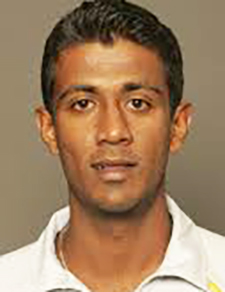 Farveez, who Captained Wesley Cricket Team in two successive season 2002 and 2003 (a very rare achievement). Farveez also, Vice Captained the Sri Lanka under 19 tours of Uk and New Zealand 2000/2002. Both these tours were successful for Farveez.During the England Under 19 tour of Sri Lanka 2003 he had the honour of recording a hundred and also, did well with the ball.
Farveez, who Captained Wesley Cricket Team in two successive season 2002 and 2003 (a very rare achievement). Farveez also, Vice Captained the Sri Lanka under 19 tours of Uk and New Zealand 2000/2002. Both these tours were successful for Farveez.During the England Under 19 tour of Sri Lanka 2003 he had the honour of recording a hundred and also, did well with the ball.
The lanky all rounder now plays for Stanmore CC and has already scored two hundreds and four half centuries and also has a good haul of wickets. The Stanmore President and the Club Captain are full of praise for Farveez.
Sri Lanka Cricket board officials have predicted that he will be playing for Sr lanka as an all rounder for Sri Lanka very soon.
Wesley OBU (UK) keeps a keen eye on Fraveez and attends to his needs. The OBU has already provided financial help towards his keep whilst in England.Recently the OBU presented to Farveez cricket equipments and have had talks with the representative of the Sr Lanka board UK to assist in funding a Cricket coaching session in the UK.
Farveez, also represented the Wesley OBU UK at the recently concluded Festival of Cricket 2003 at Shenley and did quite well.
The Wesley College OBU UK was very happy to receive the News from Colombo that Fraveez Mahroof has been voted the Schoolboy Cricketer of the year 2003.
A great honour for our Alma Mater.
A great trier Farveez Maharoof won Observer top cricket award in 2003 By Leslie Fernando
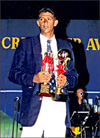 CRICKET: The 23-year-old Sri Lanka allrounder Mohamed Farveez Maharoof who is presently playing for Delhi Dare Devils team in the Indian Premier League cricket tournament was the winner of the Observer, Schoolboy Cricketer of the Year Award in 2003.Former wesleyite Maharoof, won the Schoolboy Cricketer of the Year Award 2003 and was also picked as the Best Batsman All-Island and also figured prominently in the final round of the Best Bowler, Best Allrounder and Best Captain awards.
CRICKET: The 23-year-old Sri Lanka allrounder Mohamed Farveez Maharoof who is presently playing for Delhi Dare Devils team in the Indian Premier League cricket tournament was the winner of the Observer, Schoolboy Cricketer of the Year Award in 2003.Former wesleyite Maharoof, won the Schoolboy Cricketer of the Year Award 2003 and was also picked as the Best Batsman All-Island and also figured prominently in the final round of the Best Bowler, Best Allrounder and Best Captain awards.
He was picked for the top award in school cricket by the panel of umpires from three associations - Association of Cricket Umpires and Scorers, Sri Lanka, Central Province Cricket Umpires Association and Southern Province Cricket Umpires Association.Maharoof showed early promise as a cricketer and he had many fine knocks with the bat and claimed many wickets with his bowling in inter-school cricket matches. The climb to the top in inter-school cricket was sharp and it was no surprise that the judges in the Observer Schoolboy Cricketer of the Year Contest picked him for the top honour.
 Farveez Maharoof born on 7th September 1984, is a right-hand bat and right-arm fast medium bowler. He played for Wesley College from the young age of 11 years at junior level under-13, under-17 and the first XI with distinction.Maharoof, the 1st eleven captain of Wesley in 2001 and 2002, established a fine record of scoring a double century (243 not out) against Richmond in 2002 at the Galle International Cricket Stadium. None of the past Wesley cricketers have achieved this feat.
Farveez Maharoof born on 7th September 1984, is a right-hand bat and right-arm fast medium bowler. He played for Wesley College from the young age of 11 years at junior level under-13, under-17 and the first XI with distinction.Maharoof, the 1st eleven captain of Wesley in 2001 and 2002, established a fine record of scoring a double century (243 not out) against Richmond in 2002 at the Galle International Cricket Stadium. None of the past Wesley cricketers have achieved this feat.
Good bat
He has represented Sri Lanka Schools under-19 side against the visiting England Academy side in 2003 and slammed a quick-fire century (100) off 99 balls. He was also in the Development Cricket Squad run by the BCCSL. He had the distinction of playing for the BCCSL Board XI led by Romesh Kaluwitharana against the New Zealanders in 2003 and scored 22 runs and he claimed the wickets of Kiwi skipper Stephen Fleming and Scot Styris.
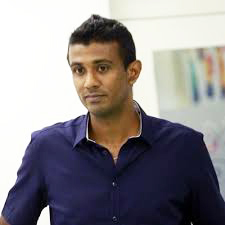 Maharoof had a good run in England, playing for Stanmore in the Middlesex County League. He figured prominently with the bat and ball, scoring heavily and capturing wickets. He has been a great asset to Stanmore who became Ladbrokes Middlesex County League Champions for the second time. For his excellent performances for Stanmore, the Australian coach of Middlesex invited Maharoof to play for the Middlesex 2nd XI.In the 2003 inter-school cricket season, he scored 845 runs which included two centuries against Ananda (146) and Nalanda (106 not out) and five half centuries. He has also bagged 42 wickets with 5 for 56 against Ananda as his best effort. He also played a few games for CCC in the under 23 tournament.
Maharoof had a good run in England, playing for Stanmore in the Middlesex County League. He figured prominently with the bat and ball, scoring heavily and capturing wickets. He has been a great asset to Stanmore who became Ladbrokes Middlesex County League Champions for the second time. For his excellent performances for Stanmore, the Australian coach of Middlesex invited Maharoof to play for the Middlesex 2nd XI.In the 2003 inter-school cricket season, he scored 845 runs which included two centuries against Ananda (146) and Nalanda (106 not out) and five half centuries. He has also bagged 42 wickets with 5 for 56 against Ananda as his best effort. He also played a few games for CCC in the under 23 tournament.
At Wesley, he was also bright in studies an ‘A’ Level student. His father Hassan Mohamed who was also a good sportsman during his younger days representing the CMC Community Centre and Playgrounds. So, young Maharoof got all the support from his father. He started club cricket in a big way, turning out for Bloomfield and proved his allround capabilities in most of the Premier League matches. Maharoof is a promising new allrounder in the Sri Lanka team. He first made his impression in the under-19 World Cup in Bangladesh where he captained the Sri Lanka team. He enjoyed a prolific school career for Wesley College with a highest score of 243 and best bowling figures of 8 for 20.
Sound technique
Maharoof has a sound batting technique and is able to adopt to different conditions. He is wellknown as a player who can score runs down the order but he is also capable of playing patiently when in tight situations.
Maharoof’s Test match bowling figures (24 wickets at an average of 60.75) do not show his natural talent as sometimes he is underbowled. This was amply seen in the third Test between England and Sri Lanka in 2006 when he did not bowl in the entire match. In the qualifying round of the 2006 International Cricket Council Champions Trophy, Maharoof had the best bowling figures in the history of the tournament - 6 wickets for 14 runs which is also the 9th best analysis in all one-day international matches. That was against the defending champions West Indies and it was Maharoof’s first five-wicket haul in ODI’s. Maharoof took 4 for 23 against Bermuda to start the 2007 World Cup and became the first Sri Lankan to take a 4 wicket haul on his World Cup debut. He also took his 100th wicket in his 75th one-day International, becoming the fastest Sri Lankan to reach that landmark, beating Muttiah Muralitharan by one match.
Maharoof out of West Indies tour
Farveez Maharoof, the Sri Lankan allrounder was ruled out of the West Indies tour recently with a side strain. He suffered the injury during the recently concluded CB Series in Australia, but was named in the 15-member Test squad for the two matches against West Indies. Selection Committee sources stated that Maharoof had failed to recover sufficiently from the injury and had to miss the tour. Left-arm fast bowler Chanaka Welegedera who toured Australia for the CB Series but did not play a single match due to a technical problem with his follow through, where he was warned for running on the pitch, was the replacement for Maharoof for West Indies tour.
In Indian League
Maharoof recovered from the side strain and presently is in India representing Dare Devils, Indian Premier League team of New Delhi.Altogether Maharoof has played in 20 Tests, scoring 538 runs, batting average 19.92. He had three half-centuries and top score of 72. He took 24 wickets after bowling 2,628 balls, best bowling - 4 for 52 and he has taken 6 catches. He played 75 one-day internationals and scored 751 runs at an average of 19.96. He has two half-centuries, highest unbeaten 69. In bowling, took 100 wickets, sending down 3,075 balls, average of 23.88, best bowling figures 6 for 14 and held 16 catches. At a recent meeting, Maharoof said that the Observer Schoolboy Cricketer of the Year Contest gave him all the encouragement to forge ahead in the cricket world.
Schoolboy cricketers he said should be encouraged a lot and the results will follow.
By A. C. DE SILVA and LESLIE FERNANDO
Farveez Maharoof of Wesley College is the OBSERVER-BATA Schoolboy Cricketer of the Year 2003. He was picked for the top award in school cricket by the panel of umpires from three associations-Association of Cricket Umpires and Scorers, Sri Lanka, Central Province Cricket Umpires' Association and Southern Province Cricket Umpires' Association at Galadari Meridien Hotel.
The awards ceremony will be on August 29 at 6 pm at the BMICH.
Besides winning the prestigious award, Maharoof who is presently playing for Stanmore in the County League in England (Stanmore Middlesex County League Champions) was also picked as the Best Batsman All-Island and also figured prominently in the final round of the Best Bowler, Best Allrounder and Best Captain awards.
While Wesleyite allrounder Farveez Maharoof won the Schoolboy Cricketer of the Year award President's College Kotte's Chinthaka Rasanga Perera was picked OBSERVER-BATA Outstation Schoolboy Cricketer of the Year 2003.
Farveez Maharoof, the Schoolboy Cricketer of the Year has played for Wesley College from tender age of II years. He has captained the school under-13, under-15, under-17 and the first XI with distinction.
Maharoof, the 1st eleven captain of Wesley in 2001 and 2002 established fine record of scoring a double century 243 not out against Richmond in 2002 at the Galle International Cricket Stadium. None of the past Wesley cricketers have achieved this feat. He has represented Sri lanka Schools under-19 side against the visiting England Academy side this year and slammed a quick-fire century (100) off 99 balls. He is also in the Development Cricket Squad run by the BCCSL. He also had the distinction of playing for the BCCSL Board XI led by Romesh Kaluwitharana against the New Zealanders this year and scored 22 runs and he acclaimed the wickets of Kiwi skipper Stephen Flemming and Scot Styris.
Maharoof is having a good run in England, playing for Stanmore in the Middlesex County League. He has figured prominently with the bat and ball, scoring heavily and capturing wickets. He has been a great asset to Stanmore who would be Ladbrokes Middlesex County League Champions for the second year.
For his excellent performances for Stanmore, the Assistant Coach of Middlesex has invited Maharoof to play for the Middlesex 2nd XI.
This season he scored 845 runs which included two centuries against Ananda 146 and Nalanda 106 not out and five half centuries. He has also bagged 42 wickets with 5 for 56 against Ananda as his best effort. He also played a few games for CCC in the under 23 tournament.
Maharoof, an 'A' Level student will continue his studies and play cricket said his father Hassan Mohamed who was also a good sportsman during his younger days, representing the CMC Community Centre and Playgrounds.
Benedictine Jeremy Saverymuttupulle is the Best Bowler and Nuwan Perera of St. Sebastian's College is the Best Allrounder. He was also picked as runner-up to Wesleyite Farveez Maharoof for the big award. Thomian wicketkeeper Kaushal Silva was picked as the Best Fielder.
The Best Team All-Island St. Sebastian's College, Moratuwa and they win the award for the first time. Manjula Silva of St. Sebastian's College is the Best Captain.
In the Outstation Contest, Chinthaka Rasanga Perera of President's College, Kotte besides winning the 'plum' of outstation cricket he was also picked as the Best Bowler and best Allrounder. He is a fine right-arm 'pacie' and has captured 81 wickets for the season. His best was 14 for 142 against Lumbini MV (match bag).
He has a very impressive bowling feat, having the following figures: 7 for 166 against De Mazenod College, 6 for 139 against Kalutara Vidyalaya, 8 for 62 against St. Aloysius Ratnapura, 8 for 148 against Raddoluwa MV, 12 for 100 against Royal Panadura, 5 for 79 against St. Anthony's College Wattala, 10 for 138 against Gurukula MV and 10 for 110 against St. John's Panadura.
Chinthaka is also a capable batsman, scoring 350 runs, the best individual score 75 against Gurukula MV.
He started his cricket career at Dehiwala MMV and captained the team 2000 and later joined President's College, Kotte and gave off his best in all departments of the game.
He was a member of the Sri Lanka under-19 team which played against England Academy team this year. He is also in the under-19 squad which is coached by Ruwan Kalpage. He also plays for Chilaw Marians in the BCCSL under-23 tournament.
The Best Batsman Outstation is M. C. Kuruppu of Siri Piyaratana MV Padukka. The Best Fielder C. Kodituwakku of President's College, Kotte.
Earlier, Yasith Mihiranga Maithripala of D. S. Senanayake College was voted in as the Most Popular Schoolboy Cricketer of the Year. Jayathu Neelaweera of Sri Sumangala Panadura was the Most Popular Outstation Schoolboy Cricketer of the Year.
Farveez to lead Sri Lanka under 19 team 30/7/03
The Pakistan Under 19 cricket team will make a tour of Sri Lanka this month. According to a release issued by the Board of Control for Cricket in Sri Lanka the Pakistan side will be coached by Aaqib Javed. The Sri Lanka team will be led by Farveez Mahroof. Former Wesley College captain Farveez Maharoof will lead Sri Lanka under 19 in the series against the touring Pakistan under 19 side next month.
Mahroof an outstanding cricketer produced by Wesley was recently picked the Observer Schoolboy Cricketer of the Year.
By M. Shamil Amit
 One of the most outstanding cricketers to have come out from Wesley in recent times, 19 year old Farveez Mahroof is to be felicitiated by the school and the OBU of Wesley on August 16 2003 at the Old Wesleyites Sports Club (OWSC). This was revealed by the Principal of Wesley M.A.P. Fernando at a press conference held at the OWSC on Friday.
One of the most outstanding cricketers to have come out from Wesley in recent times, 19 year old Farveez Mahroof is to be felicitiated by the school and the OBU of Wesley on August 16 2003 at the Old Wesleyites Sports Club (OWSC). This was revealed by the Principal of Wesley M.A.P. Fernando at a press conference held at the OWSC on Friday.
Farveez who has been selected as the captain of the Under 19 national team for the forthcoming series against the visiting Pakistan Under 19 teams is regarded as the most successful player in the school crixket arena for the last two seasons. He started his cricketing career at a tender age, making his first appearence in the year 1995 when he represented the Under 13 team.
From there he never looked back and went on to lead the Under 13, 15, 17 and the Under 19 team. He captained the senior team for two years in 2002 and 2003. His first mentor was Russel Hamer who is a Old Wesleyite and a former Sri Lanka wicket keeper. Incidentally Farveez established a new record last year when he cracked a swashbuckling 243 not out against Richmond at the Galle International Cricket Grounds eclipsing Mervyn Hamer's (Russel's brother) record of 233 n.o. against Kingswood. This is the highest scored by a Wesleyite.
Apart from him representing his school, Farveez has played for the national team at all levels. In the year 2000 he went on a tour with Under 15 team to Malaysia for the Asia Cup. The same year he was the deputy skipper of the Under 15 national team that went to England for the junior world cup. In 2001 he was a member of the Under 17 national team that went to Bangladesh for the Asia Cup.
The same year he was a member of the Under 19 team that toured Pakistan. In the year 2002 he was a member of the Under 19 team that participated in the World Cup held in New Zealand. Early this year he captained the Under 19 national team that toured Pakistan. He was also the captain of the Under 19 team for the Under 19 Tri Nation series played in Sri Lanka this year.
His performances was rewarded when he was selected for a six month contract to England which was offered by the BCCSL for the most outstanding schoolboy cricketer and he was selected to play for the Stanmore Cricket Club of Middlesex County. He made a name for himself in England with headlines in one newspaper in England giving the headline " Stanmore leading the way thanks to Mahroof magic.
But of all the best reward he got was when he was selected as the Schoolboy Cricketer of the year and the Best Batsman of the year 2003. With his selection as the captain of the Under 19 national Farveez was compelled to cut short his contract with Stanmore CC at the request of a letter sent by the BCCSL. Farveez is the second player from Wesley to be selected as the Best Schoolboy Cricketer. The first being Darrel Maye in the year 1963 which was the Lifebuoy award at that time. They will also be felicitating the rugby team of 2002 which was captained by Lahiru Boteju.
By Peter Christie Casie Chitty
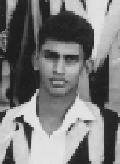 Darrell Maye I will remember as one of the best all rounders I ever played with. He was the vice captain of 1963 Wesley side acclaimed as the Best School's team and that was one team that carried no 'passengers'. The team was brilliant all round when they were batting, bowling or fielding. The two third term games Thurstan and Prince of Wales, were played without a fuss. The only blemish being that Darrell Maye for hooked
Darrell Maye I will remember as one of the best all rounders I ever played with. He was the vice captain of 1963 Wesley side acclaimed as the Best School's team and that was one team that carried no 'passengers'. The team was brilliant all round when they were batting, bowling or fielding. The two third term games Thurstan and Prince of Wales, were played without a fuss. The only blemish being that Darrell Maye for hooked
for a six by a pint sized fifteen year old who was not impressed by quick bowling. POW 's wicket keeper Srinath Silva was the beginning of a long traditional line of wicketkeeper batsmen from Moratuwa.Today we have Romesh Kaluwitharana continuing to show that
Moratuwa feeds Sri Lanka with wicket keepers.
Owen Mottau and Kingswood were finished by Darrell Maye and Evararde Schoorman in ten minutes less that a day. That is still a all schools' record.Maye's bowling return was 6 for 32 and Mottau who had been on song for three years was bowled out cheaply and twice through the gate. Darrell Maye bowled brilliantly and Wesley seemed to continue their excellent performances from the previous year where the defeated the
 invincible Royalists and Darrell Lieversz. The condescending Daily News headline
invincible Royalists and Darrell Lieversz. The condescending Daily News headline
for the preview was 'Lieversz versus Wesley", remember? The Wesleyites under Milroy Mutuvaloe seemed determined to rewrite the record books from then on. St.Peter's with the excellent all-rounder David Heyn and all their big names including Travis Fernando and Tyronne LeMercier (two of the best left arm spinners in Ceylon at the time) at Campbell Park.
Two incidents marked the match. Peterite David Heyn's petulance at an umpiring decision that earned him a bad reputation and Milroy Jebarajah walking off after the umpire refused an appeal for caught behind. Jebarajah won a bat for his sporting spirit. Maye did well with the bat getting 88 runs in quick time.Then the ball he got opener Christopher Harridge, was a beauty even Denis Lillie would have been proud of. Harridge a left hander shouldered arms to a ball outside the off stump, that changed direction off the seam and uprooted middle and leg stumps Wesley's graveyard is Mount Lavinia, but in 1961 the Thomians had their backs to the wall. In 1963 Randy Morel and the Blue and Blacks fared no better. A tail enders partnership saved the Thomians from humiliation. Baacha Fuard, brother of Ace off spinnerr Abu tormented the Thomians withhis flighted off breaks and finished with 6 for 55;
 Royal College had Vijaya Malalasekera and a battery of batsmen and on the first day Wesley had got the better of the Royalists and were better off on a placid wicket and the match heading for a draw. It did in the end. The Josephians came to Campbell Park with skipper Brian Perumal burning to avenge the defeat after the Wesleyites rendered after a run chase the year before at Darley Road. Not to be. They were skittled out for 68. Skipper Mutuvaloe, who bowled only when necessary returned the incredible figures of 3 for 0.
Royal College had Vijaya Malalasekera and a battery of batsmen and on the first day Wesley had got the better of the Royalists and were better off on a placid wicket and the match heading for a draw. It did in the end. The Josephians came to Campbell Park with skipper Brian Perumal burning to avenge the defeat after the Wesleyites rendered after a run chase the year before at Darley Road. Not to be. They were skittled out for 68. Skipper Mutuvaloe, who bowled only when necessary returned the incredible figures of 3 for 0.
The Darley Road boys fired back and put on an impressive 250 plus, with Placidus Liyanage their wicket keeper holding his side together. Then Brian Perumal returned with the vengeance in heart and body and Wesley were rescued by Clifford Rodrigo and the late Rodney Perera from a preposterous 28 for 7 to safety at close with 58 for 7. St.Josephs would have to wait for many years to get that revenge. Trinity under Sunil.M. Perera made a big score. Wesley followed suit and the match ended in a draw. Rodney Perera showed that he was also a batsmen for the bad occasions and steadied the inning with a carefully compiled 80.
The Rag Dinner was at Ward Street's Chinese, but the freshers could only eat the ice cream. They had tucked into the chicken buriyani at Trinity so that everyone else was wearing new shirts on Tuesday at school. Darrell Maye skipper the team in Galle, because of a leak in the Chemistry paper and Richmond were finished off before lunch on the second day. One of the Richmondites suffered a broken elbow. Hit by a Darrel Maye snorter. William Deutron made a comeback in the side after a studious three months and was almost run over by the Galle Colombo train, trying to check the train's speed Bacha Fuard got stranded halfway up a coconut tree, in a sarong that loosened it hold around his waist, William Deutron got Vintogene applied in a very sensitive place and had to run around the campus trying to cool off.
The Richmond principal paid a surprise visit to the dormitory and did not thing much of the team's discipline of course someone was singing a rugby song. To make him happy we sang the Collegesong after dinner at his residence and that made his dog howl. So he reported us anyway. Spoilsport. What bugged him most was that Deutron rang a bell that wakes up everyone on Richmond hill. And his dog howled. Mutu got the skipper's hundred in the last match against Ananda despite the Anandian having three men on the cover boundary. Who said he could not cut? Mervyn Hamer, Chandran Perera, Sarath 'monkey' Wickremaratne,Lal Fernando, M.G.M.Fahlih Evorade Schoorman Bacha Fuard, C.T.Rodrigo,Milroy Jebaraja, Donald Thurairatnam and I stood in the photograph with Darrell Maye, Milroy Muthuvaloe, Edmund Dissanayake and Henry Van Buuren a former Wesley skipper who was our coach. I was proud of it then and I will always be proud of that team. Only two victories and six draws, but they were always in a hurry to win. Cricket was a pleasure to watch then by the crowds of people the came to watch a school match.
 At a very informal gathering of past Wesleyites, cricketer Farveez Maharoof and the first fifteen rugby team were felicitated by Wesley College, the Parent-Teacher Association (PTA), the Welfare Society and the Old Wesleyites Sports Club (OWSC) in a joint venture on Saturday at the OWSC.
At a very informal gathering of past Wesleyites, cricketer Farveez Maharoof and the first fifteen rugby team were felicitated by Wesley College, the Parent-Teacher Association (PTA), the Welfare Society and the Old Wesleyites Sports Club (OWSC) in a joint venture on Saturday at the OWSC.
Those who were given the opportunity to speak that evening spelled out the deeds of Maharoof in glowing terms, from the time he started to wield the willow. Among them were the Principal of Wesley College M.A.P. Fernando, Sri Lanka's first Test captain Bandula Warnapura, who was one-time coach of Maharoof and Captain Navin de Silva, a former Wesley captain.
Tracing Maharoof's cricket career, principal Fernando said that he had captained the school at every age group from under 13 to first eleven and having made it to the first team at the tender age of 14, he still had a year of cricket with Wesley till March next year.
Fernando said that Maharoof had brought honour and glory to the school by becoming the first Wesley schoolboy cricketer of the year for 40 years and the first Wesleyite to captain a national under 19 side after 23 years. Darrell Maye was the first Wesleyite to become schoolboy cricketer of the year way back in 1963 and Capt. Navin de Silva led the Sri Lanka under 19 team to England in 1980.
Warnapura, who was Maharoof's second coach at school after Russel Hamer, said that he saw a huge difference in confidence in the boy after he had gone on a scholarship to England where he made it to the Middlesex Second XI team. Warnapura said the confidence was borne by the manner in which he reached his century against Pakistan under 19 that same day - with a six. He said that Maharoof will enter the Max Cricket Academy next year where he should further his cricketing knowledge and skills.
Warnapura also cautioned the boy and told him not to forget his past and what he had achieved so far in cricket was only just the beginning of what was going to be a hard road to success.
"There will be success and disappointments along the way. You should be strong enough to take both if you are to make it to the top," said Warnapura. He also warned him not to get carried away too much by the money he would earn from playing cricket, but to spend it wisely.
On the same lines, Capt de Silva reminded Maharoof that he was at the beginning of a long and professional career and the path to success was not going to be an easy one. He also reminded him not to forget his alma mater and that he should one day come back and give something in return to the school.
"Forgetting your old school is like forgetting your own parents," said de Silva. He said everyone present that evening would long to see the day when Maharoof will represent his country at Test cricket and captain his country to win the World Cup.
Maharoof was presented a gift voucher by Prefect of Games Kenneth de Silva on behalf of the school, the PTA, the Welfare Society and the OWSC to purchase sports equipment of his choice.
In return, Maharoof thanked the principal, his teachers, the three coaches who had shaped his career so far, namely Hamer, Warnapura and current coach Neil Rajapakse and everyone present, for taking the trouble to felicitate him and promised to do his best for his school and his country.
The Wesley first XV rugby players were also honoured at this function and were presented with a cash donation of Rs. 10,000 by a former Wesley rugby captain Vinod Joseph who had promised them the sum if they beat Royal. Joseph who is domiciled abroad sent the donation through another old Wesleyite Asgerally Mohideen to be presented to the team.
Wesley ended runner-up in the schools league and were losing semi-finalists in the knockout. After initial disappointments Wesley rugby has produced outstanding results under coach Priyadarshana. The secret of their success is that the team has been playing together since the under-13 age group.
Principal Fernando said that the school would present the entire first fifteen squad with tracksuits in recognition of their achievements.
 The horn rimmed spectacles Edmund Dissanayake wore, were a familiar feature at cricket practice on Campbell Park from the mid fifties. What he looked like when he played and captained Wesley in the late forties, is not for me to tell, but I daresay I was not impressed by anyone of cricket coaches before or ever since. When the former Sri Lankan cricket Arjuna Ranatunga forthrightly said that Dav Whatmore only fine tunes Sri Lanka's cricketers, he said a mouthful that has been described as unpleasant and ungrateful by those who do not know the rudiments of the game. While I endorse what he said, I give Edmond Dissanayake affectionately known as 'Pigeon' as an example of the man who towered above every coach Wesley ever had including the brilliant tactician B.J.H.Bahar (1959 to 1962).
The horn rimmed spectacles Edmund Dissanayake wore, were a familiar feature at cricket practice on Campbell Park from the mid fifties. What he looked like when he played and captained Wesley in the late forties, is not for me to tell, but I daresay I was not impressed by anyone of cricket coaches before or ever since. When the former Sri Lankan cricket Arjuna Ranatunga forthrightly said that Dav Whatmore only fine tunes Sri Lanka's cricketers, he said a mouthful that has been described as unpleasant and ungrateful by those who do not know the rudiments of the game. While I endorse what he said, I give Edmond Dissanayake affectionately known as 'Pigeon' as an example of the man who towered above every coach Wesley ever had including the brilliant tactician B.J.H.Bahar (1959 to 1962).
The reason is that like Whatmore, Bahar had only to fine tune Edmund's under sixteeners. Journalist Alban V. Fernando did Wesley proud with J.Fred .De Mel (former head master and father in law of 'Laffa' Fernando) protégés and Wesley's grandiose teams of the 1950's more than impressed. Edmond took over from Mr.De Mel and the batsmen went through their paces learning much about correctness of technique. After all was Edmond not one of De Mel's students? In some cases we saw players like Errol Ronnie Smith change stances, crouch to see the ball better and make big scores. Errol would have played international cricket if he did not decide to migrate to Australia.
 Was Darell Maye not one of the leading allrounders as were Milroy Mutuvaloe, Sarath Wickremaratne, C.T.Rodrigo, Everad Schoorman , the Hamers Russell, Mervyn and Granville. Gangling Wille Deutrom was an under estimated allrounder playing in a team that had no rudder. Everyone of these cricketers were coached by Edmund Dissanayake for at least an year at Under Sixteen level Brian Close the former England skipper described in 1965 Russel Hamer, Willie Deutrom and Omar Jayasekera as 'the fastest school boys on their feet'. Where did all the speed come from? Edmond's method may not have been unique, but he was as far as I know he was the coach to stand eleven yards away and toss a ball obliging the batsmen to do the 'one and a half'steps to the pitch of the ball. He insisted on 'up elbow up', the straight bat lift and solid defence and spent time on batsmen who walked from the under sixteens to the big boys league with one giant step. This was all the technical details that held good as most of us progressed through club cricket. Where Thomians and Royalist then had conducively laid out paths to the 'international scene' Wesleyites needed to have the extra something to go through. I am speaking from experience and can daresay that I asked my self more than once if the playing fields were levelled. They were not, then, and we can thank old Wesleyite Abu Fuard for having that changed when he administered radical changes. Today the Sri Lankan cricket team is in most aspects popular, meaning that the old school ties don't play decisive roles anymore.
Was Darell Maye not one of the leading allrounders as were Milroy Mutuvaloe, Sarath Wickremaratne, C.T.Rodrigo, Everad Schoorman , the Hamers Russell, Mervyn and Granville. Gangling Wille Deutrom was an under estimated allrounder playing in a team that had no rudder. Everyone of these cricketers were coached by Edmund Dissanayake for at least an year at Under Sixteen level Brian Close the former England skipper described in 1965 Russel Hamer, Willie Deutrom and Omar Jayasekera as 'the fastest school boys on their feet'. Where did all the speed come from? Edmond's method may not have been unique, but he was as far as I know he was the coach to stand eleven yards away and toss a ball obliging the batsmen to do the 'one and a half'steps to the pitch of the ball. He insisted on 'up elbow up', the straight bat lift and solid defence and spent time on batsmen who walked from the under sixteens to the big boys league with one giant step. This was all the technical details that held good as most of us progressed through club cricket. Where Thomians and Royalist then had conducively laid out paths to the 'international scene' Wesleyites needed to have the extra something to go through. I am speaking from experience and can daresay that I asked my self more than once if the playing fields were levelled. They were not, then, and we can thank old Wesleyite Abu Fuard for having that changed when he administered radical changes. Today the Sri Lankan cricket team is in most aspects popular, meaning that the old school ties don't play decisive roles anymore.
 Edmond was also a tactician. He advocated my aggresive leg stump line as he had done Kenneth de Silva's(1958 - 1962) to four fielders in close catching positions. His whisperings from the head umpires position at practice were educative to skipper and bowler. When it came to the batsmen playing shots square of the wicket , he insisted on playing straight or shouted out "too early to play those shots". It is reasonable for someone to ask whey then did so many Wesley teams hit rock bottom in mid sixty because Brian Close rated the Wesley team high yet we were beaten by innings three times that included a dubious record loss against Richmond for the first time in 90 years. Edmond had taken a back seat while a dancing instructor conducted a team that was in the process of being built. Most of the batsmen then forgot the golden rules taught by Edmond and he was not around to put things right. With due respect to the former Thomian wicket keeper Carl Cooke only Russell Hamer had his head out of the water and he made a ton against Ananda, because of his natural talent and agressive attitude. The rest of us , silently missed Edmund's whispered advice. Inexperienced skipper Donald Thurairatnam would have been the first to admit that.
Edmond was also a tactician. He advocated my aggresive leg stump line as he had done Kenneth de Silva's(1958 - 1962) to four fielders in close catching positions. His whisperings from the head umpires position at practice were educative to skipper and bowler. When it came to the batsmen playing shots square of the wicket , he insisted on playing straight or shouted out "too early to play those shots". It is reasonable for someone to ask whey then did so many Wesley teams hit rock bottom in mid sixty because Brian Close rated the Wesley team high yet we were beaten by innings three times that included a dubious record loss against Richmond for the first time in 90 years. Edmond had taken a back seat while a dancing instructor conducted a team that was in the process of being built. Most of the batsmen then forgot the golden rules taught by Edmond and he was not around to put things right. With due respect to the former Thomian wicket keeper Carl Cooke only Russell Hamer had his head out of the water and he made a ton against Ananda, because of his natural talent and agressive attitude. The rest of us , silently missed Edmund's whispered advice. Inexperienced skipper Donald Thurairatnam would have been the first to admit that.
 In the annual Harrow Mayor's Charity Shield limited over knockout cricket tournament final at Harrow, Farveez Maharoof of Stanmore Cricket Club walked upto receive the man-of-the-match award from the Mayor of Harrow Council recently. The Mayor on congratulating Maharoof and while exchanging pleasantries inquired as to what college he went to, Maharoof with pride replied Wesley, pat came the rejoinder from a delighted Mayor, who said that he too was a Wesleyite and introduced himself, as Mano Dharmarajah. What a happy coincidence way out in England from one Wesleyite to another, with one giving and the other receiving. Maharoof as Wesley's Cricket Captain was a prolific run getter and bowler, having had the distinction of being adjudged the 'Bata Schoolboy Cricketer of the Year' and the pride of captaining the Sri Lanka's school team against the Pakistan schools' team.
In the annual Harrow Mayor's Charity Shield limited over knockout cricket tournament final at Harrow, Farveez Maharoof of Stanmore Cricket Club walked upto receive the man-of-the-match award from the Mayor of Harrow Council recently. The Mayor on congratulating Maharoof and while exchanging pleasantries inquired as to what college he went to, Maharoof with pride replied Wesley, pat came the rejoinder from a delighted Mayor, who said that he too was a Wesleyite and introduced himself, as Mano Dharmarajah. What a happy coincidence way out in England from one Wesleyite to another, with one giving and the other receiving. Maharoof as Wesley's Cricket Captain was a prolific run getter and bowler, having had the distinction of being adjudged the 'Bata Schoolboy Cricketer of the Year' and the pride of captaining the Sri Lanka's school team against the Pakistan schools' team.

Earlier this year he had a short stint playing for Stanmore Cricket Club, UK. Mayor Mano Dharmarajah, who was taking a break from his busy schedule at Harrow Council, to be here for a week, was an old boy of Wesley College, having played cricket for Shaw Wallace and Hedges and the Tamil Union in the Daily News Trophy.
He was full of praise for Maharoof's ability as a batsman. Maharoof, he said came to bat at a crucial stage, when his side Stanmore had still to get 66 runs to defeat Harrow, Maharoof, the Mayor said clobbered the bowling in style to score 46 valuable runs and win the match.
By Peter Christie Casie Chitty
 Wesley College has had the privilege of having a number of sporting siblings throughout the last half century of years. Most of us who are still alive, balding, grey-haired, squinting or sightless and nostalgic of the times when Wesley's tuck shop sold salted wheat flour doughnuts disguised as 'ulundu vadais' for five lousy cents will remember the Adihettys Lou and Vincie; the Claessens; Bryan Radley and Herman; The Riemers brothers Glen and Robin, The Rajasingham twins Mano and Menan, the Mayes Darrell and Tyrone.
Wesley College has had the privilege of having a number of sporting siblings throughout the last half century of years. Most of us who are still alive, balding, grey-haired, squinting or sightless and nostalgic of the times when Wesley's tuck shop sold salted wheat flour doughnuts disguised as 'ulundu vadais' for five lousy cents will remember the Adihettys Lou and Vincie; the Claessens; Bryan Radley and Herman; The Riemers brothers Glen and Robin, The Rajasingham twins Mano and Menan, the Mayes Darrell and Tyrone.
Yes, but then there were also the Hamers, Mervyn, Russel and Granville. Their contributions to Wesley's sports was enormous.
Their faces adorn photographs; hanging on the walls of the school sports pavilion but when are they remembered? Like the brothers mentioned before, the Hamers were more than excellent wicket keeper batsmen and brilliant fielders. They did, as the Adihetties, the Claessens and the Riemers or the Mayes excel at athletics hockey, rugby and soccer, at the highest levels for the school and even represented Wesley at higher Zonal levels. Russell was remember an international cricketer.
Peter in 2012
 I count it a privilege to have been a member of the teams in 1963, 1964 and 1965 playing alongside two of the Hamers, Russell and Mervyn. While I have to thank Mervyn and skipper Everard Schooman for guiding me to fame in 1964, Russel and I 'graduated' from the Under 16 together. Our ties were stronger. Granville was the 'baby', we had to protect.
I count it a privilege to have been a member of the teams in 1963, 1964 and 1965 playing alongside two of the Hamers, Russell and Mervyn. While I have to thank Mervyn and skipper Everard Schooman for guiding me to fame in 1964, Russel and I 'graduated' from the Under 16 together. Our ties were stronger. Granville was the 'baby', we had to protect.
I have to change direction here and now refer to administrative blunders that have left the Hamers estranged from the school I know they love. Although it is late, too late for reconciliation of the damage done now that the younger Hamer boys have grown up and Russell and Mervyn were contraint to send their sons to schools other than Wesley. Donations for various projects were demanded from them.
Russell's son Peter, was Sri Lanka material from the day he was born, the Senior Hamer, being an excellent coach and an Sri Lankan international. Mervyn too had to school his son else where against his his wishes because of the red tape and bureaucracy laid out by old Wesleyites who have nothing to show except that they lobbied extensively to get what they wanted and where they wanted to get. Peter was schooled at St. Josephs. Representing the first eleven there he blasted his way through school and club compiling a double century against Wesley for good measure. All this while Wesley struggled with mediocrity and anthill level talent. They should have learned better but the trend was not lost. When it came to Granville's son Damien turn, History repeated itself. Damien was a team-mate of Farveez Maharoof from the under thirteen on. His all round talent at sports also found him an important and active cog in the Rugby team while the cricket season was on. Proof of this is that he was selected to represent Sri Lanka juniors in Malaysia while he was at Wesley in 2002. For this came the sentence. Damien was dropped from the school cricket team for being in Malaysia and not at cricket practice pleading with his coach. When I made a personal inquiry as to how this was possible the arrogant reply was." He did not get prior permission to go to Malaysia from the cricket coach and the Hamers don't rule Wesley College".
The cricket coach did not want Damien Hamer. Brilliant batsman and gifted all rounder Damien could have made the difference in lost of matches that were lost or drawn instead of won.
Prefect of Games the lovable and popular off-spinning all rounder who played in the sixties Kenneth de Silva was apologetic however and promised to settle the dispute. I thought that disgusting. The Principal was not M.A.P.Fernando nor was it N.A.B.Fernando. Two old boys of the school. Two men I know well enough to challenge. Being an Old Wesleyite, I did not want to have Wesley's dirty linen washed in public so nothing was publicised.
I have a feeling that an organised anti Hamer campaign flourished in the Old Wesleyites circle between 1999 and 2002. Is this what the words of our College song "bound by one fraternal band" means? Various versions were laid out but none could justify that a younger Hamer had to pay for the sins of his father and uncles. I hope Damien continued to play cricket even if it was not for Wesley. If Wesley can do without Damien's talents Sri Lanka will need someone like him.
By Srian Obeysekera
Wesley survived 24 anxious balls to salvage a draw against St. Joseph's whose bowlers could not take the last wicket in their inter-school cricket match at Darley Road yesterday. Wesley were forced to follow on having being bowled out for 117 after resuming from an overnight 40 for 4 wickets in reply to the Josephians massive score of 351 for 6 declared. The visitors fared only a shade better ending on 148 for 9 wickets with Nuwan Samith (42) and Anura Kumara (35) delaying a Josephian victory. But the day belonged to St. Joseph's leg spinner Ranesh Perera who claimed 2 wickets for 14 runs in the first essay and capped it with a remarkable 5 for 25 when Wesley batted a second time to have match haul of 7 wickets for 39. St. Joseph's's was without the services of colursman Angelo Mathew who is on national duty with the Sri Lankan Under-17 XI in the ongoing Under-17 Asia Cup.
St. Joseph's 351 for 6 wkts. dec.
Wesley: 40 for 4 wkts., overnight, all out 117.
(Anura Kumara 26, Kushan Seneviratne 17, Avishka Liyanage 15, Rajeeva Weerasinghe 3 for 26, Rajeev Vedachelam 3 for 33, Christopher Fleming 2 for 10, Ranesh Perera 2 for 14) and 148 for 9 wickets at stumps. (Nuwan Samith 42, Anura Kumara 35, Rajasekera 28, Ranesh Joseph 5 for 25, Christopher Fleming 2 for 14).
 A recent teledrama in Sinhala had implied that the real murderer was "Sivam", in the Sathasivam Murder Case. This is grossly unfair by Sathasivam who was found "Not Guilty".
A recent teledrama in Sinhala had implied that the real murderer was "Sivam", in the Sathasivam Murder Case. This is grossly unfair by Sathasivam who was found "Not Guilty".
For more than 25 years, Sathasivam had held spectators spellbound with his vibrant batting. He played with cricketing greats like F. C. de Saram, Sargo Jayawickreme, Lucien de Soysa, B. R. Heyn, C K. Nayudu, Vijay Merchant, Mustaq Ali, Mankad, Lindwall, Keith Miller, Weekes, Worrell and Walcott. No one in Sri Lanka had scored more centuries than he. No one could set a field to him. He could always find the gaps to send the ball crashing to the ropes.
In sooth, he was a murderer of the leather ball, yet he stood indicated in the Supreme Court with the murder of his wife.
Satha had married in 1940. Relationships with his wife were not too cordial latterly and the wife filed divorce action on the grounds of malicious desertion. Satha who was in England at this time’ returned to Ceylon on September 22, 1951, and in spite of the divorce proceedings, returned to his home at Alban Place, Bambalapitiya.
He lived with his wife for about two weeks. Thereafter, when he was at a friend’s house, he was served with divorce papers, on October 8. He returned to his home at Alban Place, that night.
Next day, about 8.15 a.m. the two older children left for school with the ayah.. Satha was still asleep. William, the servant had been employed by Mrs. Sathasivam, only a week before without any references!
When the children returned from school around 3 p.m. neither Satha nor William was there. Mrs. Sathasivam lay dead in the garage, which was adjacent to the kitchen. Satha was arrested around 5 p.m. at the house of his friend and charged with the murder. William, the 2nd accused, had been pardoned after the preliminary inquiry and was now a witness for the State. William who was arrested ten days after the crime, confessed that he had helped his master to kill the lady, before 9 a.m. He stated that the master had removed the lady’s bangles and gold thalikody and given them to William as a reward for his assistance.
He said that these were sold to a jeweller about 9.30 a m. Two men at the jewellers shop admitted the purchase and also confirmed the time. These jewellers were receivers of stolen property. How could one match their testimony to that of three other independent witnesses who definitely stated that they had seen Mrs. Sathasivam alive, around 10.30 a.m. The first of these was the traffic manager of the taxi company that had supplied Sathasivam with a cab, who said that a lady had phoned for a cab at 10.30 a.m. and he thought he had recognised her voice as that of Mrs. Sathasivam.
The driver of the taxi said that when he called at the house five minutes later, he saw Mrs. Sathasivam at the door when Mr. Sathasivam left in that cab. Finally, the son of Mrs. Sathasivam’s legal advisor, who was familiar with her voice, said he had a telephone conversation with her at some time after 10.25 a.m. None of them had any reason for inventing an untruth, and it seemed very unlikely that all three were mistaken.
Albert Silva, SP (Crimes) visited the scene of the murder, and acting on the evidence he collected on the spot arrested Satha. The Tangalle Police had arrested William and he was produced before the SP. The SP who had wide experience in his field, doubted William’s credibility. He played a fast one on William. Putting his hand into his pocket, he jangled his bunch of keys and said "badu hambawuna".
William who thought that Mrs Sathasivam's gold jewellery he had stolen had been recovered knew the game was up. He fell on the ground prostrate pleaded for mercy, and confessed with details of his dastardly performance, that it was he who single handed had murdered the lady. It is submitted, respectfully, that this confession to be admissible, should have been made before a Magistrate. The SP moved for the immediate release of Satha and William charged for the murder. However, the IGP rejected the SP’s plea, and ordered proceedings against Satha with William as a State witness. "Honest Albert" true to his principles of honesty, bid goodbye to the force he had served with honesty and devotion.
At this stage, let me deviate by stating that at that time very few knew that Satha was innocent. However there were at least three people who solemnly banked on Satha’s innocence. The other two were Christie Seneviratne, Sports Editor of the Daily News, and Alfred Gogerly Moragoda, Civil Servant. To continue, according to Prof. G. S. W. de Saram, JMO who had been called by the State, judging by the evidence in the digestive tract, the opinion was expressed that the morning meal of string hoppers had been taken about three hours before death and it was accepted that she would have died much later than 10.30 a.m.
"One of the most important points was the fact that the soles of the lady’s feet were coated with the same dark material that had been found with the coconut fibres adhering to the abrasions on the left side of her jaw and neck. On analysis it was found to be identical with similar material taken from the kitchen floor. The Govt. Analyst also found drag marks on the kitchen floor. It seemed clear proof that she had walked into the kitchen that morning, and never walked out". Sir Sydney Smith. Foresnic expert who testified in this case which was reported in his book "Mostly Murder", Satha who was examined soon after the crime did not have any scratches on his face or arms. William had scratches on the face and arms which looked about ten days old.
The trial lasted about 3 months and the Jury arrived at a unanimous verdict of "Not Guilty", Dr. Colvin R. de Silva led the defence team. For the record, Sathasivam’s photograph appeares in the Wesley College M. H. Mohamed Pavilion in a prominent place. An annual Award is made in his honour to a Wesley cricketer "For the most scintillating innings in the cricket season."’
Wesley College produced a splendid performance to clinch the Cup championship at the Milo Schools under 17 division two ten-a-side rugby tournament concluded at the Royal College grounds, Reid Avenue yesterday.
The Wesleyites continued with their unbeaten record in the tournament and defeated Carey College by 26 points to nil in the final. Wesley had a tough assignment in the semi finals earlier as they pulled off a hard fought 12-10 win over St. Joseph's College having beaten Zahira College in the quarter finals.
Carey College created the biggest upset of the tournament when they knocked out S. Thomas' College Mount Lavinia in the first quarter final. They continued with the good work and overcame Nalanda 12 nil in the semi finals.
St. Joseph's also created a major upset when they beat the more fancied Isipatana outfit before losing to Wesley in the semi finals.
Meanwhile Trinity College took the Plate championship with a massive 51 nil win over Wesley 'B' in the final.
In the semi finals Trinity defeated Vidyartha 29 nil and Wesley 'B' had the better of Ananda 5 nil.
St. Peter's College had the satisfaction of winning the Bowl title overcoming Maliyadeva 39 nil in the final. They beat Ananda 'B' 22 nil in the semi finals while Maliyadeva defeated Eheliyagoda MV 5 nil.
In the under 17 division two ten-a-side tournament Unawatuna MV clinched the Cup championship with a close 7 nil win over Piliyandala MV. St. Mary's Hambantota beat S. Thomas' Matale 5 nil in the Plate final while C. W. W. Kannangara MV defeated Amuhenkanda MV 41 nil in the Bowl championship final.
Sa'adi Thawfeeq reporting from Zimbabwe
 BULAWAYO, Friday, To receive a Test cap is the dream of every aspiring schoolboy who takes to cricket seriously. For Mohamed Farveez Maharoof the one-day international and Test cap came within a space of 11 days and when he described that sudden elevation from schoolboy to one of national cricketer as 'a dream come true' you have to believe him. Everything has happened so fast for the 19-year-old youngster from Wesley College that he hardly had time to sit down and absorb all what's happened on the tour to Zimbabwe."When I left for Zimbabwe I thought I was only going to be in the one day squad. Suddenly I was told that I am to stay back for the Test squad," said Maharoof.
BULAWAYO, Friday, To receive a Test cap is the dream of every aspiring schoolboy who takes to cricket seriously. For Mohamed Farveez Maharoof the one-day international and Test cap came within a space of 11 days and when he described that sudden elevation from schoolboy to one of national cricketer as 'a dream come true' you have to believe him. Everything has happened so fast for the 19-year-old youngster from Wesley College that he hardly had time to sit down and absorb all what's happened on the tour to Zimbabwe."When I left for Zimbabwe I thought I was only going to be in the one day squad. Suddenly I was told that I am to stay back for the Test squad," said Maharoof.
"I was very happy the day I got my first Test cap on the first day of the Harare Test. It also happened to be the Test that Murali (Muttiah Muralitharan) broke the world bowling record. It is a Test debut I can't forget," he said.
"I was a bit nervous and had butterflies in my stomach when I took the field, but it started to disappear slowly once I got going and I got to know what Test cricket was all about," continued Maharoof. "All the players including the reserves and the team management supported me. The senior players were very nice. They always came and talked to me about cricket - batting, bowling and fielding."
It didn't take long for Maharoof to make his mark in international cricket. Off the third over he bowled he took his first Test wicket when he held onto a return catch to dismiss Zimbabwe opener Brendan Taylor and when his turn came to bat, he contributed a useful 40 runs in 92 minutes batting at No. 9.
Schoolboy debuts
His one-day international debut also began in an almost similar manner. Off the fourth ball he bowled at this level, Maharoof picked up his first wicket by having Vusumuzi Sibanda caught by Tillakaratne Dilshan. He went on to record amazing figures of 3-2-3-3 as Zimbabwe were skittled out for the lowest ever one-day total in history - 35.
Since Arjuna Ranatunga made his Test debut as a schoolboy of 18 years, 22 years ago there have been a few players after him who have made it to the national team whilst still in school. But the figures have been diminishing rather quickly in recent times that today it is a rarity to find a schoolboy walking into the national side because the level of school cricket has dropped so drastically. By making it to the national team at the age of 19, Maharoof fall into a rare genre.
Maharoof went on to play in three one-day internationals and two Tests. "It was a good tour to start off with. I am very happy with my performances I have done my best in both Test and the one-dayers and I am quite happy that we have made a clean sweep in both series. All the players and officials have been like brothers and father to me."
What was it like to play alongside like world cricketing icons like Muralitharan and Sanath Jayasuriya?
"To play alongside them was like a dream come true. I have played with Sanath at club level (they play for Bloomfield) and it was the first time that I played with Murali. It was an experience to be beside such great cricketers," said Maharoof.
What of his future? "I think I have started well. I just want to do my very best for my country. I need to minimize some errors in my game and improve on it slowly and make sure I will be there for the long term."
"I have been struggling with my run up and I am hoping to get it right when I get back with Champaka Ramanayake (the Sri Lanka fast bowling coach).
"In batting I need to play straight always, hang around in the middle and try to make big scores and when I am bowling I need to keep a nagging length and wait for the batsman to make a mistake," said Maharoof.
Being in the national team has helped him get valuable advice from fast bowlers Chaminda Vaas and Nuwan Zoysa. "When I was getting hit for runs they come and talk to me and tell me to stick to the basics and not to get nervous."
Maharoof gets most of his wickets bowling 'induckers' the ball that is bowled off the seam, which is also his stock ball. He also bowls the ball that cuts back off the seam. Fan of McGrath and Atapattu
"I always liked Glenn McGrath (the Australian fast bowler) the way he bowls. I haven't met him but I keep following his tactics and bowling strengths. I like the way Marvan (Atapattu) bats. They are the two heroes of mine," said Maharoof.
That Maharoof was one day bound to make it to the national team there was no doubt. As a schoolboy cricketer he has been hitting the headlines with both bat and ball. He made six centuries for Wesley between 1999 and 2004 (captain in 2002 and 2003) of which 243 not out against Richmond at Galle in 2002 is the highest. He came to bat with the side in trouble at 80-4 and saw them finally reach a total of 389-6.
It was against the same school that he recorded his best bowling figures taking eight wickets for 20 (match bag of 12) the following year. He captained his country in the 2004 under 19 World Cup in Bangladesh and got valuable exposure during the Kenstar triangular one-day tournament in Calcutta last year where he bowled brilliantly for Sri Lanka 'A' led by Russel Arnold to take four wickets for 30 in the final against India 'A' and win the man of the match award. Sri Lanka won the final by seven wickets and Maharoof finished the tournament with nine wickets at an average of 11.77.
Maharoof is the only Wesleyite to win school colours for five years and when he made his Test debut at Harare he became the second Wesleyite after the late Sritharan Jeganathan to play Test cricket. Jeganathan, leg-spinning all-rounder played two Tests and in five one-dayers for Sri Lanka in the early eighties.
Maharoof's greatest inspiration is his parents. "From the age of eight I started watching cricket matches with my parents. My dream was to play for the school first and then gradually work myself upwards. But everything has happened so fast I cannot believe it."
"Cricket has been in my blood since I was a kid. My uncle Parveez Marzook played a little school cricket. I must have taken a liking to the game after him," he said.
From the Daily News 19/5/04
 Wesley College cricketers gave their former captain Farveez Maharoof a felicitation tea party at the school cricket grounds at Campbell Park on Tuesday in recognition of his selection to the national team in the recently concluded tour of Zimbabwe.
Wesley College cricketers gave their former captain Farveez Maharoof a felicitation tea party at the school cricket grounds at Campbell Park on Tuesday in recognition of his selection to the national team in the recently concluded tour of Zimbabwe.
Maharoof (19) was picked to play for Sri Lanka in the one-day internationals and the Tests against Zimbabwe while still a student at Wesley. He represented his alma mater in the first XI team for six years from 1999 (captaining two seasons) and shone as an outstanding all-rounder. He later went on to captain the Sri Lanka in the under 19 World Cup tournament held in Bangladesh.
In the absence of the school principal who was unable to attend the function due to another commitment, Prefect of Games Kenneth de Silva said the felicitation ceremony was organised by the present cricketers of the school belonging to the under 12, 14, 16 and first XI teams with the help of the three coaches Neil Rajapakse, Ajith Weerasinghe and Shafraz Farook. "The boys felt that they should honour you in some way and it is they who had put in a lot of effort to make this function a success," said de Silva.
"The school is proud of your achievements on the international cricket field. But your journey has just begun. It is going to be hard work from now on. But we assure you Wesley College will be behind you to support you in any way we can. You will be looked upon by these young cricketers as a role model," he said.
De Silva drew a parallel of Maharoof's achievement with another outstanding Wesley cricketer Brian Claessen who went onto play for Sri Lanka while still at school in the early fifties. Maharoof was presented a scroll with the names and signatures of all the present junior and senior cricketers.
Maharoof thanked everyone including the parents who were present and made special mention of the ground staff who had been helpful to him since his formative years as a cricketer. - [S.T.]
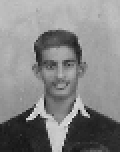 In cricket, some personalities are many-in-one. Several facets are rolled into a single individual. Such a character is Abu Fuard. He was, one time Asia's best off spinner. He was a fine all-rounder, cricket administrator, team manager and above all, a relentless trainer of young cricketers. From the exterior, he looks tough, rough, uncompromising and disturbingly harsh. But, at heart, he is human and as timid as a lamb.
In cricket, some personalities are many-in-one. Several facets are rolled into a single individual. Such a character is Abu Fuard. He was, one time Asia's best off spinner. He was a fine all-rounder, cricket administrator, team manager and above all, a relentless trainer of young cricketers. From the exterior, he looks tough, rough, uncompromising and disturbingly harsh. But, at heart, he is human and as timid as a lamb.
Like the surgeon's scalpel, his sharp words, helped to heal. He may come upon a lethargic young fellow, capable, but, not doing his best. He lashes out at him allowing the reluctant cricketing youth to blossom into his fullest potential. "The greatest achievement of my life in cricket, is the fulfilment of my ambition to throw open the game of cricket played in Sri Lanka, to every nook and corner of the island, whereby, the talented boys, who come out from outstations are able to represent Sri Lanka some day or other.
 This is because, during my long playing years, I had the misfortune of not only seeing with my own eyes, but, also experience, the discrimination meted out to outstation cricketers, who were not fortunate to be educated at "elite schools". They, were not only very snobbish to the "under privileged," but also, looked down upon them with utter contempt. Mercifully, ugly, is a thing of the past. So, I took upon myself, fighting for the cause of the under privileged cricketers. I must mention here, when I started this campaign, I had to fight against the "elite class". They opposed me. During this battle, a team-mate of mine, a former Ananda Captain, Dhanasiri Weerasinghe, who is presently domiciled in Australia, propagated my message to others."
This is because, during my long playing years, I had the misfortune of not only seeing with my own eyes, but, also experience, the discrimination meted out to outstation cricketers, who were not fortunate to be educated at "elite schools". They, were not only very snobbish to the "under privileged," but also, looked down upon them with utter contempt. Mercifully, ugly, is a thing of the past. So, I took upon myself, fighting for the cause of the under privileged cricketers. I must mention here, when I started this campaign, I had to fight against the "elite class". They opposed me. During this battle, a team-mate of mine, a former Ananda Captain, Dhanasiri Weerasinghe, who is presently domiciled in Australia, propagated my message to others."
"I, as a person, belongs to a minority community. I am proud and happy, I contributed even in a small way, for the greater good of the majority, by opening the gates to some of the cricketers who represented the so-called lesser known schools.
Gamini Dissanayake - Yuga Purusha - Sri Lanka Cricket
I was instrumental in inviting late Gamini Dissanayake for cricket administration. This was another notable achievement of mine. This great man, Dissanayake was responsible in gaining "Test Status" for Sri Lanka, and laying the infrastructure of Sri Lanka Cricket. Today, I shed tears of joy, when many boys of outstations are now in the Sri Lanka team and performing with admiration."
These words were uttered by Abu Fuard, when I met him recently. In early 1950's, Fuard was an outstanding schoolboy cricketer. In 1953, he stroked a chanceless century for Wesley College, against Richmond College, Galle, and put on 231 run partnership with Brian Classen, who later represented Ceylon. Abu took 6 for 76 against S'Thomas College Mount Lavinia, captured 8 wickets against Royal and returned the figures of 9 for 53 against Prince of Wales.
Self-made cricketer
After leaving school, he joined Colts C.C. Fuard is a self-made cricketer. He worked hard for it. His love and commitment to the game are unbelievable. Born on 6th December 1936, in Colombo Fuard started his cricket career at Wesley College. His father A. M. Fuard captained Wesley in 1915 and his brother Ansar Fuard captained in 1954.
He started his sports career as an athlete. He represented Wesley College, as a hurdler in the Public Schools Meet and competed with late Lalith Athulathmudali. He played in the under 13 Team, as a fast-bowler. But, his coach famous Alban Fernando turned him to be an off-spinner. After leaving school, he played for Moors S.C., Colts S.C. and CCC. Fuard represented Sri Lanka from 1956 to 1971. Undoubtedly, he was the best off-spinner during his era. Nothing can replace enthusiasm and practice. The best way to play cricket is to play it and enjoy it. Fuard, played it very hard throughout his career. You cannot manufacture a breed of a player, it should happen. Everyone is different. Abu, as a player, was no exception.
Bowling requires concentration, a correct bowling action, ability to bowl a good length and direction. Abu, had all these ingredients, which made him, number one in Asia during his playing days. "Those days, I used to walk all the way from 5th Lane Colpetty to Colts Grounds, Havelock Park. I start practising at 2.00 p.m. all alone. I keep a twenty five cents coin, on the matting and bowl at it-spot bowling - to improve my length and direction" stated Abu Fuard.
Abu Fuard first represented Sri Lanka in 1961 against the mighty Australians led by Ritchie Benaud, played against England in 1962. Ted Dexter captained the England Team. His most memorable moment was when he captured 6 wickets for 31 against Joe Lister's International XI. He played a key-role in the first un-official Test victory beating India at Ahmedabad.
"It was a team effort. We were left with a target of 112 runs to win. On a bad wicket, with apparent pot-holes. I opened in the second innings, made a quick fire 40 runs and won the match 45 minutes before the close, said Fuard. By profession, he was an insurance man. He joined De Soysa and Company, Colombo 2. Principal agents for seven foreign firms, who handled major projects like Galoya, Inginiyagala, Kelanitissa, Victoria Bridge etc. They did the secretarial work and Abu was handling the insurance.
They performed an honourary job He first got involved in cricket administration, during Robert Senanayake's tenure of office as the president in 1973. Those were the days, where dedicated, committed men got into cricket administration in honorary capacity. Gamini Dissanayake, Dr. N. M. Perera, T. B. Werapitiya and Lakshman Jayakody, were ornaments to the BCCSL. These gentlemen, never mixed politics and cricket. Out of these presidents Gamini Dissanayake was the greatest.
Player turned cricket administrator After hanging up his boots, Fuard took to cricket administration. In 1985, he was appointed as fulltime manager of the Sri Lanka team. Prior to this period too, he was a successful manager. Further,he was a qualified cricket coach too. Under his guidance, Sri Lanka scored the first Test series victory against India at Saravanamuttu stadium. This was followed by beating Pakistan with this victory, Sri Lanka annexed the Asia cup.
In 1979, Abu Fuard, acted as Sri Lanka cricket manager in the World Cup. During this period, Sri Lanka won the ICC Trophy and thus qualified to play in the world cup in 1979. At the conclusion, Sri Lanka was placed fourth, ahead of India, Australia. New Zealand and Canada. Fuard was a member of the selection committee of the BCCSL, from 1976-1983. Thereafter, he served as the chairman of the selectors from 1982 - 1986.
"I executed the plans and the programmes of Gamini Dissanayake, to the very letter, without any fear or favour. He prepared the ground work, with his dynamic set of officials in the BCCSL, which helped to gain "Test Status" to Sri Lanka. This was the greatest achievement of Dissanayake. He prepared the infrastructure, planning, finances, grounds, administration etc. I was like his shadow "at that time" stated Abu Fuard. One notable feature was that Fuard, served the Board in an honorary capacity. He served for the love of the game.
A man who will call a spade a spade Fuard is a man who calls a spade a spade. Because of this, sometimes, he is not a very popular character in the cricketing circles. I personally believe, Fuard, was responsible in bringing about the "Common Man's Era" in Sri Lanka cricket history. He broke the class distinction in Sri Lanka cricket. He was responsible in proposing Bandula Warnapura's name, as the first Sri Lanka Test Captain against much opposition.
"My good friend, late K. M. T. Perera, as the chairman of the selection committee backed me to the hilt," quipped Fuard.
He was a tough task master. His motto was "Country Before Self." At times, he erupts like a volcano. But in few hours he is cool as a cucumber. He always played to win.
To prove this point, I still remember an incident, when he was very harsh and severe on a Sri Lankan pace bowler, when he returned to the pavilion after capturing a wicket in the second over against Pakistan, played at the CCC grounds, stating that there is a slight pain in his leg.
Abu pounced on the bowler: "young man, country is greater than your pain. Go out, to the centre, perform in the name of your country. Forget your pain. "He uttered these words in front of three of us, Wan, Ranjit Fernando and yours truly. The bowler immediately took the field and captured five wickets, which helped Sri Lanka to score a victory against Pakistan captained by Imran Khan. Close of play, Abu congratulated the bowler and told him, not to misunderstand for shouting at him. This is the nature of Abu Fuard.
As in cricket, in life too, there are ups and downs. Fuard, is currently maintaining a low profile. Many benefitted from him. Remembering him, will be a blessing to this strange cricket character. Sri Lanka cricket, should be beholden to the many contributions made by people like Abu Fuard.
 Sports at Wesley College got a shot in the arm, as it were, when the launch of the College's Gymnasium Project took place recently at the Old Wesleyites Sports Club (OWSC).
Sports at Wesley College got a shot in the arm, as it were, when the launch of the College's Gymnasium Project took place recently at the Old Wesleyites Sports Club (OWSC).
There was much enthusiasm and eagerness amongst the young and old Wesleyites, who had come to witness the commencement of a long felt need, that of a gymnasium for Wesley. Addressing the gathering the Chairman of the Gym Project, Ivor Maharoof, dwelt briefly on the association of the College and the OWSC, with one being complementary to the other.
He said "it was the wonder of Old Boys, as to how sportsmen at Wesley were able to do well at rugger and yet other sports, sans the facility of a gymnasium." Maharoof drove the point, that some thought it ludicrous to find sportsmen at Wesley doing their power training under the shade of the Flamboyant trees at Campbell Park, with concrete and iron bars.
This gymnasium he therefore stressed, will give the Wesleyites the much needed filip to further develop and enhance their sporting skills.
Fully aware of the funds that will have to be raised for the project through different avenues, handled by members of the Committee, Maharoof exhorted all Wesleyites in the true spirit of 'Highfield' "Saying some people wonder what happened, some people watched things happening, some people make things happen - this is what Wesleyites are made for, to make things happen, lets go ahead and achieve it." The Principal of Wesley College, M.A.P. Fernando, and the President of the OWSC, Parakrama Wijemanne, also addressed the gathering.
 Way back in December 1982, Nalanda met Ananda in the finals of the Sri Lanka Schools under-13 Division One, at the NCC grounds. It was a two-day match. Ananda was captained by A. Gunawardane and Nalanda was led by Bhagya Epasinghe. Nalanda won the 'Junior Cricket Plum' beating Ananda by 100 runs. The Sri Lanka Broadcasting Corporation relayed live commentaries on this match and Ranjan Madugalle, was in the box as an expert commentator. In his summing up, Madugalle made these remarks:
Way back in December 1982, Nalanda met Ananda in the finals of the Sri Lanka Schools under-13 Division One, at the NCC grounds. It was a two-day match. Ananda was captained by A. Gunawardane and Nalanda was led by Bhagya Epasinghe. Nalanda won the 'Junior Cricket Plum' beating Ananda by 100 runs. The Sri Lanka Broadcasting Corporation relayed live commentaries on this match and Ranjan Madugalle, was in the box as an expert commentator. In his summing up, Madugalle made these remarks:
"One thing is very clear. We witnessed some absorbing cricket during the past two days. The standard is very high. I am not be bit surprised that some of the junior cricketers who excelled these two days, especially Danesh Dissanayake (Nalanda), who made a brilliant century, Marvan Attapattu (Ananda) who scored a fighting half century, and Nalanda skipper left-hander Bhajya Epasinghe, who collected a stylish 43 and ably led the side, will be future Test players of the Sri Lanka in the 1990s."
What a great prediction!
Marvan not only represented Sri Lanka, today, he is the Sri Lanka National Test captain. Nalanda wicket-keeper in this final - Chamara Dunusinghe too became a Test player.Danesh and Bhagya left Nalanda and joined Wesley and S. Thomas' College, Mount Lavinia, respectively and went on to play for their respective schools.Danesh migrated to Australia for a couple of years. Bhagya played for NCC, University of Ceylon, Gabrone Cricket Club, Botswana. He sacrificed his cricket career, for studies, became an academic and a professional in Finance Management, and Accountancy and became an accountant.
At that time, 1982, out of these three school cricketers, number one for me, was undoubtedly Danesh Dissanayake.He was one of the most elegant gifted batsmen and a fine pace-bowler, a brilliant fielder and a 'captain's dream'. I knew him so well as I watched them.'As a junior cricketer, Danesh scored four brilliant centuries that season and helped Nalanda to win the school Division One tournament in 1982. He won the Best All-Rounder and won the Man of the Match awards. Former Australian High Commissioner, David Rutter, who graced the occasion of the finals at NCC, as the chief guest, gave away the awards.
Sri Lanka material: I consider Danesh Dissanayake, a man of missed opportunities in Sri Lanka's cricket. Undoubtedly, he was Sri Lanka material. But, fate deprived his chance to represent Sri Lanka, as he went 'down under', after captaining Wesley, for further studies.
Personal names coined with schools: There are many personal names that goes with their respective schools they studied, and they are synonymous. Mahinda - Amendras; Royal - Gunasekeras and de Sarams; S. Thomas' College, Mount Lavinia - Saravanamuttus, Senanayakes (DS, Dudley and Robert), Molamures, Sarams, Mendis' and Bulankulamas; Ananda - Ranatungas, Wettimunys, Polonnowitas; Nalanda - Narangodas, Pereras (Lincoln, Jayawickrema and Parakrama twins), Asoka, Warnapuras, Seneviratnes, Illukkumburas, (Daya, Karunatilake and Achinta), Weerasinghes, Mahanamas; are some of the names that come to my mind.
Dissanayake clan of Wesley: Wesley College, and Dissanayakes are insperable. Brothers, fathers and sons have represented Wesley College in cricket, in their distinguished and chequered history. 'Dissanayake clan' began their cricket career in Wesley in late 1930s. Bertram Dissanayake played for Wesley from 1939-1941, and he was a vice captain of the college cricket team. He entered the University of Ceylon, during the period when Sir Ivor Jennings was the Vice-Chancellor.
Chandra, Donald, Edmund represented Wesley from 1944-1945. All three took up to legal profession. Chandra, retired as the Assistant Commissioner of Labour. Edmund captained in 1946 and 1947, and scored a century against Royal College after 31 years. Graham Dissanayake - retired as the Commissioner of Food, was the first Ceylonese to secure the Diploma in Development Administration (Manchester). His son, Mahendra Dissanayake, captained Wesley College in 1984 and was selected as the sports star in 1985. He too played cricket in Australia for many seasons. While in Australia, Mahendra, obtained the Bachelor of Engineering degree and MSc in Information Technology.
Danesh - a born cricketer: Danesh Dissanayake was a born cricketer. As a tiny-tot playing for Nalanda under-11, he created cricket history in Sri Lanka. The date 25th October 1980 was a memorable day for Danesh and Bhagya. Against Zahira College, Maradana, Danesh Dissanayake captured 8 wicket for 1 run and again 6 wickets for 5 runs, and a match-bag of 14 wickets for 6 runs. In the first innings Zahira were dismissed for 13 runs in less than three overs. If my memory serves right, after Nalanda scoring 250 and over, with Bhagya Epasinghe, remaining unbeaten with 158, erasing Isipatana Hashan Tillekeratne's record of 154 runs, in the under-11 Sri Lanka School Cricket Association tournament. In this under-11 tournament, right hander, Danesh Dissanayake scored a sparking 121 not out against Dharmapala Vidyalaya, Pannipitiya.
Great player: Immediately after leaving Nalanda, at the age of 14, he represented his father's College Wesley and between 1985/1989, he scored: 1985 - 107 n.o. versus Carey, 141 - against Isipatana, 1988 - 100 against Royal, and again 114 versus Royal in 1989, 105 against St. Joseph's in 1989. In addition, he scored 88 n.o., versus Trinity in 1988, 93 runs against STC MtL, and 98 against St. Peter's in 1989. As a great batsman, he takes good balls and turns them into bad balls. A great player can do what the good player cannot. Danesh Dissanayake was adjudged runner-up School Cricketer in 1989 and the Best Allrounder.
Achievements in Australia: While in Australia, he obtained Diploma in Business (Banking and Finance) in 1998 and in 2000, he obtained the Associate Diploma of Business (Accounting). In 2003, he obtained the Bachelor of Business (Banking and Finance) from the University of Monash, Australia. Danesh was in Australia for 8 years. He played cricket and watched in Australia. He was one of the most outstanding players to represent Marians and Chirnside Park Club in Melbourne between 1996 to 2003. He played along with Ravi Ratnayake, Rumesh Ratnayake and present Sri Lanka 'A' coach Stanley Nell.
Danesh Dissanayake was born on 2nd April 1970. His father Edmund Dissanayake served Wesley as a teacher for more than 25 years. Later he took up to law profession. He was the Prefect of Games, Master-in- Charge of cricket and honorary coach of Wesley College for many years. Danesh's mother Amara Dissanayke who hails from Matara, was a teacher by profession and holds the Post Graduate Diploma in Education.
Fuards - Dissanayakes father-son captains of Wesley: There are two instances at Wesley, where father and son captained. In 1915, A. M. Fuard and in 1954, Ansar Fuard, achieved this rare distinction and honour and in 1946 and 1947 - Edmund and in 1989 - Danesh, father and son respectively captained this great school.
A great seat of learning: Wesley College was founded on 2nd March 1874. Though its portals, several distinguished sons have passed through. To name a few - Sir Baron Jayatilleke, Dr. E. W. Adikaram, Prof. J. E. Jayasuriya, Prof. E. F. C. Ludowyke, P. de S. Kularatne, Father S. G. Perera, Sir Oliver Goonetilleke, Sir Claude Corea, Sir Gerard Wijekoon, Sir Mohamed Macan Markar, Justice Amir Ismail, Banker Rienzie Wijetilleke, and cricketing maestros M. Sathasivam and Abu Fuard. These are some of the distinguished Wesleyites that come to mind among many. There is a unique record created by the father and son. Both scored centuries against their oldest rival Royal College, with son Danesh doing better than the father, by scoring centuries in 1988 and 1989.
Edmund Dissanayake episode: Wesley and Dissanayake episode will be incomplete, if I do not enlighten you, on the Wesley-S. Thomas cricket encounter in 1947. Wesley were riding high beating Royal the earlier week at Ried Avenue. Thomians were captained by Upali Katugaha, who had Ronnie Weerakoon as his deputy. An unprecedented crowd was present at Mount Lavinia, to watch the Thomians reel under Wesley pressure, with skipper Edmund Dissanayake, bowling his heart out to capture 6 for 14 runs. The first day ended on a triumphant note to Wesley. Before the Thomian clash, Edmund had a feeling, some unpleasant incident is going to happen - and thinking of a premonition of disaster.
Cartman's car broke down: The following day - Saturday, Principal Rev. James Cartman decided to drive his captain to Mount Lavinia. The car stalled near Lady Ridgeway Hospital, Borella. It was a bad omen. School by the sea at sea against Wesley
However, at Mount Lavinia, Wesley fought hard and the school by the sea, were at sea, lost six wickets for 60 runs, and defeat was staring at them. Ronnie clobbered and Edmund fell Edmund changed his plan and he took position at 'suicidal short-leg'. Remember, at that era, there were no helmets, or protective gear. N. S. Jayasundera was the bowler. One of his deliveries slipped of his palm.
Ronnie Weerakoon clobbered the full toss, with all his might and the ball struck Edmund, with a resounding thud on his head. Edmund swung round like a merry-go-round and fell full length, near the pitch. Wesley victorious by 112 runs
Rev. Cartman was the first to rush to the field, and as he carried off his captain, "Even the ranks of Tuscany could scarce forbear to cheer". Before he lapsed into unconsciousness, Edmund Dissanayake, great skipper, gave instructions about the bowling changes. While Edmund was battle it out for his life at the hospital, Wesley emerged victorious by 112 runs.
Miraculous recovery of Edmund:At the Durdan Private Hospital, Dr. J. H. F. Jayasooriya, the eminent brain surgeon, battled round the clock to save Edmund. It was found that he suffered from concussion of the brain, laceration of the brain tissues, associated with paralysis of the region below the waist. Edmund Dissanayake's recovery was indeed a miracle.
Death notice and a memorial service at a sister school Galle For nearly two months he lay between life and death. There was a death notice in the Daily News 'stop press' column of another E. Dissanayake, and sympathisers presuming that the worst had happened, to Edmund, flocked to Durdans. Royal and S. Thomas' cricket teams too were there. They say that bad news has wings. The rumour of his death spread to Galle, southern capital, where a sister school Richmond College Galle, held a memorial service.
Selector of SLSCA 1968/1969: I am so happy that in later years, in 1969, Edmund (Wesley) and yours truly (Nalanda) were selectors of the Sri Lanka Schools Cricket Association. Answer Wesley's call Presently, Danesh faced a challenge. To be the cricket coach at Wesley is an achievement itself. He returned from Australia to help his alma-mater. I must remind my 'star student', Danesh, in a nut-shell, what cricket coaching is.
Young players however talented need the accumulated wisdom of others. The role of a coach is simple. To assist his charges to improve their skills and enhance their personal performances. His aims are also simple. To create improvement; so that a batsman scores more runs; a bowler takes more wickets; a fieldsman takes more catches, saves more runs in the field and seizes more opportunities to create run-outs. Knowing Danesh Dissanayake's capabilities, I am positive and confident that as the new coach of Wesley College, one of the premier schools in the island, that he will usher the dawn of a new cricketing era for them in the years to come.
Sent by Yohan Ferreira
Wesley College emerged champions at the Western Province schools under 20 seven a side rugby tournament concluded at Longden Place yesterday.
The Wesleyites continued with their impressive record in the tournament and defeated S. Thomas' College Mount Lavinia in the Cup championship final.
Earlier St. Peter's 'A' beat Thurstan 'A' in the Plate championship final and Science College Mount Lavinia beat Isipatana in the Bowl championship final. St. Joseph's College won the Shield championship defeating Zahira College in the final.
In the tournament for the 'B' division teams S. Thomas' College Mount Lavinia beat St. Peter's College 'B' in the Cup championship final. Isipatana 'B' beat Wesley 'B' in the Plate final and Carey College beat Asoka MV in the Bowl final. Thurstan defeated Zahira 'B' in the Shield final. (C.D.)
Since the credentials of Mahadeva Sathasivam have become a topic of debate in the Dilmah Forum, let me intervene even though I have never seen him bat. It so happens that I have a newspaper picture of Garfield Sobers and Satha exchanging pleasantries in Lanka during the early 1960s. From the evident warmth of this occasion my conjecture is that this event and its rapport was rendered possible by stories conveyed to Sobers by the Bajans in the West Indian teams that had toured Sri Lanka in the Sathasivam era – notably the three Ws. It is on record that Worrell considered Satha “the best batsman he had ever seen” (C H Gunasekara, The Willow Quartette, Colombo: Sumathi Publishers, 1996, p. 57).
In any event octogenarians and observers of that era make it clear that the debonair “Satha” was twinkle-toes, all class and finesse as batsman. Indeed, folklore suggests that Ghulam Ahmed considered him the best batsman he had ever bowled to. The statistics provided by Jason in the Dilmah Forum indicate why. And before someone decries all this as park cricket, let me assure people that when the Muslims played the Rest of India in the 1940s they did so as Ranji Trophy champions. In brief, it was the equivalent of, say, New South Wales playing the Rest of Australia after they had won the Sheffield Shield. In short, one had the best sub-continental cricketers on display.
So, to, did the Bombay Pentagular Gymkhana of the 1930s draw some of the sub-continental best. One needs to peruse Ramachandra Guha’s books to gain a sense of this world of cricket. The fact that some Ceylon cricketers were invited to participate was recognition by Indian cricket circles of the quality of a few Ceylon players.
As for Sathasivam’s capacities, let me add two conclusive illustrations. Firstly, he scored 101 runs in 1944 for the Rest of India versus the Hindus, the All-India champions in that year (even though he was technically unqualified – for he was a Hindu!). Secondly, he made a masterly 111 runs in difficult conditions against the full complement of Indian bowlers under Merchant at the Unofficial Test Match between India and Ceylon in 1945 and a remarkable 96 runs out of a total of 153 when the Ceylon side struggled against a visiting Commonwealth team on a rain-affected pitch in February 1950. As any cricket lover knows, it is a solid score when all around you fail that reveals the best batsmen.
So, as others within the Dilmah Forum have stressed, the foundations for Sri Lanka’s capacities were being laid in the 1930s and 1940s. Young F C de Saram scored a brilliant 128 out of Oxford’s total of 218 against Woodfull’s Australian team in 1934; made 50 and 122 not out for the Rest of India vs the Muslims in 1937; and scored masterly centuries for the SSC when they played Madras and Baroda on their tour of India in 1945. Again the Ceylon Cricket Association’s trip to Madras to play South India in January 1947 was a triumphant occasion: Sri Lanka scored 521 for 7 with Sathasivam playing what many considered to be the finest innings ever seen at the Chepauk grounds up to that date, 215 runs in 248 minutes; and then dismissed the local side for 197 and 200, with RL de Kretser (off spin) and LE de Zoysa (right arm leg spin) as the main destroyers.
Ghulam Ahmed’s evaluation of Satha undoubtedly developed from his encounters with him on some of these occasions.
Fun and Games
Satha, as he was widely known, was also a superb ballroom dancer. In personality and panache, he had so much in common with such cricketers as Sobers, Denis Compton and Keith Miller – both on field and off the field. These were young men about town, virile playboys, each a debonair Don Juan with a taste for wine, women and song. Legends grow around such men.
Neville de Silva picks up on one of these stories when he speaks of gallivanting Satha going out to bat and making a century after a night out on the town. His purpose, alas, seems to be a celebration of the generation yesteryear and a belittling of the players today. Though I played cricket with Neville, I do not share this attitude and, indeed, take exception to the disparaging tone of his essay and the whimsical insertion of irrelevant matter such as the con-job engineered by a Lankan handball team who beat the immigration laws to reach Germany. But that is of less importance than the issue at stake.
The issue of discipline and fitness among cricketers must necessarily attend to differences in each era and its expectations. In the 1930s and 1940s cricketers had more leeway in their off-field activities and were not under public scrutiny to the same degree as recent times. No more so than in Ceylon those days where the game was an amateur and elitist pastime.
Again, while old-timers and young pups may argue about the comparative batting and bowling skills of stars of the 1940s and those of 2004 till the cows go home, I believe that there is one field within which, on average, today’s cricketers stand head and shoulders above those of the 1940s: that of fielding. True, there were natural athletes (Learie Constantine say) who were mercurial fielders. But the average level of athleticism and fine-honed skills revealed today surely exceeds that of the average cricketer of bygone days. It is because of this standard of excellence that critics frown on excessive drinking and fornication in the midst of a match.
One could, of course, make an argument for fornication in moderation with a regular lover as being helpful to sportsmen and women. I go further: I affirm that it is as beneficial as exhilarating. One can be rendered purring-satisfied in ways that enable a calm focus towards the fresh task at hand or, alternatively, one can be fired up for the new day. But a night-full (serially or otherwise) probably generates exhaustion. I have no experience in the booze field as I dislike the stuff, but I suspect that it is broadly true to say that excessive drinking slows the reflexes in the same manner as marijuana smoking. And as for hard drugs, I gather they do dull/skew the senses.
So one must attend to the legends about playboys Satha, Sobers, Miller and others with some measure of reservation. Apocryphal tales are selective. They omit those moments when a night of revelry led to a dismal performance as cricketer. And especially as fielder. On the authority of a Barbadian friend, Joe Hoad, who played with Sobers, I am ready to grant that that guy’s reflexes were so extraordinary that his fielding may not have suffered much after an all-night binge. But Satha? I suspect that he was a prima donna on the field, given to laziness even on the best days. [And subsequently Neville Jayaweera has confirmed this speculation: “Satha was a hopeless fielder, never chased a ball, dropped catches and all because for most of the time he was drunk.”] So, his all-night revelry compounded his tendency to let his team down on the field.
With the cricketer of today, whether Joe Bloggs or Joe Perera, therefore, cricket lovers have the right to demand moderation and discipline in extra-curricular activities. Too much is at stake nowadays. The libertarianism of yesteryear does not prevail to the same extent.
Ironies of Circumstance
In a controversial decision the Ceylon Cricket Association selected Sathasivam of the Tamil Union to lead the All-Ceylon XI when Bradman’s team of Invincibles played a one-day whistle-stop game on 30 March 1948 when their P & O liner paused at Colombo as it vended its way to England. F C de Saram of the Sinhalese Sports Club was senior to Sathasivam and had been expected to lead. The contretemps and repercussions surrounding this decision is another story.
The story I relate is of a different order. Five years later, when Lindsay Hassett’s team played All-Ceylon on 30 March 1953 while enroute to England, the captain was F C de Saram. And what of Satha? He was in jail charged with murdering his wife.
Let me assure readers that Sathasivam was not the culprit. Indeed, he was acquitted and subsequent events have confirmed that it was a domestic servant named William who had been responsible – he committed another murder. Grapevine gossip suggests that the police authorities led by Sir Richard Aluvihare were directed by tunnel-vision. The thick respectability and prudery of middle class society at that time, a mixture of Victorian Puritanism and Buddhist reformism, encouraged some vengeful blindness. Satha had penetrated so many bedrooms that high society looked askance at the man.
There are other asides to this tale however. Australian journalists travelled with their team to cover the Ashes. Fingleton had been one of the journalists who watched the Don and Satha toss the coin in 1948. He was present in Colombo in 1953 as well. And he had the savvy to discover that Satha was in jail and to insert this fact into his match report (see Roberts & James Crosscurrents, 1998, p. 83).
Fingleton could not have foreseen a supreme irony: that the Ceylon captain in 1953 would also be jailed. F C de Saram had been a senior officer in the Army for some part of his adult life; and after he transferred to the Army Reserves as a civilian he was drafted into military service during the troubled times of the early 1960s when the government had declared emergency rule as part of its struggle against the agitations of the Left. F C de Saram then became one of the leaders in a military coup d’etat in January 1961– as a segment of the elitist English-educated classes attempted to turn back the trend of populist nationalism which had brought the reins of government into forces representing Sinhala linguistic nationalism. Well, this coup was aborted at the eleventh hour because a leak (and what else could one expect in Ceylon!) disclosed their plans. F C was man enough to say mea culpa. So he spent the best part of the 1960s in jail till a legal technicality of the same order as the Bali trials in Djakarta and the Privy Council of UK’s diktat saved his bacon (literally for FC liked his bacon and eggs).
This must surely be a record worthy of book of Guinness or, maybe, many pints in many an Irish pub. Two Ceylon captains who had the privilege of leading their country against the famous Australian cricketers both ended up in jail. Cheers mate
By Premasara Epasinghe
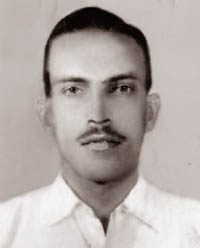 Frederick Dennis Austin Ebert, popularly known as Dennis Ebert, is an amazing, versatile, sportsman, produced by one of the leading seats of learning in Sri Lanka - Wesley College, Colombo. Domiciled in Australia, I met him while he was holidaying in Sri Lanka on balmy evening a few day ago.
Frederick Dennis Austin Ebert, popularly known as Dennis Ebert, is an amazing, versatile, sportsman, produced by one of the leading seats of learning in Sri Lanka - Wesley College, Colombo. Domiciled in Australia, I met him while he was holidaying in Sri Lanka on balmy evening a few day ago.
He represented Wesley College - in five sport disciplines - Cricket, Athletics, Hockey, Tennis and Table Tennis. Later, he joined the Police and excelled as an outstanding sportsman.
Master-Blaster of Wesley - 1949-1951
Ebert was a "Master-Blaster". As a schoolboy, he represented Wesley First XI from 1949 to 1951. The year 1950 can be considered as a "Golden Year" for Dennis Ebert, and Wesley. He became a "Batting Machine" and won the Batting Prize. The Team included Classen Brothers - Brian & Radley and Ansar Fuard - elder brother of Sri Lanka cricketer Abu Fuard.
Score board tick like - a Taxi-meter
When, Dennis occupies the crease, the score-board ticks like a Taxi-meter. Against Kingswood College, he scored a power-packed 107 runs, which included 07 massive towering sixes and 14 fours (98 runs in boundaries) made in 65 minutes. In 1950, he was the only Wesleyite to represent the continued school team, against the mighty Colts CC led by that great cricketer and fine sporstman Tita Nathanielez. This Combined College XI, included former St. Peter's College and Lecestershire cricketer - Clive Inman.
 Inman scored only 12 runs in this match. Ebert top scored with swashbucking quick-fire 69 runs. He deposited a ball over the ropes to Park Road, off Nathenielez, a catapulet fast bowler of Ceylon at that era.
Inman scored only 12 runs in this match. Ebert top scored with swashbucking quick-fire 69 runs. He deposited a ball over the ropes to Park Road, off Nathenielez, a catapulet fast bowler of Ceylon at that era.
Late Lakshman Kadirgamar
"I was deeply shocked, when I heard the news, that Foreign Minister Lakshman Kadirgamar was assassinated. He was a gentleman and a fine human being. I still remember Kadir, as the opening bowler and opening bat, when he played for Trinity and led the team admirably.
In this encounter against his team, I scored 65 runs. Kadir who opened batting and bowling scored 22 and took 2 for 24", stated Ebert.
Champion athlete
Apart from cricket Ebert, excelled as a champion Athlete in 1950. He won the Javeline Throw Event in the first ever Public School Athletic championship and won Public school athletic colours and Wesley College colours. In the year 1950, he won the prestigious Best-All round Sportsman Prize at Wesley.
Family background Born on 10th June 1932, Ebert hails from a highly respectable family. His father was Alec Ebert, surveyor, and mother Sheela Ebert. She was a "leading light in Education".
She served as the Head-Mistress of Zahira College, Maradana under the renowned, reputed Educationists T. B. Jayah and Amuan Aziz. Further, she served at Gampola Zahira, under Bad-ud-din Mahamud, the former Minister of Education. She retired from St. John's College, Nugegoda.
Ebert married Marlene in 1955. They are blessed with a daughter. Her name is Cara. The two sons are Ross and Randell.
Today, this happy "Grandpa" have five grandchildren ranging from four years to twenty five years.
Aubrey Ebert
Dennis has four brothers. the eldest Rayan. His other brothers are Aubrey was a cricketer and more a boxer at S. Thomas' College, Mount Lavinia.
Later, he became a reputed internationally recognised cricket commentator and broadcaster, from 1960-1970. I had the honour of commentating with him for many years. Presently, he is in Australia.
Batting Star - Lorensz Then, the fourth one Lorensz was a fine product of Wesley. He was a "Batting Star" in 1957/1958.
Like Dennis, he too, played in the combined school XI, under Michael Tissera against Holkar's Cricket Team from India. Lorensz scored a polished 89 runs. He too migrated to Australia, and played club cricket in Victoria along with Bill Lawry. Youngest in the family is Jeromy.
Coached by "Satha" at Junior level
As a Junior Cricketer, Dennis was coached by no lesser person than late M. Sathasivam distinguished Weslite and the best batsman produced in Ceylon before Sri Lanka gained test status.
Senior coach Alban Fernando Later, Alban - A.V. Fernando, the reputed sports journalist coached him in the First XI.
An incident that's etchers in his mind was the Richmond-Wesley Match played at Galle in 1950. "I was determined to score in this match as my cousin brother Donald Joseph was captaining Richmond. Before, I reached double figures, I was given out - caught behind by the famous umpire Dodwell de Zoysa, who was considered as number one at that time.
I was trying to glance a ball going away from my leg-stump. The ball brushed the strap of my pad protruding out. De Soysa, thought, it was off-my bat, he gave marching orders to me.
I immediately, walked away for Galle pavilion. During the tea break, this great highly respected umpire walked into our dressing room and told me "Son, I am sorry". During our era, we played the game hard. We always respected the umpires "the custodians of the game." This is something the present day cricketers should learn and follow. Cricket is a philosophy and a way of life.
You must be disciplined, and you must always respect you parents, teachers and seniors. We still respect our teachers and superiors", stated Ebert.
Some of his contemporaries who played with him, were Classen Brothers - Brian and Radley, Mack Brothers - Derik and Spencer, Herbie Felisinger, S. Mustafer (wicket-keeper) Ansar Fuard, Luckey Abeywardane to name a few.
Joins Police
Ebert, joined the police as a sub-inspector in 1952. He served the police for 17 years. He is one of the finest police officers who served in outstations as well as in Colombo. He was an honest officer and a man of highest integrity.
He was an ornament to police. He was an outstanding sportsman. He is pleasant, charming and a fine human being.
"While I was playing in a club match, as a schoolboy, the Director Police Training School, that fine sportsman Sydney De Soysa was a keen spectator. I scored a quick-fine 50. He came and congratulated me and asked me whether, I like to join police as a sub-inspector. This was a god send for me. I joined the police in 1952" stated Ebert.
Outstanding sportsman in police
"I excelled as an Athlete and as a cricketer in police. I held the Javeline Title at the police on three occasions. Further, I clinched the government service title too" quipped Dennis Ebert.
He represented the Police Cricket Team for number of years with distinction. In the Army-Police cricket encounter, Dennis Ebert and Thiru Kadirgamar established a new-record for the last-wicket with an alliance of 122 runs. I scored 69 not out. Army Cricket Team was led by maestro Col. F.C. De Seram. We scored 207 runs.
"The Army was sitting pretty at one stage score-board reading 130 for 02 wickets. Right arm paceman, Bianz De Vaz returned the figures of 05 for 46 and destroyed the Army. This match was the Big-clash played at the Police Park Grounds. "I enjoyed every bit of cricket I played in Sri Lanka. I was so fortunate to play with great police players such as Solomon Gunatilake, L.M.P. De Silva, T.B. Werapitiya, Vernon Prins, Niel Weerasinghe, Malcolm Spitel, Hubert Bagot, H.C. Perera, stated Ebert.
T.B. Werapitiya - at brilliant best
Ebert's "finest hour", "the hour of glory" in cricket, dawned when the Police Team toured India in 1958. The Police Cricket Team was led by that great cricketer cum cricket administrator (President BCCSL) par excellence, Trinity Lion and University of Ceylon Cricketer former Deputy Minister & late T.B. Werapitiya. He collected a fine, chanceless, polished 120 runs. It was a gem of an innings. "I supported him, concentrated a lot and remained unbeaten with 36 not out.
Highlights of his police career
For him the police life was fantastic and a challenging one. When, Dennis Ebert was attached to Criminal Investigation Department (C.I.D.), he served as the Bodyguard to Governor General Sir Oliver Gunatileke, another distinguished old boy from Wesley. He served in the capacity for nearly six months, in 1959, after the assassination of S.W.R.D. Bandaranaike - Prime Minister. During the non-aligned conference, Dennis Ebert, served as the Body-guard to Marshall Tito of Yugoslavia. Then, he was a member of the team of investigation into the attempted "Coup d'etat" in 1962.
Further, he served with distinction as the OIC of police stations at Ahangama, Bandaragama, Wadduwa, OIC Crimes at Wellampitiya, Welikada and Vice Squad, Mirihana. After serving for 17 years in the police, he retired and migrated to Australia.
"After settling down in Australia, firstly I served in the Australian Police Department for a couple of years. Then, I joined the British Petroleum Company and later joined the world renowned General Motor Company as a controller in the Finance Division and retired.
Links to further reading
Wesley has been the cradle to many national cricketers in its halcyon days. Having produced dynamic cricketers for the national side of the calibre of M. Sathasivam, Brian Claessen and L. Gunatillake in the pre-test era and having turned out test material like those of Maharoof in recent times, the college has established a name for itself for generating quality players. Current first xi team of the Campbell Place College, skippered by Charitha Karunarathne, is yet another formidable Wesley out fit to continue the rich tradition of Wesley’s history.
During their bad weather hampered third term matches, Wesley recorded their first outright victory beating Sri Jayawardenapura College and almost registered another win against Isipatana. Wesley had to be content with a first innings win against Isipatana when bad light stopped the match with Wesley needing 10 runs with enough overs left and wickets in hand.
Though inclement weather conditions hindered Wesley performance, a dynamic coach in Danesh Dissanayake and a veteran MiC in Nimal de Silva who is treated as a father figure in the school have been providing the youngsters the necessary drive to stand up against all odds and gain first innings lead on more than one occasion in their encounters. Nimal de Silva has been nurturing Wesley cricket for over 27 years and his coach Danesh Dissanayake who is a banking graduate from Monash University, Australia completed his first year as the Wesley coach.
Among the leading performers of Wesley is the captain Charitha Karunaratne, who accumulated over 500 runs last season. The left handed Karunaratne, in his fifth year, in the side, is one of the experienced campaigners. He really became the heartbeat of the side when he scored a splendid 116 ball 114 to help Wesley pile up 315 runs against S. Thomas and guide the side to obtain a first innings lead over the Thomians at the last week-end. If he strikes form then Wesley will be a real threat to any opponent. While strengthening the batting line-up he also contributes with his right arm off spinners.
Karunaratne’s abilities as a batsman are complemented by several others. Vice captain Anoj Katipearachchi and Sachindra Rupasinghe have opened together on a regular basis and they are followed by Shakthi Siriratne, Avishka Liyanage and Ryan Kern.
The fourth year coloursman Anoj Katipearachchi, who missed half of the last season due to injuries, proved his batting ability in the 2004 season when he aggregated a total of over 800 runs. He has found touch for the season and has notched his highest score (93) in their match against St. Benedict’s. Left hander Sachindra Rupasinghe, who opens batting with Katipearachchi, scored over 400 runs last season and he too is a reliable batsman.
The fourth year player Shakthi Siriratne who captained their Under-17 team is developing to be one of the future prospects for Wesley. The right hander has accumulated over 250 runs this season and is a good fielder. Wicket-keeper batsman Avishka Liyanage undoubtedly was the most successful batsman for Wesley during the last season. While captaining the side he scored over 900 runs during the last season. This year he has accumulated over 300 runs which includes 3 half centuries. Right hand batsman Rabindranath Mathusuthan is the reserve wicket keeper for the side.
Third year players Lahiru Fernando, Ryan Kern and Ishan Jayaratne and second year player Heshan Gomes are the all-rounders who strengthen the middle order bating line-up.
With the new ball, Wesley relies heavily on the skills of third year players Ryan Kern and Ishan Jayaratne. Both are right arm pacies and the latter was adjudged the best bowler in their annual Royal-Wesley encounter last year. The Wesley seam attack includes not only all-rounders Ryan Kern and Ishan Jayaratne, but also Anoj Katipearachchi, Dilan Marasinghe and Sachindra Rupasinghe all of them right arm medium pacies.
Third year coloursman and left arm spinner Taariq Naziar is another slow bowler that Wesley looks to for both control and penetration, while another left-armer, Thilina Abeysekara toughens the spin department. Naziar took over 40 wickets last season and has taken over 15 wickets during this season. Right arm spinners Dinith de Silva and Lahiru Fernando are also dependable spinners.
Freshers Geoffrey Vandersay, Gavin Schubert, Shane Sammandapperuma, Chinthaka Yapa Bandara, Nuzky Nazir and Dulanjana Wijesinghe who captained the Under-15 side are the rest of the Wesley outfit.
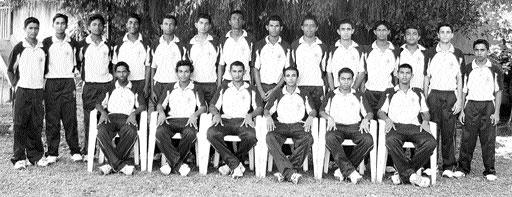
Seated from left: Shakthi Siriratne, Avishka Liyanage, Anoj Katipearachchi (V. Cap), Charitha Karunaratne (Captain), Taariq Naziar, Ryan Kern
Standing from left: Geoffrey Vandersay, Heshan Gomes, Lahiru Fernando, Shane Sammandapperuma, Ishan Anjana Jayaratne, Chinthaka Yapa Bandara, Dinith De Silva, Sachindra Rupasinghe, Nuzky Nazir, Dilan Marasinghe, Thilina Abeysekara, Dulanjana Wijesinghe, Gavin Schubert and Rabindranath Mathusuthan. (Pix by Nishan S Priyantha)
 Ten years is a fair slice in the life of any institution, all this and more annually, was given unstintingly by Ceylon Cold Stores (CCS) as sole sponsors of the Old Wesleyites Sports Clubs (OWSC) Schools Six-a-Side Cricket Tournament. The tenth of which commences on Saturday October 12 and ends on Sunday 13 at the Wesley College grounds.
Ten years is a fair slice in the life of any institution, all this and more annually, was given unstintingly by Ceylon Cold Stores (CCS) as sole sponsors of the Old Wesleyites Sports Clubs (OWSC) Schools Six-a-Side Cricket Tournament. The tenth of which commences on Saturday October 12 and ends on Sunday 13 at the Wesley College grounds.
The 62 year old OWSC with the generous assistance of CCS, has done well to maintain this tournament without interruptions since its inception in 1993. Viewed in the context of Clubs managed by old boys of other schools, this sustained partnership between the OWSC and CCS, to score in the name and cause of school Cricket is, whilst being exemplary also a rare achievement indeed. Since it is a landmark event in the annals of the Club, it does merit a brief narrative here. Right at the outset, without any reservation it must be said, that this tournament was the brainchild of former Wesley Cricketer, Eric Gauder, who is also a sports promoter, a radio and TV Commentator.
The thinking at that time, was that there should be a tournament with a difference. Unlike the league and limited over games conducted by the Sri Lanka Schools Cricket Association - it was to be a competition that will bring about 25 to 30 schools teams from different parts of the island, to converge on the Wesley College grounds for a duration of two days.
The main aim of this farsighted exercise was, whilst promoting healthy rivalry to also foster a spirit of camaraderie, bonhomie and afford opportunities for fellowship - especially with the young in mind from lesser known schools in the different district. For the OWSC held the view, that no longer is sports confined to the Urban areas only, but as well to the rural and village of our country. It is with this uppermost in mind that the Club sought to provide exposure for young cricketers, who will be the future stars of Sri Lanka.
Seen in all its entirety, it did not take long for the President of the OWSC, Prof. Mahroof Ismail and the Committee, with the all important financial assistance from Ceylon Cold Stores as sponsors, to appoint Gauder as the Chairman of the Organising Committee of the inaugural OWSC's Schools Six-a-Side Cricket tournament that was held on the College grounds on the 25th and 26th of September 1993. Daunting as the challenge was, members of the Committee spearheaded by Gauder and motivated by President Ismail rose to the occasion to relentlessly work in pursuit of success, which the tournament achieved in great measure to the satisfaction of all.
The salient features of this first ever tournament, was that it was meticulously planned and well executed. There were the billboards, buntings and banners that gave it a festive air, with the decorative school tents, which proved attractive enough. From the point of co-ordination, things were worked off in slick precision in keeping with a tight schedule, which was very salutary. The College prefects and the marshals looking ever so impressive, liaised with the teams and yet other officials on their walkie - talkies. There was no shortage for food and drink, with Elephant House chipping in, not forgetting the toilet facilities for the many who flocked on to the grounds. And to cap it all on the final day there was the colourful awards ceremony that witnessed the entire committee smartly dressed for the occasion.
There was undoubtedly much finesse and style in the way in which this major undertaking was executed. Needless to say that it lifted the stature of both the Club, as well as the tournament, with Radio and TV coverage too. So much so that through the years, it has become a much looked forward to, increasingly popular event for many. Heartening it was, that in the year 1994 a team from Maldives in Majeediya School came down to take part. It was touching as well, in keeping with the them 'Peace for all' that in 1998 with the help of the Army and Lion ir, three teams from the North/East in, a combined schools team from Jaffna, Methodist Central College from Batticaloa and R. K. M. Hindu College from Trincomalee were here to participate.
Two Principals of the College, viz. Dunstan Fernando and N A B Fernando, in accord with their respective periods of office, lent patronage to the tournament. The present principal M A P Fernando who is a keen promoter of Sports at Wesley, is a source of encouragement to the OWSC and is very supportive of the Six-a-Side Cricket competition. The Presidents of the OWSC, who were associated with the tournament during their tenure in office were Prof. Mahroof Ismail, Denzil Perera, Lucky Gunetilleke and Capt. Navin de Silva. The current President Tyronne Maye has been involved with this tournament from last year, in his official capacity. The Chairman of the Organising Committee from the inception of tournament in 1993 to the year 2000 was Eric Gauder. The present Chairman of the Organising Committee, is former Wesley Cricket Captain Sunil Fernando, who also steered last year's tournament as Chairman. Sunil also played cricket for the Colts Cricket Club and a Mercantile firm. He has sufficient experience in organizing Six-a-Side tournaments, having done so for the Tea Shippers tournament for quite some time.
Those who have assisted the tournament at different intervals from the Ceylon Cold Stores, the sponsors are M. D. Sumithra Gunasekera, Directors Billy Walpola, and Laksiri Wickremage Managers Nalin Jayasuriya, Ashan Wanduragala, Neil Samarasinghe, National Sales Manager. Billy Walpola and Ashan Wanduragala, have been very keen followers of the progress made by the OWSC in relation to the tournament. The adjudicators at these competitions have been past Sri Lankan Cricketers, while the umpires doing duty have been picked from the panel of Sri Lankan Umpires.
The Champions at this year's tournament will receive the Lemonade trophy, with individual awards for eight members, while the runner-ups will be presented with individual awards for eight members. There will in addition be special awards for the Best Batsman, Best Bowler, Best Fielder and Man of the Tournament. The past champions of this tournament winning the Lemonade Trophy were 1993 Royal, 1994 Kalutara MV, 1995 Thurstan, 1996 Nalanda, 1997 Prince of Wales, 1998 Nalanda, 1999 St. Josephs, 2000 Nalanda, 2001 Royal.
May this partnership between OWSC and CCS in the next ten years, be even more brighter than the past ten years.
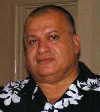 Some of you may not know that Wesley celebrates 50 years of Rugby Union this year. In recent years we have been a formidable force beating the traditional stronger schools convincingly and putting on consistent competitive performances on the field. To celebrate this milestone, Navin de Silva is chairing a committee that has arranged an invitational 7 a-side tournament over the weekend 23rd and 24th September with a formal dinner at the Transasia Hotel on the 24th after the conclusion of the tournament.
Some of you may not know that Wesley celebrates 50 years of Rugby Union this year. In recent years we have been a formidable force beating the traditional stronger schools convincingly and putting on consistent competitive performances on the field. To celebrate this milestone, Navin de Silva is chairing a committee that has arranged an invitational 7 a-side tournament over the weekend 23rd and 24th September with a formal dinner at the Transasia Hotel on the 24th after the conclusion of the tournament.
I have arranged for Bob Dwyer the famous Wallaby and International Coach to attend the tournament and present the awards as well as being the Guest Speaker at the Dinner. Loyal Old Wesleyite and former rugby player Mike Siebel has sponsored Bob’s fees and the organising team in Colombo have arranged his travel and accommodation.
It would be great to capture the memories of the past 50 years by former players putting down their thoughts on paper. Not like our cricket history, rugby was always been in the background. There are many old boys around the globe who donned the double blue hooped jersey, put on the “Win it” boots and played “the game they play in heaven”.
Here is what you have to do:
In 200 words(if more may be edited) put down your reflections on the game(particular matches), the players, teachers, coaches, incidents, the personalities. If you have photos send them in scanned. – Names of players that represented the leading Clubs in Sri Lanka (1st XV) e.g. CR & FC but not the CR Bees and those that represented Sri Lanka .
It is all about leaving a legacy for the future and in comparison to Wesley’s cricket history which is well chronicled Rugby Union needs to raise its profile.
Pass this on to other Wesley Rugby players not on the email lists.
Some names come to mind:
Sin Sen, Y C Chang, She Hung, Ma Hung, Asoka Jayawardena, “Kalu” Cassim Cader, Rehez and Shiraz Ahlip, Iqbal Musafer, Tariq Bongso, Bashur Musafer, Shafique Wahab, Cavern Gauder, Roger Koch, Bentley Barsenbach(Coach).
The Cover of the Rugby Souvenir celebrating 50 years of the game at Wesley College

.....................................................................
Some photos from the Celebration Dinner at Trans Asia Hotel
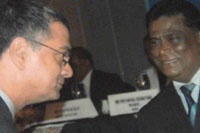 |
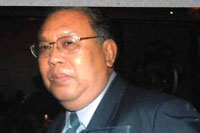 |
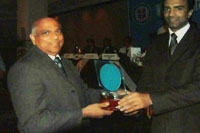 |
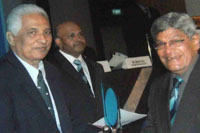 |
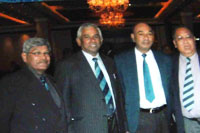 |
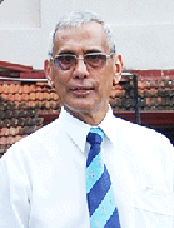 During my short stay in Sri Lanka recently I had the opportunity of witnessing the Wesley-Kingswood encounter at the Royal College grounds. I was disappointed that the match ended in a 16 all draw .It was a match that Wesley dominated in the first half and should have won, but was lucky enough not to lose in the second half. Wesley lost their scrum half who was sin binned and lost the momentum and advantage it had. However I was happy that the standard of rugby at Wesley has vastly improved and that Wesley is now a force to reckon with in the school rugby scene.
During my short stay in Sri Lanka recently I had the opportunity of witnessing the Wesley-Kingswood encounter at the Royal College grounds. I was disappointed that the match ended in a 16 all draw .It was a match that Wesley dominated in the first half and should have won, but was lucky enough not to lose in the second half. Wesley lost their scrum half who was sin binned and lost the momentum and advantage it had. However I was happy that the standard of rugby at Wesley has vastly improved and that Wesley is now a force to reckon with in the school rugby scene.
It has taken us a very long time to achieve this goal and our thanks should go to the persistence and efforts of those old Wesleyites, old ruggerites, coaches, well- wishers, supporters and those who played the game at college, as they all kept the dream alive that that Wesley could excel at rugby, this dream has come alive as we celebrate 50 years of rugby. From this point onwards we should not relent or step down from the pedestal we are now in. We should aspire to move to the pinnacle of school rugby.
It is my sincerest wish that those future players who don the double blue jersey will represent the school with pride and strive hard to play the game with a strong determination and dedication to bring honour and recognition to Wesley. They should also have the ultimate aspiration to represent Sri Lanka. This was something never conveyed to us. Inspite of all the shortcomings of rugby at Wesley we have over the few years had some representation in the Sri Lankan teams. It would be unfair to name any as I would be be doing an injustice to those who represented Sri Lanka in the last 50 years and whom I don’t know .I am sure that rugby has done better than cricket in this instance.
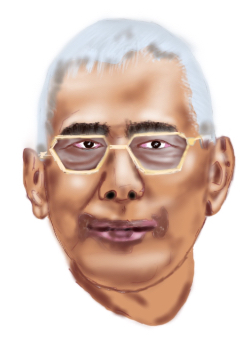 Recalling rugby in the 60’s it was just another game that Wesley played .It was a game I played as a last resort having played soccer and hockey with the one game rule prevalent at that time. Rugby practices were conducted in any corner of Campbell park and one day I joined the likes of Sin Sen ,the Chang brothers, the Christofelsz brothers ,Jardi de Silva and a host of others at practice .Given the ball and not keen to be tackled I proved to be too slippery for Jardi who sort of welcomed me to the game played in Heaven.
Recalling rugby in the 60’s it was just another game that Wesley played .It was a game I played as a last resort having played soccer and hockey with the one game rule prevalent at that time. Rugby practices were conducted in any corner of Campbell park and one day I joined the likes of Sin Sen ,the Chang brothers, the Christofelsz brothers ,Jardi de Silva and a host of others at practice .Given the ball and not keen to be tackled I proved to be too slippery for Jardi who sort of welcomed me to the game played in Heaven.
My first match was against the CR Cossacks at Longden Place is a match I will not forget as when I ran into the ground I did not know where to take my place as an inside centre. I was not a follower of rugby and hardly seen a rugby match. We had no coach and hardly new the basics.
There were no lessons as to how to tackle or pass the ball. We were lucky if there was more than one ball available for practices. Physical fitness was probably a few rounds around the park. Rarely did we have the full use of the grounds for practices as a XV. Inspite of our inexperience we won the match and it proved to be the start of a game that was the major part of my sporting career for the next fourteen years.
It was customary for the players to assist with the marking of the grounds and the erection of the goal posts (Arecanut trees). The playing area was near the prison end and ran across part of the cricket pitch .It was enough to accommodate the playing area but the in goal area was short .Our handiwork was so good that when we surveyed what we had done we found the playing area was not rectangular in shape. It was a well known fact that Campbell Park was as hard as rock and had ant hills to provide an uneven surface.
It was on this ground that St Benedicts playing rugby for the first time were pitted against Wesley a more experienced side(relative to rugby years).We were doing well and having a slender lead when the heavens opened up during the dying stages of the game. It was unfortunate that we lost possession of the ball and the Benedictines were edging closer to our goal line .Soon after they crossed the line and in their eagerness to score under the posts crossed the dead ball line as well, At this time it was not a shower but a heavy down pour and the referee the late Major Denis Hapugalle not noticing the boundaries awarded the try which was converted., Whilst the Benedictines were jubilant good old (Dubbie )Mr Donton D’Dabrera the master in charge of rugby wasn’t impressed with the referee. The subsequent outburst at the pavilion directed at the referee proved to be the end of an era of a great icon of rugby at Wesley. He was undoubtedly the father of rugby at Wesley. The net result was that we had no coach and no master in charge.
A few months later Mr Lionel Fernando who was the Commissioner of Prisons and a former CR &FC and a Trinity rugby player volunteered his services as the coach. He went on to be Principal of Trinity later on. During his tenure we played some spirited rugby that impressed him immensely, so much so that when CR lost a game he would comment that if some of us played in that team they could have done better.
There are many stories that each generation can relate to.To me the Wesley Trinity match was the most significant especially the trip to Kandy and the daunting task of limiting the score line. This was not made any easier by the amount of food and drinks ( non alcoholic) carried by the freshers. On one such trip the late Sharir Musafer reputed for his eating made use of this opportunity to the fullest.
In addition at Trinity we were treated to an excellent lunch and high tea of very sweet cakes and confectioneries. Sharir and the Captain Sin Sen being the prop forwards with the capacity to eat the most, accomplished this task perhaps thinking that it would add more weight to the scrum. How wrong they were, with the fast moving Trinity backs running circles around us it was scrum after scrum which tired the forward pack. This was too much for Sharir who was soon on the sidelines throwing up all he had consumed. It was a common occurrence for the pack to wait till the props arrived to bind for the scrum even at the best of times, but on this occasion they were missing. Eventually Sharir turned up groggy and worse for wear with Sin Sen ambling behind. Sin Sen asked Sharir where the hell had he been? To this Sharir replied ..”where the hell have you been to?” Sin Sens reply …”I am the captain and you have no bloody right to ask me that question, come on and bind.” It was a match they would both like to forget, perhaps we all wanted to reflect on the score line.
The Wesley –Trinity encounter was always a challenge and it was always our aim to spring an upset and beat them. We came close to beating them with some spirited and robust play the following year. The failure to beat them has been squarely blamed on me - If only Bashur had scored that breakaway try was the lament of the team. Looking back I wish we had beaten Trinity – Forty years ago !
During my 12 years of representing the Army and Defence Services team I noticed the absence of Wesleyites in the club scene especially in the planting sector .It was evident that the Old school network was sadly lacking in placating the many multi talented Wesleyites in positions of employment which they truly deserved. Could the present generation address this failure?
It gave me great joy when I was told a few years ago that Wesley had beaten Trinity for the first time. This was conveyed to me by Mr Dilip Kumar an old Trinitian who as a Sri Lankan held the position of Chairman of the Australian Rugby Union and is very involved in the development and the future of rugby in Australia. Over the years he has been very supportive of various fund raising projects conducted on behalf of Wesley in Australia. He has once again made an immense contribution towards the 50 years of Rugby at Wesley celebrations although not an Old Wesleyite .There are no boundaries in rugby when ones passion is to further the game. Let us thank him for this wonderful gesture and hope that all Old Wesleyites will help and support Wesley to its 100th year of Rugby.
Links to further reading
From Melbourne, Australia
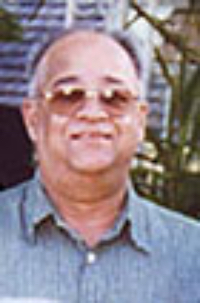 The person who is rightly labelled the “Father of Rugby at Wesley” is the late Mr. Donton D’Abrera or “Dubby” as he was affectionately called by the boys.
The person who is rightly labelled the “Father of Rugby at Wesley” is the late Mr. Donton D’Abrera or “Dubby” as he was affectionately called by the boys.
I remember “Dubby” quite vividly and recall with nostalgia his running around Campbell Park in his flapping khaki shorts , white jersey tucked into his ‘jocks’, with his ever present whistle.
He lived in Dehiwela and used to usually travel to and from school in the school bus , however he occasionally rode in on his BSA ‘kukula’ bantam and it was a treat to see Dubby on this little bike giving big “Golu” Gunasekera a lift home after rugger practice. On the days he drove his Triumph “Mayflower” in we set new records as about 10 or 12 twelve of us squeezed in for a lift home. On most occasions we would stop at Bambalapitiya junction where Dubby bought all of us ice cold milk from the Milk Board kiosk on the corner. We also used to be given “Haliborange” tablets during the season , all this out of his own funds.
During the rugby season Dubby the teacher transformed himself in to a “full time rugby coach and occasional master”. All we had to do during a physics or maths class was mention anything to do with rugby and immediately the Coefficient of Linear expansion and Newton’s Laws were forgotten and the black board came alive with diagrams on positional play, angles and trajectories for a kick in the box, up and under, as well as scrumming techniques all became the subject matter for the period. It was the only class I know where the traditional back benchers sat right up the front and the bright studious types were confined to the rear of the class.
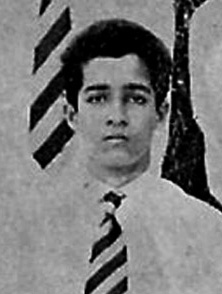 Dubby started rugby at Wesley and in his memory a few of the OBU members in Australia have donated a perpetual trophy in his name and this trophy is presented each year to “the best team player” in Wesley’s 1st XV. Unfortunately for Wesley’s rugby Dubby decided to give up being master in charge at the end of the 1961 season, due to disagreement with the school authorities on the level of support given to the sport.
Dubby started rugby at Wesley and in his memory a few of the OBU members in Australia have donated a perpetual trophy in his name and this trophy is presented each year to “the best team player” in Wesley’s 1st XV. Unfortunately for Wesley’s rugby Dubby decided to give up being master in charge at the end of the 1961 season, due to disagreement with the school authorities on the level of support given to the sport.
The next few years were dark and tough ones for rugby at Wesley. It was mainly players such as the late Dr.Daya Perera, Sheriff Fallil, C. Sin Sen, Beverley de Neise, Haig “ten men” Maloney, the two Chang brothers (CF & CS), Jaardie de Silva, Basheer Musafer, Michael and Nigel Christoffelsz, Russell Schockman, Trevor Collette , William Deutrom, Lakshman (GLR) Perera, Haig Claessen,the late Sharie Musafer, Ranjith Aaron, Reg Bartholomeusz, Lucky Samaranayake, the ‘fast breaking , non tackling’ Desmond Jayawardene, helped by the likes of Darrel Maye, Everard Walker, Lucien Fernando, Upali Perera, Hemaka Jayasekera, Hans Jonklaas and, Roy Oorloff, who all took up the game late and along with the others kept the flame alive . They were not assisted in any way by the school and were even told in 1962, that as there was no master in charge rugby would be stopped at Wesley; a few of the seniors managed to persuade their likeable Chemistry Master Mr. Pakianathan to volunteer for the job.
There was very little assistance for materials and the boys themselves helped Wilson to erect the ‘puwak’ trees for uprights and tie the cross bars on. Old engine oil was used to mark the lines. There was no professional or voluntary coach; the seniors took it upon themselves to coach the younger ones. Travel expenses for ‘away’ games were extremely miserly and the players had to fund part of the cost. Jerseys and stockings were paid for by the players ; and we can now laugh at how the 1st XV players used to warm up in bare feet or stay in the dressing room until the 2nd XV game was over to reclaim the boots they had lent the juniors.
The three years 1961 to 1963 did produce a few highlights in spite of the adversity. As Jaardie likes to remember his team beat Isipathana, and nearly did the same to Trinity at Campbell Park.
Reg Bartholomeusz went on to play for and captain CR&FC, and represent Sri Lanka for many years, Basheer Musafer played and captained the Army team and also went on to represent Sri Lanka. In fact the Sri Lankan team of 1972 had three Double Blues in it Reg Bartholomeusz , Basheer Musafer and Cavan Gauder who played for Wesley 3 or 4 years after the other two.
C.S.Chang played for Havelocks, Trevor Collette played a few games for the ‘merrie men’ of Uva, Nigel Christoffelsz continued to play rugby in Australia till injuries forced him to hang up his boots.
This lot of Wesleyites from the early sixties carefully nurtured the rugby flame under extremely adverse conditions and handed it over for the succeeding generations to nourish and fan it in to the bright white hot beacon it is today.
Some reflections of my playing career.
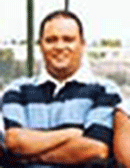 Master in Charge of Rubgy was Beno de Zylwa and we were coached by Kamal Jayawardene. This Team consisted of Sashi and Sanjeev Ganarajah, Gerard Fernando, Sanjeewa Kurruppu (V. Captain), Jerome de Franz, M.R Anura, T Falaldeen, Rizwan Uduman, Rohan Ali, Sajeev Dharmapalan, D. Thalagala, Sujeewa Pathiratne, Nalaka Nanayakkara, Dugal Jansz, Dinesh Gunesekera, Murad Fahmy, M. Mazeer
Master in Charge of Rubgy was Beno de Zylwa and we were coached by Kamal Jayawardene. This Team consisted of Sashi and Sanjeev Ganarajah, Gerard Fernando, Sanjeewa Kurruppu (V. Captain), Jerome de Franz, M.R Anura, T Falaldeen, Rizwan Uduman, Rohan Ali, Sajeev Dharmapalan, D. Thalagala, Sujeewa Pathiratne, Nalaka Nanayakkara, Dugal Jansz, Dinesh Gunesekera, Murad Fahmy, M. Mazeer
Shiraz Hussain, T. Janakan , Hiran Fernando, Vargees, Senaka Perera and Jeevan Rockswamy.(Sincere apologies for any names ommitted)
My career started when I was only 15 years and started for the 1st XV playing Prop forward under "The Great" Ajith Uvais (Captain 1979) and played under the following Captains - Bachchi Oumar (1980-81), Hassan Kaizer (1982). I captained the team in 1983. I would like to thank Coach Reggie Bartholomeusz for his dedication to Wesley College Rugby and Mr M. A.P. Fernando who always showed up for our Rugby games and supported us. Finally, not forgetting Mr. B Paternott who has also been there for Wesley Rugby.
From New Zealand
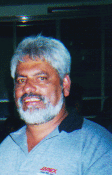 Here are a few memories of my days playing for Wesley in the Double Blue Jersey. I grew up in Borella and spent a lot of time at Campbell Park.
A few interesting things that I will always remember was my first coach Lucky Vithana. He was a brilliant coach who got the best out of us at training. If you slacked when we did our warm ups and exercises, his favourite words were “ the lot of you are running like half f...ed virgins and that would wind us up to perform.
Here are a few memories of my days playing for Wesley in the Double Blue Jersey. I grew up in Borella and spent a lot of time at Campbell Park.
A few interesting things that I will always remember was my first coach Lucky Vithana. He was a brilliant coach who got the best out of us at training. If you slacked when we did our warm ups and exercises, his favourite words were “ the lot of you are running like half f...ed virgins and that would wind us up to perform.
The best game which I played in 1967 was in the 1st XV against Trinity College at Campbell Park, it was our first game, we were a very new team, with Roger Koch, Asoka Jayawardena, Ma Hung, Kreltszheim, Sextus Taylor, C Y Chang, Cassim Cader and the Ahlip twins. We were supposed to get a hiding but we put on our best performance and only lost 6 - 0. I remember playing lock and towards the end covered one other player who was away for a try in the dying minutes and tackled him on the edge of the line and put him out and concussed myself. My first words when I hit the deck was “mummy” and I did not know where I was.
 Bentley Barsenbach was our next coach, he was not as hard as Lucky and we did not have as good a season but I remember being sent off against St Marys, Dehiwela. I was on the way for a try when a player hung on to my jersey, and I punched him accidentally instead of fending him off. Laffa our Vice Principal came to the referee and said he would sort it out and I was lucky not to go on report. I still feel ashamed as after a month of waiting Laffa said he would talk to me about the issue which he finally did and I got a caning as a 6th former.
Bentley Barsenbach was our next coach, he was not as hard as Lucky and we did not have as good a season but I remember being sent off against St Marys, Dehiwela. I was on the way for a try when a player hung on to my jersey, and I punched him accidentally instead of fending him off. Laffa our Vice Principal came to the referee and said he would sort it out and I was lucky not to go on report. I still feel ashamed as after a month of waiting Laffa said he would talk to me about the issue which he finally did and I got a caning as a 6th former.
I can keep going on but wish everybody a great 50th year celebration.
A faithful Wesleyite
From Melbourne, Australia
 I first started playing Rugby for Wesley College at the age of 14 under the Captaincy of C.Sin-Sen. The master in charge at the time was Mr. D’Arbrera and he was my Physics master. If we did not feel like a lesson on Physics we would start talking about Rugby and Mr. D’Arbrera would go on with rugby until the entire period was over, his passion for the game was so great.
I first started playing Rugby for Wesley College at the age of 14 under the Captaincy of C.Sin-Sen. The master in charge at the time was Mr. D’Arbrera and he was my Physics master. If we did not feel like a lesson on Physics we would start talking about Rugby and Mr. D’Arbrera would go on with rugby until the entire period was over, his passion for the game was so great.
I played for Wesley in 1961, 1962, 1963, 1964 and 1965 and went on to play for CR & FC from 1966 to 1976 and captained CR in 1974 when we were unbeaten League Champs.
I also played for Sri Lanka from 1969 to 1976 against many great sides. One of my finest memories was when I scored the final try to beat Paris Universities; also playing against England, Wales and other great teams that toured Sri Lanka during that period. I also had the privilege of playing in 2 Asian games.
It was in 1971 when Mr. Wirasinha, the Principal phoned me and convinced me to coach College for a year. This offer which I accepted helped me to give back to my school what it had given to me ,as I attributed my success down to what I had learned at College. This one year continued on until I had coached College for 10 years. There were some great moments when the boys gave some sterling performances against much more recognized rugby schools and it was great to see the passion with which they played the game. The most rewarding was to see them go on to become better players and play for the best clubs in Colombo and around the country, some of them captained these clubs and while some even went on to play for Sri Lanka.
From Melbourne,Australia
There are many happy memories of rugby at Wesley. I first played second XV for College in 1968 as a tight head prop due to my physique when I was fourteen. I was a large lad and as rugby union is a sport for all shapes and sizes that’s where I was slotted in.
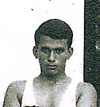 The Master in Charge was Mr. D A Pakianathan and Bentley Barsenbach was the Coach. I recall the training sessions on the rock hard playing surface which had the barest cover of grass. The training regime for fitness was “wind” sprints and boy did we do at least 30 repetitions by 100 metres after a few warm up laps before we got involved in skills drill. Cassim Cader would take us and no one dared challenge him as he was a big fellow and would not put up with any nonsense. I had a pair of “Win It” boots made in England with the metal stops and it was hell running on the hard ground. Bentley our Coach was a character and because of Rugby’s contact nature there was an expectancy that rugby players were tough. As schoolboys having an adult bellow instructions with the odd expletive was quite different to dealing with your teachers. Being a prop I recall many a time when the second row would not get low enough in a scrum. Bentley would roar his instructions and if there was no response from the second row forward, he would grab the waist band of his jock strap, pull it taut in a vertical direction and then release it like an extended rubber band which struck the sweaty back of the second rower with such a stinging sensation that he would instantly get lower when pushing in the scrums. Bentley was a no frills coach and that time Maurice Merrinon from the Southport Club in Queensland was resident in Sri Lanka and played for the CH and FC. He was a big hulk of a forward and his vigorous play and strong running were a highlight in every game. His other characteristic was a white toweling headband. In our team one of our flankers Tarique Bongso moulded his game around Sari de Sylva and Merrinon was a new phenomena and style he wanted to adopt. One day Bongso had got his mother to sew a white toweling headband which he proudly wore to practice to keep his coiffured locks in control. However every few minutes he kept fiddling with it and adjusting it or it would come off in play. Bentley had enough as this was a major distraction to Bongso’s training. In no uncertain terms he shouted at him “Take that f…… thing off or I will wrap it around your bloody neck” which finally saw it disappear for good.
The Master in Charge was Mr. D A Pakianathan and Bentley Barsenbach was the Coach. I recall the training sessions on the rock hard playing surface which had the barest cover of grass. The training regime for fitness was “wind” sprints and boy did we do at least 30 repetitions by 100 metres after a few warm up laps before we got involved in skills drill. Cassim Cader would take us and no one dared challenge him as he was a big fellow and would not put up with any nonsense. I had a pair of “Win It” boots made in England with the metal stops and it was hell running on the hard ground. Bentley our Coach was a character and because of Rugby’s contact nature there was an expectancy that rugby players were tough. As schoolboys having an adult bellow instructions with the odd expletive was quite different to dealing with your teachers. Being a prop I recall many a time when the second row would not get low enough in a scrum. Bentley would roar his instructions and if there was no response from the second row forward, he would grab the waist band of his jock strap, pull it taut in a vertical direction and then release it like an extended rubber band which struck the sweaty back of the second rower with such a stinging sensation that he would instantly get lower when pushing in the scrums. Bentley was a no frills coach and that time Maurice Merrinon from the Southport Club in Queensland was resident in Sri Lanka and played for the CH and FC. He was a big hulk of a forward and his vigorous play and strong running were a highlight in every game. His other characteristic was a white toweling headband. In our team one of our flankers Tarique Bongso moulded his game around Sari de Sylva and Merrinon was a new phenomena and style he wanted to adopt. One day Bongso had got his mother to sew a white toweling headband which he proudly wore to practice to keep his coiffured locks in control. However every few minutes he kept fiddling with it and adjusting it or it would come off in play. Bentley had enough as this was a major distraction to Bongso’s training. In no uncertain terms he shouted at him “Take that f…… thing off or I will wrap it around your bloody neck” which finally saw it disappear for good.
In 1969, we had Vernon (I think was his name) Boteju a former Trinitian who coached us. A rotund much gentler fellow who introduced us to sitting and going through running lines, defensive patterns on a white board and game plans as part of our training regime. Some of the players in that time were Keith Grenier, Richard Ebell, Shafique Wahab, “Potte” Simmons, Tarique Bongso, Bin Sappideen, Azeez, “Kalu” Cader, Tissa Abeydeera, Bryan Wijeyekoon, Leon Ingram, Jeremy Swan, Jeremy Kreltszheim, AHA Cader, Dole and Roger Koch to name a few.
 My most vivid recollection of a game that season was the fixture with St Benedicts College played at Kotahena. After torrential rain for a few days, the Bens ground was a bog. Every scrum was a mud bath and when the hooker struck for the ball you copped a mouthful of mud in your mouth and all through the game you had to clean your eyes. The players had enough and were looking forward to the final whistle as the mud was thick and it stank. When we went back to the changing rooms there was barely a trickle of water from the showers. What do we do? We would have to wear our white shirts and long trousers covered in this fine film of dried mud that smelled something awful. Emir and Iqbal Musafer had invited the team back to their home after the game as they lived in Kotahena and so without wearing our school uniform, we walked to their home with playing gear in one hand and our white shirt and trousers in the other. At the Musafer’s home we had a wash but still the smell lingered from the mud. The reward for putting up with this was the gracious hospitality of Mrs. Musafer. A sumptuous home cooked meal was laid out by her which we all enjoyed and then headed off home. Shafique Wahab was concussed badly in that game and Bryan Wijeyekoon took him home straightaway. Mr. Boteju had a good network of contacts with his Trinity schoolmates and quite often he would bring a leading player like Mohan Sahayam and the late Ian Geddes to assist us at practice.
My most vivid recollection of a game that season was the fixture with St Benedicts College played at Kotahena. After torrential rain for a few days, the Bens ground was a bog. Every scrum was a mud bath and when the hooker struck for the ball you copped a mouthful of mud in your mouth and all through the game you had to clean your eyes. The players had enough and were looking forward to the final whistle as the mud was thick and it stank. When we went back to the changing rooms there was barely a trickle of water from the showers. What do we do? We would have to wear our white shirts and long trousers covered in this fine film of dried mud that smelled something awful. Emir and Iqbal Musafer had invited the team back to their home after the game as they lived in Kotahena and so without wearing our school uniform, we walked to their home with playing gear in one hand and our white shirt and trousers in the other. At the Musafer’s home we had a wash but still the smell lingered from the mud. The reward for putting up with this was the gracious hospitality of Mrs. Musafer. A sumptuous home cooked meal was laid out by her which we all enjoyed and then headed off home. Shafique Wahab was concussed badly in that game and Bryan Wijeyekoon took him home straightaway. Mr. Boteju had a good network of contacts with his Trinity schoolmates and quite often he would bring a leading player like Mohan Sahayam and the late Ian Geddes to assist us at practice.
In the late 50’s and in the 60’s Wesley rugby was in its fledgling years and though there were many talented players we never had the success on the field which would establish our credentials as a top rugby playing like the more fancied rugby playing schools. However in the last fifteen years it is pleasing to note that Wesley has produced some excellent teams and has consistently been at the top of the Schools playing rugby. Congratulations to the Coaching staff and the support from former Old Boys that has lifted the bar to greater heights. Consistent success will surely ensure that Wesley Rugby is treated with respect and the team ranked on par with the more fancied Royal, Trinity, Isipathana, St Thomas’s and St Peter’s College teams. The 50th Jubilee celebrations is a great time to reflect on the father of Wesley rugby Donton D’Abrera, the many players that represented the College and went on to represent the leading Clubs and Sri Lanka, the Coaches and Teachers who dedicated their time and effort for the good of rugby union at Wesley.
Very best wishes to everyone involved with the 50th Jubilee celebrations. I hope it is a great success I am disappointed
 I had the privilege of playing for Wesley from 1962 through to 1964 when I left for Australia after the Cricket season missing the 1965 Rugby season.
I had the privilege of playing for Wesley from 1962 through to 1964 when I left for Australia after the Cricket season missing the 1965 Rugby season.
My most vivid memory was my first practice session where I tackled a player and had his boot in my face. Going home with a black eye I told my mother a former teacher at Wesley that I got hit at hockey practice which I had been given permission to play. She took me to hospital and had a spirited argument with the doctors on the preferred treatment for her son, much to my embarrassment. Sons of teachers have a cross to bear!! Ask Bryan Wijeyekoon the President of Wesley OBU in Australia!!!
The 1963 season was led by Jayantha(Jadi) de Silva and 1962 by Sin Sen. In 1964 Wesley was led by C.U.Chang a slashing stand-off with Bashurdeen Musafer the Vice captain who went on to be a Sri Lanka representative along with Reginald Bartholomeusz the premier Wesley Rugby player of our time.
One of the many incidents that stands out in my mind was the Colombo School trials in 1964 at Longdon Place. The Royalists and Thomians were determined to exclude the Wesleyites from the combined team and the ball was not passed to a Wesleyite in the back line. Bashur decided to take action, took a pass meant for a Thomian ran the length of the field to score and was picked in the side. I was an interested spectator on the wing!!
Playing with speedster Reggie Bartholomeusz, full back Nigel Christoffelsz, C.U.Chang and Bashur Musafer was certainly a great privilege. St.Thomas’ at Mt.Lavinia was a challenge with the sea breeze pushing the ball well across the field, so as full back I would have to kick well out of the field to get the ball back in play. Shari Musafer tackled a Thomian forward as he jumped in the lineout and then retired behind me at full back to avoid being murdered by this gorilla.
Rugby at College was a fantastic experience. There is nothing better in sport than taking a ball on the run and flying down the field avoiding the opposition. No wonder they call it the game played in heaven!! Wesley was in a development stage when we played for College. The current batch of Wesley rugby players have done us proud and we need to provide them with support. The Double Blue Trust is an initiative that needs all our support as this could provide the financial backing for all aspects of College endeavours which will re-establish Wesley as the premier educational institution in Sri Lanka.
By Neville Ludowyke (Melbourne, Australia)
 The most enjoyable Rugby game that I have had the privilege to play in was way back in 1959 in the shadow of the Bogambara Prison at Kandy.We had travelled by train to Kandy and were most disappointed as the heavens had opened up and it had rained non stop for a few days with no signs of abating. The whole team including our pioneer coach Dalton DÁbrera shared the same view that the game would have to be abandoned.
The most enjoyable Rugby game that I have had the privilege to play in was way back in 1959 in the shadow of the Bogambara Prison at Kandy.We had travelled by train to Kandy and were most disappointed as the heavens had opened up and it had rained non stop for a few days with no signs of abating. The whole team including our pioneer coach Dalton DÁbrera shared the same view that the game would have to be abandoned.
On arrival at the Bogambara grounds we wondered where the Rugby ground was because the only things visible were the Goal posts and the pavilion, the ground being completely submerged with about three to four inches of water with no grass in sight. We decided we would play regardless of the risk of injuries and the game got underway though at a very much slower pace than normal.
Within minutes The Trinity Lions were 14 points ahead and the Double Blues were yet to score. A very original and wise decision was made by our Captain T.S Saldin who was also an excellent Soccer player. His plan and instructions were to avoid handling the greasy and heavy ball but to kick , kick and kick the ball anywhere and everywhere, in other words to “hack” the ball and play soccer which we certainly did.
Trinity were baffled and had no answer to this type of game it was not the pure rugby they had been brought up on and trained hard at. This was blasphemy and sacrilege of the game played in heaven. We were initially uncertain of what to do but quickly adapted and kept hacking the ball about and it certainly saved us from a most embarrassing defeat. We were also not tackled as much by the ‘Lions’, who kept knocking on trying to field our wild kicks ahead and eventually had to resort to falling on the ball and hope their forwards could secure possession.
The Lions side was a formidable one; skippered by Eric Roles, it included the two De Sylva brothers R.T & S.R and Jayantissa Ratwatte to name a few players of this star studded side. Amongst the other questionable tactics we engaged in was when we went down for a scrum we dug our heels hard into the ground and while keeping our eyes and mouths closed we continued stamping hard while the scrum continued , the Lions kept getting the Bogambara mud in their eyes, mouths and noses. They certainly had problems to overcome.
Chang Sin Sen our oversize ‘prop’ who was 199 pounds at 17 years of age was given permission by our coach to visit his relatives in Kandy and they had given him an enormous feed, which Sin Sen had gorged himself on. When the scrum went down - Sin Sen was still half the field away. This meant Rodney DeKretser our open side wing forward had no option but to play as prop, leaving us a man down in each scrum. There were only a couple of occasions that Sin Sen managed to arrive at the scrum, but only in time to bind as a flanker.
When the final whistle sounded the Double Blues had gone down fighting and lost the match 14 – Nil, the same score as at the 15 minute mark. The Trinity lions congratulated us on the tactics we adopted in such trying conditions as they should have beaten us by a cricket score margin, having had an excellent start. Our Coach got stuck into Sin Sen in no uncertain terms – “….you know we could have won that match and I regret having given you the permission for you to visit your relatives….. Why did you eat like a pig?”
Just before we put our heads down for the night the writer had booby trapped the bed of Dubby the coach in order that it would collapse.
Dubby’s final words for the night were “… boys a lost opportunity and lights out now , for a good nights sleep.”…….. and he went crashing to the floor ! He was not impressed and retribution was to follow. On the return train journey there was a group of team mates who were having a smoko in another compartment and he singled me out and said “Neville come here, I saw you smoking” , which I hadn’t done and made me sit next to him for the entire journey back to Colombo.
Many years later I caught up with Dubby in Sydney as one of my former girl friends was married to his nephew. We reminisced about the old days and dwelt nostalgically on the Bogambara match of ’59. Dubby learned his rugby from the book but his interest and dedication was always evident and he was so proud and was heard loud and clear when numerous boys he had coached graduated to play rugby at Club level.
"If only GOLUWA had kicked the first penalty", "DAYA should have tackled the winger”, “TREVOR should have gone blind side", "JADI didn't jump in the line outs". These were some of the comments heard on the Wesley side after Trinity had inflicted a 36 to nil drubbing on us the last time we met. It was now the next year and it was my final year of School Rugby. Wesley had a fairly good team and we were due to beard the Trinity Lion in its own den in the hills of Kandy. The game was on a Saturday, when on the Thursday I was informed by our Captain' JADI' that I was dropped from the team, as I had missed three weeks practice, when ill with Chicken Pox. I was thoroughly disappointed as I wanted to play in that game so much. I had attended the last week's practice but obviously they felt I lacked fitness and form.
However on Saturday morning, along with five or six other pals I boarded the train at Fort station to travel to Kandy to watch the game and support the team. The train soon departed and after some deep and meaningful conversation on the relative merits of All Saints, Methodist and Kandy Convent girls, we each settled into our seats. I retreated behind the pages of my chemistry text, determined to do some 'cramming'. The engrossing prose of the text and the motion of the train lulled me to sleep. I awoke at Kandy and we made our way to Bogambara.
The second fifteen match was in progress and we walked towards the far side to chat with our team before the big game. Walking into the dressing room I was amazed at the reception we received. 'JADI" flung his arms around me and in his gravely voice said "Quick Machan, change. You have to play". We soon found out that half the team had sneaked out last night to Kandy town for a feast at both the Lyon Cafe and the Muslim Hotel. The cultural clash in their stomachs had made them all violently ill. Five were still in the Trinity sick room, feeling very sorry for themselves. A quick whip around and we were equipped and attired to meet the mighty Trinity Lions.
The match got underway and Trinity scored from the kick-off but missed the conversion. Trinity threw everything at us and if not for our dour defence they would have crossed the line frequently. Just before half time they scored again by the corner flag but once again
they missed the extra points. Half time saw us tired but still defiant, contemplating a 6-nil score. While we sucked on oranges, 'JADI' delivered a stirring pep talk, filled with dire threats to anyone who as he put it "shirked their duty to College". CHANG, ever the diplomat, promised all of us a special treat if we managed to at least stop Trinity from scoring again. All this talk was to no avail as within five minutes of the restart, the Wesley defence was breached and another unconverted try by Trinity boosted the score to 9-nil.
Wesley then by a series of wild hacks which shocked the Rugby purists, ended up with a scrum feed five yards from the Trinity line. Due to a quick strike by the Trinity
hooker against the head, the ball shot out of their third row and all our scrum-half had to do was fall on the ball and we had scored. The extra points were added and the score was 9-5, still in Trinity's favour. This revitalised the Wesley team and not only did we tackle Trinity to a standstill, we were actually attacking. Trinity however proved they were equally good at defence as they were in attack. The clock was ticking over and we realised that we would lose. Then a Trinity clearance did not go into touch and our inside centre 'BASHI' collected it and broke away closely followed by me on his outside. He had only the full back and the corner flagging lock forward to beat. Both defenders went for 'BASHI' and to my horror, he seemed to go straight for them and did not seem to want
to pass. As soon as he neared them, they both launched themselves at him. 'BASHI' turned around and passed to me, I only had to run about 10 yards. Just as I crossed the line, I was hit by an enormous bone crunching tackle from behind, but I had scored. Wesley 8 - Trinity 9. Our fullback took the kick from a difficult angle and the hushed crowd watched the ball sail over the cross bar. NIGEL had his kicking boots on and Wesley had hit the
front. Soon after the re start the sound of the referee's whistle signalled full-time. WESLEY HAD WON BY ONE POINT a fantastic result. I was surrounded by jubilant team mates and we walked off the ground - proud victors. Rugby history had been made - the first Wesley team to beat Trinity and in the 'Lions Den' at that. I was suddenly slapped heavily on my sore shoulder and a voice yelled in my ear - "Wake up,- we have reached Kandy". I quickly gathered up my belongings and my thoughts and slowly walked along the railway platform at Kandy station - such is the stuff that dreams are made of!!
 I starting coaching the rugby team at Wesley College around April 1971 when the country was in a crisis with the Insurgency. Initially we did not have many boys turning up at practice, but the guys who came were very keen and made me feel quite at home and brought back many memories of my own days at Wesley.
I starting coaching the rugby team at Wesley College around April 1971 when the country was in a crisis with the Insurgency. Initially we did not have many boys turning up at practice, but the guys who came were very keen and made me feel quite at home and brought back many memories of my own days at Wesley.
The majority of the boys did not have boots or jerseys. The faithful groundsmen Wilson and Charlie were glad to see me back doing what I loved most, playing Rugby. The years went on and the teams improved, the attendance also improved and the boys were beginning to enjoy the game and were highly competitive. I was a fair coach but discipline was a priority, I used to check if any of the boys had smoked before they come for practice and any one was caught they had to do extra laps to get fit. I was playing at the time and fitness was necessary and I made sure that I got them fit. When I started some of them could not do 10 sit-ups but when I finished they were doing 50 non stop. I always maintained if you are fit you enjoy your game better and you play better. The boys did not believe me at the time, but as they went on the found out that it was true.
A few years after I took over, I arranged with Wilson to get some beef bones from the Borella market and cook a tasty soup, not just for nourishment, but to get the players to bond and talk about what they have done on the Rugby field . To my amazement the number’s got bigger and the pot of soup grew larger . It not only brought the players closer together but it gave Wilson more work.
I can remember another year I think it was 1980 when Bachchi Oumar was Captain, he and I decided to have a 3 day camp at college and got permission from Mr Wirasinha for the boys to stay in the Hostel. It was during school holidays and we had the kitchen staff to cook the boys their meals including steak and vegetables which the boys relished, instead of the regular rice and curry.
These are the boys who Captained the rugby team during my coaching days.
1972 (can someone please let Keith de K know)
1973 Vino Joseph
1974 Iqbal Musafer
1975 Treherne Keil
1976 Roney Oumar
1977 Yohan Raju
1978 Rashmore Ferdinands
1979 Ajith Uwais
1980 Bachchi Oumar
1981 Bachchi Oumar
Iqbal Musafer went on the play for the CR &FC and Captained CR in 1982 and played for the President’s XV that same year. Yohan Raju, Roney Oumar, Bachchi Oumar, Zubair & Fassy Doray all played for the CR Bees and CR & FC. Zubir played for SriLanka in the 1980’s. Iqbal Uduman, Ajith Uwais, Treherne Keil, Rashmore Ferdinands played for Havelock’s B team and a few games for the 1st XV. Unfortunately a few years ago young Fassy Doray passed away.
Those 10 years gave me great pleasure and the later years watching these boys playing at the highest level of Rugby in the country made me feel so proud of them all.
Here is an article written by Bachchi Oumar Captain 1980 - 1981
 Our whole extended family consisted of rugby fans. During the 1970s, Roney, my dad, my older cousins and other childhood friends regularly attended rugby games. It was a weekly ritual to meet everyone at the Bamba flats (where my aunt lived) and then proceed to the games. Even before I reached my teens, I remember establishing myself as an ardent CR & FC fan. At that point I had firmed up my intentions of wanting to be a rugby player, represent Wesley and someday represent CR&FC.
Our whole extended family consisted of rugby fans. During the 1970s, Roney, my dad, my older cousins and other childhood friends regularly attended rugby games. It was a weekly ritual to meet everyone at the Bamba flats (where my aunt lived) and then proceed to the games. Even before I reached my teens, I remember establishing myself as an ardent CR & FC fan. At that point I had firmed up my intentions of wanting to be a rugby player, represent Wesley and someday represent CR&FC.
I remember playing rugby with other kids at the CR&FC grounds after each game. This was full contact rugby at the ripe age of 8 or 9 years of age. I vividly remember playing with Zubair and Fassy Doray – their father was the president of the club so we had access to rugby balls, drinks and of course food. It was comforting for me to eventually have Zubair and Fassy as my team mates at Wesley College and at CR&FC.
My interest in rugby followed further after Ro Here is an article written by Bachchi Oumar Captain 1980 - 1981
RUGBY, The Ultimate Team Sport By Bachchi Oumar, USA
 Our whole extended family consisted of rugby fans. During the 1970s, Roney, my dad, my older cousins and other childhood friends regularly attended rugby games. It was a weekly ritual to meet everyone at the Bamba flats (where my aunt lived) and then proceed to the games. Even before I reached my teens, I remember establishing myself as an ardent CR & FC fan. At that point I had firmed up my intentions of wanting to be a rugby player, represent Wesley and someday represent CR&FC.
Our whole extended family consisted of rugby fans. During the 1970s, Roney, my dad, my older cousins and other childhood friends regularly attended rugby games. It was a weekly ritual to meet everyone at the Bamba flats (where my aunt lived) and then proceed to the games. Even before I reached my teens, I remember establishing myself as an ardent CR & FC fan. At that point I had firmed up my intentions of wanting to be a rugby player, represent Wesley and someday represent CR&FC.
I remember playing rugby with other kids at the CR&FC grounds after each game. This was full contact rugby at the ripe age of 8 or 9 years of age. I vividly remember playing with Zubair and Fassy Doray – their father was the president of the club so we had access to rugby balls, drinks and of course food. It was comforting for me to eventually have Zubair and Fassy as my team mates at Wesley College and at CR&FC.
My interest in rugby followed further after Rodney, my brother, chose to take up the sport. I remember showing up for full practice with the college team when I was 11 years old in 1974. I didn’t allow my age nor my size to deter me from getting involved with the sport at that ripe age. I remember playing 2nd XV with much bigger players than I at age of 11 and continued to play the following year as well. In 1976, under Roney’s captaincy, I was promoted to the 1st XV team. It was a huge boost of confidence for me to represent Wesley and also to play with my brother who was 5 years older. I may have been the youngest to play scrum half at age 13 for the 1st XV team.
From 1976 to 1981 I matured as a player and gained a lot of confidence and experience playing with much older players. The teams we fielded in 1976 and 1977 were competitive, but not competitive enough to win against formidable teams such as Royal College, Trinity College, St. Thomas and St. Peters. But we sure did have a lot of good memories and great friendships.
Wesley College Rugby XV 1977
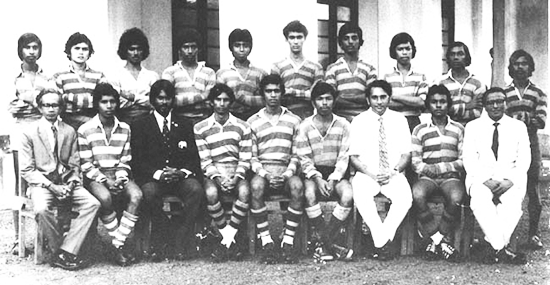
Seated Left to right : Mr Dunston Fernando (Vice Principal), Paul, Reg Bartholomeusz, Iqbal Ahamat (Vice Captain), Yohan Raju (Captain), Rohan Oumar, Mr M.A.P Frenando (Master In charge), Mr A.S.Wirasinghe (Principal)
Absent - Ransil Wijeysinghe.
Finally in 1978 we were fortunate to assemble a team with right chemistry and skill levels. Our forwards consisted of strong willed individuals who gelled and played as a cohesive group and the tackling was superb: Iqbal Uduman, Anil Perera, Ajith Uvais, Reza Kamaldeen, Rashmore Ferdinands, Anura De Alwis, Andrew Asirivatham and Ajith Dias. Our backs were strong, fast and ruthless. Sherad Mustafa was great as a stand-off – he was able to scoop up all my errant passes and still feed the back line with good ball. Further, he possessed important attributes that all good stand offs had – intuition, skill and ability to read the game. The centres consisted of Faisal Bongso and Shehan Nanayakkara – Faisal always found the gaps and fed Shammy Rajendra and Miki Kaleel in the wing. Shehan Nanayakkara was a great tackler; he hurt a lot of opposition players by his hard tackles. Of course, our rock at full back, Zubair Doray was great. 1978 was a successful season and we all enjoyed playing the game.
Rugby Team 1978
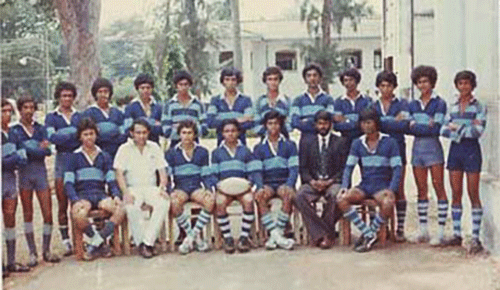
Sitting L to R; Gulam (bachi) Omar, Mr MAP Fernando , Shihan Nanayakkara , Rusmore Ferdinandz(Capt) , Ajith Uwais , Mr Reg Batho, Musthafa
The lessons learned playing the game of rugby has positively impacted on my scholastic life at Wesley College as well as my nine years at the University of Montana. I played for the “Maggots,” a city team in Missoula, Montana, for 10 years. In Montana I also consistently refereed local rugby games. I was fortunate to meet so many wonderful people from around the world who loved the game. Reviewing my skill level, drive, leadership and all other attributes needed to compete in the US, I realized what was most important were the skills I learnt since my early teens at Wesley College.
Reg, you have been my coach since I started rugby in 1972 at age 10. I started playing for the 2nd XV team in 1975 at age 12. Then proceeded to play 1st XV from 1976-1981. All along you were my idol and I have watched you play in all the CR&FC games as well as the games you represented Sri Lanka. You showed skill, toughness and gamesmanship and all attributes to be a true rugby player. You have been the reason for my success in rugby at Wesley College as well as at the club level. You have also instilled in me the value of friends and friendships – an important ingredient I aspire to. So it will be very important for you to attend this function in Sri Lanka and represent all the players you have coached and inspired over the years. You have been such an inspiration to me and I wish I was there to celebrate the 50th anniversary in Colombo with you.
ney, my brother, chose to take up the sport. I remember showing up for full practice with the college team when I was 11 years old in 1974. I didn’t allow my age nor my size to deter me from getting involved with the sport at that ripe age. I remember playing 2nd XV with much bigger players than I at age of 11 and continued to play the following year as well. In 1976, under Roney’s captaincy, I was promoted to the 1st XV team. It was a huge boost of confidence for me to represent Wesley and also to play with my brother who was 5 years older. I may have been the youngest to play scrum half at age 13 for the 1st XV team.
From 1976 to 1981 I matured as a player and gained a lot of confidence and experience playing with much older players. The teams we fielded in 1976 and 1977 were competitive, but not competitive enough to win against formidable teams such as Royal College, Trinity College, St. Thomas and St. Peters. But we sure did have a lot of good memories and great friendships.
Finally in 1978 we were fortunate to assemble a team with right chemistry and skill levels. Our forwards consisted of strong willed individuals who gelled and played as a cohesive group and the tackling was superb: Iqbal Uduman, Anil Perera, Ajith Uvais, Reza Kamaldeen, Rashmore Ferdinands, Anura De Alwis, Andrew Asirivatham and Ajith Dias. Our backs were strong, fast and ruthless. Sherad Mustafa was great as a stand-off – he was able to scoop up all my errant passes and still feed the back line with good ball. Further, he possessed important attributes that all good stand offs had – intuition, skill and ability to read the game. The centres consisted of Faisal Bongso and Shehan Nanayakkara – Faisal always found the gaps and fed Shammy Rajendra and Miki Kaleel in the wing. Shehan Nanayakkara was a great tackler; he hurt a lot of opposition players by his hard tackles. Of course, our rock at full back, Zubair Doray was great. 1978 was a successful season and we all enjoyed playing the game.
The lessons learned playing the game of rugby has positively impacted on my scholastic life at Wesley College as well as my nine years at the University of Montana. I played for the “Maggots,” a city team in Missoula, Montana, for 10 years. In Montana I also consistently refereed local rugby games. I was fortunate to meet so many wonderful people from around the world who loved the game. Reviewing my skill level, drive, leadership and all other attributes needed to compete in the US, I realized what was most important were the skills I learnt since my early teens at Wesley College.
Reg, you have been my coach since I started rugby in 1972 at age 10. I started playing for the 2nd XV team in 1975 at age 12. Then proceeded to play 1st XV from 1976-1981. All along you were my idol and I have watched you play in all the CR&FC games as well as the games you represented Sri Lanka. You showed skill, toughness and gamesmanship and all attributes to be a true rugby player. You have been the reason for my success in rugby at Wesley College as well as at the club level. You have also instilled in me the value of friends and friendships – an important ingredient I aspire to. So it will be very important for you to attend this function in Sri Lanka and represent all the players you have coached and inspired over the years. You have been such an inspiration to me and I wish I was there to celebrate the 50th anniversary in Colombo with you.
Aussie coach Dwyer present at Wesley's rugby banquet By Richard Dwight
 Banquet: Arriving in Sri Lanka to be present at Wesley's celebrative "Golden Jubilee Rugby Banquet", that takes place on the evening of Sunday, September 24, at the Trans Asia Hotel - will be the widely acknowledged, Bob Dwyer, the famed Australian rugby coach extraordinaire.
Banquet: Arriving in Sri Lanka to be present at Wesley's celebrative "Golden Jubilee Rugby Banquet", that takes place on the evening of Sunday, September 24, at the Trans Asia Hotel - will be the widely acknowledged, Bob Dwyer, the famed Australian rugby coach extraordinaire.
Dwyer, as the guest of honour, will make the keynote address at this historic occasion of Wesley's rugby and, what he has to say, would be most interesting, to be thought provoking not only to those of Wesley's rugby fraternity, but to others present as well.
His coaching the Wallabies, was well sustained spanning a period of ten years from 1982 accounting for 150 games and 74 test matches, inclusive of Australia's first World Cup victory in 1991.
Dwyer is spoken of as the longest serving and most successful coach in Australian rugby history that evoked comment from Stephen Jones chief rugby writer of the London Sunday Times, as "perhaps the finest coach the game has ever seen.
Apart from being a rugby coach he is also an accomplished electrical engineer, Company Director and businessman, whose approach to Management was featured in Marketing magazine in the following terms "He managed it not by bravado, charisma and hallow hype, but via a methodical management process that can be applied to managing a team".
Many of his pronouncements are frequently quoted by rugby commentators around the world and, one amongst them a gem is "Practice doesn't make perfect. Only perfect practice makes perfect".
Dwyer was awarded the centenary medal by the Australian Government in 2003 for his services to rugby union and an order of Australia the following year for his contribution to sport and the community, his winning strike rate with the Wallabies which was 70 per cent makes him the most successful coach in Australian rugby history.
His visit to Wesley College and the ruggerites in particular, will be a source of encouragement that will spur them on.
I was at Wesley in ’56 when Mr. Dabrera (“Dubbie” - our Physics and Applied Maths master) got together a team around a (genuine) rugby player by the name of Buell who had played for Royal and had transferred to Wesley (never found out why!) that year. Anyway, the team comprised of chaps like Noel Bevan, Neville Perera, Shanthi Perera, Sayban Samat, Abeydeera, George Siebel, the Rajasingham twins; L.R. & S.M., Buell etc (hopefully, someone will fill in the blanks, caused by my failing memory!). After a few games into the season, injuries took their toll and the team was short of players for the game against Trinity. Guess who was coerced into playing!!! I played “inside centre” and had to mark Ken De Joodt and Sena Sylva. Trinity, captained by David Frank, won handily 35-0 but for a rookie team against one of the strongest teams that Trinity ever fielded, we put up a good fight. Virtually every player on that Trinity team went on to play for Sri Lanka including Nimal Maralande, Wilhelm Balthazaar, Raji and Sena Sylva, Mike de Alwis, Canto Peiris, Uvais Odayer, Ken De Joodt.
Olkie

This photo was taken in 1972 of SRI LANKA and HONG KONG at Longden Place
SEATED: ABDUL MAJEED(CAPT), JEFF RATNAM, HADJI OMAR, KAMAL RATNAPALA, GLEN VAN LANGENBERG, TYRONE HOLDENBOTTLE,
ON GROUND: OMAR SHERIFF, BASHUR MUSAFER, CAVAN GAUDER, VIPER GUNARATNE
Sent by Olkie Edema (Canada)
Perhaps the best cricket team that Wesley ever had – I believe it was in 1952/3. I had joined Wesley the year before (from S Thomas’ Prep). I took this photo of a picture hung up in the old Wesley pavilion, while in SL earlier this year.

Incidently, A.V. Fernando was still coaching Wesley when I played. At an ‘end of season’ party (at Lorenz Ebert’s place) he came over to me, put his arm around my shoulders and said “Olkie, in my opinion, you’re the finest bowler that Wesley has had”. The only problem…. A.V. was blind drunk at the time!! Poor chap died from either cirrhosis or a heart problem not long after.
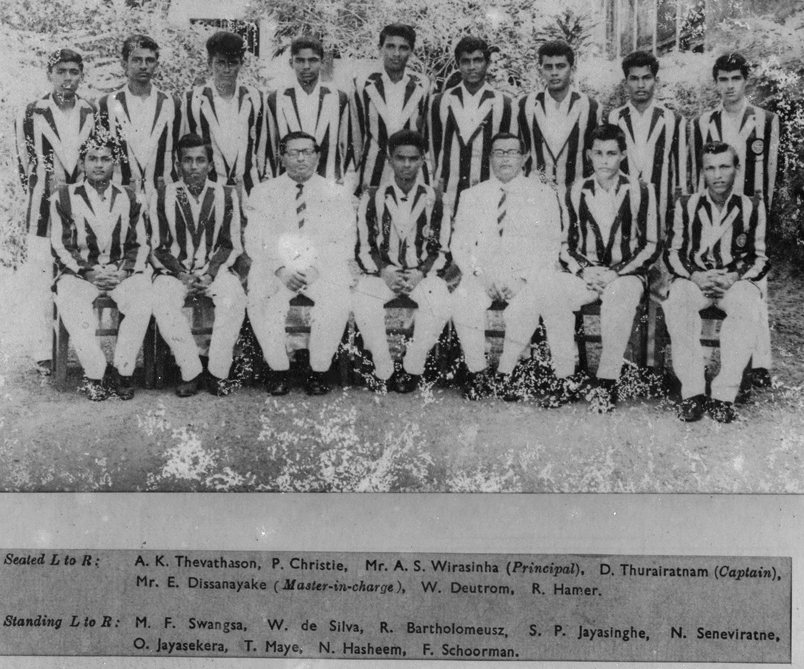
Sent by Michael Christoffelsz
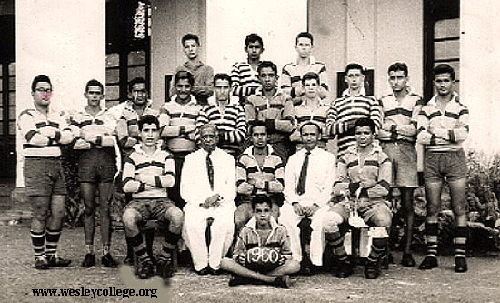
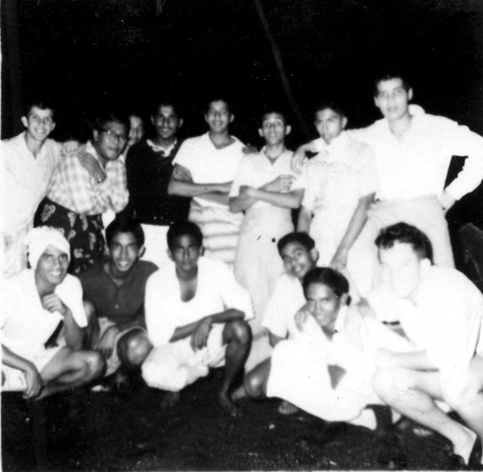
Trevor Gunasekera is in the front row second from the left, the others in the photo are Front row from L to R, Maurice Weeraperumal,Golu, Zam Lameer, Jai Lameer, Rodrigo, and Beverley Denneis, Back Row L to R, myself, Sin Sen, ??, Haig Maloney, Daya Perera, ???, Gagool Wright and Brian Weeraperumal. The picture was taken in April 1960 after we played Trinity College in Kandy and Dubby had fallen asleep and we decided to go out on the town.

 It would be unfair if Wesleyites old and young were not reminded or if they are allowed to forget the achievements of one of the most talented cricketers produced by Wesley College – Chandran Perera.
It would be unfair if Wesleyites old and young were not reminded or if they are allowed to forget the achievements of one of the most talented cricketers produced by Wesley College – Chandran Perera.
The star studded 1962 team captained by Lalith C.R.Wijesinghe returned almost unbeaten with two huge victories having disposed of two of the strongest school teams – Ananda under the then schoolboy International all rounder Sarath Wimalaratne and Royal under Darrell Lieversz. Wesley cricket was back and popular.
This side had in 1962 beaten St. Joseph’s, Kingswood and Richmond and Trinity. They had lost to St. Peter’s on the Bambalapitiya minefield and had St; Thomas groping to avoid defeat. It had not been since Wesley with the Claessens Brian, Radley and Herman, the Fuards Ansar and Abu and the Adihettys Lou and Vincy that the school team had impressed so much.
 Wesley was riding the crest of school cricket’s giant wave. A climb we had been making since Sentil Sinniah and Daya Kodithuwakku's seasons as captains. Therefore in the third term of 1962 we, juniors, were only aiming to find places in the second eleven team then captained by ‘Tiptop’ Falih, the smartly attired. Most of my Under 16 team mates had graduated in to the second eleven and matched Royal College without flinching. However I was ‘out’ of even the second eleven side. To me it seemed the end of the line where school cricket was concerned and as such I was pleasantly surprised when Master in Charge Mr. Edmund ‘Pigeon’ Dissanayake asked me why I had missed a week’s cricket practice during the holidays. I pinched my self. Was he pulling my leg or was I really as invited to practice with the big boys?
Wesley was riding the crest of school cricket’s giant wave. A climb we had been making since Sentil Sinniah and Daya Kodithuwakku's seasons as captains. Therefore in the third term of 1962 we, juniors, were only aiming to find places in the second eleven team then captained by ‘Tiptop’ Falih, the smartly attired. Most of my Under 16 team mates had graduated in to the second eleven and matched Royal College without flinching. However I was ‘out’ of even the second eleven side. To me it seemed the end of the line where school cricket was concerned and as such I was pleasantly surprised when Master in Charge Mr. Edmund ‘Pigeon’ Dissanayake asked me why I had missed a week’s cricket practice during the holidays. I pinched my self. Was he pulling my leg or was I really as invited to practice with the big boys?
When I did go for practice, I was impressed by the big names, Milroy Muthuvaloe, Darell Maye, ‘Bacha’ Fuard, Sarath ‘Monkey’ Wickremaratne, Rodney Perera and Milroy Jebarajah - impressed enough not to try to make conversation. The only one who condescended was Mervyn Hamer with a nodded “hello”. Mervyn turned out to be the friend we could go to for advice.
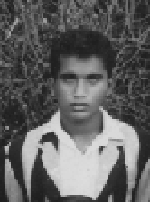 We the juniors changed in “the fresher’s corner” (behind the old bar or the bathrooms) and for company I had my bosom pal Donald Thurairatnam (skipper of the under 16 and promoted like me).
We the juniors changed in “the fresher’s corner” (behind the old bar or the bathrooms) and for company I had my bosom pal Donald Thurairatnam (skipper of the under 16 and promoted like me).
The seniors had their own dressing room and woe be unto a fresher who dared venture there. There was a lot of banter among them that we were not invited to.
Thurai and I noticed seated quietly in a corner in the main pavilion the “duck tailed" boy we would notice on the school corridors. We knew him as Chandran Perera, two classes senior. After the rituals of the “rounds around the grounds” Milroy Muthuvaloe knocked up the fielding practice while we wrung the ache out of our palms and fingers.
Mervyn Hamer got padded to face Darell Maye, Everard Schoorman and the new ball.
The “new boy” Chandran Perera, then, had no right to the new ball reserved traditionally to the quick bowlers of repute. Even with an ancient apology for a cricket ball Chandran had Mervyn Hamer defending and nodding approval. This was a sign that Chandran had something that mattered. Milroy Jebarajah, Skipper Muthuvaloe, Schoorman, Sarath Wickremaratne and Bacha Fuard in their turn were impressed.
They seemed to accept Chandran, but somewhat grudgingly, I felt. When that season started, Chandran was rarely called upon to deliver. He played in the third term games and was allowed "a bowl".
Darell Maye and Everard Schoorman smashed Owen Mattau's Kingswood with one day to spare. Then we had St. Peter’s on the back foot and a match drawn. If Warne's first ball was something of a miracle then Darrell Maye's in swinger to Peterite opener Chris Harridge was a peach. Harridge was bamboozled by one that came back square like a leg break. Milroy Jebarajah walked after the umpire had said "not out" to a ball he felt he had touched. Peterite all rounder David Heyn on the other hand sulked and was booed after being given out. David was a fighter and one of the nicest people I played with or against. The Thomians cats were “belled" in Mount Lavinia despite playing with home advantage and having very lenient umpiring decisions. At Asgiriya there were big scores and replies.
At Campbell Park we had St. Joseph’s for 65 and then struggled to save defeat with leg spinner Cliffy Rodrigo bravely defending against Joe skipper Brian Perumal’s left arm hurricane that left Wesley tottering at 28 for 7 in the second innings. In Galle, we finished Richmond off before lunch on the second day the match without the scientists Jebarajah and Muthuvaloe who had a Chemistry Paper which had leaked in Jaffna to sit for!!!!!!!! We banged Ananda into submission but had to be satisfied with a draw. Muthuvaloe's piercing cut shots and cover drives brought him the hundred that evaded him for almost five years - The skipper's ton.
In 1964, I found new Skipper Everard Schoorman’s confidence in me easier to handle when Chandran was bowling with me. He swung and seamed the ball away from the right hander; I spun it back into them. I picked up the wickets after he had toyed with the best of batsmen.
With Mervyn Hamer conducting the orchestra and Schoorman playing policeman from mid off, life for a fresher was easy.
We mauled Kingswood, had the Peterites guessing and before our batsmen were swamped by David Heyn's seam bowling at Bambabalapitiya. I had five for 21 in the second, Chandran 5 for less in the first innings.
Then came St. Joseph’s and the match I will never forget. The Joes Under Birchman de Alwis, with Polycarp Wijeysuriya, Christo Moreira and Allan de Costa posted 250 plus before they declared. We were in dire straits at close on day one with 58 for 5 and the best gone. When William Deutrom walked back in the score for 9 wickets was 91. Everard Schoorman in earshot told the openers Mervyn and 'Jebs' to pad up because the follow on to him was a forgone conclusion. I thought differently, and fortunately so did Chandran.In a mid wicket conference he told me to hang on and he would try to make as much as he could. It seemed easy listening to him, so I dug in. I made ten in one hour with one edged boundary. Chandran made 62 and must have smashed three sixes at least putting the barber saloon’s customers on Darley Road at great risks. Our partnership of 78 was a record for the last wicket going past Lou Adihetty's Maxie De Silva and L. Wickramasinghe for Wesley in 1955 against Clive Inman and St. Peters. That match however was drawn.
Chandran went on to make seventy two in the second innings then he and William Deutrom made the runs to give Wesley a two wicket win.
History seemed to be repeating itself - Derrick Ingram and Mervyn Hamer years earlier.
Chandran Perera was never discussed when Wesley’s cricket 'historians' like Watson Wijeywickrema and some other pseudo intellectual luminaries held the OWSC floor after " spirits were high” evenings where the school's heroes were discussed.
There were players who were more flamboyant, louder than life people who mattered more – or did they?
Wesley treated Chandran Perera as a hero for a day or more like for a few hours. He never asked for much so for him it did not matter. He gave a lot. Today his name appears on the records but once, yet he was not a bits and pieces cricketer. He was an all rounder who could catch, throw, bat and bowl better than many and most.
He was a situation man who batted down the line instead of where he should have - on top.
Most important to me was that by his quiet ways he could inspire. We would cross at the end of overs and a word from him was enough to realise that I was bowling well or messing up.
The next year 1965, Thurairatnam and I were like the “Babes in the Wood” lost without Mervyn Hamer, Everard Schoorman and Chandran Perera.
This, however is no excuse for being vice captain of the second worst team Wesley ever had in the sixties or in her history. The 1966 did even worse. This was the side I was supposed to captain!!!
By Bruce Maurice
 In town on a brief holiday is Darrel Maye, back ‘to touch the green, green grass of home' from ‘Down Under.' Darrel Maye was an outstanding sporting product of Wesley College turning out for the college with much distinction in cricket, athletics and hockey during the period 1959 to 1963. Arguably he was on par, if not the best of the schoolboy cricketers during his era. An opening bowler, magnificent batsman and superb close in fieldsman he was the cynosure of all eyes each time he walked onto the field.
In town on a brief holiday is Darrel Maye, back ‘to touch the green, green grass of home' from ‘Down Under.' Darrel Maye was an outstanding sporting product of Wesley College turning out for the college with much distinction in cricket, athletics and hockey during the period 1959 to 1963. Arguably he was on par, if not the best of the schoolboy cricketers during his era. An opening bowler, magnificent batsman and superb close in fieldsman he was the cynosure of all eyes each time he walked onto the field.
Speaking to the Daily Mirror Darrel was of course the modest man that he always was and was rather reluctant to single out his achievements that made Wesley College a force to be reckoned with in inter school cricket. However, he did mention it was an honour to wear the double blue cap and gave all credit to B.J.H. Bahar their coach, who moulded and guided the careers of many players including him and instilled in them the principles of fair play and discipline, which Darrel has found to be an asset not only during his playing days but also in real life situations.
Consistency was the keyword of Darrel's brilliant cricketing career and 1963 proved to be the pinnacle of his schoolboy career as a cricketer. A few of his outstanding feats were when he single handedly demolished the mighty Royal College team in 1963 taking five wickets for 49 runs that saw Wesley romp home winners quite convincingly.
In fact one newspaper headline of the previous day screamed “Lieversz versus Wesley,” for at that time another Darrel, this time Lieversz, was also in the forefront of school cricket and was deemed a terror with the leather who was capable of undoing any school team. Royal were at their peak remaining unbeaten but met their ‘Waterloo' in Darrel Maye who had other ideas and turned in a dream performance with both bat and ball to scuttle whatever hopes Royal had of keeping their unbeaten record intact. Another of Darrel's recollections was how Wesley defeated Kingswood College in one day. Another batting ‘double' that is worthy to be recalled are his knocks of 88 and 40 against St. Peter's also in 1963.
The year of 1963 was indeed an eventful one for Darrel and his crowning glory was when he was chosen the Times of Ceylon Schoolboy Cricketer of the year and the Best Allrounder by the Ceylon Observer for his fantastic achievements that year where he amassed over 600 runs and captured 43 wickets.
In 1964 he joined the Colts Club and playing alongside stalwarts Abu Fuard, Nihal Samarasinghe, the late W. Premaratne and Brian De Silva, did yeoman service for the club in the P. Saravanamuttu Trophy competition.
He was entrusted with the captaincy of the first XI team in the mid 60's and led them with distinction. During this period he secured employment with the Hong Kong and Shanghai Bank and led them in the mercantile cricket tournament from the front in cricket, soccer and athletics and won the coveted Bank's Sportsman of the Year Trophy for three consecutive years – 1965.'66 and '67.
In the 1970's Darrel threw in his lot with Silly Midoff CC and was greatly instrumental in this little known club emerging winners of the Daily News Trophy.
In 1983, along with his wife Aloma and two daughters, Darrel left the shores of his birth to seek greener pastures ‘Down Under.' Even then the fire of competitive cricket had not died down and in 1984 he turned out for New Line CC where he topped the batting averages of the club that was playing in the ‘C' division of the Australian tournament.
In 1986, pitching camp with Islanders CC in Sydney , New South Wales , Darrel once again stole the limelight when he was adjudged the best all-rounder for two years running. Winding up Darrel ventured to say, that the present Sri Lanka line up is very professional and could hold their own against any team. He also said that like many Sri Lankans domiciled in Australia , he too is looking forward to seeing the Sri Lanka team when it tours ‘Down Under' later this year
By Edmund Dissanayake
 Many factors have to be carefully considered before a captain decides to declare his innings closed in the second innings – the strength of his bowlers, the batting depth of the opponents, the target to be set, the time factor, the state of the wicket, the size of the ground, whether fast or slow and the weather are among these factors, which however are not exhaustive. For example, a target of 150 runs at Campbell Park may be a possibility, but notnecessarily so on the adjoining Campbell Place Ground.
Many factors have to be carefully considered before a captain decides to declare his innings closed in the second innings – the strength of his bowlers, the batting depth of the opponents, the target to be set, the time factor, the state of the wicket, the size of the ground, whether fast or slow and the weather are among these factors, which however are not exhaustive. For example, a target of 150 runs at Campbell Park may be a possibility, but notnecessarily so on the adjoining Campbell Place Ground.
Much has been written at various times about the hair-splitting declaration by Wesley in 1969, when Royal were set a target of 159 for victory in 70 minutes of batting, at Campbell Park….and Wesley emerged victorious at the very
last ball of the match! I crave the indulgence of readers, if I were to strike a personal note in the article, because I was the honorary cricket coach of this victorious Wesley team of 1969 skippered by Amaresh Rajaratnam. The animated, hush - hush conversation that took place in the Wesley dressing room between two people on that day is being published for the first time today. The other person was none other then the mercurial M. Sathasivam, a former Wesley cricketer, the first person in the world to have skippered two countries at cricket. It was my wish to advise the Wesley captain to declare five minutes earlier than he actually did. I was in consultation with Satha and told him that our bowlers must have sufficient time to get the Royalists out….if sufficient time is not given; they may not go for the runs.
Maestro Satha cautioned me thus, “My dear fellow, if you give one extra over, Jagath Fernando will whack you. I saw him last week. I know him well.” I bowed to Satha’s mature wisdom.As it proved later Satha was right….he is seldom wrong! Had Wesley declared five minutes earlier; Royal may have won the match. Had Wesley declared five minutes later; the match may have ended in a draw. But that hairsplitting declaration as advised by the world’s most stylish batsman, proved a thriller that even Alfred Hitchcock could not have enacted.
It is of interest to record that this match commenced each day at 12 noon, included a milk interval of 10 minutes and stumps were drawn at 6pm with no provision for mandatory overs. Certainly the playing time was much less than today….and yet a victory was possible. That was because both the Royal and the Wesley captain at the very outset were determined to make a match of it. Hence, there were three declarations. And to continue with the match, I can do no better than refer you to M.B Marjan who recounted the agony and the ecstasy that prevailed on the day, as reported in the ‘Messenger’ of Sunday 2nd March 1969 under the captivating
title “A Match For All Seasons”. “Fortune favours the brave, and Wesley College in living up to every letter of this maxim scored an incredible 10 runs victory over Royal in the last ball of the day.
This fabulous triumph by Wesley will ring around Campbell Park and wherever cricket is played in this sunny isle of ours for a long, long, long time. The hundreds that watched this “thriller” of a cricket match couldn’t believe it when Amaresh Rajaratnam, the bespectacled Wesley skipper hurled down the last over and had Royal’s tail ender J. Thalaysingham ruled leg-before in the last ball. To get into this fantastic story book win, I feel that repetition of this valorous achievement by Wesley is only to give credit to the victors and the vanquished who played the game as it should be played, keeping well in mind the dictum that “when the greatest scorer comes to write against your name, he’ll ask not how you won or lost but how you played the game”. Well played Wesley, well played Royal. Wesley was graceful after defeat and Royal
magnanimous in defeat. The milling crowd that invaded the pavilion after this fantastic match, cheered both teams and how refreshing it was to see the Wesley and Royal cricketers rejoice at the result – for the 22 young cricketers had done their job as best they could to elevate ‘King Cricket’ to the position from which she seemed like toppling. What a match it proved to be… the first winners of the Sir Frank Gunasekera Memorial Shield extricating themselves from the jaws of defeat to the lap of victory.
Wesley batting first amassed 260 for 9 declared, towards which Hariharan Jeganathan contributed 21, Sinnen 23, Jayantha Wijemanne 37, Patrick Jansz 51 and Sritharan Jeganathan 65. At the end of the first day, Royal had scored 100 for 4. Royal skipper Eardley Lieversz batted with determination to knock up 52, Paul was not out 45. C. A. P. Samarasekera notched a quick 43 when the Royal declaration was made at milk break at 207 for 7 wickets. Sritharan Jeganathan captured 3 for 84. Wesley suffered a rude shock in their second innings losing the first two batsmen without any score. They were in real trouble when the scoreboard read 45 for 7 and with plenty of time, a Royal victory seemed imminent. But Wesley’s traditional grit came into play. Delmer Achilles not out 31 and Ivan Vandort 29, added 60 runs for the 8 wicket, enabling Wesley to declare at 105 for 8.
Royal was set the target of scoring 159 for victory in 70 minutes. This was an enticement to the Royal batsmen, considering the smallness of the ground and the very fast outfield. Royal sportingly accepted the challenge. Royal’s openers Jagath Fernando and S. Thalayasingham belted the Wesley bowlers to all corners of the field. Jagath was out for a hectic 38, which included seven hits to the ropes. The batsmen who followed continued to swipe at the bowling…Paul Samarasekera, Jayaweera, Caldera, Lieversz and R. T de Silva.
The hundred came up in 40 minutes at 5.35pm. Royal had to score 40 runs for victory with 6 wickets in tact. Definitely, the game had swung in Royals favour. Lieversz was out to a spectacular running catch at long on, a few inches from the boundary line, by Hariharan Jeganathan. Wesley turned on the pressure. With 15 minutes left for play, Royal had to score 20 runs with 4 wickets in hand. Royal lost their 9th wicket in the penultimate over with the score at 148. Now the last over for the day was to be bold. Rohan Wickremaratne, who had captured two wickets, was replaced. The skipper himself came on from the Baseline Road end. The batsman played down the first few
balls. The last ball was a full toss, dead on the stumps. The batsman did not offer a stroke and the ball racked his pads as he stood flat footed, right in front of the wicket. The umpire did not hesitate to raise his finger. Caldera’s exit when he was on 45 sealed Royals chances of victory. For the full winners, Tyronne Jansz bowled
with gusto to capture 4 for 47 and Sritharan Jega 3 for 84. Wesley were worthy winners and Royal gallant losers.

Afghar Mohideen (Not a cricketer), C.T Rodrigo, M. Mihlar, Everard Schoorman in front, Sarath Wickramaratne, Darrell Maye, LCR Wijesinghe (in front of D. Maye), Genn Reimers, Kenneth de Silva in front of Glenn, Milroy Muthuvaloe
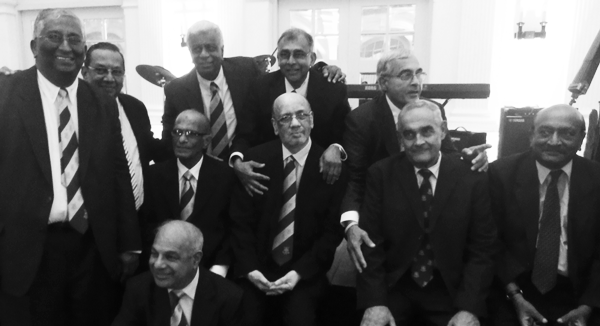
.................................................................
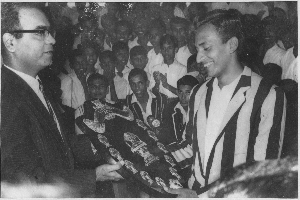
I still remember quite vividly the sense of anticipation that filled me on Monday,January 31,1961.
 I was hoping that I would gain selection in the 1st X1 due to play St Thomas at Mt Lavinia on the Friday & Saturday of that week.
I was hoping that I would gain selection in the 1st X1 due to play St Thomas at Mt Lavinia on the Friday & Saturday of that week.
Mind you,I already had previously been in the team during the Third Term of the year before.....good,but not quite the same as First Term cricket.
The week seemed to go very slowly till finally, the Thursday dawned...the day the team selected would be posted on the main notice board
near the College Hall.....and there it was.... my name in the team!!!!...My recurring dream,since starting at Wesley in 1952 (in the halcyon years of Wesley cricket) was about to come true......wow,I felt great!!
I awoke early on Friday,February 3,eager to get to school and the morning assembly...as was the custom,the Principal,Mr.Nonis, read the names of those
selected in the team to the assembly.....I was numb with excitement and pride.The morning newspaper too, had previewed the game and mentioned my inclusion...what a thrill it was to see your name in print.
Now,there was a game of cricket to be played & hopefully won.....our team was:D.Kodituwakku (Capt.),M.Bulner,K de Silva,E.Smith,L.Wijesinghe,G.Reimers,M.Muthuvaloe & those making their debut in the team,
S.Wickremaratne,M.Hamer,D.Maye & R.Reimers.The reserves for this match were H.Fuard,C.T.Rodrigo,E.Schoorman and M.Jebarajah.Happily I add,that at the time of writing I have ongoing contact with all members
of this team (bar Milroy Bulner who sadly passed away quite young) even though we are now spread to all corners of the globe.
The Thomian team skippered by R.M.Fernando included names like C.M.Ponniah,Keith LaBrooy (who with his brother Robin were involved in many a tennis ball cricket match against Glenn & myself at the Dutch House in Borella),
Maurice Fairweather and Lorensz D'Silva (later married my cousin Larraine McHeyzer and now living in Melbourne)....it also included Paul Selvadurai and Tony Sirimane....more about them later!!
Wesley had been on the receiving end of many a thrashing at the hands of the Thomians,especially at Mt Lavinia and our team went into this game very determined not to suffer the same fate.
Back,as they say in the classics,to the cricket.Wesley batting first,were all out for a meagre 102 runs.Kodituwakku,Glenn Reimers,Kenny de Silva,Sarath Wickremaratne and Milroy Bulner were
the only batsmen to reach double figures.Keith LaBrooy (4) and Selvadurai (3) shared the wickets.St Thomas' fared only marginally better in their 1st Innings,scoring 113 runs.Wesley,chasing quick runs were
2 wickets for 12 runs at stumps on the first day.Continuing on the second day Wesley were all out for 149 runs.Kodituwakkau,Mervyn Hamer,Lalith Wijesinghe,Errol Smith and Milroy Bulner reached
double figures.Chasing a modest 139 runs for victory the Thomians collapsed sensationally to be 81 for 9 just after tea.....enter Tony Sirimane to join Paul Selvadurai.Together they managed to hold
out for 45 minutes (it seemed like hours!) for a draw and to deny Wesley a famous & rare victory at Mt Lavinia.
This match came up in a conversation I had with Lalith Wijesinghe a year or so ago,with typical modesty he said that he remembers doing OK in the game.....now let me tell you how OK he did...in the Thomian 1st Innings he
bowled 22 overs and took 5 wickets for 31 runs....in Wesley's 2nd Innings he scored 60 runs.....and in the Thomian 2nd Innings he bowled 25 overs and took 6 wickets for 42 runs.....that is a little bit better than OK
don't you think!!....he also remembered that Glenn dropped a dolly of a catch which would have won the game for us.....Glenn vehemently denies the accusation.To be honest,I must have been on cloud nine
because I too can't recall the missed catch.
Bye the way,my own modest contributions in this match were 8 runs coming in at nine in the 1st Innings....and 3 not out in the 2nd innings,left stranded by Darrell Maye who went for a big hit and was caught in the deep.
I know Kodda said quick runs Darrell,but really!!!!....I also recall a catch at deep mid wicket in the Thomian 2nd innings.....not a spectacular debut, but one that will live in my memory...who said dreams dont come true!!
On the Memories below
Bryan Claessen in action in Madras
Under 12 Cricketers against Hill School Nuwara Eliya - 1948
Ceylon Cricket Assocoation team 1953 against Madras (Gopalan Trophy)
Some Cricketing Memories from Bryan Claessen (1)
Some Cricketing Memories from Bryan Claessen (2)
A Letter from Bryan Claessen to Peter Casiechetty - 2008
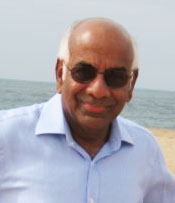 |
 |
| Senthil Sinniah 2009 | In 1958 |
Tennis Team 1958
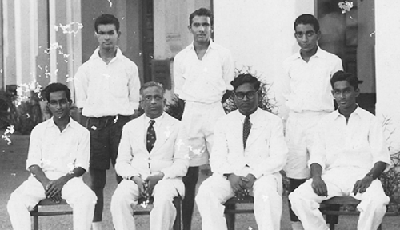 |
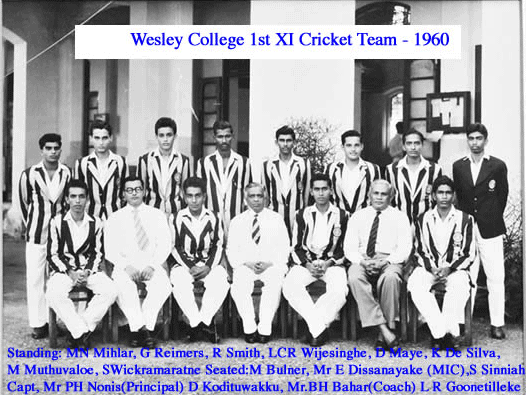
By Lalith Wijesinghe
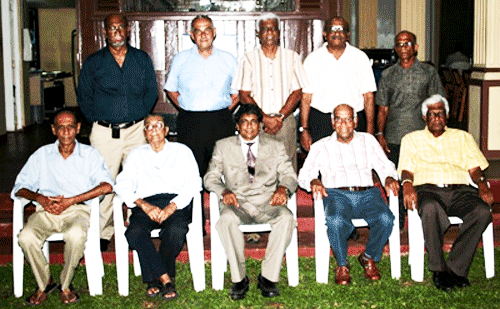
L.C.R Wijesinghe, Kenneth De Silva, Sarath Wickramaratne, Milroy Muthuvaloe and MN Mihlar
D Kodituwakku, Mr Edmund Dissanayake, Shanti McLelland, Senthil Sinniah, LR Goonetilleke
I first heard of Senthil's visit to Colombo in November from Lucky Goonetilleke.On this visit he had a earnest desire to meet with a few past Wesley cricketers from the early 1960's. This was indeed welcome news and was greatly anticipated by me and all others invited. Senthil was Wesley's cricket Captain in 1960 and I had the privilege of playing under him. He is well respected and a true blue Wesleyite.

On the evening of 12 November 2009, we all met at the OWSC. Amongst those present were Edmund Dissanayake, Dharmaratne Kodithuwakku, Milroy Muthuveloe, Kenneth De Silva, Lucky Goonetilleke, Sarath Wikramaratne, M.N.Mihlar, Mahendra Dissanayake, Dr Shanthi Mclelland and yours truly. As all of us settled down it was revealed that it was Senthil's 69th birthday.The importance of this get-together was further enhanced by this news.
There were six past Wesley Captains of cricket in the group with Edmund Dissanayake being the most Senior. As expected recollections of past cricket incidents tested everyones memories. Edmund Dissanayake regaled those present with many events, recounted in his inimitable style. His detailed narrations of many unforgotten cricket events were astounding and listened to with great enthusiasm. He is a Wesley icon and everyone present wished him a longer innings.

L.C.R Wijesinghe, Kenneth De Silva, Sarath Wickramaratne, Milroy Muthuvaloe and MN Mihlar
D Kodituwakku, Mr Edmund Dissanayake, Shanti McLelland, Senthil Sinniah, LR Goonetilleke
Subsequently Senthil cut his birthday cake and expressed his sincere thanks to everyone for being present. It was his wish that he celebrates his 69th birthday with friends in Sri Lanka at the OWSC, which has had a makeover with the lawn looking splendid.
A typical SriLankan buffet dinner was enjoyed by all present. Dr Shanthi Mclelland, Wesley's Principal was present right through the evening and would have enjoyed the camaradie of everyone present.
It was such pleasant evening and could be classified as one for posterity. A get-together of Past Wesley cricketers from the early 1960's hosted by Senthil Sinniah on his 69th birthday.
Links to further reading

Addendum by Dr Nihal D Amerasekera : To those who do not know Senthil he was the 1st XI cricket captain of 1960, a very successful year. He was a popular hosteller and also a day boy at college. He emigrated to the UK in the late 1960's where he had a very successful and rewarding career in Banking. Senthil is one of life's gentleman and a product of the Oorloff-Nonis years when the school produced exceptional men of grit and industry. It has been a pleasure to be associated with Senthil when he was the President of the OBU (UK) when he resurrected the Union from its very depths. Since then we have served in the Committee of a fine and thriving OBU(UK). We wish him a long and happy retirement.
From the Wesley College Magazine of 1919 kindly lent to me by Edmund Dissanayake
Wesley cricket was never in a more flourishing condition than between the years 1899 and 1910. In a previous article the writer recounted a few of the famous deeds of the oldest cricketers like CDR. Pereira, Z. H. Mantara, M. L. Warish, R. F. Honter, K B. Redlich, and greatest of them all, the late C. E. Perera. One of the most successful captains that 'Wesley had was C. A. Perera, younger brother of C E. Perera.
During his captaincy Wesley beat the Royalists in the annual match, and Perera himself had a great share in the honour of the victory by creating a record for these matches. Perera's score of 105 is, I believe, the' second highest ever made in this series of matches. In 1910 H. C. Gunasekera scored 108 for the Royalists, and displaced Perera's notable record. I still remember the great innings of 105 played by Perera, whose exhibition of batting was one of the finest ever given by a schoolboy. He, was opposed to some v-very good bowling, which he punished very severely indeed. One of Perera's best performances before he played that historic innings against the Royalists was the one he put up ag9.iFlst the Colombo Cricket Club in 1902 on the CCC. ground, when he scored 90 by a most dashing display against such good b1wlers as K R. Waldock, F. Blilkwill. A. D. Skrine and Lt. Hewitt. Perera's early promise at school was fully realised when he joined the Colts and the Sinhalese S. C. for whom he made heaps of runs. For the Police C. C. he played many a notable innings, and in one season of Ceylon cricket he hit up five centurie thee of them in consecutive innings.
No representative team was complete without him, and at his best he was the most dangerous batsman in a Ceylonese XL, as he could score from the moment he went in. Failing health kept him out of the cricket field for some time, and when he returned to the game he was not the same old batsman. All his schoolmates and those who admired his dashing batting· in later years will learn with regret that C. A. Perera is now in very poor health, and has bidden good¬bye to the cricket field. What he has done in his short cricket career will al ways be remembered. Most of his, great' doings are recorded in the annals of the game, and it will always be a source of pride to old and present Wesleyites to point out the doings on the cricket field Of C. A. Perera, FW Dias, RES Mendis, T Sathasivam, S Nagendran, RL Kannangara,AM Fuard,L Patternot,EA Gunasekera, NA Wahab, AE Labrooy, GRA Fernando, WE Labrooy, FC Jayawardhana, An eleven picked from the above list should prove an all round combination of much strength.
Another great Wesley cricketer of C. A. Perera's time was R. E. S. Mendis. This left-hander has a record in Ceylon cricket which challenges comparison with that of C. Horan, , the best left-hander' of today. Mendis has not played as often as Horan has done, but whenever he did' take part in big cricket he covered himself with glory. While at Wesley, Mendis was a terror to opposing, school batsmen. Wesley has had excellent left-handers, from time to time, like S. Gunasekera, L, Barbet, D. M. Rupesinghe, T. Sathasivam, and J. E. Melder, but the best of all was undoubtedly Mendis, who is today, according to W. T. Greswell, one of the best Ceylonese bowlers. Mendis did wonderfully well for Wesley and won many a game for the' double blue by his destruc¬tive work with the leather, while he also proved himself a sound and free-scoring batsman and an excellent fieldsman. Later, when he left school and played for the Treasury XI.
He soon won distinction as an all-round player. He helped his Department to win the championship Shield, and full credit was given him for his great work with bat and ball. He played for the Ceylonese against the Australians, and did remarkably well as a bowler. Noble, Mc Alister, and the other Australians' spoke very highly of Mendis' prowessas a bowler.. ,
For the C. L, I. he has proved himself a cricketer able to win a match' with little assistance. from his teammates. Mendis is still one- of the best cricketers in Ceylon, and should on his present form be included in the Ceylonese XI. against the Europeans in the next-match. Another distin¬guished contemporary of Perera and Mendis was F. W. Dias, one of the biggest hitters produced by Wesley and one of the fastest, if not the fastest bowler the College has ever· had. Before Di. was ten years of age he was a proficient young ,cricketer, who in his father's backyard at Dias' Place would indulge in all the favourite strokes of the late C, E. Perera and other cricketers, while the boys of the neighbourhood would bowl to hiJI1 for hours.
When he was tired of batting he would go on bowling for a length of time, and in this way he laid the foundation of his cricket success. As keen as mustard he put his whole heart and soul into the game, and when he found his place in the first eleven of the College he soon proved his worth as an all-rounder·. He played a re¬markable innings of 193 against the Tamil Union. That is the sixth highest score in Ceylon cricket. As Captain of Wesley he led his side successfully and .eat the Royalists. Leaving College to study Law he joined the Sinhalese Sports Club, and became one of its best cricketers .. He also joined the Nondescripts, and was a tower of strength to that -Club till a few years ago, when he ceased to play for it. Dias scored more than one century in Club cricket, and invariably gave a spirited display when he was at the wickets.
He had the honour of playing in representative cricket for the Ceylonese against the Europeans. At his best Dias was a splendid fieldsman, but in later years as he broadened out he was not so agile in the field, though he did not lose his punishing powers as a batsman or his ability to sling down those fast ones. Other notable players at Wesley were W. Don Lewis, who once went in first for Wesley against the Royalists, and carried out his bat for 71; T. Sathasivam, who performed the " hat trick." twice in one match against Trinity College; A. W. Rodrigo, A. E. Seneviratne, A. J. Botejue, A. M. Fuard, R. L. Kannangara, and Rupesinghe. Sathasivam is today one of the biggest hitters in Colombo, and as a bowler he is one of the best in the Tamil Union XI., for whom another old Wesleyite, S. Nagendran, also bats with much success.
A. J. Botejue. gave promise of great things but has not realised them alL When he does get set he can hit brilliantly. As a· bowler too he had his good days.
Fuard continues to do well for the Moor's Sports Club, while Rupesinghe, the left-hander', is a capital bowler, as he has proved it, for the Sinhalese S. C. and the Survey Depart¬ment. S. Gunasekera, another famous old Wesleyite of two decades ago, is one of the-crack bowlers of the Sinhalese S. C. and the Railway. Kannangara and Rodrigo are in the first eleven of the Bloomfield C. & A. C., and very successful they often are with bat and ball. Another old Wesley player, L. N. Joseph, does good deeds as a batsman and a bowler for the Bloomfielders as well as for the Secretariat.
This brief outline of the doings of some prominent Wesley cricketers who were in the cricket team between the years 1905 and 1915, is sufficient to show tl1.e readers of this Magazine that the College has reared some first-rate players who, if got together to-day to form an Old Wesleyite Club, will be able to give the best elevens of the Royal-l, St. Thomas', • and St. Joseph's old boys as good a game as they could wish to have. The writer is endeavouring to arrange a few' matches next year' between Old Wesley cricketers and some of the leading Clubs in Ceylon. There is no reason why these old boys should not prove an excellent combination if they are drawn from J. E. Melder, L. de Kretser, S. Gunasekera, D. M. Rupesinghe, L., N. Joseph, A. J. Botejue, A. W. Rodrigo,
I would like to have reported that it was an early morning leisurely sroll that was taken on 5th lane, Kollupitiya on which, more than a hundred years ago an ancestor of Abu Fuard built the very first house and owned property from the periphery of Galle Road to as far as the eye would see.
 It was from this residence with green doors panelled with glass that Abu would walk all the way to Colts grounds to commence at 2 o'clock his ritualistic practices everyday. He would place a twenty five cents coin on the matting and bowl incessantly to get a firm grip on line and length.
But I am ahead of my story.
It was from this residence with green doors panelled with glass that Abu would walk all the way to Colts grounds to commence at 2 o'clock his ritualistic practices everyday. He would place a twenty five cents coin on the matting and bowl incessantly to get a firm grip on line and length.
But I am ahead of my story.
Reluctant schoolboys
Even though the men in the adjoining Welikada prison might have often mused as they saw reluctant schoolboys drag themselves to class "There go I if not for the Grace of God" Abu Fuard went to Wesley that produced M.K. Albert, E. A. Gunasekera, C. E. Perera, R. L. Kannangara, Mahadevan Sathasivam, Stanley Jayasekera, Bertram Henderling, Tita Nathanielsz, Bryan Claessen and a host of other upright men of the flannels. His father, A. M. Fuard and brother Ansar captained Wesley cricket in 1915 and 1954 respectively.
As a member of the U13 cricket team he was given to hurl the red cherry at speed but Alban Fernando re-structured his deliveries to be off-spin which made him, when he came of age and played for fame and country, the best off-spinner in the whole of Asia.
 He represented Wesley in the high hurdles and matched Lalith Athulathmudali at the Public Schools Meets but cricket was his passion. He would have captained the school in 1954 after Radley Claessen, Bryan Claessen and brother Ansar but the Principal suggested, although firmly, that he step down to make way for Lou Adhihetty who was to go to the USA in the following year to work for the Methodist Ministry.
He represented Wesley in the high hurdles and matched Lalith Athulathmudali at the Public Schools Meets but cricket was his passion. He would have captained the school in 1954 after Radley Claessen, Bryan Claessen and brother Ansar but the Principal suggested, although firmly, that he step down to make way for Lou Adhihetty who was to go to the USA in the following year to work for the Methodist Ministry.
Unfair request
Abu acceded to the unfair request but, on reflection, gave up studies at which he was pretty good, securing first place in class year after year. Although still bitter with the Principal, he does feel that decision to abandon his studies had a redeeming feature in that he would otherwise have gone to University and ended up in some remote kachcheri and been buried with history as a nonentity within the stones of ruins. That episode also made him independent and not have faith in any mortal on earth.
Back wages
Whilst practising at Moors he met with Ryle de Soysa who had captained Royal College cricket in 1936 and who offered Abu a job which he accepted with reluctance. He worked at de Soysa & Company for three and a half years but, unknown to Ryle, he was never paid because he was supposed to be a Trainee. When Ryle got wind of it he paid Abu the back wages and up-graded his functions to cover all Marine Insurance Surveys. Abu was absorbed into the National cricket pool in the 1955/56 Season and underwent rigorous physical training imposed by martinet Darley Ingleton. Even as a National player he went about on a rickety old pedal bicycle which needed no bell because of the racket it made. Abu played for Sri lanka from 1956 to '71 as a specialist off-spinner and often opend the innings. He played in 1961 against the Australians captained by Richie Benaud, in '62 against England captained by Ted Dexter, '65 against Pakistan in the first unofficial Test which Sri Lanka won on the strength of his 40 in the second innings and Stanley Jayasinghe's 6 for 38 and Norton Fredrick's 3 for 85. Mysteriously, he was not given a bowl.
Partnership
Although he had a partnership of 231 runs with Bryan Claessen in inter-school cricket, he considers his 72 in a Gopalan Trophy game as his best and his 6 wickets for 25 in 31 overs the best in the match against Joe Lister's Xl which was studded with stars, many of who went on to captain England cricket - Mike Dennes, Micky Stewart, Keith Fletcher and Peter Parfitt.
Abu had been involved with the Administration of SL Cricket from 1973 and had served under the Presidency of Robert Senanayake, N. M. Perera, T. B. Werapitiya, Gamini Dissanayake and Lakshman Jayakody, all jewels in the country's crown of cricket. He has been full time Manager of SL cricket teams, been on the Selection Committees from 1976 to 82 and the Chairman from '83 to '86. In the credo of 'Country before self', he has served only in an honorary capacity. A strict disciplinarian, once when Kuruppuarachchi returned to the pavilion with an injury, Abu gave him a tongue lashing which saw the boy return to the fray and capture 5 wickets to beat Pakistan under Imran Khan.
Inept umpiring
Abu is a stern critic of inept umpiring which could result in ruined careers.
He was the stormy petrel who flew in the teeth of high-ups who wanted SL cricket to be the exclusive preserve of big school products and, with the able assistance of Dhanasiri Weerasinghe opened the doors for small school products in the hinterlands of the country to wear the National shirt. He engineered the investment of large sums of money in the cricket coffers and mentions that when in 1974 the West Indies came here under the captaincy of Clive Lloyd and sporting heavy-weights Roy Fredricks, Keith Boyce, Andy Roberts and Vanburn Holder, SL Cricket did not have the shekels to host the visitors to a Dinner and that it was eventually held with the financial help of a few cricket enthusiasts.
Behind the scenes
Perhaps, the greatest contribution Abu Fuard has made to SL Cricket is the backing he gave Gamini Dissanayake for Sri Lanka to be accepted as a Test playing Nation. It was Abu who worked behind the scenes for Gamini to be President of the Cricket Board in 1980 and with the nitty gritties attended to by the two, Gamini's aplomb, speech-craft of eloquence and persuasion got over the stubborn resistance of the white lords at the ICC who held steadfastly to a seeming attitude of apartheid by even harnessing the support of white Jeff Stllmeyer of black West Indies. When the lily white cricket lords were refusing to budge even though Sri Lanka had humbled England in 1975 and '79 and Australia in '81 and getting the bigger half of the credit against Alvin Kallicharan's WI, Gamini 'lubricated' the ICC officials with the help of Maharajahs and Balfour Beatty who were handling the Mahaweli Project, holding a number of impressive functions reminiscent of the cunning fox Oliver Goonatilleke who out-witted the Soulbury Commission.
Social graces
Furthermore, as Michael Roberts has observed, "Gamini Dissanayake being a Trinitian and a lawyer had the social graces and forensic skills to persuvasively press his case."Abu was Gamini's shadow when the Asgiriya grounds were developed to International standards in honour of an undertaking given to ICC. Abu obtained high class turf for the wicket. Khettarama followed.
Abu Fuard has nothing now to do with SL Cricket. Asked if he has 'retired hurt' like Roshan Mahanama, he said: "No, I retired in fear because lucre was spreading its tentacles every which way and all were having a pay day everyday. Oil does not mix with water."
 The above headline appearing in the ‘Sunday Island’ of Nov. 9, 2008, brought back nostalgic memories of the St. Benedict’s– Wesley match, on the Railway grounds in 1947. The press report further stated; "the series had been interrupted on a few occasions after St. Benedict’s beat Wesley in 1989." In order to write a truthful account of the 1947 match, I endeavored to get a copy of the Wesley magazine and succeeded only yesterday.
The above headline appearing in the ‘Sunday Island’ of Nov. 9, 2008, brought back nostalgic memories of the St. Benedict’s– Wesley match, on the Railway grounds in 1947. The press report further stated; "the series had been interrupted on a few occasions after St. Benedict’s beat Wesley in 1989." In order to write a truthful account of the 1947 match, I endeavored to get a copy of the Wesley magazine and succeeded only yesterday.
To begin, I congratulate St. Benedict’s on their innings victory at Campbell Park. Before I touch on the subject proper, I wish to digress a little. This is merely to show Wesley’s frame of mind before the match with St. Benedict’s. A fact not known generally was that in 1947, Wesley entered the cricket season WITHOUT A COACH!
The first match against Royal, skippered by M. Kasipillai, at Reid Avenue, ended in a win for Wesley in the last over. The second against S. Thomas’ at Mt. Lavinia, skippered by Upali Katugaha, also ended in a victory for Wesley. The third against Trinity, at Asgiriya was drawn with a first innings lead for Wesley. In this match, Alan Ratnarajah deputised for the Wesley captain, who was in hospital.
The fourth match was against St. Benedict’s at the Railway Ground, Mt. Mary.
The victorious Wesley team were cock-a-hoop. St. Benedict’s batting first scored 30 runs. N. S. Jayasundera took 2 for 0, W. P. S. Abeyeardene 4 for 5 and D. T. Ramanayake 3 for 12.
Wesley replied with 275 runs. Bertus Perera scored 55, Denis Vantwest 50 and Jayasundera 45.
St. Benedict’s in their second innings were bowled out for 79. Wesley won by an innings and 166 runs…without their regular captain, the present writer.
That night, Wesley Principal Rev. James Cartman met me in hospital and recounted the despicable action of the Benedictine boys who completely damaged his car, by throwing stones, after their defeat. What was sad was that no one in authority at St. Benedict’s attempted to prevent this shameful onslaught.
He told me "IF YOU HAVE ANY AUTHORITY, DO NOT PLAY AGAINST ST. BENEDICT’S AGAIN."
Since then this fixture did not take place until I lefy Wesley in 1980.
The esteem that Rev. Cartman was held in by the staff, students, parents and old Wesleyites prevented a renewal of this fixture.
The writer remembers a stalwart of the Methodist Church, Verney G. B Perera, who broached the renewal. When I contacted the Principal Harold Nonis, he told me; "YOUR DECISION IS SOUND, STICK TO YOUR DECISION."
Personally, I had several friends at St. Benedict’s. Dharmakan, Casichitty, J. A. Gajanayake and Bede Puvimanasinghe on the staff.
But the interests of my Principal were uppermost.
Links to further reading
By Lakshman De Silva
From the School Magazine 1958 sent to me by Arthur d'With Barbut
At a time when Wesley's reputation in cricket is at stake, it is the memory of past "giants" like C. E. Perera, that can provide us with the inspiration to reach the top of the cricket ladder once again.
C. E. Perera was a contemporary of S. P. Foenander and first played for Wesley in 1898 when M. C. Warish was Captain. C. E. Perera came to Wesley from Ananda where his talents had not been discovered. The credit for having "discovered" C. E. Perera goes to S. P. Foenander. In an Inter-Form cricket match, playing under the captaincy of S. P. Foenander, Perera did very creditably with bat and ball. He scored more than 50 runs and took more than half the number of the wickets of his opponents. The very next day, C. E. Perera was called up for first eleven practice, after Foenander had informed Mr. R. F. Honter of this promising young cricketer. In his first match representing the college against the C.C.C. he was the top scorer.
Special mention was made of C. E. Perera's feats with the bat, in the first issue of the "Double Blue" published in March 1898. In this instance reference was made to his fine performance playing for the present boys against the old boys. The passage ran "Judging from the previous day's play, the chances seemed decidedly against the present boys. But as the day dawned, the weather became sufficiently encouraging. As the game proceeded matters began to look disheartening for the old boys. They were getting a good leather hunt from their young successors. A deft turn of C. E. Perera's bat, and the ball was heard whizzing past with the portly form of an old boy scampering after it. The umpires signal "boundary" and all return to their respective places, but only to re-enact the farce. Such was the repeated scene. The present boys of course won". In this match C. E. Perera was the highest scorer, "who made a brilliant exposition of the game, with his sweeping drives, his clean and round hitting, and his magnificient cutting and hooking. He played a faultless innings of 77 runs which chiefly consisted of 17 twos, 4 threes, and 3 fours."
The same· year, 1898,. C. E. Perera helped Wesley to defeat Royal, who were led by Robert Ekanayake. This was Wesley's .:first victory against Royal. The match was played on the Sports Club grounds at Galle Face, and Wesley was captained by M. L. Warish. Before this match the Royalists were full of high hopes. They looked upon Wesley as cheap victims. They took the Wesley team so lightly that they all sported white starched shirts, which were usually worn with evening dress suits. At the start, the hope of victory for the Wesleyites vanished as the scoreboard read a portenuous 1-4-0. But C. E. Perera came to Wesley's rescue with a brilliant innings of 97 not out and turned the tide in favour of Wesley. Wesley totalled over 200 runs and won the match by an innings and 35 runs. A cricket enthusiast of that day remarked, "~His presence at the wicket wrought many changes in the Royalist attack. Perera. combines a sharp eye, powerful wrist and a little wiry frame, with patient application, a clear bend and an invincible hopefulness. His forward play is a speciality in itself. His shots are simply clean, round and magnificient."
In 1899 C. E. Perera captained Wesley. He led Wesley to a second successive victory over Royal, captained by Forrester A. Obeyesekera on Galle Face. He scored a magnificient 87, and .above all it was his clever captaincy that helped Wesley to win the match. That year S. P. Foenander and Sir Macan Marker opened the Wesley batting, while Lyn Barbut and W. O. Nathanielsz opened the bowling for us. .
In March 1899, while still captain of Wesley, C. E. Perera Was invited to captain the Combined Colle§,es' team against the Colts, which was a great honour for a schoolboy of that time. The splendid ,fi.ghtput up by the Combined Colleges' team speaks well for Perera's captaincy. As a batsman he maintained his great reputation in this match too. As a result Perera was chosen to play for the Colts against the Europeans. This was a rare distinction which Perera shared with T. A. Scharenguivel of St. Thomas'. In this annual "Test Match" played on Galle Face, Perera made test history by scoring 71 not out.
The Sinhalese Sports Club is greatly indebted to C.E. Perera. The Combined Colleges' team that Perera captained in 1899 all consisted of Sinhalese cricketers and this led to the formation of the Sinhalese Sports Club. C. E. Perera helped the S.S.C. to become established as, one of the strongest cricket clubs. He continued to maintain his reputation as a great batsman and instilled terror into many bowlers. It must be remembered that C. E. Perera did not possess much of the facilities that a present day schoolboy cricketer has .at his command. Nevertheless, the fact remains that C. E. Perera is the greatest right hand batsman ever produced in Ceylon. This should encourage present cricketers to emulate the great example he has set.
The Under 19 inter-school rugby season of 2009 is in full swing at the moment. The focus of the league tournament that is in progress now is the Division 1A and 1B categories.The top group which is the Division 1A has seen some mouth watering finishes which includes some upset wins over fancied teams inflicted by teams that have been almost written off.But the Division 1B category is dominated by Wesley who is slowly but surely raising its head after some setbacks in the past. This season the Campbell Park boys led by centre Azward Aniif are having a whale of a time and going great guns.
Since their plunge to the lower division the Wesleyites have gained their confidence and will be a side to be reckoned with in the future. They are determined to come back to the place where they were a few years back.It seems like the saying that goes that a good team learns from their mistakes this is what that is exactly happening with Wesley rugby. The dedication put in by the boys has produced the desired results that their coach Imthisham Mohideen and the dedicated old boys who have rallied around boys are expecting.Skipper Aniff speaking to the Daily Mirror said that he is happy to say that his team mates are giving him one hundred support. This could be gauged by the results of the five matches that they have played so far. They began the season with a 25-5 win over traditional rivals Thurstan and in the process bagging the Diyanesh Rajaratnam trophy.They followed it up with a convincing 42-0 win over Prince of Wales and then outclassed Lumbini MV 65-5 which continued with the demolishing of DSS 89-0 and Science 50-5.
Aniff says we have over 40 players attending practices and there is fierce competition for the 15 positions in the team. The Wesleyites posses ten senior players which four fourth year players in Aniff, centre Zalique Jayah who led the side last year, his deputy Dillon de Jonk and Azmil Oumar.They are supported by third year players Elham Sallay, Randika Tillekeratne, Inamul Hassan and the burly Dulanjana Wijesinghe who has been their mainstay this season. In fact Dulanjana is an all round sportsman having led the senior Wesley cricket team this year.Dulanjana who mans the pivoted No 8 position has been in terrific form this season. He has so far planted 19 tries in the five matches that they have played. Then there is last years skipper and centre Zalque Jayah who too hascontributed to Wesley’s success.Coach Imtisham an ardent old boy of the school who himself was a top player having represented his alma mater for three years speaking to the Daily Mirror was optimistic.Imtisham took over the senior team this year after having been in charge of the Under 18 side. Under his guidance the Wesleyites tasted success in most of the tournaments they participated.Last year the team succeeded in emerging champions in Western Province Under 18 and Ist VX categories and was also the All Island runner up. Imtisham said we have had bad patches in the last few seasons and we are making steady progress having developed the skills of the youngsters.
He further stated that the Rugby Development Committee of the school is leaving no stone unturned and are giving the boys their fullest support in every aspect.We have brought in two other coaches in Intikhab Thaam who deals with the forwards and Vidiya Bandara who is in charge with the wing three quarters. The duo are players with immense experience with Intikhab having played for the Sri Lanka youth team and Bandara an old Isipathanian who has played in most of the top rugby playing clubs and was also a member of ri Lanka 7’s team during his playing days.Nevertheless Imtisham is confident that with the proper and correct guidance that the boys are getting at present they will be a side to be reckoned with in the future.Wesley with a new principal in Dr. Shanthi Mclleland having taken over duties is sure to make headway in the schools Extra curricular activities. Dr. Mclleland also an old boy of Wesley is a sport fanatic having excelled in athletics and hockey at the highest level.
So at the moment the Wesley ruggerites are having the blessings of a sport fanatic principal and this may be the turning point for more success to come for the rugby players in the future.
The ruggerites of Wesley College are looking forward to being promoted to Group A of the Division 1 schools rugby tournament.
A promotion for Wesley is most certain, given the fact that they are easily the best team playing in the on-going Group B tournament.But the head coach of the team, Imthisham Mohideen says there is nothing to celebrate in getting back to the A Division tournament because he believes Wesley should be playing against the top teams in the inter-school tournament and not against second division teams. The school has a rich rugby tradition and celebrated 50 years in the sport, back in 2006. Wesley’s long association with rugby has given them recognition as a leading rugby playing school. However, the silver wear the school has won in all its years at rugby has been due to the efforts of their junior teams. A lot of promise has been on display at junior level but the players seem to lose track of those winning ways when they gaduate to the senior team. If this writer’s memory is right, Wesley is yet to win a tournament at senior level.
Mohideen, in an interview with ‘The Island’ said that he was happy at the manner in which Wesley was progressing, but said that he was concerned that his team’s strengths couldn’t be judged due to lack of competition in the B Group tournament. The team has so far beaten Thurstan (25-5), Prince of Wales (42-0), Lumbini (65-5), D. S. Senanayake College (89-0), Zahira (50-5) and St. Sylvester’s College (60-13). Rugby at the school is very organized this year with the boys being put through their paces by three coaches. Apart from Mohideen, the coaching team at Wesley also includes Imthisham Thaam, an IRB Level 2 coach and former Isipatana, Kandy, CR and CH three quarter, Veediya Bandara.
Mohideen said that the present members of the Wesley College team were very determined to succeed this season. The team includes players who did very well at junior level last season. This is yet another year where Wesley is blessed with the successes at junior level trickling through to the senior team in the form of experience. The side also boasts of having in their possession some of the biggest forwards in schools rugby. According to Imthisham, the average age of the players in the present First XV squad is 17 years. From merely making the numbers at inter-school First XV tournaments, Wesley began to make giant strides in rugby when the school authorities hired Sanath Martis as coach, back in 1996. That helped the school to rethink their strategies with regard to their association with rugby. Martis’ exit, after a couple of years, saw the team come under Dishantha Priyadharshana under whom rugby at Wesley had a memorable run from 2001-2006.
Then there was a slump which is reason for Wesley being in the B Group of the Division 1 Tournament. Imthisham said he believed the way forward for Wesley is to make steady progress. "I don’t think the best idea is to take immediate measures. Regrouping takes time. We have made plans till 2012 and the immediate goal is to qualify to contest the A Group in the Division 1 tournament in 2010," said Mohideen who has been associated with rugby administration at Wesley, since 1997. Mohideen acknowledged the fact that rugby at schools, overall, had reached a healthy standard. "Coaches must use methods to enhance the skill level of players and to get the maximum out of their charges. Schools rugby is approached in a very professional manner at present. However, we must be careful not to take everything out of the players in a single session," said Mohideen. He said he observed his players recuperating faster after the number of training sessions per week was reduced to three.
Wesley’s dream of competing in the A Group matches of the Division 1 tournament next season will be realized within the coming weeks when they finish off their remaining matches. The team is also assured of a slot in the knockout tournament this season on the merits of being declared the winner of the Group B Division 1 tournament. As much as large sacrifices have to be made to realize big dreams, Wesley’s head coach is also aware that success can’t be sustained sans the required support. "Competition in the school’s top division is so heavy that a team wouldn’t be able to maintain standards without financial and logistic support. Also parental support is needed more than anything else," said Mohideen.
From the Daily News of 23rd February 2012
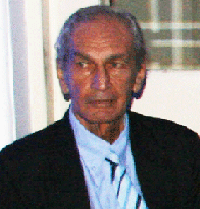 The former colourful cricketer, Neil Gallaher, of Wesley, HSBC and Colts, was an elegantly stylish right handed batsman, who through his attractive batting was the cynosure of all three institutions.
The former colourful cricketer, Neil Gallaher, of Wesley, HSBC and Colts, was an elegantly stylish right handed batsman, who through his attractive batting was the cynosure of all three institutions.
Being endowed with a fine physique and a fair complexion, he had to make do with the meagre resources that came his way and, so lived in the Wesley College hostel from 1947-1954. He came under the principalship of the Rev James Cartman and Cedric Orloff - with cricket being his forte, he played under Radley Claessen, Bryan Claessen and Ansar Fuard.
There was a time when the Wesley College cricket team had quite a number of fair complexioned cricketers which made the team comparable to a young Australian side. Neil through his cricket was popular to be sociable in his ways, with honesty and integrity as his watchwords. He was modest enough to say that he never got a century, but a good many fifties for Wesley. With two more years to play for Wesley, he through dire necessity stopped playing for Wesley to accept an offer of a job at the age of 18 by the HSBC.
He whilst playing for the HSBC also represented Colts under Tita Nathanielsz. Neil distinguished himself in both places as a prolific scorer and fine fielder. He made rapid progress at the HSBC to hold positions of responsibility and, did as well as cricket captain, to win for the HSBC the Mercantile 'A' division cricket trophy in 1958. On retirement from the HSBC in 1991, he took to playing tennis at the Otters and Cathedral Courts.
Partnering the former President of the SLTA D L Seneviratne, in the National over 65 years doubles event, they both won the titles for three years. It was whilst playing tennis at 75 years, Neil developed a pain in the knee, which turned to be far more serious than what he thought and was subsequently treated. In the process of which he suffered a heart attack and a stroke, that resulted in his right side being paralyzed.
Neil Gallaher, who leads a sequestered life is confined to his home at 28/A Rodney Street, Borella and would be pleased to see his colleagues and friends calling on him at his home.
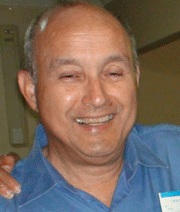 An outstanding cricketer of Wesley College in the early 1960s, Errol Smith, is back in Sri Lanka for a short stay.
An outstanding cricketer of Wesley College in the early 1960s, Errol Smith, is back in Sri Lanka for a short stay.
Smith was an exceptionally talented sportsman who excelled for Wesley in the mid-fifties and early sixties at cricket, soccer, badminton, basketball, athletics and table tennis at both junior and senior level.
However, Cricket was his forte and he represented the school with distinction, particularly in the 1st XI, from 1958 to 1961. Smith crowned a glorious school career in sport with a scintillating innings of 199 not out against Richmond College at the Galle Stadium in 1961. He was a stylish left-hand batsman and his marathon knock was a blend of elegance and aggression.
This was the highest score by a Wesleyite in school cricket at that time until Mervyn Hamer scored 233 against Kingswood College in Kandy in 1964. Farveez Maharoof went one better in 2002 with 243 not out against Richmond College at the Galle Stadium, which stands as the highest score by a Wesleyite today.
At the Wesley prize-giving day on 22 March, 1961, Smith proudly walked on stage to receive three awards: The Wilfred Jayasundera Memorial Cup for Batting, the Donald Gunasekera Trophy for Fielding and the Herman Claessen Memorial Shield for the Most Outstanding Performance – his explosive innings at Galle.
A fortnight ago a get-together was arranged to meet Smith at the Old Wesleyites Sports Club, Campbell Park, Borella. Some of those present at the occasion who had played cricket with him at school were: Dharmaratne Kodituwakku (captain 1961), L.C.R. Wijesinghe (Captain 1962), Sarath Wickremaratne, Mervyn Hamer, Milroy Muthuvaloe (captain 1963 & Wesley 1st XI coach 1981-1988), Priyanath Fernando, C.T. Rodrigo (who bowled a miraculous spell of 8 for 9 v Ananda in 1962) and K.V. De Silva. Also present were Old Wesleyites from Australia William Deutrom, who performed very well at 1st XI cricket from 1962-1965 and the great ruggerite Reggie Bartholomeusz who played for Wesley, CR & FC and Sri Lanka.
Two legendary cricketers whose names kept coming up in the conversations that night were Edmund Dissanayake, father of Danesh and uncle of Mahendra Dissanayake who were also very successful Wesley cricketers. Edmund was one of Wesley’s most astute captains who made an invaluable contribution to Wesley cricket as a player and later as coach and master in charge for over two decades on an honorary basis. The other was the maestro Mahadevan Sathasivam, who was undoubtedly Wesley’s and Sri Lanka’s greatest cricketer ever. Sathasivam regularly attended the school matches in the 1950s and ’60s and his charismatic personality and expertise helped greatly to motivate and inspire the cricketers of that era.
To Errol Smith and all of us who attended the get-together that evening it was an emotional journey going back in time to relive the wonderful moments of those halcyon days in the early sixties. It was really great sitting together enjoying the camaraderie and joyful banter in the railway carriage overlooking the Wesley grounds in Campbell Park, where we shared the thrill of success and the disappointment of failure. After all, these wonderful experiences have been a rich and unforgettable part of our lives.
Links to further reading
Wesley cricketer Errol Smith's 199 not out in Galle - the highlight of career by A. C. de Silva
CRICKET: Right now in Sri Lanka is a distinguished sportsman - an old Wesleyite Errol Smith who has come from far off Australia to meet old friends.
Errol was a top-class left-hand batsman during his playing days at Wesley in 1961. One of his memorable knocks came in 1961 when the Wesley played against Richmond at the Galle Esplanade.
He made the memorable knock of 199 and that as the figures show, was a innings that the oldsters talk about even now.
Attack the bowling was his idea when he goes to bat and besides this huge score against Richmond, he had many other knocks to his credit. That year - 1961, Wesley had a power-packed team to do duty on the cricket field. Among the other top players who played along with Errol Smith, were: Dharmaratne Kodituwakku, Sarath Wickremaratne, Milroy Bulner, L. C. R. Wijesinghe, Kenneth de Silva, Everard Schoorman - those names comes to mind in a flash as they were Wesley's leading players at that time.Errol Smith was in front and he had something like 12 innings being not out on three occasions scoring around 400 runs for an average of around 44.00.
While cricket was his pet game, Errol also played soccer and table tennis for Wesley in 1961 during the time Mr. Harold Nonis was Principal of the school.
He was also happy to meet former Wesley College cricket captains Mahendra Dissanayake and Danesh Dissanayke of the younger lot of cricketers, having met both of them in Australia earlier. A Sportsman of Wesley that cannot be missed is Edmund Dissanayake - the lawyer who was Wesley's never-say-die cricketer and coach in the good old days and Errol Smith was hoping to meet him.Wesley's great cricketers will never forget their home - Campbell Park. Campbell Park was used by Wesley from 1940 onwards and Tamil Union Cricket and Athletic Club used the grounds before.
In 1990, Wesley joined the other schools and laid out turf strips and they had their old matting wicket too.
Reza Kamaldeen lives in Montreal, Canada
 Mr Regie Bartholameuz was one of the greatest sportsman/ rugby player Wesley ever produced, and Sri Lanka ever had. I am very fortunate to know him and I am privileged to write this article about him.
Mr Regie Bartholameuz was one of the greatest sportsman/ rugby player Wesley ever produced, and Sri Lanka ever had. I am very fortunate to know him and I am privileged to write this article about him.
I met him in 1975 at Wesley College grounds (Campbell Park) when I represented the school Under 15 team along with my younger brothers. We three brothers (eldest Hafil Kamaldeen, myself – Reza Kamaldeen, and youngest Fazal Kamaldeen) attended Wesley College from 1973/1980. Beside, our academic accomplishments, we had one more thing in common; all three of us played rugby for Wesley.
We came to college from a low profile school and only at Wesley we were introduced to rugby. Regie made the game so fascinating that we got glued to it, even though the game was new to us.
He was a coach who knew the game and had the ability to teach the game. He is very quick to discover how to communicate with the boys and what language to speak. Many students came from Sinhala medium. They were very well accepted by him and vise versa, since he spoke to them in Sinhala, they too were very comfortable with him. He was a team player and he was always available to listen to our individual problems. The team and the coach was always one big family. He taught all the tricks of the trade and made a fantastic team. Not to forget, he was shrewd and a good strategist and planned each game according to the opposition. It’s true we had more losses than victories but the WCC team was once feared by many Colombo leading schools. The day we lost to mighty Trinty by 4-0 (in which I played 1977) we were very sad. But Regie said, “ lets forget about it and look for a new day”. He never showed his anger or unhappiness for the screw-ups what ever we did on the field.
He started to play for the college in 1962 when he was 15 years old. While playing for the college side he was noticed, and picked up due to his raw talent by CR and FC (Ceylon Rugby and Football club). He was the dream boy and a prodigy to play for the reputed club while still at school. He played for the club from 1969 till 1976 and captained the club in 1974 to lead the side to a fantastic unbeaten record in the same year. (They lost in the final league championship knockout by a narrow margin)
Regie still holds the college 100 yards + 220 yards records, which he achieved in 1965.
He played for Sri Lanka from 1969 – 1976. He was tipped to lead the side in 1974 and for some unknown reason he never got the captaincy, which he very well deserved.
He was the place kicker for the college, club, and for the Sri Lankan team. He was very reliable and whenever the team needed the points badly from his boots, he always fulfilled their aspirations. There were very few wingers who could kick and he was the best in my opinion.
He was a superb winger with explosive speed; at the height of the speed he could be deceptive and change the direction without loosing his speed. No one could argue his side steps; dummies and his trademark - the scissor movements - were the best in the field at that time.
Mr Wilson (in charge of the CR and FC bar was a close family friend to us through his son Nimal Hettiarachchi also a product of Wesley) once said, he was very fortunate to witness many great rugby players during his record career with the club, but, Regie was the greatest of all. No doubt he is a living legend.
Regie was a down to earth person. He coached from 1971 – 1981 on a volunteer basis. He did his service more than the expectations. He was always grateful to the school. I remember he used to come to coach in an old push bike (I am sure he would have donated that to the museum before he left to Australia) during the weekend and while he was working; he came to the grounds after work, by public transport. He never went after luxuries and when you compare the present day sportsmen with their fleet of cars/number of sponsors, Regie was a not for the affluent.
He was an ambassador for Sri Lankan rugby for his coolness and for his discipline on/ off the field. He has never shown his anger while playing. In a match played at Longdon place when his side was in a bad shape, a disturbed spectator shouted at him and said “Regie we need a try now, have a puff from my fag.” Without any hesitation Regie pulled a puff and ran from the blind side through the defense gate and scored a try, which I’ll never forget in my life. The next moment the referee had to stop the game for sometime to control the crowd as they were on the field to cheer Regie. He was a magician who could change the face of the game in a moment single handedly. For me Regie was another kind of “Andre Aggasi” who was loved by the spectators. The younger generation (the girls) of those days admired his masculine appeal the beard and his long hair.
When my elder brother said good-bye to college rugby, he started to play for CR and FC in the B (bees) division. During this time Regie had come to the end of his carrier due to his age and many injuries and he too was playing for the B (bees) division just for a brief period. My brother Hafil used to say, “it was the greatest honor in his life to play with a legend that taught him how to play rugby.” Also he said whenever there was a discrimination in the team, Regie was the first to fight for their right.
I was once again fortunate to meet Regie in Toronto in 2005, and his face to face meeting inspired me and brought back great memories.
I regretfully conclude, that our kids are very unfortunate to be deprived of not having the opportunity to get valuable advise, coaching, and encouragement what we received from a legend like Regie. Hope and wish we could contribute to the next generation what we learned from a great man.
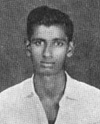 I came to know Lalith Wijesinghe when we both joined the 6th form in 1960 at Wesley College. The 6th Form Science was an exclusive club that met in the Biology lab day after day until we left school. That was a time of great uncertainty as to our future and also a time of hard work to cover extensive syllabuses for the all important University Entrance Examination. Then we were in our late teens brimming with confidence all out to have a good time whenever we could, and we did this. For many of us these were some of the best years of our lives. In my retirement I often return to these times to reminisce and think of the friends and teachers who meant so much to me.
I came to know Lalith Wijesinghe when we both joined the 6th form in 1960 at Wesley College. The 6th Form Science was an exclusive club that met in the Biology lab day after day until we left school. That was a time of great uncertainty as to our future and also a time of hard work to cover extensive syllabuses for the all important University Entrance Examination. Then we were in our late teens brimming with confidence all out to have a good time whenever we could, and we did this. For many of us these were some of the best years of our lives. In my retirement I often return to these times to reminisce and think of the friends and teachers who meant so much to me.
Lalith is an instinctive and gifted cricketer. His hand eye coordination, temperament and the physique were all well suited for an exceptional career in the sport. In those years in the 6th Form he played for the 1st XI team at school. His academic career was interrupted by the regular intrusions of cricket. Matches during the weekends and practices during the week took away most of his free time. Lalith had no time for study but created space for the usual teenage pranks. He relished the prospect of having a little fun at the expense of a particular Botany teacher who seriously and serially fractured Queen's English.
He captained cricket in 1962 and this was a formidable team ably lead. We were unbeaten that year which was a rare achievement. That had an extraordinary impact on the school. I was an avid spectator and watched many of the school games. What struck me most was his cool head in stressful situations during play. He manoeuvred the team through some tough times to emerge victorious. He became the hero of a generation of schoolboys. As a cricketer his gifts were sublime and he bore them with honour, modesty and distinction. I once asked the doyen of cricket at Wesley, Edmund Dissanayake, who was his best cricket captain, in all his years at Wesley. After much thought and deliberation he said it was L.C.R Wijesinghe for his astute judgment, cool head and talent as an all round cricketer. I cannot think of a better accolade from this great man. His contribution to cricket and to the life of the school was recognised when he was appointed a Prefect.
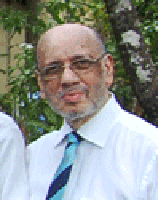 Lalith had a brother at school more senior and a shade fairer than him. They travelled to school from Baddegane Road in Pita Kotte. Lalith remembers most fondly his father watching the cricket matches at Campbell Park from a far corner of the grounds and is saddened he is not alive today.
Lalith had a brother at school more senior and a shade fairer than him. They travelled to school from Baddegane Road in Pita Kotte. Lalith remembers most fondly his father watching the cricket matches at Campbell Park from a far corner of the grounds and is saddened he is not alive today.
Although it was quite evident in class that he was academically gifted. He just had no time for studies. His scholarship was not of the sort that proceeds from laboriously reading piles of books or the analysis of copious notes. He applied his critical faculties and his common sense which he possessed in great abundance. At his best, when he really threw himself into something, he produced work that was thorough, penetrating and dazzling.
There were times we were engaged in some riotous behaviour. Lalith remained as always the person for commonsense and moderation. When we were wrong he had the courage to say so. He had his fun and good times in class but was always sensible. His considerable charm was not founded on good looks but his honesty, integrity, kindness and the ability to help at a time of need. These are some of his traits I recall from nearly 50 years ago.
After leaving school he taught at Wesley. The post did not carry a heavy teaching burden and it allowed him to make progress with his own work. He had the ambition and the intelligence to study further which he did while working in the Steel Corporation. He completed his academic career by obtaining his BSc in Metallurgy in London, MSc ( Eng) Lond. DIC ( Diploma of Imperial College), CEng..
His qualifications and experience gave him a rewarding and lucrative job in the Emirates in the Middle East. He worked for McDermott International in the Oil and Gas industry until retirement in 2007. He now lives in in Digana near Kandy enjoying the beautiful scenery and the peace it provides. It is said if you haven’t lived in Kandy you haven’t lived at all. I was born in that beautiful city and would agree with those sentiments, entirely .
After a whirlwind romance Lalith married Pamela . Theirs is a love story with a TV-Soap begining and a happy ending. They have 2 boys who are now grown up and useful citizens of this world.
Lalith has been an ardent supporter of the OWSC where he is a Past President and also a past Vice Patron. He has donated most generously to the school and the OWSC in times of need. Lalith often prefers to remain an anonymous donor and little has been said of the help he has given to those Wesleyites fallen on hard times. This speaks volumes of his love for his alma mater and his loyalty to his numerous school friends.
We have on many occasions spent hours discussing the political turmoil at the school, its remedies and drawbacks. What strikes me most is his optimism of a better tomorrow. He is a fountain of knowledge of school affairs for a person who dislikes politics.
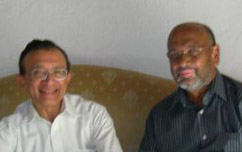 After leaving Wesley we both were busy making our careers and raising our families. As a result our paths never crossed. I was pleasantly surprised to hear his familiar voice on the phone in 1999. We happily exchanged greetings and remained in contact since. But we met for the first time since leaving school through the generosity of LR Goonetilleke who invited us both and Pamela to his home for lunch in November 2008. It was a wonderful reunion of which I think about often. The ravages of time have taken its toll on us both. He had lost most of his hair. He still speaks slowly and deliberately as he always did and has a razor-sharp sense of humour. There was a lot to catch up and we did. We spoke of the friends whom we have lost and also those who have embraced success in Sri Lanka and abroad. Time flew and once again we parted company with a promise to keep in touch. By now I have learnt to take his sincerity for granted.
After leaving Wesley we both were busy making our careers and raising our families. As a result our paths never crossed. I was pleasantly surprised to hear his familiar voice on the phone in 1999. We happily exchanged greetings and remained in contact since. But we met for the first time since leaving school through the generosity of LR Goonetilleke who invited us both and Pamela to his home for lunch in November 2008. It was a wonderful reunion of which I think about often. The ravages of time have taken its toll on us both. He had lost most of his hair. He still speaks slowly and deliberately as he always did and has a razor-sharp sense of humour. There was a lot to catch up and we did. We spoke of the friends whom we have lost and also those who have embraced success in Sri Lanka and abroad. Time flew and once again we parted company with a promise to keep in touch. By now I have learnt to take his sincerity for granted.
Lalith is always delighted to recognise merit in others. He is frugal with his praise as with his censure. His judgment is often sound. He is a fascinating and unforgettable figure, unlike anyone else. On behalf of the worldwide brotherhood of Wesleyites I wish Lalith and Pamela a long and happy retirement.
Addendum 25th February 2013: Lalith was the Chairman of the Committee that organised the Great Reunion of September 2012.
Links to further reading
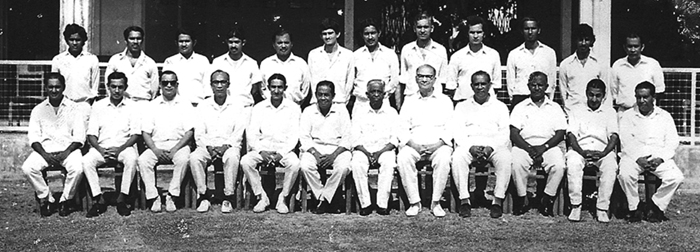
The final cricket match that Mahadevan Sathasivam played was the centenary cricket match between Past Captains vs Rest in 1974.
PAST CAPTAINS: 101 for 8 wkts dec (D. Kodituwakku 47, L. Wijesinghe 31 retd., D. Schokman 2 for 8, A. Ramachandra 2 for 13).
REST: 80 for 2 wkts (Mahadeva Sathasivam 46 not out). A. Ramachandra who played for the Rest was taken ill during the match and he died in hospital. The match was abandoned and the celebrations were cancelled.
By Major (Retd) H Careem Zavahir (New Zealand)
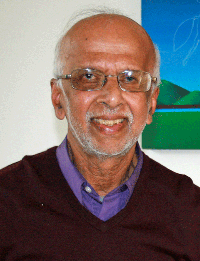 I am forwarding you some photos taken about 54 years ago. Image below is a photo of me in shorts taken in 1953 in the small park behind the school. I was a cricket fan and spent a lot of time during the lunch hours playing interclass cricket matches in the small park. My cap was inseparable and I wore it to school everyday.
I am forwarding you some photos taken about 54 years ago. Image below is a photo of me in shorts taken in 1953 in the small park behind the school. I was a cricket fan and spent a lot of time during the lunch hours playing interclass cricket matches in the small park. My cap was inseparable and I wore it to school everyday.
As a matter of interest all these photos were taken in the good old days with a Box Camera. The photo prints were developed by Golden Studio in Maradana.Boxing at Wesley was at its peak in the years 1952 – 1956. The college was well represented at the Ceylon Schools Boxing Stubb’s Shield Meet. Mr L.V.Jayaweera was our boxing coach and he was excellent. Boxing training classes were held Monday to Friday each week in the college hall from 3.30 pm onwards. We moved the benches around and formed a temporary ring.
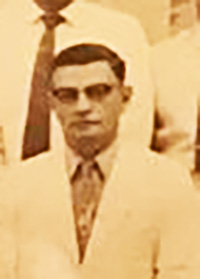 Mr Van Sanden was the boxing master in charge and he would make himself present during training sessions. He would give us a treat after training, that is a cup of tea from the tuck shop.
Mr Van Sanden was the boxing master in charge and he would make himself present during training sessions. He would give us a treat after training, that is a cup of tea from the tuck shop.
Mr Jayaweera was a devoted boxing coach. He would take us on sparring sessions and let us punch him as hard as we could, but he knew how to parry our punches. Before the Stubbs Shield meet we had physical fitness training on Saturdays at Campbell park at 7.00 in the morning. Mr Jayaweera always arrives on time riding his old bicycle. He made us run around the park shouting us at us when we slow down. He resembles Rocky Marciano when he is in his running kit
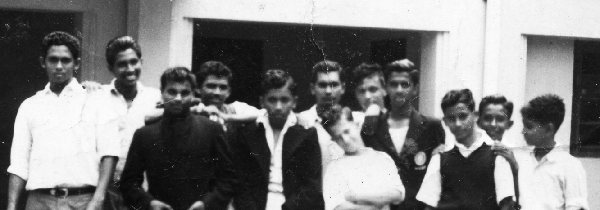
Above is the photo of Wesley College Boxing team for the Stubb’s Shield meet in 1954 taken at Trinity College Kandy.
The team members names,
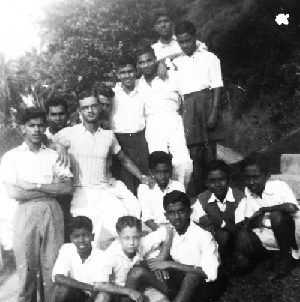
Above is the Wesley College Boxing Team for the Stubb’s Shield meet in 1955 held at Trinity College Kandy.
The team was accomodated at Kingswood College .
 Wesley had a fairly good boxing team from 1952 onwards for about 4 years. Emil Fernando, a south paw boxer was a terror in the ring. His bout do not last more than two minutes. He punches hard with a left upper cut on the opponent’s stomach. South paw boxers are a venom with their left punches and Emil was one of them. He has not lost a single bout at the Stubbs Shield meets he participated. All his wins were on knock outs. He starts off the contest with a flurry of hard stomach punches and shakes his opponent. Saybhan Samat was also another hard puncher and was always a winner. Ralph Vanroyen, David Shockman, Nagendran boxed in the heavy weight class and always entertained the boxing fans at the Stubbs Shield meet. Michaell Siebel, Ratnarajah, Samidon and Sappideen also boxed well with great speed. I also remember Ahamath (senior) and Wadugodapitiya who helped us during boxing training sessions and were very helpful. Mr Elmo Fernando assisted Mr Van Sanden as boxing master in charge. I recall that in 1952, after the Stubb’s Shield meet final held at Zahira College Maradana, Mr Vansanden took the boxing team for a treat to Buhary Hotel at Maradana. We were served Buriyani rice with a boiled egg in the centre, chicken drumstick and ice cream to finish off. It was a great treat for us at that time. We were placed third that year out of nine schools.
Wesley had a fairly good boxing team from 1952 onwards for about 4 years. Emil Fernando, a south paw boxer was a terror in the ring. His bout do not last more than two minutes. He punches hard with a left upper cut on the opponent’s stomach. South paw boxers are a venom with their left punches and Emil was one of them. He has not lost a single bout at the Stubbs Shield meets he participated. All his wins were on knock outs. He starts off the contest with a flurry of hard stomach punches and shakes his opponent. Saybhan Samat was also another hard puncher and was always a winner. Ralph Vanroyen, David Shockman, Nagendran boxed in the heavy weight class and always entertained the boxing fans at the Stubbs Shield meet. Michaell Siebel, Ratnarajah, Samidon and Sappideen also boxed well with great speed. I also remember Ahamath (senior) and Wadugodapitiya who helped us during boxing training sessions and were very helpful. Mr Elmo Fernando assisted Mr Van Sanden as boxing master in charge. I recall that in 1952, after the Stubb’s Shield meet final held at Zahira College Maradana, Mr Vansanden took the boxing team for a treat to Buhary Hotel at Maradana. We were served Buriyani rice with a boiled egg in the centre, chicken drumstick and ice cream to finish off. It was a great treat for us at that time. We were placed third that year out of nine schools.
I boxed for three successive Stubb’s Sheild meets, won once in the final and was runner up in the other two bouts. I continued boxing in the Amateur Boxing Association meets (ABA of Ceylon) whilst still at Wesley and was unbeaten in six fights in the finals, including the National Championship Pin Weight class when I won against Anton John who was unbeaten for 6 years. I continued boxing after I went to the Royal Military Academy Sandhurst for officer training and remained unbeaten in 9 bouts in the two years I spent at Sandhurst . My opponents included, Oxford University Captain and Dublin University Captain. The grounding in boxing I got whilst at Wesley under Mr Jayaweera stood me in good stead when I decided to continue this sport. I was appointed vice captain of the Sandhurst Boxing team in 1959.
Although Wesley had a good boxing team during my time, we were unfortunate in that we did not win the Stubb’s Shield at that time although we had many winners in the finals. As far as I remember, once we finished third out of some nine schools that participated. Royal College , Trinity College and St Sylvester college Kandy were our main competitors.
Thanks Nihal for giving me the opportunity to contribute to the past history of Wesley OBU and your keen interest in the past history of Wesley is well appreciated.
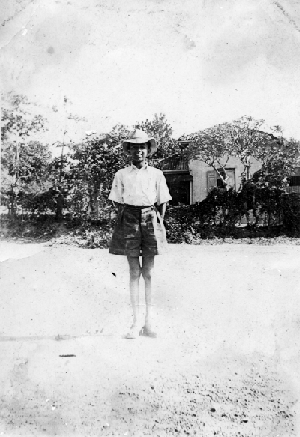
Addendum by Nihal D Amerasekera : The Small Park (as shown in the above photo) was a play ground behind the school in Karlsruhe Gardens and owned by the school. It was the venue for keenly contested cricket matches in the lunch interval. The grounds was extensively used by the boarders who played football and cricket after school and at weekends. We sadly do not own that land anymore as it was sold for a pittance to property developers in the 1960's. On hindsight this sale of prime school property was a disastrous loss for Wesley. Please read:
Links to further reading
A note from Dr Nihal D Amerasekera:
The name 'Zavahir' was synonymous with Boxing at Wesley in the 1950's. The two Zavahir brothers brought honour and recognition to the school by their excellent performances in the ring. As now even in those days it was regarded as a 'manly' combat sport and a true test of strength, courage, stamina and talent. The boxers were held in high regard. Mr.LV Jayaweera Senior and the Master in Charge Mr Van Sanden by their enthusiasm and hardwork improved the standard of boxing at Wesley. They are both, sadly, no more. I recall watching the practice sessions at the back of the great hall.
 Mr Jayaweera looked like the famous African-American Joe Louis. He was one of the outstanding schoolboy boxing-trainers of the 1950's. The great Hall at Wesley College was the training ring. He made acclaimed improvements in the skill, stamina and discipline of those in his care. He was a father figure to the boxers and a caring, conscientious man who was the total opposite to the usual image of boxing coaches. He spoke loudly but was polite and was a fine student of the noble art. A master of the ringside, LVJ was an implacable coach who calmly trod the fine line between forcefulness and consideration. He invariably showed compassion for his boxers and did all that was possible to prevent harm during bouts. The Inter-School Boxing was an annual event for the coveted Stubbs Shield. We honour the boxers and the coaches for their comittment to the game. H. Careem Zavahir was one of the finest schoolboy boxers of his time. It is indeed a great pleasure to make contact with him after half a century. After a successful career in the New Zealand Army he retired as a Major. The passage of years has not diminished his love for Wesley College. The brotherhood of Wesleyites worldwide would like to wish him a long and happy retirement.
Mr Jayaweera looked like the famous African-American Joe Louis. He was one of the outstanding schoolboy boxing-trainers of the 1950's. The great Hall at Wesley College was the training ring. He made acclaimed improvements in the skill, stamina and discipline of those in his care. He was a father figure to the boxers and a caring, conscientious man who was the total opposite to the usual image of boxing coaches. He spoke loudly but was polite and was a fine student of the noble art. A master of the ringside, LVJ was an implacable coach who calmly trod the fine line between forcefulness and consideration. He invariably showed compassion for his boxers and did all that was possible to prevent harm during bouts. The Inter-School Boxing was an annual event for the coveted Stubbs Shield. We honour the boxers and the coaches for their comittment to the game. H. Careem Zavahir was one of the finest schoolboy boxers of his time. It is indeed a great pleasure to make contact with him after half a century. After a successful career in the New Zealand Army he retired as a Major. The passage of years has not diminished his love for Wesley College. The brotherhood of Wesleyites worldwide would like to wish him a long and happy retirement.
Links to further reading
By Nizar Sappideen, NSW, Australia
I was a member of the very successful College boxing team of 1954.
 Wesley took part in the Ceylon Schools Boxing Association - STUBBS' SHIELD MEET in 1954, which was held at Trinity College, Kandy for the first time. Wesley was placed third in the overall rankings. 1954, probably was the most glorious year of boxing at Wesley. I was a proud member of this team. The team was captained by David Shockman and coached by L. V. Jayaweera, a champion boxer himself during his time. I boxed in the 'PIN' weight class. In the semi-finals I beat a guy called Dilpechitra from St. Sylvesters College, Kandy, who was the favourite to win the event. I was a bit over confident in the finals, and lost to D. N. Perera from Christian College, Kotte, in a split decision. I was awarded College colours for my performance.
Wesley took part in the Ceylon Schools Boxing Association - STUBBS' SHIELD MEET in 1954, which was held at Trinity College, Kandy for the first time. Wesley was placed third in the overall rankings. 1954, probably was the most glorious year of boxing at Wesley. I was a proud member of this team. The team was captained by David Shockman and coached by L. V. Jayaweera, a champion boxer himself during his time. I boxed in the 'PIN' weight class. In the semi-finals I beat a guy called Dilpechitra from St. Sylvesters College, Kandy, who was the favourite to win the event. I was a bit over confident in the finals, and lost to D. N. Perera from Christian College, Kotte, in a split decision. I was awarded College colours for my performance.
I read with interest the article written by H.C. Zavahir, a member of the 1954 team. All are of opinion that he was the most scientific boxer Wesley produced, and eventually became the 'PIN' weight champion of Ceylon.
Links to further reading
Excerpts from the History of Boxing in Schools by Donald Munasinghe
From the Ceylon Daily News of 4th September 2004
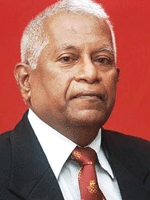 The Stubbs Shield was named after Sir Edward Stubbs, the Colonial Secretary, 1913- 1919, after which he was Governor Hong Kong, 1919-25. Sir Edwards returned to Ceylon in 1933 as Governor.
The Stubbs Shield was named after Sir Edward Stubbs, the Colonial Secretary, 1913- 1919, after which he was Governor Hong Kong, 1919-25. Sir Edwards returned to Ceylon in 1933 as Governor.
Boxing Introduced to Schools
At the beginning of the Second decade of the 20th Century, around 1912, in order to popularise this new game, boxing was introduced to Schools of Ceylon. At this time C.G. Pigford of the Ceylon police along with L.M.C.D. Robinson taught boxing at the Old Police Training School at Thimbirigasyaya where the Police Field Force Headquarters is now situated.
Any schoolboy around the area who wanted to learn the game there, was most welcome. Donald Obeysekara, a Cambridge University Blue (Coloursman) taught boxing at his old school Royal College.
A.B. Henricus of Royal Army taught boxing at Wesley College, Borella. R.V. Routledge and Sgt. Major Jobson trained boxers at Trinity College, Kandy and John Gaye taught at St. Anthony's College, Kandy, where the present St. Sylvesters is situated whilst St. Thomas' Mt. Lavinia also started the game during the same era.
Stubbs Shield Competition begins
It was the British Tea-Planter S.C. Trail who fore-saw that boxing could be made popular and be wide-spread throughout the country by introducing an All-Island Inter Schools Championship Tournament. He met the British Colonial Secretary of Ceylon then, (later the Governor) Sir. R. Edward Stubbs and obtained his permission to present a challenge shield in Sir Stubbs' name at a championship boxing tournament.
Trail then drew up rules and conditions to hold an All Island Inter-Schools boxing tournament and also got a large shield made, had it engraved it as the "Stubbs Shield" and passed on the drawn up papers and the Shield to the USBAC to conduct this tournament annually.
The inaugural tournament was held at Royal College Hall in July 1914 and Trinity College Kandy won the First Championship. Trinity retained the Championship in 1915 but St. Thomas' College, Mt. Lavinia won it in 1916. Trinity re-captured it in 1917 and retained it in 1918.
Burgher Crowds Fill Boxing Halls
As the medium of education at Schools upto Nineteen Sixties was English, there were lot of Burgher boys studying at Schools. Those affluent, went to schools such as Royal, St. Thomas', Mt. Lavinia, St. Peters' Bambalapitiya, Trinity, St. Anthony's Kandy, Carey and Wesley.
The less affluent ones went to Arethusa, Wellawatte, St. Michaels, Polwatte, St. Mary's Dehiwala, Cathedral Kotahena and St. Sylvester' Kandy
Records in the Annals of the Stubbs Meet
In the long annals of 85-years of Stubbs Shield Boxing Royal College, Colombo has dominated. They have won the shield 18 times the highest ever for any school. Except in 1999, Royal has participated 84 times, which is also a record.
They have won the shield consecutively for four years on two occasions from 1944 to 1947 and 40 years later from 1984 to 1987. Both Trinity College and St. Sylvester's College have won 11 times each. St. Mary's College, Dehiwala has won it seven times St. Thomas College, Mt. Lavinia and Zahira College, Maradana have won it five times each. However, Vidyartha College, Kandy holds the unique record for winning the Shield consecutively for seven years from 1991 to 1997.
The L. V. Jayaweera Boxing meet and its history By Donald Munasinghe
- Island Newspaper June 2002The Schools Boxing Association of Sri Lanka, has made arrangements to hold their annual inter-schools freshers boxing tournament for the L. V. Jayaweera Memorial Cup, from June 6 to 9.
This years venue will be Polonnaruwa, Royal College.
Last year’s winners St. Sylvester’s will be out to retain the cup, but they will receive stiff competition from St. John’s College, Nugegoda, Royal College, Colombo, Seevali MMV, Ratnapura and the Year 2000 winners Pilimatalawa MMV.
Before 1969, the Stubbs’ Shield Championships was the only boxing tournament for schoolboys where the weight categories were matched with corresponding age limits. The standard was extremely high and the champions with ex-perience kept on participating annually as long as they were in school. The newcomers rarely had a chance of winning. Hence in 1969, an inter-schools novices meet was introduced for the benefit of new schoolboys in order to gain experience prior to participating at the Stubbs Shield Championships. This new tournament was named as the T. B. Jayah Memorial Cup Meet, in the name of Maradana Zahira College’s Principal who had been a past President of the Association.
However, there were plenty of novices, who could not win even at the T. B. Jayah meet, but spiritedly kept on fighting for many years, until they finally won at the finals. By this method, they gained much experience. The freshers who wanted to box at the novices meet feared to face the much experienced boxers.
In 1972, N. Thambimuttu, the Master-in Charge of Boxing at St. Michael’s College Polwatte (Colpetty), had a brain-wave and suggested a new idea, a kind of panacea, to eradicate this unwarrented fear. He and I formulated a plan to hold a new meet, purely for freshers (the first-time participants). The meet was to be called "the L. V. Jayaweera Memorial Cup Meet", in memory of a famous and fine boxer in the twenties and thirties. He had boxed for the Ceylon Garrison Artillary (CGA) and at National Championships held in 1927 and had been adjudged as the Most Scientific Boxer. Later, he coached the Carey College team. Fredrick Obeysekera donated the challenge cup to Jayaweera’s memory.
The inaugural meet was held in May 1972 at the Army Basketball Courts in Echelon Square where the Galadari Meridian Hotel stands. The Mahiyangana Maha Vidyalaya (now a Central College) boxers who had come to Colombo for the first time carried away the trophy. I was there as Science Master and Boxing Coach. Of the 6 boxers we could only bring 5 and win the finals and the other was the runner-up. In giving publicity to the epic event one newspaper had a caption "Kurakkan Strength brings victory". Another said "Boxers made out of Iron".
Royal College, Colombo was placed second and St. Mary’s College, Dehiwala third. A farmer from Mahiyangana, a parent of a boxer who accompanied us, was unexpectedly called upon to the ring to give away the awards.
Team Photo kindly sent to me by Frank Daniel via L.C.R Wijesinghe
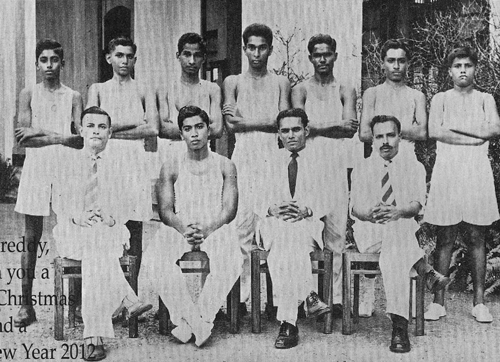
The glorious history of the Stubbs Shield Boxing Meet by Donald Munasinghe
- Daily News Sept 2003The reader will be surprised to learn that the oldest boxing tournament of Sri Lanka is an Inter-Schools Meet. It is none other than the Stubbs Shield Championships.
 The 85th Stubbs Shield Boxing meet will be held on 6th, 7th & 8th of September at Sugathadasa Indoor Stadium, Kotahena. The meet had originated in 1914 and since then it had not been held only on 3 occasions, in 1942 and 1943 due to the 2nd World War and in 1988 due to political disturbances in the country.
The 85th Stubbs Shield Boxing meet will be held on 6th, 7th & 8th of September at Sugathadasa Indoor Stadium, Kotahena. The meet had originated in 1914 and since then it had not been held only on 3 occasions, in 1942 and 1943 due to the 2nd World War and in 1988 due to political disturbances in the country.
Since the beginning of the 20th Century, British Armed Forces were in occupation of the country. The men serving in these forces had to be kept in prime condition and fighting fit. Boxing was among many games introduced to them. Being a man-to-man game it caught up popularity and drew huge crowds. Inter Regiment Contests in the Army, Inter Command Meets in the Navy and Inter Squadron Contests in the Air Force were conducted. In order to control and conduct boxing tournaments a body consisting of officers from the 3 Armed Forces was formed. This was named as the United Services Boxing Association of Ceylon or the USBAC.
In 1911, certain British personnel and a few locals who had boxed commenced teaching this new game as a sport at some of our leading schools, Police and YMCA. A former Cambridge University Blue (Coloursman) Mr. Donald Obeysekera introduced boxing to his Alma Mater, Royal College. An Army boxer Mr. A. B. Henricus (Senior) taught the game at Wesley College. Englishman Mr. John Gaye introduced boxing to St. Anthony's College, Kandy. Two other Englishmen Mr. R. V. Routledge and Sgt Major Jabson helped Trinity College, Kandy. Mr. C. G. Pigford of Ceylon Police and Mr. L. Mc D. Robinson trained the Police boxers at the Old Police Training School at Thimbirigasyaya. St. Thomas' College, Mt. Lavinia was another pioneer starter.
It was the British Planter Mr. S. C. Trail who took a keen interest to promote this new game among local schools. He had learnt to box at Bedford School in England. He planned to hold an annual Championship Contest among schools. He met the Colonial Secretary of Ceylon then (Later the Governor) Sir R. Edward Stubbs and got the consent to hold this annual tournament in his name. He then got a large shield made and met the officials of the USBAC and requested them to formulate Rules and Regulations for the tournament.
At the inception, schoolboys who were under 18 years of age and between 50 lbs and 140 lbs could compete in any weight category each exceeding the next by 05 lbs.
However, a school team could comprise only of 8 boxers. The limit of 8 boxers rule still prevails. The USBAC conducted the inaugural tournament in July 1914 at Royal College Hall which was packed with screening and cheering schoolboys.
Trinity College, Kandy won the championship and the proud Trinity Captain received the large Stubbs Shield from the Colonial Secretary who was present as the Chief Guest for the Finals. Trinity retained the Shield in 1915. St. Thomas, Mt. Lavinia won it in 1916 but Trinity re-captured it in 1917 and retained it in 1918. Trinity and St. Anthonys alternatively kept the Shield among them in Kandy from 1917 to 1926.
The USBAC conducted this tournament till 1925. In 1926, the USBAC was dissolved and the Amateur Boxing Association of Ceylon was formed and this new body included Police and YMCA. The ABA ran the Stubbs tournament till 1934. In 1935 a separate body consisting of school teachers from participating schools was formed. It was called the Ceylon Schools Boxing Association (CSBA). The first President was Mr. L. H. W. Sampson, the Principal of Royal College. The CSBA ran the tournament from 1935 onwards with the assistance of the ABA. In 1972 CSBA became SBASL, the Schools Boxing Association of Sri Lanka. The SBASL runs the meet now.
The CSBA formulated 15 weight categories ranging from 65 lbs to 135 lbs. Each weight category had a maximum age limit thereby minimising dangers. In mid seventies 55 lbs and 60 lbs weight categories were added. Today there are 17 weight categories with the lowest and highest weights being 33 kilos and 63.5 kilos respectively. Each weight has a maximum age.
In 1991 on an appeal made by the Senior Vice President then Mr. Donald Munasinghe, the Education Ministry Sports Department agreed to consider the Stubbs Shield tournament as a National Schools Game and started sponsoring the meet since that year. The Stubbs winners now receive an additional Shield presented by the Education Ministry.
In the long history of 84 years, except in 1994, Royal College has competed for 83 years. They hold the highest number of victories, 18 times. Trinity and St. Sylvesters have won 11 times each. St. Marys Dehiwala and Vidyartha Kandy have won 7 times each.
Vidyartha holds the unique record of winning the Shield consecutively for 7 years from 1991 to 1997. Zahira College, Maradana and St. Thomas', Mt. Lavinia have won 5 times each.
In the past, winning at the finals of Stubbs meet had been a dream of every schoolboy. He was awarded school colours and was considered as a hero by his peers. In the decades of fifties and sixties, the 3 Armed Forces were eager to recruit the winners who reached 18 yrs to box for them.
The standard was so high that all winners were automatically selected to represent the Ceylon Schools team for the Indo-Ceylon dual contest which was held from 1959 to 1966. It also became a qualification to contest for a key post in the ABA, the controlling body.
Last year Pilimatalawa MMV won the Shield. Ratnapura Seeval MV won in 2000 and 2001.
They are in the forefront of the contest this year too. However both Royal and Carey have been training hard and this year it is difficult to predict the winners.
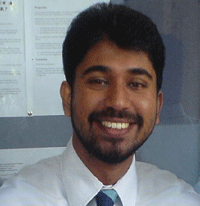 I still remember the day that we heard of the passing away of who was possibly the greatest batsman of all time. It was a Monday morning in 2001. I was then a sub-prefect of college standing on duty at the assembly in the college main hall, my position to be exact- under the photograph of the late Sir Oliver whose benign gaze spreads over the scores of students sitting in rows of wooden benches awaiting the arrival of the Principal and the tutorial staff to commence assembly. The principal at the time was Mr. Dunstan Fernando who was handed the stewardship of Wesley as acting Principal, taking the mantle of the esteemed chair for a second time in his long and valuable career at our college.
I still remember the day that we heard of the passing away of who was possibly the greatest batsman of all time. It was a Monday morning in 2001. I was then a sub-prefect of college standing on duty at the assembly in the college main hall, my position to be exact- under the photograph of the late Sir Oliver whose benign gaze spreads over the scores of students sitting in rows of wooden benches awaiting the arrival of the Principal and the tutorial staff to commence assembly. The principal at the time was Mr. Dunstan Fernando who was handed the stewardship of Wesley as acting Principal, taking the mantle of the esteemed chair for a second time in his long and valuable career at our college.
The assembly commenced with a rather sad announcement of one of cricket’s great immortals. ‘Dunstan sir’ announced to the assembly that he had heard on the morning news that Don Bradman the great Australian cricketer had passed away. I can recall clearly how the news saddened me. Mr. Fernando told us what an exemplary life ‘the Don’ had presented and how his gentlemanly conduct and humility were imbued with values that we should all try to emulate. He said how once a journalist in Australia in an article about Donald Bradman had written that mentioned that his father-in-law was a banker. And how seeing this error ‘the Don’ had written to the paper pointing out the mistake and putting the record right by stating that his wife’s father was in fact a farmer. Dunstan sir emphasized how it was a mark of great integrity for a man to put the record right to give a truthful picture, though people generally would think the image of a banker would seem far more superior and sophisticated than a farmer. The Principal told us that it is the example Donald Bradman showed the world as a great sportsman whose conduct proved the meaning of ‘sportsmanship’ that makes his character highly praiseworthy. We were told that the college flag was put on half-mast as a show of respect to this great cricketer whose greatness was equally so as a gentleman. The latter attribute being what merited an official mark of respect from Wesley College, to have the double blue fly at half-mast out of deference to the passing away of a great figure of gentlemanliness. A trait that should be definitive of a Wesleyite.
And so the Principal called for the assembly to rise for to observe a moments silence in respect to the life of Sir Donald Bradman. I could not help but note that Dunstan sir, when he mentioned ‘the Don’s’ full name said it as “Donald Gerard Bradman” when in fact the Don’s middle name is ‘George’. A minor lapse of no real damage I should say. This is my recollection of the day that I heard of the demise of who was arguably the greatest run making machine the world of cricket has seen so far. It was a moment I remember well, how we as boys told to uphold the values that form a gentlemen paid respect to a man who exemplified values that we are told must be emulated.
Years from that day, 25th February 2001, when some batch mates of mine and I paid a visit to Dunstan sir at his home in Lunawa Moratuwa where he now lives in restful retirement with his beloved wife Chinthamani, I happened to mention this memory I had of him calling a moment’s silence to remember ‘the Don.’ Of course now with the years catching on, he could not recall this event but was quick to agree that Sir Donald Bradman was very likely the best there was. And so in conclusion as a recall this moment from my days in Wesley and make an account of it in the hope that the deep message and significance that can be read of it, will be appreciated by fellow Wesleyites. I sincerely believe that Wesley’s creed must be to produce men who can be true gentlemen, in the likes of Sir Don Bradman and also Principal Dunstan Fernando who not only presented a form of conduct and demeanor of a venerable gentleman but also had the great sensibility of indentifying the traits of gentlemanliness and giving in due recognition.
By Sharm de Alwis
 I did not wear my Trinity cap in deference to my one year stint at Wesley wherein, together with Baboo Ahamath, I agitated with the authorities to re-introduce boxing to the extra-curricular format of the college. Here it was that I had my head thumped three times on the desk for having suggested "brassiere" when we were asked by Harold ‘Pappa’ for the adjective of brass. I will vouch that ‘Pappa’ de Mel had a sense of humour from the wrinkled lines on the face behind the years of wisdom even as he admonished me.
I did not wear my Trinity cap in deference to my one year stint at Wesley wherein, together with Baboo Ahamath, I agitated with the authorities to re-introduce boxing to the extra-curricular format of the college. Here it was that I had my head thumped three times on the desk for having suggested "brassiere" when we were asked by Harold ‘Pappa’ for the adjective of brass. I will vouch that ‘Pappa’ de Mel had a sense of humour from the wrinkled lines on the face behind the years of wisdom even as he admonished me.
I was the only spectator on both sides of the divide until Ana Paranavitana and Chris Dassenaike came along. There were two pretty ladies who I thought wrongly to be Trinity mothers because in my one year term at Wesley, mothers did not come for cricket matches. I asked them and they said, "No. We are Wesley mothers." The game of cricket was being played for the R. L. Kannangara Trophy, a prolific scorer with the willow for Wesley before he joined the Tutorial Staff of Trinity to teach of books and culture and to walk the straight line.The Trinity/Wesley cricket encounter is the third oldest in Trinity’s cricket fixtures. It commenced in 1903 after the Trinity-Royal in 1893 and Trinity-STC in 1897. C. B. Aluvihare captained for the first of his three year terms for Trinity and Wesley’s captain was that doyen of sports writers, S. P. Foenander. Wesley won the inaugural game.
 I missed Niroshan Dickwella’s polished 114 purely because I placed bread and butter above cricket and frolics but I was given a fair resume by Ana P. When Wesley wickets fell like skittles in their second innings and only death-throes were visible, a punchy stand thwarted an early finish. To overhaul 352 runs with 272 for 6 declared in the kitty would have been a chicken feed, but the Trinitians were in a hurry like at Asgiriya when they wished to ‘hit’ the 3.30 movies. Anyway, they finished with the flourish of a boundary to retain the R. L. Kannangara Trophy.
I missed Niroshan Dickwella’s polished 114 purely because I placed bread and butter above cricket and frolics but I was given a fair resume by Ana P. When Wesley wickets fell like skittles in their second innings and only death-throes were visible, a punchy stand thwarted an early finish. To overhaul 352 runs with 272 for 6 declared in the kitty would have been a chicken feed, but the Trinitians were in a hurry like at Asgiriya when they wished to ‘hit’ the 3.30 movies. Anyway, they finished with the flourish of a boundary to retain the R. L. Kannangara Trophy.
It was, certainly, a far cry from 1956 when Mahinda Ratwatte, in a show of false bravado gave Wesley 37 runs to get in 17 minutes by cutting short the change over ten minutes by half and Lou Adhihetty ‘went to town’ and brought the goodies home. Sampath Perera is Kumar Sangakkara’s gift to Trinity in as much as Kumar is Trinity’s gift to SL Cricket. But Janishka Premasinghe whose father, Susil, opened batting for Trinity in the all-conquering team of 1986 led by Tusha Weerasooriya, should be taught decorum by his skipper Akila Jayasundera. The manner in which he appealed for a LBW was as though he was on burning cinders. Not done, Trinity.
Highlights of the game were 6 wickets by Wesley’s Daniel Bartholomeusz in Trinity’s second essay; 114 by Niroshan Dickwella, 5 for 46 + 2 for 67 by Aaamil Anaz. Others chipped in adequately.
By Premasiri Epasinghe
 The dream begins with a teacher, who believes in you, who tugs and pushes and leads you to the next plateau. If I may quote the famous Pandit Guru Govinda (1898-1985), a guru is an individual, who is definitely more than a teacher or a pedagogue, a strict or formal teacher. This individual has all these atributes. There are certain teachers whose names are synonymous with the schools they teach. Also, there are school cricketers, many names that go with the respective schools they studied at. For example, Viji Weerasinghe, E. C. Gunasekera of Royal, W. D. E. Perera, Captain V. I. Perera, Stanley Munasinghe, W. B. (Bertie) Perera with Nalanda, Keerthisinghe, A. D. Karunanda, Bertie Fernando with Ananda, Lassie Abeywardane, Bertie Wijesinghe, Orville Abeynaike, Jayasena Ratnayaka with S. Thomas’ College, Mount Lavinia and Edmund Dissanayake, with Wesley, to name a few.
The dream begins with a teacher, who believes in you, who tugs and pushes and leads you to the next plateau. If I may quote the famous Pandit Guru Govinda (1898-1985), a guru is an individual, who is definitely more than a teacher or a pedagogue, a strict or formal teacher. This individual has all these atributes. There are certain teachers whose names are synonymous with the schools they teach. Also, there are school cricketers, many names that go with the respective schools they studied at. For example, Viji Weerasinghe, E. C. Gunasekera of Royal, W. D. E. Perera, Captain V. I. Perera, Stanley Munasinghe, W. B. (Bertie) Perera with Nalanda, Keerthisinghe, A. D. Karunanda, Bertie Fernando with Ananda, Lassie Abeywardane, Bertie Wijesinghe, Orville Abeynaike, Jayasena Ratnayaka with S. Thomas’ College, Mount Lavinia and Edmund Dissanayake, with Wesley, to name a few.
Out of the schoolboy cricketers, some of the names like Amendra’s of Mahinda, Gunasekera’s and De Saram’s at Royal College, Senanayake’s (D. S., Dudley, Robert), Molamure’s, Bulankulama’s and Pieris’s) from S. Thomas’ Perera’s – Lincoln, Parliamentarian and Chairman of the United National Party, Gamini Jayawickrama Perera, Asoka Warnapura, Weerasinghe, Illukkumbura’s, (Daya, Karunatilake), Narangoda’s, (Herbert, Eastmen, Leslie, Jayantha), Nalanda’s, Ranatunga’s – Dhammika, Arjuna, Prasanna, Nishantha, Ruwan, are unforgettable. Dissanayake clan The name Edmund Dissanayake as a school cricketer and a teacher at Wesley College, Colombo is one of a kind. Wesley College and the Dissanayakes are inseparable. Fathers, brothers and sons have represented Wesley at cricket.
The Dissanayake clan began their cricket career in Wesley in late 1930s. Bertram played for Wesley from 1939-1941, Chandra, Donald, Edmund from 1944-1945, Graham Dissanayake, who retired as the Commissioner of the Food Department was the first Ceylonese to secure the Diploma in Development Administration (Manchester). His son, a livewire at Wesley, Mahendra Dissanayake, captained in 1984. He played cricket in Australia too. While in Australia, Mahendra, son of Graham, obtained the Bachelor of Engineering Degree and Msc in Information Technology.
Record breakers – father and son All these Dissanayakes (father-son combination), wrote their names in gold in the cricketing history of Wesley. They both captained the college. Both scored centuries against Royal College, another unique record. These two Dissanayakes set many records at Wesley. Edmund’s son Danesh, did better than the father Edmund, by scoring two centuries against Royal. Fairy tale The Wesley and Dissanayake episode, is like a fairy tale. It will not be complete, if I do not enlighten you on the famous, Wesley – S. Thomas’ encounter in 1947. Wesley were riding high, having beaten Royal a week before. The Thomians were captained by Upali Katugaha and Wesley by Edmund Dissanayake. Ronnie Weerakoon was the vice captain of S. Thomas’ College. An unprecedented crowd flocked to Mount Lavinia to see a ‘Greek meeting a Greek’. Edmund Dissanayake had a premonition of disaster before the game. On the second day of the match (Saturday), Wesley Principal, Rev. James Cartman, decided to drive Edmund in his car to Mount Lavinia. The car stalled near the Lady Ridgeway Hospital, Borella. Was it a bad omen? They managed to do a quick repair and proceeded to Mount Lavinia. The first day belonged to Wesley with their skipper Edmund Dissanayake capturing 6 for 14 in the first innings. In the second essay, the school by the sea were at sea, losing their last six wickets for 60 and and were staring at defeat. Edmund Dissanayake was a brilliant captain. He was a fine strategist. From one end he brought in N. S. Jayasundera, a spinner for an odd over. Edmund, the fighting captain, took up position at short leg. During this era, there were no helmets and other protective gear. Ronnie Weerakoon was at strike facing N. S. Jayawickrema. One of his deliveries slipped off his palm. Ronnie clobbered the full toss with all his might and the red cherry struck Edmund with a resounding thud on his head. Edmund swung around and around like a merry-go-round. Wesley Principal Rev. Cartman was the first to rush to the field and carried his injured skipper Edmund. Before Edmund lapsed into unconsciousness, he instructed the deputy skipper regarding the bowling changes. While Edmund was battling for his life at the hospital, Wesley emerged victorious by 112 runs.
At the hospital the good doctor Dr. J. H. F. Jayasuriya, the eminent Neuro Surgeon, battled round the clock to save Edmund’s life. He suffered from concussion, laceration of the brain tissues, associated with paralysis of the region below the waist. Edmund Dissanayake’s recovery was a miracle. For nearly three months Edmund’s life was hanging on a thread. Added to all this commotion, there was a death notice in the Daily News – stop press – E. Dissanayake. Presuming that the worst had happened to Edmund, people sent floral tributes and telegrams and rushed to E. Dissanayake’s residence. The Royal and S. Thomas’ cricket teams were also present to pay their last respects. Can you believe, the lady principal, teachers and students in the southern capital, the sister school of Richmond, Rippon Girls School, held a memorial service on behalf of the living Edmund Dissanayake. Wesley – A great seat of learning Wesley was founded on March 2, 1874. Through its portals, several highly distinguished sons have passed through. To name a few out of many; Sir D. B. Jeyatilleke, Dr. E. W. Adikaram, Prof. J. E. Jayasuriya, Prof. E. F. C. Loduwyke, P. de S. Kularatne, Father S. G. Perera, Sir Oliver Goonetileke, Sir Claude Corea, Sir Gerard Wijekoon, Sir Mohammed Macan Markar, Justice Amir Ismail and Rienzie Wijetilake. From Wesley emerged Sri Lanka cricketers, M. Sathasivam, Abu Fuard, L. R. Gunatileke and Sridharan Jeganathan.
Edmund began has career as a teacher at Wesley and rose to the rank and positions of Head Master, Deputy Principal, Prefect of Games and Master-in-Charge of Cricket. Edmund Dissanayake taught at Wesley from 1949 to 1980, the last five years as Head-Master. Then from 1982 to 1985, he taught English at the University of Sri Jayawardenapura. From 1982 to 2005, he was an English Lecturer attached to Aquinas. In the meantime, he did his law studies and became an Attorney-at-Law. From 1980 to 2005, he worked as an attorney at the Magistrate’s Court. After a motor accident, in 2005, he did not attend court. For the last five years he had been kept under ‘House Detention’. His beloved wife Amara is nursing him. Daughter Gaithri, daughter-in-law Kanchana and son Danesh have given a fresh lease of life to Edmund Dissanayake.

Letter to Nihal Amerasekera(1)
Letter to Nihal Amerasekera(2)
Bryan's list of school friends
Letter to Peter Casiechetty(1)
Letter to Peter Casiechetty(2)
Gopalan Trophy Match 1953 in Madras
Under 12 Cricket against Hill School Nuwara Eliya 1948
Bryan sweeps the ball - Gopalan Trophy
By Premasara Epasinghe
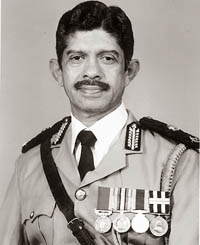 B. M. N. Jurangpathy CRICKET: There are certain names that are synonymous with their respective schools. Mahinda College, Galle and Amendras are inseparable. So are the Wettimunys and Ranatungas of Ananda and Narangodas and Nalanda. S. Thomas' and Saravanamuttus go hand-in-hand. Gunasekeras and Royal are the same. When you trace the history of cricket at Wesley College, Dissanayakes, Fuards, Jurangpathys are one, not two. These three names are linked to Wesley College. Today I feature a 'top cop' a versatile sportsman who rose from the rank of Sub-Inspector to Deputy Inspector General of Police at the time he retired. He is a Wesleyite. He is none other than B. M. N. Jurangpathy, the retired DIG. He was an ornament to Police. A man of honesty and integrity - gentleman par excellence and a fine human being. Tracing the history of Jurangpathy is as interesting as his sports achievements.
B. M. N. Jurangpathy CRICKET: There are certain names that are synonymous with their respective schools. Mahinda College, Galle and Amendras are inseparable. So are the Wettimunys and Ranatungas of Ananda and Narangodas and Nalanda. S. Thomas' and Saravanamuttus go hand-in-hand. Gunasekeras and Royal are the same. When you trace the history of cricket at Wesley College, Dissanayakes, Fuards, Jurangpathys are one, not two. These three names are linked to Wesley College. Today I feature a 'top cop' a versatile sportsman who rose from the rank of Sub-Inspector to Deputy Inspector General of Police at the time he retired. He is a Wesleyite. He is none other than B. M. N. Jurangpathy, the retired DIG. He was an ornament to Police. A man of honesty and integrity - gentleman par excellence and a fine human being. Tracing the history of Jurangpathy is as interesting as his sports achievements.
To begin with, he was the 9th in a family of 13, of 7 boys. Five of them attended Wesley College, a great seat of learning in Sri Lanka. These five Jurangpathys attended Wesley College at the tail end of World War II. At that time Wesley was housed at Kitiyakkara, opposite All Saints Church. The Imperial Army occupied the College building at Karlsruhe Gardens, later handed back to Wesley which moved to its present premises along with Campbell Park being vested. Jurangpathy, started his school career at Wesley from the lower kindergarten up to HSC. The principal then was that great educationist Rev. James Cartman. He was a lover of cricket and the President of the Schools Cricket Association. Cricket was a passion at Wesley under the guidance of Rev. Cartman.
Under the coach Vanburen and A. V. Fernando, Master-in-charge junior cricket, Wesley cricket prowess moved from strength to strength. Not like the present day, cricket enthusiasm was great at that time. At Wesley, the entire hostel, students, staff, parents, old boys would assemble in thousands to cheer their team. Matches then were of two days duration, commencing at 12 noon. It was the pride for the cricketers on a Friday morning, when the team was announced at the College Assembly and to walk adorning the 'Dark blue Light Blue' College blazers. The college song was sung followed by the famous war cry Zam, Zam, Zake. Such was the interest shown for cricket at Wesley College.
Schoolboy Jurangpathy grew up at Wesley in this environment. He played in the under-14 side captained by Brian Classen. He was coached by late A. V. Fernando. Under the captaincy of Lou Adhihetty, he played in the under-16 cricket team. Jurangpathy represented the Wesley first XI from 1952 to 1955. His team-mates were captain Brian Classen, vice captain Ansar Fuard, Abu Fuard, Patrick Shockman, Vincey Adhihetty, Lou Adihetty, Neil Galahar, M. N. Samsudeen, Hermon Classen and Chapman. Out of his team-mates Brian Classen and Abu Fuard represented Ceylon. "Cricket was part and parcel of our school life at Wesley and there was so much of interest generated. There were many lessons that we learned in the playing field. Discipline, fair-play, justice, team spirit, honesty. To respect our teachers, elders - umpires. It was here our character was moulded to face the challenges of the future.
Wesley College Cricket 1st XI Team 1953
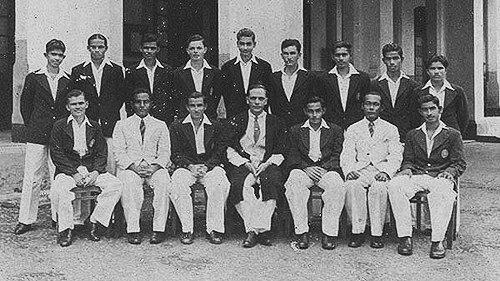
The lessons that we learned in the cricket field can be considered as a transfer of training in our lives," said Jurangpathy. Greek meeting a Greek "One of my most memorable incidents was the inter-school cricket match against St. Anthony's College, Katugastota. Antonians were then an unbeaten side. They were captained by A. C. M. Lafir, who was also a member of the national side. This match was like 'Greek meeting a Greek' at Campbell Park. We beat the Antonians by an innings. Their star batsman Lafir was caught under the bat by me, off that great off-spinner Abu Fuard in both innings. Ronnie Stevens, Saliya and Ranjith Doranegama, Tom Deen were some of the Antonian players that I can remember," stated Jurangpathy.
Jurangpathy was a versatile sportsman. He was a soccerite, athlete and a hockey player. He captained the Wesley College Football team. Under his captaincy, Wesley beat Ananda, Zahira and S. Thomas' College, Mount Lavinia. He was also the vice-captain of the hockey team and also a college athlete. In all three sports disciplines, he excelled and brought credit and honour to the college. On leaving school, he joined the Police as a Sub-Inspector. At the Police Training School, he took up to Rugby Football and played in the 7-a-side rugby tournament and at the 25th anniversary of the seven-a-side Layards Rugby Tournament played at Bogambara grounds, Kandy. "Bogambara grounds, have happy memories for me. It was here that I met my life's partner, which was love at first sight," and blossomed out to three cricketers and a daughter who went out to represent University of Mysore at tennis.
The Malays of Sri Lanka have long been an integral and important part of Sri Lankan family. Their loyalty and dedication to promote the political, economic, social, cultural and sports development of Sri Lanka was enormous. The members of Colombo Malay Cricket Club was founded in 1872. Jurangpathy played a keyrole in promoting the Sri Lanka Malay Association and Colombo Malay Cricket Club. He was instrumental in embarking on a project to develop the Padang complex which comprises the playing field, club house and association headquarters. It was in 1872, that a band of Sri Lankan Malays drawn from the Ceylon Rifle Regiment and other walks of like, among whom were the descendants of Royal exiles, founded the Colombo Malay Cricket Club.
At that time there were no other Ceylonese sports clubs in existence. Therefore, the Malays could justifiable pride claim to have the oldest Sri Lankan sports institution in the island. Jurangpathy was an outstanding cricketer at the Central Province cricket tournaments, which had cricketers of the calibre of S. L. Silva, Lee Vedamuttu, Ronnie Paul, Carlyle Dias, Harold Gunawardene, Hema Weerasinghe and Herby Jayasuriya. Two years in succession, he won the J. R. Jayawardene Trophy. He captained the Police 'B' team that won the Government Services championship.
"In 1952, as a schoolboy, I was coached by late Senior B. H. Bahar, at the Zahira College indoor nets and I played for the Colombo Malay Cricket Club in the Daily News trophy matches being the premier tournament at that time. Further, in 1972, I captained the centenary side of the Colombo Malay Cricket Club," stated Jurangpathy. Sons kept the tradition going His three sons too excelled in sports. They are Shan, Rohan and Roshan. Shan represented Wesley first XI. Rohan and Roshan represented Royal College. Roshan excelled both as a batsman and a bowler and won the Schoolboy Cricket of the Year award. Roshan had the proud distinction of captaining Royal and at 16, he was the youngest to represent Sri Lanka at Test level. He played against India at Asgiriya, and again at Hyderabad. Jurangpathy had a highly distinguished career as a police officer. He won a Commonwealth Scholarship to Scotland Yard to follow a Senior Investigation Course.
At the Interpol Police, he followed a course in International Crime and Drug Trafficking. Whilst in the CID, on a warrant issued by late J. R. Jayawardene, along with General Denzil Kobbekaduwa, conducted terrorist operation from Jaffna - 1979-1983 and later at Batticaloa of the Cobra Movement terrorists. He was a good cricket administrator - Vice President of the Colombo District Cricket Association for 9 years. During the late Gamini Dissanayake's golden era of cricket in Sri Lanka, he joined the Sri Lanka cricket administration. Jurangpathy served Sri Lanka Cricket Board for 8 years, the Disciplinary Committee and also elected to the Executive Committee and served cricket with commitment.
It is a pity that this type of honest, dedicated, committed cricket administrator, who played cricket at the highest level are not in the cricket administration today.
OWSC News 2011
Cricketing gear donation to OWSC
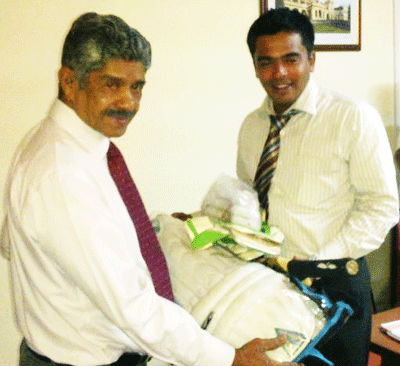
Mr. B.N Jurangpathy – Advisor on Administration of the OWSC and handed over valuable Cricketing gear sent by his son, Shan Jurangpathy who is based in Australia to the The Head of Sports of the OWSC – Asif Johar.
The President, Executive Committee & the members thank Shan and Mr. BN Jurangpathy for this generous donation. As you know OWSC participates in the Division 3 cricket tournament conducted by the SLC.
Darrell Maye 10 for 82 By Dilwin Mendis
By the Moratuwa Sports Correspondent
 The game of cricket is unpredictable at times that's where the result is concerned and there has been occasions where the 'underdogs' have come on top, displacing the favoured teams.
The game of cricket is unpredictable at times that's where the result is concerned and there has been occasions where the 'underdogs' have come on top, displacing the favoured teams.
Inter-school cricket has captured the hearts of many people right down the years and one of the matches that stood out was the Royal-Wesley encounter of 1962 that's 48 years ago.
What made this encounter so very interesting was the fact that in the Royal team was a pace bowler of repute Darrel Lieversz who had the distinction of running through the Peterite batting, capturing 6 wickets for three runs in 8 overs of which were seven maidens on day one.
Then came Royal's turn to play against Wesley at Cambell Park on February 23 and 24. On the first day of the match, the Ceylon "Daily News" in its preview of the match had the headline: "Lieversz vs Wesley" at Campbell Park.
So what was on most Royal supporters mind was it going to be another Lieversz domination this time against the wesleyites.
Those days Wesley had no turf strip, they had to play their home matches on the matting wicket at Cambell Park. Now Lieversz was coming determined to cause have against the Wesleyities. but he had to bowl on the matting.
And it was Darrell Maye with a match haul of 10 for 82 who bowled Wesley to victory. Royal made 162 and 136. Wesley got: 170 and 136 for 5 wickets. Darrell Maye now lives in Sydney, Australia. His remarkable bowling feat will be remembered for many years to come.
Lalith CR Wijesinghe (Captain)
 Playing their 'home' matches on matting those early days, Wesley had moulded themselves into somewhat of powerful unit. Wesley did wonders in this match under the leadership of L.C.R. Wijesinghe did wonders against the Royalist who were led by Darrell Lieversz.
Playing their 'home' matches on matting those early days, Wesley had moulded themselves into somewhat of powerful unit. Wesley did wonders in this match under the leadership of L.C.R. Wijesinghe did wonders against the Royalist who were led by Darrell Lieversz.
Royal won the toss and decided to bat and were somewhat shocked to be all out for 169 with the top score of 73 by S. S. Kumar and 21 by S. Thiagarajah. Darrel Maye was the top Wesley bowler and captured 6 for 41.
There was 45 minutes play remaining on the first day and Wesley coach then B.J.M. Bahar (snr) and asked the regular opening pair to stand down and asked Milroy Muthuvaloe and Mervyn Hamer to open the innings. Coach Bahar asked the two openers to take strike about a foot in front of the popping crease and hit the ball as hard as possible among the ground.
Then the Wesley innings began and Royalists were poised for the 'kill'. Muthuvaloe - the make-shift opener addressing umpire Lappen shouted: 'Sir my off-stump please." The umpire and Royal fielders were somewhat puzzled especially skipper Lieversz. Wesley were 34 for 1 wicket at the end of the first day.
Came day two the Wesley coach Bahar's plans worked and Wesley were all out for 170 which gave them a one run lead on the first innings. For Wesley, Kenneth de Silva made 44, Muthuvaloe 30, Sarath Wickramaratne 26 and Darrel Maye 24. For Royal, skipper Lieversz had 4 for 44, T.R. Jansen 2 for 19 and Sugi Rajaratnam 2 for 20.
So, innings in the second turn of Royal was going to be crucial, but the Royalists couldn't do much and were bowled out for a paltry 136 which gave them a lead of 137 runs.
The successful 1st XI Cricket Team of 1962

So, Wesley had somewhat of a comparatively easy task of winning the match as the lead was not a much of a score to get and Wesley had a good enough batting line-up to get those runs.
For Royal in the second innings, Lieversz got 30, Vijay Malalasekera 31 and R.C. de Silva 28 were the chief scorers and Darrel Maye taking 4 for 41 which gave him eye-catching match-figures of 10 for 82 - a truly fine piece of bowling. There was also Kenneth de Silva who took 3 for 18.
So, it promised to be somewhat of a close finish, but Wesley batsmen had determination written all over their minds and made 136 for loss of five wickets to win the match. Wesley skipper Lalith Wijesinghe (37), Evo Schoorman (23), Sarath Wickremaratne (32 not out) helped them along to their victory target.
Royal's skipper Lieversz was not successful with the ball though his bowling was economical, giving 31 runs away in ten overs without taking a wicket. R.C. de Silva was the pick of the bowlers with 3 for 50.
Links to further reading
- How B. J. H. Bahar (Snr) magic, helped Wesley trounce Royal and Ananda in 1962
- Darrell Maye -- the first Wesleyite to win School Boy cricketer by Peter Christie Casie Chitty
- Darrel Maye of ‘double blue' fame is back home on a brief holiday By Bruce Maurice
- Lalith Wijesinghe (L.C.R)by Dr Nihal D Amerasekera
Article from the “Floreat” – the Newsletter of Royal College OBA Australia, 2005
When I was invited to submit an article for the Floreat by the Editor, it was indeed an unusual request given that I went to Wesley and not Royal. However after elaborating on his invitation, I
agreed to send Maurice Thomasz an item. What should I write about? What would be of interest that I could write about that linked our two great schools. Whilst each school was unique in the traditions handed down over the years, the mutual respect for each other was inculcated by the keen rivalry between the two schools as combatants in sport. Royal College has been pivotal in its significant contribution to school sport in Sri Lanka and still continues this rich heritage today. Wesley’s link with Royal College goes back a long time with “Cricket” being the key. Wesley’s cricket history dates back to 1893 when the inaugural Wesley – Royal cricket series, the second oldest series in Sri Lanka after the Royal –Thomian began. Royal was captained by M D Cockburn and Wesley by Percy de Bruin with the Principal of Royal, Mr John Harward officiating as one of the umpires.
The game was played at San Sebastian Hill, Pettah the home of Royal at that time. C.E. Perera, a great right hand bat at that time played for Wesley and later went on to skipper the side in 1899. Wesley has never had a big match in its 130 year history, a strange phenomenon indeed. Therefore for many Wesleyites, the Royal fixture fulfilled this sense of importance but with a lot less emotion and the associated carnival atmosphere and pageantry that has symbolised the “big matches” between schools in Sri Lanka. It may be of interest to readers, that C.E. Perera captained the famous Combined Colleges Team in 1899 made up of players from Wesley, Royal, St Joseph’s and St Thomas’ that had 11 Sinhalese cricketers. The side lost by 1 run to Colts C.C. after chasing a modest total of 196 runs. After this game a gathering of young Sinhalese cricketers including those that played in the game met with distinguished Senior Members of the Sinhalese community on 28th March 1899 at the Wesley College Hall in Dam Street, Pettah. The convenor of the meeting was distinguished Wesley Old Boy, Scholar, Bard and Legal Luminary H.J.V.I Ekanayake and the meeting was chaired by Wesleyite D B Jayathilake later known to many as Sir Baron Jayathilake. The mood of the meeting was to form a cricket club along ethnic lines and the Sinhalese Sports Club(SSC) was formed. Sir Harry Dias was the first President. As we now know, the SSC is a Test Cricket venue and the headquarters for the Board of Control for Cricket in Sri Lanka.
This year was the 112th encounter between the schools with Royal very much in the lead in the number of games won. Old Boys of varying eras will remember the stars of their time which are too numerous to mention. Some may have vivid memories of these encounters. Whilst Reid Avenue offered a full size ground and turf wicket, Campbell Park was a batsman’s delight with
matting wicket and a very short boundary on the Campbell Place side of the ground. The surface was also rock hard and the gentlest of strokes if timed well would scamper to the boundary rapidly. I vividly recall one of the finest games between our two schools in my era which was in the 1969 season. The Wesley team in that year approached their cricket in a cavalier fashion but ended the season being the fourth post-war team at Wesley to be unbeaten in a season. The most exciting game of the season was the game against Royal at Campbell Park a traditional two day fixture in those days between two unbeaten sides that season and traditional rivals. Wesley batted first and amassed 260 for 9 with solid batting from Sridharan Jeganathan 65, Patrick Jansz 51 and Jayantha Wijemanne making 37.
In reply Royal was lucky to avoid the follow-on with Eardley Lieversz the skipper putting on a dogged display at the crease to get Royal to 207 for 7. Sridharan Jeganathan took 3/84. Wesley suffered a rude shock in the second innings losing 7 wickets for 45 runs. A gutsy performance by Delmer Achilles 31 and Ivan Van Dort 29 steadied the innings. With ample time left on day two, a Royal victory was imminent. Thanks to a great salvage effort for the 8th wicket partnership, Wesley declared at the fall of the 8th wicket with the score at 105 runs, leaving Royal to make 159 runs for victory in 70 minutes. Wesley Times November 2011 page 12/24 Royal sportingly accepted the challenge and with stylish opener Jagath Fernando in a swashbuckling mood, belted the bowlers to all corners of the field with the short boundary being a major disadvantage to Wesley. Despite losing a few wickets, Royal continued the hectic run chase, getting to 50 in eighteen minutes and 100 in forty minutes. At 5.35 p.m., Royal had to make 40 runs with 6 wickets in hand. The crowds were starting to build to witness this great contest between bat and ball. The game had swung very much in favour of the boys from Reid Avenue. As the boys chanted for their heroes, Royal lost two quick wickets with Lieversz the saviour of the Royal first innings caught brilliantly in a running catch at long on just inches from the boundary in front of the sight screen by Haridharan Jeganathan off the bowling of his twin brother Sridharan. So elated was Hari at getting this prized wicket that he kept on running around the boundary with his arm outstretched with the ball in hand gesturing to the crowd in the pavilion. This was the turning point in the game and with 15 minutes left, Royal needed 20 runs with four wickets remaining.
Unbeaten 1st XI Cricket Team 1969

Two more wickets fell rapidly with the score at 148, just eleven more runs required. With two overs to go, Royal lost their ninth wicket. Amidst the tension and mayhem the supporters of both schools were on the edge of their seats. There was a hush around the ground when the Wesley skipper Amaresh Rajaratnam in a bold move took the ball to bowl the last over from the Baseline Road end in a gesture that would have made him a villain or hero. A penetrating swing bowler, could he deliver the wicket to give Wesley victory? The last pair for Royal were now looking at fending off defeat and the first five deliveries were gently played back. Rajaratnam appeared to have run out of all the tricks in his bag. As he approached the end of his run up he took a deep breath, then he gathered up all his energy and he ran up to deliver the final delivery for the game. It was a full toss and the Royal batsman was caught plum in front shuffling across his wicket. “Howzat” was the cry from the bowler, the fielders and the many Wesley supporters. With no hesitation the umpire raised his finger. What an end to an enthralling game. Royal were gallant losers – defeated but not disgraced. Cricket was the big winner. For the record Tyrone Jansz took 4/47. After the game old Royalist Dr Lucien Gunasekera presented a trophy in memory of Sir Frank Gunasekera another old Royalist who was a great benefactor for Wesley.
This trophy is played for each year between Royal and Wesley. It is sad to see that the great camaraderie and sportsmanship that prevailed in those teams of the past no longer appears to be of importance to the students in this day and age. In a sense it reflects the loss of interest in the old school tie and the holistic approach to education which transcended the classroom. As the traditions of the bygone days are progressively eroded by the changing demands of modern society, the tendency is to embrace the new and neglect the past. As an item of interest to former Royal cricketers, the ground at Campbell Park has undergone major change and development. Wesley acquired the land belonging to All Saints Church on the opposite side to the cricket ground which was divided by the unsealed road linking Baseline Road (from the Children’s Hospital) to the Church and a culvert that ran parallel to the road. This was a major coup as it gave Wesley the opportunity to expand the cricket ground. With Sri Lanka gaining Test status, the need for turf wickets was also important. Until the nineties the pavilion was directly behind the wicket. This has since changed with the pavilion being on the square boundary(say cover point direction) as the wickets were relocated being rotated ninety degrees to the original set up. There are four turf wickets in the centre square and the boundaries are equidistant between 65 -70 metres. Adjacent to the pavilion is the Old Wesleyites Sports Club which is a great place to wine, dine and watch a game.
Links to further reading
School Cricket and Rugby stories from Press Cuttings 1960
 |

Click on the underlined text below for further information
- Wesley Vs Ananda
- Wesley beat St Josephs in a thrilling game
- Abeysuriya lead Wesley Team again by Christie Seneviratne alias Wrong 'Un
- Wesley Vs Royal
- School cricket Review 1959 by AV Fernando alias Alban
- Wesley fights back to gain dramatic win
- Wesley's strength lies in fielding From the Daily News
- Fruitful School Cricket Season 1959 by ND Abeygunawardene
- Wesley beat Trinity
- Wesley Vs St Josephs
- Wesley won with hours to spare
- Sinniah 96 couldn't baulk Ananda
- St Peters Vs Wesley
- Wesley Vs Kingswood
- Schools Inter-district Cricket Final
- Tyrone Le Mercier causes havoc against Wesley
- Schools Cricket Inquest by Wrong 'Un
- Wesley defeat Havelocks at Rugby
- Good display by Wesley at Rugby
- Wesley College Staff members 1959/60 - for List
- The Senior Prefect was B.S.(Shanthi) Perera. He was selected by the Sri Lankan Airforce to be trained as an Officer cadet at the Cranwell Royal Air Force base in England. He successfully completed his course. He died in a plane crash during his final hours of flying in the UK in 1961.
School Prefects of 1959
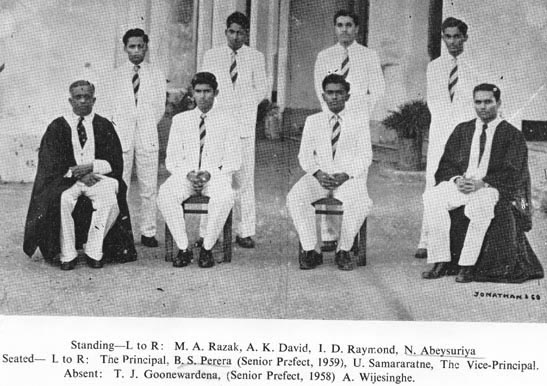
1st XV Rugby Team 1959
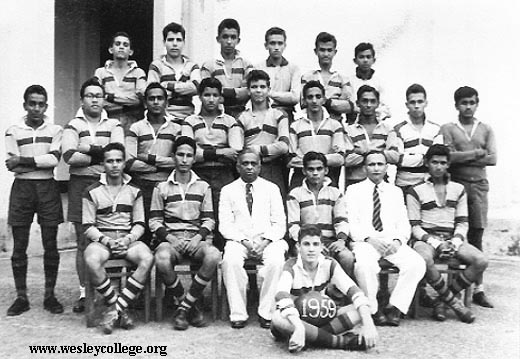
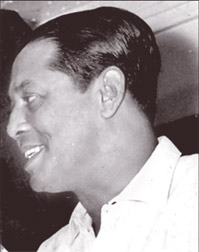 CRICKET: Changing the action plan in cricket is not easy. But, there have been some instances where bowlers have changed their course of action and turned batsmen and yet hit the top. One such bowler is former Wesley College cricketer Mahadeva Sathasivam, who was a known bowler in his school days, but changed ‘wings’ as if to say, and became a full-fledged batsman in later years.
CRICKET: Changing the action plan in cricket is not easy. But, there have been some instances where bowlers have changed their course of action and turned batsmen and yet hit the top. One such bowler is former Wesley College cricketer Mahadeva Sathasivam, who was a known bowler in his school days, but changed ‘wings’ as if to say, and became a full-fledged batsman in later years.
Wesleyite Sathasivam’s change-over from being a bowler during his school days to a star-class batsman in later years in life buzzles most people.
Take for instance 1935 and Wesley were in the forefront of inter-school cricket and up came their match against Trinity College and the venue was the former Tamil Union Ground at Campbell Park March 22 and 23 that year.
Trinity had quite a forceful batting line-up and in those early days they did quite well to get to 185 runs in their first turn. It was a good score by any standard. Piling on the runs for Trinity were O. L. Izadeen 37, M. Ratwatte 24, H. Bandaranayake 22, D. D. Reith 20, S. David 18 and S. G. Perera was 34 not out.
The other players for Trinity were: S. Jansz, John Halangoda, Rex Breckenridge, W. Winter and R. Ratwatte.
Sathasivam opened bowling for Wesley and he really gave all the shocks to the Trinitians with his penetrative bowling and he was successful in capturing 4 for 47 and he was supported by Bertram Chlmus (2 for 43) and Ivan Wallbeoff (2 for 35).
Came Wesley’s turn to bat and Henry Van Buren - the captain also batted well to make 39 and they carried the batting while there were useful contributions from Ohlmus 22, Sathasivam 19 and T. F. Adjie 15.
The other members of the team were: Panchala Goonetilleke, Henry Duckworth, Eric Ferdinands, Claude Ganegoda and Reggie Joseph.
Trinity’s bowlers had done well to restrict Wesley batsmen from piling on the runs and they kept a tidy length. S. David (6 for 67) and S. G. Perera 2 for 46 and Rex Breckenridge 2 for 20 kept a tidy length to restrict the scoring by the Wesleyites.
Shocks for Trinity
Came the second innings and Trinity’s batsmen ran into difficulties and they were more or less routed out for 66 runs in their second innings. Izadeen who top scored for Trinity in the first innings, was at it again in the second innings and made 34 - the top score.
Sathasivam who troubled the Trinitians with a haul of 4 for 47 in the first innings was at it again and his nagging length caused the downfall of the Trinitians again and they folded up for 66.
Sathasivam captured 5 for 30 to give him eye-catching match figures of 9 for 77, Ohlmus took 2 for 9 and he had match figures of 4 for 52 and Wallbeoff took 3 for 21 and he had match figures of 5 for 56.
So, the bowling of Mahadeva Sathasivam turned up trumps again for Wesley in the second innings and he certainly would have been the toast of all the Wesleyites, both past and present for his performance in this game.
In their second innings, Wesley had to make 79 runs for victory and they marched to the victory post, losing just one wicket.
Past Captains vs Rest

The final cricket match that Mahadevan Sathasivam played was the centenary cricket match between Past Captains vs Rest in 1974.
PAST CAPTAINS: 101 for 8 wkts dec (D. Kodituwakku 47, L. Wijesinghe 31 retd., D. Schokman 2 for 8, A. Ramachandra 2 for 13).
REST: 80 for 2 wkts (Mahadeva Sathasivam 46 not out). A. Ramachandra who played for the Rest was taken ill during the match and he died in hospital. The match was abandoned and the celebrations were cancelled.
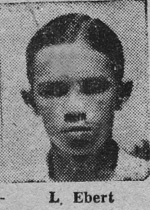 |
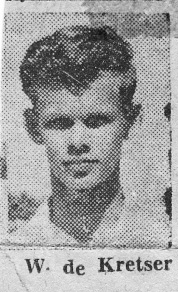 |
On the left is Lorensz Ebert who scored a century for Wesley in 1957
Onthe Right is Warwick de Kretser who now lives in Adelaide, Australia.
An Email from New Zealand from Ranjit Aaron - an ardent cricket fan and a loyal Wesleyite from the 1950's
From the Sri Lankan Papers 1966 My thanks to Aubrey Melder for his efforts to present the newspapers in a readable format despite the discolouration of 46 years. It is an ample reminder of Rugby at school in 1966 and the immense contribution made by students, staff and coach to the life of the school. S Ramakrishnan lives in Harrow, London . Tall and broad Rama still looks a Rugby player. He and his wife Lakshmi are generous hosts and holds numerous dinner parties for Old Boys in particular to those visiting from abroad. I first came to know him when we served in the OBU(UK) Executive Committee. His commitment, honesty and integrity helped the organisation enormously. He retains a deep loyalty to the school. His easy going attitude hides his determination to see that justice and fair play prevailed at all times. Rama has a tremendous sense of humour which has often helped to diffuse difficult situations at meetings and discussions. He is a tribute to Wesley College of the 1960's. Many old boys have been at the receiving end of his kindness and help. We wish Lakshmi and Ram a long and happy retirement. From Nihal D Amerasekera Wesley College Rugby 1966
WESLEY will field 3 coloursmen and six regulars, from last year's fifteen this season.
During Inter-Collegiate fixture this season rugger has not made rapid progress at Wesley. it has been a slow process. with the potential being correctly tapped only last year when Lucky Vitharne the Havelocks and former Trlnity ruggerite began to coach them. Ramakrishnan has been elected captain of the rugger team . This tall Lock-forward and line-out man did yeoman service for Wesley last year. The other two coloursmen in the side are deputy-skipper Peter Smith the full-back. and last year's skipper, S Musafer a fine prop-forward. The others who played. last year and are available this time are Shee Hung, the fly-half, wing three-quarter M. Gnanapragasm and E. Mathuranayagam, centres. Omar Jayasekera and Nihal Peiris, hooker C. Gauder. scrum-half P. Ahlip second-row forward A Jayawardene
With the experience gained by most of them last year. Wesley have the nucleus to form a well balanced team capable of enjoying a successful season. The practice on alternate days at Campbell Park and Havelock Park where Lucky Vitharne puts them through a tough schedule.
Two freshers making a bid for a place In the second-row are crIcketer Nihal Seneviratne, Rohan Weerasinghe . Nihai Seneviratne with the added advantage of height should clinch this vacancy.
E Corteling and E Melder, two fast and young aspirants; for a place In the wing may find a place In the side although the regulars are there. H Bauddin and F Dickman may play as a prop forward to give support to S Musafer the other prop sea most experienced player In the side. Freshers Chou Min and Ratnasiri have been selected to the key position. According to the Master in Charge Sam Thevathasan both these freshers are rugged and hard tacklers.
S. Ahlip brother of R Ahlip Is also being groomed to play as a scrum-half
Wesley back division is a speedy one. The wingers Mathuranayagam and Gnanapragasam with centres Omar Jayasekera and Nihal Peris have sufficieut speed, if they could temper it with heady play by moving the ball down the line, then their problem of scoring tries is solved_ The pack. Is heavy and mobile with skipper Ramakrishnan and Musafer being there to give, them all the support. Last year Wesley gave most of the leading schools a stiff time WESLEY WILL MEET ROYAL TODAY AT LONGDEN PLACE IN THEIR ANNUAL RUGBY ENCOUNTER.
The referee appointed to officiate is Mr. W. S. Allan. This is Wesley's first outing for the season and they will be pitted against a fairly strong Royal XV. The Royalists were held to a scoreless draw by the Josephians. The Wesley-Royal encounter should be another well-contested game. Wesley is led by S. Ramakrishnan, whose deputy is Peter Smith. The team has seven regular players
who figured well during the last season. . Amongst them is sturdy S. Musafer who captained the team in the previous year. Four others have played in one or two games last year. Many freshers have shown keenness and promise at the practices. -The team is being coached by Mr, Lucky Vitharane. THE TEAM
S. Ramakrishnan—Skipper is a third year player. He is the lock forward and the line-out specialist of the side. P. Smith—Vice-Captain — A capable, player in almost any position, will play full-back. - He is a hard tackler and will take the place kicks for the side. He too, is a third year player, S. Musafer—A fourth year player—led the side last year. He specialises as the prop- forward—a hard and tireless player in the loose, Shee Hung—A third year player—plays a very hard game and is a hard tackler too. He will figure as Wesley's stand off. M. Gnanapragasam—A second year player—is a wing three,quarter. He runs fast when in possession of the ball. A. Jayawardene—A second year player—is very young but a very great trier. He is one of the hardest tacklers in the side and is outstanding in the loose. E.N. Peries—A second year player—plays in the second row. A tireless player in the loose and supports the skipper in the line out. Henry Muthurunayagam—A: second year player—will play as wing-three-quarter. He is expected to use his speed to advantage. Omar Jayasekera — Another second year player—will help the side as 1st inside-three-quarter. He, too, has speed a hard tackler and is a, tireless player. C. Gauder—The new hooker of the side—is a great trier. R. Ahlip—A second year player—will swing the passes hard and clean and is a able scrum-half. Nihal Peries—A second year player—will play as the three-quarter. He is expected to do better this year. The others fighting for places are Nihal Seneviratne and Rohan Weerasinghe — second row; E. Corteling and wing three-quarters: Bauddin and E. Dickman —prop forwarids; Chou-min and Ratnasiri, wing forwards: S Ahlip—the twin of R. Ahlip—scrum-half.
FIXTURES. 1966 May 24: Vs. Royal—Longden Place. May 30: Vs. Thurstan—Camp-bell Park. June 9: Vs. Trinity—Nitta--meth. June 15: Vs. St, Thomas'— Campbell Park. June 23: Vs. St. Joseph's—: Darley Road. June 30: Vs. St. Benedict's—Kotahena. July 4: Vs. Zabira—Longden Place. July 23: Vs. St. Anthony's —Campbell Park. July 29: Vs. St. Peter's—Bambalapitiya. My thanks to Aubrey Melder for his efforts to present the newspapers in a readable format despite the discolouration of 46 years. Wesley College Cricket - 1966 Season
But Wesley has always been fortunate in the possession of old boys of sterling worth. Seeing the ship at sea two past pupils in Alban Fernando and Lou Adihetty took charge of the steerage. And ever since then Wesley has kept on improving by leaps and bounds. There are now great hopes for the "Band of Double Blue." Led by Ananda Kumar Thevathasan a third year player in the side. Wesley have six of their experienced boys doing duty for them this year. Thevathasan is a stylish left hand batsman who goes for the runs from the very outset of the game. He is also a right arm medium pace bowler who swings the ball both ways. The vice captain of the team Mass Swangsa who will be seen behind the sticks this season is a second year is also a dependable right hand batsman. Opening batting for Wesley will be fresher Eric Gauder, who is a fine right hander having many good scores his 'credit. He will be partnered by either second year Christopher Alwis a right hand batsman who is also a capable off-spinner or more experienced Omar Jayasekere (third year), also a right-hander who has been very consistent during his other seasons. The bowling attack will be spearheaded by second year Nihal Seneviratne and Premalal Jayasinghe. Seneviratne is a right arm inswerve specialist and has real pace in his bowling. The two coaches have been quite impressed with him and we have no doubt that he will be a menace to batsmen during this season. He is also a right hand batsman, capable of good scores. 'the other batsmen in the side are Brian Batstone. a fresher who could also share the new ball if the need arises and Shee Hung a right hander who got a place in the side later a few days of practice. Shee Hung is also a leg-spinner. USEFUL Those trying for places are A. Musafer a left arm leg-spinner, J. Jayasekere an off-spinner Eardley Melder,, a promising opening batsman and R. Vethecan a right hand batsman and a useful off-spinner. Wesley opened their school season with Kingswood on January 21st and 22nd at Kandy.
The rest of their fixtures are as follows: January 26th and 27th vs St Peter's College at Bambalapitiya February 2nd and 3rd vs St. Thomas' College Mt. Lavinia at Campbell Place February 10th and 11th vs St Joseph's College at Darley Road February 17th and 18th Vs Trinity College. Kandy at Campbell Place. February 25 and 26th Vs Royal College at Campbell Place. March 11th an 12th Vs Richmond College at Campbell Place. While in Adelaide I visited the imposing St. Peter’s Cathedral and on my way to the Adelaide Oval for the Sri Lanka- India game that ended in a historic tie, I met two former Wesley cricketers Radley Classen and Warwick de Kretser who sported Wesley College colours in the late 1950s and early 1960s. After the game, I was their guest and was glad to meet Warwick’s wife Peggy who had prepared a sumptuous dinner, with a tasty dish of prawn curry prepared by Warwick, who Radley told me would out beat any chef with his preparation of prawn and crab curry!

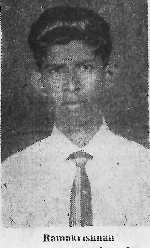
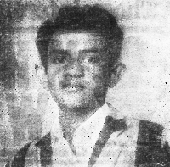 A the end of their third term matches things looked pretty bleak for Wesley.. There was plenty of inconclusiveness about their cricket and it looked as if they were going to keep tossing around in the doldrums for some time to come.
A the end of their third term matches things looked pretty bleak for Wesley.. There was plenty of inconclusiveness about their cricket and it looked as if they were going to keep tossing around in the doldrums for some time to come.
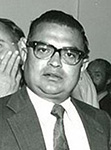
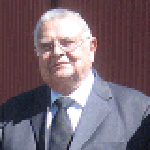
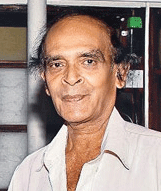 While Warwick did not attain the heights that the Classens attained at cricket, he was also a cricketer and hockey player of repute. But it was the Classen brothers Radley, Brian and Herman who rewrote history at Wesley with their stupendous feats, with Brian being the most outstanding.
While Warwick did not attain the heights that the Classens attained at cricket, he was also a cricketer and hockey player of repute. But it was the Classen brothers Radley, Brian and Herman who rewrote history at Wesley with their stupendous feats, with Brian being the most outstanding.Talk about old times
After dinner it was talk about old times, believe it or not of 50 to 60 years, about their sporting careers, their team mates and the interesting incidents, reminiscing and anecdotes that they could vaguely still remember.
While Radley was an excellent all-rounder, it was Bryan out of a family of five brothers, the others being Doug, now going on 87, Hector deceased, Radley 80 Bryan and Herman deceased who was a brilliant, all-rounder with his leg spin, googly bowling and batting as his forte made it to the All Ceylon team as a schoolboy.
In that era sporting national colours as a schoolboy was a great achievement considering the rich talent and the cricketers the schools produced at that time. Bryan who won his spurs as a schoolboy played against England, Australia and India. He also toured India with his contemporaries being F.C. de Saram, Mahadevan Sathasivam, Malcom Spittle, C. Ivers Gunasekera and Vernon Prins.
 |
 |
Five centuries
Bryan scored five centuries for Wesley with his highest contribution being 157 not out against Richmond. His bowling figures were amazing taking 8 wickets in an innings on two occasions and five wickets and over in an innings in 13 matches. His best performance, for some unknown reason has not been recorded on the Wesley record board. It was against Zahira in 1950 when he took 9 wickets for 37 runs. This oversight, I am told is being rectified. Radley recalled with much affection many of his old cricketing colleagues – Stanley Jayasinghe (Nalanda), Conrad Barrow (STCML), Stanley Oorloff and many others such as F.C. de Saram, Sargo Jayawickrema, Mahadevan Sathasivam, T.S. Musafer (wicketkeeper), the Abeywardena brothers, Herbie Felsinger, Ansar and Abu Fuard, Derrick and Spencer Mack, Tita Nathanielsz, Bobby Schoorman, Ken Joachim, Dick Vabcuylenberg, Roger and Clive Inman, Michael Tissera, Tony Don Michael, George Jayatunge and many others too numerous to mention.
Five centuries
Radley played for Wesley for three years – 1950, ’51 and ’52, captaining the side in 1952. Bryan and Radley won their cricket colours in 1950, in their first year and were held in high esteem by the well known coach Alban V. Fernando.
Incidentally ‘AV’ was the cricket correspondent when I joined the ‘Times of Ceylon’ in 1961 and had the privilege of being shown how to write and describe the game and must say a big thank you to him for what I am in the world of cricket writing today. Radley was an opening bowler and opening batsman, a rare combination and achieved much distinction in both areas. He recalled making about five centuries whilst playing for Wesley, Times and Vikings. He had scored several 50s for the Colts and was unfortunate not to score a century for the club he loved so much and represented for so long.
Three plums
Radley held three plums of school life – cricket captain,Senior Prefect,Games Club secretary- a feat rarely achieved. It is said that Sir Oliver Goonetilleke, also a Wesleyite ( former Govenor General of Ceylon)came a close second holding the positions of Senior Prefect and Games Secretary. He also worked for five years in the ’Times of Ceylon’ and “Sunday Times’ under distinguished journalists such as Felix Goonewardena, Tori De Souza, who was my first Editor, Subbiah Muttiah, D.S.C. Kuruppu, Francis Ashborn, Felician Fernando , Victor Gunewardena and Ben Alwis. Radley also recalled the games between rivals ‘Daily News’ and the ‘Times’, and when the ‘Times’ trounced their rivals which team had Bertie Wijesinghe and Mahes Rodrigo.
Accident at Galle Road
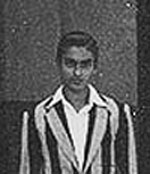 He recalled the accident at Galle Road, when a drunken driver crashed onto the motor bike ridden by Bryan with Herman as the pillion rider. The brothers were returning after a late night show at the Regal when the accident occurred which killed Herman when he was just 18 and with a wonderful cricketing career ahead of him.
He recalled the accident at Galle Road, when a drunken driver crashed onto the motor bike ridden by Bryan with Herman as the pillion rider. The brothers were returning after a late night show at the Regal when the accident occurred which killed Herman when he was just 18 and with a wonderful cricketing career ahead of him.
Herman was a clever left-arm spinner and was tagged the Ernie Toschak. Toschak was Australia’s number one left-arm leg-spinner at that time. His early demise took away a bowler who could have reached great heights.Radley who was described as the Brylcream cricketer by Nihal Amerasekera, who is 80 now is still sporting that Brylcream look. He served as the Sri Lankan Counsul in South Australia for nine years before retiring from that prestigious position.
Bowling terror
Radley modelled his bowling on former Sri Lankan pace ace D.S. Jayasundera who was a terror. He also worked for the South Australian Public Service and rose to the position of Senior Publicity and Promotions Officer of the Transport Authority in South Australia.
By Michael H. Tissera Former Sri Lanka Test Captain
From The Wesley Cricket Book edited by Jeremy Brohier
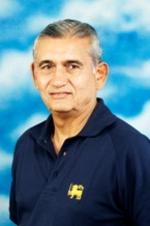 Wesley produced some very fine cricketers in the early / mid-fifties. The Claessen brothers come readily to mind, Radley, Bryan and Herman. Bryan was a classy batsman and leg spin bowler who played for Ceylon while yet a schoolboy while Herman who was a great left armer bowling fastish off breaks would surely have played for Ceylon if not for his tragic early demise following an accident. Our current Sri Lanka team would love to have had a bowler of his class in their ranks. Then there were the Fuard brothers Ansar and Abu. Ansar was an aggressive batsman, medium pace bowler and very good fieldsman. In 1954 Wesley beat S. Thomas by one wicket, thanks to a whirlwind 78 by Ansar, his first 50 coming in just half an hour. Abu however was the better known cricketer having played for Ceylon essentially as an off break bowler. He was also a stodgy batsman who was called upon to open batting in the 3rd Test against India in Ahmedabad in 1964/65, as the regular opener was injured. He scored 40 runs and helped Ceylon to get the 120 runs needed for a famous victory. It was as an off spinner, however, that he excelled. Not a great turner of the ball he beat batsmen in the air with flight and guile.
Wesley produced some very fine cricketers in the early / mid-fifties. The Claessen brothers come readily to mind, Radley, Bryan and Herman. Bryan was a classy batsman and leg spin bowler who played for Ceylon while yet a schoolboy while Herman who was a great left armer bowling fastish off breaks would surely have played for Ceylon if not for his tragic early demise following an accident. Our current Sri Lanka team would love to have had a bowler of his class in their ranks. Then there were the Fuard brothers Ansar and Abu. Ansar was an aggressive batsman, medium pace bowler and very good fieldsman. In 1954 Wesley beat S. Thomas by one wicket, thanks to a whirlwind 78 by Ansar, his first 50 coming in just half an hour. Abu however was the better known cricketer having played for Ceylon essentially as an off break bowler. He was also a stodgy batsman who was called upon to open batting in the 3rd Test against India in Ahmedabad in 1964/65, as the regular opener was injured. He scored 40 runs and helped Ceylon to get the 120 runs needed for a famous victory. It was as an off spinner, however, that he excelled. Not a great turner of the ball he beat batsmen in the air with flight and guile.
In Samsudeen (Sam) and Lou Adihetty Wesley had a hostile opening pair of bowlers. Contrasting in styles, Sam a left arm low slingy action made the ball skid & keep low while Lou tall and with a high ann action got the ball to lift on the Campbell Park matting wicket. They gave batsmen plenty to think about. Sam played some representative cricket and was perhaps unlucky not to play for Ceylon. Playing for a combined services team against the Pakistan Eaglets he achieved a famous feat of getting all ten wickets in an Eaglets score of 40 all out. A little later came L.R. (Lucky) Goonetilleke, a tall, lanky, high arm left armer with plenty of pace who played for Ceylon. Unfortunately his International career was cut short as he took up to planting and found it difficult to find sufficient time for practice. He is another our current Sri Lanka team would have liked to have had Some other Wesley players of that era were Pat Shockman a short, gutty opening batsman who on leaving school turned out successfully for the NCC. Later he left for England and joined a tea broking firm and with my connection in tea, met often when I did get to London on work.
Neil Gallaher was a stylish batsman and just as stylish in his dress. He joined the Hong Kong bank and I played against him often turning out for Brooke Bond. Harold Juriansz and Hilary de Vos worked together with me at Brooke Bond and we were part of a team that won the Mercantile (A) Division championship. We used to have some great battles with Hong Kong bank who had many good cricketers. Harold and Hilary subsequently migrated to Australia. Hilary unfortunately passed away a few years ago but Harold keeps in touch and we were able to meet on my last visit to Melbourne, 18 months ago. I am also in touch with Warwick de Kretser his wife Peggy, and twice had the great pleasure of dining with them in Adelaide while I was with the Sri Lanka team as Manager. After a while on tour one longs for a curry, and Peggy excelled in that preparation.
From an earlier era Sri Lankas greatest batsman Mahadeva Sathasivam played for Wesley. Satha as he was familiarly known to most was a magnificent batsman with lightening foot work and a famous late cut that sent the ball away to the boundary. I had the greatest privilege to play against him for S. Thomas in a traditional warm up game against the Tamil Union at the Oval, prior to our big match. He was well past his prime : I could not help but admire his foot work and stroke play. Satha had played many classy innings in his time but three innings that stood out and I had the immense joy and privilege of seeing one of them. In his mid-fifties he scored 160 for the Rest against Mercantile in the Robert Senanayake Quadrangular tournament. Opening the batting with Derrick De Saram he made mince meat of a strong attack and I marveled at his stroke play. Another stand out inning was his 215 for Ceylon against South India at in1947. Gulam Ahmed, the Indian off spinner who played against
Satha in that game rated it the best ever played at that ground. Then in 1950 Satha scored 96 out of a total of 153 on a rain affected wicket against a Commonwealth team skippered by Frank WorrelL This outstanding inning prompted Worrell to say that Satha was the best batsman in the world. Wesley should be doubly proud of their son.
As part of the Thomian team I played five years against Wesley from 1954 to 1958. In my first year Wesley won a thriller at Campbell Park by one wicket. In 1956 we won a thriller with minutes to spare also at the park, this despite Herman Claessen getting 6 wickets and Lou Adihetty 71. In 1955, 57 and 58 We won comfortably but what was significant was that all five years ended in results and matches played in great spirit.
I have a special fondness for Campbell Park as the only century I scored in school cricket was there in 1958.
I wish Wesley all the best in their celebrations and good cricket in the years ahead.
Bryan Claessen one of the finest Cricket Captains By Edmund Dassanayake

From the Wesley Cricket Book Edited by Jeremy Brohier
1953 will be remembered as a glorious year for Wesley and of special interest to cricket captain Bryan Claessen. As under his leadership, Wesley was unbeaten, having registered victories against St. Joseph's, Royal, Kingswood, Prince of Wales and Richmond. The matches against S.Thomas. Trinity and St. Peter's were drawn. It will be seen that only 8 inter-collegiate matches were played then, when compared to the number played today. The authorities concerned should seriously consider whether increasing the number of fixtures will have a deleterious effect on the players themselves. Should not education be the primary concern?
The match against Royal has been singled out because of certain special features. In each of three innings, the totals did not exceed 85. Royal scored 68 and 76 while Wesley scored 145 and 84.
In Royal's first innings, the first four wickets fell for a solitary run, which was a leg bye. There were three sets of brothers - Claessens. Adhihettys and Fuards. In this match played at Reid Avenue on the 7th and 8th February, as many as 15 players were out LB\"X/ of which nine such decisions went against Wesley. For Royal, N. Mathew scored 35 and Patrick Schockman scored 74 for Wesley in the bowling S.L.A. Wickramasinghe bowled best for Royal capturing 4 wickets for 2 runs in the 2nd innings, while M. N. Samsudeen was Wesley's wrecker in the 2nd innings, capturing 5 for 17.
Just before the Wesley team left for Reid Avenue, one of Wesley's cricketers, who happened to be a prefect also, was summoned before the Principal Cedric Oorloff. The head of a leading girls' school had come with a complaint that a couple of Wesley boys had hidden behind a giant flamboyant tree, and shouted at a girl, whose hair-style reminded one of a common bird's nest. The cricketer in question was on duty at the rear entrance to Wesley, but had not taken steps to identify the boys, nor prevent them from shouting at the girl. The Principal who was a strict disciplinarian, gave this lad 'six of the best'. He took up his punishment stoically. But in later life, he reached the highest ranks in the Police Service.
Not withstanding reduced fixtures and shorter playing hours, Bryan Claessen notched up 4 centuries. Against Trinity (101 not out) 115 vs Kingswood, 157 not out vs Richmond and 105 vs St. Thomas'. His best bowling performance was against Zahira (9 for 37). Other good performances were 8 for 68 vs St. Joseph's, 6 for 39 vs Kingwood, 6 for 87 vs Trinity and 6 for 38 vs Richmond.
Bryan was selected to play for All-Cevlon while at school, in 1953 under Sargo Jayawickreme's captaincy against the powerful Australian Team skippered by Lindsay Hassett.
Bryan was an outstanding and complete cricketer, a stylish and aggressive stroke maker with an array of strokes all round the wicket. He was also a wily leg spinner, who bamboozled batsmen with his flight and spin; a brilliant fielder in any position and one of the prodigious captains produced by Wesley.
He owes his success to coach Alban V. Fernando. Alban was hit on the head when he opened batting with Henry Van Buren against Royal in 1931. He had scored 24 runs when he was rushed to hospital after being struck by bowler D. H. Labrooy. The head injury put him off the game of cricket, but not as a coach as he served Wesley in an honorary capacity.
Bryan migrated to Australia in 1957, and secured several awards in cricket. He will be remembered as the first Sri Lankan to be elected President of South Austalia's District Cricket Club.
Professionally, Bryan was a Prosecutor in Family Law. When he retired in March 1988, he was in charge of the Division responsible for the enforcement of family support orders in South Australia.
Wesley's wonder team of 1953 consisted of Bryan CIa essen (Capt.), Ansar Fuard, Abu Fuard, P. Schokman, B.N. Jurangpathy, Lou Adihetty, Viney Adihetty, A.R. Chapman, Herman Claessen, C.N. Gallaher, D. Range, A.P. Batuwitage M.N. Samsudeen and N. W. Fernando the coach was A. V. Fernando and Master-in-Charge was JLF de Mel.
By Jeremy Brohier
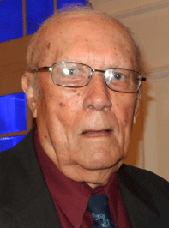 I found it extremely difficult to extract much information on Norman but with whatever information I gathered I thought that it would be the ideal opportunity to pen a few lines of this colourful and flamboyant Wesley cricketer in the interest of the future generations of Wesley.
I found it extremely difficult to extract much information on Norman but with whatever information I gathered I thought that it would be the ideal opportunity to pen a few lines of this colourful and flamboyant Wesley cricketer in the interest of the future generations of Wesley.
Norman was enrolled to Wesley way back in 1935 and was educated under five Principals namely Rev. Dalby, Rev. Izzet, Rev. Holden, Rev. Cartman and Mr. C.J. Oorloff. He was an excellent sportsman having excelled in cricket and athletics. He also played hockey and tennis and was a versatile boxer too. Norman who played for Wesley between 1946 and 1948 will be remembered as a fiery opening bowler, arguably the fastest schoolboy pace bowler in 1948. He was a member of Harold Matthysz's champion team of 1948 where he took 4 for 40 along with N.S. Jayasundera 3 for 32 to rattle the powerful Royal side for 136 runs. Unfortunately Norman could not play in the second innings to Wesley's disadvantage as he was unwell.
Confirming Norman's fiery pace was the famous cricket commentator Mr. Premasara Epasinghe who in a recent conversation with me mentioned that many opening batsman of that era feared facing Norman who played for the Colombo Colts cricket team and the C.C.A. Such was the respect opposing
batsman had for Norman. According to Mr. Epasinghe he believes Norman bowled at over 90 mph a fact that many Wesleyites or even Sri Lankans may not know.
Norman who was also a brilliant athlete excelled in the high jump and putt shot events coming first at the Public Schools Sports Meet in 1948. Having won many trophies in athletics Norman was selected to represent Ceylon as it was known then in the high jump event at the Asian games in New Delhi in 1953.
A contemporary of my father who was a Josephian and later a N.C.C cricketer, I have listened to many interesting stories of this colourful personality who emigrated to Australia in 1958. Norman continued to play cricket in Australia at District level where according to records available he played for T ooronga District in Brisbane along with Kevin Jarvis of England. Norman's contribution to Wesley in the field of Sport has been exemplary. He has always mentioned that he is a born and bred Wesleyite who is _loyal and proud of his school. Certainly a true Wesleyite worthy of recognition.
Daily Mirror July 2003
 Wesley College Colombo will hold their Colours Nite tomorrow at the College hall from 5.00 p.m onwards.
Wesley College Colombo will hold their Colours Nite tomorrow at the College hall from 5.00 p.m onwards.
The awards are presented to outstanding sportsman who excelled in sports activities for the year 2002.
In rugby the Wesleyites did exceedingly well last year with the senior team emerging as the runner up in the President's Trophy and the junior team taking the Under 15 trophies by winning the Western Province, all-island and Premier trophy.
Four Wesleyites, Farveez Mahroof (cricket), Kasun de Silva, Zakir Badurdeen (rugby) and M.S.M. Riyaz (soccer) excelled in their respective fields and were selected to represent the junior national team. They will receive their colours today.
Farveez Mahroof who is presently in Stanmore, England on a cricket scholarship has been unofficially adjudged the schoolboy cricketer of the year 2003.
President of the Sri Lanka Rugby Football Union Mohan Balasuriya and his wife will grace the occasion as the chief guests while four outstanding ex-Wesley sportsmen Lucky Goonetilleke (cricket), O.K. Hemachandra (DIG) (athletics), Captain Dalkin Samidon (soccer) and Ransiri Sahabandu (rugbyr) will be the guests of honour.
from the OBUA Newsletter 2003
Trevor was a student at Wesley college from 1939 – 1948 and had the privilege of serving under Principals, John Dalby, David Izzett, William Holden and James Cartman.Trevor was an outstanding athlete. He was the College’s champion (Moscrop House) and held the school records for both the Hop Step and Jump and 120 yds High Hurdles.
In 1947 Wesley College was placed third for the Tarbat Challenge Cup. Trevor was placed second in both the 100yds High and 200yds low Hurdles, narrowly beaten by Walter May of STCM. 1948 was the golden year for Wesley athletics. In that year the college was placed third for the Obeysekera Challenge trophy, a remarkable performance for schoolboys participating at a national level. Other members of that champion team were Harold Matthysz (pole vault/javelin) Mohammed Sheriff (hop step/long jump), Bertus Perera (220/440yds), Norman De la Harpe (high jump/putt shot), Trevor Van Rooyen (120 yds High Hurdles and Ian Campbell (high jump).
At the National AAA meet held in 1950, Trevor established a new Ceylon record for the 120 High Hurdles in 15.6 secs. He was awarded the Wilton Bartlett cup for this achievement and was selected for the Asian Games 1951, in New Delhi. At the Asian Games, Trevor qualified for the 120yds high hurdles final and was a certain medal hope, but unfortunately he had to pull out of the event due to an injury just prior to the running of the final. Trevor was a member of the Wesley College champion Hockey Team in 1948, he also played cricket (U 16). Trevor is full of gratitude, praise and respect for that outstanding school master Mr Dick Honter, who was his mentor, teacher and friend. Mr Honter “had the amazing knack of motivating and producing Wesley Champions with the limited resources available to him at that time”.
Trevor was handpicked by the IGP Ceylon for a career in the Police Force and spent some time in training at the Police Academy. However, after a brief spell with the Ceylon Police, he decided to join the Shell Company and participated with great distinction at the Ceylon Mercantile Athletic meet in 1950. winning the 120-yds hurdles and the Hop Step and Jump for which he was awarded the Col. Griffith trophy for the best performance at the meet.
Trevor recollects with glee his foray into acting whilst at college. In his own words “in 1947, a revival of dramatics was orchestrated to give aspiring actors an opportunity to develop ones talent. The theory was to introduce an inter-house competition. My faction MOSCROP House under the guidance of Messrs B.R. Blaze and D.A. Weerasooria put on a modified version of “THE BISHOPS CANDLESTICK”. Moscrop easily accounted for the interlopers in the contest. My claim to fame? The judge at the contest, reported that Van Rooyen in the role of the Bishop is highly commended for his brilliant acting. For a good maximum of 60 seconds, I had this vision of playing Rhett Butler in a remake of Gone with the Wind. Oh the joys of a dreaming schoolboy. Alas the next day it was back to class. Doing the show was great fun, with the likes of Natty Prins, Pete Mendis, Shirley Rodrigo, K.D. Ahmat and others”.
In 1952 Trevor immigrated to Australia and joined the RAAF as an education officer. He continued with athletics and also played Cricket and Rugby for the RAAF whilst stationed in Victoria. Trevor is so proud to be a WESLEYITE, in his words “what accolades I received, would not have been, if it wasn’t for the great educational institution that is Wesley College, Colombo. My love and unqualified devotion to my College goes without saying. GOD bless Wesley and all who walk through her Portals”.
WESLEY TO THE FORE
With the stunning achievements of Wesley College in rugby, it revealed to me when going "down memory lane", that my connections with Wesley rugby dates back to 1958 as a schoolboy.
As captain of the 1958 Trinity rugby team the inaugural match between Trinity and Wesley was played as a friendly match at Campbell Park cricket ground.
 |
 |
 |
 |
In fact, the east-side of the cricket ground was used, with two bamboos set up as the goal posts, touchlines and other markings were done with a kind of white paint, with six flags on sticks used to demarcate the half-way line and the two goal-lines, as corner-flags! Yet, the game went on in true competitive style, displaying good sportsmanship.
As agreed to, Trinity played an A Team and permitted Wesley to make substitutions during the game, for any injured players or those who had to be tried-out! It was on the initiative of P.H.Nonis, Principal of Wesley (an old boy of Kingswood College Kandy) and C.J.Oorloff, the Principal of Trinity College Kandy, to start this fixture and encourage the game of tugby to 'catch-on' at Wesley.
In fact, Oorloff had been educated at Trinity and much later in life, became the Principal of Wesley up to 1956, before taking up his appointment at Trinity in 1957. Perhaps, this was the first big step to playing serious rugby.
In 1960, the master-in-charge A.D. "Ada" Dabrera, was keen on reviving rugby at Wesley and he invited me to coach. Not many boys were interested in playing rugby when it was announced between January and March, maybe due to the cricket season been on.
So, just a handful of boys were willing to commit to rugby and the whole idea was left on-hold!
In later years A.S.Wirasingha inspired the boys to continue the game, with absolute keenness and enthusiasm. Some fine products of Wesley at those primary stages were Reggie Bartholomeusz, who went on to captain CR&FC and represent the country as a wing-three, Sin Sen Chang who turned out for the Havelocks sides, plus Bunny Saldin and Ronnie Asirwatham who come in to my random thoughts! There were many more outstanding Wesleyites, thereafter who covered themselves with distinction.
Over the decades of rugby, Wesley have steadily built-up their strength in the game and their prowess has been seen in this year's magnificent performances. In 2013, their playmaker and star scrum-half captain Rahula de Silva, has already helped Wesley to win sensationally, over the School's League Champions and giant-killers Dharmaraja College Kandy in their Milo President's Trophy semi final played on Monday.
Some others who have put their shoulder to the wheel and proved a success with great play are vice-captain number eight Gavin Siegertz, one of the best forwards in the schools as well as Kushan Pathiraja and the rest of the hard-working team.
Wesley, inspiringly led by their skipper and star scrum-half Rahul de Silva won by 22 points to 13, over Dharmarajah College played at the Royal Sports Complex, Colombo.
Speaking on the recent history of Wesley Rugby, the coordinator F. Silva had this to say: "Wesley College's domination, influence and iconic status have been so significant over the years. For example, last year there were over 400 students competing for a place in the rugby team. Statistically that's a startling 400 to 15 ratio. True, opposition sides have delivered regular 'push backs' and even 'slap-downs' since. Yet, I am confident about the expectations of the current team and what they have gained from expedient out-bound trainings they have gone through".
It is the hope of all Wesleyites that the Milo Trophy will find a special place on the mantelpiece at Wesley College, this year, depending on who they meet in the final Trinity or St. Peter's!
Incidentally, Wesley College celebrates 50 years of rugby and have invited a World Cup winning coach, Australian Bob Dwyer to attend the celebrations in Colombo in September. It is been sponsored by the Kumar Group of Companies Sydney, Australia. A distinguished Old Wesleyite Mike Siebel of Melbourne, will attend along with Kumar Group Chairman – Dilip Kumar, a former Trinitian and Chairman of the Australian Rugby Union and current World president of the International Association of Rugby 80.
Wesley College Cricket Team 1947
Trinity, founded in 1872, is only two years older than Wesley, which was founded in 1874.Nevertheless, the link between the two schools is as firm as a clasp. A man of quiet, dignified integrity, Cedric Oorloff had been the Wesley Principal from 1950 to ‘57 and went to steer Trinity over a lengthy period of 12 years, from 1957 to ‘68. Then there was R. L. Kannangara, who strode the schools cricket circuit as a Wesley schoolboy, scoring 129 not out versus Royal in 1916, to repeat the performance with 153 in 1917 and went on to score 121 not out against Trinity, also in 1917. Kannangara’s fame was beyond the confines of cricket, in which he coached the little boys, the U-16 and for some time, the 1st Xl. He was a stimulating teacher and a fine raconteur the staff ever had. He was Head Master and House Master in the Junior School, Middle School Master and the first House Master of Lemuel House. A man of moral integrity, he did not promote from his classroom his two sons, who he felt was not suitable material. But both of them went on to receive their Doctorates in Medicine and Agriculture. Hilary Abeyratne taught History at Wesley after graduation and had been Edmund’s teacher in Form lV. Neil Algama was a mischievous boy, and one day, as Abeyratne walked in to class in his sartorial elegance, the boy shouted "Buruka coat" on whom Abeyratne pirouetted and laced a thundering slap. When Edmund went to Trinity as Wesley’s Master-in-Charge of cricket, Abeyratne, who was then on the tutorial staff of Trinity and a House Master in the Upper school, carried his bag, although the offer was not accepted at the Kandy railway station. Humility is a many splendoured attribute! Matron Ruth Hindle also joined Trinity from Wesley, when Oorloff became the Trinity Principal. Trinity’s blind telephone operator and organist, B. Alexander had also been a student at Wesley and would instantly recognise Edmund’s voice even as he telephoned about cricket match arrangements. E. W. ‘Pat’ Solomons came to Trinity from Wesley on the recommendation of the Wesley Principal, as the boy needed a boarding life to contain his teenage exuberance. Pat captained Trinity cricket in 1941, won his Lion the same year, and is considered as one of the three best opening batsmen to play for Trinity. C. N.’Pittu’ Schokman had been Edmund’s classmate until Form l. The two of them captained Trinity and Wesley in 1946 and ‘47. Trinity won the game in ‘46 by an innings on the back of S. B. Pilapitiya’s 54, Asoka Yatawara’s 64 and C. N. Schokman’s 60. The 1947 encounter was drawn, with Wesley shy of the target by 20 runs with three wickets yet to fall. They had been set 147 to get in 90 minutes. Edmund says that "Asgiriya has often presented some queer cricket, but none as queer as the Wesley-Trinity fixture of 1947." "Wesley, batting first had 200 for 4 on day one (games started at Noon). D. T. Ramanayake 65, Harold Matysz 30, Vivil Dias 41 and W. P. S. Abeywardena 47. On day two, Mervyn Wanduragala snared three wickets in four deliveries on his way to 5 for 66 and Wesley were all out for 215. Trinity collapsed for 108, despite S. B. Pilapitiya’s 61. The follow-on was the first time in 20 years that any school had asked Trinity to follow-on and after feeble attempts, Wesley was left with a gettable target. The rest is history."Edmund couldn’t play in this game as he was fighting for his life at Durdan’s, having been pole-axed by Ronnie Weerakoon at the match against S. Thomas’. C. N. Schokman’s younger brother Patrick joined Wesley from Trinity in the late ‘40s and he and I were classmates when the teacher, ‘Pappa’ de Mel asked the class for the adjective from brass. After a round of failures I was picked on and very sheepishly, I suggested "brassiere" for the teacher to thump my head three times on the desk. My stint at Wesley lasted only one year and I was back at square one, but my Wesley friends keep saying that my English improved during that one year. Kenneth Boteju joined Trinity from Wesley in 1945 and stayed on to play rugger as a wing-three quarter, in 1952 and ‘53. Edmund’s classmate in the kindergarten was Dav Whatmore who subsequently joined Trinity for a short spell, before the family migrated to Australia. Edmund would have been the third Wesley cricket captain to join Shell, had he not met with a near fatal accident on the cricket field. Others have been Stanley Jayasekera who captained Wesley in 1939, and gifted Edmund with a then princely five bucks when he scored a century against Royal in 1946 after a drought of 29 years. The 1942 Wesley cricket captain was Bertram Henderling, the oldest living Wesley cricket captain, now in Australia. Edmund is the oldest captain living in Sri Lanka. Under his captaincy, in 1946 and ‘47, Wesley had resounding success against Royal, S. Thomas’ and St. Benedict’s (by an innings). When Edmund captained the Teachers’ Training College in Maharagama, seven ex-schools captains played under him, including Theodore Silva, Roy Abeysekera and Romulus Abeysekera. When the team played SSC in a tournament match and Edmund had trapped Sargo Jayawickrema LBW and the umpire Ahamath denied the appeal, Theodore told Edmund; "he will never give a decision against Sargo. You have to bowl him out," which Edmund did, but only after Sargo had got a half century. Mahadevan Sathasivam is of course, universally accepted as the ‘Priceless Kohinoor’ in the headgear of our cricket. His deeds have been written about in purple poetic prose, but few will know that he snared four wickets 47 in Trinity’s 1st innings and 5 for 30 in 1935. Wesley won by nine wickets, with Satha unbeaten on 31. The side was coached by John Halangoda, who had produced a galaxy of stars at Trinity from 1913 to 1926 and STC from 1927, until he joined Wesley. Wesley cricket has been captained by four boys from Hambantota. They were T. I. Cassim in 1944 and ‘45, Edmund Dissanayake in ‘46 and ‘47, Mahendra Dissanayake in ‘84 and Edmund’s son, Danesh in ‘89. In 1944 and ‘45, three Dissanayake brothers played under T. I. Cassim. They were Chandra, Donald and Edmund. Three sets of brothers played in the inter-schools champion team of 1956 and they were Lou and Vincent Adhihetty, Ansar and Abu Fuard and Brian and Herman Claessen. Lou Adhihetty, the Wesley captain of 1955 and ‘56 and later Principal from 1985 to ‘88, had four centuries; 114 versus SJC in ‘55; 147 versus Kingswood, 104 versus Trinity, 116 versus SJC, all in 1956. Brian Claessen also had four centuries. These records was broken by Edmund’s son Danesh, who scored five centuries. And so ends my narrative of the mosaic or kaleidoscope of experiences of a remarkable man who played for Wesley from 1944 to ‘47 in a period that Trinity had T. B. Werapitiya, Lala Wadsworth, S. B. Pilapitiya, Frank Sirimanne, Mervyn Wanduragala, C. N. Schokman, Golly Perera, G. A. S. Perera, Asoka Imbuldeniya, Asoka Yatawara, Michael Kagwa, Michael Schokman, A. C. and Jim Bandaranayake. S. Thomas’ had Sam Elapatha, K. M. T. Perera, Oscar Wijesinha, Upali Katugaha, Ronnie Weerakoon, Walter May, Chandra Schaffter and C. Chelliah. Royal also had impressive talent in Tissa Kapukotuwa, M. Kasipillai, Mahes Rodrigo, Gamini Goonasena, C. H. Gunasekera, S. D. N. Hapugalle and D. B. Gunasekera.
By Sharm de Alwis

 Oorloff was no stranger to Trinity. Even though he studied at Royal, he was born and bred almost within the Trinity precincts. He had been on the tutorial staff of Trinity in the ‘30s, but could not resist the temptation of life in the Civil Service. His broken connection with Trinity was healed when he married the sister of three Trinity brothers.
Oorloff was no stranger to Trinity. Even though he studied at Royal, he was born and bred almost within the Trinity precincts. He had been on the tutorial staff of Trinity in the ‘30s, but could not resist the temptation of life in the Civil Service. His broken connection with Trinity was healed when he married the sister of three Trinity brothers.
By Elmo Rodrigopulle
 Wesley College past and present sportsmen had good reason to celebrate. For the first time in their rugby history the school
Wesley College past and present sportsmen had good reason to celebrate. For the first time in their rugby history the school
ruggerites created a sensation when they swamped the famed Trinitians in the President’s Trophy Milo schools knockout final at the Royal College Sports Complexion on Sunday.
Wesley had previously beaten Trinity in 2002 in a league match at Longdon Place under Lahiru Boteju 21-0, but never in a final. The victory in this final was creditable considering that Wesley was the underdogs The 34 points – 3 goals, 2 tries, 1 penalty to 21 - 1 goal, 1 try, 3 penalties – makes fantastic reading considering that Wesley were not much known in rugby. In the circumstances to beat a school like Trinity that is famed for the Oval ball game is incredible.
Wesley’s effort is all the more creditable considering that they had to overcome another mighty rugby school from Kandy Dharmaraja to enter the final. Not many gave the Campbell Park School a chance in this final.
Never say die approach : But the gallant ruggerites took the field with that never say die approach and we are second to none attitude and it was this attitude that drove them like men possessed to dump the Trinitians.
This sensational victory should create a renaissance in their rugby. Wesely is famed for giving to the game of cricket that genius of a
batsman, the great, the one and only Mahadevan Sathasivam whose square or late cuts made the blades of grass on the grounds stand up in awe.
Then there were other cricketers such as Tita Nathanielsz, Brian and Radley Classen, Abu Fuard, Lucky Gunetilleke, Navin de Silva and Sritheran Jeganathan. Then in hockey there was that wizard and penalty corner specialist A. Mylvaganam who had goal keepers shivering in their boots when up against a penalty corner taken by the maestro.
Cricket in the country is what it is today thanks to that off spinning all rounder and stormy petrel of cricket Abu Fuard. It was Fuard who was a leading light in our search for Test status and who opened the doors for outstation school players to dominate and cut a niche for themselves.
Mercurial Captain Rahul de Silva But this rugger team led by the mercurial Rahul de Silva will go down in history. Rahul is the son of Navin de Silva. Navin was a superb all rounder at cricket. They performed the impossible. From a seemingly ordinary looking set of ruggerites they became larger than life in this final to rewrite the record books.
When they took the field in the final, other than for their supporters no one else would have wagered on them. Trailing 8-13 at the recess, Wesley hit back with a vengeance planting 3 tries in 8 minutes to knock the sails out of the Trinity rugby ship.
Those three tries had a demoralizing effect on Trinity and that fluency they commanded in the first half went missing as Wesley took charge to dominate and when referee Nizam Jamaldeen blew the long blast, all hell broke loose as Wesley supporters stormed the field to hug, kiss and celebrate with the players.
In the euphoria of this stunning victory one must also shower praise on their coach Henry Terrance for licking into shape a team that performed the impossible.
Terrance a national player : A Wesleyite himself and a national player and prop forward, he worked tirelessly with the ruggerites, showing and teaching the youngsters how to play match winning rugby and the ruggerites delivered in telling fashion.
Terrence played for the Red Shirts from 2006 to 2011 and then wore the Havelock Pak Club jersey captaining the club in 2012.He is showing good talent as a coach and the Sri Lanka Rugby Union should take note.
The Master in charge of rugby at Wesley is Wimala Bandara a keen ruggerite and the Principal is that famous former hockey player Shanti McLelland who gives sport in the school top priority..
Good for schools rugby that the usual dominance by schools such as Trinity, S.Thomas, St.Peter’s, Royal and Dharmaraja has ended and a little known school in rugby has scaled to the top. They should keep up the good work.
25th July 2013
Rahel brings honour to Sri lanka (Kindly sent to me by Farman Cassim)
 Rahel Chaanakya Karunaratne finished second runner-up in the open under-6 category of the Asian Youth Rapid Chess Championship 2013 held from June 19 to 26 in Sari, Iran.
Rahel Chaanakya Karunaratne finished second runner-up in the open under-6 category of the Asian Youth Rapid Chess Championship 2013 held from June 19 to 26 in Sari, Iran.
About 500 players from 15 countries participated in this tournament and 20 players represented Sri Lanka. Rahel was the only player to bring a medal for the country.
Rahel Karunaratne who won the bronze medal in this tournament is a young up and coming Chess player who studies in Grade one at Wesley College, Colombo.
He was the champion of both under 6 National Youth Rapid championship and Blitz Championship conducted by Sri Lanka Chess Federation and was also selected to represent Sri Lanka in the Asian Youth Chess Championship.
Rahel started playing Chess one year ago and he has made a significant progress under the guidance of his coach Indika Anuruddha.
During this short period, Rahel has won many other age group tournaments and his biggest achievement was to play in Sri Lanka National Chess Championship - Major Division, conducted by Sri Lanka Chess Federation. He may be the youngest player in Sri Lanka who got qualified to the said tournament, at the age of five.
He is determined to continue his chess carrier and appreciates the support he receiving from his coach and school.
Kindly sent to me by Ranjit (BCRN) Fernando now living in Denmark
Transcribed from the Book - Wesley's Cricket History - by Jeremy Brohier
The year 1910 was particularly bright for Wesley, as under the dynamic leadership of M. Kamer Cassim, Wesley produced an all-conquering team. All the matches ended in victories for Wesley against Trinity, St. Thomas, Royal and Richmond. The match against St. Josephs does not appear to have been played that year.
The cricket match against Trinity was played on the Bogambara ground. It was a low-scoring match in which Wesley emerged victorious by 20 runs. In the first innings Wesley were bundled out for 58 runs. H.V. Cooke captured 6 for 26 and T.B. Malmiwella 3 for 30. Trinity replied with 75; S.R. Titus (20) and Cooke scoring 22. W. Don John captured 3 for 35 and Kamer Cassim 5 for 7 runs. Wesley's second innings realised 90 towards which T. Sathasivam contributed 24 and D.C. Gunasekera 29 not out. Titus captured 3 for 24 and Cooke 4 for 40. Trinity had to score 74 for victory but collapsed for 53. Malmiwella was top scorer with 20. T. Sathasivam bowled with devastating effect to capture 6 for 21 and C.S. Jayasinghe who took 3 wickets without conceding a run put on a dramatic show in capturing the last 3 wickets in 5 balls. Sathasivam performed the hat-trick too.
The match against St. Thomas was played on the former Sinhalese Sports Club grounds on the 23rd and 24th of February. This was also a low scoring match which Wesley won by 45 runs. Wesley batting first totaled 148 runs. Don John scored 25 not out and T. Sathasivam 37. E. Wanduragala took 2 for 31; W. Leembrugen 2 for 17 and A. Goonawardena 3 for 22. St. Thomas' were out for 73. H.B. Kannangara scoring 26. C.S. Jayasinghe bowled exceedingly well to capture 7 for 26. Wesley was in serious trouble losing their first 8 wickets for a mere 17 runs until G.V. Perera with a knock of 31 retrieved the situation and helped Wesley to total 58 runs. Wanduragala was in deadly form turning in a performance of 9 wickets for 30 runs. But this was of little avail because St. Thomas was able to score only 81 in the second essay. Wanduragala scored 30 runs. Cassim took 3 for 13 and Jayasinghe 6 for 31.
The match against Royal was played on the former SSC ground on the 9th and 10 of March. This match ended in an exciting seven run win for Wesley. Wesley totaled 86 in the Ist innings with Cassim scoring 23. L. Bulankulame took 2 for 15 and C.E. Gunasekera captured 7 for 26. Royal replied with 98,
A.E. Christoffelsz scoring 48. Jayasinghe took 3 for 40 and Don John 6 for 28. Wesley score 117 in the second innings. Molligoda being top scorer with 29, H.E. De Silva captured 3 for 33 and Gunasekera 6 for 35. Royal were out for 98, S.F. De Saram being top scorer and J ayasinghe capturing the wickets.
The Match against Richmond was played at Galle on the 17th of March. Wesley totaled 152 runs towards which T. Sathasivam contributed 30 and Don John 60, D G Goonetilleke took 3 for 44 while R F Jayasinghe took 4 for 63. Richmond scored 58 towards which B.C. Seneviratne made 24. Jayasinghe captured 4 for 26 and DonJ ohn 4 for 23. Following on Richmond scored 76 runs. Once again D John and Jayasinghe bowled well capturing 4 for 28 and 5 for 25 respectively. Wesley won by an innings. It would be
of interest to record the results of the other cricket playing schools in 1910. St Thomas's defeated Royal and St Joseph's and Trinity. Lost to Wesley. St Joseph's defeated Trinity drew with Royal. Lost to St Thomas'. Trinity defeated Royal. Lost to St Joseph's Lc:o St Thomas's. St Joseph's and Wesley and Royal drew with St joseph Lost to St Thomas's, Trinity and Wesley.
The success of Wesley team is attributed- well-knit team ably handled by Kamer Cassim whose all-round perforl1ce helped the team immensely. Incidentally Kamer's son Jehan who waf-ll known for his debating ability at Wesley, functioned as Chairman of the Common Amenities Board. His sons Kaleel & Farman both represented Wesley at cricket.
By Edmund Dissanayake
Transcribed from the Book - Wesley's Cricket History - by Jeremy Brohier
In the year 1935, the Wesley cricket team under the astute captaincy of Henry Van Buuren, and coached by the amiable John Halangoda, emer.ged unbeaten with glorious victories against Royal and Trinity. To set the record straight, the only other school to remain unbeaten that year was St. Thomas' College.
In the past, comparatively very few school matches were played in the First Term. In 1935, Wesley played five matches against Royal, St. Thomas'. Trinity, St. Joseph's and its sister school Richmond.
The match against Royal was played on the former Tamil Union Ground at Campbell Park. Royal batting first were in serious trouble having lost 6 wickets for 48 runs. However with the entry of the renowned Pat McCarthy, things brightened up for Royal. He scored a polished 54 and helped his side to total 108 runs.
The wickets were shared by M. Sathasivam (2 for 16), T.F. Adjie (2 for 18) and B Ohlums (3 for 38).
Wesley replied with 225 for 9. Henry van Buuren scoring 41 and B. Ohlums 69. A.N. Dharmaratne bowled best for Royal capturing 4 for 51.
In the second innings, Royal fared better totaling 129 runs. M.F. de Saram was top scorer with 30 runs. Speedster B. Ohlums was unplayable capturing 6 for 26, including a hat-trick. Wesley wiped out the deficit for the loss of 1 wicket, thus winning by 9 wickets.
The second match was against St. Joseph's at Campbell Park. Wesley scored 157 towards which the mercurial Sathasivam stroked an elegant 80. Captain Henry Van Buuren scored 30. The rest of the batsmen failed to reach double figures. Malcolm Spittel bowled best capturing 3 for 32.
St. Joseph's replied with 257, D. Arndt 42, Victor Albert 67, and Malcolm Spittle 77, Sathasivam captured 5 for 81 and Ivan Walbeoff 4 for 47.
Wesley fared better in the 2nd innings scoring 208 for 4. Sathasivam scored 73 and Henry Duckworth 66. The match was drawn.
In the next match against St. Thomas' at Campbell Park. St. Thomas' Scored 258, towards which Donald Fairweather contributed 19, M.O. Goonaratne 27, W. Jayatilleke 28, D. Bartholomeusz 54 and S Thabrew 74, Walbeoff captured 4 for 60 and Panchala Goonethileke 5 for 52.
Wesley replied feebly with 108, Sathasivam's "calm and resolute batting" in scoring 30, saved the side from a complete collapse. M.O. Gooneratne took 4 for 42 and S Anthonisz 3 for 21.
Following on Wesley did well to amass 233. Van Buuren scored 27, Sathasivam 39, Ohlums 48, and Duckworth scored 52.
A refreshing feature of the 2nd innings was the plucky display of Wesley "grit" by the last pair Panchala Goonethilake and Lakshman Samaraweera, Lakshman's son, Mahes played for Wesley 39 years later and remained 32
unbeaten on 45 against the same school in Wesley's Centenary year 1974 . S Anthonisz captured 3 for 42 and R. Wekmeister 3 for 57. The match was drawn.
In the match against Richmond - Wesley declared at 257 for 7. Duckworth scored 83 and skipper Van Buuren 116 not out. It is interesting to record that Wesley lost the first 3 wickets, including that of Satha's for only 3 runs. Mahes Dodanwa1a bowled exceedingly well to capture 3 for 44.
Richmond replied with 151 towards with G. S Weerasooriya stroked a polished 57. It was a half century scored under heavy odds, and would have done honour to any school cricketer. In later life, affectionately referred to as "Reverend Joe", he functioned for a brief spell as Chaplain of Wesley, during the Principa1ship of another Richmond cricketer, Shelton Wirasinha, who played a straight bat both literally and metaphorically, Readers must pardon me for deviating to refer to this lovely person "Rev ... Joe". He was a very lovable person indeed. He was a very knowledgeable cricketer who could have held his own against anyone anywhere. But he was always ready to learn from anybody, big or small. Humility was the hallmark of his character.
To continue with the match ... Walbeoff bowled well to capture 4 for 47. Following on Richmond scored 79 for 5. G.S. Weerasooriya was top scorer again with 30. Duckworth captured 4 for 17. The match was drawn.
The last match was against Trinity played on the 22nd and 23rd of March at Campbell Park.
Trinity scored 185, towards which S.G. Perera contributed 34, and O.L. Izadeen, 37, Sathasivam captured 4 for 47.
Wesley's first innings score fell short by 12 runs. Van Buuren scored 39 and Emil Othen (55) S. David took 6 for 67.
In the second innings, Trinity were bundled out for 66. Izadeen, who scored 34, was the only person to enter double figures. Sathasivam captured 5 for 30.
Wesley rattled up 79 for 1 wicket, thus gaining a 9 wickets victory, Satha was not out 31 and Duckworth, not out 37.
This Wesley team was coached by John Halangoda whose enthusiasm for the game was infectious. The excellent! rapport between the members of the team and the coach, coupled with astute captaincy, no doubt, contributed to the success of the team.
F.J. Senaratne functioned as master-in charge of the team. He ended as SubWarden of St. Thomas' College.
It is interesting to note that Satha (who is better known for his batsmanship) was Wesley's best bowler in 1935.
His relations and well-wishers have donated a giant Trophy in his memory to be awarded to the batsman "For The Most Scintillating Innings Over 50 Runs".
"Ganymede" in an article "Vintage Snort" dated 7th July 1984 had this to say of Satha ... "He was the most naturally gifted batsman the world has ever seen. The most charmingly disdainful of any kind of bowling: the most nonchalant in situations most adverse, the most graceful.
"It was well nigh impossible to set a field to contain him. He found the gaps with effortless ease and he did it with artistry and finesse. No wonder he captained two countries at cricket.
"I have seen Hobbs and Sutcliff, Hammond and Bradman; Miller and Dexter; and Worrell and Sobers. But Satha, was more than their peer."
..."The bewitching elegance with which he walked to the wicket won my heart in a way that bore little comparison to the way in which the erect grace of Miller, the lordly elegance of Dexter and the measured arrogance of Bradman captivated me."
And the smile with which he took his stance at the wicket, after looking
gleefully around the field at all the spots left vacant by the opposite captain" ... will continue to haunt us for ever.
Transcribed from the Book - Wesley's Cricket History - by Jeremy Brohier
Wesley's cricket history dates back to 1892 with the inauguration of the Wesley-Royal series in 1893, which is the second oldest school cricket series ill Sri Lanka. Percy de Bruin had the honour of captaining the Wesley team (d' 1893 while Royal was captained by M. D. Cockburn. One of the umpires was Mr. John Harward who was then the Principal of Royal College. The Historic match was played at San Sebastian, then the home of the Royalists. The first Wesley team included G. B. Honter, Z. H. Mantara, T. A. Akbar, E. Perera, Gerard Wijekoon who was later knighted and W. Faber.
Wesley Cricket 1900 - 1940
Leading cricketers produced by Wesley after 1900 were C. A. Perera (brother or the great C. E. Perera-and the first Wesleyite to score a century), F. W. Dias, R. E. S. Mendis, E. J. Melder who, in S. P. Foenander's opinion was the greatest left-hand batsman, Sam Gunasekera, S. Nagendra (Snr), Richard de Alwis, O. C. Amath, and A. M. Fuard. Richard de Alwis was a right-arm lust medium bowler who once captured nine wickets in an innings against Royal and this performance is still a record in this series (there are only one other instances of a Wesleyite capturing nine wickets in an innings. W. E. de Zylva bagged nine for 14 against Richmond in 1912 and Amaresh Rajaratnam returned figures of 9 for 10 against Issipathana in 1969). This had perhaps been Wesley's most glorious era in cricket, the team remaining unbeaten for three consecutive years, from 1908-1910.
Other cricketers who did Wesley proud during the first thirty years of Wesley cricket were E. A. Gunasekera, T. Sathasivam, M. K. Cassim, N. Molligoda,
the late R. L. Kannangara (the only Wesleyite to score two centuries against Royal in consecutive years), A. H. M. Ismail, the Mayo brothers H. E. L. and A. T. M, A. E. Seneviratne, V. N. Vanden Driesen and P. H. Nonis. Excelling for Wesley during the thirties were R. Jeganathan whose record score for Wesley of 163 against Trinity in 1932 was broken only in 1961 when Ronald Smith made 199 not out against Richmond, and this in turn was eclipsed by Mervyn Hamer who made 233 against Kingswood in 1964. H. L. Van Buren, S.W Jayasekera, H. N. Duckworth, I. H. Walbeoff, C. P. W. Vangeyzer, C..Ganegoda and M. Sathasivam. The last named was the most brilliant batsman produced in Sri Lanka since C. E. Perera, and occupies a prominent place in the roll of honour. He enlivened the local cricket scene with his particular brand of batsmanship and has scored more centuries than any other Wesleyite. One of his more noteworthy knocks was the century he made in the Pentangular Tournament in India, and his best performance too was recorded in India when he made 217 in Madras, which is a record for a Ceylonese cricketer in India. Incidentally in making this score, Sathasivam broke England's Joe Hardstaff's 'ground record of 214. "Satha" as he was popularly known has the added distinction of being perhaps the only cricketer in any part of the world to have led two national sides, All Ceylon and Malaysia.
Post War 1940 - 1950
The Wesley College pavilion at Campbell Park was purchased for the school in 1940 by Mr. P.H. Nonis who was a senior member of the tutorial staff of Wesley at that time. Due to the 2nd world war (1939 to 1945),
Wesley's cricket was badly affected as not only the school was taken over by the armed forces for use as a military hospital but its grounds as well. Nevertheless, even during those difficult years Wesley produced a number of cricketers who did their College proud.
Among them were S. Nagendra (jnr.) who following in his famous father's footsteps too, winning representative honours (the only Wesleyite fatherand-son due to achieve this honour, A. A. Perera, B. T. Henderling, T. 1. Cassim, and A Mylvaganam (who was considered the best schoolboy bowler of his time, and later represented Sri Lanka). Under the captaincy of J A. A. Perera, in 1944, Wesley emerged champions in intercollegiate cricket. That year, Wesley beat St. Thomas by an innings and St. Joseph's, Trinity and Richmond. With the conclusion of the war and Wesley's returning to her traditional home of Campbell Park for use of her cricketers, saw the school emerge as a force in school cricket.
Intercollegiate cricket fixtures were far and few with not more than six games played in the first term. Edmund Dissanayake was one of the finest cricketers and captains produced by Wesley in the 1940's. As a captain he was a shrewd tactician with a good cricketing brain. Wesleyites will recall how by his strategy in the encounter with Royal in 1946 he became the centre of controversy. A very unusual incident was witnessed at this match. The Royal Captain Mahes Rodrigo decided to declare his innings at 307 for 5 one hour forty minutes before time. On an appeal made by the Wesley captain the umpires decided not to allow a declaration which was against the rules. Royal then decided that the remaining batsman would bat five minutes each and retire. The matter was of such magnitude that it was referred to the M.C.C. who ruled in favour of the Wesley skipper. On the second day the Wesley captain displayed brilliant batsmanship by opening the innings and being last out at 107.
In Wesley's second innings Vivil Dias was given out with the skipper Edmund Dissanayake at the other end. As he was given out, Dissanayake asked Dias to leave. The gentleman as he was Mahes Rodrigo checked with Percy Goonewardena who had taken the catch off Dias' boot. Vivil had almost reached the pavilion when the Royal captain requested him to return. Here was "King cricket at its best".
Incidentally Wesley's war cry led by Rev. Cartman "ZAM ZAM ZAKAY, ZAM ZAMZAY, ISHUBAH ISHUBAH, OOH AH EH" was heard for the Ist time at this match.
Wesley emerged as a striking force in inter-collegiate cricket with her team of 1947. Ably led by Edmund Dissanayake she convincingly beat Royal and St. Thomas' the only time this had been achieved in the last 51 years. After Wesley's victory against Royal the next match was against St. Thomas' at Mt. Lavinia. Wesley had scored 185 runs in the first innings. Sensational swing bowling by Edmund Dissanayake who took 6 for 14 was responsible for the Thomians collapsing for 91 runs. Scoring 171 in their 2nd innings St. Thomas' were 60 for 6 shortly after tea with the match pretty well sewn up.
It was at this stage that the accident took place that nearly put paid to the life of the Wesley skipper Edmund Dissanayake. Ronnie Weerakoon was batting and he was pegged down by the nagging length of Jayasundera. Dissanayake decided to move to short leg, to the "suicidal position" hoping to bring off one of those close in catches for which he had already made a name. Such was the confidence he had in Jayasundera. Alas, Jayasundera, bowled a rare full toss which Weerakoon hammered right into Dissanayake's face. The Wesley skipper dropped like a log. The Principal Rev. Cartman was the first to rush to the scene and aided by the Thomians and Wesleyites carried Dissanayake to the pavilion. From the pavilion he was rushed to the hospital where he lingered between life and death for many days. Dissanayake's final act as captain before he lapsed into unconsciousness was to instruct the team to take the third reserve Orville Mottau as a replacement. What they needed was a good fielder.
Without their captain's guidance Wesley were lost for a while but having got their composure back they went on to defeat the Thomian's by a 112 runs.
Brothers who played for Wesley
During the period following the war, a feature of the Wesley teams with ;\ few exceptions, was that there was at least one set of brothers representing the College. The brothers who had represented Wesley since the war included the Dissanayake brothers Chandra, Donald and Edmund: Abeywardena brothers Piyasiri and Lakshman; Mack brothers Derrick and Spencer; Ebert brothers: Denis and Lorenz; C1aessen brothers Radley, Bryan and the late l Hermon followed by their cousins, brothers Jeremy and Robin C1aessen; Fuard brothers Ansar, Abu and M. H. (the first named, like his father, A. M. Fuard, captained the school); Adihetty brothers Lou and Vincey; Rajasinghe I wins; Hamer brothers Mervyn, Russel and Granville; Wickremaratne Brothers, Sarath and Rohan (the former captained the Central Province team versus "the visiting M cc. team in early 1973); the Rajaratnam brothers Amaresh, Diyanesh (who later played for Thurstan) and Mahesh; Schoorman brothers, Everard and Francis; Jeganathan twins Haridharan and Sridharan; the Jansz brothers; 'Travis, Ray and Tyronne (the last named was the fastest schoolboy bowler in 1972); the Wijayasinghe brothers Ajith and Sanjeeva; 111l' Van Dort brothers, Wilhelm and Grayden; the Brohier brothers Jeremy fU1l1 Perry; the late Malik and Mansar Jhan; the Ganarajah brothers, Sanjeev fU1l1 Sushi; the Rasoo1 brothers Roshan and Teheran; Cassim brothers Kaleel and Farman; the Karunaratne bothers Manju1a and Indika Bandara; the Wijenayake brothers Shehan and Mahesh; the Mohammed brothers Renoze and Riyaz; the Jayasinghe brothers Suresh and La1antha; Johar brothers Prasad and Roshan; the Senadeera bothers Brian and Rienzie; Jayaratne brothers Ishan and Imesh; Caderamanpulle brothers Jonathan and Jason.
Brothers who captained
Radley and Bryan Claessen; Suresh and Lalantha Jayasinghe; Brian and Rienzie Senadeera
Father and Son who captained
A.M. Fuard and M.A.M. Fuard; Edmund and Danesh Dissanayake
Cricket pundits of Wesley who have followed Wesley cricket and its statistics closely regard that the two greatest Wesley teams during her cricketing history were C. R. Perera's XI of 1896 and Bryan C1aessen's XI of 1953. This, then, was part of Wesley's record in cricket between 1900 and 1950. She has had her great moments; those not so great, and yet others which were far from great. She has acknowledged triumph with grace, defeat without rancour, and has battled adversity with courage and tenacity, fighting back gallantly while demonstrating what sports writers in Sri Lanka have now come to identify as "sheer Wesley guts", to snatch victory from the jaws of defeat.
Transcribed from the Book - Wesley's Cricket History - by Jeremy Brohier

The 1955 School Cricket Team - above
The Royal-Wesley cricket encounter of 1955, played at Reid Avenue on the 4th and 5th of February is of interest for many reasons. The total runs scored by both teams did not exceed 259, and despite shorter playing hours as compared to what takes place today, there was a result, the match being I «ucluded within an hour on the second day. Wesley emerged victorious by 10 wickets.
The Wesley boys had cause for regret when they came to school on the Following Monday. This will be referred to later.
Royal batting first collapsed for 55 in the first innings. Herman Claessen 3 for 10, Lou Adhihetty, 3 for 18, and M.N. Samsudeen 3 for 25.
Wesley scored 123 towards which Harold Juriansz contributed 30, F.B. Crozier captured 3 for 17 and T. Jothilingam bowled exceedingly well to take 5 for 29.
Batting a second time, Royal were in dire straits. The first wicket fell at O. The second at 5, the third at 7, the fourth at 15, the fifth at 15, and the Next at 22. At the end of the first day the score board read 29 for 6 wickets. On the following day Royal were able to get up to 74. Samsudeen was in devastating mood with his left arm swing capturing 6 for 26. Wesley scored the' few runs necessary for victory without loss, thus emerging victorious by 10 wickets.
This match ended early on Saturday afternoon and thereafter, the good fortune and misfortunes of young Samsudeen should interest readers. The Hony. Cricket coach of Wesley, Alban V. Fernando, was also a live-wire of the Colts' Cricket Club. At his insistence, Samsudeen was rushed across to the oval to play in another cricket match soon after. The Sunday observer of
6.2.1955 under the heading "SAMSUDEEN RUSHED FROM SCHOOL GAME SERVES COLTS WELL" reported as follows: "The Tamil Union V CoIts P, Suravanamuttu Trophy fixture on which depends the latter's chances of attaining to second place on the Championship table is poised in a most interesting position.
The feature of the innings was the prominent part played by schoolboy M.N. Samsudecn of Wesley College, Samsudeen had to be rushed to the Oval from the Royal College Grounds at Reid Avenue where Wesley defeated Royal by 10 wickets conveniently in time for Samsudeen to take his place in the Colts side."
"Samsudeen proceeded to show that all this endeavour was not in vain. He dismissed the first batsman off his own bowling and then held on to four catches in a row to dismiss Perumal, Jayalingam, Rabindran and Murugesar."
It is relevant to record that M. Sathasivam, a product of Wesley, who captained Ceylon and Malaysia, played in this match, scoring 37, before being caught by another Wesleyite, Radley Claessen off the bowling of Pat Kelly.
The School rules in regard to students participating in sports for clubs were very strict. Prior permission had to be obtained from the Principal. As permission had not been obtained, Wesley's star bowler was suspended from playing in the remaining school matches.
The Principal of Wesley then was Mr. Cedric J Oorloff, who succeeded Rev. James Cartman, To the eternal credit of the Wesley students it must be stated that this suspension was accepted in the correct spirit. there were no demonstrations, no black flags, no protests, no resentment of any kind.
Transcribed from the Book - Wesley's Cricket History - by Jeremy Brohier

The 1955 School Cricket Team - above
The St. Peter's - Wesley cricket series began in 1948 because of the keenness displayed by Rev.James Cartman, Principal of Wesley. It will be recalled that Rev. Cartman functioned as the Fist President of the Schools' Cricket Association.
Wesley gained her first victory in this series in 1955. Lou Adhihetty was the Captain of Wesley while his Peterite counterpart was Clive Inman.
Lou Adhihetty functioned as Principal of Wesley from 1985 to April 1988. This match was played on the 11th and 12th of March 1955 at Campbell Park. Throughout both days there were many thrilling moments and it was anybody's game till the fall of the last wicket.
In an article that appeared in the 'Island" of Sunday 19th Feb. 1989 the writer had referred to the circumstances that led to the suspension of Wesley's star howler for the rest of the cricket season. In order to set the record straight. (as a result of the suspension) the bowler M.N. Samsudeen had missed three school matches and only two more fixtures remained to be played. A few of us, the staff together with the then Prefect of Games, Mr Fred de Mel summoned sufficient courage to meet the Principal to request the relaxation the suspension of this youngster. We stated that there were certain extenuating factors that called for less stringent punishment. We pointed out that while it was true the boy had not obtained prior permission to play for a club, it was not possible for him to refuse his coach who probably was not aware of the existence of such a rule. The Principal magnanimously withdrew the suspension.
The Ceylon Daily News of 11th March 1955 stated thus, "Wesley who were all at sea with the suspension of M.N. Samsudeen for the breach of a college rule are now again at full strength with the surprise return of this left arm pace bowler to the team. A close game is in store and seems evident on the matting wicket
To set the record straight even without Samsudeen Wesley beat Kingswood, lost to Trinity and drew with St. Joseph's. However it must be admitted his absence was a severe blow to the team.
Wesley who took first lease of the matting were in trouble losing 5 wickets for only 28 Lakshman Serasinghe was in deadly form with a first spell having the figures of 10 overs 8 maidens 7 runs 4 wickets.
Wesley who had lost 9 wickets came back into the game through R.M. de Silva (48) and D. Wickremasinghe (23) who added 89 runs for the last wicket.
In reply to Wesley'S 169. St. Peter's scored 126 runs. St. Peter's who had lost 6 wickets for 62 were helped by a stubborn stand of 43 for the seventh wicket between S Saravanabhavan and Russel Duckworth (26). Clive Inman contributed 20. M.N. Samsudeen captured 3 wickets and Lou Adhihetty 3 for 21 and Abu Fuard 2 for 26.
In their second innings Wesley scored 147 towards which contributions were made by Vincent Adhihetty 17, Maxie de Silva 17, Jurangpathy 18, D. Wickremasinghe 19 and Adhihetty 27.
St. Peter's were left with the task of scoring 190 for victory in 165 minutes. They started, losing 4 wickets for 34. St. Peter's finally got to 177 and with 3 minutes left Samsudeen had Inman L.B.W. and thus, Wesley won by 12 runs. The only other batsman to reach double figures was R. Jayasinghe 11.
M.N. Samsudeen captured 5 for 46 and Adhihetty 4 for 47. It may interest readers to understand the pressure under which the Peter's skipper, Clive Inman battled for his team, by the following account as it appeared in the Times of Ceylon of 16th March 1955.
"In what was probably the last over of the day Samsudeen captured the Peterite captain's wicket with a ball that gave him no chance. This was after Inman had played the most alluring innings of his distinguished school cricket career. The pace bowling he had to contend was fiery enough without the electrification of early success was turned on at white heat by Adhihetty and Samsudeen.
Inman might have been out when his deadly hook sailed into deep square leg's hands mercifully from the spectators point of view gained the fieldsman's reprieve! From then till his dismissal, he showed his class in masterful fashion. Driving, hooking and cutting with the precision of a first class batsman at the peak of his form. Inman's runs were made off the most hostile attack in the schools.
In both innings, Wesley's captain had the assistance of Samsudeen who's bowling was well up to Ceylon standard."
By Edmund Dissanayake
Transcribed from the Book - Wesley's Cricket History - by Jeremy Brohier
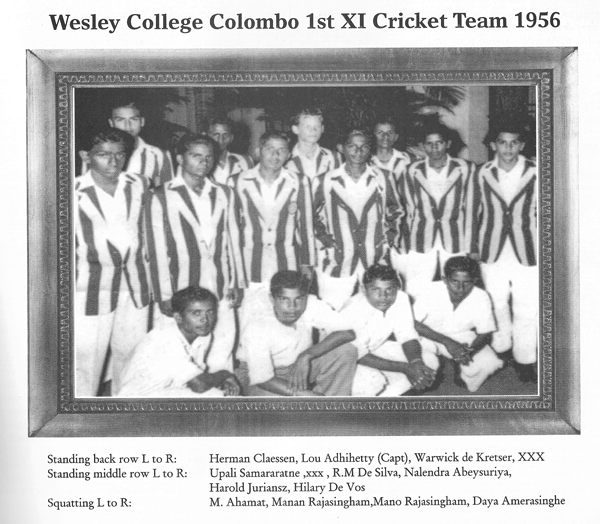
The Trinity-Wesley cricket match of 1956 will be remembered mainly for two reasons - for Wesley's "guts" in achieving the almost impossible task of scoring 49 runs for victory in 12 minutes, and for the splendid sportsmanship displayed by Trinity in bowling as many as 6 overs in 12 minutes and for not employing "delaying tactics" to baulk a Wesley victory.
This match was played on the 17th and 18th of February 1956 at Campbell Park. The hours of play were from 12 noon to 6 p.m. with a milk interval and a tea interval. There were no mandatory overs at that time. Nevertheless, there was a result.
Wesley batting first rattled up 281 runs, towards which D.P. Wickremasinghe contributed 25, Harold Juriansz 27, Warwick de Kretser 28 not out, Upali Samararatne 43 and L. Adhihetty 104, The bowling honours were shared by L. Fernando and Nimal Maralande who captured 4 for 68 and 3 for 52 respectively.
Trinity were able to total only 136 in the first innings towards which S Ettipola Contributed 23 and Maralande 29. The bowling honours were shared by Herman Claessen (who captured 5 for 40) and Warwick de Krestser, (3 for 42). It is sad to recall that Herman was killed in a motor cycle accident, not long after. Herman was a left arm bowler who was adept at bowling both breaks.
Following on, Trinity did well to score 193 towards which Maralande scored 34, G. Koelmeyer 38 and M. Odayar 42.
R. Maxie de Silva captured 5 for 37 and Herman Claessen, 3 for 69. The Trinity innings ended at 5.36 p.m. Wesley was left with 49 runs for victory. There were no mandatory overs, then.
The question on everybody's lips was how many overs would be bowled. Normally, allowing 3 minutes for one over, only 4 overs would have been possible. Very wisely, two left Handers Harold Juriansz and Lou Adhihetty opened the innings. If one of the openers had been right-handed certainly the number of overs would have been less and a victory may not have resulted. When the batsman faced the first ball, the time was 5.48 p.m. and only 12 minutes were left for play.
It must be said to the credit of the Trinity players that they refrained from
employing "delaying tactics". They did not delay unnecessarily in setting the field nor did they delay unnecessarily between overs. On the contrary, the fielders seemed to be in great haste to speed up the game. Thus, during the 12 minutes of playas many as 6 overs were bowled, 38 balls including 2 wides.
Wesley set about the task of scoring the required runs in a very sensible manner. They did not swipe at every delivery. Nor did they run after the ball half way down the wicket. In Lou's knock of 22 runs there was only one boundary. In Harold Juriansz score of 21, there were 3 boundaries and one six. Upali Samararatne was not out 4 and two wides made up the 49 for victory.
In fact when the game ended at 6 p.m. the large crowd present, were uncertain whether victory had actually been achieved and everyone converged on the two scorers in the pavilion to ascertain the result.
L. Fernando bowled 2 overs and conceded 20 runs. M. Ratwatte bowled J overs and captured 2 wickers for 20 runs while Maralande bowled one over giving away 7 runs.
The way that these two senior cricket schools played the King of Games that day was an object lesson to everybody. "For when the ONE GREAT SCORER COMES TO write against your name, he writes not whether youi won or lost but how you played the game."
By Senthil Sinniah
Transcribed from the Book - Wesley's Cricket History - by Jeremy Brohier
 These notes have been made by me, relying in the main, on my memory, of events that have taken place more than fifty years ago. Wesley's cricket during these years were following soon after her "golden" years with the Mack's, Claessens, Adihettys, Fuards and Samsudeens making an indelible stamp with their excellence. There was a big void created with their departure. Maintaining and keeping alive the earlier cricketing standards required dedication and hard work. The years recounted belonged to a period of consolidation and building. The number of matches won during this period was by no means remarkable but the foundation was being laid for better things in the years to come.
These notes have been made by me, relying in the main, on my memory, of events that have taken place more than fifty years ago. Wesley's cricket during these years were following soon after her "golden" years with the Mack's, Claessens, Adihettys, Fuards and Samsudeens making an indelible stamp with their excellence. There was a big void created with their departure. Maintaining and keeping alive the earlier cricketing standards required dedication and hard work. The years recounted belonged to a period of consolidation and building. The number of matches won during this period was by no means remarkable but the foundation was being laid for better things in the years to come.
1957 SEASON
During the period, the early 1950's to 1957, the Wesley College 1st Eleven enjoyed a "purple patch. The 1957 team, captained by Harold Juriansz - a hard hitting, left hand bat, medium pacer, who also kept wicket. The team contained only three "coloursmen" ---- Nalendra Abeysuriya, Upali Samararatne and skipper Juriansz and eight "freshers"----mostly from the Under16 team, which was the "nursery" for the First Eleven.
Results wise, it was a disappointing season. However, the "freshers" gained valuable experience and performed adequately.
Skipper Juriansz held the team together well and gave every encouragement to the younger players. Lorensz Ebert, a "fresher" with a good batting technique and temperament, gave promise of better things to come. Rajah Athukorale,Lucky Goonetilleke,Senthil Sinniah,Olkie Edema" Rajasingham twins, Warwick De Kretser and Hilary De Vos were some of the other "freshets".
1958 SEASON
Nalendra Abeysuriya, playing in his third year, captained the team and had Upali Samararatne, as his deputy. The nucleus of the team were the second year players----- Hilary de Vos - left arm, medium pace and hard hitting bat, "twins" Mano and Menon Rajasingham - solidly built, hard hitting batsmen and brilliant fielders, Warwick de Kretser - hard hitting bat and right arm medium pacer, Lorensz Ebert- dependable bat and good fielder, Senthil Sinniah - off spinner, improved batsman and safe fielder, Olkie Edema - left arm spin, Lakshman Goonetilleke- Left arm fast, swing bowler, Rajah Atukorale, a hard hitting batsman and Dharmaratne Kodituwakku, a good bat and reserve wicket keeper.
The team had reasonable success and moulded well as a unit. Skipper Abeysuriya, in his first year as captain, handled the team judiciously.
1959 SEASON
Nalendra Abeysuriya, in his second year as captain, had Upali Samararatne, as vice-captain and seven "coloursmen" in his team. However, the absence of Lorensz Ebert, last year's best batsman, left a hole, in the batting department. Abeysuriya, himself, a graceful left hand bat, and Upali Samararatne, a hard hitting, impetuous right hand bat, bore the batting responsibilities. Senthil Sinniah moved up the order to open the innings, Rajah Atukorale, middle order bat and Dharmaratne Kodituwakku, a stroke playing, middle order bat. Fresher Milroy Bulner, showed ample promise, as a batsman. A well balanced bowling attack, spearheaded by left arm pace man, Lakshman Goonetilleke, and skipper Abeysuriya, who used the new ball effectively.
Off spinner Sinniah headed the spin department. Derek Ingram, Errol Smith, Lalith Wijesingha, Kenneth De Silva and glen Reimers were the crop of freshers vying for regular places in the team.
After a slack beginning, the team performed very creditably, with Goonetilleke ripping through many of the strongest batting teams. Opening batsmen, quite often, moved their stance towards the square leg umpire, when facing Goonetilleke! Randy Layman and Richard Alles, the Peterite openers, were two batsman, who clearly were traumatised by Goonetilleke!!
1960 SEASON
Senthil Sinniah, in his fourth year captained the team had Dharmaratne Kodituwakku, as his deputy and the 1959 best schoolboy bowler, Lakshman Goonetilleke , as the nucleus of the team. Lalith Wijesingha, a very promising all-rounder, Errol Smith, a hard hitting left hand bat, Glenn Reimers, a correct orthodox bat, Derrick Ingram, opening bat, second year Milroy Bulner, and all-rounders, Kenneth de Silva, Milroy Muthuveloe and Sarath Wickramaratne provided the "spine" to the batting department. l.eft arm pacer, Goonetilleke, spearheaded the bowling department, ably supported by M.N. Mihlar, right arm fast, medium pacers Wijesingha and left armer Muthuveloe, with skipper Sinniah and Kenneth de Silva, both off spinners, undertaking ~re spinning duties.
The season started disastrously, with defeat at the hands of St. Peters College (on the Bambalapitya turf and St. Thomas's College (bamboozled by leg spinner Idroos) who took a liking to the "bouncy" matting at Campbell Park. As many as 14 catches were dropped in these two matches. With renewed determination, the team rallied around skipper Sinniah and achieved a notable victory over the strong Josephian eleven at Darley Road. Victory was achieved, in the last over, chasing down 197 runs in 130 minutes. Further victories were achieved over Trinity College, Richmond College and Kingswood College, while losing to Ananda College and drawing against Royal College. The youngster's performances were pleasing to see as they promised so much, for the future years.
Mr. Edmund Dissanayake and Mr. Fred de Mel (Masters in charge of college cricket (1957----' 60)
Wesley College was very fortunate in having these two teachers, in charge of cricket. They were two astute and dedicated teachers. Mr. Dissanayake was always available for those cricketers who needed to iron out any problems. He was enthusiastic and patient but firm, with any cricketer who stepped out of line. I will always remember Mr. Dissanayake demonstrating the classical "off drive" ---- picking up a bat he would play the off drive-in imaginary mode--- feet and hands in unison, a straight bat, finishing the stroke with the bat over the left shoulder (right handers.) All Wesley College cricketers owe them a great debt.
CRICKET COACHES (1957----' 60)
During this period, Wesley College had the services of three excellent coaches-----namely, Mr. A.V.Fernando, Mr. R.B.Wijesinghe and Mr. B.J.H.Bahar. Each of them had an individual method of coaching.
Mr. A.V. Fernando was soft spoken, with a "dry" sense of humour, spiced with a cutting edge.!!! He mainly adopted a wait and see attitude----allowing individual traits to blossom-----whether in batting, bowling or fielding. He never tolerated sloppy fielding. "Catches win matches" was his mantra.
Mr. R.B.Wijeysinghe (ex Sri Lankan all-rounder.) Very astute and quick to spot any weaknesses in your game. He was so good at explaining any
technical aspects of the game.
Mr.B.J.H.Bahar (ex Sri Lankan all-rounder.) Very forward looking and thinking coach. Encouraged the players to play to their strengths and always willing to discuss strategy and our opponents.
Many a Wesley College cricketer, looking back, will be grateful and thankful, that they were coached by one these three gentlemen.
WHAT A CRICKETING LIFE----- by Sooty Banda (interesting "tit bits.")
1. (1957) At practice, with Mr. A.V.Fernando (Coach) in attendance, a very promising all-rounder and future cricket captain, once had both hands in his trouser pockets. Mr. Fernando's eyes caught sight of this and he asked the cricketer (loudly) whether he was at cricket practice or whether he was playing another form of cricket. Result----no cricketer ever dared to put their hands in their trouser pockets----when Mr. Fernando was around!!
2. (1959) Vs. St. Peters College at Campbell Park. The Peterites on arrival at the ground, asked for the matting (already laid out and nailed in by Wilbert, the senior groundsman) to be raised, as they wanted to see whether there were any pebbles-------placed under the matting to assist the Wesley College pace bowlers. Surprisingly, the two umpires granted the Peterites request.
This added to the tension that was building up. The Peterite players then, quite loudly voiced(in their dressing room,) how they would finish Wesley off by early Saturday afternoon, giving them time to watch the afternoon movie at the Liberty cinema. Result---Upali Samararatne took Anton Perera (the Peterite paceman) apart and Wesley declared, after they reached 200 runs. The Peterites were bowled out twice for Wesley to win by an
innings and two runs!!!!!
3. (1960) Vs. Royal College at Campbell Park. In a low scoring game, Wesley was chasing 180 runs to win. Late on Saturday afternoon, the task was impossible as a mini collapse, left Wesley in dire straits. Storm clouds were gathering and the light was fast deteriorating. Kenneth de Silva and Errol Smith were batting but did not appeal against the light. However, the Umpires gave the light to the batsmen and the crowd (the Wesley supporters) implored the batsmen to take the light. The Royalists were none too pleased. Mr. F.C. De Saram (ex Royalist, ex Sri Lankan captain) who was watching the match, standing by the pavilion stepped in and loudly asked the umpires to resume play saying that the light was good enough!!! Up jumped Mr. A.V. Fernando (Coach) who was in the pavilion and told Mr. De Saram that, had he been batting, he would have walked off.
These incidents are worth recording for posterity's sake.
By Edmund Dissanayake
Transcribed from the Book - Wesley's Cricket History - by Jeremy Brohier

The result of a cricket match cannot be predicted with any degree of accuracy. Recently, Sri Lanka beat India convincingly in the first One-Day International and in the next. India beat Sri Lanka equally convincingly. The same is true of school cricket.
In 1959, St. Peter's humbled the mighty Thomians at Mount Lavinia, the last Thomian pair putting up stout resistance against the fiery bowling of Anton Perera and saved them from certain defeat. It was this same Pete rite team that went down tamely to Wesley by an innings at Campbell Park the following week, while Wesley in turn in the succeeding week had to eat humble pie at Mount Lavinia. The left-arm swing of Annesley de Silva, and the hectic pace of skipper Dennis Ferdinands proved too much for Wesley who did not relish turf wickets.
It is these vagaries of cricket, the glorious uncertainties, that continue to make cricket the "King of Games."
It is proposed to refer to the St. Peter's - Wesley match in greater detail. This match was played on the 30th and 31st of January 1959 at Campbell Park. Fresh from the laurels gained at Mount Lavinia, the peterites were cock-a-hoop when they came to Campbell Park.
In fact, prior to tossing, a few of the Peterite players even had the audacity to lift the cricket matting and look under it! What they expected to find nobody knows. A request was made to the Umpires that the pitch should be rolled before the match. The Umpires quite correctly stated that only turf wickets are rolled, and not matting wickets.
Wesley Skipper Nalendra Abeysuriya won the toss and elected to bat. The Peterite hero of the previous week, Anton Perera, struck again. He had captured 2 wickets and the Wesleyites were left wondering. Undaunted, out strode the mighty Upali Samararatne, undeterred. Came Anton's first delivery, a short-pitched bouncer and Upali hit it over the tallest tree in Campbell Place. The second delivery was given the same treatment, the ball landing on the hood of a car parked near the Prison. The third was clobbered to the boundary. The fourth dropped a little short of the sight screen. 20 runs in four balls ... even the ranks of Tuscany could scarce forbear to cheer. In that single over 22 runs had been conceded. Wisely, Anton was removed from the firing line. Wesley went on to score 191 runs. Rajah Atukorale and Milroy Bulner each contributing 29, while Upali Samararatne collected 48. Didacus de Almeida captured 3 for 27 and Anton Perera 2 for 56.
St. Peter's going into bat, were all at sea against the swing of Lucky Goonetilleke and the off-cutters of Nalendra Abeysuriya. Having lost 5 wickets for 46. St. Peter's were all out for 83. Lucky Goonetilleke captured 6 for 20 and Nalendra, 310r 11.
Following on St. Peter's fared a little better. The first wicket fell at 66 and the rest folded up for 105. Richard Alles scoring 51 and Brian Seneviratne 11, The only two batsmen to enter double figures. Nine batsmen could together total only 31 runs for there were 12 extras (1 byes, 5 leg byes and 4 no balls).
Lucky continued to be among the wickets capturing 3 for 17, Nalendra 3 for 23 and stocky M.N. Mihlar also taking 3 for 23. Wesley were victorious by an innings and were hailed as "giant killers"
It is relevant to record that Lakshman (Lucky) Goonetilleke was selected as the Best Schoolboy Bowler of 1959. He played for All-Ceylon against England and the large crowd present at the Colombo Oval wil1 remember how he clean bowled England Captain Ted Dexter, neck and crop. However, parodying the words of Dr. W. G. Grace, the crowd did not come to see Lucky bowl but to see the visitors bat."
Transcribed from the Book - Wesley's Cricket History - by Jeremy Brohier

It would interest readers to know that until Wesley purchased her present Pavilion in 1940, certain matches, including the fixture with Richmond, were played on the Ground adjacent to Baseline Road. That Ground did not boast of a Pavilion, the only shade came from a Goraka tree where the cricketers blazers were hung. That Ground is very popular for soccer today.
The cricket match of 1960, played at Campbell Park is of special interest because it was "Richmond's match" till the very last moment when "Wesley grit" triumphed by just 2 runs. Richmond had to score 115 runs for victory and were sitting pretty on 95 for 5, but were mesmerized by speedster lanky Lucky Goonetilleke and folded up for 112.
Play commenced at 12 noon as usual and within 69 minutes Wesley were back in the Pavilion having 'scratched" 74 runs. Kenneth de Silva was unbeaten on 19 Wesley lost the first 3 wickets for one run. Hemasiri Hettige who turned in an excellent performance of 5 for 17 was almost unplayable. The others who supported him were J.K. Pieris 2 for 14 and
E.W. Hamilton, 2 for 20.
• Richmond in turn were hundled out for 68. T. Jayasooriya scoring 23 and G. Benjamin 16, Lucky Goonetilleke captured 5 for 21 Lalith Wijesinghe 2 for 8, and Kenneth de Silva 2 for 12.
•Wesley scored 108 in the second innings. Lalith Wijesinghe 21, Ronald Smith 20, and Senthil Sinniah 16.
•Once again Hemasiri Hettige bowled his heart out to capture 4 for 27, J.K. Pieris captured 2 for 19 and H.M. Fernando, 2 for 30.
•Richmond were left with the task of scoring 115 for victory and although they had scored 95 for 5 succumbed to the swing of Lucky Goonetilleke who captured 5 for 42 and Lalith Wijesinghe 3 for 51 T. Jayasooriya made a well compiled 58. Wesley emerged victors by 2 runs.
The 1961 Match
It is interesting to record that in the following year 1961, when the match was played at the Galle Esplanade in comparison with the low scores of 1960 tall scores featured in the 1961 match.
In that match Wesleyite Ronald Smith missed a well-deserved double ton, when his partner Darrel Maye was run out, to remain on 199 not out.
Transcribed from the Book - Wesley's Cricket History - by Jeremy Brohier
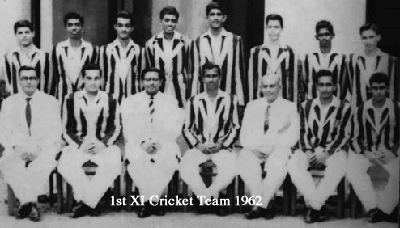
Wesley College was fortunate in securing the services of Mr. B. J. H. Bahar (Snr.) as her cricket coach. He hailed from far away Hambantota which produced outstanding cricketers who in their day did yeoman service for schools like Zahira. Ananda and Wesley. Mr. Bahar was able to build splendid rapport between coach and team, and that was one of the potent factors that contributed to success. In the year 1962, Wesley was also fortunate in having as her captain, an unassuming but most intelligent boy ... Lalith C. R. Wijesinghe.
One week prior to the Royal-Wesley match, Royal's speedster Darrel Lieversz, had annihilated St. Peter's College. In that match, at the end of the first day, out of the 8 wickets that St. Peter's had lost. Lieversz had captured 6 wickets for 3 runs, in 8 overs, 7 of which were maidens. And so, it was not surprising when in a pre-view of the Royal-Wesley Match the "Ceylon Daily News" of Friday the 23rd, of February, 1962 published the following headline ... "LIEVERSZ Vs WESLEY AT CAMPBELL PARK".
The insult Wesleyites were not going to take this lying down, their amiable coach had already planned the strategy to withstand the Royal fury. In cricket, as in war, attack is the best form of defence. Wesley was ready to meet the challenge .... more of this strategy, later.
Royal batting first scored 169 runs. S. Rajaratnam 18. S. Thiagarajah 21 not out, and S. S. Kumar 73 are the chief scorers. Everard Schoorman cartured 2 for 43 and Darrel Maye, 6 for 41.
When Wesley openers Milroy Muthuvaloe and Mervyn Hamer walked out to face the deadly combine of Lieversz and de Silva, there was a gasp from the Wesley camp ... they were not our regular openers! They had been instructed to thrash the bowling come what may... and so, when the righthander asked for his off-stump guard, there was a titter from the Royal close-in fielders'. The umpire too was confused. Who will want to take off-,stump guard? Perhaps this would have had an effect on Lieversz himself, psychologically. The Vicious inswing had to be countered .... And Wesley"s openers did it, magnificently.
At the end of the first day, Wesley had lost one wicket for 34 runs off 11 overs. Lieversz had bowled 4 overs and given away 10 runs. R. C. de Silva had bowled 5 oven and given away 20 runs capturing one wicket, while S. Rajaratnam had bowled 2 overs and given away 3 runs.
The Ceylon Daily News of 24th Feb published a picture on the left hand side and another on the right hand side. The picture on the left had the caption, "Darrel the Hero", The picture on the right bore the caption "Darrel who failed".
The Ceylon Daily Mirror of Saturday 24th Feb. had the headline, "STUBBORN WESLEY KEEP ROYAL AT BAY".
Wesley, in their 1st innings scored one run more than Royal, 170 runs, Darrel Maye 24, Sarath Wickramaratne 26, Milroy Muthuvaloe 30, and Kenneth de Silva 44.
T R. Jansen captured 2 for 19, S. Rajaratnam, 2 for 20, and Darrel Lieversz, 4 for 44.
Royal in their second essay could reach, only 136 runs towards which R. C de Silva scored 28. Lieversz 30. and Vijaya Malalasekera 31. Kenneth de Siva with his, fast offbreaks captured 3 for 18, while Darrel Maye with his off-cutters captured 4 for 44.
Wesley scored 136 for the loss of 5 wickets and won a magnificent victory by 5 wickets. Schoorman scored 23, Lalith Wijesinghe, 37, and Sarath Wickramaratne was unbeaten on 32.
Poor Lieversz ... he bowled 10 overs and conceded 31 runs without capturing a single wicket, de Silva however captured 3 for 50.
The Ceylon Observer of Saturday 24th, Feb. stated as follows, "WESLEY MASTER COMBINE" ... "The Lieversz - de 'Silva pace swing combination of whom so much was expected failed to do anything sensational. The Wesley batsmen showed no more respect to this pair than they did to the other bowlers" The Sunday Observer of 25th Feb. stated thus. "It was a tactical error that cost Royal the match by so wide a margin. Tempting batsmen behind the
clock with tossed up deliveries proved to be their undoing. The tossed up deliveries were so fondly collared by the Wesleyites who drunk with the strokes and runs and the schoolboy cheer played even the Lieversz de Silva combination with a gay abandon. It was vintage batting by Sarath Wickramaratne and Lalith Wijesinghe who moved up to the ball and the crack of willow against leather and the ball racing towards the rope? This and a strange contrast of the Royal fielding of brilliance coupled with mediocre bowling gave the boys from Campbell Park, a holiday which their cricket eleven most certainly earned.
The strategy of Mr. Bahar in countering the pace-swing attack had paid dividends. Yet, as the amiable cricket coach, he remains most unassuming and unsung, till the very end. It will be remembered that in 1962 Wesley defeated Royal, Trinity, St. Joseph's, Richmond, Ananda and Kingswood ... and unlike today, the grounds were full of spectators, cheering lustily. There were many ordinary folk who had nothing in common, with either School, who would come from far away places to watch Lalith and his band of "adventurers" wield the willow as it should be wielded.
The writer remembers with nostalgia the trip to Adam's Peak in the company of Wesley's most ardent supporters ... the Danister de Silva family. Our party had stopped at Kitulgala for light refreshment and spying a radio in a cafe requested the Mudalali to turn in to a "Big-Match" commentary in Colombo. The Mudalali did not display much interest but made a very salient comment... "Sir, you must watch Wesley boys. What are the other schools compared to Wesley?" We discreetly remained silent about our identity. He said that he travelled almost every week-end when the Wesley matches were in Colombo. He was able to rattle off the names of his heroes Sarath, Rodney, Kenneth, Lalith, Darrel, and Hamer ... those were the days of KING CRICKET.
Four runs to get in 2 balls and Rodney Perera swipes a Perumal bouncer over the Keeper
From "Wesley’s Cricket History" by Jeremy Brohier

In 1962 Wesley was coached by B. J. H. Bahar (Snr.) Lalith Wijesinghe was captain,m with Kenneth de Silva as deputy and the Wesleyites will remember the year for the wonderful cricket produced by their team, which resulted in victories over Trinity, Kingswood, Royal, Ananda, Richmond and St. Joseph's.
The match against St. Joseph's was of special significance as both teams were equally balanced and a large crowd converged at Darley Road, Maradana had taken "bets" on the game. Wesley declared at 240 for 9 with Mervyn Hamer making 50 and Sarath Wickremaratne 66, St. Joseph's replied with 124 with off spinner Kenneth de Silva taking 6 for 41. Following on the J oes were dismissed for 156 with Kenneth de Silva Capturing 5 for 36. It was in the J osephians second innings, that the 9th wicket was worth 50 runs, after a fresh lease of life was given to the batsman, when the Wesley keeper and another fielder appealed to the wrong umpire for "hit wicket".
Law 47 clearly states that the jurisdiction for "hit wicket" lay with the leg umpire ... and so the batsman continued with his innings, regardless. Wesley were left with only 30 minutes to score 41 runs for victory and then there were no mandatory overs. Five Wesley wickets had fallen, and with the crowd on its toes paceman Brian Perumal sent down the last over, from the swimming pool end. Four balls had been delivered and Wesley had to score 4 runs for victory in the last two balls. The entire field paraded the boundary line. While one fielder was even placed behind the wicket keeper.
In schoolboy language "a long bye". Run getting was almost impossible ... but not for Rodney Perera, Perumal's 5th delivery was a bouncer and Rodney swiped at it in the way one would hit a rubber ball. (popularly referred to as "uda bat"? and the ball sailed over the wicket keeper, and also the long bye and rolled over the boundary near the pavilion.
Rodney then raced to the pavilion, followed by an angry crowd (not schoolboys) who probably had lost their bets, Rodney was "hidden" in the pavilion while Kenneth de Silva jumped for joy and injured his head!
But the writer's problem then was to smuggle out Rodney with an angry crowd waiting at the northern entrance, near the pavilion.
There were three cars lined up facing the northern gate opposite the pavilion, the third of which was driven by Danister de Silva, who was given instructions by the writer to reverse his vehicle as soon as the first two cars had gone forward to turn, past the main building, past the swimming pool and through the southern gate, into freedom. This car carried Rodney, in dark clothing and dark glasses, Danister's children and the writer. In the words of Sherlock Holmes this was an exercise "Elementary, Watson!"
Rodney (now no more) was a very popular figure. He scored 101 not out in 43 minutes against Richmond. The other centuries scored in 1962 were by Kenneth de Silva 100 against Richmond and 127 by Lalith Wijesinghe
against Kingswood.
The Wesley cricketers will remember the wonderful sea bath at Uswetakeiyawa, in celebration of their victories, when Rodney mischievously pushed into the inviting waters, the cheering squad of Arlene, Audrey, Malkanthi and Wickramaratnes. (Did they learn from Percy) where they had their first lessons on swimming by using a tyre. The fabulous lunch at Danisters, and the sumptunous dinner at Bahars, where the Principal Shelton Wirasinhe and his wife Manel were present. Probably, they would have tasted for the first time the exotic food prepared in the inimitable Hambantota style!
Transcribed from the Book - Wesley's Cricket History - by Jeremy Brohier
In sharp contrast to some of the good performances of the 1940s and early 1950s, there was a slump in Wesley cricket after the mid-fifties. However, with veteran coach Major B.J.H Bahar taking over in 1960, a great recovery was evidenced. His efforts were strongly backed by Edmund Dissanayake, one of Wesley's cricket greats, who was the master-in-charge at the time.
Bahar introduced a lot of changes to Wesley cricket with his professionalism, knowledge and methods which were far ahead of what one would expect at that time. Cricket practices were very intense but thoroughly enjoyable. He believed the side nets were only for correcting technique and held center pitch practices, as often as possible, with both batsmen at the wickets, only 11 fielders and changing ends after the over and with him standing as head umpire. This was to emulate match conditions and work on all aspects of the game as far as possible.
He also made it a point to witness other school matches to spot the strong and weak points of the opponents and helped the team to exploit this knowledge.
Thanks to the dedication and acumen ofthe Bahar - Dissanayake combination, the improvement in Wesley cricket became evident in the 1961 team which was ably led by Dharmaratne Kodituwakku. It was a very successful season where Wesley was unbeaten with two very noteworthy performances against S. Thomas', Mt. Lavinia and Ananda College, Colombo. At Mt. Lavinia, Wesley came very close to beating S. Thomas' but was stalled by a classic example of Thomian grit when their last pair, Sirimanne and Selvadurai, held out to draw the match. In the game against Ananda, led by Yatagama Amaradasa, Wesley registered an excellent innings victory.
Lalith Wijesinghe's impressive all-round performances ensured his selection to the Sri Lanka Schools team, captained by Ananda's Yatagama Amaradasa, which toured India in 1961.
Another significant performance was the mammoth innings of Errol Smith who scored 199 not out against Richmond College at the Galle International Cricket Stadium. This was the highest individual score for Wesley till Mervyn Harmer scored 233 against Kingswood at Kandy in 1964, and Farveez Maharoof set the record at 243 not out against Richmond College in 2002.
It is sad and ironic that around four decades later 'time and unforeseen occurrences had to befall' Errol and his two sons - turning their dream holiday to Sri Lanka into a nightmare. Errol was taking his two sons on a sentimental journey to the venue of his great feat in 1961, the Galle Stadium, when the negligence of the driver resulted in the hotel car they were travelling in meeting with a deadly accident with a train at the unprotected railway crossing at Hikkaduwa. Despite being awarded damages by the Court, the appeal to the higher Court by the hotel has resulted in the case dragging on for the past 14 years. It is hoped that Errol and his sons receive the relief due to them soon.
In 1962, under the astute leadership of Lalith Wijesinghe, Wesley enjoyed what must easily be one of their most fruitful cricket seasons. Wesley went on to win six out of eight matches on the trot beating Kingswood, St. Joseph's, Trinity, Royal, Richmond and Ananda. Wesley lost their first encounter to St. Peter's and the next match with S. Thomas' ended in a draw.

The victory against Royal was quite special as wins against them don't come that easy, and, in 1962 they had a very strong team led by Darrel Lieversz, who was enjoying tremendous success in bowling. The media hype on a Royal win was so high that a daily newspaper carried an article before the match with the heading 'Lieversz vs. Wesley'.
However, Wesley went on to a comfortable victory when Darrel Maye bowled brilliantly to contain Royal by taking a match bag of 10 wickets for 85 runs. One of the happiest at the grounds was Wesley's and Sri Lanka's greatest batsman, the maestro Mahadevan Sathasivam who had taken a bet with his friends at (if I remember right) the Golf Club that Wesley would beat Royal. Sathasivam, who had been subjected to severe teasing by his friends, thanked the team for giving him the opportunity to go back and
have the last laugh at the club that evening. He also presented a bat to the writer, who was the highest scorer for Wesley in the Royal game. This was the bat presented to Sathasivam by Rohan Kabhai after he scored 60 not out for the Daily Mirror Xl (which comprised six West Indian players) in the match against the Ceylon Cricket Association at the Colombo Oval (P Sara
Stadium) in 1961.
The toughest challenge however that Wesley faced, according to Bahar, was Ananda, and he decided to witness their match with St. Benedicts at the Nalanda grounds to plan his strategy. On his return, he made a startling prediction that CT Rodrigo would be the match-winning bowler for Wesley as Ananda was clueless against leg-spin. CT, a right-arm leg-spinner, hadn't much occasion to bowl in the previous games but he was now put through his paces and worked really hard on his bowling. The plan of using him as the shock weapon was kept strictly under wraps.
In the first day's play, the plan not to use CT until it was vital worked spot on with Ananda collapsing for 116, without CT having to bowl. Wesley scored 254 in their first innings leaving Ananda to make 138 to avoid an innings defeat. In their second innings Ananda was quite comfortable at 80 for 2 when skipper Wijesinghe brought CT on. The shock weapon worked and Ananda collapsed sensationally for 94 and CT Rodrigo becoming a part of Wesley's cricket history with figures of 8 wickets for 9 runs in the Ananda second innings. No doubt CT would be the first to agree that his feat may not have been possible if not for the sensational fielding of Sarath Wickremaratne who had a match bag of 10 catches - six in the first innings and four in the second off CT.
Lalith Wijesinghe was quite appropriately selected the best schools captain in 1962.
Some of the other players who made significant contributions to the cricket successes of 1961 and 1962 were: Milroy Bulner, Glen Reimers, Darrel Maye, Kenneth De Silva, Milroy Muthuvaloe, Everard Schoorman, Mervyn Hamer, Bacha Fuard, Priyanath Fernando, Robin Reimers, and Milroy Jebarajah.
Transcribed from the Book - Wesley's Cricket History - by Jeremy Brohier

The year 1963 was a glorious year for Wesley cricket for under the captaincy of Milroy Muthuvaloe, who had Darrel Maye as his deputy, Wesley was awarded the Lifebuoy Shield for the best school cricket team of 1963 in the first year of its award; and Darrel Maye was adjudged "Schoolboy Cricketer of the Year".
The year 1963 is of further interest because the two-day fixture with Kingswood, played at Campbell Park, was completed in one day! Kingswood were shot out for 82 runs in the 1st innings. Darrel Maye capturing 4 wickets for 12 runs. Wesley replied with 143, Kingswood were able to score only 69 in the second innings succumbing to the wiles of Darrel Maye who captured 6 for 32. Wesley scored the required runs for victory and thus gained a ten wicket victory, on the first day itself.
The other victories were against St. Peter's and Richmond, the latter losing by an innings.
It is of interest to record that Richmond was the only school to beat Wesley in 1987, and it was a decisive 5 wicket victory at Campbell Park, which they richly deserved.
The 1963 matches against St. Thomas', St. Joseph's, Tinity, Royal and Ananda were left drawn. Wesley's skipper Milroy Muthuvaloe scoring an elegant 114 against Ananda.
The 1963 Wesley team was coached by Henry Van Buuren, who captained Wesley in 1935. He is considered as one of the shrewdest of captains that
Wesley has produced.
Transcribed from the Book - Wesley's Cricket History - by Jeremy Brohier
 As a kindergarten pupil, I walked through the school's back gates from Karlsruhe Gardens in January 1952 for my first day at Wesley. Those memories are vivid even today. Mrs Sheila Wijekoon was my very good looking class teacher. Mrs Joyce Lembrugen and Miss Nalini de Mel older daughter of Mr Fred de Mel (the Head Master) and later Mrs L.A. Fernando followed for the years 1953 and 1954. In between we had a replacement Mrs Deutrom, Willie's mother.
As a kindergarten pupil, I walked through the school's back gates from Karlsruhe Gardens in January 1952 for my first day at Wesley. Those memories are vivid even today. Mrs Sheila Wijekoon was my very good looking class teacher. Mrs Joyce Lembrugen and Miss Nalini de Mel older daughter of Mr Fred de Mel (the Head Master) and later Mrs L.A. Fernando followed for the years 1953 and 1954. In between we had a replacement Mrs Deutrom, Willie's mother.
The teacher who impressed and frightened every young Wesleyite was Miss Iris Blacker!
This is a piece on cricket; so, I will not dwell too long on her except to say that she instilled in me the love for cricket. I was seven going eight. She proudly announced cricket match scores with an elusive smile we were not used to seeing. She even told us why a new ball was important.
She seemed to know everything I needed to.
In 1955 we did have a cracking First XI team. Lou Adihetty, Abu Fuard, M.N.Samsudeen, Herman Claessen. These were names I was to remember throughout my life. Then here was Harold Juriansz the wicket keeper, R Maxwell de Silva, with Wickremasinghe held on to a record partnership for the last wicket against St. Peter's.
My father Reginald, a second generation Old Wesleyite was not a cricketer but a fan of the Claessen brothers and his classmate "M.Satha". He found time to con my mother into allowing him watch Wesley play St. Peter's .I was forced to watch as well.
How that game inspired me! I pretend not to remember the scores but I learned from the excited "old Wesleyite", "Lou had scored a century. Clive Inman the Peterite skipper too. Wesley had gone on to win.
The bug bit me.
On Fridays I would sit on my school bag watching the games. My two older brothers not as keen were already at home: Kotahena. Come Monday's general assembly, Mr Cedric Orlorff read the results out. On Friday morning he named the team to play the next match.
The team in 1956 had Lou Adihetty systematically making huge scores. Abu Fuard batted with a "Bungalow Bill" khaki hard hat that preceded the helmet. He then bowled sides out with a classic off spin. Abu was a complete all-rounder like Lou who opened the bowling.
Legend in his own right we were told tall tales about teeth flying around the place and clock towers knocked out with his hard hitting. Years later I from other schools. Ronnie at one stage had a crouching stance but he shot like a cobra when he had to.
Glenn gracefully stroked his way into the hearts of everyone who watched him and Lorenz was poetry in motion. How can anyone forget Derrick Ingram? He used his bat like a bludgeon and had the mighty J osephians with Priya Perera and Rajah de Silva cringe with his masterly 60 odd in 20/20 style. This was 1960 and we were to humble the J oes when we played at Darley Road for some years to come.
Deaths
Mention must also be made of Russell Ingram a brilliant junior cricketer and brother of Derek who moved to Nawalapitiya with his parents and continued there. We lost Robin Reimers and Teddy Campbell both brilliant junior cricketers when they both migrated after a year as freshers in the First XI. Their deaths were hard for us all to take having known these boys.
Milroy Bulner was the other. Affectionately known as "Rickshaw" he was loved by the juniors. Wesley and brothers Royston and Jimmy fine cricketers themselves at Kingswood. We lost Milroy very early in his life. I hope he stays within minds and hearts, and with Nalendra Abesuriya when we meet to celebrate.
Senthil had youngsters, Mervyn Hamer, Darrel Maye, Milroy Muthuvaloe, Sarath Wickremaratne who were fast learners and excellent athletes. They varne good and Wesley was now never to be taken for granted. With BJ.H.Bahar we had an innovative coach who thought outside the text book. The results were good and home grown Wesleyites needed no imports to slrow we were better than other schools. We now had the Thomians fighting for survival, the Royalists having to man action stations on their sinking ship, the Peterites making wickets that would counter our tough batting line-up. Wesleyites were flocking to see their school play and we did with a lot ofpride, walking home and bragging about the latest results.
In 1961 Daya Koddithuwakku our very own "Flagpole Boyd" skippered Wesley. "Kodda" who stood over six feet I am told was a man of two words." Pad on" or "eff off". As senior Prefect his imposing figure stood
at the first door in the hall as did those of all the greatest old W esleyites. A Brilliant opening bat and an equally good captain.
1962 was captained by L.C.R Wijesinghe." L.C.R" or Lalith had Kenneth De Silva a rotund all-rounder and another cricketer I admired. He used a lot of shoulder and his pace for an off spinner was not gentle or loopy. He banged them in, teams had to have a game plan against him. There was no "walk out and whack" more like "stick your pad out and wait till his fingers tire." They had all-rounders way down the line and Rodney Perera who preferred soccer to cricket chanced his hand when Mr. Bahar delightfully allowed him to express himself. He could have used a single stump and still hit the ball out of the grounds. A brilliant eye he had.
 Darrell Lieversz was the Goliath created by the newspapers and fine bowling performances. At Bambalapitiya he had skittled a strong Peterite batting line-up for less than 40 runs in two innings. But the coach had watched him and an improvised batting line-up planned for the big day ... the second oldest clash in schools. The Daily News head line prompted by our own Christie Senaviratne who had a nom de plume of "Wrong Un" read "Lieversz versus Wesley". If school cricket crowds missed that match as I did (punished for some reason or other) they would have missed the school match W esleyites will remember. Mervyn Hamer and Muthuvaloe went out and took Lieversz and R. C D'Silva his new ball partner "to the cleaners! My father who had the right to the Sunday Observer before me broke into a smile and handed the paper over to me. We had beaten the strongest school team by five wickets. I almost memorised the article by Eustace Rulach reading it over and over. I was to be "gated" the whole week -end but I got off on Sunday and went about bragging to all my friends My classmates described their innings when we returned to school on Tuesday Monday, being a holiday? I stayed at home and celebrated!
Darrell Lieversz was the Goliath created by the newspapers and fine bowling performances. At Bambalapitiya he had skittled a strong Peterite batting line-up for less than 40 runs in two innings. But the coach had watched him and an improvised batting line-up planned for the big day ... the second oldest clash in schools. The Daily News head line prompted by our own Christie Senaviratne who had a nom de plume of "Wrong Un" read "Lieversz versus Wesley". If school cricket crowds missed that match as I did (punished for some reason or other) they would have missed the school match W esleyites will remember. Mervyn Hamer and Muthuvaloe went out and took Lieversz and R. C D'Silva his new ball partner "to the cleaners! My father who had the right to the Sunday Observer before me broke into a smile and handed the paper over to me. We had beaten the strongest school team by five wickets. I almost memorised the article by Eustace Rulach reading it over and over. I was to be "gated" the whole week -end but I got off on Sunday and went about bragging to all my friends My classmates described their innings when we returned to school on Tuesday Monday, being a holiday? I stayed at home and celebrated!
By 1963 Milroy Muthuvaloe's team were ready to take on anyone. Wesley had no stars just a team of very talented cricketers. Darrel Maye, Muthuvaloe himself and Everard Schoorman were the all-rounders genuine as they come. They could bat, bowl and field better than anyone on the schools' circuit. We impressed defeating Owen Motthau and Kingswood in just one day: Richmond in an hour on the second. Trinity, St Thomas and Royal put up shutters though they had home advantage and turf wickets alien to us. St. Peter's forced a draw. St Joseph's were bundled out for 65 but fought back only dogged defence from CT and Rodney kept Brian Perumal and Victor Wickremasinghe at bay. Muthu battered the Anandian attack between cover and third man leaving five fielders standing helpless at the brutality of his century. Rodney Perera's innings at Asgiriya showed that he was able to curb his natural instincts and playa responsible part in the team.
He made over 80 runs, unbeaten.
In 1964 we lost two matches under Everard Schoorman and Mervyn Hamer his vice-captain. One was on the Bambalapitiya mine field where David Heyn showed he was a master of all;trades and got 13 of our wickets and restricted us to 60 runs when all we needed was 120 to win! St. Thomas' is the bad humoured match we lost because of putrid fielding and I suffered. The same happened against Royal but William Deutrom took cricket to another level of comedy and got a slating from the media for making the Royalists laugh. We did not lose and to me that was important.
Donald Thurairatnam's 1965 team was probably the worst side since the Golden 1950's the vintage years of cricket at Wesley, sadly we lacked direction because we were rudderless. We had a dancing instructor who volunteered to Coach us and then he stood at the umpiring end and counted the overs. We had no plans and the senior players were not consulted. Some of the umpiring decisions in Galle were shocking and although we grudgingly congratulated our opponents their victory drumming on the doors haunted me for some time. I don't know whether I needed to be respected ... that did not matter much to me but playing for Wesley came as a surprise even when I did play. It just happened and I have to thank Mr. Edmund Dissanayake to seeing that there was something positive in my otherwise negative attitude.
The jibes on the corridors hurt me and although I vowed to make amends we were never given the chance. Mr. A.S.Wirasinha the Principal dismissed us as arrogant and good for nothing. We did nothing to prove him wrong. Then things got worse in 1966. We lost six games by innings and one by ten wickets. We hit rock bottom without any aid or direction that was due to schoolboys. Those were the bad years.
I was proud to have met many of the icons of those years having corresponded with the Claessens Bryan and Radley I was able to tell them both how much I admired them. Sadly Bryan will not be with us but I am sure that more than ever he will spiritually be there.
We were juniors when we heard of Herman's death and mourned the youngest of the Claessens. The pocket dynamo Patrick Schockman I had the chance to meet with the Obeysekera twins Carl and Valentine of Nalanda team mates at the BRC when Patrick was on holiday.
Neil Gallaher the debonair Irishman who was a Banker with a "six pack" stomach even when he was approaching, he said seventy. I thought he was twenty years younger then I started to count back and yes, this man had held it up with the reckless and mischievous glint in his blue eyes. Neil was always hilarious and a lover of life and of good things: ladies for example. I swore I wanted to grow older like him smiling ... but I can't as I lacked his good looks. Neil was a major contributor to the Hong Kong and Shanghai bank's A division cricket team where Darrell Maye and Kenneth de Silva played and I suppose worked sometimes! Darrell and Kenny were my heroes from the 1962 team. I learned to bowl into the "leg trap" watching Kenneth's spinners bite and turn where Muthuvaloe, Sarath Wickremaratne hovered to snatch amazing catches. I was not at the match but saw the amazing feats of "CT" Rodrigo who humiliated a powerful Ananda team with his leg spinners 8 for 9. His action was so side on that I imitated it and got a little turn myself with adequate results, I suppose.
I was also able to catch up with another old Wesleyite opener Lucky Abeywardena at the Bloomfield Cricket Club pavilion a wooden shed bordering a "paddy field of grass and an apology for a matting wicket! Lucky was a member of the team that won the Saravanamuttu Trophy the Premier League tournament, then with loads of great contributions. He was a quiet man and had a great cricket brain.
At the BRC I was a member of the Donavan Andree team (Second Division) under the captaincy of big burly Clive Bartholameuze. He could hit a ball far and hard, so I was happy he was on the same side as I was when it came to me bowling. Clive was on his way to retiring playing the odd week end. Brothers Herbie and Allan Fe1singher were also old Wes1eyites who made their mark as umpires and players in the sixties for first class clubs.
I must mention now that an uncle of mine (my favourite) Ashley Casie Chetty, played in the Golden fifties. Again I use Niha1 the authority. His career was cut short I suppose because of an incident on a train that was doing the Kandy Colombo run. I am told and the Master in charge spent the whole trip locked up in the toilet. The team I hear thought it funny. But not Mr.J.L.F. De Mel.
I needed clarification about my uncle's escapade but were taboo, so I had to seek advice to find out if my own behaviour was as normal as his! Trouble seemed to run in our blood. Principals and Masters in charge found our humour hard to accept.
I would be failing in my duty to the Fuards, the late Ansar, Abu and "Batcha" not to mention them in a paragraph. The older boys were stalwarts in the best sides of the fifties. All- rounders, senior prefects. They were fine cricketers with hugely different characters. Abu was forthright, Ansar, a diplomat. One was appreciated, the other was not." British is about looking down and not up". Abu did disagree and thought like I do that the old school tie cannot be flying for ever. He never got past being vice- captain for two successive years. I felt hard to understand why ... but I suppose the people who like to stamp their authority on the game are always right, be it justifiable or not.
Batcha was the studious one. But he could not climb a coconut tree wearing a sarong! I remember laughing on to a gripe in Galle 1963 after Darrell Maye's XI had smashed Richmond in a day and an hour. One of their batsmen had a broken arm, thanks to a Maye bouncer. We had hours to kill and almost had a suicide when one who came to be known as the "Wintogeno Kid" was trying to check the speed of the Matara- Colombo express! Wesley's good relationship with Richmond faded into the night sky when a sight screen somehow managed to crash downhill and a bell mysteriously started ringing at night. Then the team paid a visit to an annoyed principal of Richmond with an apology for all the wrong done since that school had been built, and we were forced to be nice to them. We sang the school song. We, Wes1eyites do not seem to like trains somehow!
To my absolute horror when I returned home and "dog tired" I dropped off to sleep. I was woken up by a lot of arguing going on between my parents. Mother having tried to wash my dirtied clothes had opened my bag and found spilling a pile of "girlie magazines". My father was appalled being a straight laced conservative type. I was confronted. I had not checked my bag my team mates had stuffed their books into my bag. He wanted to report them and my mother thought otherwise. My defence was "I did not know they were there". I swore I would not go back to school if he complained so he decided against it.
Never found out who stuffed them in.
By T M K Samat
Transcribed from the Book - Wesley's Cricket History - by Jeremy Brohier
1972 1st XI Cricket team

I can't quite grudge giving kudos to, Wesley won purely through their guts, will and determination to come up from almost the floor.
If you heard or read about an explosion at Borella last evening, let me reassure you, it was only a roar from a thousand Wesley throats that rose to the high skies at 5.20 p.m when their cricketers, so disbelievingly and stunningly snatched victory from the Thomians.
It must have left their own supporters feeling they've just seen the living example of a miracle and left yours truly, who yesterday condemned them to panic stations after their reckless batting, blushing but happy eating his hat! Sheer guts. It was the kind of performance that even those in the other camp
Left standard. Wesley keeper Granville Hamer whips off the bails. It was in 1954 under Ansar Fuard that the Wesleyites last won over the Thomians and it seemed they threw all that suppressed frustration and determination stored for over 18 years into yesterday's play alone.
Clearly, after Wesley's crazy run-chase on the previous day in which they lost six wickets in the final halfhour, there must have been some deep rethinking even though Wesley's batting in the first innings had come down to its last pair. But Ajit de Silva and R. Kern reflected the change in Wesley's attitude when through sensible methods they added 36 runs last afternoon in about even time. This was the beginning of Wesley's recovery the switch point of the game.
ST. THOMAS 1st Innings 153
Wesley Ist innings 153 for 9 (overnight)
S.A. de Silva not out 21, R. Kern c. Rudra b. Abeywardena 18, Extras 14. Total 169
BOWLING : H.D.K. Silva 15-4-39-2, R. Saravanamuttu 3-1-7- 0, R. Ellalasingham 5-2-14-0, A. Abeygunawardena 20-5-62-4, R.
Abeywardena 14.3-1-33-4.
ST. THOMAS
2nd Innings
L.P. de Silva b Jansz 5,H.D.K. Silva c Disanayake b Jansz 1, R. Rudra b Jansz 0, S. Manotharan b Jansz 10, F.J. de Saram lbw b Jansz 8, R. Saravanamuttu, c Cader b Wijesinghe 17, N.M. Wijesuriya run out 16,
A. Abeygunawardena c Hamer b Wijesinghe 0, C.D. Ekanayake run out 32, R. Abeywardena St. Hamer b de Silva 3, R. Ellalasingham not
out 0 Extras 7, Total 99.
Fall: 1, 1, 16,25,28, 56, 56, 63,95
BOWLING T. Jansz 14-4-26-5, W. Vandort 6-2-8-0, R. Kern 4-0-11-0, A. H. A. Cader 10-2-21-0, A. Wijesinghe 6-1-21-2, Sellamuttu 1-0-5-0, S.A.
de Silva 1.1-1-0-0.
WESLEY 2nd Innings
O. Dissanayake c and b Abeygunawardena 16, G. Peiris c de Silva b H.D.K. Silva 8, R. Devadason c and b Abeygunawardena 13, T. Jansz c H.D.K. Silva b Abeygunawardena 21, A. Wijesinghe not out 19, G. Hamer not out 2, Extras 5. Total (for four wickets) 84.
FALL 22, 28, 61, 80
BOWLING: H.D.K. Silva 7-0-21-1, R. Ellalasingham 3-1-11-0, A. Abeygunawardena 8-1-28-3, R. Abeywardena 4.5-0-19-0.
By Y.K Dayaparan
Y.K. Dayaparan was 1st XI Cricket Captain 1975
Transcribed from the Book - Wesley's Cricket History - by Jeremy Brohier
I was selected to represent Wesley 1st eleven team in 1973. I was elected as the captain in 1975 and went on to represent the school till 1976.
1974 was a special year for Wesley as the college celebrated its centenary year. The team was captained by Dayalan Sellamuttu, arguably the best right arm leg spinner among the schools that season. The team also had one of the best right arm off spinners in schools - Russel Kern, who bowled in his off spinners at a speed of a medium pace bowler. We had a 'moderate' season.
In 1975 we had the honour of being coached by the best batsman Sri Lanka produced in the pre-test era - M. Sathasivam an old boy of Wesley. "Satha", as he was fondly known, had a quick temper and expected extremely high standards from the cricketers. His positive approach to the game was unmatchable.
After leaving school I associated with him for a few years and came to know him better. He was a sincere human being and always willing to help others.
In 1975 we resumed our encounters with two leading Buddhist schools in the country, Ananda College and Nalanda College. In the early 1970's
Wesley suspended the annual encounter with Ananda College due to some unpleasant incidents that took place after a match. I do not recall Wesley having an annual encounter with Nalanda College but it is heartening that our relationship with Nalanda College was strengthened by our cricket encounter.
In 1974, for the first time, Wesley had an encounter with a school in J affna - St. John's College. All the cricketers were excited to travel to J affna as most of them had never seen that part of the country. The journey took longer than expected, more than 8 hours by train, to the dissatisfaction of the players.
The hospitality showed by St. John's students and staff was heartening and we were surprised to see the talent of the cricketers in the north. Wesley won that match and we had the luxury of spending an additional day in Jaffna. Some players were curious to taste the famous "Palmyrah Toddy" in Jaffna. Two of them sneaked out from the school and found their way to a toddy tavern. After a few "shots" they returned to the school, unable to stand or walk straight. Fortunately they escaped the eyes of the masters in charge. The following year, in 1975, these 2 players were appointed as Captain and Vice-Captain.
Very recently I came to know of an interesting incident that took place under my captaincy. It was a well concealed secret. I was injured in a game prior to the Richmond game in Galle and decided to avoid the Richmond game on doctor's orders. On the day before the match I was feeling much better and decided to travel to Galle to play the game. In the meantime it was decided that Dilrukshan De Alwis was deputising for me as the wicket keeper. I arrived in Galle taking the early morning train just approximately 15 minutes before the toss. The team gave me such a warm welcome I was wondering why? Unable to figure out the reason I continued taking over my role as captain and keeper. It was only very recently that I got to know that coconuts were craftily plucked from a tree without permission from the owner adjoining Richmond premises and that in the process Dilrukshan who was to keep in my place had dislocated a finger trying to help the culprits by catching them as they were plucked. What a laugh I had, but what is ironic is that the secret was concealed so long.
Several hundreds of cricketers have passed through Wesley. The way Wesley taught us to play cricket helped us to look at the world beyond ethnic and religious borders. Wesley did not produce champion teams year after year but Wesley cricket certainly produced high quality individuals.
The most important lesson taught by the school was - "Play the game in the correct spirit. Victory is secondary".
We are thankful to all our coaches, masters in charge and our Principal, Shelton Wirasinha, for teaching us how the game should be played and until this day we lead our lives the same way.
By Ganesh Mylvaganam
Transcribed from the Book - Wesley's Cricket History - by Jeremy Brohier
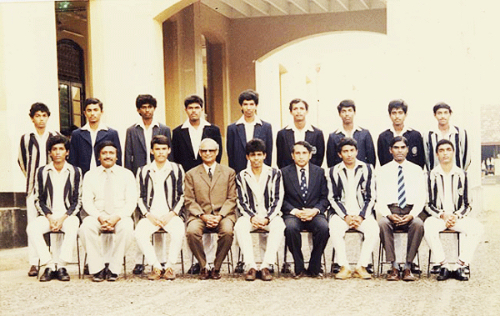
It is my privilege as the captain of the 1985 victorious cricket team to send a message to the Wesley College cricket book that is being compiled to be launched on the 7th of September 2012.
Today is a day when we gather to enjoy a pleasant evening of fellowship of the opulent past, those cohesive schoolboy days of writing exams and playing games, successes of the "Golden Years" will surely belongs to all W esleyites of the time. You will stop the beat of the rhythmic band to re-live the "the best days of your life", through Wesley's rich tradition of excellence steeped in the camaraderie of 'one fraternal band', taking "Wesley forward steadily from victory to victory". Now as "past and present kindly meet" let it be so, that your school day achievements will always remain as your most cherished recollections to this very day.
The team which I led in 1985 is a bunch of friends who played for each other. Although, none of the cricketers played representative cricket for various reasons, we played extremely well against schools which possessed representative cricketers. Foundation for the 1985 success was laid under the leadership of Mahendra Dissanayake who captained the team in 1984. We lost only two players in 1985 and with the few youngsters who gained valuable experience during the 1984 season, which enabled them to perform to their potential in 1985. My job was made easy by some outstanding leaders around me. Dugal J ansz (Vice Captain) and Mahendra Dissanayke contributed eminently with their leadership qualities. The team possessed all round talent, and had some outstanding schoolboys. The team strength was bowling and the fast bowlers were led by dangerous Mahendra Dissanayake, who was assisted by consistent Perry Brohier, lion hearted Dugal Jansz, hardworking Manjula Jayasinghe, Jeganathan Wijenathan and baby of the
team Danesh Dissanayake. The spin department was headed by outstanding Divakar Ratnadurai who was supported by Anjula Fernando and outstanding Chaminda Gunaserkera. The team had a strong batting line up. I had the opportunity to open the batting with the hard hitting Duminda Nissanka. The pair was well assisted by the consist:ent Chanaka De Mel and all-rounders late Rajah Navindran, Zeshan Mantara, Dugal Jansz, Mahendra Dissanayake and Danesh Dissanayake. The team also had the service of Jerome De Fransz and Shehan Wijenayaike. We were fornlllate to have the services of one of the brilliant cricketers in his days to coach the team. Milroy Muthuvaloe who led Wesley in 1963 and became the best ali island team. Using all his experience he guided us to repeat the same in 1985, The team was managed by Nimal De Silva, who also coached and guided most of the boys in the team during their early days at school.
The team is remembered not only for some outstanding performances on the field throughout the year but the way the boys conducted themselves off the field. We had some outstanding games ,llld did well against most of the leading schools. The win against Trinity at Campbell Park was well deserved and the performance against Nalanda was outstanding having bowled them out twice for 84 in the 1st innings and 89 in the 2nd innings. Mahendra Dissanayake had an outstanding game with a matCh bag of 14 wickets, capturing seven wickets in each innings. Nalanda had both Roshan Mahanama and Asanka Gurusinghe playing for them.
Whilst the past cricketers and associations all over the world got their own agendas, it is heartening to note that all have supported the college in various capacities, thereby giving the necessary encouragement to the players. May this be the beginning of a long association. Transcribed from the Book - Wesley's Cricket History - by Jeremy Brohier
I joined Wesley in 1950. After captaining the Under 14 and Under 16 teams, I had the privilege of being appointed as the Captain of the 1st Eleven Cricket team in 1963. We went through the season unbeaten defeating St Peter's, Kingswood, and under the able guidance of our coach Henry Van Buuren, former captain, and astute tactician, we were selected as the first recipients of the Lifebouy Shield, for the best school's cricket team of 1963. Darell Maye was selected as the "Schoolboy Cricketer of the years from 1960 to 1962. We came under the able guidance of B.].H. Bahar (Snr) , who hailed from far away Hambantota. Our Cricket was right on top. Other members of the team were Everard Schoorman (Australia), Milroy Jebarajah (Canada), Batcha Fuard (New Zealand), Sarath Wickramaratne, Mervyn Hamer, Clifford Rodrigo, Rodney Perera, C.Perera, L.Femando. I was invited to be the honorary coach of the 1st Eleven in 1981 I accepted the challenge although the facilities available were limited. We were unbeaten in 1981 and in 1985.
It was with a great sense of satisfaction that I can state that during the period 1981-1988 many centuries were scored by the boys trained by me. On four occasions, more than a 1000 runs were scored by individual players. Navin de Silva achieved this twice in 1981 and in 1982. In addition he captured more than 50 wickets each year. Duminda Nissanka scored 1000 runs in 1987.
Navin de Silva was selected to lead the Sri Lanka Schools Cricket Teams tour of England and its worthy of mention that the former Captain and Vice Captain of our National Team, Arjuna Ranatunga and Aravinda de Silva played under Navin in this tour. Our unbeaten team of 1985, skippered by Mylvaganam Ganesh was adjudged the Best Schools Team and was awarded the Lifebuoy Shield again, for the third time, the second being under the captaincy of Amaresh Rajaratnam. in 1969.
Before I conclude I must also refer to the 1983 Under 17 Team skippered by all-rounder Mahendra Dissanayake, which won the All-Island Division II Tournament, winning all six (6) matches. Mahendra captained the 1st XI in 1984. He holds the school record as the best bowler against St Peter's capturing 8 for 54, in 1985. In the same year, in the match against the invincible Nalanda team, on the Nalanda Grounds, Mahendra was in devastating form capturing 7 for 34 and 7 for 30. Even Asanka Gurusinghe and Roshan Mahanama who were stalwarts in the national team later found it extremely difficult to face the deadly inswing of Mahendra. He materially helped the school to become champions in 1985, through his personal example with bat and ball. It was with great regret that I accepted a staff post in Nuwara Eliya in 1988, which prevented me from serving my Alma Mater longer. Transcribed from the Book - Wesley's Cricket History - by Jeremy Brohier
Wesley College has experienced its fair share of ups and downs in cricket, as most schools do, and was going through a particularly lean period in the early 1990s. This resulted in the first Xl cricket team being demoted to the second division of school cricket somewhere around 1994.
In 1996, in deference to the requests of many cricket enthusiasts, the Wesley principal Mr. N.A.B Fernando, entrusted the responsibility of reviving our cricket to the Old Wesleyites Sports Club (OWSC). As a first step in this direction the OWSC Cricket Committee selected Sri Lanka's first Test captain Bandula Warnapura as the coach for the task. Back on track
Warnapura, a veteran level qualified coach, got down to business straight away and, at the first practice session in August 1996, he gave a tough challenge to the cricket squad to save Wesley, a school with a glorious past in cricket, from the ignominy of playing in the second division.
The only way they could achieve this was by emerging champions or runners-up out of 26 schools in the up coming season as only the first two in the group would be promoted to division one. Of course Warnapura did warn the boys that this would be back-breaking work in the next seven
months. But none appeared to be dismayed. The team and coach got down to the job straight away.
In the 1996/1997 cricket season, Manjula Karunaratne the captain, Brian Senadeera vice- captain and five to six seniors spearheaded the campaign to accomplish this goal. Of the 16 matches played, they won. two, lost one and earned enough points in the 13 drawn games to emerge runners-up and earn promotion to divisionone,
Karunaratne and Senadeera bowled well with Karunaratne taking 8 wickets for 60 runs against Thurstan which is the best bowling by a Wesleyite against this school.
Jayakody's eight tons
A major contributor to this success was Dharshika Jayakody who batted magnificently to score four centuries in the first-term matches in 1997 as follows: 116 vs. St. Joseph's 131 vs. Kingswood, 110 vs,.Jrinity and 136 vs Richmond.
Jayakody continued his century-scoring spree in 1998 with four more _ 125 vs S. Thomas', 126 vs. Carey, 101 vs. Vs Nalanda and 171 not out vs. Maris Stella. His scores against Maris Stella and Carey are the highest by a Wesleyite with these schools.
For this astonishing feat the Sri Lanka Schools Cricket Association selected Jayakody as the best batsman in division 2 and the best all-rounder in school cricket.
Unfortunately he was unable to increase his tally of 8 hundreds despite playing another season but his record will certainly be a hard act to follow.
Keeping the ball rolling
Brian Senadeera captained the side with Darshika J ayakody as deputy in the 1997/1998 season, and despite facing stiff competition in division one, kept the momentum of the previous season going to win one game, lose one and remain unbeaten in 14. Indika Ranasinghe made a well-compiled 100 against S. Thomas' Mt Lavinia.
The 1998/1999 season was very special with Wesley celebrating their 125th anniversary. Darshika J ayakody (captain) and Azri J aldin (vice-captain) had the honour of leading Wesley in this auspicious year and, though the results weren't quite matching the great occasion, the team performed quite steadily to record one win and remain unbeaten in the balance 17 matches. M. de Silva batted well to make 104 not out vs. St. Peter's College.
In 1999/2000 Rakitha Wijetunga captained the team with Danushka Dissanayake as his deputy. Of the 16 matches played two were lost and 14 drawn. Dharshana Medagedera enjoyed a great season with three centuries - 113 vs. Sri Jayawardenapura Kotte, 104 vs Kingswood and 125 vs. St. Sebastians. Skipper Wijetunge also scored a century (103 not out) with Sri J ayawardenapura Kotte.
They say' coming events cast their shadows before them' and this appeared to be true of Farveez Maharoof who started his climb to cricketing fame in the 1999/2000 season with a great bowling spell to take 7 for 13 against St Benedict's College. He also earned selection to the under-15 national team for the Junior World Cup held in the United Kingdom.
Thanks Warnapura!
It was sad to lose Bandula Warnapura who resigned at the end of the cricket season in March 2000 to take up a post with Sri Lanka Cricket. The skimpy sketch above of events in the past four years ofWarnapura's coaching hardly does justice to the great job done by him to raise the standards of our cricket and instill into the boys the fighting spirit and hunger to win.
This can be best described by a humorous and colloquial comment by a Nalanda old boy at the Wesley-Nalanda match in March 1997 at their grounds.
A great rapport existed between the two schools and there were some old boys of both schools and Warnapura chatting together and watching the match.
Wesley had fared very well to overtake the Nalanda 1st innings score and was around 280 for 8, about an hour before tea, when Warnapura wanted Wesley to declare. An old Wesleyite then suggested it would be better to get 300 and declare. This provoked a Nalanda old boy, who knew Wesley had lost the six previous encounters to them, to promptly retort: "Wesleyta giya kala! Dang ung enewa Nalandata thun siyak gahanna." Though much of the flavour is lost in the translation the closest English equivalent could be:
"See how Wesley has gone places. Now they are coming to score 300 against Nalanda." Great progress indeed.
Rajapakse takes charge
Neil Rajapakse, former St. Sebastians coach and present Royal coach, took over the coaching from Warnapura.
The 2000/2001 team was captained by Rienzie Senadeera, brother of Brian who captained in 1998. The vice-captain was Rishi Kanagasabay. They led the team to a reasonably successful season to remain unbeaten in 17 matches with a victory over Richmond Galle to retain the E.R de Silva trophy after a lapse of 10 years. Farveez Maharoof's batting talent became quickly noticed with his two centuries - 163 against Prince of Wales and 144 against St. Josephs in 2001. These scores are the highest by a Wesleyite against these
two schools. He also shone in bowling with figures of 8 for 22 and 2 for 19 against Richmond - a match bag of 10 for 41.
A wonderful incident' depicting true sportsmanship occurred in the 2001/2002 season. It was a toss-up for captaincy between the slightly more senior Sajith Colombage and Farveez Maharoff who was the more successful performer and had more years of school cricket ahead. However as there was a delay in making the choice Colombage went up to the school authorities and said he felt Maharoof should lead the side as he would make a better captain. Sajith added that he had no problems at all about playing under Maharoof. Accordingly Maharoof was made captain and Colombage the vice-captain. This incident was reported by veteran sports journalist Ravi Nagahawatte in the Island newspapers on January 19,2002 in an article under the heading 'Wesley leads in sportsmanship' .
In this season Wesley played 17 matches, won one, lost one and drew 15. The highlight of the season was the 243 not out by Maharoof with Richmond at the Galle Stadium on February 26, 2002. This is the highest score by a Wesleyite in school cricket. He also had a match bag of 11 wickets for 81 against Isipathana, and went on to be selected to the U-17 national side.
Anderio T oussaint also had a fine season scoring 863 runs and accounted for 42 victims behind the stumps. He was voted the Most Popular Schoolboy
Cricketer 2002.
Maharoof peaks
The 2002/2003 season again had the same combination of Maharoof and Colombage as captain and deputy respectively, though Colombage frequently took over when Maharoof was on national duty. Wesley played 17 matches and went through unbeaten. K Kodikara scored a good 100 against St. Sebastians. Maharoof scored 146 ~\gail1st Ananda (highest for a Wesleyite with Ananda) and 101 not out against Nalanda to take his tally to five centuries in his school career.
Maharoof was selected Schoolboy Cricketer of the Year and Best Schools Batsman.
In the 2003/2004 season we had Nuwan Samith as skipper with Avishka Liyanage as deputy. Of 18 matches, we won one, lost one and drew 16. Wesley was placed 15th out of 26 schools in division one, the best placing in the past 12 years. Maharoof represented the national team at the Junior Word Cup in January 2004 and was awarded the 'Prince of Wales trophy' for the Most Outstanding School Cricketer. Finally Maharoof had the great distinction of being selected to the national side while still a schoolboy. The last Wesleyite to achieve this was Bryan Claessen in 1953.
Neil Rajapakse resigned from coaching on February 5, 2005 to take up an assignment in Malaysia. In the five years he served, the performances were steady and our cricket was on track.
Danesh is back
Danesh Dissanayake a former Wesley captain and outstanding batsman who had five centuries in his school career took over the coaching from Rajapakse.
In 2004/2005 Avishka Liyanage led the side with Charitha Karunaratne as vice captain. Of 16 games we won one, lost 2 and 13 were draws. Wesley retained the ER de Silva and LV J ayaweera trophies for first innings wins with Richmond and St. Anthony's Kandy respectively. Avishka batted well to score 101 not out vs. Sri J ayawardenepura plus seven half centuries in the other matches.
It was very encouraging to see our performances in the 50-over knockout tournament where Wesley won four out of six games, with a very impressive win over S. Thomas' Mt. Lavinia.
In 2005/2006 Charitha Karunaratne captained the side and Anoj Katipearachchi was vice captain. We did well to win one of the 16 matches and remained unbeaten in the rest.
There were some really good individual performances with as many as four centuries scored by Anoj Katipearachchi 119 vs. Kingswood, Charithe Karunaratne 114 vs. St. Thomas' Mt. Lavinia, Dulanjana Wijesinghe 111 not out vs. St. Thomas' College Matara and Ryan Kern 126 vs. St. Sebastian's.
Lest we forget
Special mention must be made of the tremendous support extended to the cricketers by Wesley principals NAB Fernando, Dunstan Fernando and MAP Fernando, in the 10 cricket seasons 1996/1997 to 2005/2006. We also thank the OWSC, Welfare Society and OBU for their backing.
The substantial support from old Wesleyites in Australia, UK and other parts of the world was a tremendous encouragement to those involved in Wesley cricket.
Russel Hamer kindly provided his expert services as curator when he was there in the early part of this period.
The master in charge of senior cricket, Nimal de Siva holds a record of service in this capacity for over 30 years (and still counting). A feat very few schools can match.
Last, but certainly not the least, the gratitude of all those who trod the pitch at Wesley is expressed to the ground staff: Rajendran, Nandasiri de Silva, Ratnasiri, -Latha- Siglin and Peiris - without whom none of the above would have happened.
Neath the Double Blue
At the time this souvenir is going to press there is a great sense of expectation among the past Wesley cricketers who are looking forward to the gala banquet to be held in September 2012 at the Galle Face Hotel.
No doubt it will be great for 'past and present to meet and proudly greet each other' to once again recollect those wonderful days at Wesley.
After all this was the school where all of us from various races, religions and diverse backgrounds came together to learn and play in perfect harmony. Yes, we learnt what it meant to be 'bound by one fraternal band'.
All of us have tried, in whatever small way we could, to contribute our mite to the school, and perhaps this is an appropriate time for us to redeem our pledge of loyalty to Wesley and brotherhood among Wesleyites.
Some of us who played cricket for Wesley well over 50 years back are living in the sunset years of life and may not be around for too long. But we are confident the school is in good hands and pray that God gives the strength to generations of Wesleyites to come - to keep the faith.
Transcribed from the Book - Wesley's Cricket History - by Jeremy Brohier This verse from the College song was and will be in the minds of all sportsmen of Wes1ey which has encouraged them to excel in their lives as proud Wes1eyites.
2003 / 04 Season
As a 14 year old, I stepped into the 1st XI cricket team in the 2003/04 season under the captaincy of Nuwan Samith, who was an excellent all-rounder himself as well as an inspirationa11eader. The team was coached by Mr. Nei1 Rajapakse and he being of firm character was the ideal person to groom the
young cricketers.
Farveez Maharoof captained the under 19 national team for the Youth World Cup which was held in Bangladesh in 2004. His exceptional talents gave an easy way to play for the under 19 cricket team and also qualified him to play for the Sri Lanka senior cricket team while being a schoolboy. He was further honoured with the Prince of Wales Trophy for the most outstanding school boy cricketer in 2004.
In this season a total of 18 matches were played. While we won one match and lost one, the remainder were drawn. The team was placed 15th out of 26 schools, the best position achieved in the division 01 tournament after the season of 1992. In this season we were the champions of the Mayors Cup six a side tournament organised by the Colombo Municipal Council.
At the end of the season Captain Nuwan Samith, Anoj Katipearachchi and Thaariq N aziar were awarded cricket colours for their outstanding performances with Bat and Ball.
2004 / 05 Season
The team was captained by Avishka Liyanage and was assisted by his deputy Charitha Karunaratne. This season 16 matches were played with 1 win and 2 losses against Trinity College and Ananda College. The captain scoring 881 runs with 1 century and 7 half centuries was the pick of the performers
In the school season this year.
Ishan jayaratne received the best bowler award in the Roya1-Wes1ey annual cricket encounter for his bowling efforts. A vishka Liyanage, Thaariq N aziar and Ishan J ayaratne received cricket colours at the end of the season for their performances during the tournament.
2005 / 06 Season
Charitha Karunarathne was the captain and had Anoj Katipearachchi as his deputy. The team was also supported by a new coach in Mr. Danesh Dissanayake who was one of the cricket legends at Wes1ey. The team comprised 4 coloursmen blended with freshers and was an all-round side.
The season was highly successful resulting in the team being nominated to the top 5 schools in the country as well as the captain being nominated as one of the 5 best captains in school cricket that same year.
We played 15 matches during the season with one win and the rest being drawn. We came 2 wickets away from beating Royal College and also 7 runs away from beating Issipatana College. Unfortunately the Issipatana match was called off due to a bizarre decision taken by the umpires as a result of an appeal by the fielding side (Issipatana) for bad light.
To bring much more honour to the school,for the first time in the history of our Alma Mater 4 different batsmen scored centuries in a single season. They are: Anoj Katipearachchi (119 vs Kingswood), Charitha Karunaratne (114 vs St. Thomas's College, Mount Lavinia), Dulanjana Wijesinghe (111': vs St. Thomas's College, Matara) and myself (126 vs St. Sebastian's College - this is a record with that school).
Anoj Katipearachchi, Lahiru Fernando and I received cricket colours for the performances during the season.
2006 / 07 Season
This season was captained by Shakthi Sirirathna and was coached by Mr. Danesh Dissanayake and Mr. Chaminda Handunneththige. A total of 13 matches were played with six first inning wins. A highlight of the season was the clinching of the inaugural Hatton National Bank schools cricket sixes title, where 8 other top ranked schools competed for the title.
Captain Shakthi Sirirathna, Sachindra Rupasinghe and I were the only centurions, with the Captain and Sachindra scoring one century each and myself with two centuries were the recognizable individual performances for the season.
Shakthi Sirirathna, Sachindra Rupasinghe and I were awarded with school colours for the performances during the season.
The M. Sathasivam Trophy was awarded to the writer for the
innings of 150 runs against Kingswood College, Kandy.
The Eric J ayasekera Memorial Challenge Trophy for the Best Bowler for the Royal Wesley Cricket Encounter was awarded to Dulanjana Wijesinghe for the figures of 4 for 32.
Ishan Jayaratne and I represented Sri Lanka in the Under 19 Tri-Nation Tournament between India, Bangladesh and Sri Lanka in 2007. The former also participated in the Youth under 19 Tri Nation Tournament between England, Pakistan and Sri Lanka.
2007 / 08 Season
I was appointed the captain of the College Cricket Team during my last school season which is an honour and a dream come true for the 14-year old that came into the school senior team as a fresher in 2004. A new coach J erry W outersz was appointed. A total of 15 matches were played during the season. In this year's HNB Sixes, we were unfortunately the runners up after losing the final in a close game against Ananda College.
This year's noteworthy individual performances were the centuries scored by R. Sooriyakumara and Sachindra Rupasinghe (the latter scoring the only century against Thurstan College by a Wesleyite); and the 5 wicket hauls by D. Bartholomeusz, D. Wijesinghe, Jefferey Vandersay and myself.
The only coloursman for the season was Dulanjana Wijesinghe for his performances in the field. The M. Sathasivam trophy was awarded to Sachindra Rupasinghe for his high class inning against Thurstan College.
Ishan Jayaratne represented Sri Lanka in the Youth W orld Cup which was held in Malaysia in 2008.
Transcribed from the Book - Wesley's Cricket History - by Jeremy Brohier
By Milroy Muthuvaloe

By Kenneth De Silva - Former Prefect of Games
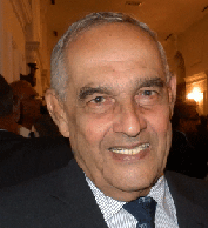
By Ryan Kern - Captain 2008
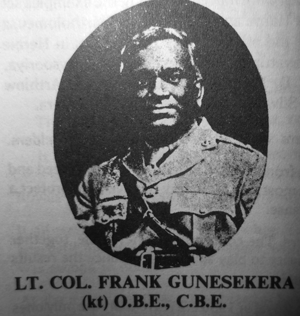 Both Royal and Wesley have rich traditions between them. The cricket match between the two schools started in 1892, but could not be considered as the inaugural match as two Royalists (C. Pate and Ekneligoda) fielded for Wesley. Masters also played, and the first match between the students of the two schools started in 1893.The centenary match between the two schools was held in 1993 which is the second oldest schools cricket match in Sri Lanka next to the Royal - Thomian.
Both Royal and Wesley have rich traditions between them. The cricket match between the two schools started in 1892, but could not be considered as the inaugural match as two Royalists (C. Pate and Ekneligoda) fielded for Wesley. Masters also played, and the first match between the students of the two schools started in 1893.The centenary match between the two schools was held in 1993 which is the second oldest schools cricket match in Sri Lanka next to the Royal - Thomian.
Both Sir Frank and Dr. Lucien had connections with both Royal and Wesley. Although both were educated at Royal, Sir Frank resided close to Wesley at the junction of Campbell Place and Baseline Road near the Welikade prisons. His two brothers Eric and Donald both studied at Wesley and played cricket for school in 1908 and 1910. The former ended up as Vice Principal and lived at Karlsruhe Gardens right in front of the Wesley Principal and Vice Principal's bungalow. Their sister Irene too lived here.
Sir Frank's portrait is hanging in the Royal College hall. He was a brilliant student who won the Thoburn prize for the best all-rounder in 1904. Chief Guest Sir Henry Blake predicted success in whatever career he chose.
Sir Frank entered Medical College and won the Jeejeebhoy Scholarship in 1905 and Diploma in 1910. He resigned from Government service and proceeded to England for higher studies at the London University in 1911 and returned in 1915 with British qualifications, and was held in high esteem in the medical profession.
A cadet in the Royal Cadet Battalion in 1903, Sir Frank was commissioned as a Lieutenant in the Ceylon Medical Corps of the army in 1916, promoted to Colonel and was its commanding officer till 1939. Sir Frank was awarded the Order of the British Empire (OBE) in 1935 by King George V and made a Commander of the British Empire (CBE) in 1947 by the British Monarch.
Sir Frank dabbled in politics too at the insistence of his good friend D.S. Senanayake the first Prime Minister of Independent Ceylon. Sir Frank was DS's personal physician too. He was Deputy President of the Senate in 1948.
Sir Frank's eldest son Dr. Noel was practicing medicine with his father at Borella together with Dr. Lucien who later opened dispensaries at Dematagoda and Nawala too. Dr. Noel was also the Commanding Officer
of the Ceylon Medical Corps (Volunteers) in the army and held the rank of Colonel. Dr. Lucien too was in the Ceylon Medical Corps (Volunteers), but later gave up at the insistence of his father.
Sir Frank was closely associated with social service and initiated the Trust Fund for a children's home for TB patients on the banks of the Bolgoda Lake, which was later handed over to the CNAPT.
Five generations of Gunesekera's have studied at Royal and Wesley College, including Eric, Donald, Elmer, Terrance, Lal, Chrysantha, Nalin, Rohith, Hiran, Sharmal, Sivaji, Shivantha, Rajiv, Tharindra and Anujith,
Sir Frank served on the Board of Governors of Royal College Hostel from 1939 to 1952 and passed away on January 23, 1952 whilst shaking hands with Lord Soulbury, the last British Governor General of Ceylon who was also Sir Frank' personal friend and physician too, at Queens House in Colombo Fort.
It was in 1969 that Dr. Lucien Gunesekera presented the Sir Frank Gunesekera Shield in memory of his father which Wesley became the first recipient in the famous last ball victory.
(The writer is the eldest grandson of Sir Frank and eldest son of Dr. Lucien. He is a senior journalist attached to The Island with 42 years in the profession).
Transcribed from the Book - Wesley's Cricket History - by Jeremy Brohier
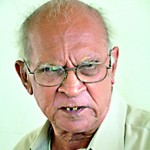 It came as a big surprise when Old Wesleyite Jeremy Brohier requested me to write an article about the above series of matches I remember. It is indeed an honour and privilege as I myself did not play cricket for school. The inaugural match between Wesley and St. Joseph's began in 1904. There was a short gap between 1906 to 1912 when matches were not played between the two schools and again from 1942 to 1943 owing to World War II.
It came as a big surprise when Old Wesleyite Jeremy Brohier requested me to write an article about the above series of matches I remember. It is indeed an honour and privilege as I myself did not play cricket for school. The inaugural match between Wesley and St. Joseph's began in 1904. There was a short gap between 1906 to 1912 when matches were not played between the two schools and again from 1942 to 1943 owing to World War II.
Wesley had produced some of the greatest cricketers of the 20th Century with the great C.E.Perera, Sammy Gunasekera. There were other great names like R.L. Kannangara, Harold Nonis, the Fuards, the batting artist M. Sathasivam, the Duckworths, Claessens, the Dissanayakes, the J ayasekeras, Nagendra, Ivan Walbeoff, Cassims, Musafers, Lucky Goonetilleke, the Hamer brothers, the Jeganathan twins, the Rajaratnams, Navin De Silva and more recent Farveez Maharoof. Wesley has produced champion teams like St. J osephs and even today is a cricketing school to reckon with.
The years I vividly remember are from 1945 to 1953 where cricketers namely Harold Matthysz a brilliant batsman cum wicket keeper, the Abeywardena's, Mack's', Clive Bartholomeusz a mountain of a man who could hit the ball many a mile and also Norman De La Harpe a fearsome fast bowler who later played for Colts C.C, were some of the outstanding cricketers produced by Wesley. Of the Josephian's were stalwarts like Neil Weerasinghe, Joe Perera, Hubert Bagot, Joe De Mel (now Rev. Father), Tommy Rodrigo, Billy Balthazar amidst others. During that time Wesley played most of their matches on a small ground in Mount Mary. Needless to say many runs were scored on this ground.
At Brooke Bonds where I worked we had three Wesleyites who played for the team with much success. They were Harold Juriansz, the late Hillary De Vos and Jayantha Wijemanne. Jayantha was an excellent opening batsman having scored many runs for Wesley. He also excelled in hockey.
Going back to 1952, two invincible sides from Wesley and St. Joseph's met each other at Darley Road in what could be described an epic encounter of champions. From memory, Wesley was captained by Radley Claessen which also included his brother Bryan who in my opinion was a class above all other schoolboys playing at that time. He was a brilliant batsman, an exceptionally good leg spin googly bowler and a superb gully fielder. The others in the side were bothers Ansar and Abu Fuard, A.R. Chapman, N. Gallagher, Pat Shockman, S. Musafer (wicket Keeper), Lou Adihetty, M. Samsudeen and R.M. De Silva. Incidentally both Bryan and Abu played for Ceylon. St. Joseph's was captained by Ken Serpanchy which consisted
players of the caliber of the two W's, Wanigaratne and Wimalaratne, Milroy and Ralph Brohier, Rienzie Perera, Chris Fernando amongst others. Wesley won this match comfortably.
The mid seventies saw many interesting encounters between Wesley and St. Joseph's. From those sides Wesley produced some fine cricketers namely, Dilrukshan De Alwis, Dilanjen Jayasekera, Shammy Rajendran, N.R. Gajendran, K. Dayaparan and Jeremy Brohier whose father and uncle both played for St. Joseph's. The Josephian side consisted of players namely Trevor Croner, the Wijeratne's, Lakshman Aloysius my son Rohan Wijesinghe and Wayne Jansz whose brother Dugallater played for Wesley in the 80's and was Vice Captain of the famous 1985 champion all Island schools team.
Needless to say, I have always look forward to witness cricket matches played between these two great Christain schools both at Darley road and Camp bell park while enjoying the company of many friends from Wesley. The bonds of friendship between the cricketers of the two schools and amongst old boys over the years have been so close that at times we felt that we were from one family even though on opposing sides. I will be failing if I do not mention that the Josephian cricket teams have always been treated well whenever they were hosted by Wesley.
This article is written for a souvenir that is to be released to coincide with a re-union of past cricketers to felicitate and recognize cricketers who played for Wesley 50 years ago. There is no doubt that many old boys from all over the world who will be coming for this re-union will re-live the camaraderie that existed over the years into the future.
Since this cricket book will be of historic value I would like to give you some interesting statistics of Wesleyites against St. J osephs.
WINNING CAPTAINS FOR WESLEY CENTURY MAKERS FOR WESLEY
WESLEY AGAINST ST. JOSEPHS
1936 Henry Duckworth 1921 P.H. Nonis 103
1939 Stanley J ayasekera 1938 C.P.W. Vangeyzel 104
1941 L.A.A. Albert 1940 S. Nagendra 133 not out
1949 W.P.S. Abeywardena 1945 T.I. Cassim 112
1952 Radley Claessen 1948 W.P.S. Abeywardena 109
1953 Bryan Claessen 1949 Lucky Abeywardena 100 not out
1960 S.R. Sinniah 1955 L. Adihetty 114
1962 L.C.R. Wijesinghe 1981 Navin De Silva 123
1964 E. Schoorman 1989 D .Dissanayake 105
1969 Amaresh Rajaratnam 1997 D. Jayakody 116
2001 F. Maharoof 144
BOWLING 7 WICKETS AND OVER
1905 Sam Gunasekera 7 for 26
1917 A. Roberts 7 for 52
1951 Bryan Claessen 8 for 68
1980 S. Amaratunga 7 for 47
1983 M. Dissanayake 7 for 44
Transcribed from the Book - Wesley's Cricket History - by Jeremy Brohier
 With so many articles written on the cricketing feats of Wesleyites and its team's performances, I thought that I would add a different flavour by penning some of my interesting experiences off the field as a cricketer who represented Wesley in the 1st XI from 1974 - 1977.
With so many articles written on the cricketing feats of Wesleyites and its team's performances, I thought that I would add a different flavour by penning some of my interesting experiences off the field as a cricketer who represented Wesley in the 1st XI from 1974 - 1977.
Coming from a background of Josephians, I consider myself privileged to have been educated at Wesley College after St. Joseph's rejected my admission. That rejection did cause a stir in the family and my father who was an out and out Josephian, and a cricketer who played in their 1st XI was disappointed and pretty annoyed over the decision.
Disappointed as he was, my father then applied to Wesley for my admission which was accepted with open hands. Since that day my parents especially my father was ever so grateful to Wesley and distanced himself from his own school which let him down where his children were concerned. He never attempted even at a later stage when my two brothers were of age to begin their schooling, try to admit them into his own school. He remained loyal to Wesley and continued to educate my two younger brothers, Miles and Perry at Wesley in gratitude for accepting my application. Off my two brothers, Perry went on to represent Wesley at 1st XI cricket and was the opening bowler in the 1985 champion outfit under Mylvaganam Ganesh. Miles was more studious and did not take to cricket.
Growing up within the portals of the great campus at Karlsruhe, I began to show an interest in playing cricket at a very young age as it probably flowed in the genes. I remember before I went for my first practice, my father advising me saying "Putha, learn to bowl right arm leg spin. It is an art of spin that very few attempt". And so, trudging my way to Campbell park rather nervously, I attended the first under 14 cricket practice session. I had apprehensions as any boy would probably have at an age of 10, wondering if I would gain selection especially when I saw over 50 boys attending the first practice session.
The under 14 cricket coach at that time was the Principal Mr. Shelton Wirasinha. I vividly remember him first training us in the pavilion on the different bat drills as the first step. The grip, stance, forward defence and back foot defence. Once we mastered those drills, he then moved on to the drives, both off and on, the drive of the back foot, the cut and the hook shot. Positioning of head, feet and balance were instilled into us. From that point he taught us the technique of fielding and catching. Interestingly when Mr. Wirasinha took fielding practice he would shout, offering senior players an incentive of his famous quote "Pineapple toffee" by sending a sky rocket, hitting the ball until it reaches the size of a ping pong ball expecting it to be caught. It was great fun and at times serious with a small knock on the head if the catch was missed. With these drills complete we were then taken to the centre mat for live practices after a session of physical training. Senior boys were given to bat first and the fresher's or new entrants were given opportunities to bowl at them.
Given my chance, my father's words rang in my ears. Taking his advice, I twirled my first ball as a right arm leg spinner. This was the beginning of my cricket career at Wes1ey and my very first ball did raise the eyebrow of Mr. Wirasinha. He straight away knew that he had a future leg spinner for Wes1ey and continued to encourage me with the art. From then on I played and captained the under 14 and under 16 sides of Wesley with success not having lost a game and continued as a 1st XI cricketer until I left school in 1977.
Having graduated into Wesley's 1st XI as an under sixteen player, purely for my leg spin bowling I began as a fresher and reserve in the 1974 first eleven under another classic right arm leg spinner Dayalan Sellamuttu. A very stylish left hand batsman, always nattily dressed in his cream flannels and at times eccentric, Daya1an was probably the best exponent of leg spin in the schools at that time. With him in the side, it was natural that I had to sit out most of the season except for maybe a match.
It was in 1974 that Wesley decided to accept a fixture against St. Johns Jaffna a team from the North for the first time in Wesley's cricketing history. I was fortunate to be in the squad to travel and what an exciting trip we had since most of us had never been there. I recall being driven in our Morris Minor car and being dropped off early morning at the Fort railway station by my parents to meet the rest of the cricketers and MIC to board the train leaving the Colombo railway station at 4.30 or Sam. The freshers on this trip were fairly naughty guys, Grero Van Dort (brother of another superb opening bowler for Wesley Wilhelm, Gihan Seneviratne better known as 'Hotta' (who was the son a famous cricket correspondent Christie Seneviratne and brother of Nihal both of whom opened bowling for Wesley during their time) and the writer. The train was fairly long and since the restaurant car was way back from our carriage the reserves slowly scooted to the restaurant car to enjoy the inhalation of some filtered Aces. The prank was never caught.
With the carriage almost to us and the train being fairly empty there was a sudden splurge of people that boarded the train from Vavuniya. We were bewildered and were wondering from where this crowd emerged and where they were travelling. At the Paranthan station when the crowd was disembarking we were in for a pleasant surprise. Beverly Nathanielsz my classmate and current leader of the band Midnight Mist based in Australia suddenly appeared from nowhere and boarded the train joining us to Jaffna.
He had read in the news paper about the match and had found out that we were on that particular train. It was great to have him throughout and in fact while on our way when we inquired from him as to where these people who disembarked in Paranthan went, we were told that they were employees of the Paranthan Chemical factory.
The welcome we got at the Jaffna station was unbelievable. There was a massieve crowd at the station to greet us. Interestingly after settling down at the dorm of St. John's most of the team mates went for a shower and not finding the soap lather on their bodies, were wondering if something was wrong never realizing that it was hard water. It was rather a funny episode. Later after dinner as usual the seniors began to induct the fresher's welcoming them into the team which was great fun. The next day was the match, the grounds was thronging with spectators in some sections, 4 to 5 rows deep. Colombo schools hardly had fixtures against Jaffna schools and it was a special occasion for them to witness a team play cricket there from Colombo.
The match was over early on the second day with Wesley winning. The team decided to go for a movie and if I may recall it was a Charles Bronson movie at the Rio Jaffna. Standing in the queue to purchase our tickets the manager of the theater sprang a surprise on us by allowing us free entrance to the ODC always having recognized us. Apparently he had come to witness the match. It was a lovely gesture that I will remember.
Given an additional day in Jaffna we decided to visit the famous natural pond in Keerama1ai. Boarding the bus at the central bus stand we encountered a problem to purchase the tickets as the conductor was not conversant in Sinha1a. Thanks to our burly offie N.R. Gajendran who was able to converse in the language the conductor understood, we were able to continue and visit Keerama1ai. On our way back we once again arrived at the Jaffna central bus station and visited a famous hotel by the name of Subash. That day Subash probably had the best sale of ice cream as we swept their stocks of ice cream that was branded Subahs' jolly ball.
Then in 1975 we visited Richmond in Galle. Dayaparan our captain and regular wicket keeper had sustained a head injury in the previous match and Dilu De A1wis was down to keep wickets. On the day we arrived at Richmond the team was at a loose end in the evening. While scouting around the premises a pathway to a thick jungle growth was discovered leading to a bath well in someone else's property. The boys decided to take a bath at this well. Nearby a kurumbas tree full of fruits was spotted, Ivor Mahroof who was better known as Farzan decided to climb the tree to break the fruits. Catching the kurumbas below so as not make a noise was Dilu. While most of the fruits were caught, one fruit was misjudged striking Dilu on the tip of his fore finger. Later on his finger began to swell and we then realised that it was dislocated. We were at a loss not knowing how he will manage to keep wickets. We could not mention it to the MIC as we were scared that some would be punished. On the day of the match we arrived at the Galle Esplanade for the match and were worried about Di1u's finger as it was fairly bad. Just arount 15 minutes to go for the toss the skipper of the side Dayaparan who was not in the squad to Galle suddenly appeared. He declared himself fit and bailed us out of the situation. Until I mentioned it to him recently he was unaware of the incident. Such was the secrecy.
Another interesting episode which took place was in the match against Zahira at Maradana. Opening the batting for Wes1ey was A.V. Pathiraja the Vice captain. Partnering him was either Shan J urangpathy or Dilanjen Jayasekera. A short single was attempted but the call 'No'; was a bit slow and Pathiraja went sliding on his back trying to turn back. The result was a run out. When Pathiraja walked back to the dressing room the coach Mr. Sathasivam wanted to inspect his boots. He was in for a surprise. There were hardly any hob nails on both boots. Mr. Sathasivam's face turned red. Pathiraja got a lambasting with a barrage of words in the choicest of English and was given an ultimatum to fix new hob nails before Wesley began fielding. The Maradana cobblers were hard at work being pressurized to ensure that the boots were ready before the last Wes1ey wicket fell. Eventually the job was done but as a result of this lapse the boots of the players were inspected prior to every game by Mr. Satahasivam.
In 1976 Wesley was captained by Dilu De Alwis a stocky and powerful batsman. Unfortunately I had contracted a severe attack of hepatitis and after suffering a relapse I had to avoid playing the entire season following doctor's instructions. Resuming in 1977 under Dilanjen Jayasekera we had another interesting season, The MIC of the side was an interesting gentleman by the name of Mr. Piyasena who had no clue about cricket. However he was very enthusiastic about performing his role. Dilu who scored a brilliant 190 against St. Peters, was once again in brilliant form against St. Thomas'. He scored a run a ball 120, and basically tore the Thomian attack apart at Mt. Lavinia. During his innings his bat cracked and was sent to the pavilion for a replacement. While we were examining his bat the MIC also examined it carefully and gave us his suggestion which basically made us howl in laughter, of course behind his back. Quoting his suggestion "cant you drive a few nails and mend the crack". It was really a brilliant bloomer.
Playing for Wesley and practising at Campbell park was always interesting. Surrounding the small grounds were huge sal and flamboyant trees. The ground stood between the main road leading to Punchi Borella from the prisons end on Baseline road and the gravel road in the park from the government printing press to All Saints church. Unlike today during our time and before, on the days Wesley plays its 1st XI matches, large crowds stand around the grounds to watch the action. Cheering squads from the younger brigade of Wesley were ever so present, loudly cheering their heroes with all their might. More interestingly and much to the delight of the cricketers, the girls of All Saints school were always distracted from their studies by the cricketers who walked to the pavilion from the school with their double blue blazers slung on their shoulders prior to the commencement of the match. There were many admirers from across the boundaries of All Saints, some waving and giving signals and some sending messages through sign language during warm up sessions. With no mobile phones or face book around at that time and the only source of obtaining a written message was the autographbook or a slip of paper slowly smuggled by a go-between. I can vouch that there would have been many of our names and signatures on those autograph books.
Wednesday was another special day for the Wesley cricketers during our time and probably before. The Novena at All Saints Church which takes place at 2.30 in the afternoon and 5.30 in the evening was a special attraction to us as sportsman. Wesley's cricketing talent was on show and was at its very best on the day, purely to attract the attention of the beautiful ladies who walked by the ground to attend the Novena. Fielding practice was held at around 2.00 in the afternoon which went on till about 2.30pm. Practices were purposely held by the roadside on Wednesdays. As the saying goes that catches win matches, all I can say is that the action was electric with even the most difficult of catches that would have been missed in a match were either held or attempted. The best of batting and bowling was left to be witnessed for the 5.30pm Novena crowd.
I was privileged to have played alongside some great and colourful team mates between 1974 - 1977. Dayalan Sellamutu,Russel Kern a brilliant off spinner, Lalith Fernando always nattily clad, K. Dayaparan a stylish batsman similar to Mark Waugh, Eric Solomons a pacie with a beautiful action, Mahes Samaraweera who had an action similar to a snake charmer, Dilu De Alwis a powerful batsman and excellent wicket keeper, Dilanjen Jayasekera a stodgy left hand bat and swing bowler, N.R. Gajendran the burly offie and a batsman when on song scores runs only in boundaries while his permanent fielding position was 1st slip, Shan Jurangpathy another dependable opener and off spinner, Kirk Solomons a superb attacking one down bat, Hubert Gunasekera, cavalier in approach, Nandalal Hemachandra an attacking opening bowler, former Sri Lanka Badminton Champion the Late Malik Jehan an exellent batsman and swing bowler, Sheraad Musthapha another stroke maker and fast medium bowler, Mahes Rajaratnam a fast bowler who had a good sense of humour, Grero VanDort a right arm swing bowler who hardly lost his cool, Shammy Rajendra a brilliant left hand batsman who scored
a fabulous double century against Issipatana and excellent left arm spinner, Jehan Samarasinghe a stylish right hand batsman and right arm medium paced bowler, Farzan Mahroof better known as Ivor, a brilliant cover fielder and right hand batsman, Wilhelm Dias a stylish opening bat and slip fielder, Jeremy Claessen a right arm speedster who could bowl at an alarming speed and an excellent bat, J eremy's brother Robin a lion hearted left hand batsman, Jehan Jameel an enterprising batsman himself, Evan Johnson a good bat but was famous to pitch his bouncers close to his toes and Dilshad Ahamed a right arm fast bowler.
Coaching the teams during my era were great sons of Wesley. In 1974 it was L.C.R. Wijesinghe who also was master in charge, in 1975 it was the great Mr. Sathasivam, 1976 and 1977 arguably Wesley's greatest wicket keeper, Russel Hamer. Supporting them as masters in charge were teachers namely, Mr. Ratnayake and Mr. Piyasena. One cannot forget Mr. Edmund Dissanayake the POG who played such a pivotal role in the affairs of cricket at Wesley. In lighter vein, I must confess that every master in charge had a nick name ranging from planets to animals and birds.
Well, these are some of the interesting stories that I experienced off the cricket ground as a 1st XI cricketer at Wesley, memories of which I still treasure and continue to talk about when some of our team mates meet. Those were the great day's when cricket was played with a passion even though Si Lanka did not enjoy Test status. Masters, coaches and cricketers all enjoyed themselves together as a single unit bound by the band of double blue.
Before I forget I must state that during my time as a 1st XI cricketer and before, the pavilion was out of bounds for students. The chairs were neatly arranged for visitors who came to witness the matches. To enter the pavilion a ticket of Rs1.00 was sold at the entrance by the prefects. The pavilion was always full and at tea time all visitors were served with a piece of cake and a cup of tea free of charge.
The discipline instilled into us can be certainly attributed to the education we received at this great Christian institution. Every team that represented Wesley in 1st XI cricket had its own uniqueness. What is important is that each of those teams played together as one single unit to bring glory to their alma mater by continuing its traditions.
Long Live Wesley. May she move from strength to strength and once again dominate cricket amongst the schools in Sri Lanka.
Transcribed from the Book - Wesley's Cricket History - by Jeremy Brohier
H. Aponso of Prince of Wales College - Cricket Captain 1962
 Wesley and Prince of Wales' Colleges were founded two years apart. Wesley in 1874 by Rev. Daniel Henry Pereira and Prince of Wales' (PWC or Cambrians) in 1876 by Charles Henry De Soysa, the greatest philanthropist Sri Lanka has ever known. The vision of the revered founders were more than fulfilled when, from among the thousands of boys who passed through the hallowed portals of these two educational institutions, emerged eminent men of tenacious fibre, who shone in all forms of human endeavour like the brightest of stars in the firmament.
Wesley and Prince of Wales' Colleges were founded two years apart. Wesley in 1874 by Rev. Daniel Henry Pereira and Prince of Wales' (PWC or Cambrians) in 1876 by Charles Henry De Soysa, the greatest philanthropist Sri Lanka has ever known. The vision of the revered founders were more than fulfilled when, from among the thousands of boys who passed through the hallowed portals of these two educational institutions, emerged eminent men of tenacious fibre, who shone in all forms of human endeavour like the brightest of stars in the firmament.
Those who were assigned the task of shaping the destinies of the two schools, at the beginning were famed educationists who firmly believed in the old adage. "Mens Sana Corpore Sano", encouraged their charges to take to sports, in addition to their curricular activities. Cricket had taken firm root here at that time and it was small wonder, the two schools started playing the game since the inception, but on an organised scale from 1892
and 1896. The first match in the series between Wesley and PWC was played in 1897 with R.F. Honter andJohn G. Fernando tossing the coin as captains. Inspite of Wesley fielding a formidable side Cambrians emerged victorious by innings and seven runs. Brief scores: Wesley 83 and 32 - C. E. Perera 22, M. L. Warish 18, PWC - 132 - J.C. McHeyzer 87. However Wesley avenged this defeat in 1900 by overcoming PWC by 11 runs.
In 1908 D .H.L. De Silva of PW C had the honour of scoring the first century of the series when he made 101 not out in a total of 161. He also had the distinction of bagging 5 wickets in an innings for the first time the previous year. Unfortunately young D.H. L. was on the losing side on both occasions when Wesley beat PWC handsomely. Writing about the 1908 game later among other things D.H.L. said "I remember OEG, the smart young man, who was destined to be our first Ceylonese Governor General who was the Hony Secretary of the Wesley College C. C. and also the scorer in the above match".
D.H.L., of course was referring to Sir Oliver Goonatilaka, the eminent Wesleyite, who reached the zenith in the public life of our country.
The first century for Wesley in the series came off the bat of Navin De Silva, when he scored 107 in 1981. He also came up with a fine knock of 98 not out the previous year. In a recent conversation he confided in me that once playing on PWC grounds he square cut a ball which sailed over the boundary wall, the two-carriage way Galle road and crashed in to a shop. Navin was a dashing batsman, with strokes all round the wicket and astute leadership qualities for which he was rewarded by being selected to lead the U19 team to England in 1981, which included some cricketers who played for Sri Lanka later including Arjuna Ranatunga and Aravinda De Silva. If not for his boyhood ambition to become an Airline Pilot, which he achieved, Navin would have been a certainty for national honours and most probably may have enjoyed celebrity status, in the international cricket scene. Navin now plays a game of golf for relaxation, sometimes with a Cambrian Sirath Kasturiratne who did well in cricket matches with Wesley twenty years before Navin.
The first player to take five wickets in an innings for Wesley, was Bryan Claessen in 1951. Claessen had the figures of 6 for 20 and 5 for 24 and also scored a scintillating 74 runs. This is the best all round feat by any player in the series. As a schoolboy he represented Ceylon in 1952 against an Australian team led by Lindsay Hassett that was in Colombo for a short whistle-stop tour. Ceylon lost a good long term cricketing prospect when the Claessen family decided to migrate to Australia in the mid-fifties.
Others who did well for PWC in the early days were W.O. "Waddy" De Silva, Senaratne Brothers, G.A.F, O.T.F, O.L.F and H.H.F. Incidentally O.T.F was the first Cambrian to represent the country against India in 1927. For Wesley C.E Perera, W.D. Abraham, S.P. Foenander, the doyen of cricket journalists in his day, A.M Fuard were outstanding players in the series. In the 40s and thereafter PWC had in their ranks some exciting players in Peiris brothers Terrence, Lloyd and Cecil who scored twin centuries against Kingswood and followed up with two more centuries in his next two visits to the crease. H. 1. Fernando who played for Ceylon on several occasions and Nisal Senaratne, son of H.H.F, Cricket Board Player and Hony Secretary of the then BCCSL who managed several Sri Lanka teams on overseas tours, Stanley De Alwis and Lasantha Rodrigo, both national players, Jagath De Soysa & Herbert Fonseka. Wes1ey also had some great players in the calibre of H.L Mathysz, Mahadevan Sathasivarn of whom I believe much will be written elsewhere in this magazine, Norman De La Harpe, V.R Dias, L. Abeywardena, P.W.S Abeyrathne, M. Samsudeen, Lou Adhihetty, the inimitable M.A.H "Abu" Fuard, who took a match bag of 9 for 34 in the 1954 encounter. Abu was later an automatic choice for the Ceylon Team and a no-nonsense administrator with BCCSL in various capacities. Abu's foresight in harnessing the talent in lesser known schools outside of Colombo has paid rich dividends as Sri Lanka Cricket Teams are now mainly comprised of cricketers from such schools, S.R. Sinniah, Upali Samararatne, D. Kodituwakku, N. Abeysuriya and L.R. Goonatilleke. Goonatilleke also played for Ceylon at a very young age and chose a career in planting and never could get back his old rhythm which made him a devastating left arm fast medium bowler. "Lucky" as he is popularly known, as the President of the O.W.S.C. with a band of enthusiastic old Wesleyites worked tirelessly to raise the standard of the club and it is now ranked second to none in old boy's club circles.
The first cricket match between Wesley and Prince of Wales' that I witnessed was way back in 1956 when Stanley De Alwis captained PWC. PWC scoring 259 and 58 for 3 beat Wesley 157 and 160. J agath De Soysa came out with a fine all round performance scoring 92 runs and bagging 5 for 36. The following year Wesley came back strongly to beat PWC by 40 runs with R.M. De Silva doing the damage with 6 for 24. In 1960 under the captaincy of W.G. Fernando also PWC overcame Wesley by 4 wickets at Moratuwa.
In 1962 I had the privilege of captaining a strong Cambrian side which included Ryle De Mel, Merl Mendis, Thilak Munasinghe, Sarath De Silva, Raja Peiris (all deceased) and D. S. De Silva, test player and also the Chairman Interim Committee of the SLC. Wesley had an equally strong side led by L.C.R. Wijesinghe and including Darrel Maye, Milroy Muthuvaloe, Keneth De Silva, Sarath Wickramaratne, Everaad Schoorman, late Mervyn Hamer and Batcha Fuard among others. We started the season against STC Mount Lavinia where we had the better of the exchanges in a tall scoring game. We beat Darell Lieversz' Royal side by innings the following weekend and were brimming with confidence when we had to face Wesley a week later, but was cautioned against complacency by our coach Nisal Senaratne as Wesley also had a strong side with L.C.R. capable of running through any side in no time with his right arm fast medium stuff. Playing a very cautious game we managed to beat Wesley by 7 wickets. The most notable performance in this match was by Sarath De Silva who took 7 for 15. Batcha Fuard made a valiant 37 runs for Wesley.
Thereafter both schools produced some excellent cricketers but due to space constraints it is not possible to give details here in full. But one cannot forget Wirantha Fernando who made twin centuries in the match with Wesley in 1975. At an early age Wirantha showed much promise of developing into a classy batsman. He fulfilled the expectations of many by being one of the best school boy batsmen of the era scoring heavily for PWC and later for Moratuwa SC and Colts CC. But due to his love of politics he was unable to devote more time to improve his game and reach the top. In his first outing at the hustings he was elected as the Deputy Mayor for Moratuwa MC. Next time he won the WPC elections and was appointed a Minister. A Parliamentary seat was in the offing when the cruel hand of fate struck and he met with an untimely demise. J eremy Brohier, immediate Past President of the OWSC played in this match with limited success bowling his leggies
Wesley - Prince of Wales' matches played in Moratuwa attracted vast crowds in those days mainly from the Anglican and Methodist communities and also the cricket loving public of Moratuwa. Gentleman and ladies accompanied their children to witness these games. A special attraction was the lovely little lasses from the Methodist College and our own Princess. Men huddled together talking of their days in the middle with exaggerated versions of their feats with willow or cherry. But the ladies had the arduous task of keeping their female brood from the unceasing gaze of the star struck young hopefuls.
It is the fervent wish of all the old Wesleyites and the old Cambrians that the cricketing connections which have lasted more than a century will grow from strength to strength in the years ahead.
by Jeremy Brohier
Transcribed from the Book - Wesley's Cricket History - by Jeremy Brohier
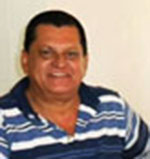 There is a saying that fast bowlers hunt in pairs. How true this saying is when one compares the different pairs of fast bowlers that have represented Wesley at 1st XI cricket in its cricketing history. Standing out from the many were three pairs that come to my mind who represented Wesley in the late 60's and early 70's. In 1969 it was Amaresh Rajaratnam and Tyronne Jansz a deadly left arm - right arm combination. In 1972 it was Tyronne Jansz and Wilhelm Van Dort both lethal from either end and in 1973 it was Wilhelm Van Dort and Athula Wickramasinghe. From the three pairs, the most dangerous and finest pair of fast bowlers I consider to represent Wesley in contemporary cricket was Wilhelm VanDort and Tyronne Jansz. While Tyronne was a tear away speedster who had batsman, ducking and running away from him, Wilhelm was the prince of swing making batsman grope
There is a saying that fast bowlers hunt in pairs. How true this saying is when one compares the different pairs of fast bowlers that have represented Wesley at 1st XI cricket in its cricketing history. Standing out from the many were three pairs that come to my mind who represented Wesley in the late 60's and early 70's. In 1969 it was Amaresh Rajaratnam and Tyronne Jansz a deadly left arm - right arm combination. In 1972 it was Tyronne Jansz and Wilhelm Van Dort both lethal from either end and in 1973 it was Wilhelm Van Dort and Athula Wickramasinghe. From the three pairs, the most dangerous and finest pair of fast bowlers I consider to represent Wesley in contemporary cricket was Wilhelm VanDort and Tyronne Jansz. While Tyronne was a tear away speedster who had batsman, ducking and running away from him, Wilhelm was the prince of swing making batsman grope
and miss to his late swing. Combining beautifully, they complemented each other striking at will from opposite ends.
A fabulous exponent of both the in and out swing with the new ball, his ability to bowl both off and leg cutters when the ball became old was an advantage. Wilhelm had many top class batsman at sea. Playing against St. Peters in 1973 he created a record by capturing 8 for 60 which was subsequently broken by Mahendra Dissanayake in 1985. His best season was in 1973 when he took 60 wickets in eight matches second to the late Ranil Abeynaiake who had taken 73 scalps. Wesley had only eight permanent fixtures in the first term of its cricketing calendar. This was a great achievement when one takes into consideration the current era when
twenty matches are played in the first term. Wilhelm's performances could not be ignored and was an automatic choice to be selected to represent the Colombo North schools in the Zonal tournament. In the same year Wilhelm was selected as best all-rounder for Wesley. Representing Wesley at rugby and athletics Wilhelm went on to win colour's in cricket at the age of sixteen and later in athletics.
As a schoolboy Wilhelm represented the BRC (Burgher Recreation Club) in Sara trophy cricket which was the premier division. On debut he created a sensation by capturing 5 wickets in 5 balls including a hat trick against Moors Sports Club. If not for a catch being dropped at short leg by Jayantha Amarasinghe who later represented Sri Lanka, Wilhelm would have created a world record, taking 6 wickets in 6 balls. Playing for Moors who had a strong team were, Shabir Asgerally a former Sri Lanka player, Ghulam Razik who also played for Sri Lanka, M.S. Sharwadie and G. Ambepitiya. His performances in Sara trophy cricket never went unnoticed and the national selectors at that time drafted him for trials to select the National squad to represent Sri Lanka against Pakistan played for the Ali Bhutto trophy.
Brilliant as he was as a cricketer, Wilhelm was also a good singer. Having a superb voice he was a member of the famous Wesley choir under Mr. Haig Karunaratne. Recalling the many solo's performed by him at numerous Carol services of Wesley, he left his best for the famous Christmas opera which was directed by Wesley's great choir master, Mr. Haig Karunaratne. Wilhelm's cricketing career could not proceed much further since he decided to take up to a vocation in the tourism industry that consumed a major part of his time. Today Wilhelm is one of the most renowned French tour promoters and is in demand by the industry in Sri Lanka.
A very colourful personality and good humored, Wilhelm is married to Priyanthi an accomplished music Directress in the country. They have a beautiful daughter Mariella who is equally talented possessing a lovely voice. Wilhelm the Prince of swing was one of Wesley's greatest fast bowlers in the 70's.
Transcribed from the Book - Wesley's Cricket History - by Jeremy Brohier
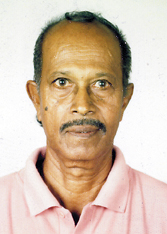 The swift do not have the race, nor the mighty ones the battle ... because time and unforeseen circumstances befall them all." These words from the Bible came to be in the life of Herbert Clement Felsinger upon whom calamitous times fell suddenly when he suffered a Cerebro Vascular accident (stroke) at the height of his career as an International cricket umpire in 1991.
The swift do not have the race, nor the mighty ones the battle ... because time and unforeseen circumstances befall them all." These words from the Bible came to be in the life of Herbert Clement Felsinger upon whom calamitous times fell suddenly when he suffered a Cerebro Vascular accident (stroke) at the height of his career as an International cricket umpire in 1991.
Felsinger was an excellent all-rounder who played 1st XI cricket for Wesley College in 1949 and 1950. He joined The Mercantile Bank in 1951 and continued to play cricket for The Moors Sports Club, Saracens Sports Club and The Burgher Recreation Club in the P. Saravanamuttu Trophy Tournament. He played for the Mercantile Bank for over two decades.
In October 1952, Felsinger opened batting, with Makin Salih, for The Moors Sports Club and they established a record opening partnership of
351 runs against Notts Sports Club. At the fall of the first wicket Makin Salih was out for 237 and Felsinger was on 114 not out.
Felsinger took to umpiring and in a short time earned a strong reputation as an outstanding umpire. He said, "I was appointed an International umpire and had the privilege, together with KT Francis, of umpiring the 1st Test between England and Sri Lanka in February 1982. I also officiated at numerous Test and One-day-Internationals. In addition Errol Seneviratne and I had the opportunity to umpire in 1st class matches in England from April to August 1985."
In September 1991 Felsinger was nominated to umpire in an International tournament in Sharjah and was also listed to officiate at the World Cup in
Australia in 1992. His son, Hillary, was to migrate to Australia at the end of the month and they called over at Honkong Bank, Fort office, to purchase traveller's cheques. While speaking to a bank official Felsinger's voice started to fail and he began to stutter. Knowing something was seriously wrong his son took him immediately to hospital and Felsinger suffered from a stroke that left him paralyzed on the right side of his body.
Going back to the agonizing events of 1991 Felsinger said, "I thought I would die. It was a horrible feeling like being thrown into a deep well. I knew I had to claw my way out of this. I was bedridden and the doctors said recovery would be very slow. One step at a time was all I asked for. Though it took years of torment, now I can walk to the top of my lane and back with a walking stick.
However painful it is, I will continue to fight back and improve on this.
"Sadly all my savings were exhausted. This was a very testing period for me and my family. The only consolation I have is that my wife and family stood by me through this trauma for the past 15 years. I will be grateful to them forever."
When 'The Nation' visited Felsinger he had neatly laid out on his dining table the mementoes he had carefully preserved over the years. He had tears in his eyes when he picked up his International umpire's badge and said, "Among my souvenirs I cherish this badge the most. Unfortunately it was not to be. At the end of the day all I am left with are these souvenirs which remind me of happy times. Yet I have one dream, which I hope comes true before my innings in life closes, and that is to be able to take even a few steps and bowl one more over."
Herbie unique among cricket umpires by S Thawfeeq
Herbie Felsinger was a legend among local cricket umpires. Umpires of his genre are few and far between today in an ever changing world.
I feel we did a better job than the present umpires because when they have a doubt they always go to third umpire. In our time if we gave out that s it, the batsman went. If the ball pitches within the sticks and if it doesn t vary much and the batsman misses, it s out, said Felsinger. The standard of Sri Lankan umpires in Felsinger s opinion is below standard . Sri Lanka umpiring standards have gone down from what it was during our time. The reason is more money. Umpires are always thinking of money not the game. They are keener to finish the match early and get the money.
Another area which Felsinger felt the local umpires were lacking is the back foot no-ball. Our umpires don t look at the back foot because most bowlers cut the line with the back foot and they are not no-balled. The greatest offender is Sanath Jayasuriya. If the back foot cuts the side line it is a no-ball. The umpires only look at the front foot for a no-ball and not the back foot. We were taught to look for this. On television when the ball is bowled the camera focuses on the batsman and not on the bowler so no one ever sees it. Only if a bowler is no-balled it is shown in slow motion where the front foot landed.
Felsinger was an umpire for two decades since 1971 until a stroke in 1991 left him partly paralysed and ended his career. I spent one month at Asiri Hospital. They said there is a clot in my brain and I couldn t be operated and that I would end up a vegetable. It took me about four years to recover from that illness. I couldn t talk for one year but my wife (Mignnone) understood me, Felsinger recalled. Even today Felsinger still bears the scars of that stroke because he walks assisted by a walking stick and with a slight limp on his right leg.
Felsinger officiated in six Tests and 11 One-Day International matches between 1982 and 1986. Along with another umpiring icon KT Francis, Felsinger officiated in Sri Lanka s inaugural Test match against England at the P Sara Oval in February 1982. At the time they were paid Rs. 750 a day for a five-day Test and Rs. 5000 for an ODI.
I didn t feel any pressure at all although it was our first Test match. For me it was just like a normal game, said Felsinger. I no-balled Ian Botham from my end first and second ball. After the captain spoke to him he bowled a legal ball and he asked me is that okay . I said it was. You must speak to the players not stay glum. On the fourth day we were looking very good to win the Test but the batsmen ate it up.
He also had the honour of officiating in the Centenary match between two traditional schools Royal and S Thomas in 1979 at the P Sara Oval.
Another incident which Felsinger remembers is helping Sri Lanka middle order batsman Ranjan Madugalle to score his solitary Test century against India at the SSC grounds in 1985.
I was umpiring at square leg when the Indian fielders appealed for a run out against Madugalle, but I had to say not out because one of the leg side fielders stood in front of me covering my vision. I couldn t see anything. Madugalle was on 40 odd at that time and he went on to make a Test hundred only because I was unsighted. After the match Gamini Dissanayake, the Sri Lanka Cricket Board president came to me and said good decision , said Felsinger.
On another occasion, officiating in a Pakistan v India ODI match at Sharjah with legendary English umpire Dickie Bird, Felsinger felt the Englishman imposed his authority on him as he was the senior umpire and was deciding on how the match should be conducted. But Felsinger who took everything in his stride and had the last laugh when Bird miscounted and allowed a seventh ball to be bowled in an over off which Imran Khan, the Pakistan captain scored two runs. When the scorers were at a loss how to credit the seventh ball in their books, Felsinger stepped in and told them to take the two runs off the book and the game continued. At the awards ceremony Dickie admitted that I was a very good umpire and he told me if I came to England he would help me anytime. When I went there a few years later I rang him up, he came and met me.
Felsinger s view is that the advent of technology forced a lot of good umpires to retire from the game. Dickie Bird was one of them and later another top notch English umpire David Shepherd. They were good umpires and when they made a mistake they admitted it. Umpires should be very bold in giving decisions. Technology has taken away the pleasure of umpiring.
I read the laws of cricket before every match and it is fresh in my mind. What makes a good umpire First of all you must tell a prayer and walk out. You must give any decision, whether right or wrong, straight from the heart whoever the players is.
What made Felsinger earn a reputation of one of the finest umpires to don the white coat was his experience as a cricketer. As a player I know I am out if the ball is pitched within the wickets and the ball hits me below the knee roll and I miss it. As an umpire the same principles apply. Playing the game makes it easier to umpire, especially if you are a good player. To be a good umpire you must play the game first and be well read and educated.
Felsinger s cricket career at school and at club was a real mixed bag. He was never allowed to settle down in one place. I went to Wesley College and studied up to the third standard when my father took me out and put me to Carey College. There, playing for the first eleven at the age of 14, I scored 202 (n.o.) opening the batting against St John s, Nugegoda. That score is still a record today. I broke the previous record of 173. After two years I was back again at Wesley where I played as an opening bowler and opening bat. I never got to bowl after the seventh wicket went down because they preserved me for my batting, but in one match I managed to take five wickets.
Felsinger s club history was almost on similar lines. He joined Moors SC as the first non-Muslim when Procter MAH Fuard (father of Sri Lanka off-spinner Abu Fuard) was president of the club and in his first season (1952-53) etched his name in the record books by putting together an unbroken opening partnership of 351 runs with Makkin Salih. While Salih went onto make a double century (237 n.o.), Felsinger s contribution was 118 not out.
In my first match I scored 70 runs and in my second, we got this record partnership against Notts CC at the Moors SC grounds. I was adamant not to get out. I always pushed the single and gave Makkin the strike. Makkin was in good form and he hammered the ball all over and scored faster than me. He came and told me Herbie I am only scoring why not you Then I started hitting out and soon after I got to my hundred, I gave him most of the strike and we carried on till we had put on a record 351 runs for the first wicket, Felsinger recalled.
Makkin and I used to put on 100 runs for the first wicket at any time. The Moors batting strength was in the first three batsmen Makkin, myself and MA Cafoor and then came Cabraal thereafter followed all the hard hitting batsmen. If the top order scored 200 runs Moors would still be all out for 225, he said. That year Felsinger and Salih were picked to represent Ceylon CA in the inaugural Gopalan trophy match against Madras (now Chennai) in India.
The division I first wicket record stood for nearly 30 years before it was broken by Tamil Union opening pair of Athula Samarasekera (192) and Wayne Jansz (115) who put on 352 runs against Police SC in 1981-82.
From Moors SC, Felsinger joined NCC and then after a few seasons there he crossed over to Saracens where he opened with another famed Sri Lanka opening batsman Abdul CM Lafir. Felsinger eventually ended up playing Sara trophy cricket for BRC where he met Major-General BR Heyn, a stalwart of the club who was to change his career from cricketer to umpire.
Major BR Heyn who was administrator at the Cricket Board one day told me that I would become a very good umpire because I was cool and had a good temperament. He said everything in me was correct and that he had been watching me play cricket for one year. He told me you can play in the second division and umpire in the first division, said Felsinger.
My first match was between NCC and SSC. There was a catch attempted by the elder Ranatunga (Dammika) who scooped and caught the ball, but at once my heart said no. They appealed and I said not out . At the end of the over the fielders were crossing over and I overheard them say that was a good decision, man . At the end of three days, I got a good report and Major Heyn told me to come for all the matches and that my playing days were over.
He was the one who kept me going for a long time as umpire. After every match he would come to me and say well done and he would also ask for the umpires report and if he found that I had erred somewhere he would say don t do that . Whenever I couldn t obtain leave he would give me a letter to release me from work.
I enjoyed my career as an umpire although I experienced some difficulties with some of my partners. They were an unscrupulous lot and never wanted to co-ordinate when umpiring. Only a handful of umpires I liked to umpire with like Errol Seneviratne, MO Guneratne, Dooland Buultjens, a lawyer chap called Dissanayake and Elmo Gunasekera. These guys I appreciate, Felsinger said.
Although Felsinger admitted he enjoyed umpiring his heart was more on playing cricket. I enjoyed playing cricket than umpiring because playing cricket was my first love. I dream of playing my shots and I give due credit for it to Capt FT Badcock, the former New Zealand captain who came on a coaching assignment to Sri Lanka in 1946. He taught me how to hook and the cut shot. Those were my main strokes where I got a lot of my runs from.
Felsinger worked in the banking sector having joined Mercantile Bank (later known as Hatton National Bank) straight from school as a clerk and retiring after 20 years as manager of Outer Bills department. He played and captained the bank in the inter-bank tournament where their main rivals were Hong Kong Bank.
What makes a good umpire: I will first watch his attire, secondly, he must walk to the grounds very boldly and look around and thirdly, the way he makes his decisions. If he takes a long time to make a decision it s all wrong. His heart must instantaneously say whether the batsman is out or not out once the appeal goes up. A maximum two seconds and then the decision should be given. Some of them don t adhere to all this, said Felsinger who resides at Mirihana and will celebrate his 80th birthday on June 4th.
How zat ! - Herbert (Herbie) Clement Felsinger By Pelham Juriansz
Sunday Leader June 19 2005
A double century in school cricket at the age of 14 and a partnership of 351 for the first wicket with Makin Salih for Moors was the highlight of his career.
He played for 3 clubs BRC, Moors and Saracens the longest being for 11 years. But he is best remembered as being an umpire of repute and one of the longstanding and outstanding umpires of yore.
An umpire, especially today, comes under a lot of fire. More so because of the television replays and the use of technology! The armchair critic is ever ready to criticise the umpire and even the commentators take the "man in white" to task. He has to count the balls and have literally about ten eyes to watch what is going on. Sometimes he may fall asleep and wake up o the sound of a ferocious "Howzat" blasting his ear drums. He then considers the volume of the sound. Better to give the batsman out as then he leaves the crease than to face the wrath of eleven men crying for his blood. And especially if one has a bowler of the ferocity of Dennis Lillee appealing one is tempted to raise the finger.
Well, enough of meandering.
We are talking of Herbert (Herbie) Clemen Felsinger. He scored a rare double century (202 not out) in January 1948 when playing for Carey College against St.John's Nugegoda at the Wesley College grounds.
In 1952/53 he was selected to play for Ceylon vs India under the late F.C. de Saram. In 1979 he umpired the 100th Royal-Thomian match at the SSC and in 1982 he stood once again with K.T Francis for the first Test match against England at the Oval.
Having umpired in England in 1985 he expanded his horizons.
One of his unforgettable experiences is having umpired with the legendary Dickie Bird in Sharjah. He even has a stump autographed by the great man.
He was selected to umpire the first World Cup to be held in Australia.
He was one of the 16 local umpires felicitated by the Association of Cricket Umpires and Scorers at the P.Sara Stadium in January 2003. He was awarded a medal of excellence and a certificate of merit by Chandra Schaffter, MD of Janashakthi Group.
Some of the outstanding players whom he watched as an umpire were Sunil Wettimuny, Roy Dias, Ranjan Madugalle,
Describing the First Test match vs England Felsinger said that Sri Lanka had a good side, with the Wettimuny's , Madugalle, Dias, Arjuna Ranatunga and bowlers like John and Ashantha de Mel. Sri Lanka was in a winning way at one stage. I thought that Sri Lanka could save the match but they failed," said a disappointed Felsinger.
For 20 years as an umpire from 1971-1991, till a stroke overtook him, he was yet another umpire struck down by tragedy, the other being Ajith Perera.
As for the pre Test era, he mentioned that Sri Lanka had a good side. "Umpiring today is easy. All you do is that you watch the ball when it is in the air and see whether it is going to strike the stumps or not. If in doubt you can refer to the third umpire."
Celebrating his 75th birthday on June 4 and also coincidentally his 50th Wedding Anniversary on the smae date, Felsinger said that the umpires of his era were better.
Talking of good bowlers during his umpiring era he mentioned Ajith de Silva and Ravi Ratnayake, not Rumesh. "He could swing the ball a lot." He added. He also described Sunil Wettimuny as a class bat. "There is too much of money in the game now" he lamented.
As for recent umpires he singled out S. Venkataragan and Asoka de Silva. Venkat played against me when I represented Ceylon. Steve Bucknor takes too much time to give a decision" he said.
"The standards of umpiring have deteriorated. The standards were of a high calibre at one time. He particularly referred to the late M.A.Jayasinghe as being an outstanding umpire. Others he mentioned were K.T. Francis and Basil Anthony.
As for cricketing standards he said that that too had deteriorated because of the lure of money.
Wicket keepers of note were Ben Navaratne and the two Fernando's Ranjit and H.I.K. Fernando. Special mention was made of Mahes Goonetilleke and Russell Hamer.
In later years "Little Kalu" was good but the selectors have opted for Kumar Sangakkara, whom he doesn't consider the best.
Recently Stanley Jayasinghe in an article that Felsinger was omitted from a list of umpires given recognition by Thilanga Sumithapala. Umpires are remembered after they are dead and not always thanked for the thankless job they do out there.
Transcribed from the Book - Wesley's Cricket History - by Jeremy Brohier
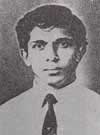 "Cricket lovely cricket at Wesley" I attribute my liking for this game to my genetic component passed down by my father who was the Cricket Coach for Richmond College, and to my "Alma Mater" who nurtured what was inherent in me.
"Cricket lovely cricket at Wesley" I attribute my liking for this game to my genetic component passed down by my father who was the Cricket Coach for Richmond College, and to my "Alma Mater" who nurtured what was inherent in me.
I was first initiated to this game in the 1970's when as a little five year old boy I was compelled to watch my elder brother Ajith play for Wesley at Campbell Park. Amaresh Rajaratnam was the Captain, and there I was a starry eyed kid who couldn't quite understand the intricacies of cricket, but utterly engrossed in what was going on in the field. From then on, I would have watched almost every game played at the College grounds. In fact, I grew up idolizing my cricketing heroes of W esley. To name a few:
Amaresh, Delmar Achilles, Sridharan & Hariharan Jeganathan, Tyronne Jansz, Oscar Dissanayke, Dilrukshan De Alwis, Shammy Rajendra and Dilanjan Jayasekara. Therefore, from this background I easily slipped into the stream of cricket in my school career at Wesley. We had as our Principal Mr. Shelton Wirasinha who a cricketer himself, understood the importance of this sport. He encouraged and supported us at all times, and was a
gentleman of the highest calibre. Unlike today we didn't have any special coaches. Mr Nimal De Silva was the Master in charge of junior cricket. He was our coach, disciplinarian and guide all rolled into one. We had complete faith in him.
In 1975, junior cricket came into prominence with the organisation of tournaments for under 12. Wesley reached the quarter finals in this tournament, but unfortunately lost to St. Anthony's Kandy. The junior team at that time was captained by Asgar Hamidon with Gerard Fernando as his Vice Captain.
1976 was a memorable year for me as I captained the under 12 team with Sanjeev Ganarajah as my deputy. We became the all island "B" division Champions beating Issipathana under the leadership of Asanka Gurusingha. In that game, I grabbed a match bag of 7 wickets. In the group stage we beat Ananda who went on to reach the finals in Division 1 and I scored 113 in that game. The most outstanding bowler was nine year old Mahendra Dissanayake who burst into the limelight in this year. He was well supported
by Felix Wijesinghe and Kaleel Cassim. Ganarajah brothers (Sanjeev and Sashi), Nalendra Amarasinghe and the late Fassy Doray being the other consistent performers.
Our next best achievement was winning the under 15 Division II Championship under the captaincy of Asgar Hamidon beating Kingswood, Kandy. In the finals Gerard Fernando scored a match winning 50 to get us out of trouble well supported by the tail. Mahendra Dissanayake was once again outstanding taking 5 wickets. In the semi finals Sri Kanagasabapathy scored a swashbuckling century against St Thomas's Prep. Hamidon, Sanjeev Ganarajah, Asela Suriyakumar, Felix Wijesinghe, Kaleel Cassim, Sri and Prakash Selvarajah made useful contributions throughout the season.
We as junior cricketers were very fortunate to have a great support group in our parents. I will never forget the tasty food, drinks and transport that were provided by Mr. Ganarajah, Mr Dissanayake and Mr.Suriyakumar. Felix's parents and Mr Godwin Fernando were regular spectators. I wish to make special mention of my mother, who was always there at every game. In fact, she was my biggest Fan.
In 1981, I was chosen to play in the 1st XI team. It was the realisation of my dream. I carry nostalgic memories of my first year when I played under the captaincy of Navin De Silva with Z ubair Doray as Vice Captain. N avin was brilliant right from the start. He skippered an inexperienced side leading the way with bat & ball. He scored an unbeaten 107 against prince of Wales and 123 against St. Josephs. Moreover in the match against Trinity he scored a fantastic 96 trying to meet an impossible target. Therefore it was no surprise to us when he was later chosen to captain the highly successful Sri Lankan school's team to England. In fact, six other players in that team went on to represent Sri Lanka in test cricket.
The highlight of the year was beating Nalanda at Campbell Place in a low scoring game. This was the first game to be played on a turf wicket at Nalanda grounds making the victory even sweeter. Batting last we were set a target of 78 and we cruising at 2 down for 70 before all hell broke loose when we lost 7 wickets for less than 8 runs in a space of 6 overs. However, we managed to grab victory by 1 wicket. Unfortunately, the
spectators found it difficult to accept defeat and there was a hostile crowd outnumbering Wesley supporters. I scored the winning run and I remember Zubair Doray, my Vice- Captain running through the crowd and carrying me to the safety of the pavilion. Unfortunately, N.R Sivendran, our last man was left to fend for himself reaching the pavilion without most of his cricket gear and specs.
Our mode of transport to the cricket grounds and back was a small mini van. Fifteen players, Charlie or Wilson aiya, Mr. M.A.P Fernando plus our bag and baggage, crammed into this van. On one occasion, on our way to play St. Thomas's we had to turn back because our opening bowler, Anura Dharmasiriwardane forgot his boots. This was an antique pair of boots that needed ongoing repairs. During the Thomian first innings, Charlie aiya had to run out with his old hammer to knock back all the nails that had fallen off his boots. The irony of it all was that poor Charlie had to endure the embarrassment of having his sarong removed in this process. Meanwhile, Anura undeterred by what was going on carried on regardless and at one stage had the Thomians 4 down for 19 & they would have been in deeper trouble if the umpires had heard the snick behind to the keeper. They could not do so due to the roaring noise of the "Ruhunu Kumari "train rolling past at that very moment. We remained unbeaten that year. At another time Anura was denied his maiden 50 because the ball struck a stray dog near the boundary line. To everyone's horror he got out at the very next ball.
Useful contributions were made by Mansar Jhan who excelled as an all rounder and a brilliant cover fielder taking 7 for 44 against Issipathana. Also Asgar Hamidon, Sanjeev Ganarajah, Sri Kanagasabapathy, Anura De Silva, Felix Wijesinghe made useful contributions. Chitral De Silva was the Runner up All Island Best Bowler.
Under Navin's 2nd term as captain in 1982 we had a good chance of becoming the best all island team as we had beaten Prince of Wales, Zahira and Richmond, but unfortunately lost to Royal thereby losing our chance. In this year the centurians were N avin with a big ton against Richmond, Anura De Silva against Prince Of Wales and Sanjeev Ganaragah in a 3rd term fixture against Issipathana. Sri Kanagasabapathy, Asgar Hamidon and Sanjeev Ganarajah made useful runs. In the bowling, Mahendra Dissanayake
in his debut season formed a formidable attack with Navin, while Sri Kanagasabapthy was the leading spinner who created a major sensation by taking 7 for 49 against Nalanda.
My last year was under Sanjeev Ganaraj's captaincy. The highlight of the year was our game against Royal where we overtook their mammoth first innings score of 320 runs. I scored a hundred and I can still remember Asoka Perera's "sakkili Band" that went into action resonating through the entire cricket field drowning the cheers of the crowd.
I was well supported by Mylvaganam Ganesh (who opened batting for United Arab Emirates in the 96 World Cup) and Prakash Selvarajah. I also backed it up with another hundred against Nalanda College at Campbell Place. Mahendra Dissanayke showed his true capabilities as an opening bowler taking 7 wickets against Prince Of Wales and 8 wickets against St Josephs.
We were coached by Milroy Muthuveloe who had the horrendous task of moulding an inexperienced team and knowing how to bring the best out of each and everyone of us. Being an ex-college captain, his loyalty to the school and to cricket is unquestionable. We owe our success to him.
Finally, Campbell Park where it all began has played a major part in the history of Wesley cricket. Cricketers were born and cricketers were made on this pitch. Today it holds a strategic position in the hub of Borella and has extended its territoriality right upto All Saints Church. However during my tenure this ground had no specific boundaries and was used as a short cut from Baseline road to the church. We also shared it quite amicably with other sports: Reggie Bartholomeuz with the ruggerites and Mr. Suppiah with the hockey players. On the other hand stray dogs used it as a mating ground and sometimes ran in to the field along with the bowlers. What is more, Wednesday evening was a 'happy hour' for the cricketers when many young girls walked across this ground on their way to the Novinas, sauntering along giggling and chatting, causing havoc to the concentration of the players.
We took it all in our stride and cricket thrived in this simple, homely and unpretentious setting. Our past records bear ample evidence of this.
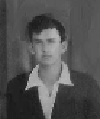 I first came to know Neil when I joined the boarding in 1952. He was many years my senior but being a fine cricketer he was well known to everyone at school. I remember him as a kind and helpful senior being very modest and not affected by the adulation and the back slapping. He was an immensely popular figure.
I first came to know Neil when I joined the boarding in 1952. He was many years my senior but being a fine cricketer he was well known to everyone at school. I remember him as a kind and helpful senior being very modest and not affected by the adulation and the back slapping. He was an immensely popular figure.
Neil joined Wesley during the Cartman era and showed a marked talent for the game of cricket. He continued to play for the school when Mr CJ Oorloff became the Principal. He was part of the legendary unbeaten teams captained by the Claessen brothers, Radley and Bryan. In 1952 the team was captained by Radley when the only loss was to St Thomas’ , after our cricket season had ended. From 1952-53 were the glorious years of cricket at Wesley when Neil Gallagher was an integral part of the unit. He was an important cog in the fabulous team of 1953 captained by Bryan Claessen that finished unbeaten. Fair-skinned and handsome, Neil stood out from the crowd. On the pitch he possessed the panache and the courage to match his competitive spirit. Off it, he was unfailingly good-humoured and friendly.
| Neil while at Hong Kong Bank | Neil at the Reunion Sept 2012 |
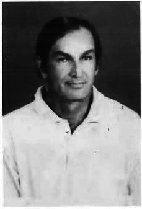 |
 |
Throughout his school career, on and off the field, Neil had a relaxed and calm demeanour which earned him many friends and a string of vocal supporters who showed off their colours at the cricket matches at Campbell Park. He was also a quiet man off the pitch and in the boarding. Neil and Arthlow Chapman were the best of friends in the boarding and it would be fair to say they were inseparable. They played cricket together and also joined in the practices at Campbell Park together. I cannot recall any instance when Neil got into trouble with the strict rules of the school or the boarding. Academia never suited him. He remained a principled and dignified student concentrating on sports.

Neil was a handsome and stylish cricketer at Wesley. Tall, fair skinned, broad with curly black hair, Neil looked down the pitch from a neat, upright and perfectly balanced stance. This perhaps gave promise of the range of stroke play at his command. As I recall, despite the theory at the time, he remained very much a back-foot player. Neil seemed to have all the time in the world to play his shots. He made his mark as a reliable and effective batsman. His on-drive was of the highest calibre. Neil never gave away his wicket cheaply. As well as his prowess with the bat Neil was an excellent fielder, either close to the wicket or on the boundary where he was known for the strength and accuracy of his throw. Although Neil never scored any centuries he made half centuries on many occasions at important matches during crucial stages of games.
Neil left school to join the Hong Kong and Shanghai Bank. He played cricket for the bank and rose to become one of its trusted executives.
He travelled to Australia in 2003 to see his former schoolmates and also old colleagues from Hong Kong and Shanghai Bank now resident in that country. George Roberton who was his classmate has written a fine account of his meeting with Neil Gallagher. This must have been a wonderful opportunity to relive those glorious years in Ceylon.
Links to further reading
Neil lead a happy life in retirement in Hendala. It was recently that illness struck a cruel blow. Neil is a fighter and he had recovered well when we saw him at the Grand Reunion of September 2012. He still has a tremendous love for Wesley. When I saw him with Arthlow Chapman it was like those good old days in the boarding when we all were young and carefree. I was sad to hear that lately he seems to have retreated into solitude. Let us hope and wish he could return to the life he lead before.
Kindly sent to me by Mohammed Iqbal (NZ)
The unveiling of the new name board went off well. It was attended by a few selected members of the OBU and with the participation of the Actg Principal Rev: Ebenezer Joseph. The board was unveiled by Hon Mr MH Mohammed and followed by Tea and speeches made by Mr. Ritchie Sappideen, Actg Principal and on behalf of the family Br. Hussain addressed the gathering. Br. Hussain mentioned about the assistance in words and deed from yourself and Br. Azahim along with the OBU UK branch. For your information Dr. Maharoof, Rajah Sinnathurai of the senior membership was present.
Ritchie informed the members present that the name board is presently fixed will be changed to a wooden board which was unable to install as the pavilion wooden paneling is perished and unable to hold the wooden name board due to the weight. He also informed that he will install the wooden board and send photos to all the members present.
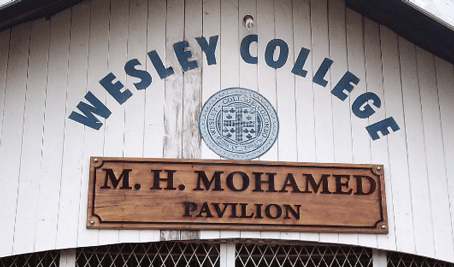 |
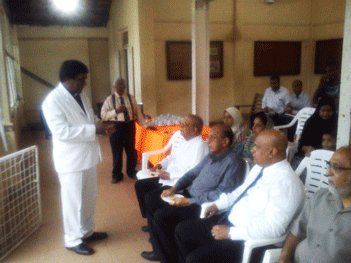 |
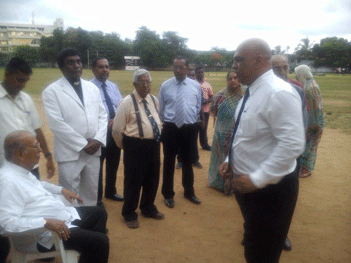 |
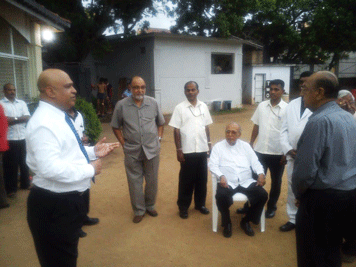 |
By Premasara Epasinghe
I have been writing about outstanding sportsmen and sportswomen who shone in their respective fields. Today, I thought, I must dedicate this article to two outstanding sports journalist who contributed their might with the pen, in promoting sports here and abroad.
 They were 'two Seneviratnes'. The senior one was our one and only Christie. He was a giant among sports writers, both physically and mentally. He used to write to the 'Daily News' as 'wrong un'.
They were 'two Seneviratnes'. The senior one was our one and only Christie. He was a giant among sports writers, both physically and mentally. He used to write to the 'Daily News' as 'wrong un'.
Christie Seneviratne was an outstanding schoolboy cricketer, who represented Wesley College in the late 1930s. He was a fine fast-bowler and a hard hitting batsman. His son Nihal, too played for Wesley and later for Saracens and the Board President's X1.
My first meeting with Christie was in mid March 1957, was when, he came to meet the Nalanda team and Master-in-Charge of Cricket at Nalanda, just two weeks before Ananda-Nalanda Big Match. If my memory serves me right, Lake House legendary 'Star' photographer Hector Sumathipala was taking our photographs.
I still remember what Christie told me: 'You are the Nalanda 'keeper. I saw you recently against St Benedict's College. 'Young man, you cannot keep wickets for toffee 35 extras. I must tell your prefect of games to drop you and go for a new keeper', were the words he uttered smilingly.
I told him, 'Sir, I did not play in that match. I was indisposed, down with fever.'
 Then this kind hearted gentleman patted my back 'Epasinghe, you are good. I still remember how you stumped Darrel De Silva of St Peter's College. I gave you week-end honours. Good luck for the Big Match'.
Then this kind hearted gentleman patted my back 'Epasinghe, you are good. I still remember how you stumped Darrel De Silva of St Peter's College. I gave you week-end honours. Good luck for the Big Match'.
If my memory serves me right, his column school cricket review was highly educative and full of facts and figures. Undoubtedly, he was one of the best cricket writers produced in this country. I learned a lot from this writer.
One of the most outstanding Sports Editor's was Carlton Seneviratne. He was my teacher, guide and philosopher in my career in sports journalism.
During my university career in early 1960s I worked as a reporter for Lake House Group. Carlton was a lovable personality, who helped young journalists. His life was athletics. With great sports writer, cum junior cricket coach at Royal, Harry Jayawardene he was instrumental in founding the Ceylon Track and Field Club - CT and FC. He gave a helping hand to many athletes.
I consider Carlton Seneviratne as my "Guru" and Teacher. He was a fine gentlemen and fine human being. Later, he functioned as the Director Sports at Sri Lanka Broadcasting Corporation when that great media personality Eamon Kariyakarawane was the SLBC Chairman. I proudly state that Carlton Seneviratne's period as Director of Sports ushered the golden age of Sri Lanka Broadcasting in sports media.
He played cricket for St Peter's College in mid 1940s, under Michael Chanmugam.
The most senior citizen of sports journalism was that fine walking Encyclopedia in sports late M M T Thowfeek. He was a distinguished Old Anandian. He did not talk much, but was a highly respected Sports Editor. He was a contemporary of Meemana Prematilake, the famous Editor and Poet. He was a fine gentleman always ready to help journalists.
Out of all the sports journalists M.B. Marjan was the Best of Best journalists. He was a complete sports writer. He was knowledgeable and was attached to 'Times of Ceylon' Soft-spoken Marjan was a brilliant sports journalist and he was very popular among the tribe.
Out of the Sinhala Sports Editor's Jackson Senaratne (Janata) was a fine volleyball player, who represented Ceylon in Volleyball. His contribution in promoting sports was enormous.
Then there was Wasantha Jayathilake (Lankadeepa). He was the one who promoted th elle. With lots of difficulties he was instrumental in spreading Elle.
Then there were two Sports Editor's who were in charge of Janata and Silumina, respectively. There were dynamic and had a fine knowledge amnd were University of Ceylon Products Nissanka Fernando (Janata) and Meemana Prematilake's own brother Sumana Prematilake (Silumina).
These great sports journalists contributed their might in propagating sports in Sri Lanka in print and electronic media. Today, these great men are forgotten, no one talks about them or remember them.
I penned these lines to revive their contributions. We, as sports journalist appreciate your contribution. Thank You!
To score a hundred in a game of cricket is a difficult task. There are eleven players to get you out. To achieve this landmark, one should possess, loads of concentration power. Cricket is a mind game. For a young school cricketer to score a hundred in the first innings and in the second innings respectively, is the most difficult task for any cricketer in any age group.
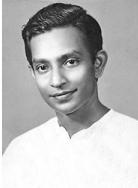 The year was 1943. A young Royalist - George Rajapaksa, against Trinity College, Kandy, had the proud distinction of creating this unique record by scoring twin-centuries at Asgiriya.
The year was 1943. A young Royalist - George Rajapaksa, against Trinity College, Kandy, had the proud distinction of creating this unique record by scoring twin-centuries at Asgiriya.
I presume the second schoolboy to achieve this distinction in 1943 was Cecil Peiris of Prince of Wales, Moratuwa.
George Rajapaksa was born on December, 29, 1925 to a highly respectable family in down south Medamulana - Weeraketiya, Hambantota district. His father was "Ruhune Sinhaya" - D M Rajapaksa. He was an outstanding classy cricketer who first represented Richmond College, Galle and then Wesley College, Colombo in the early 1900s.
Those were the days, the captain of the school cricket team was selected by the voting of the students. D M Rajapaksa was the rightful candidate for Richmond College captaincy. Another cricketer R A De Mel in the team, spent lot of money and he was selected. Even the Principal of Richmond knew there was gross-injustice done to Richmondite star cricketer D M Rajapaksa. He helped him to enter Wesley College, Colombo and he had the proud distinction of captaining Wesley College.
George Rajapaksa joined Royal College in early 1930s and he had the proud distinction of wearing the Blue-Gold and Blue Blazer as a Royal cricketer.
In the 63rd Battle of the Blues played on 19th and 20th March 1942, at the SSC grounds. (present Nelum Pokuna grounds) George Rajapaksa opened batting with Rudolph Wickramatilake scored 12 runs in the first innings (run out) and in the second innings out for nought caught by K M Perera bowled Vernon Prins. Royal won this match by six wickets under the leadership of Gamini Salgado.
George Rajapaksa in the 64th Royal-Thomian 1943, scored eight runs falling a victim to Daniel and in the second essay he was caught by Daniel off the bowling of Sam Elapata. The Thomians led by Vernon Prins won this Big Match by 10 wickets.
In the year 1944, 65th Royal-Thomian, George Rajapaksa captained Royal. In the first innings he scored 39 runs as batsman number 4 and in the second innings scored two runs. In first innings his wicket was captured by Sam Elapata (19-7-29-6) and in the second innings his figures were 20.3-8-32-3) George Rajapaksa's rival captain was Renga Selvaratnam.
Thomians won the Big Match by innings and 27 runs. This match was former Teldeniya Member of Parliament Tissa Kapukotuwa's debut in the Royal Thomian. He scored five runs and one run respectively for Royal.
Those who played for Royal under George Rajapaksa were Nihal Wickramasuriya, Vivian de Krester, Huge Aldons, Willie De Saram, Mahes Rodrigo, Mahendra Kasipillai, Dr C D L Fernando, N Vanculenberg and Tissa Kapukotuwa.
A notable feature for the two Rajapaksa's DM and George that their wickets were captured by Elapatas. In early 1900 when D M Rajapaksa played for Wesley in the match against S Thomas', he fell a victim to senior Elapata. His son George in the Big Match against S Thomas' College Mount Lavinia, ended his innings when Sam Elapata captured his wicket in 1944 (39 + 02). This young cricketer George Rajapaksa a right hand batsman was one of the best all-rounders, during the early 1940s. After leaving Royal College, he joined the Law College and passed out as a lawyer.
Following the foot-steps of his illustrious father D M Rajapaksa, young handsome charismatic personality George and his brother Lakshman, served the people of Hambantota District as MP's.
In 1955, George Rajapaksa entered the political arena as a member of Walasmulla village Council and was elected as Vice Chairman.
In 1960, he was elected as Member of Parliament for Mulkirigala constituency. Even today, Beliatta Mulkirigala Parliamentary seats in Hambantota District are the pocket boroughs of Rajapaksas. Today, illustrious, honest gentlemanly politician George Rajapaksa's daughter Nirupama Rajapaksa is the MP for Hambantota District- (UPFA) and Deputy Minister of Water Supply and Drainage). Her father was a highly respected honest Minister of the Sirimavo Bandaranaike Cabinet. He held the portfolios of Fisheries and Health.
Rajapaksas of Hambantota District are genuine and honest politicians who serves the District with dedication and commitment. They are honest and maintains a high degree of integrity.
George Rajapaksa was married to Lalitha Samarasekera. This gracious lady was the wind behind the sails of the family. The demise of his son Shyamlal at the age of 43 was an irreparable loss to the family. Great George Rajapaksa, cricketer and honest gentlemanly politician passed away on June 18, 1976.
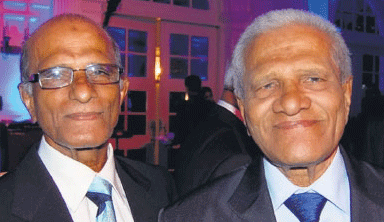
M.N. Samsudeen popularly known as “Sam” was 14 when he was ‘conscripted’ to the front lines of the Wesley College First XI in 1952. In his first match at senior level; his laid back attitude hid the brilliant deception he used to mesmerise the strongest batting lines up in the early fifties. Whether it was boys of his own age of men with international careers.
His coach Edmund Dissanayake who captained the school a few years earlier was the talent scout hors pair. He noticed the youngster’s effervescence and realised Wesley had a trump card. St. Joseph’s College team had the best batting line-up of schools... They had, the year before, destroyed the St. Peter’s attack scoring 382 runs then routed their big match rivals with Clive Inman and H.I.K.Fernando (both later international players) for 96 and 70.
Their team was one that rarely drew matches: leave alone lose any.The Josephian batting line-up included century makers the mercurial openers Wilson Wimalaratne and Maurice Wanigasekera. Kenneth Serpanchy, Talath Ismail, brothers the all-rounders Malcolm and Ralph Brohier followed.But Wesley had found the new baby face to shock the Joe’s batting into submission. That was Samsudeens.“Sam” was trusted with the new ball partnering his skipper Radley Claasen.
The young fast bowler had strong, broad shoulders and an advanced cricketing brain. He was precocious... His slinging action and fast arm would have made the Pakistani all-rounder Wasim Akram proud. He moved the ball both ways and was “able to pitch it on a coin”. The modern term is “on the money”.
The Joes were all at sea in their Maradana home ground! While Samsudeen kept the ball up, Claesen pushed them back with effective short pitched bowling. Quotes from Edmund Dissanayake “Had the umpiring been better he would have had more lbws” and Senthil Sinniah who captained Wesley in 1960 “Sam used his away swinger to dupe the batsmen who could not cope with the one that came back. More often batmen would play cover dives and cut shot then get bamboozled by the in-swinging Yorker. He created havoc. Often opening batsmen were bowled out shouldering arms.”
In the 1952 game with their centurions gone the Joes suffered meekly scoring less than 100.This was the first of many reversals very strong Josephian teams had to suffer when it came to a weaker Wesley teams.Sam was regularly among the wickets and like all good bowlers loved to play a very straight bat. He was always as a good bowler protected from injuries having to bat only when absolutely necessary. He says he regrets this because his tenacity meant that he could have been a good all-rounder.
This was the era Wesleyites fondly remember – the Golden Fifties... It was then when the Claessens: Radley, Brian and Herman, the Fuards: Ansar and Abu, the Adihettys: Lou and Vincent strode on field to prove they were as good as any, if not better. Bar Herman and Vince Adhihetty the others were proven great all-rounders.
 The story of Samsudeen’s cricket started in the backyard of the cricket fanatic Claesen family in Thimbirigasyaya. Sam and Herman were classmates and the fierce competition between the three younger boys and occasionally Radley had perhaps more to do with improvements. It was “after school”, on weekends and on school holidays. Brian was later to represent Ceylon against Lindsay Hassets’ Australian Test team on the way to the Ashes in England. He was still a schoolboy and Samsudeen was not far behind following. In 1952 still a fourteen year old he got another 6 for 6 against Prince of Wales College.. He then came up against a very strong Trinity team two years later. The best ever performance by any Wesleyite he achieved with 8 for 23 shocking the batsmen to a standstill as it were. Cricketers and fans will have realised that many schools and clubs learn to cope with a bowler who is on top. Finding ways to nullify Sam however brought defensive negativity and often the spinners were brought on to good effect. Internationals Brian Claesen (right arm leg spin), Abu Fuard (right arm off spin) and youngster Herman Claesen (left arm orthodox) were turned on. Sam was bowled in brief spells. Samsudeen by now had created seizure in opening batsmen, be they Royalists, Thomians, Trinitians, Kandy Antonians, Kingswoodians, Richmondites or Benedictines.
The story of Samsudeen’s cricket started in the backyard of the cricket fanatic Claesen family in Thimbirigasyaya. Sam and Herman were classmates and the fierce competition between the three younger boys and occasionally Radley had perhaps more to do with improvements. It was “after school”, on weekends and on school holidays. Brian was later to represent Ceylon against Lindsay Hassets’ Australian Test team on the way to the Ashes in England. He was still a schoolboy and Samsudeen was not far behind following. In 1952 still a fourteen year old he got another 6 for 6 against Prince of Wales College.. He then came up against a very strong Trinity team two years later. The best ever performance by any Wesleyite he achieved with 8 for 23 shocking the batsmen to a standstill as it were. Cricketers and fans will have realised that many schools and clubs learn to cope with a bowler who is on top. Finding ways to nullify Sam however brought defensive negativity and often the spinners were brought on to good effect. Internationals Brian Claesen (right arm leg spin), Abu Fuard (right arm off spin) and youngster Herman Claesen (left arm orthodox) were turned on. Sam was bowled in brief spells. Samsudeen by now had created seizure in opening batsmen, be they Royalists, Thomians, Trinitians, Kandy Antonians, Kingswoodians, Richmondites or Benedictines.
The two schools with whom there were no fixtures were Ananda and Nalanda who had the Obeysekera twins Carlton and Valentine, Gerry Gooneratne and Stanley Jayasinghe. This was policy then: Buddhists schools however good did not get fixtures from Wesley College! Against the strong Royal College team in 1955 he bamboozled the batsmen getting 6 for 26 following his first inning 3/25 and the match was over very early on the second day (Saturday).
Sam was then rushed off by his coach Alban V. Fernando to a first class game for the Colombo Colts cricket Club against Tamil Union at the Oval a stone’s throw from Campbell Park. The pr oblem was that as a school boy he needed the school’s permission to play in February 1955.
The archaic rule meant that instead of presenting him proudly, he was suspended by Principal Cedric Orloff for three matches against Trinity, Kingswood and St. Joseph’s. Needless to say Wesley without their best bowler was trounced by Trinity drew with St. Joseph’s, who had by then lost all their senior colours men and won against the lowly Kingswood College. Next on the Wesley fixture list was St. Peter’s. Bowling now with Lou Adhihetty as his opening partner he had a match bag of 8 for 67. In a low scoring match that was nail biting throughout, Wesley prevailed.
The fifties was the period where Sri Lankan or Ceylon cricket was at its best. The main team could have taken on Hutton’s Englishmen, Hasset’s or Bradman’s Aussies, the Pakistanis, Indian and even the West Indies who Stollmeyer led. Brian Claasen and Samsudeen were the two school boys who were chosen to represent “Ceylon”. They both shone in their own right. Claasen as a batsman and Samsudeen as a bowler and fielder.
Michael Tissera the gentleman skipper of many international matches Ceylon played in the late fifties and early sixties remembers that in one match against the Pakistan Eaglets Samsudeen had a “Royal flush” - ten wickets against the highly rated Pakistani batsmen. Sam helped dismiss the side for 40 runs.
I can safely presume that Pakistani coaches could have picked up some strong points and made good their own left arm fast bowlers with Sam as a standard! Wasim Akram had the fast movement of arm that made him a deadly bowler to face. Eventually if Sam did not get the wickets he must have helped the spinners in no small way to get theirs. Accurate, aggressive new ball bowling always creates opportunities for the spinners to “clean” up. With spinners like the Claasaen brothers Brian (leg spin) Herman (left arm spin) and the iconic off spinner Abu Fuard to follow, batting against this bowling attack must have been a hazardous task for even the best.
Samsudeen spent a major part of his first class career at the Colts cricket club favourite water hole of the Wesleyite cricketers before he joined the Navy to see the world. During his absence his son was schooled at D.S. Senanayake College instead of Wesley and he chose rugby as his main game. Wesley was deprived of seeing another Samsudeen in a cricket team for Milhar Samsudeen’s younger brother stepped into his shoes pairing off with L.R. Gunatillake the left arm fast bowler and they made a lot of schoolboy batsmen hop and skive to avoid having broken bones. The quiet beach front where we chatted showed me that in this gentleman were the qualities I would have longed to have; simplicity humbleness, a man reserved, polite and soft spoken. We are proud of you Sam. In fact very proud.
The 16th Annual Golf event between past pupils of Wesley College Colombo and Trinity College Kandy was held at the Morack Golf course in Melbourne on the morning of Sunday 8th' November 2015. Melbourne provided a fine spring day, temperature 16-24 degrees, light winds and a golf course in great condition.
Since the inception of this event in 2000, it has been clear that the depth of golfing talent has been in favour of Trinity College; notwithstanding this, Wesley College won consecutively in 2013 and 2014; following 3 consecutive Trinity winning years.
Many of the senior Trinity players are long-time friends of the writer; they have frequently made me aware that Trinity will make amends for 2 consecutive losses; and so they did.
The winning College team is traditionally based on the aggregate Stableford score of the 6 best cards from each school.
Here are those results:
Trinity-200
Wesley-198
Well done, Trinity College Kandy. Among the individual prize winners on the day were:- Martin Siebel Memorial Trophy -( Best Wesley Score) Lloyd Siebel: 36 Stableford points; countback from Sri Kanagasapathy also with 36 Stableford points.
Longest Drive - Imran Juma,Wesley College, (measured at - 280 M); the writer played with Ravi Ratnayake in the final group; Ravi made a colossal drive on this hole and we were convinced that this would be the longest drive; to find that, as we approached the green the long drive marker about 10M ahead of Ravi's drive.
Other good Wesley scores - Imran Juma 34 points; George Siebel 33 points; and Shah 30 points.
Best Individual Trinity score - Ravi Ratnayake; 39 points. As usual, following the game and before the prize giving, Trinity, our hosts for 2015, provided a hearty Barbecue with lots of beverage.
The writer wishes to thank all those who represented Wesley so well; and particularly those new and very social golfers who were severely disadvantaged by the new handicapping rules. It is both easy and inexpensive to obtain a Golf Australia, Golf Handicap. Need help, talk to me.
We need you! This is an important social event on the Wesley OBU calendar, and we look forward to your continued participation. The event for 2016 will be hosted by Wesley and held on Sunday 9th October, at the picturesque Morack Golf Course, in Vermont South. We cordially invite both Interstate and Overseas old Wesleyite Golfers to represent us at these annual encounters. I am confident that, if sufficient interest is shown, our well organized and hard working Commitee will find their way to adding other activities around this time.
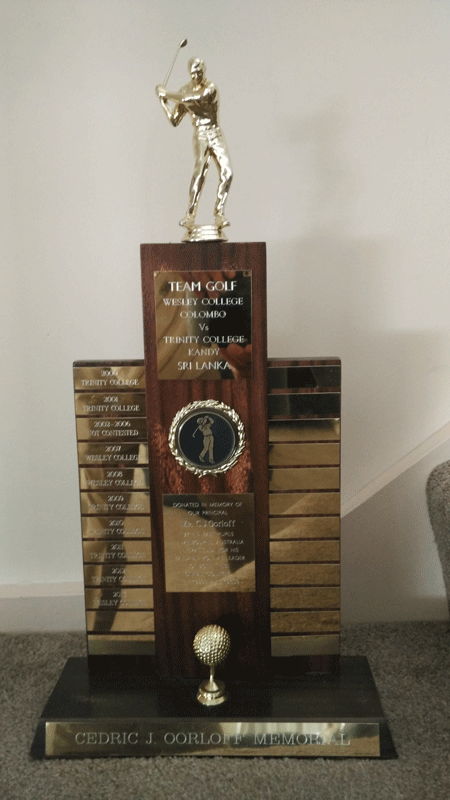 |
 |
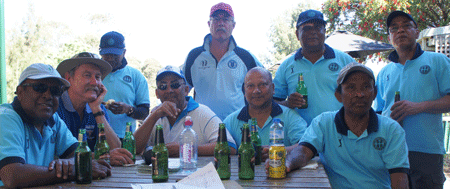 |
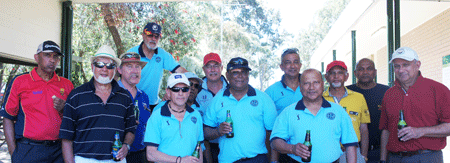 |
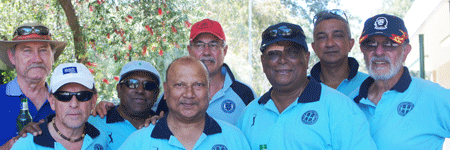 |
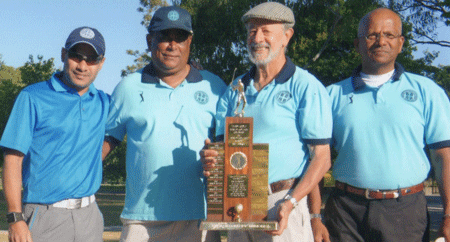 |
Wesley and St. Joseph’s centenary cricket encounter For the Arthur Hakel Trophy
Wesley College and St Joseph’s College will inaugurate the Bryan Claessen- Arthur Hakel Memorial trophy at the centenary match of the historic series to be played at Campbell Park on Jan 6 and 7.
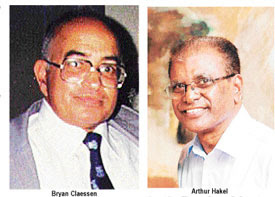 Wesley College will be led by Shamod Athulathmudali and St. Joseph’s College by Harin Cooray. Out of the 99 encounters played so far, St. Joseph’s lead the series tally with 35 wins, the last being in 2016 under Sandaruwan Rodrigo, and Wesley College with 10 wins, with the last being in 1969, under Amresh Rajaratanam. Bryan Claessen captained Wesley College in 1953. Under his leadership, Wesley was unbeaten, having registered victories against St. Joseph’s, Royal, Kingswood, Prince of Wales and Richmond. The matches against S. Thomas’, Trinity and St. Peter’s were drawn. The match against Royal has been singled out because of certain special features. In each of three innings, the totals did not exceed 85. Royal scored 68 and 76 while Wesley scored 145 and 84.
Wesley College will be led by Shamod Athulathmudali and St. Joseph’s College by Harin Cooray. Out of the 99 encounters played so far, St. Joseph’s lead the series tally with 35 wins, the last being in 2016 under Sandaruwan Rodrigo, and Wesley College with 10 wins, with the last being in 1969, under Amresh Rajaratanam. Bryan Claessen captained Wesley College in 1953. Under his leadership, Wesley was unbeaten, having registered victories against St. Joseph’s, Royal, Kingswood, Prince of Wales and Richmond. The matches against S. Thomas’, Trinity and St. Peter’s were drawn. The match against Royal has been singled out because of certain special features. In each of three innings, the totals did not exceed 85. Royal scored 68 and 76 while Wesley scored 145 and 84.
Bryan notched up four centuries. Against Trinity (101 not out) 115 vs Kingswood, 157 not out vs Richmond and 105 vs S. Thomas’. His best bowling performance was against Zahira (9 for 37). Other good performances were 8 for 68 vs St. Joseph’s 6 for 39 vs Kingswood, 6 for 20 vs Prince of Wales, 6 for 87 vs Trinity, and 6 for 38 vs Richmond.
Bryan was selected to play for All-Ceylon while at school, in 1953, under Sargo Jayawickreme.
He was an outstanding and complete cricketer, a stylish and aggressive stroke maker with an array of strokes all round the wicket. He was also a wily leg spinner, who bamboozled batsmen with his flight and spin, a brilliant fielder in any position, and one of the prodigious captains produced by Wesley.
Bryan migrated to Australia in 1957, and secured several awards in cricket. He will be remembered as the first Sri Lankan to be elected President of a South Australian District cricket club.
Professionally, Bryan was a Prosecutor in Family Law. When he retired in March 1988, he was in charge of the division responsible for the enforcement of family support orders in South Australia.
Arthur Hakel was a multi-talented sportsman representing St Joseph’s College in cricket, athletics and soccer. He played cricket under the captaincy of Lalit de S. Wijeyeratne 1968 and Brian Obeyesekere 1969, and opened the bowling during this time. Arthur achieved a hat-trick as an opening bowler against Richmond College and was known as hat-trick Hakel by his team mates, Arthur was never a batsman. However, he valued his wicket and would not throw it away. On the field he was one of those quickest throwers of the ball, as he was a javelin thrower and held the schools javelin record for some time. After leaving school, he represented Colombo Cricket Club.
After spending day in day out on the field while at college, he could not do without same after leaving college, representing the Cricket Committee and being the Chairman of the Athletics Committee, and was the first President of the Past Cricketer’s Association of St. Joseph’s College until his untimely death last year.
Links to further reading
- Elton Bryan Claessen - In Memoriam 18/3/2010 -
- Cricketers of 1953 - Sent by Olkie Edema -
- A Tribute to Sir Donald Bradman- A Poem by Bryan Claessen -
- Some Memories of cricket of the 1950's sent by Bryan Claessen -
- Bryan Claessen by Dr.N.D.Amerasekera -
- Lunch with the Claessens - From the OBUA Newsletter 2005 -
- A Letter from Bryan Claessen sent in 2009 -
Wesley’s magnanimous gesture after the season-opener scuffle By Inshaf Caffoor
The Principal of Wesley College, in an unprecedented gesture has issued an official apology on behalf of Wesley College to Trinity College on an incident that took place involving the players of Wesley and Trinity.
Friday’s season opener of the Schools Rugby League that was played by Wesley College and Trinity College saw an unruly scuffle breaking out after Trinity College scored its tenth try towards the dying stages of the game.
A shoulder charge which escalated into a brawl between the two sides saw the fans joining in the fray and subsequently taking it to a full-on brawl. The unruly incident was soon resolved with the intervention of the Police and the referees. In the aftermath of the incident, the Principal of Wesley College Mr. Avanka Fernando has tendered an apology undertaking the full responsibility for the actions that were committed by their students.
“I personally spoke to the Principal of Trinity College and apologized and spoke to the entire Trinity College rugby team to say sorry for the misbehaviour of my boys.”
He further goes on to add that he will personally make a visit to Trinity College with his rugby captain to tender their apologies to the Trinity camp. “Same day evening after the match I decided to visit Trinity College during the coming week with our rugby captain and vice captains to meet the Trinity College Principal and their rugby captain and the vice-captain to apologise and to build the mutual understanding and to ensure that the strong relationship that we had will continue to remain as the same”
The official communique further elaborates that necessary action will be taken by the school authorities in terms of discipline and has ensured that such an incident will not occur in the future.
ThePapare.com applauds this gesture, especially at a time where most school authorities are vying to win at all costs with little or no regard to sportsmanship and etiquette, a culture which they are also enforcing on students as well. It is fervently hoped that this action of the Wesley College principal will set a new precedent at the vociferously contested schools’ rugby passage where passions run high and most often common sense and decency get misplaced in the mayhem.

Wesley players face disciplinary action By Harsha Amarasinghe
CT Sports: The rugby players of Wesley who were involved in a brawl that broke out in the dying moments of the inter-school league rugby tournament opener against Trinity College on Friday, are expected to face disciplinary action over their on-field antics.
The Kandy team had taken a resounding 57-24 lead and their lock Pasan Samarawickrama had crossed the whitewash in the 80th minute adding more misery on the Double Blues. As the Trinity player was touching down, the Wesley lock crashed into his opposite number quite intentionally, delivering a blow with his elbow in the process. This unwarranted act led to an exchange of blows between the players.
"As the home team we have to take responsibility for what happened and we are ashamed of it," Wesley head coach Jeevan Gunathilake told Ceylon Today. In the previous season, a similar incident took place up in Kandy when St. Joseph's players were assaulted by Dharmaraja College, which saw the players involved in the brawl being banned from playing inter-school rugby.
"The school is already in discussion over what form of disciplinary action should be taken, as this is something that should never happen on a rugby field. It was truly embarrassing," revealed the ex- Sri Lanka junior national captain. After the initial contact between the two players, even the reserve players charged into the playing area, causing a lot of problems to the officials, who lost control of the situation.
"Well, that is the main problem. I think an exchange of words between players on the field is understandable, but the players from the bench breaking into the field is certainly not acceptable," the former CR and FC player stated. Meanwhile, a source close to Trinity College revealed that the Wesley Principal apologized soon after the match over the incident.
"Wesley Principal apologized for what happened soon after the match. Then players from both sides shook hands. There is a good relationship between the two schools. Wesley must have been very disappointed with the way their players behaved and Trinity players could have also handled the situation a bit smartly," the source said.
DEFEAT WITH HONOUR By Eardley Lieversz
Wesley College Unbeaten 1st XI Cricket Team 1969

Royal College Cricket Team 1969

2019 is not only the 50th anniversary of the last decision in a two-day Royal – Thomian, in which Royal were triumphant, it is also the anniversary of a famous game which Royal lost, while still showing magnanimity in defeat.
It is rare that two games in the same season, where defeat and victory occurred within a two-week period, are recalled half a century later. It is arguably Wesley’s most celebrated win because playing Royal was the equivalent of a big match for them, and the Royal-Wesley encounter is second only to the Royal-Thomian in age, the two schools meeting for the first time in 1893. Indeed, from time to time Wesleyites, who either witnessed or participated in the match, bring up that particular game in the media and in conversation, to the exclusion of other memorable games involving Wesley. In this manner the encounter is kept in the public mind.
A match for all seasons
The Royal – Wesley encounter took place at Campbell Park on the 21st and 22nd of February 1969. So far most of the descriptions of the game have been mostly from a Wesley perspective, quite often interpreting the game with the benefit of hindsight and, to my mind, distorting the true dynamics of what occurred. M.B. Marjan, writing for the Messenger, described the game as “a match for all seasons.” (Refer next page.) He rightly described it as a thriller and used words such as “carnival cricket” in capturing the excitement which prevailed in the last session and gripped the milling crowd. And although he praised the vanquished, citing Grantland Rice, he made it appear that it was only Wesley that had taken the risks and opened the game up. He quoted the well-known saying “fortune favours the brave”, the brave in this instance being Wesley.
The problem with using clichés is that one ends up validating the cliché by interpreting events in a particular way. Because Wesley won, they are anointed with the halo of bravery. Eleven runs stood between Royal and a similar accolade.
Marjan refers to the Wesley captain’s dismissal of J. Thalayasingama as “a typical captain’s deed that needed all the confidence and skill of an adventurous buccaneer who knew which way the wind was blowing”, but remarks that Royal’s captain was lucky to score a fifty. He refers to Wesley’s traditional grit as underwriting its eighth wicket stand, but ignores Royal’s gutsy recovery from 67 for 4 wickets, and partnerships of 42 and 96 for the fifth and sixth wicket, respectively. Jagath’s Fernando’s seven fours are described as reckless rather than full-blooded and well-timed. He constantly refers to how Wesley withstood Royal’s batting “tornado”, while giving scant credit to Royal’s incredibly risky run chase, which turned the game into the thriller it was.
I am attaching Marjan’s article as it appeared in the Messenger followed by a typed transcription. Despite his bias towards Wesley, without Marjan’s article, readers today will have little idea of how cricket was elevated fifty years ago and his use of the phrase “a match for all seasons” makes the game belong to the ages.
The reproduction of Marjan’s match summary in the Island newspaper twenty years after differs slightly from the original due to subsequent editing. The author died tragically in a drowning accident in the mid-seventies and, out of respect, I feel obliged to present his review in its pristine form, right at the beginning of this article.
Links to further reading
A MATCH FOR ALL SEASONS by M.B. Marjan, Sunday, 2nd March 1969.
Special “Messenger” Sports Correspondant
FORTUNE FAVOURS THE BRAVE and Wesley College in living up to every letter of this maxim scored an incredible 10 runs victory over Royal in the last ball of the day.
This fabulous triumph by Wesley will ring around Campbell Park and wherever cricket is played in this sunny isle of ours for a long, long, long time. The hundreds that watched this "thriller" of a cricket match couldn’t believe it when Amaresh Rajaratnam, the bespectacled Wesley skipper hurled down the last over and had Royal’s tailender, J. Thalaysingham ruled leg-before in the last ball. A typical captain’s deed that needed all the confidence and skill of an adventurous buccaneer who knew which way the wind was blowing.
Perhaps most of you have read most of the details in the daily newspapers. But to get into this fantastic story book win, I feel that repetition of this valorous achievement by Wesley is only to give credit to the victors and the vanquished who played the game as it should be played, keeping well in mind the dictum that "when the great scorer comes to write against your name, he’ll ask not how you won or lost but how you played the game." Well played Wesley, Well played Royal. Wesley were graceful after victory and Royal magnanimous in defeat.
The milling crowd that invaded the pavilion after this fantastic match, cheered both teams and how refreshing it was to see the Wesley an Royal cricketers rejoice at the result — for the 22 young cricketers had done their job as best they could to elevate KING CRICKET to the position from which she seemed like toppling.
Lest I forget, this must be said. The Sir Frank Gunasekera Memorial Shield to the winners of this match was awarded by for the first time by his son, Dr. Lucien Gunasekera at a dinner held at Wesley College after the match. And what a match it proved to be – the first winners of the Shield extricating themselves from the jaws of defeat to the lap of victory. This how the match went. Wesley batted first and raced to 260 for the fall of nine wickets. Sriharan Jeganathan enjoyed his stay at the wickets to breeze his way to an attractive 65 in 70 mins., while little Patrick Jansz batted with astonishing maturity and poise to belt the Royal bowlers in belligerent fashion to collect 50. Patrick Jansz is the boy to watch, he’s got oodles of talent and isn’t afraid to hit the ball hard. Royal replied with 100 for four at the end of the first day’s play and went on to reach 207 for the loss of seven wickets, when skipper Eardley Lieversz declared at the milk break. Lieversz was lucky to score 52 while Paul was unbeaten with 45 and C.A.P. Samarasekere notched a brisk 43. At the end of the first day, Royal had scored 100 for 4. Royal skipper Eardley Lieversz batted with determination to knock up 52, Paul was not out 45. C. A. P. Samarasekera notched a quick 43 when the Royal declaration was made at the milk break at 207 for 7 wickets. Sritharan Jeganathan followed up his good work with the bat by snatching three wickets for 84 runs.
Wesley’s second innings was one of fluctuating fortunes. After losing two wickets without a run on the board and the scoreboard reading 45 for seven at a later stage, Wesley’s traditional grit came into play as Delmer Achilles and Ivan Van Dort added 60 runs for the eight wicket in 52 minutes for Wesley to declare at 4.40 with score at 105 for eight – Achilles remained not out at 31 and Van Dort carved a quick 29. This left the Royalists with the task of making 158 to win in 70 minutes – which looked an enticing one considering the fast outfield and the smallness of the ground. The way Royal’s openers blasted off it seemed as if they could do it. Jagath Fernando and S. Thalayasingham breathed fire at the bowling to put on 49 runs in 18 minutes, before Fernando was out for a hectic 38 in 18 minutes with seven reckless fours. The others continued to swipe at the bowling. The batsmen who followed continued to swipe at the bowling – Paul, Samarasekera, Jayaweera, Caldera, Lieversz and R. T. de Silva. Meanwhile the Wesley bowling though being battered was never erratic and paceman Tyrone Jansz collected the first four wickets to fall – all to frantic efforts at hitting, to give the fielders hot catches to grasp. When Jayaweera was out at the score read 119 for 5 and the game proceeded in the same fierce vein as the Royal tornado began to blow hot and wild, threatening to swamp their opponents.
But with Caldera’s exit for a fierce 50 Royal’s chances dimmed. They were 148 for eight and with two overs to go they needed 11 runs to win. Another wicket fell and tailenders stood their ground. Just then Rajaratnem took over the bowling end, and in the last ball saw his side earn a dramatic win. M. Sathasivam one of Ceylon’s best Batsmen in recent times gave the Weslyites some valuable tips; made them declare their second innings and forced Royal to go on the rampage; provide Carnival cricket and give his old school a deserving win. Also present at the match were Dr. C.H. Gunasekera and F.S. (sic) de Saram who enjoyed every minute of the game and were all smiles at the finish of this match of all matches, or as a colleague said “A match for all seasons”.
By Thilina Galappatti -February 10, 2016
It is the second oldest inter-school cricket encounter in the island where two prestigious institutions, Royal College and Wesley College battle it out for the Frank Gunasekara Shield at Campbell Park, on the 12th and the 13th of February 2016.
The first encounter between the two schools was played back in 1893 at San Sebastian Hill, Hultsdorf, home of the Royalists. The hosts were led by F.S. De Silva while Percy de Bruin captained the visitors. One of the umpires was John Harward, then principal of Royal College. The Royalists won the inaugural encounter by 53 runs.
This year it will be the 123rd occasion on which the schools will meet. Royal lead the tally with 51 wins to Wesley’s 21 while 50 have ended with no result. The only break in the series came in 1943 when the grounds of both schools were taken over by the British during the Second World War.
The shield is named after a famous Ceylonese Senator, an old Royalist Sir Frank Gunasekara who was the Deputy President of the Senate of Ceylon in 1948.
The Royalists are the current holders of the shield, having won it last year under the captaincy of Harith Samarasinghe. Batting first, Royal made 235/8 before bowling out Wesley for a paltry 93. Following on, Wesley made 172 giving Royal a 31 run target which was comfortably chased down by the home side. The 9 wicket win saw the shield returning to Reid Avenue after 3 years.
The shield was first awarded in 1969 with Wesley emerging victorious under the leadership of Amaresh Rajaratnam. The result was made possible due to sporting declarations by both sides. Batting first, Wesley scored 260 for 9 while Royal replied with 207 for 7. With a lead of 53 runs in the first innings, Wesley declared at 105 for 8, setting the Royalists a target of 158. The game subsequently ended in a thrilling finish as the Royalists were bowled out for 148 in the last over of the day, giving Wesley a 9 run win.
However their reign was short lived, as Royal won it back in the following year, leaving Wesley with no option but to wait for another 42 years to taste victory, which they did in 2012 under the captaincy of Ashen Fonseka.
The centenary encounter was played as a three-day affair at the P.Sara Oval in 1993 where Royal triumphed under Gamini Perera. The Wesleyites were led by Tehran Rasool in the centenary game. After bowling Wesley out for 103 runs, the boys from Reid Avenue posted a mammoth total of 411 for 6 with the skipper himself scoring an unbeaten 152. The match ended within two days when Wesley were bowled out for 112 in their second innings, giving the Royalists an emphatic innings and 196 run victory. N. Rajan’s brilliant bowling earned him a match bag of 10 for 43.
In 1905, C. A. Perera of Wesley made 108 in the encounter, becoming the first ever opponent to score a century against Royal.
Wesleyite Danesh Dassanayake scored centuries against Royal in 1988 and 1989. His father Edmund Dassanayake too scored a ton in 1946. They remain the only father-son duo to score centuries against Royal.
The record for the highest individual score is held by the former Royal skipper Chulaka Amarasinghe who scored an unbeaten 207 in 1983 while Roshan David’s 199 in 1990 stands as the best for the Wesleyites. David’s innings also happens to be the highest score by any opponent against Royal in a school cricket fixture.
Royal’s highest total of 463 for 9 came in 1930 while the highest total for Wesley was their 368 runs which came in 1990.
This year the Royalists will be looking to hold on to the celebrated shield which they earned after a long wait while the Wesleyites will be hoping to do their utmost to bring it back to Campbell Park.
Dilwin Mendis-Moratuwa Sports Special Correspondent
Saturday, November 18, 2017
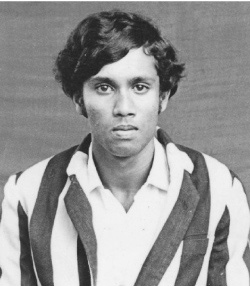 Former Wesley College cricketer, Junior Athlete and Senior House Captain, Saracens Sports Club, Burgher Recreation Club, Galle Cricket Club Sara Trophy and Mercantile “B” Division cricketer, Cricket Umpire, Coach and Director Coaching Oscar Dissanayake spoke to the Daily News at his residence in Kotte.
Former Wesley College cricketer, Junior Athlete and Senior House Captain, Saracens Sports Club, Burgher Recreation Club, Galle Cricket Club Sara Trophy and Mercantile “B” Division cricketer, Cricket Umpire, Coach and Director Coaching Oscar Dissanayake spoke to the Daily News at his residence in Kotte.
Question Can you tell something about yourself and your family in brief?
Answer I am Oscar Dissanayake and I was born on 11th August 1953 and I am the only child in our family. My father is Clair Dissanayake and he was at the Ministry of Planning and Economic Affairs and my mother is Iranganie Dissanayake nee Seneviratne. She was a housewife. My wife is Tilaka Dissanayake nee Boange and we have a daughter and we hail from Panadura.
Question What is your school?
Answer I studied at Wesley College, Colombo from Lower Kindergarten to Advanced Level and entered in 1958 the Principal was Harold Nonis and my first class teacher was Miss Norma de Silva. Later Shelton Weerasinghe assumed duties as the Principal.
Question Did you participate in sports?
Answer I played cricket and was a Junior Athlete and a Senior House Captain. I am a right hand bat and a right arm bowler. During my time it was all friendly matches in the under 14 and 16 and traditional matches in the first eleven. I played for the under 14 and was the vice captain in my first year and my captain was Nilaraj Coomarawel and the coach and MIC was Shelton Weerasinghe. I batted at number three and bowled off spin. My under 16 captain was Tyronne Jansz and L. C. R. Wijesinghe took over as the coach and asked me to open and to concentrate on batting. The following year I captained the under 16 team.
Question Did you play for the first eleven?
Answer My first year was in 1968/69 under Amaresh Rajaratnam and the following year too he captained and Edmund Dissanayake was the MIC and Coach. Under Rajaratnam we won the Lifebuoy Trophy I was the Best Batsman that season. In 1970/71 Delmer Achilles captained and I got 566 runs and against Kingswood I scored 81 versus Trinity 81. We beat Thomians. I was awarded the Best Batsman Trophy at the College Prize Giving and I won Colours. The following year A. J. Cader and Tyronne Jansz led the side.
Question Did you lead the College team?
Answer In 1972/73 I captained and D. H. de Silva was the coach and MIC was L. C. R. Wijesinghe and my Vice Captain was Granville Hamer. In the Sir Frank Gunasekara Trophy we beat Royal on first innings.
Question What is your unforgettable match under your leadership?
Answer Against Trinity we traveled down to Kandy and Trinity had a very strong side and the match was played on the turf but we were used to the matting. They under estimated us and their captain was Ranjith Dissanayake. In this game we won on first innings. Athula Wickramasinghe got a scintillating 107 and I got 74 and put on a record partnership of 177 runs in 114 minutes. The same year against Richmond we won the E. R. de Silva Trophy. In the Kingswood match Rennie Devadasan got 107 and I scored 81 we put on another record partnership of 180 runs.
Question Can you tell the names of your under 19 squad?
Answer Granville Harmer (Vice Captain), Rennie Devadasan, Geethal Peiris, Athula Wickramasinghe, Wilhelm Vandort, Dayalan Sellamuththu, Carlyle Peris, K. Dayaparan, Lalith Fernando, Eric Solomons, Russel Kern, Vevele Perera, Weera Pathirajah, Mahesh Samaraweera, Anura de Silva and Roger Cock.
Question How do you fair in athletics?
Answer In the Junior Level I did 100, 200, Relays and High Jump and I was in Lemphers House. In the Senior Level I did not take part in athletics but I was the House Captain of Passmore House.
Question Did you play club cricket?
Answer I played Sara Trophy for Saracens, B.R.C. and Galle CC. Ralston Burke and Percy Perera captained Saracens and I opened with Merryl Dunuwille while Gerry Wouterz and Vernon Wambeck led B. R. C. I opened with Bernard Wijetunge. Saliya Wijewardene and Harith Weerawarna invited me to play for Galle CC and I played under Tissa Dias and Neranjan Withanage and scored six fifties in a row.
Question What is your employment and did you play cricket for them?
Answer I was at Kundanmals and I played in the Mercantile “B” Division and later “C” and “G”. I captained in 1981 and scored an unbeaten 130 with Hirdramanis and I carried away the Best Batsman and the Highest Scorer of the tournament in any division trophy called the Bartleet Trophy.
Question Were you involved in coaching?
Answer I am a Level One coach. I commenced with first eleven at St. John’s College, Dematagoda, Wesley Juniors, Carey and Sir Baron Jayathilake schools first eleven teams and St. Thomas’s Prep. I was an umpire too. In the mean time I got an appointment in Saudi Arabia and I played for ABV Rock Camp. I was the president of Rock City Cricket Club for two years and came to Sri Lanka and went to Doha Qatar. There I coached Lanka Lions cricket team for two years and I was the Director Coaching of the Qatar Cricket Academy. Then I joined United Nations Mission in Siera Leon and came back to Sri Lanka.
Question Are you involved with your OBA activities?
Answer I was one of the Vice Presidents of the OBU and a member of the Old Weslyites Sports Club and a member of Saracens SC and Colts CC and a life member of the Galle CC. In addition I am a Methodist and a member of the Methodist Church, Nugegoda and a Parishioner at Christ Church, Kotte.
Question Who is the Best Schoolboy Batsman and Allrounder during your school career and at club level?
Answer The Best Batsman was Roy Dias and Best Allrounder was Garry Melder and at club level it was Anura Tennakoon and Michael Tissera.
Question Does your daughter do any sports at school?
Answer Her name is Shivanthi Dissanayake and she was at Ladies College, Colombo. She captained the Schools Senior Table Tennis team. Presently she is domiciled in Australia and both my wife and I might join her soon.
Question What is the advice you can give to young sportsmen?
Answer Firstly you must obey your parents, elders and teachers and whatever the religion you are, you must practice it and then the studies. In the present day youngsters doesn’t want to take up defeat. For this you must do at least one sport and play the game in true spirit.
By Jeremy Brohier
 The second oldest inter-school cricket fixture in the country will be played at Campbell Park on 16 and 17 February for the 125th year between two of the finest educational institutions, Royal College and Wesley College for the Dr Sir Frank Gunesekera Shield. The first encounter between the two schools was played in 1893 at San Sebastian Hill, Hultsdorf which was the home ground of the Royalists. Royal was Captained F.S. De Silva while Percy de Bruin captained Wesley. The Royalists won the inaugural encounter by 53 runs. The only break in the series came in 1943 when the grounds of both schools were taken over by the British during the Second World War.
The second oldest inter-school cricket fixture in the country will be played at Campbell Park on 16 and 17 February for the 125th year between two of the finest educational institutions, Royal College and Wesley College for the Dr Sir Frank Gunesekera Shield. The first encounter between the two schools was played in 1893 at San Sebastian Hill, Hultsdorf which was the home ground of the Royalists. Royal was Captained F.S. De Silva while Percy de Bruin captained Wesley. The Royalists won the inaugural encounter by 53 runs. The only break in the series came in 1943 when the grounds of both schools were taken over by the British during the Second World War.
The shield is named after a famous Ceylonese Senator, an old Royalist Sir Frank Gunesekera who was the Deputy President of the Senate of Ceylon in 1948. Both Dr. Sir Frank and Dr. Lucien had connections with both Royal and Wesley. Although both were educated at Royal, Sir Frank resided close to Wesley at the junction of Campbell Place and Baseline Road opposite the Welikade prisons. His two brothers Eric and Donald both studied at Wesley and played cricket for school in 1908 and 1910. The former ended up as Vice Principal and lived at Karlsruhe Gardens right in front to the Wesley Principal and Vice Principal’s bungalow. Their sister Irene too lived here.
Sir Frank, whose portrait hangs in the Royal College hall, was a brilliant student winning the Thoburn prize for the best all-rounder in 1904. The Chief Guest Sir Henry Blake predicted success in whatever career he chose. Five generations of Gunesekera’s have studied at Royal and Wesley College, including Eric, Donald, Elmer, Terrance, Lal, Chrysantha, Nalin, Capt. Rohith, Hiran, Sharmal, Sivaji, Shivantha, Rajiv, Tharindra and Anujith.
It was in 1969 that Dr. Lucien Gunesekera presented the Sir Frank Gunesekera Shield in memory of his father which Wesley became the first recipient in the famous last ball victory under the leadership of Amaresh Rajaratnam. Sporting declarations by both sides made the match one of the, if not the most interesting of the 125 encounters played between the two schools.
Batting first, Wesley scored 260 for 9 while Royal replied with 207 for 7. With a lead of 53 runs in the first innings, Wesley declared at 105 for 8, setting the Royalists a target of 158.
The game ended in one of the most thrilling finishes when the Royalists were bowled out for 148 in the last ball of the last over of the game, giving Wesley a famous 9 run win.
Wesley’s reign was short lived, as Royal won it back the following year, leaving Wesley with no option but to wait for another 42 years to taste victory, reclaiming the trophy in 2012 under the captaincy of Ashen Fonseka.
The centenary encounter was played as a three-day match played at the P.Sara Oval in 1993 where Royal was captained by Gamini Perera and Wesley was captained by Teheran Rasool. After bowling Wesley out for 103 runs, Royal posted a mammoth total of 411 for 6 with the Captain himself scoring an unbeaten 152. The match ended within two days when Wesley was skittled for 112 in their second innings, giving the Royalists an emphatic innings and 196 run victory. N. Rajan’s brilliant bowling earned him a match bag of 10 for 43.
In 1906, C.A. Perera of Wesley made 108, becoming the first ever Wesleyite to score a century against Royal. Another interesting feature of this longstanding encounter was when Danesh Dissanayake scored centuries against Royal in 1988 and 1989 while his father Edmund Dissanayake too scored 107 in 1946. They remain the only father-son duo to score centuries against Royal, while for Royal, H.C. Gunasekara scored 120 in 1912 and his son C.H. Gunasekara (Jnr) scored 100 in 1949.
The record for the highest individual score is held by the former Royal skipper Chulaka Amarasinghe who scored an unbeaten 207 in 1983 while Roshan David’s 199 in 1990 stand as the highest for the Wesleyites. M.L. Warish holds the bowling record for Wesley against Royal taking 9 for 17 in 1897. Warish’s match bag of 14 for 48 in that match still continues as a record for both schools.
Another unique feature of this series is when the Harmer brothers Mervyn and Russell had a hand with dismissal of all 10 Royal batsman in the 1st innings of the 71st match played in 1964 a Campbell Park. In that innings S. Rajaratnam from Royal was the only batsman to be run out for 62.
Over the 125 years both schools have produced some outstanding and great cricketers, a few that come to mind are Dr. C.H. Gunasekera, Sargo Jayawickrema, Col. F.C. De Saram, Sathi Coomaraswamy, C.I. Gunasekera, Gamini Goonasena, Fritzroy Crozier, Darrel Liversz, Jayantha Amerasinghe, Gajan Pathmanathan, Asitha Jayaweera, Ranjan Madugalle, Rohan Jayasekera, Sumithra Warnakulasuriya, Sudath Pasqual, Asantha De Mel, Chulaka Amarasinghe, Roshan Jurangpathy, Jehan Mubarak and Kushal Janith Perera from Royal with the famous M. Sathasivam, S. Gunasekera, R.L. Kannangara, A. Mylvaganam, S. Nagendra, I.H. Walbeoff, H.L. A. Matthysz, Edmund Dissanayake, Lucky Goonetilleke, M.N. Samsudeen, Lou Adihetty, the Claessen brothers, Bryan, Radley and Herman, the Harmer brothers Russell, Mervyn and Granville, Darrell Maye, the Jeganathan twins, Sritheran and Hariharan the Fuard brothers, Ansar and Abu, L.C.R. Wijesinghe, Amaresh Rajaratnam, Tyronne Jansz, Dilangen Jayasekera, Mahendra Dissanayake, Ganesh Mylvaganam, Navin De Silva, Sanjeeva Wijesingha, Dharshika Jayakody, Roshan David, Danesh Dissanayake, Farveez Mahroof and more recently Ishan Jayaratne and Jeffrey Vandersay playing for Wesley. Some of these gentlemen went on to represent the country.
The Royalists are the current holders of the shield, having won it in 2015 under the captaincy of Harith Samarasinghe.
Giving a synopsis of the second oldest schools cricket fixture in the island leading to the 125th year, Royal have won 50 with Wesley winning 22 encounters while 52 matches were drawn.
The Chief Guest for this memorable encounter will be former Wesley and Sri Lanka Schools under 19 cricket captain, Capt. Navin De Silva. Navin began playing 1st XI cricket in 1978 and ended captaining Wesley in 1981and 1982. He was a dashing batsman who feared no bowler and a right arm fast medium bowler deceptive with speed. Many of his knocks were dazzling and worth going miles to watch. Considered to be one of the finest cricket captains in the 80’s, Navin was selected to lead the Sri Lankan schools team on its first ever cricket tour to England in 1981 with Arjuna Ranatunga as his deputy. The tour was a success with Sri Lanka remaining unbeaten a great achievement at that time. The side consisted of players in the calibre of Aravinda De Silva, Marlon Von Haght, S.H.U. Karnain, Graham Labrooy and Rumesh Ratnayake. Navin went on to be adjudged the best schools captain and best all-rounder in school cricket in 1981.
Celebrating the 125 years of cricketing encounters in 2018, the Royalists will be looking to hold on to the Sir Frank Gunesekera shield under the Captaincy of Pasindu. Sooriyabandara while the Wesleyites under the leadership of Thusaraka Akmeemana will be shifting all gears to bring the shield back to Karlsruhe Gardens. Whatever the outcome may be both sides are bound to provide the cricket loving spectators an entertaining game.
From the Sri Lankan Sunday Observer 12th February 2012 by Ranjan Anandappa
Wesley College with a superior team effort beat Royal College by 10 wickets after 43 years to regain the Sir Frank Gunasekera Trophy in their 119th school cricket encounter ended at Campbell Park yesterday.Wesley last beat Royal in 1969 under the captaincy of Amaresh Rajaratnam and lost to Royal in the following year (1970) also under Amaresh Rajaratnam.
The two oldest cricket playing schools have played 119 matches where Royal had won 53 and Wesley 21 with 48 ending as draws.The main cause for Royal's defeat was their paltry 89 runs scored in the first innings.
Credit should go to the Wesley medium pacer Sadeem Thawfeeq who restricted the Royalist in their first innings taking 5 for 17 in a sustained spell of medium pace bowling. Left arm spinner Sachin Jayawardena too played a pivotal role in the Wesleyite win taking three wickets in the first innings and 6 for 51 in the second innings.In reply to Royal's 89 in the first innings ,Wesley were 214 for 7 overnight with skipper Ashen Fonseka unbeaten on 79. Fonseka after adding 9 runs was dismissed for 88 after facing 113 deliveries and striking 13 fours and two sixes.
Devin Pathmanatha had the startling figures of 7 for 77 for Royal.Royal in their second essay fared better through two good innings by Sampath Silva 35 and Milan Abeysekera 44 , left arm spinner Sachin Jayawardena (6 for 51) and Ashail Kariyawasam ( 2 for 35) made inroads into the Royal innings to restrict them to 168 leaving the Wesleyites to get 19 runs to win which they did before tea.
Royal: 89 in 44.5 overs (Anup Tillekeratne 25, Sadeem Thawfeeq 5 for 17, Sachin Jayawardena 3 for 20 ) and 168 in 60.3 overs ( Sampath de Silva 35, Milan Abeysekera 44, Imal Liyanage 18,Sachin Jayawardena 6 for 51, Ashail Kariyawasam 2 for 35) Wesley: (214 for 7 overnight) 239 in 53.3 overs ( Ashail Kariyawasam 70, Sadeem Thawfeeq 16, Ashen Fonseka 88, Devin Pathmanathan 7 for 77) and 19 for no loss (Sadeem Thawfeeq 10 n.o)
Wesley eager to start winning in 2012 By Naushad Amit
Misfortunes have been following them during the recent months as the Wesley College first XI cricket team attempts to progress on their way to the top of the schools cricket arena in the country. The ongoing schools cricket season as well as the previous season has been not up to their liking. But Wesley cricketers are determined as ever to barge into the peak. According to their coach, Shanthi Peiris, a veteran of the sport, Wesley cricketers have all the possible aspects in achieving their goals if not for a mishap which is most vital for wins.

“The side as for me is really good. They needed a little time to get along with each other including me and my methods. Now their communication level is coming to a very good level. But they lack the finish which is causing us much trouble in recording wins at this level. We are working on it and our aim is to overcome this problem as soon as possible,” revealed Peiris, who has been coaching the side since last season.
This season, so far, Wesley has played 12 games but they have been denied of a win. They are improving after each game looking forward to register a badly needed win at least in the next five matches they are set to play before ending the season. Wesley has been not in the winning ways during their last 25 games or so but they have been performing reasonably well. During last month, they drubbed S. Thomas’ College, Mt. Lavinia and St. Peter’s College Colombo. But as Peiris mentioned earlier their failure to finish off a game prevented them from wins. On both occasions they fell short by 15 runs which is a serious matter to ponder from the point of a leading cricket team in the country.
“My assessment about them is that the team is doing fine. Had they clicked well as expected, then by this time we could have won at least five games. Apart from the two games which we failed to win, this was evident in the matches against Ananda, Prince of Wales’, Kingswood and Mahanama. We came on top against these four teams but then again ran out of luck. But we could have done a lot better I suppose,” Peiris added.
The present set of Wesley cricketers have been playing together as a unit in the past couple of years or so. While Wesley’s batsmen have continuously struggled to score big knocks their bowlers have been playing their part as expected. Though it has cost a lot to the team’s steady progress, in whole they have made genuine efforts individually to overcome the bad patches.
Technically sound batsmen in the calibre of Sadeem Thawfeeq, Lahiru Perera, Dinuka Jayasinghe, skipper Ashen Fonseka and Ashail Kariyawasam have constantly scored runs but not the knocks needed to guide a team towards wins. The side consists of three seamers and three spinners who are capable of turning tables on any strong team with their prolific bowling. Seamers rated as the big guns are Tharindu Karunaratne, Sadeem Thawfeeq and Jonathan Cadiramanpulle, a youngster to come out from the Under-15 batch. Among the top spinners are deputy skipper Sachin Jayawardhana, Ashail Kariyawasam and Basith Muzammil – all leg-spinners. Wesley will be a strong team the coming seasons as many of its first XI cricketers, as much as seven; still can play Under-17 in addition to a promising cricketer in Cadiramanpulle.
“I’m really satisfied with their techniques and temperament. The way we are tuning up, we should at least win two games out of five. Otherwise we are below par. I don’t know if I’m asking for quick results but by this time we should be winning. The only bad thing about the present state is our boys are not pushing for wins. All are keen to overcome these patches and start winning. Let’s hope we can triumph over,” Peiris noted.
From the Sunday Times Sri Lanka, By Mahinda Wijesinghe
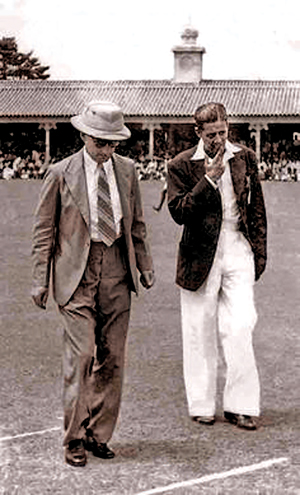
The modern generation may not have heard of Mahadevan Sathasivam (1915-1977), generally referred to as ‘Satha’, and certainly not watched this mercurial batsman in action. He is considered by most of the older brigade as the best-ever batsman Ceylon/Sri Lanka produced. He captained three nations, Ceylon, Malaysia and Singapore! In the two decades ending 1960, he lit the nation with his electrifying batsmanship–both here and in parts of India. Gamini Goonesena said: “During my time I have played with or seen the best batsmen in the world, and I rate Satha as the best of them all.” Stanley Jayasinghe, commented: “I can recall a masterly 96 runs ‘Satha’ scored out of a total of 153, when Ceylon struggled against a visiting Commonwealth team on a rain-affected pitch at the Colombo Oval in February 1950. The bowling attack comprised Australians George Tribe and Fred Freer, George Pope (England), and Frank Worrell (West Indies). Little wonder, Worrell referred to ‘Satha’ as “the best batsman he had seen.” The second highest scorer was schoolboy Stanley Jayasinghe (17), batting at No.9. He described his own innings as all from the edge of his bat, while ‘Satha’s innings was “all from the middle of the blade. I was simply hypnotized watching him from the other end.”
Of course, those were tributes by players, not writers. It was not easy to pay adequate tribute to a batsman of this calibre. ‘Satha’ was the ultimate Musketeer of cricket. He “cut, glanced and drove, upright and lissome. His cricket was of felicity and no power, giving joy to the connoisseur.” I saw him make a 3-figure score at the NCC grounds, in a Quadrangular game again a Mercantile XI, and like Stanley, I was transfixed. His batting was music.
Old timers still wax lyrical about the batting of ‘Satha’. It was all about the panache of a man who used to prance down the pitch to spinners and pacemen alike and dismiss the ball from his regal presence, even after a bout of debauchery the previous night. All the stories about him that still abound him are true!
The writer too, once had the privilege of playing against him in a ‘friendly’ fixture at the Oval in March 1957. Remember ‘Satha’, then aged 42 years. The Royal College team was having a midweek ‘practice’ game against Tamil Union, in preparation for the forthcoming Royal-Thomian encounter. ‘Satha’ walked into bat wearing a silk shirt fluttering in the wind, with a cap worn rakishly, slightly askew, a white hanky knotted round his neck and his bat held between right arm and chest. I was hoping my skipper would not want me to bowl at this apparition! However, this time, Patrick Poulier, our medium paceman, had to bell the cat.
“Looks an old man Pat, why don’t you try him with a bumper first-up” I suggested. ‘Satha’, batting from the tennis court end took guard, and Pat obliged. ‘Satha’ casually deposited the ball onto the roof of the pavilion. He then called Pat and asked his name. “Poulier, Sir”.
“Are you anybody of Hilton Poulier?” “He is my father, Sir” beamed Pat. Hilton Poulier was also an opening bowler who played for Ceylon under Dr. C.H. Gunasekera. “Your father would have told you not to pitch the ball on your half of the wicket. You must pitch the ball so that the batsman has to hurry his stroke and force him to error”.
As Pat was getting back to his mark, the writer whispered: “Pat, that was a fluke, give him another.” In came Pat, bounding with all the exuberance of youth, and hurled yet another bumper. ‘Satha’, was on his back foot, muttering: “I told you………” and the ball was last seen soaring over the pavilion!” I was next seen patrolling the outfield!
Famous Indian, Test off-spinner Ghulam Ahmed (1922-1998), who played in the decade ending 1958, unequivocally declared: “The best batsman I’ve bowled to is Sathasivam from Ceylon”. Remember, Ahmed had bowled to the likes of the three W’s, Hutton, Compton, Sobers, Kanhai, Neil Harvey………et al. Obviously, Ahmed must have recalled the dashing double century ‘Satha’ made when the Ceylon Cricket Association XI met the South India XI in February 1947, and scored a magical 215 runs in 248 minutes – a ground record at that time. The bowling attack comprised three bowlers of Test level. And thereby hangs a tale. The Manager of the Ceylon team wagered that, if ‘Satha’ made a double hundred, he would be sent on a week’s holiday to Bombay. The Manager did fulfill his promise! Lack of space prevents the writer from describing further memories pertaining to this legend.
The Tamil Union has paid tribute to Satha’s memory by naming a part of the pavilion in his name with the notation “The bat was a magic wand in his hands.” Perhaps the older members of the Club may remember who made a written suggestion in this regard. Indeed this was the first occasion any Club paid tribute to a player in this manner. Later, Bloomfield and SSC followed this practice.
Links to further reading
- M.Sathasivam by Alfie Gogerly Moragoda CCS
- Sathasivam the batting maestro By Edmund Dissanayake
- M.Sathasivam by Christie Seneviratne
- M. Sathasivam was not guilty - From the Daily News
- M.Sathasivam - 'Not Guilty' from the Sunday Island 11/4/04
- Sathasivam sent by Naveen TK
- Mahadevan Sathasivam Cricket Legend of Sri Lanka by Premasara Epasinghe Sept 2009
- Sathasivam the bowler brings victory to Wesley by Edmund Dissanayake 29/11/11
 |
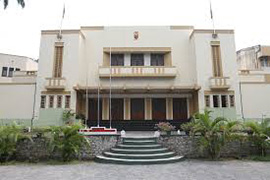 |
It is in the fitness of things that the Wesley-Trinity inter school match scheduled for January 12 and 13 at the Asgiriya Stadium will be played for the R. L. Kannangara Memorial Trophy.
It would be well nigh impossible to find another who has made such a tremendous contribution in diverse capacities, be it noted to these two Christian institutions as Ritchie Kannangara.
The unintiated and those less long in the tooth may be inclined to ask, "Ritchie who?'. If that were so, it would be a shocking injustice to a flannelled gentleman who, by all accounts, played his cricket with immeassurable grace and infinite style. Diminutive in stature, this left hand bat and purveyour of left arm medium pace, played for his alma mater, Wesley College, from 1914 to 1917, captaining the school in 1917.
Just as McGrath targets the leading batsmen in the opposing team (Lara, Tendulkar, Atherton) for special attention, so Ritchie Kannangara picked on the leading adversaries of his day to make an indelible impress. Thus, he made 129 not out against Royal in 1916 and went one better in 1917, scoring 153. This was his annus mirabilis, the year in which he also charmed his way through an unbeaten 121 against Trinity (his haven to be in the hills) added a third century and, just for good measure, topped the inter school batting averages.
On leaving school he turned out for Bloomfield Cricket Club, the Ceylonese Upcountry team and All Ceylon. His national appearances were by necessity restricted by the fact that after the study of law, Ritchie Kannangara decided to embark on a teaching career. He threw in his lot with Trinity and the association was mutually rewarding.
Briefly, as coach of the senior team, and more lengthily as coach of the junior teams, he ensured a steady supply of impressive cricketers - everyone of them moulded in his image : that of a very "perfect gentile knight". In the case of Ritchie, the style was the man.
At Trinity, he lived life to the fullest, taking part in almost every field of activity. Headmaster of the Lower School and teacher of English in the Upper, in the case of Ritchie, the word's "well at the boding tremblers learned to trace/that day's disasters in his morning face" do not apply.
Stern he was when the situation demanded it. But more often than not, the twinkle in his eye was the perfect giveaway.
In the field of cricket, whatever he touched, he adorned. Borrowing a quotation from the celebrated Bertie Wijesinghe, twenty five years his junior: "Ritchie moved with smooth lithe grace ...... and then he touched the ball with flowing blade, wand like in his small hands... persuasion rather than force."
Ritchie played his cricket in an age when the game was played for sheer pleasure and strong bonds of friendship were extablished. Mercifully, the Guptas and the Johns had not yet begun to taint and tarnish the noble game. Present-day cricketers of Wesley and Trinity could with advantage adopt Ritchie Kannangara as their role model.
"He nothing common did or mean upon that memorable scene." (Andrew Marvell)
Links to further reading
 |
 |
The second oldest inter-school cricket fixture in the country will be played at Campbell Park on the 16th and 17th February 2018 for the 125th year between two of the finest educational institutions, Royal College and Wesley College for the Sir Frank Gunesekera Shield.
The first encounter between the two schools was played in 1893 at San Sebastian Hill, Hultsdorf which was the home ground of the Royalists. Royal was Captained by F.S. De Silva while Percy de Bruin captained Wesley. The Royalists won the inaugural encounter by 53 runs. The only break in the series came in 1943 when the grounds of both schools were taken over by the British during the Second World War.
The shield is named after a famous Ceylonese Senator, an old Royalist Sir Frank Gunesekera who was the Deputy President of the Senate of Ceylon in 1948. Both Sir Frank and Dr. Lucien had connections with both Royal and Wesley. Although both were educated at Royal, Sir Frank resided close to Wesley at the junction of Campbell Place and Baseline Road near the Welikade prisons. His two brothers Eric and Donald both studied at Wesley and played cricket for school in 1908 and 1910. The former ended up as Vice Principal and lived at Karlsruhe Gardens right in front to the Wesley Principal and Vice Principal’s bungalow. Their sister Irene too lived there.
Sir Frank, whose portrait hangs in the Royal College hall, was a brilliant student winning the Thoburn prize for the Best All-Rounder in 1904. The chief guest Sir Henry Blake predicted success in whatever career he chose. Five generations of Gunesekera’s have studied at Royal and Wesley College, including Eric, Donald, Elmer, Terrance, Lal, Chrysantha, Nalin, Rohith, Hiran, Sharmal, Sivaji, Shivantha, Rajiv, Tharindra and Anujith.
It was in 1969 that Dr. Lucien Gunesekera presented the Sir Frank Gunesekera Shield in memory of his father which Wesley became the first recipient in the famous last ball victory under the leadership of Amaresh Rajaratnam. Sporting declarations by both sides made the match one of the, if not the most interesting of the 125 encounters played between the two schools.
Batting first, Wesley scored 260 for 9 while Royal replied with 207 for 7. With a lead of 53 runs in the first innings, Wesley declared at 105 for 8, setting the Royalists a target of 158.
The game ended in one of the most thrilling finishes when the Royalists were bowled out for 148 in the last ball of the last over of the game, giving Wesley a famous 9 run win.
Wesley’s reign was short lived, as Royal won it back the following year, leaving Wesley with no option but to wait for another 42 years to taste victory, reclaiming the trophy in 2012 under the captaincy of Ashen Fonseka.
The centenary encounter was played as a three-day match played at the P.Sara Oval in 1993 where Royal was captained by Gamini Perera and Wesley was captained by Teheran Rasool. After bowling Wesley out for 103 runs, Royal posted a mammoth total of 411 for 6 with the Captain himself scoring an unbeaten 152. The match ended within two days when Wesley was skittled for 112 in their second innings, giving the Royalists an emphatic innings and 196 run victory. Nalliah. Rajan’s brilliant bowling earned him a match bag of 10 for 43.
In 1906, C. A. Perera of Wesley made 108, becoming the first ever Wesleyite to score a century against Royal. Another interesting feature of this longstanding encounter was when Danesh Dissanayake scored centuries against Royal in 1988 and 1989 while his father Edmund Dissanayake too scored 107 in 1946. They remain the only father-son duo to score centuries against Royal.
The record for the highest individual score is held by the former Royal skipper Chulaka Amarasinghe who scored an unbeaten 207 in 1983 while Roshan David’s 199 in 1990 stand as the highest for the Wesleyites. M.L. Warish holds the bowling record for Wesley against Royal taking 9 for 17 in 1897. Warish’s match bag of 14 for 48 in that match still continues as a record for both schools.
Over the 125 years both schools have produced some outstanding and great cricketers, a few that come to mind are Dr. C.H. Gunasekera, Sargo Jayawickrema, Col .F.C. De Saram, Sathi Coomaraswamy, C.I. Gunasekera, Gamini Goonasena, Fritzroy Crozier, Darrel Lieversz, Jayantha Amerasinghe, Gajan Pathmanathan, Asitha Jayaweera, Ranjan Madugalle, Rohan Jayasekera, Sumithra Warnakulasuriya, Sudath Pasqual, Asantha De Mel, Chulaka Amarasinghe, Roshan Jurangpathy, Jehan Mubarak and Kushal Janith Perera from Royal with the famous M. Sathasivam, S. Gunasekera, R.L. Kannangara, A. Mylvaganam, S. Nagendra, I.H. Walbeoff, H.L. A. Matthysz, Edmund Dissanayake, Lucky Goonetilleke, M.N. Samsudeen, Lou Adihetty, the Claessen brothers, Bryan, Radley and Herman, the Harmer brothers Russell, Mervyn and Granville, Darrell Maye, the Jeganathan twins, Sritheran and Hariharan the Fuard brothers, Ansar and Abu, L.C.R. Wijesinghe, Amaresh Rajaratnam, Tyronne Jansz, Dilangen Jayasekera, Mahendra Dissanayake, Ganesh Mylvaganam, Navin De Silva, Sanjeeva Wijesingha, Dharshika Jayakody, Roshan David, Danesh Dissanayake, Farveez Mahroof and more recently Ishan Jayaratne and Jeffrey Vandersay playing for Wesley. Some of these gentlemen went on to represent the country.
The Royalists are the current holders of the shield, having won it in 2015 under the captaincy of Harith Samarasinghe.
Giving a synopsis of the second oldest schools cricket fixture in the island leading to the 125th year, Royal have won 50 with Wesley winning 22 encounters while 52 matches were drawn.
Celebrating the 125 years of cricketing encounters in 2018, the Royalists will be looking to hold on to the Sir Frank Gunesekera shield under the Captaincy of Pasindu. Sooriyabandara while the Wesleyites under the leadership of Thusaraka Akmeemana will be shifting all gears to bring the shield back to Karlsruhe Gardens. Whatever the outcome may be both sides are bound to provide the cricket loving spectators an entertaining game.
The Chief Guest for this memorable encounter will be former Wesley and Sri Lanka Schools under 19 cricket captain, Capt. Navin De Silva. Navin began playing 1st XI cricket in 1978 and ended captaining Wesley in 1981and 1982. He was a dashing batsman who feared no bowler and a right arm fast medium bowler deceptive with speed.
Many of his knocks were dazzling and worth going miles to watch. Considered to be one of the finest cricket captains in the 80’s, Navin was selected to lead the Sri Lankan schools team on its first ever cricket tour to England in 1981 with Arjuna Ranatunga as his deputy.
The tour was a success with Sri Lanka remaining unbeaten a great achievement at that time. The side consisted of players of the calibre of Aravinda De Silva, Marlon Von Haght, S.H.U. Karnain, Graham Labrooy and Rumesh Ratnayake. Navin went on to be adjudged the best schools captain and best all-rounder in school cricket in 1981.
Invitation to past cricket captains of Royal and Wesley
To commemorate the 125th cricket encounter between the two schools, the past captains of both Royal and Wesley are invited to be present at 2.30 pm on Saturday, the 17th February 2018 for a photograph after which a special memento will be presented to them.
By Dinesh Weerawansa
 Former Sri Lanka Test and One Day International player Ferveez Maharoof was yet another promising star to emerge through the Observer Schoolboy Cricketer contest, sponsored by Mobitel.
Former Sri Lanka Test and One Day International player Ferveez Maharoof was yet another promising star to emerge through the Observer Schoolboy Cricketer contest, sponsored by Mobitel.
Following the unveiling new millennium stars of the Mega Show with Trinity’s Kaushalya Weeraratne in 2000 followed by Kaushal Lokuarachchi of St. Peter’s in 2001 and Sahan Wijeratne of Prince of Wales in 2002, Wesley College produced its first ever Observer Schoolboy Cricketer of the Year in 2003.
Born on September 7, 1984, Maharoof won the Observer Schoolboy Cricketer of the Year in 2003 following a highly successful school career for Wesley College.
Young Maharoof took to cricket when he was eight years old and also showed interest in football and touch rugby until he was twelve years. But from that age, little Maharoof continued his cricket career seriously as a wicket keeper-batsman. He began bowling regularly from under-13 level.
In one match, the hidden talents of Maharoof came to light when five regular bowlers of his school team were down with flu. Maharoof was called upon to bowl and rose to the occasion by capturing six wickets, including a hat-trick and from then on concentrated on fast bowling.
His rich harvest for Wesley was crowned with a highest innings of 243 and best bowling figures of 8 for 20. Having won the Observer Schoolboy Cricketer of the Year in 2003, he was immediately called to make his debut in the following year. Also in 2004, he was appointed captain of the Sri Lanka under-19 World Cup team.
Immediately after winning the Observer Schoolboy Cricketer of the Year award in 2003, he was picked to represent Sri Lanka ‘A’ in a tri-series with India ‘A’ and Pakistan ‘A’ in India in December-January 2003-2004.
He came out with flying colours, capturing nine wickets in the series at an average of 11.77, the best average of the tournament. Maharoof was named Man of the Match in the tournament’s final, which Sri Lanka ‘A’ won. A month after this, he was appointed captain of the Sri Lanka Under-19s for the Under-19 World Cup.
He had a memorable experience and in the game against Australia, he scored 56 to help his team to victory, an effort which earned him the Man of the Match award.
Maharoof was a member of the Sri Lanka team that toured Zimbabwe for five ODIs and two Tests in April-May 2004.
Two players, including Maharoof, made their ODI debut in the third match of the series while three of the Sri Lankan regulars were rested.
He grabbed the opportunity by taking three wickets as Zimbabwe were bowled out for 35, the lowest score in ODI history. In the last two matches of the five-match series, Maharoof took another two wickets, finishing the series with five at an average of 16.60 and made his Test debut on the same tour. Across the two matches, he scored 40 runs in the Test and took four wickets.
Delhi Daredevils bought him for USD 225,000 in the inaugural edition of the Indian Premier League (IPL) in 2008.
Maharoof did justice for the deal by capturing 15 wickets in the tournament at an average of 16.60, making him the joint ninth-highest wicket-taker in competition.
The six foot three-inch all-rounder represented Sri Lanka in 22 Tests, scoring 556 runs with three half centuries including a career best 72 and captured 25 wickets.
Batting at number nine, he had scored 40 runs on his Test debut on May 6 in Harare against Zimbabwe which the visitors won by an innings and 240 runs.
Maharoof had played 109 ODIs for Sri Lanka, aggregating 1113 runs with an unbeaten 69 as his career best. He made a memorable ODI debut for Sri Lanka, with a magical spell of three overs, one maiden, three runs and three wickets in Sri Lanka’s nine wicket win over Zimbabwe in Harare on April 25, 2004.
It was Chaminda Vaas (4 for 11), Maharoof (3 for 3) and Dilhara Fernando (2 for 18) who produced tight spells to destroy Zimbabwe for a record 35 runs in 18 overs.
Maharoof took 4 for 23 against Bermuda to start the 2007 World Cup and became the first Sri Lankan to capture a four wicket haul on his World Cup debut. On 7 October 2007 Maharoof took his 100th wicket in his 75th ODI; at the time he was the fastest Sri Lankan to reach the landmark, beating off spinner Muttiah Muralitharan by one match, however this record was later grabbed by paceman Lasith Malinga in 2010 who reached 100 wickets in 68 matches.
Maharoof took his first hat trick in One day Internationals against India in the Asia Cup 2010 on June 22, 2010.
The Observer-Mobitel Schoolboy Cricketer of the Year is organized by the Sri Lanka’s oldest national newspaper the Sunday Observer and sponsored by the national mobile communication provider SLT Mobitel. This is the 12th consecutive year in which Mobitel is providing its financial support.
Mobitel’s financial support has taken the Observer-Mobitel Schoolboy Cricketer of the Year contest to great heights and has not only helped to improve the quality of the contest with lucrative price money but also has helped to reward coaches and masters-in-charge of champion teams.
In a unique gesture of goodwill and fair play, a special award for the best behaved team too is on offer. This award was added to the glorious award list on a suggestion made by none other than the first recipient of the most sought after award in school cricket Ranjan Madugalle, the current Chief Match Referee of the ICC, who won the title in 1978-79.
Chief Executive Officer of Mobitel Nalin Perera has done a splendid job towards the success of the show under the guidance of the Chairman of Sri Lanka Telekom and SLT Mobitel Kumarasinghe Sirisena.
Chairman and Managing Director of Lake House, Krishantha Cooray has always guided the organizing committee of the Observer-Mobitel Schoolboy Cricketer of the Year with positive ideas.
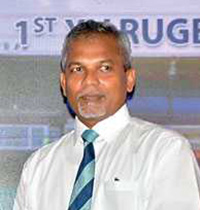 Wesley College has experienced 64 golden years of rugby, since it officially started chasing the oval ball in 1956. Rugby at Wesley has grown tremendously in stature and popularity to make Wesley College one of the top rugby playing schools in the country. I quote an excerpt from an article from the Rugby 50th anniversary magazine written by Eddie Buell, Wesley's inaugural captain, to illustrate the humble beginnings. And also an excerpt from late Peter Christie Casie Chitty from the same magazine.
Wesley College has experienced 64 golden years of rugby, since it officially started chasing the oval ball in 1956. Rugby at Wesley has grown tremendously in stature and popularity to make Wesley College one of the top rugby playing schools in the country. I quote an excerpt from an article from the Rugby 50th anniversary magazine written by Eddie Buell, Wesley's inaugural captain, to illustrate the humble beginnings. And also an excerpt from late Peter Christie Casie Chitty from the same magazine.
EARLY BEGINNINGS FROM EDDIE BUELL
“In the early 50's I had not seen a Rugby match, a Rugby ground or a Rugby ball. Then some friends coaxed me to seeing a Rugby match with them. It was Havelock's Vs CR&FC. I was completely intrigued & taken up with the game. For 02 years I watched many games as possible & in the process learned the rules &g of some idea of how the game was played. The urge to play Rugger was now strong in me but there was NO Rugby at school & the only option was to join a club. With much uncertainty I joined CR&FC in 1954 as a student member & from then on got involved in the game, like a duck taking to water. At that time only Royal, Trinity & St. Peters played Rugby. St. Thomas started in 1955 & St. Anthony’s Kandy & St. Josephs came in about that time. In 1955 whilst attending Rugger practices at CR & FC, I was also playing Hockey for Wesley & Mr. D'Aberea was the hockey master. I spoke to him about starting Rugger at Wesley and he was very supportive and agreed to speak to Mr. Oorloff, the Principal who gave the green light. I spoke to Mr. Alfie Koelmeyer of CR & FC and sought his support. Mr. Koelmeyer arranged for Mr. Fred Kellar to coach us whenever he could and also obtained some used balls from CR&FC for us. e then measured out a Rugby ground at Campbell Park and arranged for the rugby kit whilst at the same time finding & encouraging boys to come for Rugger. In the late 1955 we started practices, drilling in the individual & unit skills, fitness training & teaching the rules. Then the 1956 season was on and we had a team ready. We played about 04 matches that season and the 1st match was against Royal at Campbell park, whilst we lost narrowly by 03 points.”
WESLEY'S LOVE AFFAIR WITH RUGBY - BY PETER CHRISTIE CASIECHITTY
“Wesley College officially chased the oval ball around in 1956 we are told. Eddie Buell, who later skippered Air Force was outstanding, led Wesley's chase. By the early 60's with Nigel and Michael Christoffelsz, the clubs were interested in Wesley after Ranjith Abeydeera was making headlines for the Airmen. Ranjith Abeydeera was the 1st Wesleyite to represent the national team. Darrel Maye known for being the schoolboy cricketer of 1963 and Reggie Bartholamuze who later captained Sri Lanka were two other outstanding players. Mention must be made of "Jaadi" Silva (J.A. de Silva) who as captain brought the best result. Wesley had produced players like Cavan Gamier (Havelocks" Hooker), Peter Smith, Haig Classen (wing forward), William Deutrom (full back). They all took off to Australia and Wesley changed attitudes. Kalu Cader and Asoka Jayawardena), the Dorai brothers, Zubair and Farcy had all played club rugby and shone. Bashurdeen Musafer who later played for Army as full back was also Wesley's.”
RUGBY REVIVAL
In 1988 under the leadership of Shalan Rupasinghe and Shiraz Jaldin Wesley revamped the ability to be among the top league. In the early 90's Kishan Musafer played the big league representing CR & FC and captaining the club,is the longest serving national player for Wesley. Since the revival in 1996 with the involvement of Ransiri Sahabandu, Clive De Silva and the Class of 90's, Wesley produced national players in the likes of Zulfikar Halimdeen and Junior Tuskers in Razil Doray, Lahiru Boteju, Ziard Thahir, Steve Perera and Mahes Samarasinghe. In the millennium Wesley reached the pinnacle by being within the top four on many occasions in the league, and became finalists in the Knock-outs resulting in clinching the knock-out championship under the captaincy of Rahul De Silva in 2013. Furthermore, the millennium paved the way to produce many Junior and Senior nationals in the caliber of Lahiru Boteju, Kasun De Silva, Henry Terrence, Samantha Lakshan, Niroshan Karunanayake, Dulanjan Wijesinghe, Dulaj Perera, Rahul De Silva and Joel Perera. Niranjan Wickramaratne, Shehan Dias and Sithum Pieris who represented the shorter version by being members of the National 7's team.
I will be failing in my duty if I don’t make mention about the ever vibrant late Mr. N. J. Mudannayake. In 1985 when Wesley's rugby was at a dismal level, no staff member was willing to be in charge of it. Many players begged Mr. Mudannayake to take it on and he did even though He didn't understand a forward pass from a late tackle. Though he lacked knowledge of the game he compensated for it with his administrative skills, and put us on the School Rugby map. We owe a great deal of gratitude and sincere appreciation to this unsung hero of Rugby at Wesley. With the introduction of Paul Toia (A New Zealand Maori) as the consultant cum Head Coach there is transformation of attitude among players and we are beginning to notice the change gradually. Being "humble" has been the main theme of the transition. Thanks to the utmost support and blessings of our Principal Mr. Avanka Fernando who is a great enthusiast in promoting great values and keeping up to traditions and Wesley's rich culture through sports.
This year together with the Principal the Rugby Development committee will launch the Wesley College Official Rugby Ball to coincide with the 145th Founder's Day on March 01, 2019. The event will be graced by the ex -All black Rodney So'oialo. Launching of an official rugby ball itself will be a land mark as it is done for the first time by a school in Sri Lanka. While making history the event will be used as a fund raiser by presenting the limited edition memorabilia balls in the category of Platinum, Gold and Silver autographed by Rodney So'oialo to our generous old boys and well wishers. This ambitious undertaking will be to raise funds in aid of a multipurpose training facility for all sports, comprising a modern gymnasium, physiotherapy centre, meeting room and an office room for all coaches.
The 2019 rugby season is scheduled to commence on March 03, 2018 with Kingswood College for the L.E. Blaze trophy. This is the year Wesley will field a formidable team led by Murshid Zubair, son of old Wesleyite, and Ex National and CR player Zubair Doray. We request the whole fraternity to rally around the team in every possible way to encourage and motivate the Double Blues to create history.
Some Memories of Rugby at Wesley over the years
From the Double Blue International
Links to further reading
- When did Rugby arrive at Wesley?
- Fifty years of Rugby at Wesley by Keith De Kretser
- Reflections by Bashur Musafer
- Wesley Rugby 1961-63 By Trevor Collette
- Rugby Reflections – Ishan Ali (California USA)
- Reflections of Wesley Rugby from New Zealand – Frederick(Erick) Forster
- Rugby Memories – Reg Bartholomeusz (Melbourne, Australia)
- Rugby Reflections – Keith de Kretser (Melbourne,Australia)
- Reflections – Bill Deutrom (Australia)
- Double Blues Vs Trinity Lions at Bogambara Kandy (1959) – Neville Ludowyke(Melbourne, Australia)
- Rugby Glory at Bogambara by The Flanker
- My coaching days at Wesley – Reg Bartholomeusz (Australia)
- Rugby the ultimate Team Sport – Bachchi Oumar, USA
- Fifty years of Rugby at Wesley - Celebrations
- Some Rugby recollections by Olkie Edema
- Cricketers of 1953 - Sent by Olkie Edema
- 1st XI Cricket Team 1936 captained by HN Duckworth
- Wesley Rugby XV April 1960 - Sent by Michael Christoffelsz
- Wesley take under 20 rugby title 2005 sent by Yohan Ferreira
- Wesley clinch Under 17 Milo Rugby Cup - 2004 by Chris Dhambarage
- Wesley takes WP Under17 Rugby title 2003
- A historic win - Wesley beat Trinity at Rugby (2002) from Yohan Raju
- Wesley Rugby players are going great guns By M. Shamil Amit
Kindly sent to me by R.A Murad Fahmy
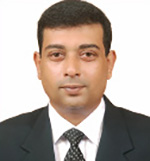
Wesley College Colombo First XV Rugby Team - 1981
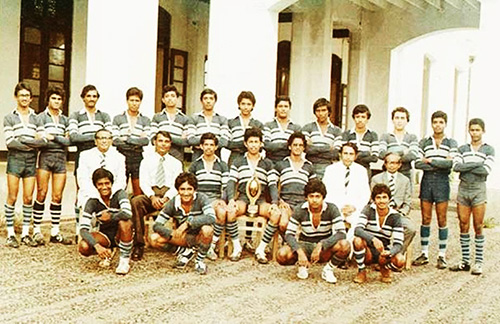
Winners of the Tyrrel Muttiah Trophy
Standing L to R:
Seated L to R: Squatting L to R:
Wesley College Colombo First XV Rugby Team - 1982
Standing L to R: Seated L to R: Squatting L to R:
Wesley College Colombo First XV Rugby Team - 1983
Standing L to R: Seated: L to R:
Wesley College Colombo First XV Rugby Team - 1978
Standing L to R: Sitting L to R:
Wesley College Colombo First XV Rugby Team - 1977
Standing: left to right : Seated: left to right : Absent After a few setbacks at the very beginning of the 1st round of the Singer League when we were pitted against strong teams such as Royal, St. Peters and Kingswood, Wesley began to dictate terms from the moment we defeated St. Thomas in the final game of that round, not only retaining Sir Oliver Goonetilleke Trophy but also qualifying for the 2nd round of the league.
In the second round we displayed a splendid brand of Rugby defeating teams such as Trinity, St. Joseph’s and Isipathana securing the fourth position in the league. In the Milo knockout that followed we reached the final and was narrowly beaten by St. Peters after acquiring a comfortable lead in the 1st half. In the final analysis it was distinctly clear that Wesley had emerged as a major force among the cream of the School rugby circuit.
Our talented squad was fittingly felicitated to a grand celebration and dinner at a leading hotel at the conclusion of the Season.
Looking back in retrospect we owe the success of our rugger team to several key personnel. We are grateful to our head coach Mr. Paul Toia for introducing a brand new culture to rugger before he bid goodbye to us after serving 3 years.
Wesley College First XV pool: The successful 1st XI Cricket Team of 1961 The successful 1st XI Cricket Team of 1962 A few past Cricketers from the 1960’s hosted Glen Reimers and his charming wife Jill and daughter Karen to dinner at the OWSC on 7th of January 2020.
It was an extremely joyous occasion full of camaraderie with tales from the past being exchanged and related by all. He was visiting the country of his birth after 2012, having attended the Wesley Reunion held that year.
Glenn played 1st XI Cricket under Nalendra Abeysuriya in 1959 and subsequently was a leading member of the Cricket Teams of Senthil Sinniah and D Kodithuwakku in 1960 and 1961 respectively. He was a stylish right hand batsman who was technically correct having come under the tutelage of the renowned Cricket Coach BJH Bahar at Wesley. Unfortunately Glenn migrated to Australia with his family in 1961 and missed out playing for Wesley in 1962 though eligible to do so. Glenn demonstrated his immense talent at cricket by playing district Cricket for South Australia in the mid sixties and was also selected to the pool of the South Australia State side along with the likes of Ian Chappell during this same time. Subsequently having moved to Victoria he represented the Colingwood Cricket Club later on.
A typical Srilankan dinner of Stringhoppers and spicy curries were enjoyed by all, during the evening, prepared by the OWSC Kitchen, run by an Old Wesleyite.
At the end of the proceedings Kenneth De Silva addressed the small group present to say thank you to Glenn Reimers and family for gracing the occasion. Glenn responded by returning the courtesy extended.
Among those present to welcome Glenn and family were L.R Goonetilleke, Kenneth De Silva, L.C.R Wijesingha, Milroy Muthuveloe, Sarath Wickramaratne, C.T Rodrigo, O.K.Hemachandra, Dalkin Samidon and their spouses.
At the conclusion having said their goodbyes all left with the fervent wish to meet again .
It was such a pleasure to see Glenn and Robin Reimers when I was in Melbourne in 2009. Fifty years is a long time when we were at school enjoying those youthful years. Cricket was what united us. At Campbell Park we beat the drums and sang the songs under the “Mara” trees as the cricketers toiled and entertained us. Despite the years, oceans and continents that separate us there is a certain closeness that will remain with us forever.
Lalith (L.C.R) was my classmate in the 6th form. As I burnt the midnight oil poring over my books he was busy playing cricket. But he came to his own in later years to become a respected geologist. The colourful Doyen of Wesley Cricket, Mr Edmund Dissanayake said Lalith was the best captain he had in all his years as a master in control of cricket at school. That was indeed a lavish expression of admiration, high praise and honour bestowed by our finest and best loved coach. We all know he excelled as a captain leading an unbeaten team.
Sarath Wickramaratne was my classmate from Std 2 right up to the 6th Form. We’ve had many good times together at school and thereafter. Whenever I visited SL he took me out for dinner to his favourite watering-holes.
O.K Hemachandra and Dalkin Samidon were fantastic footballers playing for the 1st XI at school. We have remained in contact on WhatsApp. It was such a great pleasure to see Milroy Muthuvaloe, Kenneth De Silva and C.T Rodrigo at the Great Reunion of 2012. Kenneth and I go back a very long way being boarders together playing soft ball cricket in the small park. With his tubby fingers he gave some vicious spin to the ball which mesmerised the batsmen. We thought then, it was the gravel and stones that made the ball deviate so much!!
L.R Goonetilleke is from Nugegoda where I lived and grew up. It was such great joy to see him in London in the summer of 2019. With Senthil Sinniah and I.D Raymond we had a wonderful time together recalling and reminiscing those years gone.
It is so lovely to get news of old friends and also to know they have all met up together to relive those great years in the now famous Railway Carriage. I wish each and everyone of you good health and the very best in the coming years.
As for Glenn Reimers the “Chief Guest” – May you continue to enjoy the goodlife and friendship of those most loyal old boys in Australia and in particular, Melbourne.
I just wish I was there with you at the OWSC Railway Carriage to raise a glass and join in the fun From the Great Reunion of 2012 The death of Radley Classen in Adelaide Australia last month brought to an end the famous Classen family that dominated school cricket in the fifties playing for Wesley College. Radley was the last survivor of the quintet of brothers born to the Classen family who lived down Thimbirigasyaya at the time.
Mohamed Nakeem Samsudeen who terrorized batsmen with his deadly and deceptive left-arm swing bowling had the privilege of opening the bowling with Radley Classen when he captained Wesley College in 1952. On hearing of the death of Radley, Samsudeen who was very close to the
Classen family rolled back the years to throw light on the achievements of this famous triumvirate of brothers – Bryan, Radley and Herman who represented Wesley College with distinction. Two of the brothers Douggie and Herbert did not play cricket, but branched into other fields.
“Radley played only in that year with me before moving to Colombo Colts CC where he played a little cricket before migrating to Australia. In the year he captained we played our first match against the powerful Josephian team that included Ken Serpanchy and Roy Perera and we beat them. That year we were unbeaten and the team comprised players like Patrick Shockman, Musafer the wicket-keeper, Bryan Classen, Ansar and Abu Fuard, Neil Gallagher, Chapman, Herman Classen, Lou Adihetty, Jurangpathy and myself.”
The Classens looked to have a bright cricket future ahead of them when tragedy struck one of the brothers and with it the interest for the sport also died.
Recalling the incident Samsudeen related, “Bryan was working and with his first salary he brought a British made Velocette motorcycle and put his younger brother Herman behind him and they went to the Regal theatre to see a film. When they were returning a car came and knocked them down and Herman died from the accident.
“Herman was a real Bill Johnston (former Australian bowler) type of bowler. He was very tall and bowled left-arm. He was a fantastic bowler who could have gone very far but unfortunately his career was cut short. All three brothers were coached by that legendary coach at Wesley Alban V Fernando.
“Bryan was the famous of the three, a fine all-rounder - leg break and googly bowler and a top order bat. He was of short stature and could hook any short-pitched ball. He got into the All-Ceylon side for his batting. He was the best batsmen at the time in school cricket.”
Five years later in 1960 when Pakistan Eaglets toured Sri Lanka, Samsudeen set up a new record by being the first Sri Lankan bowler to take all ten wickets in an innings against a visiting team playing for Combined Services at the CCC grounds. He had figures of 14.2-3-26-10 as the touring side was shot out for 40 in a matter of 85 minutes. At 79 he spends his life in retirement at Thalawatugoda.
At the conclusion having said their goodbyes all left with the fervent wish to meet again .
I deem it a privilege and an honour to be asked to pen a piece on Mahadevan Sathasivam by my editor Sujith Silva. He was indeed the greatest batsman produced by Sri Lanka in the pre test era and even later.
Having played with him after a successful career at St. Benedicts College
in the twilight of his career, I can vouch for the fact that even then he carried himself like a Maharaja and showed that he was twinkle toed as he carried all his God given strokes and displayed them. I hope I have done justice to this great cricketing son of Sri Lanka.
When after watching the 'SATHA' magic with the bat. Sir Garfield Sobers, the West Indian marvel, called 'SATHA' 'the greatest batsman ever on earth'. Sir Frank Worrell the gentleman West Indian captain and all rounder tagged 'SATHA' 'the best batsman he had ever seen'.
SATHASIVAM captained All Ceylon and had the honour of making the toss with the greatest batsman ever born, SIR DONALD BRADMAN whose star-studded team in 1948 was on their way to England (March 27, 1948 at P. Sara Oval also known as Colombo Oval). The Australians came to be named the 'INVINCIBLES' for winning the Test series and remaining unbeaten on tour.
Ghulam Ahmed, the unplayable left arm Indian captain and spinner when asked about SATHASIVAM had this to say. 'I have bowled at Bradman, Harvey, Hutton, Dennis Compton, Keith Miller, the terrible Ws - Weekes, Worrell and Walcott. If you ask me who is the most difficult batsman that I have ever bowled, to I will mention a name that you may not know adding 'He is M.Sathasivam of Ceylon in Chennai.
That was when in the game between Southern India and Ceylon Cricket Association at Chepauk in February 1947. In that game SATHASIVAM made an elegant and exquisite 215 in 248 minutes with 24 fours. He eclipsed England's Joe Hardstaff's ground record of 214.
SATHASIVAM was born on October 18, 1915 in Ceylon. A stylish right hander played in only 11 first-class games scoring 753 runs from 18 innings. He had 3 centuries and 3 fifties. He started his career at St. Joseph's College before switching on to Wesley College where his career began to blossom.
'Don't bounce on me son, I am an old man'. This is what the batting genius MAHADEVAN SATHASIVAM told Burgher Recreation Club pacemam Dennis Ferdinands when Ferdinands bounced on 'SATHA' on the fiery matting wicket at Havelock Park in a 'Donovan Andree Trophy game.
But Ferdinands a young buck just out of S. Thomas' College, Mount Lavinia was the fastest paceman in the schools in the late 1950s. He came dashing in and let fly another bouncer on SATHASIVAM.
What one saw was the next moment was the ball landing on the trees at
with the umpire raising his hands signalling six. Twinkle toed 'SATHA' even at the twilight of his career moved in line with the bouncer and played the hook shot, textbook style and Ferdinands stood flummoxed.
Such was SATHASIVAM'S mastery and the batting arrogance of his illustrious career. I played in that Tamil Union team of 1962. I mentioned this incident to Professor Ravindra Fernando when he was writing the book- 'SATHASIVAM OF CEYLON, the batting legend'. But it was inexplicable why Professor Fernando failed to quote me and acknowledge me on this incident in his book.
Back to that incident and in the return game at the Colombo Oval turf Ferdinands got even when he bounced and stuck SATHASIVAM a glancing blow on his brow. SATHA' took the strike in his stride.
These incidents took place after the great man returned from retirement from Malaya where, in addition to sporting Sri Lanka colours as a batsman and captain, he also showed his prowess playing for Malaya and later Singapore. The stories told about the debonair SATHASIVAM are legion and they are all well documented in Fernando's books for posterity which are a collector's items.
I did not have the opportunity of watching the maestro dazzling with the bat in his heyday using it like a magic wand to scatter bowlers all over the field or over it, excelling especially with the square cut that even had the blades of grass rising in honour and paving pooja to this great batsman.
But it was a great pride and honour for me to have played with and under him when he was in the twilight of his glittering and epoch making career. What a pleasure it was in later life to keep his exalted company when I was Sports Editor of the 'Times of Ceylon' and 'Daily Mirror'. Gamini Perera my journalistic colleague and I would enjoy a drink with at the Taprobane or Otters his water holes while listening to his humour and relishing the many anecdotes he could unwind and keeping his exalted company.
During his reign as the king of the willow, he was exciting to watch. His twinkle toed footwork to get to the pitch of the ball and sending it screeching to the boundary piercing the tight set field or over it with exquisite timing was the hall mark of his batting excellence. When a bowler pitched short, he square cut or would dance back and execute his brilliant square cut that sped to the boundary like a shot from a gun.
SATHASIVAM was amazing with his drives, pulls, hooks, square cuts and in fact all the shots were from the book with strokes all round the wicket and his improvisation was pure magic.
During his reign as batting king, he made his bat do the talking, and it was a great honour to him and the country when he was compared with terrible 'W's of West Indies cricket - Clyde Walcott, Everton Weekes and Frank Worrell.
And of the many scintillating knocks he played - fifties, centuries he is best remembered for the magnificent double hundred - 215 - he made in Chepauk, India in 1947 for the Ceylon Cricket Association.
In addition to his prowess with the willow he was a graceful ball room dancer and the fair sex who danced with him would always tap him on the shoulder acknowledging his skills in dancing too.
It is said that he brought out the best in his batting the next morning after partying till the wee hours of morning. He would rush down to the ground, take a shower and then don pads and to the amazement of his team mates and the opposing bowlers he would craft out a terrific hundred as it was his usual routine showcasing his array of stroke with arrogance, disdain and brilliance.
One of 'SATHA'S' contemporaries was another former Sri Lanka cricketer who like good wine needs no bush. He was GERRY GOONERATNE the former Josephian Saracens and Sri Lankan Cricketer.
Getting Sathasivam out was no easy task. In a game between Tamil Union and Saracens, Gooneratne planned the strategy days ahead to lure SATHASIVAM to his demise.
Came match day and to quote former Nalanda, University and Saracens opening batsman and wicket Premasara Epasinghe. 'Once I had the good fortune of playing for Saracens against Tamil Union. Nalanda's coach, former ever green, Gooneratne captained the Saracens. Gooneratne as a successful captain had 'foxed' SATHASIVAM many a time. His ploy was simple. In that particular match Gooneratne used his crafty off spinner former Nalandian Mahinda Athulathmudali, when SATHASIVAM arrived at the crease. Gooneratne laid a trap. He got the lanky off spinner to bowl three deliveries outside the off stump.
Gooneratne instructed the bowler to allow 'SATHA' to play his famous square cut. The fourth ball spun from middle to leg. SATHASIVAM moved and cut it. Gooneratne applauded 'SATHA'S' beautiful square cuts 'Nice shot SATHA', 'beauty SATHA' and encouraged him to go for his pet shot freely. The fourth ball, he misjudged and cut through gully uppishly. Goonerate diving to his left held a brilliant catch to dismiss 'Satha'.
One personal note - as one just out of school from St. Benedict's College, Kotahena after five years of successful cricket with a hat trick to boot and as captain and then at Tamil Union, when I got to know that I was going to play under the great man, I got the jitters.
SATHASIVAM had got to know of me as a leg spin, googly bowler and even before the shine had gone off the ball, he tossed the ball to me and asked me to have a bowl. This was in a game at the Oval against Negombo CC which team had the hard hitting josephian Ben Fernando and he had scored heavily in the previous games.
When Fernando took strike, SATHA shouted 'get him out son'. I bowled a googly which pitched right and crept along the turf to bowl a bewildered Fernando. SATHA who was fielding at mid-off walked up to me and said - 'son if you play for Ceylon, say I predicted it’. These same sentiments were also expressed by former Trinity captain, and All Ceylon cricketer Bobby Schoorman when I switched clubs and played for BRC after watching me bowl at the nets. These sentiments by two 'greats' are still vivid in my memory.
It was a God given opportunity to play alongside the greatest batsman of all MAHADEVAN SATHASIVAM and as legends go SATHASIVAM was it.
Regarded as one of the best if not the best Batsman ever produced by Wesley College and Ceylon. 'Satha' was a colourful Cricketer, a master stroke player and a prolific run scorer. Only player known to have captained three nations in Cricket; Ceylon (against Australia in 1948), Singapore and Malaysia (against Australia & Hong Kong in 1959-1960). Satha's life inning which was flamboyant on field and off-field and later embroiled in controversies surrounding his wife's murder where he was acquitted after trial and spending time in judicial custody came to end on July 9th 1977) When he passed away from a heart attack in Colombo.
Represented Wesley College 1st XI (1934-36) and his 142 runs against a start studded S. Thomas' College side led by Donald Fairweather in 1936 stands out. 11
1934 - Played for Wesley College 1st XI under A.R.Musafer
1935 - Played for Wesley College 1st XI under the captaincy of Henry Van Buuren coached by John Halangoda. Sathasivam who is known as a batsmen ended the season as the best bowler for Wesley College. Wesley College remained unbeaten having beaten Royal College and Trinity College. Also played against St. Thomas’ College, St. Joseph’s College and Richmond College. Mahadevan Sathasivam took 2 for 16 against Royal, scored 80 runs and 73 and captured 5 for 81 against St. Joseph's College, scored 30 against St.Thomas' College, 4 for 47 and 5 for 30 and 31 not out Vs Trinity College
1936 - Played for Wesley College 1st XI under the captaincy of Henry Duckworth. Best performance 142 against S. Thomas' College. Wesley College managed to secure a win against St. Joseph’s College.
Represented All-Ceylon against visiting English, Australia and West Indies teams or Ceylon Cricket Association on tours to India. In 11 matches scored 753 runs in 18 innings with 3 centuries and 3 fifties.
Represented Tamil Union C & A, at club level and his best have been against S.S.C 167 in 1945 and 163 in 1947. Satha also played for the Rest in the Bombay Pentangular and scored 101 against Bombay Muslims, which included a big partnership with Vijay Hazare. Across all levels he has scored 44 centuries with 4 double centuries.
Represented All-Ceylon against visiting English, Australia and West Indies teams or Ceylon Cricket Association on tours to India. In 11 matches scored 753 runs in 18 innings with 3 centuries and 3 fifties.
Three of Satha's best
1947 - 215 at the M.A Chidambaram Stadium (also known as Chepauk Stadium), India against South India breaking the then ground record of 213 runs (Joe Hardstaff, 1939)
1945 - 111 at Colombo Oval against visiting Indian team led by Vijay Merchant included bowlers like Lala Amarnath, Shute Banerjee, Vinoo Mankad, CS Nayudu, Vijay Hazare and Rusi Modi.
1950 - Scored 96 out of a total of 153 on a sticky wicket at Colombo Oval against the visiting Commonwealth team which included West Indians Frank Worrell, Geo Tribe, Fred Freer and Geo Pope who were considered invincible then. Picture by Dilwin Mendis - Moratuwa Sports Special
Wesley College, Colombo were going great guns during the 1968/69 inter-school first eleven cricket season under the astute captaincy of Amaresh Rajaratnam and with the guidance of their experienced coach and past Wesleyite cricketer Edmond Dissanayake. Half way of the season they were unbeaten having beaten Kingswood, Richmond and more fancied St. Joseph’s College, Colombo.
It was 51 years ago the Reid Avenue boys Royal College, the masters of turf cricket travelled to Campbell Park under the leadership of Eardley Lieversz to take on Wesley College who were the masters on matting wicket. The Royalists with a star studded outfit took it easy with the blessings of their coach former All Ceylon cricket captain and old Royalist F.C. de Saram. In cricket you must never underestimate your opponents and so it proved.
This game turned to be Amaresh versus Lieversz and a tussle between Dissanayake and de Saram.
Amaresh called the coin correctly and decided to take the first lease in a dried matting wicket with a fast outfield and his gamble paid off with Wesley declaring at an amazing 260 for 9 with Sridharan Jeganathan making a top score of 65 and Patrick Janz 51. Healthy contributions came off the bats of Jayantha Wijemanne 37, Tuan Sinen 23 and Hariharan Jeganathan 21. When stumps were drawn on day one the Royalists were 100 for 4 with Lieversz scoring 52 and the game was evenly poised. On day two the visitors declared at the milk interval at 207 for 7 in the hope of an early break through. C. A. F. Samarasekara scored 43 and Beverly Paul was unbeaten on 43. Sritharan Jeganathan claimed 3 wickets for 84.
Royal’s gamble paid off as almost all the Wesley top order batsmen were back in pavilion with the score at 45 for 7 and an overall lead of only 98 runs with three wickets intact. Ivan Vandort joined Delmer Achilles and the pair put on a valuable unbeaten partnership of 60 for the eighth wicket and at 5.40 p.m. Wesley declared giving Royal an easy target of 159 runs to score in 70 minutes for an outright win.
Royal openers Jagath Fernando and Thalayasingham put on 49 runs in 18 minutes and Jagath got out for a hectic 38 which included 7 fours. Then the collapse started. Royal had to score 20 runs with 4 wickets intact. They lost their ninth wicket in the penultimate over and one over was left to score 11 runs for victory.
At this stage Rohan Wickramaratne was bowling a nagging length without conceding runs from the Baseline Road end. To the dismay of everyone he was changed and Amaresh commenced bowling. Last man J. Thalayasingham was the striker and all the spectators were on their toes. Amaresh bowled his first ball but the batsman had no intension for going for a victory and the Wesley spectators wondered why as the score remained on 148 for 9.
Amaresh bowled another four balls and the batsman played it down without giving an opportunity of getting out. The last ball was a full toss which is a dangerous ball in bowling. The batsman did not offer a stroke and the ball rapped the batsman on the pads and he stood flat footed right in front of the wicket. Not only all the eleven players appealed but all the Wesley supporters shouted, “How is that Umpire”. Head umpire Anton Lappen without any hesitation raised his finger. All the Wesley supporters thronged onto the ground and carried their heroes to the pavilion on their shoulders. Thus Wesley College recorded a good double under Amaresh by winning the Lifebuoy Trophy and the Sir Frank Gunasekera Memorial Challenge Trophy. This encounter amply proved that cricket is a funny and a glorious game with a lot of uncertainties.
Scores:
Wesley College 260/9 dec. (Haritharan Jeganathan 21, Tuan Sinen 23, Jayantha Wijemanne 37, Patrick Jansz 51, Sritharan Jeganathan 65) and 105/8 dec. (Delmer Achilles 31 n.o., Ivan Vandort 29 n.o.)
Royal College 207/7 dec. (Eardley Lieversz 52, C.A.P. Samarasekera 43, Beverly Paul 45 n.o., S. Jeganathan 3/84) and 148 (Caldera 45, Jagath Fernando 38, Trevor Janz 4/47) 'Having led at half time 13 - 8, I don’t think anybody at this venue would have thought that there would be a period of something like 15 minutes of magic. Wesley played 7’s Rugby ladies and gentlemen - beautiful stuff - to have Trinity back peddling to that extent nobody would have ever thought. But credit to Trinity; they played excellent Rugby right through the final whistle.’ That was the animated voice of Haritha Perera at the post match presentation of the 2013 Milo Knockout finals.
Wesley came into existence in 1874, and introduced the oval shaped ball game in 1956 with Eddie Buell receiving the honour of being the first skipper. For 56 years the school did not have a major rugby trophy in their cabinet; until Rahul de Silva and his boys decided it was high time to create a blockbuster award winning performance in 2013.
Always tagged as the underdogs, Wesley first reached the President’s Trophy final in 2002, but Zulker Hamid’s invincible Royal boys were too tough for Lahiru Boteju’s blues and lost 6-20. In 2004, they featured in the finals again, and this time lost at the hands of traditional rivals Kingwood 13–31.
Then it was the waiting game for the Campbell Park boys. For eight editions they witnessed two other schools battling for glory. Finally, their dream became a reality when the 2013 team got the better of 2012 runner-up and 2011 knockout champions, Trinity College, after an inspirational comeback. With that win Rahul de Silva went into history as the first and only Wesley skipper to win the Milo Knockouts.
Born on 13 October 1994 to Navin and Ruveni de Silva in Colombo. Rahul was the middle child between two sisters. His father Navin was a remarkable man who excelled in all aspects of life, maintaining a few unique records of his own. Navin was a decorated Wesleyite, a perfect all-rounder. He was the Cricket Captain, the Athletics Captain, the House Captain, and also the Head Boy of the school. In 1981, Navin was made the captain of the Sri Lanka Schools Cricket team that consisted of players in the calibre of Aravinda de Silva, Arjuna Ranatunga, Rumesh Rathnayake, Graeme Labrooy, Charith Senanayake, Ravin Wickramarathne and Ashley de Silva, who went on to become some of Mother Lanka’s great cricketers.
The team led by Navin went on to become the first Sri Lankan schoolboy cricket team to play against an English schoolboy cricket team when they toured England in 1981. Unfortunately, Navin did not continue with the game as he opted to become a pilot at SriLankan Airlines, which was known as Air Lanka back then. He became the youngest captain of Air Lanka at the time. Had Navin continued with the game, he could have gained fame and happily retired as one of the greatest all-rounders. In the eighties, Navin was quite a revelation, who could pack a punch and bowl good medium pace.
Making Wesley his alma mater from Grade one, the sport Rahul first engaged in was cricket, for obvious reasons. He was ten when he started, but the kid could not resist falling in love with the oval shaped ball. With time, practices clashed and the boy had to make a serious decision. Rahul found cricket a tad more boring than rugby and he did not favour the time consumed by cricket. After playing a couple of seasons of cricket for the first XI team, Rahul decided to bid farewell to cricket and concentrate more on the hooligans game.
Just like his father, Rahul had many achievements and held many leadership positions in his final year in school. Rahul was appointed Rugby captain and House captain and made deputy head boy. As Rahul says, the 2013 Rugby league and the knockouts were an entire movie to them. “We were placed 4th in the league, but we definitely could have finished higher as we started the season very strongly and were right up there.
But there were some issues while the tournament was going on, and we were not fully involved in training. We were not even sure whether we can play the knockout. The outstation boys went back home and we had to get them back. The toughest game for us was the semi-final clash against Dharmaraja. I consider that as the finals. They were the league champs and we lost to them in the league 24–36, but came back strongly in the semis 22-13,” Rahul refreshed his memory of 2013.
Wesley started the league on a high, beating the previous year's knockout winners Pathana 23–21, then blew the Josephian challenge 38–24, won against St. Anthony’s 32–17, before going down pretty badly to Royal 12–30, and narrowly to Trinity 19–22. Against Kingswood nothing could separate the two sides as they drew eight each. De Silva’s boys then lost to Dharmaraja and St. Peter’s won over Science to hold on to the 4th spot of the league. It was astonishing to see the Wesley boys coming back strongly to win both the semis and the final against two teams that they lost to badly in the league, after winning the quarters against Science 20 -17.
On 13 July 2013 Royal Sports Complex was packed with supporters from both schools. When Referee Jamaldeen’s stopwatch struck halftime, the boys from the hill country were leading 13-8. Wonder what motivation was given to the boys by Coach Henry Terrence and his support staff during the break, but the double blues looked a different outfit in the second half. Ten minutes into the second half the Campbell Park boys had three tries to their name through winger Ishaq Jurangpathy in the 46th minute, a minute later by Hooker Thisara Maduwantha and then in the 50th minute by Fly Half Joel Tillekeratne, with skipper Rahul converting two of them. With three tries in four minutes the Wesleyites were leading 27-13.
The lads were on a roll and four minutes later in the 54th minute Centre Ishara Madushan’s try sealed the deal for the determined boys. 14 minutes of stunning, magical rugby. Nizam Jamaldeen’s whistle sounded to mark an emphatic 34 - 21 victory to the boys from Campbell park. The man who brought about this remarkable change in Wesley’s fortunes in 2013 was former Wesley, CR and FC and Havelocks Prop Forward Henry Terrance. “It was an amazing feeling and we were like celebrities in school. The school has been playing rugby for over 50 years and for the first time in the history of the school, we had a win of this calibre,” said Rahul.
After his school career Rahul was appointed vice-captain of the Sri Lankan under-20 team that toured Korea to play the Under-20 Junior Asiad. Straight after school in 2013 Rahul joined CR and FC and was with them until 2015 before crossing over to Havelock’s. In 2016, Rahul was seen playing for the Sri Lanka senior team. In the same year, Rahul decided to pursue his higher studies in Australia and attended University of Swinburne, Melbourne. Even though Rahul’s main intention was to study, he did not let go of his passion and love for the game. Rahul joined Box Hill SC in Melbourne and continued to play the game there, while he used to take the flight back to the island during his summer holidays (November - March) to play for Havelocks. Rahul graduated in 2018 with a Bachelors in Business Management and decided to come back. He rejoined his first club CR and FC and played for them as scrum half. Rahul joined John Keells to pursue a professional career and is contemplating on continuing with the game.
“Sports made me a better human being altogether. It taught me many aspects of life. Building team spirit and being flexible are few traits I gained. What I see is that there is a vast difference between people who have engaged in sports and not. In the work place it is very easy to blend and work with people who have been engaged in sports.” Rahul touched on how sports has added to his personality.
The love for sport ran in the DNA of de Silvas. Apart from Rahul and Navin, Rahul’s Mother, Ruveni was also engaged in Netball and Athletics during her days at Ladies College. His older Sister, Neshika captained the Ladies College Hockey team, while his younger sister Sulani was a complete all-rounder who captained the Athletic, Netball, and the Water Polo teams of Ladies College the previous year (2020). In an era where parents want their kids only to excel in studies, Rahul considers himself lucky to have grown up in a sports background. He received great support and motivation from his family that helped him to do what he loves perfectly. “Sports runs in our blood, and it made it very easy for me to choose what I want and love.
Nobody pushed me to make decisions. I was given freedom to choose what I want, that's how it was easy for me to choose Rugby over Cricket even though my father loved Cricket. I see a lot of parents pushing their kids to make certain decisions, which they actually do not like. That should not happen, more freedom should be given for kids to choose the sport they love to be engaged in. Parents should always support the kids, but should not force them in a way that they will hate what they do. My advice to the young kids is to do what you love and to train hard,” elaborated Rahul on the support he received from his parents and his advice to parents and kids.
Maintaining fitness and being active is one essential element for any athlete. Even though the COVID-19 Pandemic did put a halt on it, Rahul decided to maintain his fitness and to be busy. He got himself qualified online as a fitness trainer and maintained his fitness by joining Island Spit Fit, a fitness centre conducted by former national rugby player Hasitha Perera, and then later after receiving an invitation from Hasitha, Rahul decided to help them by conducting a few fitness classes.
Executive at John Keells, 27-year-old Rahul now aims to concentrate more on a professional career and move up the ladder at JKH, and also hopes to engage in coaching and give back something to his beloved school.
Just like his father who was very patriotic to this paradise nation, Rahul too decided to come back and contribute to the country, after completing his studies in Australia.
Wesley and St Benedict’s are two of the oldest and leading Christian Colleges with shared Christian values based in Colombo North. They first played Cricket in 1896 and over the years there have been periods where this cricket fixture has not taken place, the last being in 1975. Over the past year negotiations have taken place to resume playing. On 3rd march, the Principal of Wesley, Mr Avanka Fernando and the Rector of St Benedict’s signed an Memorandum of Understanding (MOU) at The Auditorium at St Benedict’s College to resume playing cricket against each other. There will be two fixtures
Two Day match played for the Rev James Cartman Trophy and 50 over fixture for the Bro. Luke Shield
Rev James Cartman(Principal of Wesley 1944-1949) was a strong supporter of Cricket during his stewardship and Bro. Luke a dedicated teacher and supporter of Sport at St Benedict’s. Wesley and St Benedict’s College are the only two Colombo schools that don’t have a big match However the expressed wish of both schools is that the match is not a Big Match. The first encounter will be played towards the end of April.
Below are some photos from the signing of the MOU (source www.owsc.lk) St. Benedict’s College and Wesley College will turn a new leaf in their cricketing history when they clash in the inaugural Inter-Schools Under-19 cricket encounter today and tomorrow at Kotahena.
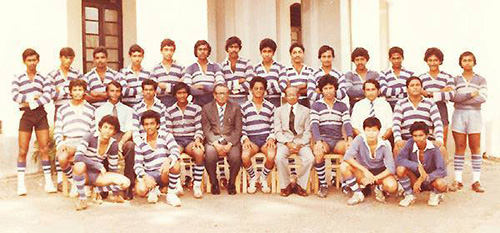
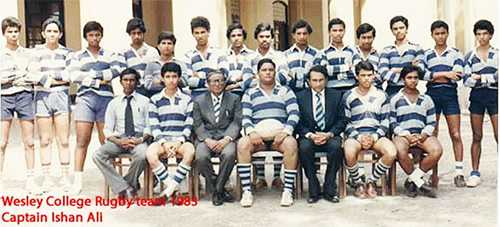
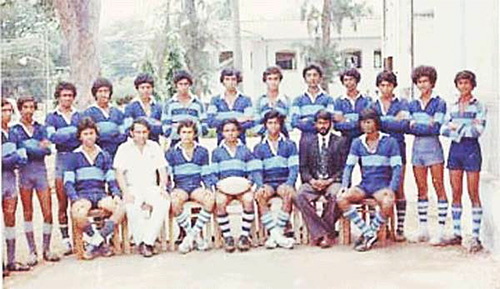
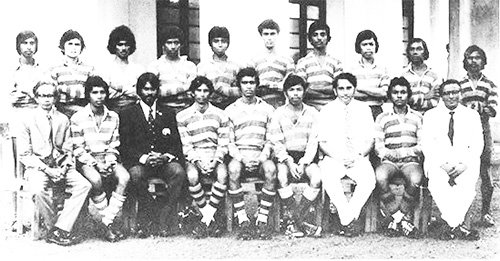
Kindly sent to me by R.A Murad Fahmy

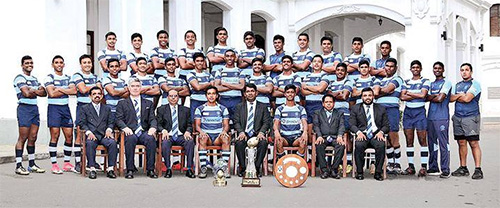
Kindly sent to me by L.C.R.Wijesinghe
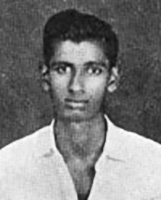

Meeting friends and recalling memories at the OWSC - Restaurant
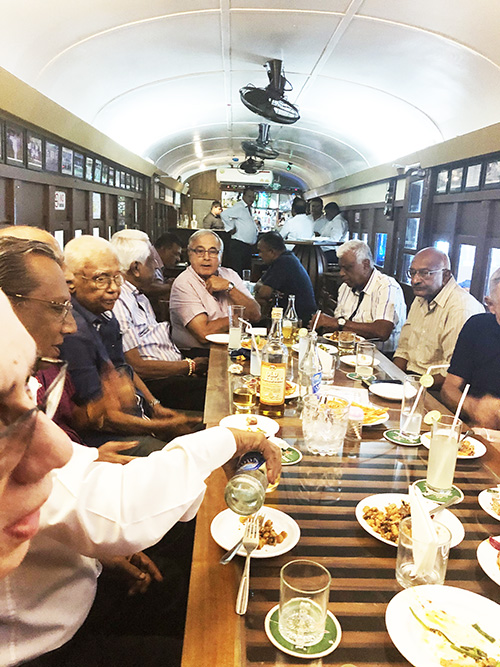
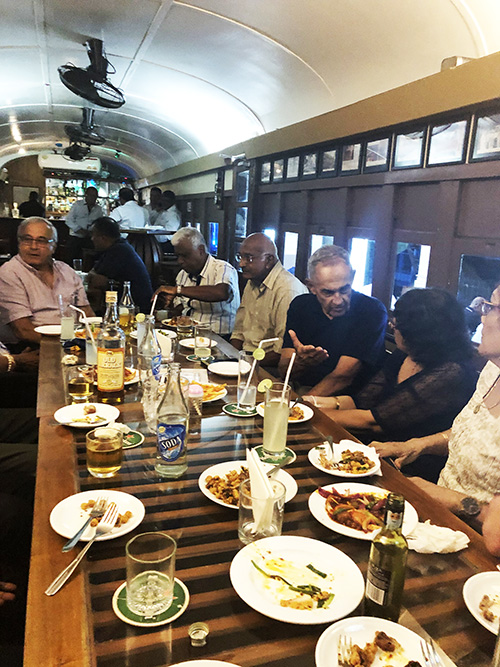
The Memorable Cricket Teams

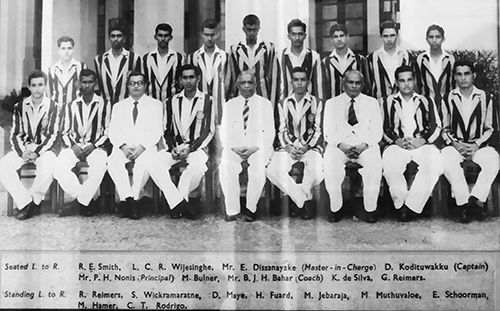

An evening with Glenn Reimers and family at the OWSC by L.C.R Wijesinghe
Some interesting reading
Links to further reading
A Footnote from the Editor - Nihal D Amerasekera

From the Sunday Observer February 16th 2017
 “The year Radley captained Wesley his brother Bryan was his vice-captain. Radley was the opening bowler and I shared the new ball with him,” recalled Samsudeen. “Radley was a right-arm fast bowler famous for his short-pitched bowling. He was a specialist of that delivery and in one match he broke the teeth of Peterite opener Vitachi.
“The year Radley captained Wesley his brother Bryan was his vice-captain. Radley was the opening bowler and I shared the new ball with him,” recalled Samsudeen. “Radley was a right-arm fast bowler famous for his short-pitched bowling. He was a specialist of that delivery and in one match he broke the teeth of Peterite opener Vitachi.
 The following year (1953) when Bryan took over the captaincy, Samsudeen recalled Wesley became the best school’s team. “Radley opened batting and bowling for Wesley. He opened the batting with Abu Fuard and he became very popular because of his bowling. He had a long run up and was able to bounce the ball much to the discomfort of the batsmen. He was appointed a counselor for Sri Lanka in Australia and a Justice of the Peace. He had a very good reputation in Australia,” said Samsudeen. “When he once came down on holiday, Rienzie Wijetilleke (the former Hatton National Bank chairman) hosted a dinner in Radley’s honour and all his team mates were invited for it. That was the first visit he made to Sri Lanka after he migrated he looked very fit. On a later date when he came down Radley was like his father very fat and old.”
The following year (1953) when Bryan took over the captaincy, Samsudeen recalled Wesley became the best school’s team. “Radley opened batting and bowling for Wesley. He opened the batting with Abu Fuard and he became very popular because of his bowling. He had a long run up and was able to bounce the ball much to the discomfort of the batsmen. He was appointed a counselor for Sri Lanka in Australia and a Justice of the Peace. He had a very good reputation in Australia,” said Samsudeen. “When he once came down on holiday, Rienzie Wijetilleke (the former Hatton National Bank chairman) hosted a dinner in Radley’s honour and all his team mates were invited for it. That was the first visit he made to Sri Lanka after he migrated he looked very fit. On a later date when he came down Radley was like his father very fat and old.”
 “All were males in that family – Bryan, Radley, Douggie, Herbert and Herman. The mother’s pet was Herman the youngest fellow he was my classmate also. When he died the mother was terribly upset, she gave up coming to see her sons playing cricket. Before the accident she was a regular visitor to all the matches her sons played. They used to travel in their Bug Fiat which their father who was one of the directors at Collettes owned and, they also found some room for me as well. However with Herman’s tragic death the entire family gave up cricket and when the mother also died the father took the rest of his family to Australia.
“All were males in that family – Bryan, Radley, Douggie, Herbert and Herman. The mother’s pet was Herman the youngest fellow he was my classmate also. When he died the mother was terribly upset, she gave up coming to see her sons playing cricket. Before the accident she was a regular visitor to all the matches her sons played. They used to travel in their Bug Fiat which their father who was one of the directors at Collettes owned and, they also found some room for me as well. However with Herman’s tragic death the entire family gave up cricket and when the mother also died the father took the rest of his family to Australia.
 Samsudeen who represented Colts and later the Navy is renowned for playing for two teams on the same day and also taking all ten wickets in an innings against a visiting team. In 1955 Samsudeen represented Wesley against Royal in two-day match. His fine bowling (3/26) enabled Wesley to beat Royal by lunch on the second day. He then rushed to represent Colts half an hour later in a Sara trophy match against Tamil Union and opening the bowling took 2 for 26. He also held four catches in the Tamil Union innings.
Samsudeen who represented Colts and later the Navy is renowned for playing for two teams on the same day and also taking all ten wickets in an innings against a visiting team. In 1955 Samsudeen represented Wesley against Royal in two-day match. His fine bowling (3/26) enabled Wesley to beat Royal by lunch on the second day. He then rushed to represent Colts half an hour later in a Sara trophy match against Tamil Union and opening the bowling took 2 for 26. He also held four catches in the Tamil Union innings.
In Memoriam
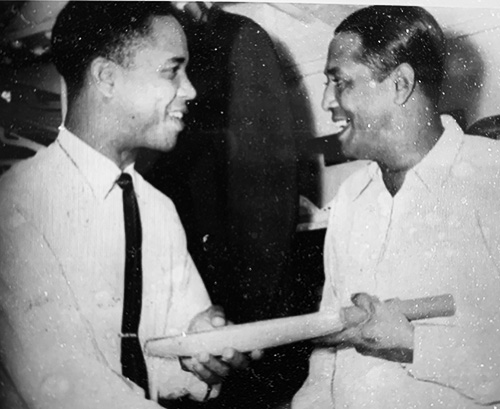
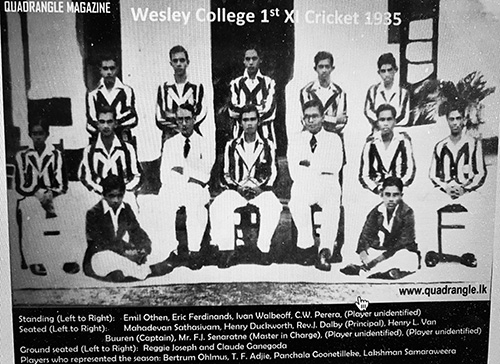
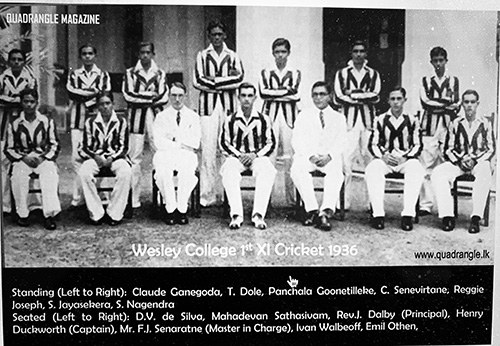
Mahadevan Sathasivam (1915--1977)
Links to further reading
WESLEY COLLEGE FIRST ELEVEN CRICKET TEAM 1968/69
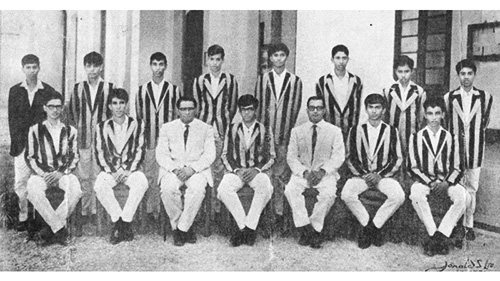
Kindly sent to me by Keith de Kretser
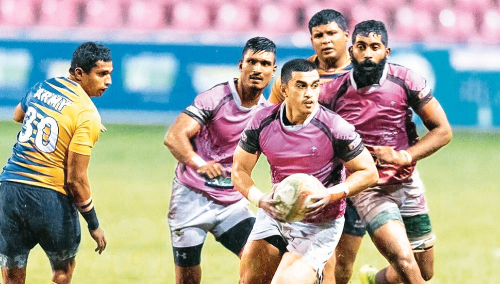
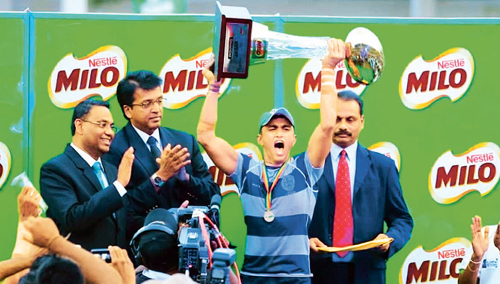
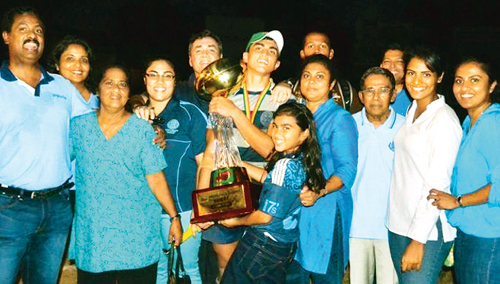
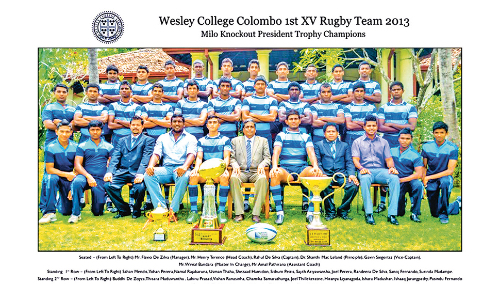
Kindly sent to me by Keith de Kretser
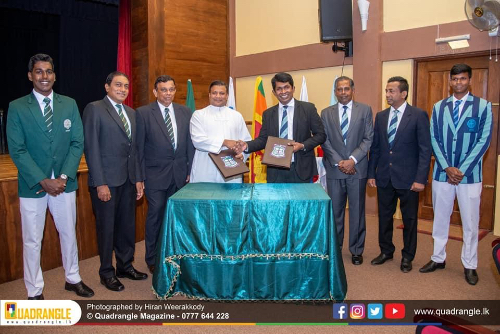
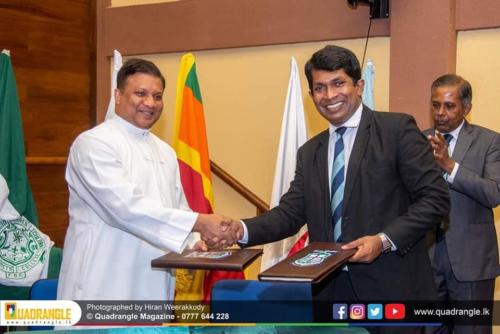
Wesley First XI Cricket Team

Standing (From left): Lakshan Ruwantha, Disula Yapa, Semila Liyanage, Linal Subasinghe, Rakitha Fernando, Anudith Wickremasinghe, Denuwan Mendis, Sanithu Amarasinghe, Kushan Chamalka, Yohan Anthony, Akaz, Dawood, Tilshan Senanayake, Ravindu Sigera and Tharanga Fernando
Both teams of course, could not make it to the quarter-finals of the limited over tournament and will be determined to make an impact in this vital encounter. Wesley Head Coach Keerthi Gunaratne expressed his confidence of his team performing well in this encounter after a successful season. “We have fared very well against the big teams and we did not lose a game despite playing without a fast bowler for most of the season.”
St. Benedict’s First XI Cricket Team

Standing (From left): Hasanga Nanayakkara, Sharujan Shanmuganathan, Isuru Lakshan, Chamath Chathurya, Yohan Soysa, Sachin Senanayake, Dilan Malintha, Akindu Karunarathne, Ashen de Zoysa, Vidun Weerawardane, Ashwin Dalan, Himalka Oshen, Aveesha Sandaruwan, Nethan Fernando and Viduneth Wilson
“Our main fast bowler Zakirthan from Batticaloa is back in the side after recovering from dengue and our batting has a lot of depth, with the tail-enders also contributing well.” “In the limited over tournament we suffered some injuries but could not make it to the final round. Fast bowlers will be our main weapon but we also have a good spin attack as well,” he said.
“I am expecting a more disciplined performance from the batsmen because when they score 30 or 40 runs they think everything is fine and they throw their wickets away.”
“The Kotahena track is not a good wicket for batting and it has been always low scoring. I don’t know whether they have prepared a special wicket for this match and we got to go and check on that.”
“The outfield at Kotahena has improved a lot. But the track is turning and the ball is coming low. I think they are not watering the wicket enough.”
However, St. Benedict’s Coach Trishen Nonis said that the surface at Kotahena is quite good for both batting and bowling and the wicket could last even four days.
“True, we got out for a low score in the first innings against Gurukula but we recovered well in the second innings and altogether over 400 runs were scored,” he stressed. “We started our preparations rather late unlike some of the other schools in Colombo and it took some time for the players to settle down and play their normal game.”
“We will miss two of our senior players due to injuries but I am confident that the team will play to their true potential and pull off a victory,” he added.
The inaugural Big Match between Wesley College and St. Benedict’s College played for the Cartman Cup, ended in a draw
Wesley scored 228 for nine in their first innings while in the second innings they scored 90 for five wickets declared leaving a target of 179 to their opponents.
St. Benedict’s were bowled out for 139 in the first innings and were 47 for one in the second innings when the match ended.
Chief scores
Wesley: 228/9 decl (Sahil Dias 50, Kushan Chamalka 45, Thenuka Perera 42, Sidath Dharmasiriwardena 21, Anudith Wickramsinghe 25, Malinda Perera 6/66) and 90/5 (Semila Liyanage 54, Akindu Karunaratne 4/20)
St. Benedict’s: 139 (Ashen de Soyza 23, Sharujan Shanmuganathen 21, Dilan Thabrew 22, S. Zhakirthan 2/21, Thenuka Perera 3/17) and 47/1 (Kaviru Perera 20).
Kindly sent to me by Dr Indra Anandasabapathy
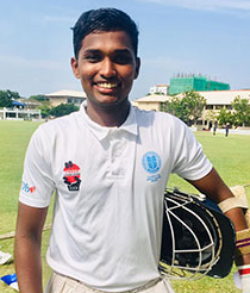 Wesley’s Sahil Dias equalled a schools batting record held by legendary cricketer Mahadevan Sathasivam when he scored 142 runs against S. Thomas’ in their traditional Under-19 encounter which commenced at Mount Lavinia on Friday.
According to Clifford Rodrigo, the Sports Administrator of Wesley College, 142 is the highest score made by a Wesley batsman against S. Thomas’.
“Sahil equalled the record held by legendary Mahadevan Sathasivam. Sathasivam scored 142 against S. Thomas’ in 1936. No one has scored higher than that against S. Thomas’,” Rodrigo told The Island.
Wesley’s Sahil Dias equalled a schools batting record held by legendary cricketer Mahadevan Sathasivam when he scored 142 runs against S. Thomas’ in their traditional Under-19 encounter which commenced at Mount Lavinia on Friday.
According to Clifford Rodrigo, the Sports Administrator of Wesley College, 142 is the highest score made by a Wesley batsman against S. Thomas’.
“Sahil equalled the record held by legendary Mahadevan Sathasivam. Sathasivam scored 142 against S. Thomas’ in 1936. No one has scored higher than that against S. Thomas’,” Rodrigo told The Island.
The National Youth development squad player, who is eligible to play next year as well, scored 15 fours in his knock which was vital in the Thomians reaching 317. Dias faced 202 balls for his knock. Incidentally, the historic series between Wesley and S. Thomas’ is played for the Mahadevan Sathasivam trophy. Match results
Wesley V S. Thomas at Mount Lavinia
Wesley 317 all out in 89.5 overs
Kindly sent to me by Dr Shanti McLelland
Walter Jayasuriya is often referred to as the ‘Father of Sri Lankan Hockey’. He reigned supreme.
PRELUDE TO THE FIRST NATIONAL HOCKEY CHAMPIONSHIPS OF CEYLON 1956
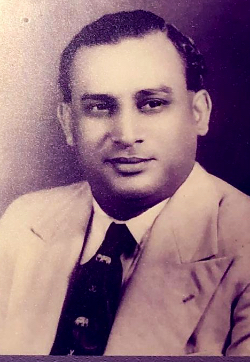 It was the era when mighty India was ruling the world of Hockey, that with the blessings of the President of the then Ceylon Hockey Association, Sir Donatus Victoria, Mr. Walter Jayasuriya (Vice President , Ceylon Hockey Association, rightly and affectionately known to be the father of Ceylon/Sri Lanka Hockey and Mr. T.M. Naz Mahamooth (Hony. Secretary, Ceylon H.A.) a passionate lover of the game, ventured out to Madras in 1955 to witness the 19th National Hockey Championships of India, to be held in Madras. Primarily to learn how to conduct a major tournament of this magnitude, in order to inaugurate our own Nationals.
It was the era when mighty India was ruling the world of Hockey, that with the blessings of the President of the then Ceylon Hockey Association, Sir Donatus Victoria, Mr. Walter Jayasuriya (Vice President , Ceylon Hockey Association, rightly and affectionately known to be the father of Ceylon/Sri Lanka Hockey and Mr. T.M. Naz Mahamooth (Hony. Secretary, Ceylon H.A.) a passionate lover of the game, ventured out to Madras in 1955 to witness the 19th National Hockey Championships of India, to be held in Madras. Primarily to learn how to conduct a major tournament of this magnitude, in order to inaugurate our own Nationals.
Walter and Naz were cordially and warmly welcomed by all the high ranking officials of the Indian Hockey Federation, and even more so later by the officials of the Madras H.A. who were celebrating the success of the Madras H.A. team being Joint National Champions along with the Combined Services HA. Walter was also well known as the Manager of the Ceylon Team that toured Madras and Bangalore in 1953.
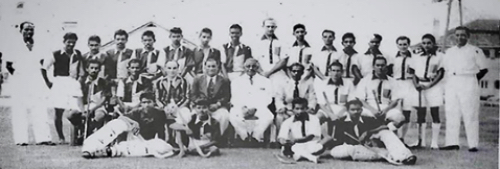

For the record, India won every Olympic ‘Gold’ from 1928 to 1956 (not held in 1940 and 1944 because of WW2).
FIRST NATIONAL HOCKEY CHAMPIONSHIPS OF CEYLON, AUGUST 1956
It was the new Federation’s first baby; the most ambitious hockey tournament in Ceylon, which was conducted on the then Navy Grounds, Galle Face. Thousands floc ked to the venue throughout the tournament to witness the performances of our International and National Players and also some outstanding teenage school boys who were selected to play for respective Associations. The eight Associations affiliated to the Federation were, Mercantile, Colombo, Matale, Kandy, Uva, Jaffna, Government Services, Combined Services (Army, Navy and Air Force),.
Wide publicity was given by all newspapers and the ‘Times of Ceylon; published a special supplement with photographs of all individual players with larger ones of Captains, the Organising Committee and the handsome A.A. Virasingha and Bin Ismail Trophies.
1..Mercantile was described ‘As a Hard nut to crack’ and were pre-tournament favourites.
Hugh Aldons (Captain), International debut against India in 1947. He also played for Ceylon at Cricket and was an outstanding wing-three quarter for Ceylon at Rugger.
Vernon G. Prins, International debut against India in 1947. Also captained Ceylon at Cricket.
Chandra T.A. Schaffter National debut in Ceylon’s tour of South India in 1953 and International debut versus Pakistan in 1955. Also represented Ceylon at Cricket.
Ivan de Kretser, National debut in Ceylon’s tour of South India in 1953 and International debut versus Pakistan in 1955.
V.S. de Kretser (Jnr), National debut in Ceylon’s tour of South India in 1953 and International debut versus Pakstan in 1955.
6/15 – Asoka Perera, B La Brooy, T.S. Adahan, P. Wright, A Savill, K, Sampanthan, D.I. Henricus, Rienzie Perera, H.S. Oorloff and M.E. Thornton.
2. Colombo was described as ‘Here’s a happy blend’.
M.A. Albert (Captain), International debut versus Indian Olympic team in 1948.
Brian J. Assey, National debut with the Ceylon tour of South India in 1953 and International debut versus Pakistan in 1955.
A, Nadarajah, National debut with the Ceylon tour of South India in 1953 and International debut versus Pakistan in 1955.
Malcolm Aldons, National debut versus Delhi Wanderers in 1955.
Dennis A.B. de Rosayro, National debut versus Delhi Wanderers in 1955,
6/15 – Anton D’Costa, B.L. Peiris, S. Crusz, N.W. Gauder, T. Rajaratnam, W. Gunasagaram, T.A. Buhar, M. Muthcumaroe, Don Bosco and L.P. Rayen.
3. Government Services was described as ‘No lack of experience’.
A. Mylvaganam (Captain), National debut. Captain of Ceylon tour to South India in 1953 and International debut versus India in 1947.
Leslie Sellayah, International debut as Captain versus Afghanistan in 1947. Also captained versus India later that year.
Fred Perera, International debut versus India in 1947.
Brindley Stave, National debut with the Ceylon team for tour of South India in 1953 and International debut versus Pakistan in 1955.
Barney Bowen, National debut versus Delhi Wanderers in 1955.
Chandi Chamnugam, National debut versus Madras in 1955.
C.S. Modder, National debut versus Indian Army Southern Command in 1950.
8-15 – Russel Bartels, S.D. Anthonisz, F. Modder, J.G.I. Wijesinghe, I.T. Pakir Ally,
R. Tissaweerasingham, C. Wijeratne, A.M. Jayasekera.
4. Kandy was described as ‘Ready to give any team a run’.
Bertie Dias (Captain), M. Sameen, D.R. Rajasinham, N.R.L. Alwis, W.B. Adhikaram, M.S. Jumar, J.R.E. Paramsothy, Roy de Silva, P. Thangavaloo, S. Weerasuriya, Derrick Harvie, B.S.G. Sahayam, J.W. Jayasuriya, F. Martin.
5. Matale, described as ‘They head outstation challenge’.
S. Subbiah (Captain), National debut with Ceylon tour of South India in 1953.
Herbert Wijekoon, International debut versus Pakistan in 1955.
3-14 – M.H. Fuard, G.H. Chndrasena, R.S. Somasekeram, N. Thilakar, P. Nanayakkara, G.H. Jayatissa, P.S. Hettiaratchi, L.W. Samarakoon, M.S. Musheen, G.H. Rupasinghe, T.S. Salideen, T.S.J. Packer Ally.
6. Uva, described as ‘Speed is their forte’.
Dr. R. Harry Aldons (Captain)
K. Ariyarajah, International debut versus India in 1948.
3-16 – A.M. Somapala, Fred Aldons, Pat Williams, M.I.M. Hussain, R. Mahmoor, M.I.M. Laheer, W.D. Dhar Madasa, M.F. Jamaldeen, A.C.M. Farouk, K.D. Wickramasena, A.H.M. Lafeer, A. Perampalam M.D.I.L. Marikkar, E.R. Dheerasena.
7. Combined Services, described as ‘Fighting fit’.
Ernie Kelaart (Captain), International debut versus India in 1947.
Frederick White, National debut with tour of South India in 1953 and International debut versus Pakistan in 1955.
3-15 – M.S. Ismail, Eddie Baptist, V.C. La Brooy, T. Abeysena, L. Winter, D.C. Ingleton, A. Vigneswaram, R, Meynert, E.R. Rode, R. Sam T, Meyers, P. Francis, S. Peter.
8. Jaffna, described as ‘Dark Horse’ of the tournament.
V. Balakrishnan, A. Mahadevan, T. Emmanuel, T. Anandaratnam, K.V. Thanendran, S. Rajasingham, R.A. Radchakan, V. Rajaratnam, Hugh Muller, S. Thevendrfam, R, Breckenridge, R. Kanageratnam, N.V. Devaraj, S. Balachanmugam
The outstanding teenage school boys who participated were L.P. Rayen, T. Rajaratnam from Colombo, Derrick Harvie from Kandy, R.S. Somasekeran, P.A. Hettiaratchi, G.H. Jayatissa, G.H. Rupesinghe from Matale, A.C.M. Farouk and A.H.M. Lafeer from Uva and V. Rajaratnam from Jaffna.
Anton D’Costa and Don Bosco from Colombo were employed at Heath & Co. and Pettah Pharmacy, respectively.
Dennis de Rosayro from Colombo, employed at Heath & Co. was the only National ‘Cap’, having represented Ceylon versus the Delhi Wanderers in 1955 as a school boy.
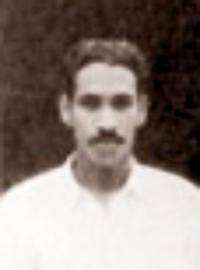 A. Mylvaganam – One of the best players produced by Wesley and Sri Lanka, and better known as “The Hockey Wizard’ who captained the All-Ceylon Team. A.Mylvaganam of Wesley College, Tamil Union and Ceylon was splendid at the ‘curved wand’ game. ‘Myla’ packed dynamite in his short corner or penalty corner hits that no goalkeeper of that era could or would dare to stop. The ball was hit with such tremendous force it hit the rear board of the goal with a sound like a clap of thunder. Hockey of a very high standard was displayed by most teams. The Semi-final between favourites Mercantile and youthful Colombo was a classic with the favourites Mercantile winning 4/3 after being led 0/3.
The Final Mercantile and Matale were worthy finalists having beaten Colombo and Defence Services in hotly contested semi -finals.
The Navy grounds, Galle Face, was a sea of heads aided by bus loads of fans from Matale. The Navy Band was in attendance and the game of hockey was enhanced with the presence of the Prime Minister, the Hon. Sir John Kotalawala, as the Chief Guest, who was also the Patron of the Ceylon Hockey Federation. Both teams played fast and attacking hockey of the highest level, sharing 6 goals. It was a treat to watch the teenage half line of Matale, G.H. Rupesinghe, M.H. Fuard and P.A. Hettaratchi tirelessly and bravely swart the dangerous and crafty moves of seasoned National ‘Caps’, Hugh Aldons, Vernon Prins, Chandra Schaffter and Ivan de Kretser.
A. Mylvaganam – One of the best players produced by Wesley and Sri Lanka, and better known as “The Hockey Wizard’ who captained the All-Ceylon Team. A.Mylvaganam of Wesley College, Tamil Union and Ceylon was splendid at the ‘curved wand’ game. ‘Myla’ packed dynamite in his short corner or penalty corner hits that no goalkeeper of that era could or would dare to stop. The ball was hit with such tremendous force it hit the rear board of the goal with a sound like a clap of thunder. Hockey of a very high standard was displayed by most teams. The Semi-final between favourites Mercantile and youthful Colombo was a classic with the favourites Mercantile winning 4/3 after being led 0/3.
The Final Mercantile and Matale were worthy finalists having beaten Colombo and Defence Services in hotly contested semi -finals.
The Navy grounds, Galle Face, was a sea of heads aided by bus loads of fans from Matale. The Navy Band was in attendance and the game of hockey was enhanced with the presence of the Prime Minister, the Hon. Sir John Kotalawala, as the Chief Guest, who was also the Patron of the Ceylon Hockey Federation. Both teams played fast and attacking hockey of the highest level, sharing 6 goals. It was a treat to watch the teenage half line of Matale, G.H. Rupesinghe, M.H. Fuard and P.A. Hettaratchi tirelessly and bravely swart the dangerous and crafty moves of seasoned National ‘Caps’, Hugh Aldons, Vernon Prins, Chandra Schaffter and Ivan de Kretser.
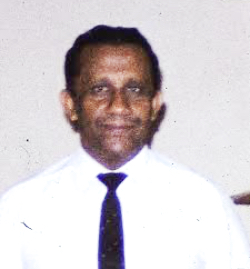 Also teen Somasekeran thrilled the appreciative crowd with a dazzling display of stick work to score a hat trick of field goals which was matched by veteran Ceylon ‘Cap’ Vernon Prins. The end result was the best, and no side deserved to lose.
Also teen Somasekeran thrilled the appreciative crowd with a dazzling display of stick work to score a hat trick of field goals which was matched by veteran Ceylon ‘Cap’ Vernon Prins. The end result was the best, and no side deserved to lose.
The Selection Committee of Walter Jayasuriya (Chairman), Wally de Zylva, L. Sellayah, M.S. Jainudeen and George Mant, were present at all matches. Immediately after the Final and before the Closing Ceremony, the Chairman of the Selection Committee announced that 35 players had been selected and intensive training and coaching programmes have been outlined in view of Ceylon’s tour to South India in early 1957.
Teams
Mercantile
Asoka Perera Goal
V.S. de Kretser R/B
Tony Adahan L/B
Ivan de Kretser R/H
Hugh Aldons (Captain) C/F
B. La Brooy L/H
Chandra Schaffter R/E
Rienzie Perera R/I
Vernon Prins C/F
Tony Savill L/I
Patrick Wright R/E
Matale
M.S. Musheen
S. Subbiah (Captain)
N. Tilekaratne
G.H. Rupesinghe
M.H. Fuard
P.A. Hettiaratchi
G.H. Chandrasena
R.W. Samarakoon
Herbert Wijekoon
R.S. Somasekeran
G.H. Jayatissa
The team :- Fred White (Goal), V.S. de Kretser (R/B), Brindley Stave (left back), Dennis de Rosayro (R/H), Hugh Aldons (C/H-Captain), P.A. Hettiaratchi (L/H), A. Nadarajah (R/E), Ivan de Kretser (R/I), Herbert Wijekoon (C/F), Brian Assey (L/I) and G.H. Jayatissa (L/E).
Reserves :- K.A. Jayasinghe (Goal), M. Jalaldeen (Back), M.H. Fuard and Derrick Harvie (Halves), M.A. Albert and Rienzie Perera (Forwards). A. Mylvaganam and Chandra Schaffter who were certainties were not available for selection.
The experienced and respected Organising Committee of Walter Jayasuriya (Chairman), E. Wickrematilleke, Wally F de Zylva, T.M.N. Mahamooth, E. Wickramasujriya, C. Gunatileke, S.M.S. Sabreen (Hony, Secretary) and Ken Aitken (Hony, Treasurer) did a magnificient job, making this National Event an outstanding success.
Last but certainly not least, was the very high standard of Umpiring, which helped the players immensely and was a joy to the Hockey loving spectators.
A.V. Virasinghe - International debut as player versus India in 1932. Debut as National Umpire – Ceylon versus Trichopoply United in 1938.
Walter Jayasuriya – National debut in Madras 1955. International debut versus Indian Olympic team 1960
Willie Moses – National debut vs Indian Army Command 1950. International debut versus Indian Olympic team 1960
Lt. Col. B.R. Heyn – National debut versus Delhi Wanderers 1955. International debut as player versus Afghanistan in 1947 and later same year Captained vs India.
Lt. Comd. D.C. Ingleton – International debut versus Pakistan in 1955 E. Van Cuylenburg - Very experienced Umpire
Links to further reading

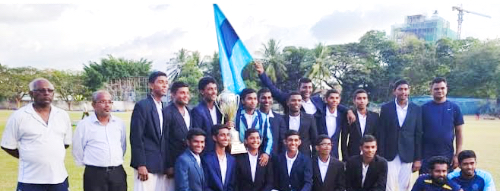
The Prestigious Sathasivam Challenge Trophy back to Wesley after 50 years.
Congratulations to the 1st XI cricket team for winning the M. Sathasivam trophy against St. Thomas' College.
STC 1st innings 129/9 and 2nd innings 134/10
WC 1st innings 256 all out & 2nd innings 12/0
Wesley won by 10 wickets..
Wesley claim Sathasivam Trophy with 10-wicket win over Thomians
From M. Shamil Amit - The Sunday Times Sri Lanka
 Wesley College claimed the M. Sathasivam Challenge Trophy for the very first time since its inauguration in 1999, after handing S. Thomas’ College a 10-wicket defeat at Campbell Park, as the hosts also claimed a vital century old traditional first XI match after many moons against the opponent.
Wesley College claimed the M. Sathasivam Challenge Trophy for the very first time since its inauguration in 1999, after handing S. Thomas’ College a 10-wicket defeat at Campbell Park, as the hosts also claimed a vital century old traditional first XI match after many moons against the opponent.
Chasing a target of eight runs with ample overs in hand, Wesley wasted no time at all as they utilised only three deliveries to out of the 48, to score 12 runs and seal the victory.
Earlier in the day, Wesley resumed at their overnight total of 143-4, as man on duty, Sahil Dias, who was 88 not out, powered his way to muster 116 runs and help his team pile up 256 runs, in reply to the Thomians’ score of 129-9 declared. Dias faced 178 deliveries, hit 10 fours and three sixes, as Thilshan Senanayake hit 62 runs in putting Wesley in the box seat.
S. Thomas’ could not impress much in the second essay as Ravindu Sigera spearheaded Wesley bowling to claim a 5/27, to restrict the opponents to 134. This put the hosts in on cloud nine as they were set to chase a simple target of eight runs, with little time left of the second and final day.
Chief scores
At Campbell Park: Wesley beat S. Thomas’ by 10 wickets S. Thomas’ 129 for 9 declared (46.5) (Janindu Abeygoonewardena 43: Linal Subasinghe 4/33, Semila Liyanage 2/30) and 134 all out (59) (Mahith Perera 39, G. Caniston 30, Ravindu Sigera 5/27)
Wesley (Overnight 143-4) 256 all out (66.2) (Sahil Dias 116 – 88 n.o., Thilshan Senanayake 62, G. Caniston 2/72) and 12 for no loss (0.3) at close
The Match Winning Team
Principal - Avanka Fernando
Tilshan Senanayake
Rakith Fernando
Chamath Gomes
Arshan Sudarshana
Anudhith Wickramasinghe
Semila Liyanage
Uvin Perera
Linal Subasinghe
Sanithu Amarasinghe
Ravindu Sigera
Reserves:
Akas Dawood
Nilupul Liyanage
Sakesh Minoth
Disyla Yapa
Coaching and Ground Staff
Ass.coach - Shanuka Jeewantha
Fielding coach - Kavindana Perera
Trainer- Maduka
MIC - Wasantha Kasturiarachchi
Ground staff - Raja , Ajith
From Bashur Musafer
2nd XI Cricket Team 1960
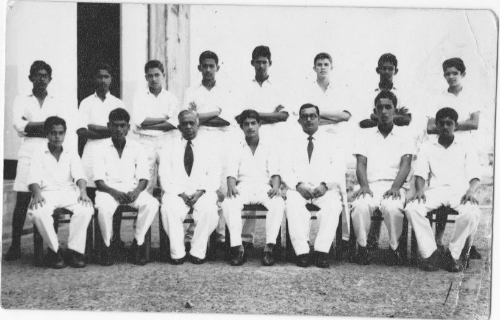
Standing L to R: Ranjith Aaron, M Falih, Mervyn Harmer, Bashur Musafer, Lucien Fernando, Michael Christofelsz, Rodney Perera, Ted Campbell
Seated L to R: Robin Reimers, Denis Thome, Mr P H Nonis, Everard Schoorman (Capt) Mr Edmund Dissanayake, Trevor Gunasekera, Milroy Jeberajah
1st XI Soccer Team - 1960
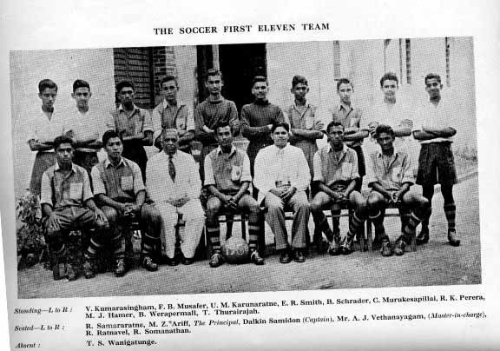
Standing L to R: V.Kumarasingham, Bashur Musafer, U.M Karunaratna, Errol Smith, Boris Schrader, Chandra Murugesapillai, Rodney Perera, Mervyn Harmer, Bryan Werapermall, T.Thurairajah.
Seated L to R: Samararatne (Brother of Upali ) M R Ariff , Mr P H Nonis, Dalkin Samidon (Capt ) Mr John Vethanayagam, R Ratnavale, R. Somanathan.
2nd XI Soccer Team - 1960
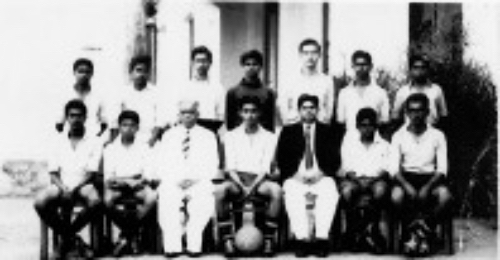
Standing L to R: Roberts, P R David, Lariff Ismai, M Abbas, C U Chang, M Falih, Arulanandam
Seated L to R: Hemaka Jayasekera, Tony Musafer, Mr P H Nonis, Bashur Musafer (Capt), Mr John Vethanayagam, Hafiz Musafer, M Zanoon
He was the first Ceylonese to win the Hockey ‘Blue’ at the Cambridge University.
T. LOUIS (LOU) DE Z. ADHIHETTY (born 1937)
Position: Goal Keeper
Clubs: Old Wesleyites SC, Colombo and Mercantile HA
1962 Tour of Singapore and Malaysia
1962 Asian Games, Djakarta
Excerpts of an interview with the Sunday Observer:
Q: Can you describe yourself in one word?
Ambitious
Q: Any words or phrases you overuse?
“Shit” “Damn”
Q: What is your most marked characteristic?
I see myself as a courageous person
Q: If you could edit your past, what would you change?
Nothing to change, I like the way it is.
Q: What is the most important thing in your life?
Family and close friends
Q: Who has influenced you the most?
My dad
Q: Are you fashionable?
Yes
Q: What motivates you in your life?
Intention to be successful
Q: If you could choose any career right now, what would it be?
Pilot
Q: What forms of music do you listen to?
Pop music
Q: What’s the best thing you would like to hear from someone?
Anything related to games and movies, anime
Q: What made you to choose sports?
I always had a passion for sports from childhood
Q: Thus far what was your most unforgettable sporting incident?
My first year club rugby match CH and FC versus Kandy at Nittawela. It was a great sporting atmosphere and a memorable match
Q: So what was your best school sporting achievement?
Rugby coloursman and track and field champion
Q: What is your notion of happiness?
Traveling and gaming with friends
Q: Which person do you most admire and why?
There are few people in my friends and family circle and I’m a big fan of Lionel Messi
Q: What has been your biggest disappointment?
Giving up playing 1st XI cricket for my school Wesley.
Q: Most important lesson life has taught you?
Never give up
Q: What happens to the broken hearted?
Yet to experience
Q: What is the most beautiful thing you’ve ever seen?
So far the sea view from the Koneshwaram Temple (Trincomalee)
ROHAN AMARASINGHE - An illustrious product of Wesley College
Born 1952 Position: Left back
Clubs: Old Wesleyites SC, Bloomfield C&AC, Mercantile HA, Colombo HA
1972 Tour of North India and vs West Germany in Delhi
AL George represented the Colombo HA at the National Championships in 1976 and 1977 and State Services HA in 1974.
He rendered great service by being the Chairman of the Sri Lanka Hockey Federation Umpires Committee for 11 years. In 1989, he was inducted as an international umpire by the International Hockey Federation. Previously he umpired at the Asia Cup tournament in 1988 in Pakistan and several international tournaments abroad. His expertise was sought as a Technical Delegate at the SAF Games at home and abroad.
Al George, A Zahir, TA Chondon and S Samad were the other legends at the time.
Hockey at Wesley had been revived in the 1950's by the efforts of Mr Fred Abeysekera, Mr L A Fernando, Mr N A B Fernando and other members of the staff. With the introduction of hockey to the younger generation in the age groups of 12 to 16 an interest was kindled and a fun version of hockey was played in the confines of any space available in the school premises with improvised hockey sticks and tennis balls which proved as a catalyst for the game to catch on.
By the nineteen sixties Wesley had made significant progress to be reckoned as a formidable side in the inter school arena and during which period the dedicated coach was Mr T G Amith.
During this period there was a " One Game Rule" in existence which barred any sportsman from playing more than one game during the second term. This episode is a consequence of that rule and goes back to the 1963 Wesley vs St Thomas’s encounter played on the rock hard uneven surface of Campbell Park, a challenge to any visiting side. Upali Perera was the captain and recalls some of his team mates being the likes of C T Rodrigo, D Thurairajah (vc ) Sarath Wickramaratne, Tyronne Maye,D Thiagalingam, Lal Fernando Rajah Jaysuriya, Devarajah, Upali Siriwardene, William Deutrom and Priyanath Fernando. and a few others whose names he cannot recall and extends his apologies to them.
However before the game was to commence it was found that they had no goal keeper. The regular goal keeper William (Bill) Deutrom had injured himself a few days earlier in the game against Trinity and was ruled out by his Mum.The injury as I recall being a classmate, was a dark blood clot in the upper part of his thigh (very reluctantly shown ) made to look worse on his very fair skin. This was by no way an impediment for William to keep goals however when Mrs D said No it stayed that way, there was no way that William could disobey her. An obedient son but notorious for his antics on and off the cricket or any playing field which earned him headlines in a Royal vs Wesley cricket encounter “Deutrom’s antics saves Wesley “. very courageously patting down the matting wicket at Campbell park in a time wasting exercise.
The reserve goalkeeper was Priyanath Fernando who did not attend school that day as he had to attend a funeral and was expected to turn up for the match but failed to do so. Upali Perera and C T Rodrigo were desperately looking for someone who had turned up at the grounds to don the pads.Their choice was between me and Upali Karunaratne affectionately called “ Pissu Karu" because he was a daredevil, brave and brash about anything he decided to do and a good soccer player to boot. Fortunately or unfortunately the task fell on me for reasons unknown.
Vincent the groundsman helped me with the pads that had to be tied with coir ropes ( a sign of the cash strapped times) as the leather straps were broken. I still remember that I was so nervous my legs were trembling at the prospect of keeping goals which I had never done before.Vincent was very assuring and told me in Sinhalese "baiya wennda eppa". I was given a protector commonly referred to as a box , worn by many a cricketer to be worn over my jockstraps .There were no concerns of ringworm or personal hygiene then, one size fitted all !.
A hockey stick and a glove was thrust into my hand and I was assured by Upali Perera, the smooth talking captain that everything would be fine before being escorted to the grounds. In present times a hockey goal keeper is well protected from head to foot with a helmet and grill, body padding and oversize gloves and pads. How times and the game itself, now played at a faster pace on an astro surface have changed.
The match umpires were Mr Walter Jayasuriya referred to as the “Father of Ceylon Hockey “ and Mr Mylvaganam dubbed as “ The Wizard “ for his artistry and brilliant stick work. They were two of the best umpires in the island . They were both old Wesleyites who had distinguished themselves representing Ceylon and also present was Mr T M N Mahmooth an old boy,ardent hockey fan and also an official of the Ceylon Hockey Association.
Nervous and lacking confidence I took up my position at the goal mouth but within the first few minutes the Thomians scored their first goal. Thoughts ran up my mind that we were to get a bigger thrashing this time around. It was a worry every time the Thomian forwards approached the “D” goal area but being able to stop a few shots at goal my confidence grew with the excitement and adrenalin pumping in as well. From thereon it was a do or die effort from me. In desperation and instinctively I used my entire body to block every shot at goal and with Wesley’s spirited play and resolute defence we managed to restrict the Thomians to a narrow lead at half time.
Every effort by the Thomians to score was thwarted by a determined and spirited Wesley side unfazed by the reputation, skill and speed of the opposing team. There were penalty corners after penalty corners charged down by Wesley and if it happened to be hit at goal it was somehow saved. The Thomians found it difficult to penetrate our defences especially of the two full backs Upali Perera and Lal Fernando who could hit the ball many a mile to get us out of danger. They were a tower of strength and a source of encouragement throughout the game.
The score till the dying moments of the game was one all when the Thomians made another desperate attempt to score. A Thomian forward broke through the defence and had only me to beat and score when I deliberately slid towards him and in desperation threw my hockey stick at his legs. I was blown for rough play and a penalty bully was duly awarded. This again was a first time experience which was bound in failure. The Thomians scored to win the match by two goals to one as I remember.
After the match Randy Morell walked in to our dressing room and congratulated me. I thought it was a great sporting gesture on his part to acknowledge a creditable performance of an opposing player. As for me I was too dumbfounded to realise that it was that much of a performance. Overall it was no doubt a superb all round team effort by Wesley to lose by such a close margin to a champion team.
It was quite recently (Sept 2022) that Ananda Amaranath a former State Counsel in Sri Lanka and a Thomian now residing in Sydney who played in that match recounted that though the match was played sixty years ago he still clearly remembers how the coach chastised the Thomian team for their failure to win the match by a bigger margin as they had done in the past.
During that season Wesley under the leadership of Upali Perera went on from strength to strength beating some of the strongest school teams.
This was the only hockey match that I ever played for Wesley. However on that performance I was picked to represent the Colombo North schools and then progress to the Ceylon school’s team at the National Hockey Championships in 1964, K P Dias from STC, Rajah Jayasuriya and Hafiz Musafer from Wesley were also in that Ceylon schools team. From there on I was picked to play for Ceylon against Pakistan returning from the Ganefo games in Indonesia. However the game was called off and I could not don that national shirt.
In 1963 Sarath Wickramaratne and I shared the E A Gunesekera prize for the Best All Round Sportsman. In late 1963 I together with Bunny Saldin and four other school boys of Wesley played hockey for the Colombo Malay Cricket club when they resumed playing Hockey after a very long absence. The club is the oldest Ceylonese Cricket club and celebrates its 150th anniversary in 2022.
In 1965 I represented the Pakistan Military Academy hockey team coached by Major Abdul Hamidi who captained the Pakistan Olympic team in 1956 and 1960 that won a silver and gold medal respectively.
Regretfully I did not return to national hockey much to the disappointment and dismay of many. Rugby being a popular and prestigious sport at that time took precedence in the Army and I had no say in the matter. However I had the opportunity to play a decade of rugby and captain the Army and Combined Defence Services rugger teams in 1972 and also represented them at Hockey .
The unexpected twist - “an accidental one hit wonder” ?
A coloursman in many a sport as a multitude of talented past Wesleyites were but not in Hockey, a game I had excelled in by a strange quirk of fate.
I left for Pakistan leaving behind a great school I had attended from the kindergarten, a school I am very proud of that stood by its core principles and ethics during a period of great financial challenges, economic and political turmoil.The school had opted to be a private non fee levying school and was solely dependant on donations devoid of any government assistance.This was a period of great difficulty for the parents as well. Despite these challenges Wesley laboured on and taught me a great many things,nurturing me in an environment of caring and sharing in one big family of equality, devoid of caste,creed, religion, wealth or social standing and instilling in me the values of being a good citizen,a true sportsman and most importantly a decent human being.
Post Script
Dr Shanthi Mclleland the former Principal of Wesley and an outstanding Hockey player and athlete himself during his visit to Australia in 2015 did present me with an embroidered hockey colours crest. However despite this wonderful gesture on his part I will not claim to be a coloursman and have no regrets about it. If there was a regret it was that I did not don that national jersey in hockey, a goal that was never inculcated or set to us at school. However I am glad that some from my vintage and other juniors after me like Bunny Saldin, C T Rodrigo, Sarath Wickramaratne,Rajah Jayasuriya , Shanthi McLelland, A L George, Buster Harvie, Rohan Amerasinghe, Malik Jahn and many others have done tremendously well in hockey.
........................................................................ Captain Navin de Silva hosted the 1969 Wesley's champion team Capt Amaresh Rajarathnam and past cricketers to dinner at OWSC.
Navin captained the 1st XI Cricket Team 1981 and 82. Amaresh Rajaratnam was the school Cricket Captain in 1969 and 70. They were indeed some of the most successful years for cricket at Wesley College.
The second oldest inter-school cricket fixture in the country will be played at Campbell Park on the 16th and 17th February 2018 for the 125th year between two of the finest educational institutions, Royal College and Wesley College for the Sir Frank Gunesekera Shield.
The shield is named after a famous Ceylonese Senator, an old Royalist Sir Frank Gunesekera who was the Deputy President of the Senate of Ceylon in 1948. Both Sir Frank and Dr. Lucien had connections with both Royal and Wesley. Although both were educated at Royal, Sir Frank resided close to Wesley at the junction of Campbell Place and Baseline Road near the Welikade prisons. His two brothers Eric and Donald both studied at Wesley and played cricket for school in 1908 and 1910. The former ended up as Vice Principal and lived at Karlsruhe Gardens right in front to the Wesley Principal and Vice Principal’s bungalow. Their sister Irene too lived here.
Sir Frank, whose portrait hangs in the Royal College hall, was a brilliant student winning the Thoburn prize for the best all-rounder in 1904. The Chief Guest Sir Henry Blake predicted success in whatever career he chose. Five generations of Gunesekera’s have studied at Royal and Wesley College, including Eric, Donald, Elmer, Terrance, Lal, Chrysantha, Nalin, Rohith, Hiran, Sharmal, Sivaji, Shivantha, Rajiv, Tharindra and Anujith. It was in 1969 that Dr. Lucien Gunesekera presented the Sir Frank Gunesekera Shield in memory of his father which Wesley became the first recipient in the famous last ball victory under the leadership of Amaresh Rajaratnam. Sporting declarations by both sides made the match one of the, if not the most interesting of the 125 encounters played between the two schools.
Batting first, Wesley scored 260 for 9 while Royal replied with 207 for 7. With a lead of 53 runs in the first innings, Wesley declared at 105 for 8, setting the Royalists a target of 158.
The game ended in one of the most thrilling finishes when the Royalists were bowled out for 148 in the last ball of the last over of the game, giving Wesley a famous 9 run win.
Wesley’s reign was short lived, as Royal won it back the following year, leaving Wesley with no option but to wait for another 42 years to taste victory, reclaiming the trophy in 2012 under the captaincy of Ashen Fonseka.
The centenary encounter was played as a three-day match played at the P.Sara Oval in 1993 where Royal was captained by Gamini Perera and Wesley was captained by Teheran Rasool. After bowling Wesley out for 103 runs, Royal posted a mammoth total of 411 for 6 with the Captain himself scoring an unbeaten 152. The match ended within two days when Wesley was skittled for 112 in their second innings, giving the Royalists an emphatic innings and 196 run victory. N. Rajan’s brilliant bowling earned him a match bag of 10 for 43.
In 1906, C. A. Perera of Wesley made 108, becoming the first ever Wesleyite to score a century against Royal. Another interesting feature of this longstanding encounter was when Danesh Dissanayake scored centuries against Royal in 1988 and 1989 while his father Edmund Dissanayake too scored 107 in 1946. They remain the only father-son duo to score centuries against Royal, while for Royal, H.C. Gunasekara scored 120 in 1912 and his son C.H. Gunasekara (Jnr) scored 100 in 1949.
The record for the highest individual score is held by the former Royal skipper Chulaka Amarasinghe who scored an unbeaten 207 in 1983 while Roshan David’s 199 in 1990 stand as the highest for the Wesleyites. M.L. Warish holds the bowling record for Wesley against Royal taking 9 for 17 in 1897. Warish’s match bag of 14 for 48 in that match still continues as a record for both schools.
Another unique feature of this series is when the Harmer brothers Mervyn and Russell had a hand with dismissal of all 10 Royal batsman in the 1st innings of the 71st match played in 1964 a Campbell Park. In that innings S. Rajaratnam from Royal was the only batsman to be run out for 62.
Over the 125 years both schools have produced some outstanding and great cricketers, a few that come to mind are Dr. C.H. Gunasekera, Sargo Jayawickrema, Col .F.C. De Saram, Sathi Coomaraswamy, C.I. Gunasekera, Gamini Goonasena, Fritzroy Crozier, Darrel Liversz, Jayantha Amerasinghe, Gajan Pathmanathan, Asitha Jayaweera, Ranjan Madugalle, Rohan Jayasekera, Sumithra Warnakulasuriya, Sudath Pasqual, Asantha De Mel, Chulaka Amarasinghe, Roshan Jurangpathy, Jehan Mubarak and Kushal Janith Perera from Royal with the famous M. Sathasivam, S. Gunasekera, R.L. Kannangara, A. Mylvaganam, S. Nagendra, I.H. Walbeoff, H.L. A. Matthysz, Edmund Dissanayake, Lucky Goonetilleke, M.N. Samsudeen, Lou Adihetty, the Claessen brothers, Bryan, Radley and Herman, the Harmer brothers Russell, Mervyn and Granville, Darrell Maye, the Jeganathan twins, Sritheran and Hariharan the Fuard brothers, Ansar and Abu, L.C.R. Wijesinghe, Amaresh Rajaratnam, Tyronne Jansz, Dilangen Jayasekera, Mahendra Dissanayake, Ganesh Mylvaganam, Navin De Silva, Sanjeeva Wijesingha, Dharshika Jayakody, Roshan David, Danesh Dissanayake, Farveez Mahroof and more recently Ishan Jayaratne and Jeffrey Vandersay playing for Wesley. Some of these gentlemen went on to represent the country.
The Royalists are the current holders of the shield, having won it in 2015 under the captaincy of Harith Samarasinghe.
Giving a synopsis of the second oldest schools cricket fixture in the island leading to the 125th year, Royal have won 50 with Wesley winning 22 encounters while 52 matches were drawn.
The Chief Guest for this memorable encounter will be former Wesley and Sri Lanka Schools under 19 cricket captain, Capt. Navin De Silva. Navin began playing 1st XI cricket in 1978 and ended captaining Wesley in 1981and 1982. He was a dashing batsman who feared no bowler and a right arm fast medium bowler deceptive with speed. Many of his knocks were dazzling and worth going miles to watch. Considered to be one of the finest cricket captains in the 80’s, Navin was selected to lead the Sri Lankan schools team on its first ever cricket tour to England in 1981 with Arjuna Ranatunga as his deputy. The tour was a success with Sri Lanka remaining unbeaten a great achievement at that time. The side consisted of players in the caliber of Aravinda De Silva, Marlon Von Haght, S.H.U. Karnain, Graham Labrooy and Rumesh Ratnayake. Navin went on to be adjudged the best schools captain and best all-rounder in school cricket in 1981.
Celebrating the 125 years of cricketing encounters in 2018, the Royalists will be looking to hold on to the Sir Frank Gunesekera shield under the Captaincy of Pasindu. Sooriyabandara while the Wesleyites under the leadership of Thusaraka Akmeemana will be shifting all gears to bring the shield back to Karlsruhe Gardens. Whatever the outcome may be both sides are bound to provide the cricket loving spectators an entertaining game.
St. Benedict’s College captain Pasan Suwahas (left) and his Wesley College counterpart Sahil Dias shake hands in front of the Rev James Cartman Cup and Rev Bro Luke Gregory Shield, two trophies they will play for in the 126th two-day match at Campbell Park on March 25 and 26 and the 50 over encounter on April 2 at the P Sara Oval.
With a pandemic wiping out the sporting passions of schoolboys over the past two years followed by the island’s economy gone haywire, two educational institutions, St. Benedict’s College and Wesley College have come together in a manifestation of optimism to keep a 126-year tradition alight in one of the most darkest eras of the country.
The occasion marks their annual cricket encounter that commenced way back in 1896 and interestingly not branded on the likes of so-called big matches some of them that mushroom overnight and in reality are the breeding ground for hooliganism and sleazy conduct.
Organizers say the Bens-Wesley encounter was a match made in Heaven and now at a time when countless numbers of corporate companies are kicking their heels and putting up shutters unable to make ends meet economically, the banding together of a cast of sponsors for their match on March 25 and 26 is itself a miracle.
“We are a beautiful encounter and we have initiated something great”, declared Avanka Fernando, the head of Wesley College. “We have seen a lot of schools playing cricket, but we want to make sure this encounter is significant and a different one from all the other cricket matches in the schools arena. We want to have this encounter as an example in our country.”
Fernando’s remarks threw a challenge to the rest of the cricket-playing schools in the country to prove they practiced virtues in the name of sport, if not change their big-match lifestyles for the welfare of Society that has lost most of its public appeal.
Both schools can also take credit for moulding some of the most illustrious sportsmen and scholarly elite that have passed through their hallowed portals and are among the few institutions in the country that can be counted in for their roles in responsible public service.
“Cricket is a great leveller and our relationship is based on shared values, traditions and Christian cultures,” said the head of St. Benedict’s College Rev Bro Pubudu Rajapakse.
“Bens and Wesley have been enriched for so many years and that has been the pride and dignity of our schools and let us look to introduce additional values through cricket.”
St. Benedict’s and Wesley, who are not part of the all-noise, no-song syndrome, will be showcasing a new concept that they contend will make school cricket an interesting sport once again by deciding to take the second new ball after 50 overs instead of the 80-over wait.
The new playing rule the two schools believe will prepare a spin bowler to compete more at school level for the future by using the new ball like in present day Test cricket where some teams open the bowling with the new ball.
Proceeds from last year’s match were donated towards charity and vocational training for under privileged boys at a church-run institution and the generosity will be followed this year as well according to the organisers.
St. Benedict’s College:
Sahil Dias (captain), Semila Liyanage, Anudith Wickremasinghe, Tilshan Senanayake, Tharanga Fernando, Rakitha Fernando, Ravindu Sigera, Yabesh Blessing, Uvin Perera, Chamath Gomes, Sanithu Amarasinghe, Pahan Brito, Linal Subasinghe, Disula Yapa, Ashan Isira, Shakesh Minon
Wesley College:
Pasan Suwahas (captain), Yohan Soyza, Ashen de Zoysa, Sachin Senanayake, Viduth Wilson, Mevan Dissanayake, Sheron Kannangara, Shenel Samaratunga, Chamath Chathurya, Aarshan Joseph, Akshar Selvanayagam, Dilan Milantha, Pankaja Perera, Vihara Attanayake, Haren Olagama, Kojitha Himsara, Sharujan Shanmuganathan, Aveesha Sandaruwan, Hasanga Nanayakkara
Ravindu Sigera batting left hand has been a prolific scorer and a fine bowler for Wesley College all through the season.
Wesley College cricket has been on the ascendancy more recently. In 2022 Wesley won the Mahadevan Sathasivam Trophy by beating S. Thomas' College Mt. Lavinia. Played at at Campbell Park, we won this long standing and important fixture after 50 years. Sahil Dias with a Grand Century and Ravindu Sigera 5/27 paved the way for this historic win. As an all round cricketer we wish Ravindu Sigera well for the future. 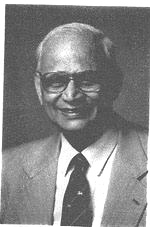 Lou Adihetty came into prominence when he was selected to represent Colombo HA versus the visiting Madras HA in 1955 and again in 1956 versus the Mysore HA - both ‘Corera Cup’ encounters. In 1964, he represented the Mercantile HA at the National Championships. During his short career he represented Ceylon at the 1962 Asian Games and against the visiting world champions Pakistan.
Lou Adihetty came into prominence when he was selected to represent Colombo HA versus the visiting Madras HA in 1955 and again in 1956 versus the Mysore HA - both ‘Corera Cup’ encounters. In 1964, he represented the Mercantile HA at the National Championships. During his short career he represented Ceylon at the 1962 Asian Games and against the visiting world champions Pakistan.
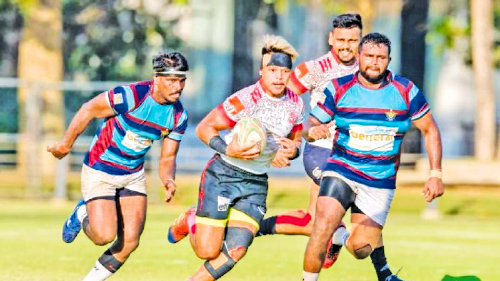
 Former Wesley College rugby captain Avantha Lee is no stranger to followers of the sport in the country. The fullback will make no secret of his passion for rugby, his ambition and his drive for courageous acts. Born on March 29, 1998 in Sri Jayawardenapura, Kotte, Trueching Avantha Lee is straightforward in what he does and likes to see blue and black besides walking off the field in victorious colours that he gets into. Could he be somebody’s role model?
Former Wesley College rugby captain Avantha Lee is no stranger to followers of the sport in the country. The fullback will make no secret of his passion for rugby, his ambition and his drive for courageous acts. Born on March 29, 1998 in Sri Jayawardenapura, Kotte, Trueching Avantha Lee is straightforward in what he does and likes to see blue and black besides walking off the field in victorious colours that he gets into. Could he be somebody’s role model?
From the Sunday Observer 11th September 2022
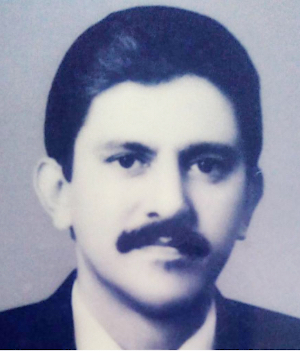 Rohan Amarasinghe represented the Colombo HA at the National Championships in 1972 and Mercantile HA from 1973 to 1978, playing in the runner-up teams of 1973 and 1976 and joint Champions in 1975.
Rohan Amarasinghe represented the Colombo HA at the National Championships in 1972 and Mercantile HA from 1973 to 1978, playing in the runner-up teams of 1973 and 1976 and joint Champions in 1975.
 Cricket has been the predominant game played at Wesley dating back from 1893 and is well chronicled and written about whilst there is very little of Hockey and Soccer being documented. As to when exactly these two games were introduced remains unanswered. However Soccer and Hockey had been played at Wesley before the 1940's which led to a band of former hockey players Walter Jayasuriya, T M N Mahamooth and A Nithiyanandan getting together to form the Old Wesleyites Sports club in 1941 which continues todate. Rugby though introduced in 1956 has moved on and gained more interest and popularity.
Cricket has been the predominant game played at Wesley dating back from 1893 and is well chronicled and written about whilst there is very little of Hockey and Soccer being documented. As to when exactly these two games were introduced remains unanswered. However Soccer and Hockey had been played at Wesley before the 1940's which led to a band of former hockey players Walter Jayasuriya, T M N Mahamooth and A Nithiyanandan getting together to form the Old Wesleyites Sports club in 1941 which continues todate. Rugby though introduced in 1956 has moved on and gained more interest and popularity.
1st XI Hockey Team 1963 - St Thomas' Mt lavinia

1st XI Hockey Team 1964 - St Thomas' Mt lavinia

 L M Wickremesinghe was the captain of St Thomas’s and led a star studded side, perhaps the best amongst the schools. Amongst the players in their midst were K P Dias, Anura Tennakoon, S Abeyesekera, A A De Silva. Mohan Samarasinghe, Randy Morell, Sarath Seniviratne, R Van Twest and an array of big names. Wesley had been thrashed at Mt Lavinia the previous year in double digit figures and had been looking to redeem that best be forgotten encounter.
L M Wickremesinghe was the captain of St Thomas’s and led a star studded side, perhaps the best amongst the schools. Amongst the players in their midst were K P Dias, Anura Tennakoon, S Abeyesekera, A A De Silva. Mohan Samarasinghe, Randy Morell, Sarath Seniviratne, R Van Twest and an array of big names. Wesley had been thrashed at Mt Lavinia the previous year in double digit figures and had been looking to redeem that best be forgotten encounter.
"All fruits of a magnificent hockey revival at Wesley."
Links to further reading
Hockey at Wesley College
Wesley's 1969 Cricket Team with other Past Wesley Cricketers

Amaresh Rajaratnam and Navin de Silva
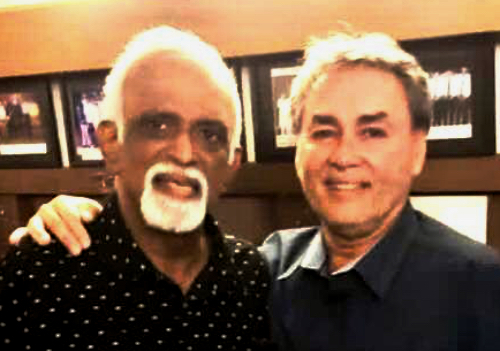
Links for further reading
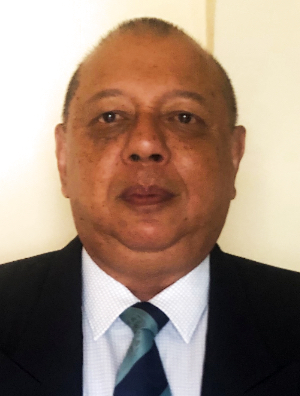 The first encounter between the two schools was played in 1893 at San Sebastian Hill, Hultsdorf which was the home ground of the Royalists. Royal was Captained F.S. De Silva while Percy de Bruin captained Wesley. The Royalists won the inaugural encounter by 53 runs. The only break in the series came in 1943 when the grounds of both schools were taken over by the British during the Second World War.
The first encounter between the two schools was played in 1893 at San Sebastian Hill, Hultsdorf which was the home ground of the Royalists. Royal was Captained F.S. De Silva while Percy de Bruin captained Wesley. The Royalists won the inaugural encounter by 53 runs. The only break in the series came in 1943 when the grounds of both schools were taken over by the British during the Second World War.
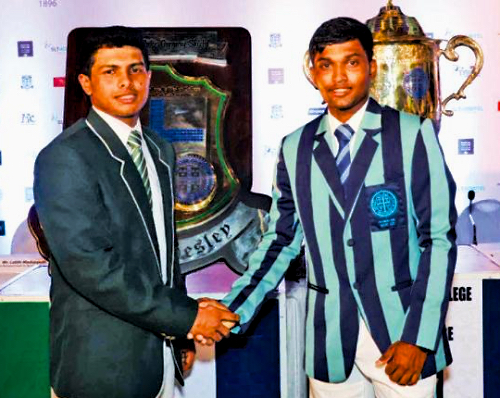
The Squads:
Links to further reading
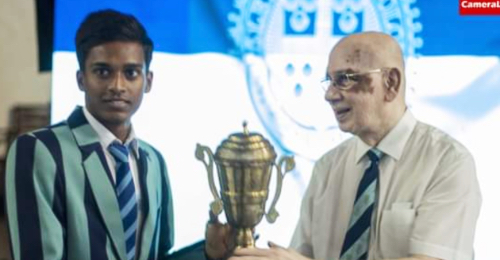
Links to further reading
The Ceylon Team at the Ratmalana Airport - 1957
The Wesleyites
T.M.N. Mahmooth
Abu Fuard
Walter Jayasuriya

First National Hockey Championships of Ceylon – August 1956 by Dennis de Rosayro
It was the new Federation’s first baby; the most ambitious hockey tournament in Ceylon, which was conducted on the then Navy ground at Galle Face. Thousands flocked to the venue throughout the tournament to witness the performances of our international and national players and also some outstanding teenage schoolboys who were selected to play for the respective Associations. The eight Associations affiliated to the Federation were, Mercantile, Colombo, Matale, Kandy, Uva, Jaffna, Government Services and Combined Services (Army, Navy and Air Force).
Wide publicity was given by all newspapers and the Times of Ceylon published a special supplement with photographs of all individual players with larger ones of captains, the Organising Committee and the handsome A.A. Virasingha and Bin Ismail trophies.
The Mercantile team was described ‘as a hard nut to crack’ and were pre-tournament favourites.
The captain was Hugh Aldons who made his international debut against India in 1947. He also played for Ceylon at cricket and was an outstanding wing-three quarter for Ceylon at rugby. There was Vernon G. Prins who made his international debut against India in 1947. He also captained Ceylon at cricket. Another player Chandra T.A. Schaffter made his national debut on Ceylon’s tour of South India in 1953 and international debut versus Pakistan in 1955. He also represented Ceylon in cricket.
Ivan de Kretser made his national debut on Ceylon’s tour of South India in 1953 and international debut versus Pakistan in 1955. The others were V.S. de Kretser (Jr), national debut on Ceylon’s tour of South India in 1953 and international debut versus Pakistan in 1955, Asoka Perera, B. Labrooy, T.S. Adahan, P. Wright, A. Savill, K. Sampanthan, D.I. Henricus, Rienzie Perera, H.S. Oorloff and M.E. Thornton.
The Colombo team was described as ‘here’s a happy blend’. M.A. Albert was the captain who made his international debut versus the Indian Olympic team in 1948. Brian J. Assey, national debut with the Ceylon tour of South India in 1953 and international debut versus Pakistan in 1955. A. Nadarajah, national debut with the Ceylon tour of South India in 1953 and international debut versus Pakistan in 1955.
The others in the team were Malcolm Aldons, national debut versus Delhi Wanderers in 1955, Dennis A.B. de Rosayro, national debut versus Delhi Wanderers in 1955, Anton D’Costa, B.L. Peiris, S. Crusz, N.W. Gauder, T. Rajaratnam, W. Gunasagaram, T.A. Buhar, M. Muthcumaroe, Don Bosco and L.P. Rayen. The Government Services team was described as ‘no lack of experience’ with A. Mylvaganam as captain and toured South India in 1953 and made his international debut versus India in 1947.
There was Leslie Sellayah, international debut as captain versus Afghanistan in 1947 and also captained the team versus India later that year. Another member Fred Pereira made his international debut versus India in 1947. There was also Brindley Stave who made his national debut with the Ceylon team on a tour of South India in 1953 and international debut versus Pakistan in 1955. Others in the team were Barney Bowen, national debut versus Delhi Wanderers in 1955, Chandi Chanmugam, national debut versus Madras in 1955, C.S. Modder, national debut versus Indian Army Southern Command in 1950, Russel Bartels, S.D. Anthonisz, F. Modder, J.G.I. Wijesinghe, I.T. Packeer Ally, R. Tissaweerasingham, C. Wijeratne and A.M. Jayasekera.
The Kandy team was described as ‘ready to give any team a run’. They were captained by Bertie Dias while the other team members were M. Sameen, D.R. Rajasinham, N.R.L. Alwis, W.B. Adhikaram, M.S. Jumar, J.R.E. Paramsothy, Roy de Silva, P. Thangavaloo, S. Weerasuriya, Derrick Harvie, B.S.G. Sahayam, J.W. Jayasuriya and F. Martin.
The Matale team was described as ‘they head outstation challenge’. The captain was S. Subbiah who made his national debut on Ceylon’s tour of South India in 1953. The other players in the team were Herbert Wijekoon who made his international debut versus Pakistan in 1955, M.H. Fuard, G.H. Chandrasena, R.S. Somasekeram, N. Thilakar, P. Nanayakkara, G.H. Jayatissa, P.S. Hettiarachchi, L.W. Samarakoon, M.S. Musheen, G.H. Rupasinghe, T.S. Salideen and T.S.J. Packeer Ally.
The Uva team was described as ‘speed is their forte’. They were captained by Dr. R. Harry Aldons and the other members were K. Ariyarajah who made his international debut versus India in 1948, A.M. Somapala, Fred Aldons, Pat Williams, M.I.M. Hussain, R. Mahmoor, M.I.M. Laheer, W.D. Dharmadasa, M.F. Jamaldeen, A.C.M. Farouk, K.D. Wickramasena, A.H.M. Lafeer, A. Perampalam M.D.I.L. Marikkar and E.R. Dheerasena.
The Combined Services team was described as ‘Fighting fit’. They were captained by Ernie Kelaart who made his international debut versus India in 1947. They also had Frederick White who made his national debut on a tour of South India in 1953 and international debut versus Pakistan in 1955, M.S. Ismail, Eddie Baptist, V.C. Labrooy, T. Abeysena, L. Winter, D.C. Ingleton, A. Vigneswaram, R, Meynert, E.R. Rode, R. Sam T. Meyers, P. Francis and S. Peter.
The Jaffna team was described as the Dark Horse of the tournament. They had players in the mould of V. Balakrishnan, A. Mahadevan, T. Emmanuel, T. Anandaratnam, K.V. Thanendran, S. Rajasingham, R.A. Radchakan, V. Rajaratnam, Hugh Muller, S. Thevendram, R. Breckenridge, R. Kanageratnam, N.V. Devaraj and S. Balachanmugam.
The outstanding schoolboys who participated were L.P. Rayen, T. Rajaratnam from Colombo, Derrick Harvie from Kandy, R.S. Somasekeran, P.A. Hettiarachchi, G.H. Jayatissa, G.H. Rupesinghe from Matale, A.C.M. Farouk and A.H.M. Lafeer from Uva and V. Rajaratnam from Jaffna. Anton D’Costa and Don Bosco from Colombo were employed at Heath & Company and Pettah Pharmacy respectively.
Dennis de Rosayro from Colombo, employed at Heath & Company was the only national Cap having represented Ceylon versus the Delhi Wanderers in 1955 as a schoolboy.
Hockey of a very high standard was displayed by most teams. The semi-final between favourites Mercantile and the youthful Colombo was a classic with the favourites Mercantile winning 4-3 after being led 0-3. Mercantile and Matale were worthy finalists having beaten Colombo and Defence Services in hotly contested semi-finals.
The Navy ground at Galle Face was a sea of heads aided by bus loads of fans from Matale. The Navy band was in attendance and the game of hockey was enhanced with the presence of the Prime Minister, Sir John Kotalawala, as the chief guest, who was also the Patron of the Ceylon Hockey Federation.
Both teams played fast and attacking hockey of the highest level, sharing six goals. It was a treat to watch the teenage half-line of Matale, G.H. Rupasinghe, M.H. Fuard and P.A. Hettarachchi who tirelessly and bravely thwarted the dangerous and crafty moves of seasoned national Caps Hugh Aldons, Vernon Prins, Chandra Schaffter and Ivan de Kretser. Also teenager Somasekeran thrilled the appreciative crowd with a dazzling display of stick-work to score a hat-trick of field goals which was matched by veteran Ceylon Cap Vernon Prins. The end result was the best and no side deserved to lose.
The Selection Committee of Walter Jayasuriya (chairman), Wally de Zylva, L. Sellayah, M.S. Jainudeen and George Mant were present at all matches. Immediately after the final and before the closing ceremony, the Chairman of the Selection Committee announced that 35 players had been selected and intensive training and coaching programmes were outlined in view of Ceylon’s tour of South India in early 1957.
The team:
Fred White (goal), V.S. de Kretser (R/B), Brindley Stave (left back), Dennis de Rosayro (R/H), Hugh Aldons (C/H-Captain), P.A. Hettiarachchi (L/H), A. Nadarajah (R/E), Ivan de Kretser (R/I), Herbert Wijekoon (C/F), Brian Assey (L/I) and G.H. Jayatissa (L/E).
Reserves: K.A. Jayasinghe (goal), M. Jalaldeen (Back), M.H. Fuard and Derrick Harvie (Halves), M.A. Albert and Rienzie Perera (Forwards). A. Mylvaganam and Chandra Schaffter who were certainties were not available for selection.
The experienced and respected Organising Committee of Walter Jayasuriya (chairman), E. Wickrematilleke, Wally F de Zylva, T.M.N. Mahamooth, E. Wickramasujriya, C. Gunatileke, S.M.S. Sabreen (Hony Secretary) and Ken Aitken (Hony Treasurer) did a magnificent job making this national event an outstanding success.
Last but certainly not least, was the very high standard of umpiring, which helped the players immensely and was a joy to the hockey loving spectators. A.V. Virasinghe - International debut as player versus India in 1932. Debut as National Umpire – Ceylon versus Trichopoply United in 1938. Walter Jayasuriya – National debut in Madras 1955. International debut versus Indian Olympic team 1960
Willie Moses – National debut versus Indian Army Command 1950. International debut versus Indian Olympic team 1960.
Lt. Col. B.R. Heyn – National debut versus Delhi Wanderers 1955. International debut as player versus Afghanistan in 1947 and later same year captained versus India.
Lt. Cdr D.C. Ingleton – International debut versus Pakistan in 1955 E. Van Cuylenburg - Very experienced Umpire
1st XI Team 1963
Kindly sent tome by Upali Perera and Bashur Musafer
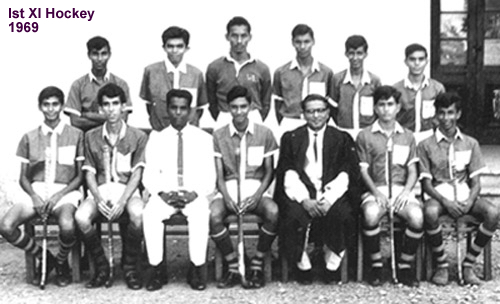
W.Deutrom, S Wickramaratne, Upali Perera(Capt), I.Thurairajah (Vice Capt) C.T Rodrigo, Lal Fernando
Standing: L to R:
D Thiagalingam, H Musafer, Devaraj,T.Maye, R.Jayasooriya
..................................................
1st XI Team 1967
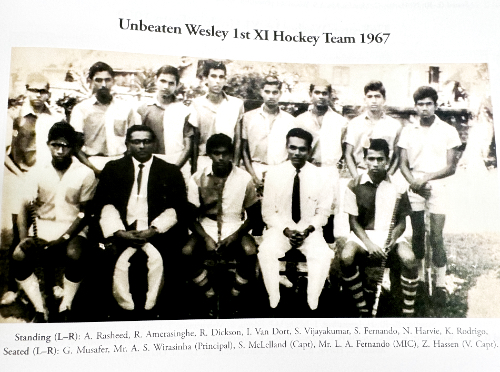
..................................................
1st XI Team 1968
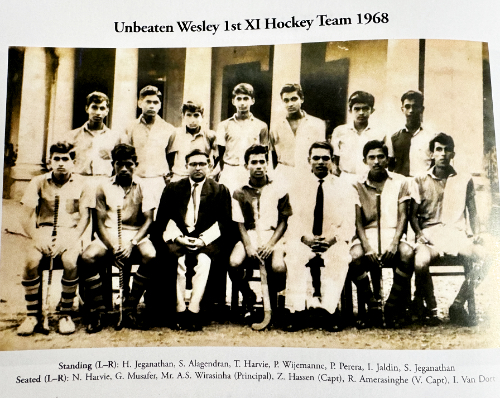
..................................................
1st XI Team 1969

Jayantha Wijemann, Van Dort, Mr A.K Suppiah, Rohan Amerasinghe, Mr A.S Wirasinha, Neil Harvie, S.Jeganathan
Standing: L to R:
Hariharan Jeganathan, Jaldeen, Patrick Edema, Sinnethamby, Trevor Gomes, Kingsley Samaratunge
..................................................
1st XI Team 1970
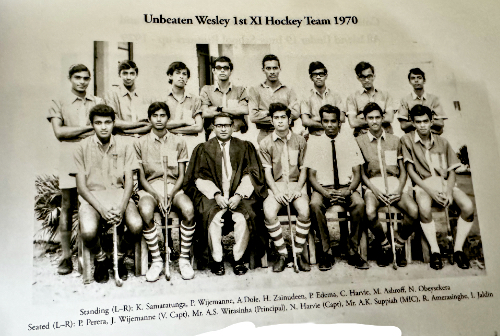
..................................................
1st XI Team 1971

Parakrama Wijemanne, Mr A.M Mohideen, Rohan Amerasinghe, Mr A.S Wirasinha, Jayantha Wijemanne, Mr. A.K Suppiah, Neil Harvie, Chris Harvie
Standing L to R:
Geethal Peiris, Neil Obeysekera, Shamil Amit, Mahinda Silva, Ananda Karunaratne, Mervyn Lye, S.Rajendran
..................................................
1st XI Team 1972
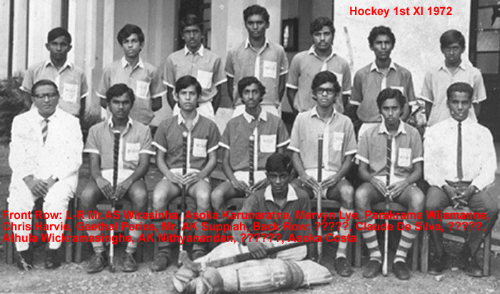
Mr A.S Wirasingha, Ananda Karunaratne, Mervyn Lye, Parakrama Wijemanne, Chris Harvie, Geethal Peiris, Mr A.K Suppiah
Standing L to R :
?????, Claude De Silva, S.Sadanandan, Athula Wickramasinghe, A.K Nithyanandan, Akbar, Asoka Costa
..................................................
1st XI Team 1973
Photo kindly sent to me by Athula Wickramasinghe, Saskatchewan, Canada
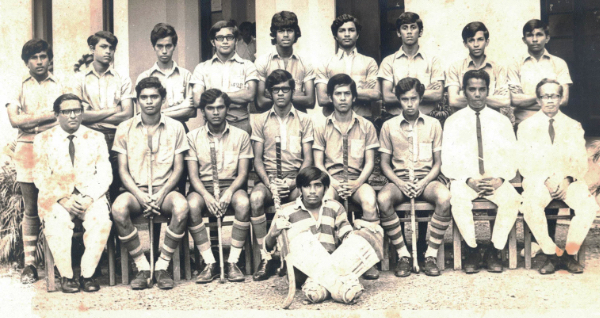
Mr.A.S Wirasinghe- Athula Wickramasinghe- Ananda Karunaratne - Christopher Harvie - Mervyn Lye - Geethal Peiris - Mr.A.K.Suppiah - Mr. D.Fernando
Standing L-R
Nandalal Hemachandra, xxx, xxx, Lalith Hemachandra, Russel Kern, xxx, S Sadanandan, Claude de Silva, xxx
Goalie: xxx
1st XI Team 1963
Kindly sent to me by Upali Perera and Bashur Musafer

W.Deutrom, S Wickramaratne, Upali Perera(Capt), Mr L.A Fernando, I.Thurairajah (Vice Capt) C.T Rodrigo, Lal Fernando
Standing: L to R:
D Thiagalingam, H Musafer, Devaraj,T.Maye, R.Jayasooriya
...........................................
Hockey Season 1963
Upali Perera (Capt) I Thurairajah (V.Capt)
Fixtures
St Thomas College
De Mazenod College
Kingswood College
Ananda College
St Benedicts
Trinity College
St Joseph's College
Won 5 Matches
Lost 2
Number of goals scored 16
Number of goals against Wesley 4
...........................................
From the Newspapers
Wesley beat Kingswood
In a fast and exciting game Wesley College registered a good 1-0 win over Kingswood in an inter collegiate Hockey Match Played at Randles Hill, Kandy on Saturday. At half time there were no scores.
From the first whistle Kingswoodians set a scorching pace but Wesley undaunted defence kept them away from scoring.
After the breather Wesley followed suit by increasing the pace of the game and in one of the movements initiated by the forward line CT Rodrigo playing as centre forward netted a goal.
Wesley Beat St Joseph's College
Their fifth win for the season
(By our Hockey reporter)
Wesley College registered their fifth win of the Inter-collegiate hockey season, when they defeated St. Joseph’s by four goals to nil at Campbell Park yesterday evening. At halftime Wesley led 3-0.
For the first ten minutes the Josephians held sway and during this period they raided the Wesley goalmouth although i without success. With a little time to settle) down, Wesley proved their superiority. Their forwards, who had the backing of the halves and backs played well to chalk up a clear cut win.
In the Wesley forward line the combination of Sarath Wick- ramaratne and Thiagalingam was outstanding. Two of the goals scored came off the good | understanding shown by these two players. Halves Rajah Jayasooriya and Lai Fernando at centre-half position gave good ^counts of theselves.
Messrs. Homer Fernando and Subramaniam umpired.
Benedictines lose to Wesley 1-2
Wesley registered yet another creditable win in their hockey season this year when they beat the strong St. Benedict’s team by 2 goals to one in their inter-collegiate fixture played yesterday a Campbell Park. The winners led 2—0 at half time.
It was their splendid team work and constructive play that enables the Wesleylte* to overwhelm their opponents.Time and again the Wesleylte forwards broke through the Benedictine defence, but they met considerable resistance when they came up against the Benedictine right full-back Charles.
After several attacks on the Benedictine goal the Wesleyites succeeded when their right-outer Sarath Wickramaratne put the finishing touches to a fine mow initiated by their centre-forward Pressing on with this success, they scored yet another goal, again through Wickramaratne. this time off a move initiated by the centre-half.
Changing ends the Benedictines fought hard, but all their efforts were thwarted by the fine goal-keeping of William Deutrom who made some grand saves. Midway in the second period of play the Benedictines suceeded when centre-forward Nuttal beat the goal-keeper with a bullet-like drive, to reduce the lead 2-1.
Wesley find it easy
Wesley scored a runaway 0-7 victory over Ananda at Campbell Park. Ananda defence couldn’t counter the fast attacks by the Wesley forwards. Devaraj, CT Rodrigo and Raja Jayasooriya were outstanding. Their fast forward thrust found the Anandians in difficulty.
The Ananda defence was weak. Raja Jayasooriya playing inside right gave a sparkling display scoring a hatrick. Within 5 minutes Devaraja scored the first goal. C.T Rodrigo scored the final goal.
Wesley prevail in a game of missed chances
After a great struggle for supremacy Wesley College just made it when they edged through to a 1-0 win over De Mazenod College the match played at Campbell Park. There was no score at half time. The Kandana boys shared the exchanges having been used to the same conditions as Campbell Park.
It was a game of missed chances. Wesley should have scored two goals during the first half. Wesley’s forwards were more concerned of personal glory than the tall for the school. The right back Shirley Amarasekera gave a fine display in defence. He was always on the ball and foiled some feeble Wesley efforts. Had it not been for Amarasekera Wesley would have scored 3 more goals.
For the winners Sarath Wickramaratne, Thiagalingam, Centre forward C.T Rodrigo, Thurairajah and T.Maye were outstanding. Midway in the second half Wesleyites made certain of their win. When off a free hit Raja Jayasooriya passed to Rodrigo but made a mistake with the hit from the top of the circle.
Links to further reading
1st Team 1956

..................................................
1st Team 1959
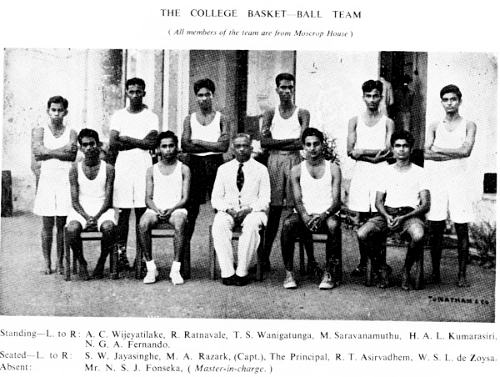
1st Team 1961
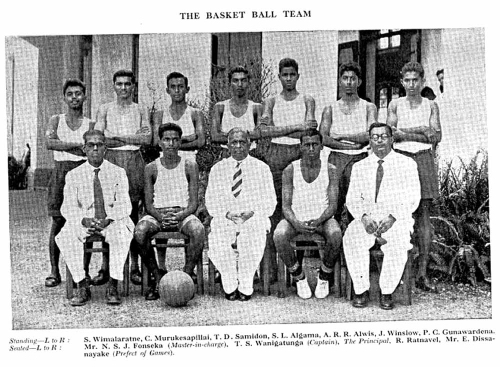
1st Team - 1946
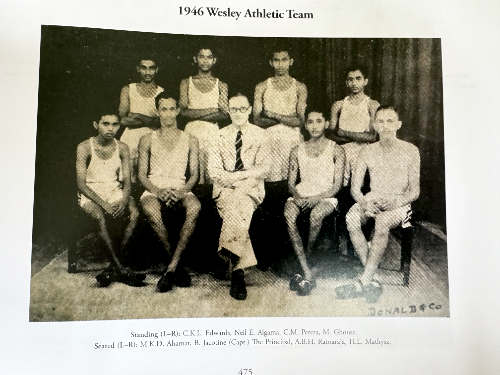
..................................................
1st Team - 1948

..................................................
1st Team - 1959
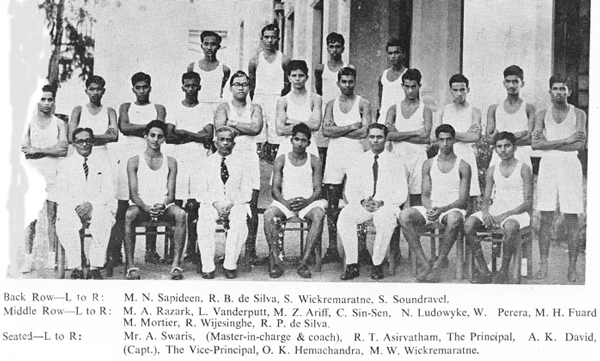
..................................................
1st Team - 1968
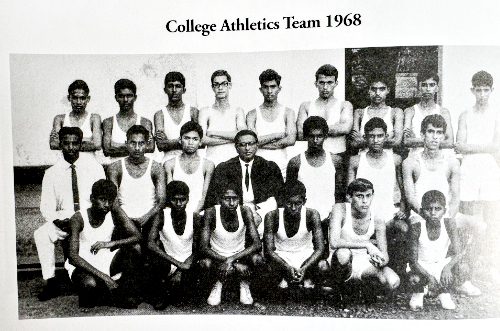
..................................................
1st Team - 1969
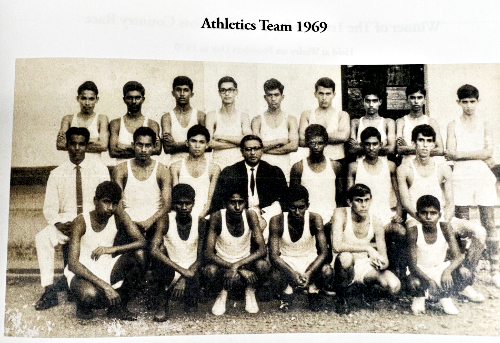
..................................................
1st Team - 1970
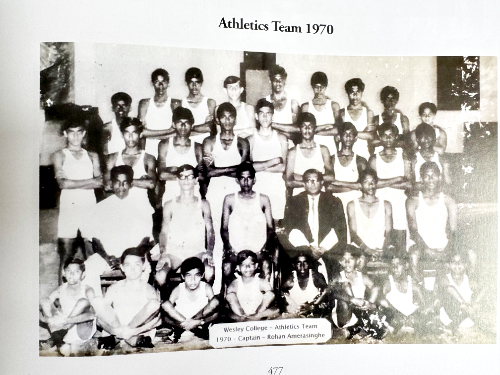
..................................................
1st Team - 1971
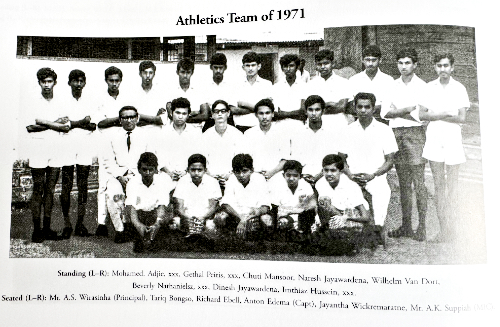
..................................................
1st Athletics Team - the year not known
From N.D.Amerasekera
The following photo and script were sent to me by a loyal old boy Yohan Raju. Due to the passage of time and disuse he cannot recall the names of some friends in the picture which he apologises unreservedly. If any Wesleyite can help us "to put names to faces" please contact me on this website. The scratches in the picture merely adds to its historical value. I belong to an earlier era but Oh! what nostalgia to see the music class on the left, the Kindergarten on the right and the old "takarang" Tuckshop at the back.
Yohan Raju writes:
Attached is a photo of the College Athletics team. I honestly cannot remember which year this was taken! I suspect that it was in the late 60's or early 70's - most probably 1968, 1969 or 1970. I am also sure that I spelt some of the names wrong - I apologise for that. I will attempt to give you the names of those in the photo that I remember - but not all.

Seated L to R: Mr A.S Wirasinha, Tariq Bongso, Richard Ebell, Patrick Edema, Jayantha Wickramaratne, Mr A.K Suppiah (Master in Charge - Athletics),
Front Row seated: Trehern Keil, Yohan Raju, ????, ????, Rajkumar Chinniah
..................................................
1st Team - 1983
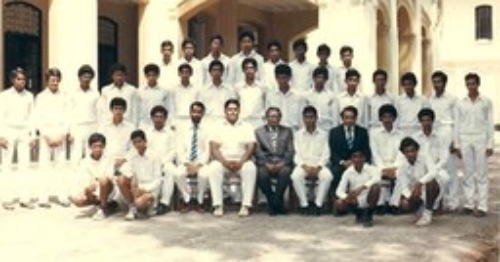
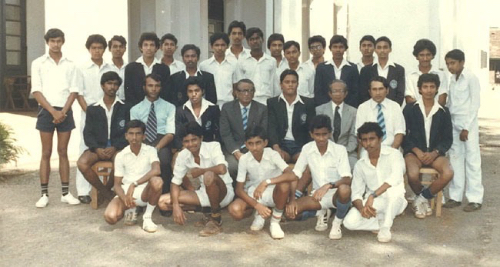
..................................................
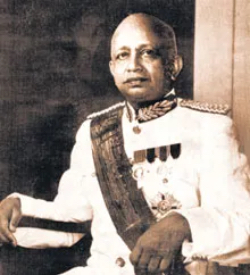 Wesley College Colombo and St Thomas College Mt Lavinia have embarked on a trophy game in the schools rugby arena. The trophy is to be named after the most illustrious Sir Oliver Goonetilleke and will be worked off on the 15th May 2015 at the Havelocks Sports Club.
Wesley College Colombo and St Thomas College Mt Lavinia have embarked on a trophy game in the schools rugby arena. The trophy is to be named after the most illustrious Sir Oliver Goonetilleke and will be worked off on the 15th May 2015 at the Havelocks Sports Club.
A media conference was held yesterday at the Wesley College hall in connection to this at which plans for the encounter were unveiled.
Old boys of both schools participated in this occasion and Jeremy Brohier- President of the Wesley College old boys Union, Clifford Rodrigo- Sports Administrator of Wesley College, Varuni Sumthirathne, a Member of the Goonetilleke Family, Farman Cassim - Match Coordinator and Sisira De Silva- Director of Sports St. Thomas’s College were present at the head table.

Considered an outstanding public servant, Sir Oliver Goonetilleke Ceylon’s first Ceylonese Governor General and a colourful personality was one of Wesley’s five illustrious Knights and arguably Wesley’s greatest alumni. As the unsung hero, very few in the public domain know that he was responsible along with the late Hon. D.S Senanayake for achieving Sri Lanka’s independence in 1948.
Sir Oliver did not fail to recall with gratitude the education he received at Wesley, and that the bursaries and scholarships played a valued part. Bestowed with the Hill medal which is the supreme award of the College for a record three consecutive years in 1908, 1909 and 1910, Sir Oliver maintained an abiding interest in Wesley and made several contributions for its improvement. Teaching at Wesley for a few years and later passing the London B.A. and the London Inter Science (Economics), Sir Oliver served as President of the Wesley College OBU from 1940 – 1949 and once again from 1953 – 1963, the longest to serve in that capacity
 Starting off the proceedings at the media conference Mr. Farman Cassim explained the importance of Sir Oliver and that such an encounter is organized to keep his memory alive. He also said ‘In honour of such gentleman we are organizing this rugby match against the 2 main Christian schools in this country. I also thank the Warden of S. Thomas’s for accepting our invite and joining hands with us to make this a success.’
Starting off the proceedings at the media conference Mr. Farman Cassim explained the importance of Sir Oliver and that such an encounter is organized to keep his memory alive. He also said ‘In honour of such gentleman we are organizing this rugby match against the 2 main Christian schools in this country. I also thank the Warden of S. Thomas’s for accepting our invite and joining hands with us to make this a success.’
Talking about this event Mr. Clifford articulated that this could be the’ battle of the blues’ for rugby. He also mentioned that from the time he has been representing Wesley college, both schools have been performing with great sportsmanship and it would be a privilege to play against S. Thomas’s College.
The Goonetilleke family has donated the trophy and Miss. Varuni spoke on behalf of them. She expressed her thoughts on how proud it is to be a part of Sir Oliver’s family. She thanked the organizing committee for bringing alive a part of history and also the principal and the warden for letting the teams play against each other.
This clash could be a friendly or a tournament match as the league is yet going on. It will be decided by this Saturday. If St Thomas' win against St Anthony’s this will be an additional game. If they lose both teams are likely to go into the plate and thus it will end up a league game.
The organizers invite all the supporters of the two schools to witness what would surely be a nail biting episode.
From Bashur Musafer, Sydney, Australia
 Athletics being a sport of individual talent, prowess and immense dedication never kindled much interest among many a schoolboy. It was perhaps dull ,boring and lacked fun and team participation. One had to be extremely talented and successful to be recognised as a champion in the Track and Field arena whereas playing in a team was a far better, enjoyable and easier prospect.
Athletics being a sport of individual talent, prowess and immense dedication never kindled much interest among many a schoolboy. It was perhaps dull ,boring and lacked fun and team participation. One had to be extremely talented and successful to be recognised as a champion in the Track and Field arena whereas playing in a team was a far better, enjoyable and easier prospect.
However playing a team sport exposed one’s talents and capabilities to indulge in another sport or athletics as was the case at Wesley. It could be said that Athletics was by and large a by product of the multi talented sportsmen of Wesley and therefore of secondary interest.
Wesley as I recall did not have a dedicated Athletic coach. Mr Kirupairajah on his return from the USA was one for a brief period. Mr Nissanka was another dedicated PTI who also took a great interest in Basketball and Volleyball during my time.
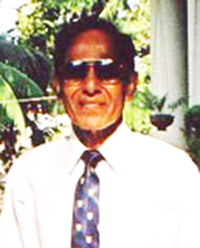 Whilst many a Wesleyite had excelled at College, Colombo North, Public Schools, Club and National level M A M Sherrif would be the only athlete to achieve international fame having represented Ceylon in the Empire games.
Whilst many a Wesleyite had excelled at College, Colombo North, Public Schools, Club and National level M A M Sherrif would be the only athlete to achieve international fame having represented Ceylon in the Empire games.
From the Editor: MAM Sheriff was in the school boarding and won the coveted Lydia Senaratne Memorial Prize in 1946 for the best all rounder in the hostel. He held the prestigious office of Senior Prefect in 1949.
MAM Sheriff was an outstanding athlete for school and country. He represented Ceylon in the British Empire Games (Now known as the Commonwealth Games) held in Auckland New Zealand in February 1950 where MAM Sheriff was placed 7th in the order of merit in the Long Jump clearing 21ft 6 inches. This was a great achievement in a strong field of British and African athletes. Duncan White, an old Trinitian, won Gold for the 440 yards Hurdles at the Empire Games in 1950. He had won Silver at the 1948 Olympic Games in London. M.A.M Sheriff continued his studies at Oxford University where he won an Oxford Blue in Athletics.
.....................................
This short list is an incomplete summary of Athletes of an era now long gone.
Athletes of Wesley 1950 to 1970
Sherrif M A M -1950 Empire Games (Late)
Samuel Frank- Colours Public Schools award
Alalasunderam T & Public Schools & Cricket (Late)
Van Rooyen Trevor - 100 & 200 yds (Late)
Perera Bertus -220 & 440 yds & Cricket (Late)
Matthysz Harold -Pole Vault & Cricket (Late)
De La Harpe Norman (Late) Australia & Cricket
Campbell Ian -High Jump (Late)
Woutersz Ralph (Late) Australia -Hurdles
Adhihetty Vincent- Colours & Cricket (Late)
Rajasingham L R colours 1958 & Cricket (Late)
Rajasingham S M colours 1958 & Cricket (Late)
Abeysuriya Nalendra Colours 1957 & Cricket (Late)
Goonewickrema Joy Colours 1957
Dwight Kirubai- Colours 1957 & Rugby (Late)
O.K Hemachandra - Public Schools Athletics/Ceylon Relay team - school records in the 110 meter hurdles and 400 meters, National Champion in the 400 meters in 1963, Soccer Colours
Athletics 1st Team - 1959

..................................................
Sappideen M Nizar - Athletic Colours & Soccer
De Silva R S
Wickramaratne Sarath Public Schools & Cricket
Soundravel S
Razark M A M - (Late) & Senior Prefect & Soccer,
Vanderputt Layton & Boxing
Ariff M Z— Boxing & Soccer
Ratnavel S— Basketball & Soccer (Late)
Sin Sen Chang (Late) & Senior Prefect & Rugby
Ludowyke Nevile Rugby (Late)
Perera W
Fuard M Haris (Batcha) New Zealand & Cricket
Mortier Morris
Wijesinghe Rohan -Badminton
De Silva R.P (Dynamite) (Late)
Asiriwatham Ronnie T Public Schools Champ
David Alfred K - Capt Public Schools & Rugby (Late)
Hemachandra O K Public Schools/ Ceylon Relay team
Wickramaratne M W (Mynah) (Late)
Other athletes names as recalled by Bashur Musafer and Conrad Fernando 1962 -1968
Alwis K.R Ranjit (Late)
Akmeemana Ranjith Half Miler Public schools
Amerasinghe R Relay Team
Bartholomeusz Reginald Public schools Champ
Christoffelsz Nigel -
Cooray Nihal
De Silva Upul
Fernando Conrad - Public Schools Pole Vault/Relay
Fernando Lal- Colours Public Schools & Cricket
Fernando Hemal- Public School 400m
Gnanapragasm Mano & Rugby colours (Late)
Jayasinghe S Cricket
Jayasekera Hemaka Rugby & Soccer
Keil Derrick - Rugby
Koch Neville
Maye Darrel Public Schools Half Mile& Cricket
Maye Tyronne - (Late) Hockey & Cricket
Mclelland Ranjith - Athletic & Hockey Colours
Mendis Somaweera
Murugesupillai Ananda (Late)
Murugesupillai Chandra - Athletic colours & Soccer
Musafer Bashur - Athletic colours & Rugby & Soccer
Perera Rodney K High Jump & Cricket (Late)
Saldin T M S (Bunny) & Rugby & Soccer
Samidon T Dalkin -Soccer & Basketball
Somanathan Ratnasamy -Soccer
Suraweera Malik -HighJump (Late)
Colin-Thome Denis Migrated to Canada
Wanigatunga T S - (Late) & Senior Prefect & Soccer
Wickremaratne Sarath Athletic Colours & Soccer
Winslow J Athletic Colours 1962 - Pole Vault
Athletics Photos
The only photo circa 1969/70 to 1978

Raju Yohan
Adjie Mohamed
Mansoor Chooti
Chinniah Rajkumar
Keil Trehern
Edema Patrick
Bongso Tariq
Wickramaratne Jayantha
Ebell Richard - Capt -
Jayawardene Dinesh
Jayawardene Naresh
Nathanielsz Beverly
Ginger Carlyle
Vandort Wilehelm
Hussein Imtiasz
1970 to 1978 No Photographs, Articles or Information Available. If anyone in possession please send to the Editor DBI
.................................................
Links to further reading
From the Island Newspaper 3rd February 2021 - By K.L.F. Wijedasa
 Duncan White, Lakshman Kadirgamar, Oscar Wijesinghe and M.A.M. Sherrif represented the four communities when they brought four scrolls to the Independence Square to be handed over to the Prime Minister D.S. Senanayake to be read for the public to hear.
Duncan White, Lakshman Kadirgamar, Oscar Wijesinghe and M.A.M. Sherrif represented the four communities when they brought four scrolls to the Independence Square to be handed over to the Prime Minister D.S. Senanayake to be read for the public to hear.
After 400 years of Western domination Ceylon as Sri Lanka was known gained Independence on the 4th of February 1948. Heralding the occasion four athletes from the four corners of the Island brought four scrolls to the Independence square to be handed over to the Prime Minister D.S. Senanayake to be read for the public to hear.
The four reputed athletes represented the four communities. They were Oscar Wijesinghe (Sinhalese), Lakshman Kadirgamar (Tamil), Mohamed A Sherrif (Muslim) and Duncan White (Burgher). Arriving at the Independence Square they handed over the scrolls to young females representing the four communities. Swarna Amarasuriya (Sinhalese), Srimani Ramachandran (Tamil), Ayesha Zally (Muslim) and Phyllis de Kretser (Burgher). In turn the four damsels handed over the scrolls to the Prime Minister who read them over the public address system.
It was indeed a happy coincidence that in the very same year Sri Lanka made her debut at the greatest sporting spectacle in the world, as an independent nation. A team comprising of three athletes and three boxers represented the country at the XIV Olympic Games in London 1948. No one ever dreamt that any of the participants would ever win a medal at the greatest sports festival after the Second World War. In the final of the 400m Hurdles event Duncan White of Sri Lanka though beaten by Roy Chocran, USA to second place lowered the existing Olympic record skimming over the hurdles in 51.8 secs. Thus getting the first medal to Independent Sri Lanka at an international sporting event. Commenting on the breath taking performance, the President of the Sri Lanka Olympic Association said that “White has done more for Sri Lanka in 51.8secs than all the propaganda over 100 years”. This athlete was none other than one of the athletes who brought the scroll to the Independence Square on 4th February 1948.
Duncan White proved that his performance at the London Olympics was not a flash in the pan at the British Empire Games in Auckland New Zealand in 1950 (now known as the Commonwealth Games). His noteworthy performance of 52.5secs not only won the gold medal and the Empire Games record, but was just outside the world record for the event by one fifth of a second.
Subsequently the other three athletes too performed well for the country. Oscar Wijesinghe and M.A.M. Sherrif represented the country at the British Empire Games along with Duncan White. Oscar Wijesinghe a Public Schools athlete, representing the University of Ceylon won the 100m at the All India and Ceylon Inter University Championships. He established a Sri Lanka record in the 100m in 11.0 seconds in 1949 (The writer too equalled this record in 1955).
Lakshman Kadirgamar won the 110m Hurdles event at the Public Schools Meet and later won the Nationals in 1951. At the All India and Ceylon Inter University Athletic Meet too he won the above event.He finally became the Foreign Ministers of Sri Lanka.
From the Editor:
M.A.M Sheriff was at Wesley College during the Principalship of Rev James Cartman. He held the prestigious office of Senior Prefect in 1949. MAM Sheriff was in the school boarding and won the coveted Lydia Senaratne Memorial Prize in 1946 for the best all rounder in the hostel. He was an outstanding athlete for school and country. M.A.M. Sherrif represented Ceylon in the British Empire Games (Now known as the Commonwealth Games) held in Auckland New Zealand in February 1950 where he was placed 7th in the order of merit in the Long Jump clearing 21ft 6 inches. This was a great achievement in a strong field of British and African athletes. Duncan White, an old Trinitian, won Gold for the 440 yards Hurdles at the Empire Games in 1950. He had won Silver at the 1948 Olympic Games in London.
M.A.M Sheriff continued his studies at Oxford University where he won an Oxford Blue in Athletics.
He was domiciled in the USA and passed away in January 2014 while on holiday in Sri Lanka. He was 85 years.
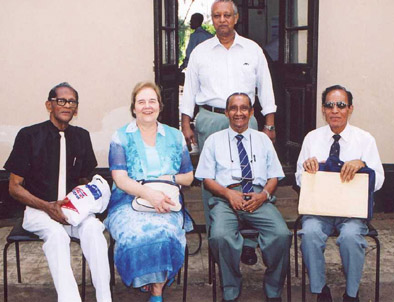
L to R: : Shelton Peiris, Christine Weaver, Mervyn Peiris and MAM Sheriff,LV Jayaweera standing
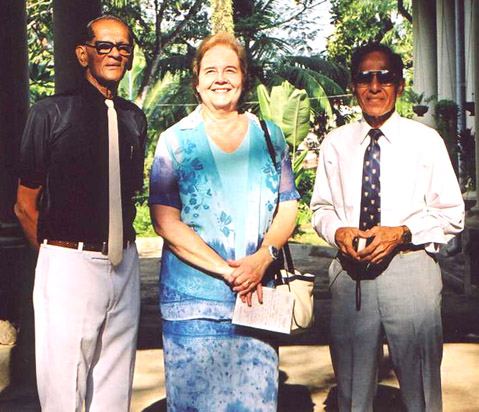
L to R: Shelton Peiris, Christine Weaver, and MAM Sheriff
....................................................
1950 Ceylon Team for the British Empire Games held in Auckland New Zealand
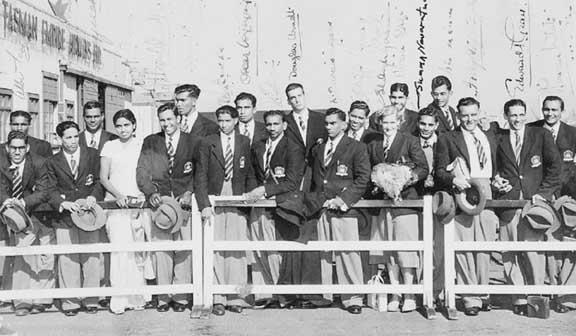
L to R: M.A.M.Sheriff, Albert Perera, J.R.de Silva, A.I.Obeyasekera, Mrs. H.N.P.Perera (the manager's wife), Somapala, Oscar Wijesinghe, K.Edwin, Douglas Arndt, K.Duraisingham, Clifford Jansz, Shelagh Gaddam, Vivien Blaze, Summa Navaratnam, John de Saram, Harry Nightingale (swimming coach), Edward Gray and Duncan White.
Links to further reading
Wesley’s Cricketing History 1887-1910
1887 The Principal’s prize day report mentioned that permission had been granted to use Price Park Pettah for cricket practice.
1892 Wesley 1st XI met Royal College “A” team on the 3rd of March including some masters. This is the first recorded cricket match by Wesley College Colombo.
1893 Wesley met Royal in their inaugural 1st XI match. Royal beat the inexperienced Wesley team.
1895 Wesley met Trinity in their Inaugural 1st XI match.
1897 Wesley beat Royal and did so for the next three years. Emergence of the most graceful Batsman in Ceylon cricket – C.E. Perera in the Wesley team.
1897 Wesley Met St. Thomas’ Mt. Lavinia in their Inaugural 1st XI match.
1899 C. E. Perera elected captain combined colleges XI against colts C. C., the strongest Ceylonese combination at the time.
1907-11 The golden age of Wesley Cricket. Royal were beaten for five years. Wesley produced Some fine cricketers during this period, mainly left arm bowlers and batsman. T. Sathasivam, R.E.S. Mendis, F.W. Dias, S.Gunasekara, D.M.Rupasingha, E.J.Melder, And C.A. Perera (all left handers, batting and bowling).
1910 - Wesley met Ananda College in their 1st XI Inaugural match.
1st XI Cricket Team 1908 - The very first year after move to Karlsruhe Gardens

S.Gunasekera, D.M.Rupasinghe, E.A.Gunasekera, E de Silva, U.Gunaratne, Rev.Henry Highfield
Seated:
W.D.Lewis, S.Nagendra, F.W.Dias, O.C.Amarh, R.F.S.Mendis
Links to further reading
From the Daily News Sri Lanka 20th November 2023 by Dhammika Ratnaweera reporting from India
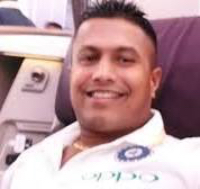 There is an unknown Sri Lankan with Indian cricket team .He is none other then Indian throwing coach Udenaka Nuwan Seneviratne better known as “Bawwa”.
There is an unknown Sri Lankan with Indian cricket team .He is none other then Indian throwing coach Udenaka Nuwan Seneviratne better known as “Bawwa”.
Virat Kohli who reached the milestone of highest number of ODI centuries (50) remembered three men for his success .One man is Nuwan Seneviratne ( Bawwa) the throwing coach.
When the writer had chance to cover the India – Sri Lanka match and India – New Zealand semi final both in Mumbai there was an active msn behind the boundary line always with a water bottle , Energy drink or with the towel and used to help players and we spotted when Virat comes to the boundary line Bawwa always follows him. This is is extra duty apart from throwing coach. When the India team trains Bawwa is very busy man. He is throwing the ball to batsmen and also assists in fielding practice.That is why Virat always says Bawwa played a key role in his success. Bawwa can throw the ball at top speed and those days Mahela Jayawardena and Kumar Sangakkara got his service to build up their batting skills.
Bawwa is today vey popular among Indian team and he is well looked after by India Cricket Board ( his one months salary equal to ten months salary from Sri Lanka and when India team sing the National anthem before the match Bawwa also joins the team singing Indian National anthem.
He hadn’t good history in Sri Lanka.After leaving school ( Wesley College ) Bawwa left for UAE for a job .But that was not successful and he had to return home.
He was very keen to play cricket and he got chance to play division two cricket at CCC in Maitland Place. He got chance to play only two first class matches and his cricket journey was not successful .First he started as an office van driver and his duty was to bring officials to office in the morning and in the evening drop them at home. When he worked as van driver he used to park his van near the NCC grounds close to Sri Lanka Cricket headquarters.At his free time he used to go to NCC grounds and watch the Sri Lanka A team practice At that time Manoj Abeywickrama was the Sri Lanka A team fielding coach and was promoted as National team fielding coach.
Bawwa started to give assistance to Manoj Abeywickrama. At that time everyone realized Bawwa ‘ s talent .Bawwa did very well and he was throwing ball to batsmen and his skill was very important to all batters that time. Bawwa ‘ s left arm is very strong and he has ability to throw the ball 145-150 kmph. After this success Bawwa got chance to enter the Sri Lanka A team as throwing coach and this was his turning point.
In 2016 Sri Lanka – England tour Bawwa got chance to enter the National team as (Assistant fielding coach.At that time Sri Lanka head coach Graham Ford used Bawwa as Throwing Specialist. He worked hard to do his duty and one time he can throw 150kmph speed. Some times Bawwa’ s throw hurt batsmen and some players feared facing Bawwa.
When Bawwa worked with Sri Lanka A team he had a clash with Sri Lanka A coach and that was way back in 2017. At that time he lost his SLC job and luckily former India Batting coach Sanjay Bangar invited Bawwa to join them with a higher offer and Bawwa got that chance and from 2018 Bawwa is doing great service to India and Sri Lanka lost his service.
Today Bawwa is proud team member of India and he is looking forward to do well M.S Dhoni ,Rohit Sharma,Suresh Raina,K.L Rahul ,Virat Kohli trained under Bawwa.
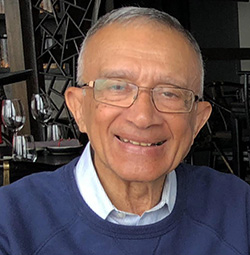 I joined Wesley College on the 8th of January 1950 and remember to this day being mesmerised by the elegant sweep of the beautiful buildings. Playing and watching cricket was one of the most enjoyable things of my time at Wesley. There was a park behind the school we called the small park. It was in a dip in the Karlsruhe Hill, a veritable dust bowl. Here we played soft ball cricket before school started, at the intervals, and also after the school closed. Cricket then was all consuming.
I joined Wesley College on the 8th of January 1950 and remember to this day being mesmerised by the elegant sweep of the beautiful buildings. Playing and watching cricket was one of the most enjoyable things of my time at Wesley. There was a park behind the school we called the small park. It was in a dip in the Karlsruhe Hill, a veritable dust bowl. Here we played soft ball cricket before school started, at the intervals, and also after the school closed. Cricket then was all consuming.
A tangle of emotions tumble through my mind as I reflect on the cricket matches at Campbell Park. Sixty plus years is a long time. I have travelled into the past and searched the deepest crevices of my mind to gather these memories. Looking into those archives was a wonderful experience and it is my hope this will remind Wesleyites of their own time at school.
The cricket team was announced on Friday, at assembly. It was the custom to sing the College Song. The school matches started on Fridays and on Saturdays at 12 noon. Each side played 2 innings. Campbell Park was our amphitheatre. Watching the school matches was a ritual never to be missed. Despite the 60 plus years I still have vivid and nostalgic memories of the matches. Even now while reading and recalling them, the tension of the games is never far away. The schoolboys, old boys and well wishes lined up on the Campbell Place side of the park and the visitors gathered on the opposite side. The boys assembled in large numbers under the massive “Mara” trees adjacent to the main road. Seated on the grass, with the sun on our backs, we sang and chanted waving the school flag. “Zam Zam Zaky” and the school song broke out spontaneously. Mr L.A Fernando, a senior teacher of my time, often rallied the troops to sing and support the school. When wickets fell we sang “What’s the matter, minor matter”. There was a carnival atmosphere all around the park. Alerics and Piccadilly Ice cream vans, with their whirring engines provided the sustenance while the ‘achcharu’ ladies and peanut vendors enjoyed a brisk sale.
To play 1st eleven cricket for the school was a great honour and a privilege. Cricketers were idolised and were greatly respected by all. That intoxicating amalgam of praise and public acclaim can be destructive. Despite their teenage years they received this adulation with poise and dignity. Conceit grows imperceptibly and the person who is afflicted is unaware of it. The hard knocks of our lives at school and those in the cricket field were enough to tone it down. Much has to be said about the discipline and training at Wesley which helped to groom such men of modesty and valour. I must say I looked at them with immense reverence and respect.
Cricket in those days was a gentlemen’s game and more so was school cricket. Umpires word was sacrosanct. We congratulated the opponents’ achievements in the field. We walked away when we felt it was out although the umpires did not see. The players never showed dissent. When we lost although crest fallen and frustrated clapped the opponents back to the pavilion. Those injured in the heat of the battle were comforted by the opposing captain. Such was the spirit of sportsmanship amongst the players.
The 1950’s and 60’s were the ‘Golden Years’ of cricket at Wesley. It was over a decade of excellence. Bryan Claessen, M.N Samsudeen, Abu Fuard and L.R Goonetilleke had the distinction of being selected to play for Ceylon/Sri Lanka while at school. This was a great honour and a prestige for the school. D.B.C Mack captained the two successful years of 1950 and 51. After completing his university degree he returned to teach at school, briefly. 1952 to 53 were the Claessen years when Radley and then Bryan captained the teams. The hostile bowling of M.N Samsudeen and the Claessen brothers and the aggressive batting of Patrick Schockman brought us tremendous success. In those days the barometer of success was the performance against St. Thomas’, Royal and St. Joseph’s. We remained unbeaten in those years. In that decade we had a galaxy of exceptional talent. Ansar Fuard captained in 1954. He was an astute captain and was ably assisted by his brother Abu’s fine off spin bowling to complete a very successful year. Ansar and Abu followed in the footsteps of their father who captained in 1915. Lou Adhihetty captained in 1955/56 and we were unbeaten. Lou is still considered one of the most brilliant all-rounders in the school's history. L.R Goonetilleke must be the best fast bowler we’ve ever had. His accurate left arm spears broke the back of many school teams. I must pay homage to Harold Juriansz who captained in 1957, Nalendra Abeysuriya 1958/59, Senthil Sinniah 1960 and Don Kodituwakku in 1961. L.C.R Wijesinghe captained a successful unbeaten team in 1962. They were all inspirational leaders and were a credit to the school. Their cricket will be remembered and admired forever for the dignity, integrity and sportsmanship.
The enchantment of the cricket matches of my childhood still haunts me. At school Cricket was not only a game but a way of life. My lasting memory of cricket at Campbell Park is the sight of the setting sun behind All Saints Church with its lengthening shadows. The Church bells rang at 6 o'clock. As the bails were lifted, we all departed discussing the ebb and flow of the days play. Losing a match in those days was like the end of the world, but we always bounced back. It was certainly a good training to face the peaks and troughs of our own lives. The songs we sang and the friends I made are etched deeply in my memory. After leaving school in April 1962, I continued to watch matches at Campbell Park. The magic and the aura of this extraordinary spectacle seemed to change imperceptibly with the passage of years. Then building my career and raising a family took precedence. I never saw any matches at Wesley again. Ah! Those were the days.
We are greatly indebted to the many who have played an important role in maintaining the high standard of cricket at Wesley. The ascendancy in cricket began during the Principalship of Rev James Cartman(1945-49). His support and enthusiasm for the game is legendary. He will be remembered forever for introducing the Wesley College War Cry: Zam Zam Zacky, Zam Zam Zay, Ishuba Ishuba, Hoo Ha Hay I appreciate the huge support given by the Principals, Mr C.J Oorloff, Mr P.H Nonis and Mr A.S Wirasinghe. Mr Nonis was a fine cricketer and captained the school in 1921, during the Highfield era. Until 1943, Campbell Park was the grounds of the Tamil Union Sports Club. When Mr Nonis was the Vice Principal he procured Campbell Park for Wesley College. We will remain eternally grateful to Mr Nonis for his exceptional foresight and wisdom. No one has had a greater impact on cricket at Wesley than Mr Edmund Dissanayake. He captained the school in 1946/47. He is rightly called the doyen of cricket at Wesley for his tremendous commitment to the game. He has served as the Master in Charge and also coach for over a period of nearly 40 years. My heartfelt thanks posthumously to Wilbert the chief groundsman, Cricket Coaches Mr A.V Fernando and Mr B.J.H Bahar and also the Master in Charge of cricket in the 1950’s, Mr J.L.F De Mel. They made it all happen in the background while we sang and beat the drums beyond the boundary.
To me, those years at Wesley have been one rich gift. Wesley College has played cricket since 1893. This is an opportunity to pay homage to the many who represented the school over the years. I dedicate these notes to all who entertained us but have now departed this world. They have done us proud. We hold them all in high regard.
Although the atmosphere at school matches have changed, the ethos of the game of cricket is timeless. This indeed is an account of school cricket from a different era but in no way diminishes the value and the prestige of the game played in Campbell Park in the 21st Century. I recognise and admire those who represent the school now and hold them in high esteem. Although I live in London there are times my mind crosses the mighty oceans and the vast swathes of land to that green and pleasant Campbell Park, the grounds where as a schoolboy I once watched the cricket unfold. The sheer magic and the memory of those games will live with me forever.
As George Bernard Shaw said:
A dialogue with Jeremy Brohier by Muaard Razick
 Today, the Daily Morning Sports will go down the memory lane to the glorious days of schools cricket in the island nation where almost all top traditional schoolboy games regardless whether they were ‘big matches’ or normal games, attracted a large fan base surrounding the venues. We spoke to Jeremy Brohier, a senior alumnus hailing from a sporting school, Wesley College Colombo. Here Jeremy takes us through timeless classics of his heydays playing for the school on the Karlsruhe Hill which in the words of one of their great principal’s M.A.P Fernando, considers every century-old traditional cricket match versus (Royal, S. Thomas’, Trinity, Richmond, St. Benedict’s, Kingswood, St. Joseph’s) as a big match. The second oldest uninterrupted cricket encounter in Sri Lanka after the Royal-Thomian is the Royal-Wesley game which dates back to 1893. Wesley, celebrating its 150-year sesquicentennial in March this year, continues to-date the no ‘big match’ policy and carries on the fundamentals of their forefathers – A school of the
common man.
Today, the Daily Morning Sports will go down the memory lane to the glorious days of schools cricket in the island nation where almost all top traditional schoolboy games regardless whether they were ‘big matches’ or normal games, attracted a large fan base surrounding the venues. We spoke to Jeremy Brohier, a senior alumnus hailing from a sporting school, Wesley College Colombo. Here Jeremy takes us through timeless classics of his heydays playing for the school on the Karlsruhe Hill which in the words of one of their great principal’s M.A.P Fernando, considers every century-old traditional cricket match versus (Royal, S. Thomas’, Trinity, Richmond, St. Benedict’s, Kingswood, St. Joseph’s) as a big match. The second oldest uninterrupted cricket encounter in Sri Lanka after the Royal-Thomian is the Royal-Wesley game which dates back to 1893. Wesley, celebrating its 150-year sesquicentennial in March this year, continues to-date the no ‘big match’ policy and carries on the fundamentals of their forefathers – A school of the
common man.
Our protagonist today, Jeremy Brohier, one of the last remaining roots in the renowned Brohier clan, and known as the walking historian of his alma-mater since he compiled Wesley to the fore (The history of Wesley cricket) in 2012, a book published celebrating 125 years cricket at Wesley and is now lying in the National Archives and the National Library of Sri Lanka. His greatest feat would be the upcoming Chronicle of Wesley set to be launched in March this year; after 6-years of daunting research with a dedicated team including Kumar de Silva, Susan Brohier, Ubewansa Warnakulasooriya, Joshua Siriwardena, Lakshman Uduwara, Dilshan Boange, Miles Brohier, Peter Peiris, Chryshan Rodrigo, and Avanka Fernando, it’s a 822-page masterpiece that documents Wesley’s journey of 150-years.
We sat down with Jeremy last weekend at Campbell Park whilst the Trinity versus Wesley encounter for the R.L. Kannangara Trophy was in full swing where Janith Ravishka of Trinity broke the hill capital school’s all-time batting record scoring 241. Let’s now take the long-winding road to the early 1960s where Jeremy Brohier recollects his boyhood cricketing memoirs at Karlsruhe.
By some quirk of fate, I gained admission to Wesley in 1965 although I was born to a family of Josephians. Following me were my two brothers, Miles and Perry. Miles was more studious than Perry and myself. While Miles did not participate in any sporting activities at Wesley, both myself and my youngest brother Perry were a part of Wesley 1st X1 cricket teams. My 1st X1 cricket career began in 1974 as a fresher at the age of fifteen under the captaincy of Dayalan Sellamuttu in 1974, which was the centenary year of Wesley. I continued to be a member of the team until 1977 under the captaincy of Dilangen Jayasekera. Perry went on to represent Wesley from 1983 and was the opening bowler partnering Mahendra Dissanayake in the famous 1985 All- island Champion team which was captained by Mylvaganam Ganesh. Perrywent to be the Archdeacon of Colombo in the Anglican Diocese, the 1st Wesleyite to have been appointed in this position. He has now completed his term and is presently the Vicar in Charge of St. Luke’s Church Borella and the Manager of Wesley College.
As for myself, I began playing in Wesley’s junior teams at U14 and U16 levels. Captaining both levels, I can proudly state that Wesley were never defeated in any of the games under my tenure as captain. I remember that vividly in an U14 match against St. Joseph’s, I made a strategic decision with the coach who was our principal, A.S. Wirasinha to relieve the regular wicketkeeper Gershu Paul and to use him to open the bowling. That decision had a huge impact on the game when he ran through the Josephian batting line up in both innings for scores less than 20, enabling Wesley to win the game in double quick time. In addition to my cricket, I was an athlete who represented Wesley at the Colombo North sports meets and qualified to participate at the public school level.
Bowling right arm leg spin was my forte, a rare commodity in the school cricketing circuit at that time and that was the reason why I was drafted into the 1st X1 squad as a fifteen-year-old. The only other right arm leg spinner at that time was probably Premalal Fernando from Prince of Wales College and Dayalan Sellamutu as my mind recalls.
My first year as a fresher was very exciting. I recollect the visit we made to Jaffna as a team to play St. John’s. Word had apparently travelled around the Jaffna public that the Wesley 1st X1 team was visiting Jaffna to play St. John’s and we were surprised to see a large crowd along with our hosts to welcome us at the Jaffna train station. On the first day of the match the grounds at St. John’s were packed to the maximum to witness the game. It was indeed an experience that is difficult to describe. The game finished early on the second day with Wesley winning the game. After the game, with time in our hands, I recollect the team were taken to watch a Yul Brynner movie. I cannot remember the name of the cinema but vividly recall that the manager of the cinema recognised us and permitted the entire Wesley team to enter free, giving us ODC seats.
Becoming a permanent in the team of 1975 and beyond, I was always mainly dedicated to bowling and among the wickets taking many 4-wicket and 3- wicket hauls. Partnering me at the other end were spinners, Russell Kern (right arm off spin), N.R. Gajendran (right arm off spin) and the late Shammy Rajendra (left arm leg spin). As spinners, we complimented each other well because of the variety and different speeds we bowled. As a middle order batsman I had a penchant to play attacking and attractive cricket.
In 1975, the cricket encounter against St. Benedict’s was played in November as a third term match. Wesley was captained by Dilrukshan De Alwis and I happened to be a part of that team. Wesley went on to win the match by seven wickets. In the following year, rain washed off part of the first day’s play. In that game I was the top scorer for Wesley scoring 47 runs.
The captains I played under were Dayalan Sellamuttu, K. Dayaparan, Dilrukshan De Alwis, and Dilangen Jayasekera. Unfortunately after the third term games under Dilrukshan De Alwis in 1975, I was struck down with a bad attack of hepatitis and was unable to play the entire season.
Being part of a 1st X1 cricket squad is an exciting experience that any cricketer could never forget. At times it could be flamboyant. During the time I played, we were considered as heroes to the young students of Wesley. On the first day of a match, junior students surround us before the team leaves the school premises, tapping us and encouraging us by saying “do well, good luck”. They follow us after school hours in droves to cheer and watch us play. Public interest to witness 1st X1 cricket during our time in the 70s was very encouraging, boosting our adrenalin to do well. If Wesley played at Campbell Park, the grounds were surrounded with overwhelming crowds to witness the matches. Our pavilion was always full with parents, school teachers, and visitors. I remember that to enter the pavilion there was a gate charge which was overlooked by the prefects. Such was the enthusiasm during our era. The visitors in the pavilion were treated with a piece of cake and a cup of tea free of charge during the tea break.
Describing Campbell Park the home ground of Wesley since 1907, it was much smaller than what it is now. Surrounded by ‘Sal’ and flamboyant trees and a gravel roadway running to All Saints Church from the Lady Ridgeway hospital end parallel to the ground created a picturesque sight. The pavilion in such a setting resembled one of an English country ground. The ground had a matting with one end facing the prison and the other end facing the pavilion. Although from beyond the boundaries the ground was picturesque, fielding on it was a nightmare especially on the All Saints Girl’s School side as the outfield was very uneven. There were ant hills in different places and if a batsman played a strong stroke and the ball by some misfortune hit one of the ant hills and a fielder was in line with the ball, it was unsure if the ball would kick up or deviate in a different direction.
During the time we played, cricketing gear was very scarce as there was an import ban in the country. Unlike the modern day cricketers who have the luxury to access cricket gear of their choice, we had to share cricket gear. During that era the pad straps were made of leather and invariably if a strap was broken, we used a handkerchief as an alternative. Batting gloves were always exchanged and were quite different to the modern gloves. The gloves were made of a thick cloth and had little rubber spikes instead of the padded sausage type modern glove. The team had to share three bats that were available and if anyone owned a bat it was a luxury. I was one who was fortunate to own my own bat, thanks to my father who was a cricketer himself playing for NCC during the last stages of his cricketing career.
Team mates whom I recall playing with in addition to the names mentioned were, Russell Kern, A.V. Pathirajah, Mahesh Samaraweera, Hubert Gunasekera, Nandalal Hemachandra, Curklen and Eric Solomons, Alvin Ahamat, Wilhelm Dias, Greyden Van Dort, Jehan Samarasinghe, Shan Jurangpathy, Ivor Maharoof, brothers Robin and Jeremy Claessen, Jehan Jameel, Mahesh Rajaratnam etc.
On a final note Jeremy wished both St. Benedict’s and Wesley College’s who will be playing their traditional Cartman Cup encounter on the 23 and 24 this month in celebration of a 128-year legacy.
“I wish the two teams the very best as they compete against each other for the Cartman Cup and Rev. Brother Luke Gregory shield. Fittingly enough the Bens–Wesley one-day encounter will be played on Wesley’s Founder’s Day on 2 March and it is my prayer that this encounter will continue to grow and be encouraged by the generations representing both schools as the years go by in the spirit of true sportsmanship.”
Reviewed by - Lakshman Ranasinghe
The history of Wesley College cricket of 120 years has been made into an eye-catching hard cover collector’s item by Jeremy Brohier and published by Stamford Lake (Pvt) Ltd. This impressive volume is a must for every cricket fan irrespective of being an old Weslyite or not.
 This souvenir consists of eight sections starting with the Principal’s message followed by the Editor’s and office bearers of the Old Boys Union and Old Wesleyite Sports Club. This valuable collection not only includes Wesley College cricket details but includes pictures of the buildings of the college dating back to 1874.
Chapter one opens from year 1892-1910. The most important item are the score sheets of the inaugural Royal-Wesley cricket encounter in 1982, with the oldest photograph being the 1908 cricket team.
This souvenir consists of eight sections starting with the Principal’s message followed by the Editor’s and office bearers of the Old Boys Union and Old Wesleyite Sports Club. This valuable collection not only includes Wesley College cricket details but includes pictures of the buildings of the college dating back to 1874.
Chapter one opens from year 1892-1910. The most important item are the score sheets of the inaugural Royal-Wesley cricket encounter in 1982, with the oldest photograph being the 1908 cricket team.
Chapter two begins from 1911 to 1950. Rest of the seven chapters goes up to year 2011 consisting very valuable write-ups of distinguished old boys and guest writers along with their memories running down to every moment of their school life and interesting school matches.
Mr. Edmund Dissanayake the Grand Old Guru of most of the Wesley cricketers has presented the readers with write-ups of outstanding cricketers and interesting events starting with the story of how the late D.M. Rajapaksa joined Wesley. Dissanayake takes every Weslyite way back to the good old days with write-ups of the Wesley-Royal and Wesley-Trinity matches that were played in memory of distinguished old boys who had presented trophies. Dissanayake is one of the most honoured Wesleyites who guided so many school boys to reach the top, of their cricketing careers. The book also contains a write-up of legendary Mahadevan Sathasivam, a proud product of Wesley College.
It talks about their first victories with notable performances both in batting and bowling highlighted with details. Write-ups of outstanding cricketers such as the Classan brothers, Sathasivam, Lakshman Gunatilleke, the Harmer brothers, Fuard brothers, Lalith Wijesinghe, Darrel May and the Jeganathan brothers, to name a few gives every reader an insight about services the above mentioned had rendered to their Alma-Mater. The volume also contains the history of the college grounds at Campbell Park, with tributes to long serving ground staff members with pictures of important events. Then the services of past principals and about champion teams with details of interesting matches are also noted in this booklet.
By Nizar Sappideen, Sydney, Australia
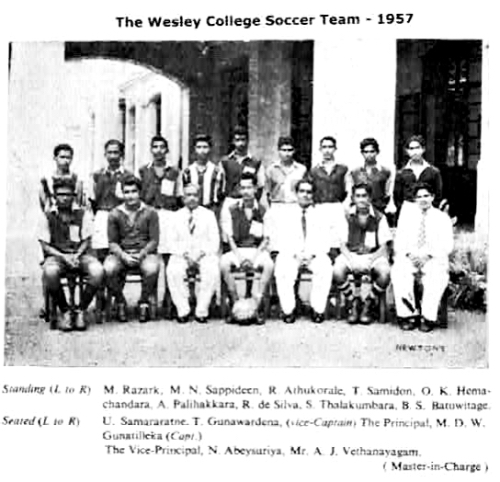
I joined Wesley in 1953 and at that time, emphasis was placed on sports like cricket and hockey. Soccer received very little recognition. However, attitudes changed from 1957. After playing in the under 16 team for a couple of years, I graduated into the senior team. Initially, I was the first reserve in the team. In the first practice game for the season T. Binny Samidon (Dalkin Samidon’s older brother) was injured and I replaced him. After my first match, and to Binny’s bad luck, I replaced him permanently in the team. Some of us in the team initially, were barefoot players. So were some of those who represented Sri Lankan in 1950s. In 1952, when India played in the Helsinki Olympics, many of the players were without boots.
The 1957 team was one of the best Soccer teams Wesley produced. The team was captained by Wimal Goonetilleke and coached by Neville Abeygunawardena. Neville was an excellent coach, with a great soccer brain. He was a very uncompromising disciplinarian. The team comprised of - Terrence Gunawardena (Goal), Wimal Goonatilleke (Captain) and Upali Samaratne (full backs), Razark (right half), O. K. Hemachandra (centre half), Nizar Sappideen (left half), Nalendra Abeysuriya (Right extreme), Ajit Pallihakara (right in), Rajah Athukorale (Centre), Rex de Silva (left in), and Thalakumbura (left extreme). That year, we ended the season undefeated.
In 1958, both Wimal and Terrence left school. However, the team was strengthened by the entry of Michael Fernando (centre forward) and Dalkin Samidon (right in). Allan Patmarajah, replaced Terrence as goal keeper and R. Ratnavale replaced Wimal as one of the full-backs. Upali replaced Wimal as Captain. Dalkin, was selected to represent the Sri Lankan National Youth Team that year. In the year 1958, we had a younger team. We stayed undefeated that year as well.
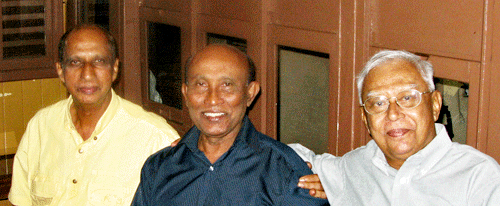
Towards the end of the season, Neville left to the Maldives to take up position as coach to their National team. This was a great loss to the team. In 1959, some of our senior players, viz: Upali Samaratne and Allan Pathmarajah left us. Upali was replaced as fullback by M. Z. Ariff and Pathmarajah was replaced by Sherrard as goal keeper. Razark was appointed Captain of the team, with me as his deputy. The team did reasonably well without a coach. We were undefeated that year, until we met Zahira College and lost to them 2 goals to 1. Zahira had some excellent players that year. Coomarasamy captained their side and had players like A. Ameer (represented Sri Lanka), Abdeen and a few who represented leading Clubs. As a rule, at Wesley we were not permitted to play for any Clubs whilst playing for College.
After these three glorious years, interest and enthusiasm for Soccer at Wesley bloomed and there was great fervour from our supporters both in school and from outside. Whenever Wesley played a match at Campbell Park, the ground was packed by supporters across Dematagoda to Borella. Terrence de Zilwa, a very colourful figure and a great old boy, was one of our generous benefactors. He provided the team with jerseys, stockings and shorts. The team looked very smart with a standard sporting gear. He never missed a match and was also there to support and encourage the team.
There were many great performances from our Soccer players through the years. Regrettably little is mentioned about those greats in the ‘Double Blue International’ website.
From Dr Nihal D Amerasekera
My grateful thanks to Nizar Sappideen who has as always been a great supporter of the Double Blue International. He has never failed to inform me of the OBU in Sydney and its many functions. The Double Blue International is only as good as its contributors.
Links to Further Reading
..................................................
1st XI Soccer Team 1930
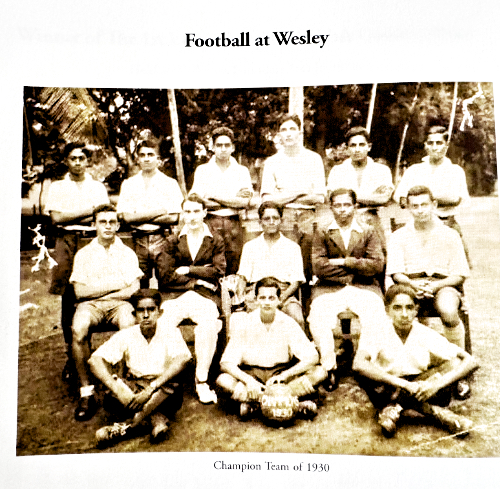
..................................................
1st XI Soccer Team 1957

..................................................
1st XI Soccer Team 1960
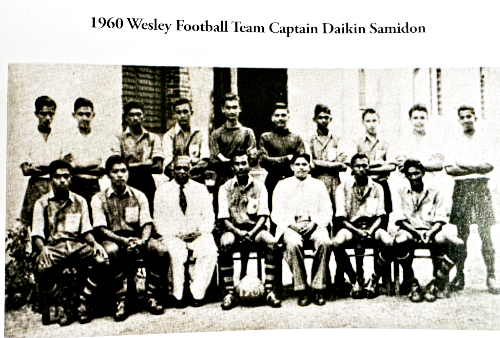
..................................................
1st XI Soccer Team 1988
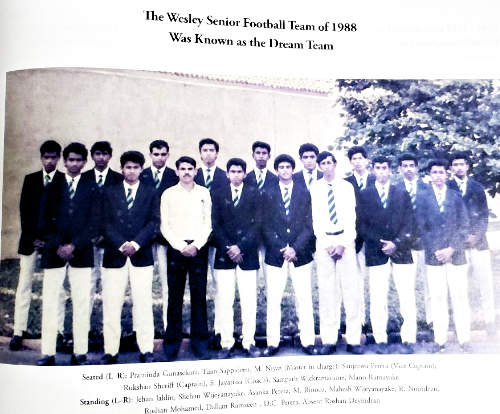
..................................................
1st XI Soccer Team 2009


